April 20, 2024

The Top K-News from Around the World
31 best korean dramas on netflix, q&a with salle yoo, the first chief legal…, top 5 hidden gems for authentic korean food…, ‘1212: the day’, how a nine-hour coup seized….
Join Our Newsletter

- Korean Childbirth Traditions
- HWANGAP 60TH BIRTHDAY
- LEARN THE KOREAN LANGUAGE
- KOREAN ZODIAC
- Korean Weddings
- TRAVEL GUIDE
- RESTAURANTS
- FOOD STORIES
- K-DRAMA & MOVIE
South Korea Travel Guide
Where to go, what to see & how to stay on budget.
By Patricia Liu and Joel Marinan
There has never been a better time to visit South Korea. Clean, modern, sophisticated, and ultra safe, Korea is a destination that you will want to come back to again and again. With the rise of Korean culture and entertainment throughout the world, the country is experiencing a renaissance of sorts, especially for foreigners who wish to experience all that Korea has to offer.
Korea has always been a fascinating country to visit and deserves a place on everyone’s travel bucket list. Known for its stunning blend of tradition and modernity, Korea features futuristic technology, bustling markets, and a thriving pop culture scene. There are no guns or drugs allowed in Korea, and visitors can expect a high level of safety and cleanliness while exploring the country. Also of note is that Korea is a no tipping culture, so savoring the delicious cuisine is extra affordable, as are the cab rides to restaurants and other destinations.
Speaking of affordability, the exchange rate between the Korean won and the US Dollar has been very favorable for Westerners, which is another perk of traveling to Korea right now.
Our South Korea Travel Guide shows you where to go, what to see, and when to travel. Start your journey with itinerary ideas and pre-travel tips, the best day trips, and lots more essential Korean travel advice. Let’s go!
Here are some of our most popular articles that will help you make the most of your trip to South Korea.

A Local’s Guide to Gyeongju
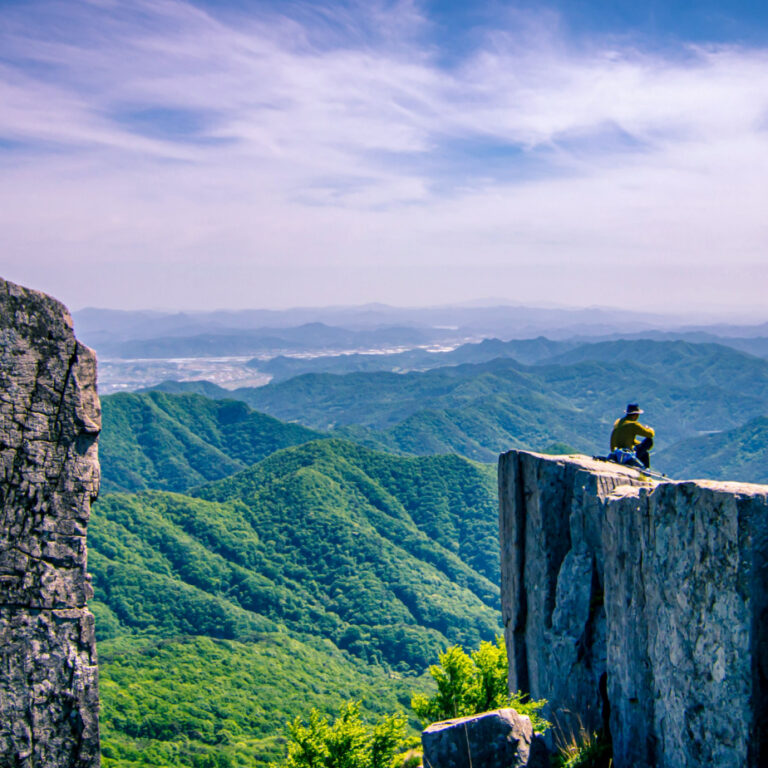
What To Do in Korea in May: The Family Month
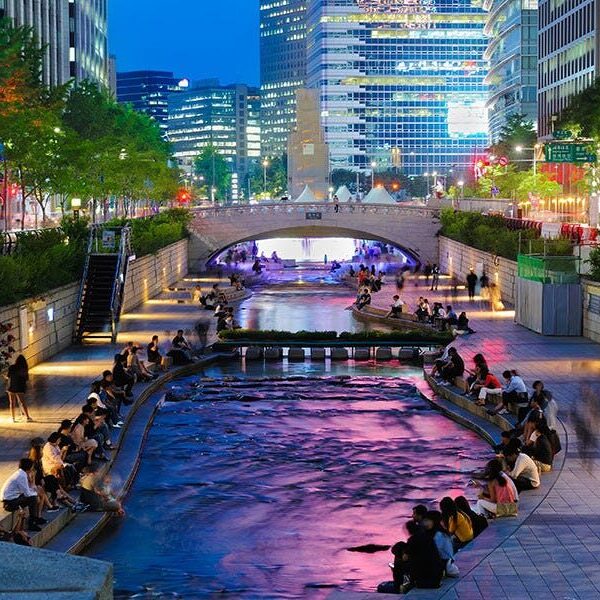
19 Did-You-Knows About Korea
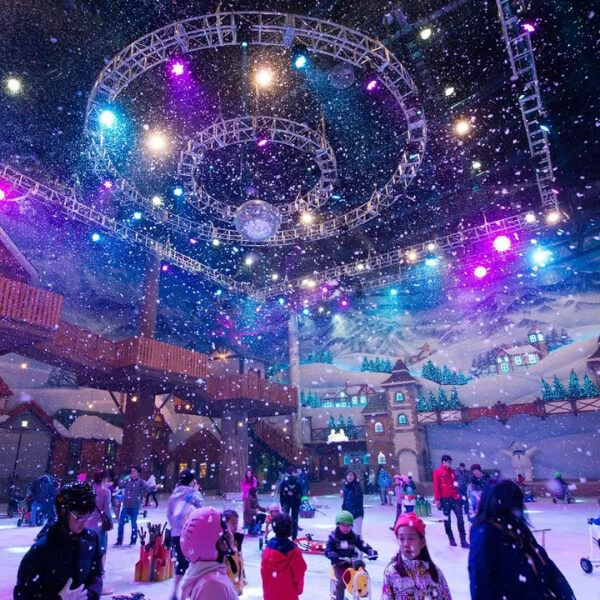
10 Ways to Spend a Magical Christmas in Korea
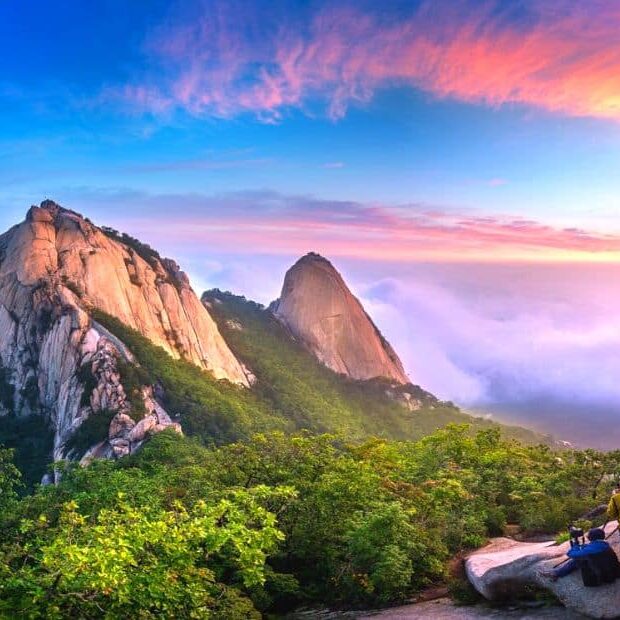
Hiking in Seoul, the Top 5 Mountains You Must Try

Jeju Island: Top 10 Places You Must See
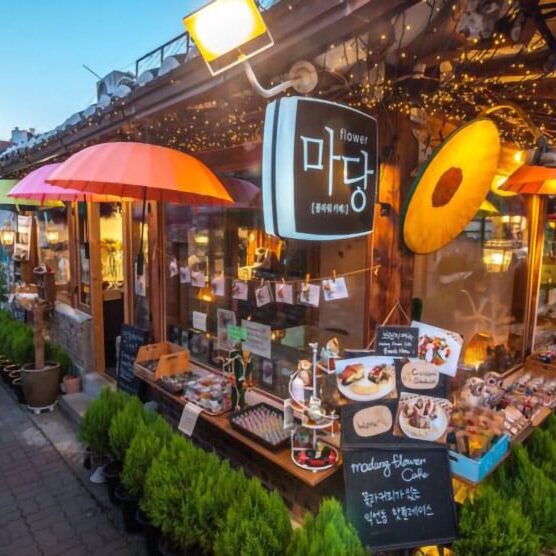
19 Best Things to Do in Seoul Right Now- An Insider’s Guide
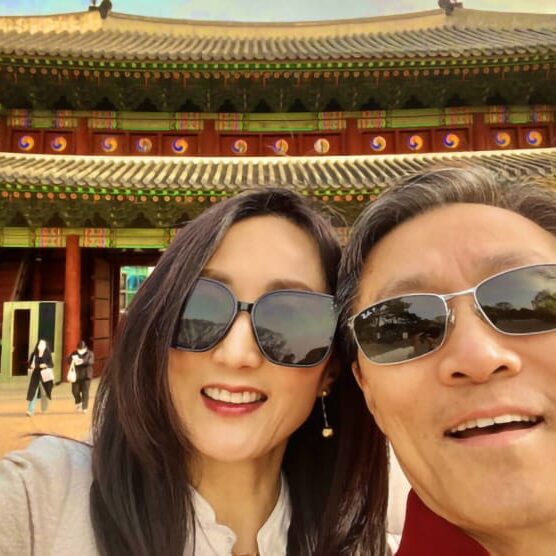
23 Reasons Seoul Will Be Your New Favorite City
Latest travel updates.
- Vaccination is NOT a requirement for entry into Korea.
- There is no requirement on the passport’s remainder validity for entry. You may travel to Korea as long as your passport remains valid throughout your stay in Korea.
- From April 1st, 2023, travelers from the USA, Canada, and 21 other countries no longer need to apply for the K-ETA to travel to Korea. This will run at least until 31st December, 2024 and is designed to make it easier to travel to Korea.

Planning Your Trip To Korea
Check the Korean Embassy for any possible travel restrictions.
- If you’re not sure where to stay, check out our guide to the best hotels in Seoul . You can find our recommendations for the best luxury, mid-range, and budget hotels in Seoul, as well as long-term apartments that you’ll love.
- For the best flight deals to South Korea, Best of Korea recommends Skyscanner and Expedia . You can find the cheapest prices and most convenient flights and buy the one that suits you best.
- For the best hotel prices in Seoul, Best of Korea recommends Klook 0r Agoda – they cover most hotels in Seoul and the rest of Korea and offer great prices without hidden fees.
- Before you travel to Korea, it’s a good idea to order an eSim card, regular sim card or portable WiFi router to collect at the airport so you’re connected as soon as you arrive. You can change a small bit of money before you travel, but you can also use the airport ATM to get some Korean won.
- There are large differences in exchange rates so you will need to do some comparing before you exchange a large sum of money. You can exchange USD to KRW easily at banks or money exchange shops in all major tourist areas like central Seoul (Myeongdong and Namdaemun are good places but the Coex Center also offers money exchange. You can also negotiate the exchange rate with the vendor if you think it is too high.
- You can withdraw cash from bank ATMs. Alternatively, use a pre-paid travel card like the one offered by Wise , which allows ATM withdrawals and payments and works perfectly in Korea.
- Don’t forget to bring a travel adapter for your electronics and leave plenty of extra space in your suitcase for the many Korean souvenirs and goodies you’ll buy on your tri
Do US Citizens Need A Tourist Visa?
No, travelers from the USA don’t need a tourist visa to enter South Korea. You can visit for up to 90 days visa-free.
Current COVID-19 Rules In Korea
Most COVID-19 rules in Korea have been dropped and now there are only 2 main rules to be aware of. First, face masks are mandatory when visiting medical facilities (hospitals). There is no longer a 7-day mandatory quarantine for people in South Korea. If you’re infected with COVID, the Korean government recommends a 5 day self-quarantine, but it’s not enforced. Travelers to Korea should follow the current restrictions or may be liable for fines or deportation.
Korean Tourism Support Hotline
If you have any concerns or problems when traveling in Korea, you can call 1330 . This is a dedicated tourism support hotline where trained specialists provide tourist assistance and is available in Korean, English, Japanese, Chinese, Russian, Vietnamese, Thai, and Malay.
US Government Travel Advisory For Korea
The U.S. Department of State currently has a level 1 travel advisory (Exercise Normal Precautions) for the Republic of Korea (ROK). Find out more about current travel advisories for South Korea on the Department of State website.

6 Best Destinations In Korea
South Korea is truly a country of contrasts. From the bustling, modern city of Seoul , with cutting-edge designer buildings, VR labs, and AI robots, to peaceful UNESCO World Heritage cities like Jeonju and Gyeongju , there are many unique places to explore.
There’s nothing worse than coming back from vacation and hearing about incredible places you missed that you wished you’d seen, such as a beautiful Buddhist temple by the beach (Haedong Yonggungsa Temple) or a leafy island getaway where deer and rabbits roam freely (Nami Island).
Here are 6 of the best destinations in Korea that you absolutely must visit, as well as some of the sights you’ll want to check out while you’re there. We’ll be bringing you lots more detailed destination guides in the future, so be sure to visit again soon.
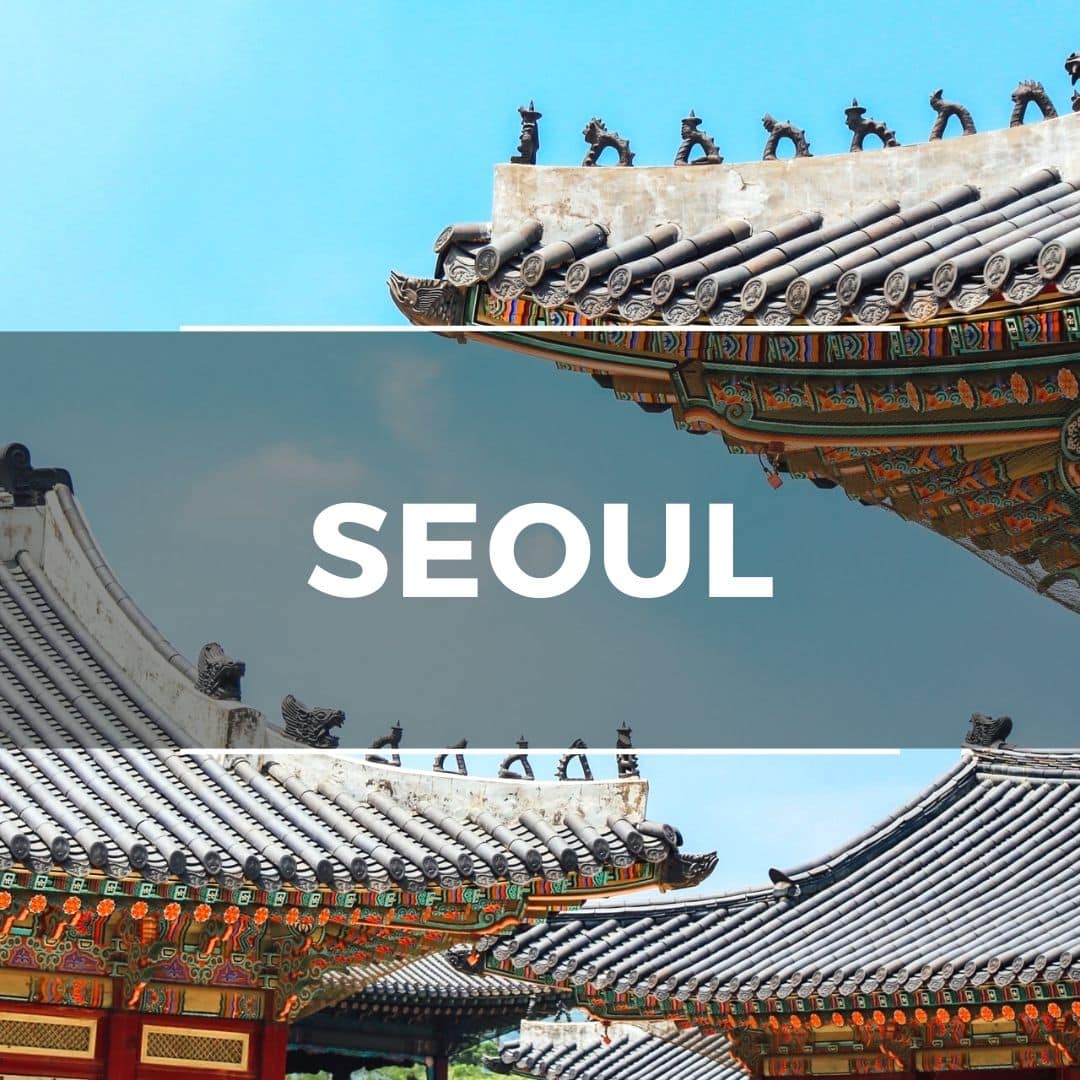
Korea’s Busy Capital
Seoul is Korea’s largest city, capital, and first, stop for most travelers to Korea. There are many beautiful places in Seoul , including landmarks, relics from ancient kingdoms, towering skyscrapers, Buddhist temples, Michelin-starred restaurants, and some of the best street food you’ll find in the world. If you see only one city in Korea, you should definitely visit Seoul.
You’ll never be bored in Seoul. Whether you’re traveling as a family, as a couple, or by yourself, there’s so much to do. Be sure to plan lots of time to check out Korea’s capital.
This Full Day Tour of Seoul will show you some of the hottest spots in the city, while this Customized Private Tour of Seoul will allow you to choose where to go.
Here are 10 of the best Seoul attractions:
- Gyeongbokgung Palace
- Bukchon Hanok Village
- Starfield COEX Mall
- Bukhansan National Park
- Myeongdong Street Markets
- Lotte World Tower
- Secret Garden (Changdeokgung Palace)
- Dongdaemun Design Plaza
- N Seoul Tower
- Yeouido Hangang Park

Korea’s Second City
Busan, Korea’s second city, is a thriving port city far away from Seoul both physically and culturally. This popular summer destination features some of Korea’s most popular beaches and bars. Explore Busan and you’ll find sprawling markets, fresh seafood, film festivals, the world’s largest shopping mall, coastal temples, and lots more.
Busan is a city with some very photogenic sights. See the sunrise on the beach, hike around leafy coastal streets on the side of cliffs, and marvel at the wide range of (living!) seafood in the markets.
This Full Day Tour of Busan will show you the best beaches, markets, and local sights, while this Customized Private Tour of Busan will allow you to choose where to go.
Here are 10 of the best Busan attractions:
- Haeundae Beach
- Gwangbokdong Food Street
- Haedong Yonggungsa Temple
- Huinnyeoul Culture Village
- Gamcheon Culture Village
- Oryukdo Sky Walk
- Lotte World Busan
- Jagalchi Fish Market
- BIFF Square & Centum City Mall
- Taejongdae Resort Park
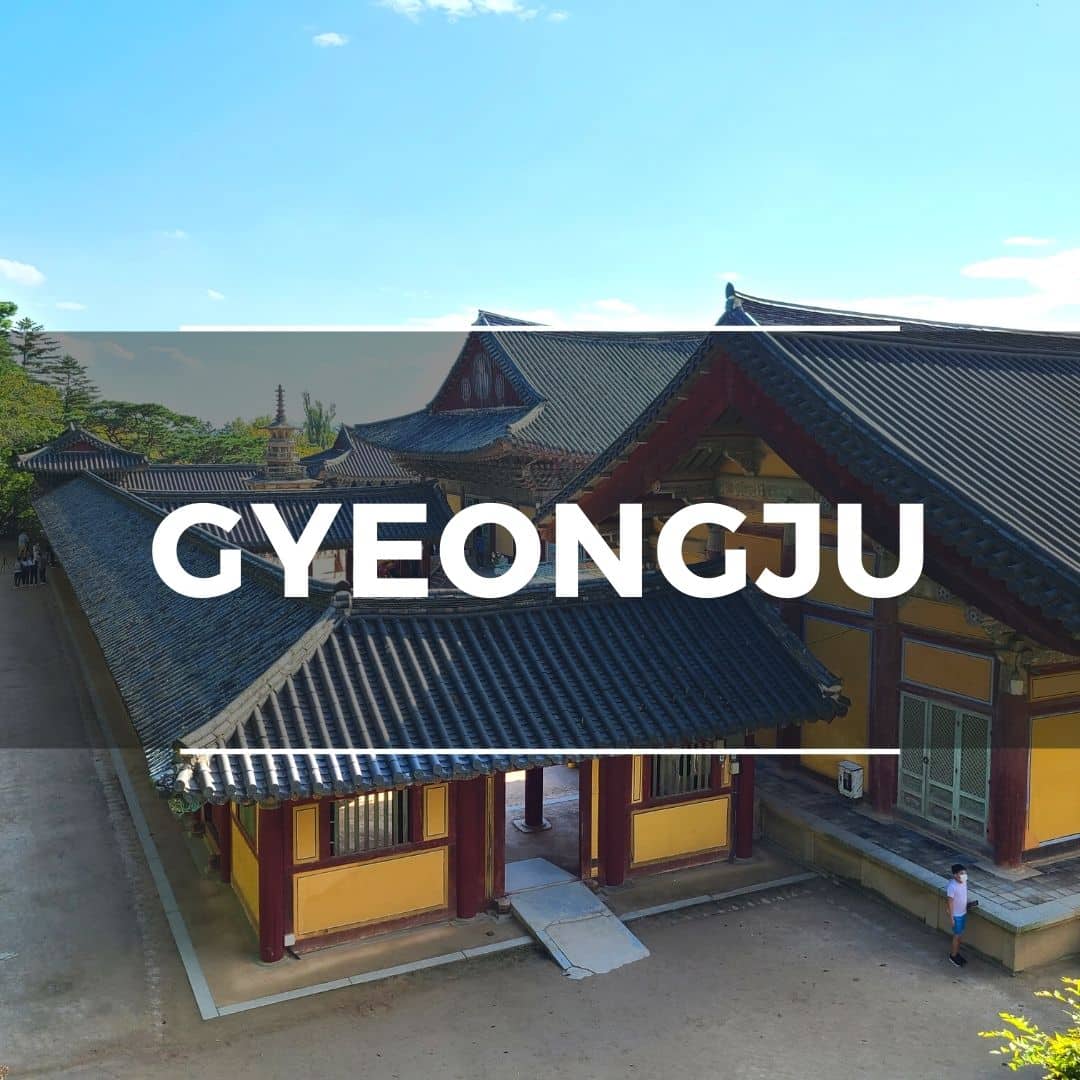
UNESCO City
Gyeongju is the former capital of the Silla Kingdom, part of the Three Kingdoms part of Korean history. These days, Gyeongju is an open air museum housing Korea’s finest history and monument. This UNESCO World Heritage City is a must-see for those who want to learn more about Korea’s deep cultural past.
Gyeongju is packed with temples, palaces, historical sights, and monuments. But it’s not just the history that draws the crowds, the city is an area of natural beauty, lined with cherry blossoms and shadowed by misty mountains.
This Full Day Tour of Gyeongju from Busan will take you around Korea’s open-air museum city, showing the top UNESCO sites along the way, while this Customized Private Tour of Gyeongju will allow you to choose where to go.
Here are 10 of the best Gyeongju attractions:
- Gyeongju Historic Area
- Bomun Lake Tourist Complex
- Bulguksa Temple & Seokguram Shrine
- Donggung Palace & Wolji Pond
- Yangdong Folk Village
- Cheomseongdae Astronomical Observatory
- Gyeongju National Museum
- Gyochon Traditional Hanok Village
- Woljeonggyo Bridge
- Gyeongju National Park
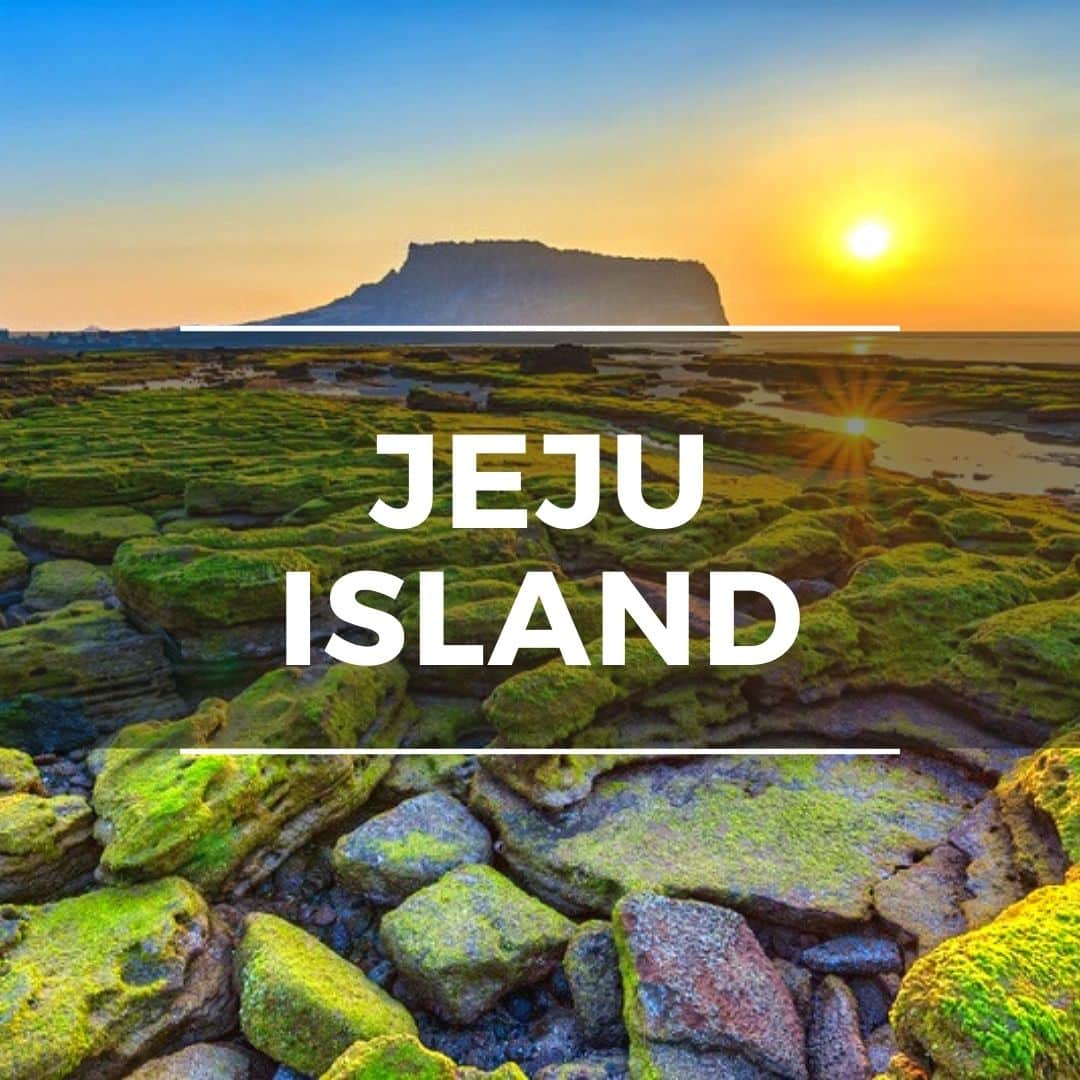
Natural Wonder
Jeju Island is Korea’s semi-tropical island that’s a popular vacation destination for locals and tourists alike. This area of outstanding natural beauty offers up rugged coastal walks, sandy beaches, green hills, and a volcano to hike up for those who enjoy a challenge. Culture and cafe lovers will also find Jeju Island a charm.
From snorkelling under the sea, to hiking above the clouds, sampling Jeju’s black pork BBQ, and drinking local green tea, there’s so many exciting activities, sights, tastes, and experiences waiting for you on Jeju Island.
This Full Day Tour of Jeju Island will show you some of the most incredible UNESCO World Heritage sites on Jeju’s East Coast, while this Customized Private Tour of Jeju Island will allow you to choose where to go.
Here are 10 of the best Jeju Island attractions:
- Seongsan Ilchulbong Sunrise Peak
- Jusangjeolli Hexagonal Lava Cliff
- Hallasan Mountain (Volcano)
- Hamdeok Beach
- Jeju Folk Village
- Hyeopjae & Geumneung Beach Areas
- Cheonjeyeon & Jeongbang Waterfalls
- Udo Traditional Island
- Yakcheonnsa Coastal Buddhist Temple
- O’Sulloc Green Tea Fields
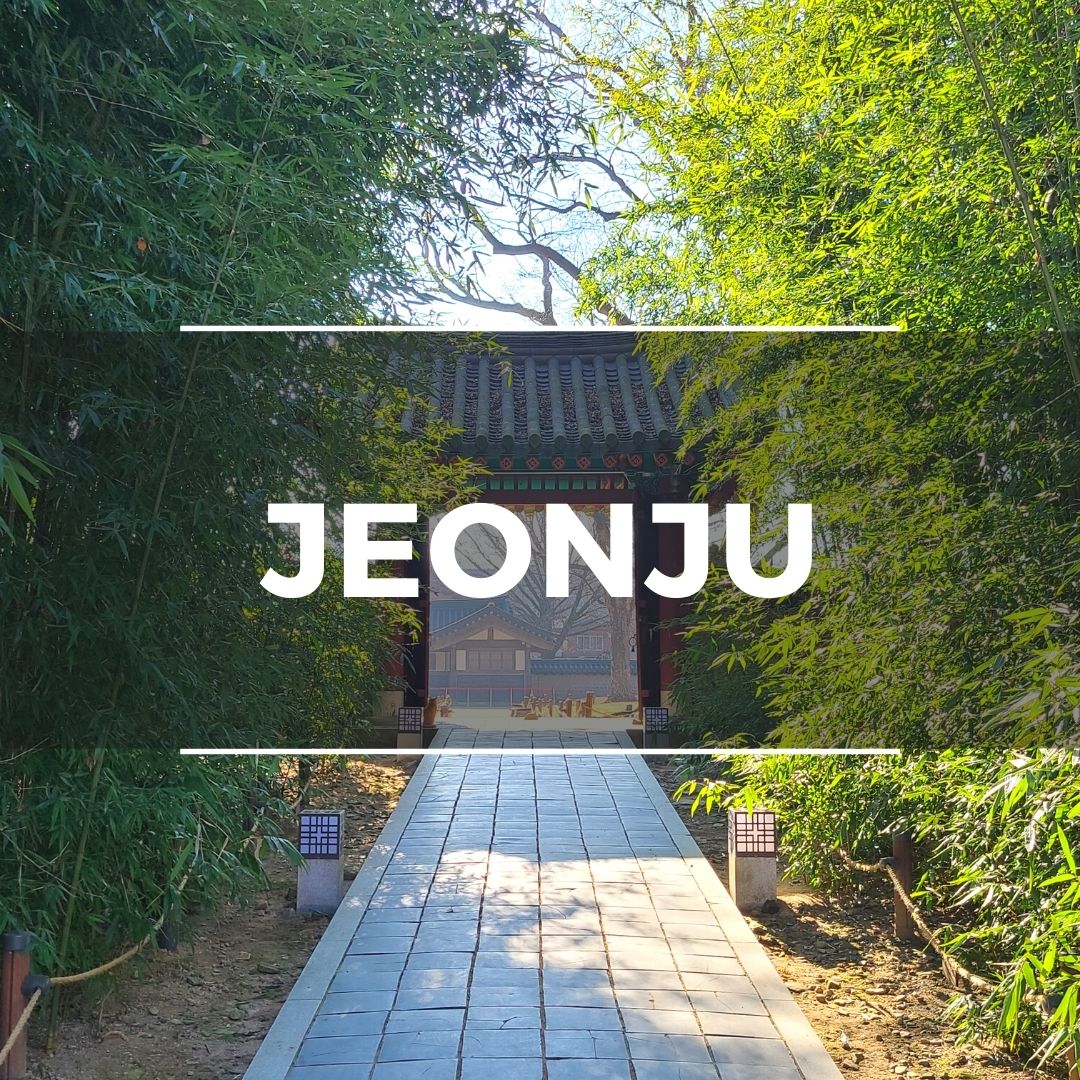
Traditional Korea
Jeonju is famous for its historical and cultural sights, including the sprawling Jeonju Hanok Village, packed with more than 700 traditional hanok houses. Jeonju’s many impressive sights are close to each other and perfect for a day trip from Seoul or Busan. You can even stay overnight in one of the traditional houses.
Jeonju is a tourist hotspot so there are plenty of things to keep travelers entertained and places to experience traditional Korean food and drinks. Be sure to check out the Jeonju bibimbap, one of Korea’s national dishes. Rent hanbok (traditional clothes), take lots of pictures, and see the sights.
This Full Day Tour of Jeonju will show you around the beautiful hanok houses and traditional Korean restaurants, while this 2-Day Tour of Jeonju includes an overnight stay in a hanok and lots of delicious Korean meals.
Here are 10 of the best Jeonju attractions:
- Jeonju Hanok Village
- Gyeonggijeon Shrine & Portrait Museum
- Jeongdon Catholic Church
- Jeonju Hyanggyo Confucian School
- Nambu Traditional Market
- Jaman Mural Village
- Omokdae Viewpoint
- Deokjin Park
- Hanbyeokdang Pavilion
- Taiji-ro & Hyangoyo-gil Shopping Streets
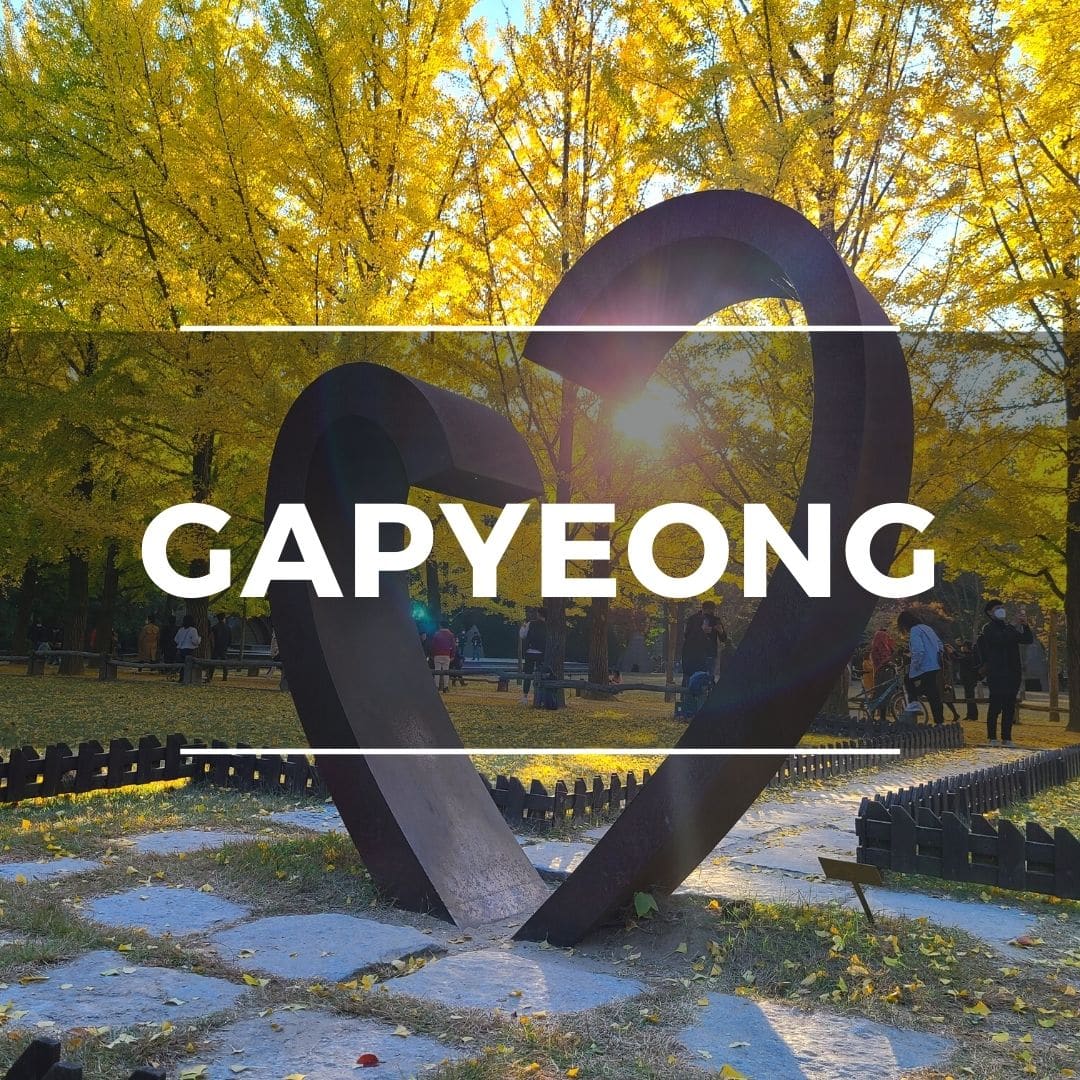
Rural Attractions
Gapyeong County is an area just outside of Seoul that’s home to several interesting attractions celebrating Korean and foreign culture. The lush green hills and blue rivers of Gapyeong make it a great place to immerse in Korean nature.
You’ll find some of the hottest day trip locations here. Explore Gapyeong County on a day trip from Seoul. You can see romantic tree-lined streets and cafes on Nami Island, explore one of Korea’s most beautiful gardens, take a trip to Petite France, and enjoy cycling through the hills on an abandoned railway track.
This Full Day Tour of Gapyeong will show you around Nami Island, Garden of Morning Calm, and the Rail Bike Park.
Here are 10 of the best Gapyeong attractions:
- Nami Island
- Garden of Morning Calm
- Petite France
- Ganchon Rail Bike Park
- Edelweiss Swiss Village
- Cheongpyeong Lake
- Jarasum Island
- Kalbongsan Recreational Forest
- Gapyeong Sledding Hills
- Nami Island Zip Line

There are loads of locations to visit in Korea that make for a perfect day trip from Seoul. Hop on a coach, train, or tour bus in the morning and explore one or more of these unique destinations.
Here are 10 of the best day trips from Seoul to discover on your next journey to Korea:
- DMZ (North Korean Border)
- Suwon Hwaseong Fortress
- Everland Theme Park
- Jeonju Historic City
- Seoraksan National Park
- Korean Folk Village
- Alpaca World
- Gwangmyeong Cave
Most travelers to Korea arrive at Incheon Airport and then travel into Seoul (it’s only 40 minutes away) to begin their journey. Seoul is certainly an incredible place to start traveling, but it definitely shouldn’t be your only destination. Korea has a lot to offer, including a lot of seasonal activities and events that you should take into consideration.
Spring and fall are the best seasons to visit Korea and during these times the traditional cities like Gyeongju and Jeonju look amazing. They’re covered with cherry blossoms or fall foliage and this creates some postcard-like scenes. Gapyeong area is packed full of natural sights to enjoy, so definitely check out these areas.
If you’re visiting during summer, head towards the coastal areas, including the north-east coastal towns of Gangneung & Sokcho, or the south-east coastal areas of Busan and the nearby islands, such as Geoje, Tongyeong, and Yeosu. You’ll find lots of winter activities to enjoy in these areas.
Winter is cold and dry and, ironically, a great time to visit Jeju Island. This semi-tropical island is warmer than the mainland, but still gets snow on the mighty Hallasan Mountain. You can sit on a sunny beach one day and then hike knee-deep in snow the next. Jeju is also famous for its citrus, with thousands of tangerine trees dropping their juicy fruits in early winter.

Where To Stay In Seoul
South Korea is truly a country of contrasts. From the bustling, modern city of Seoul , with cutting-edge designer buildings, VR labs, and AI robots, to peaceful UNESCO World Heritage cities like Jeonju and Gyeongju , there are many unique places to explore. If you’ve decided on Seoul, here are some of the best hotels that are well located and highly reviewed.
Choosing the best destinations to visit in Korea can be a challenge, especially if you don’t know what there is to see. You might not have heard of some of these destinations, which is not surprising. Korea is a country of undiscovered wonders that are waiting to be found.
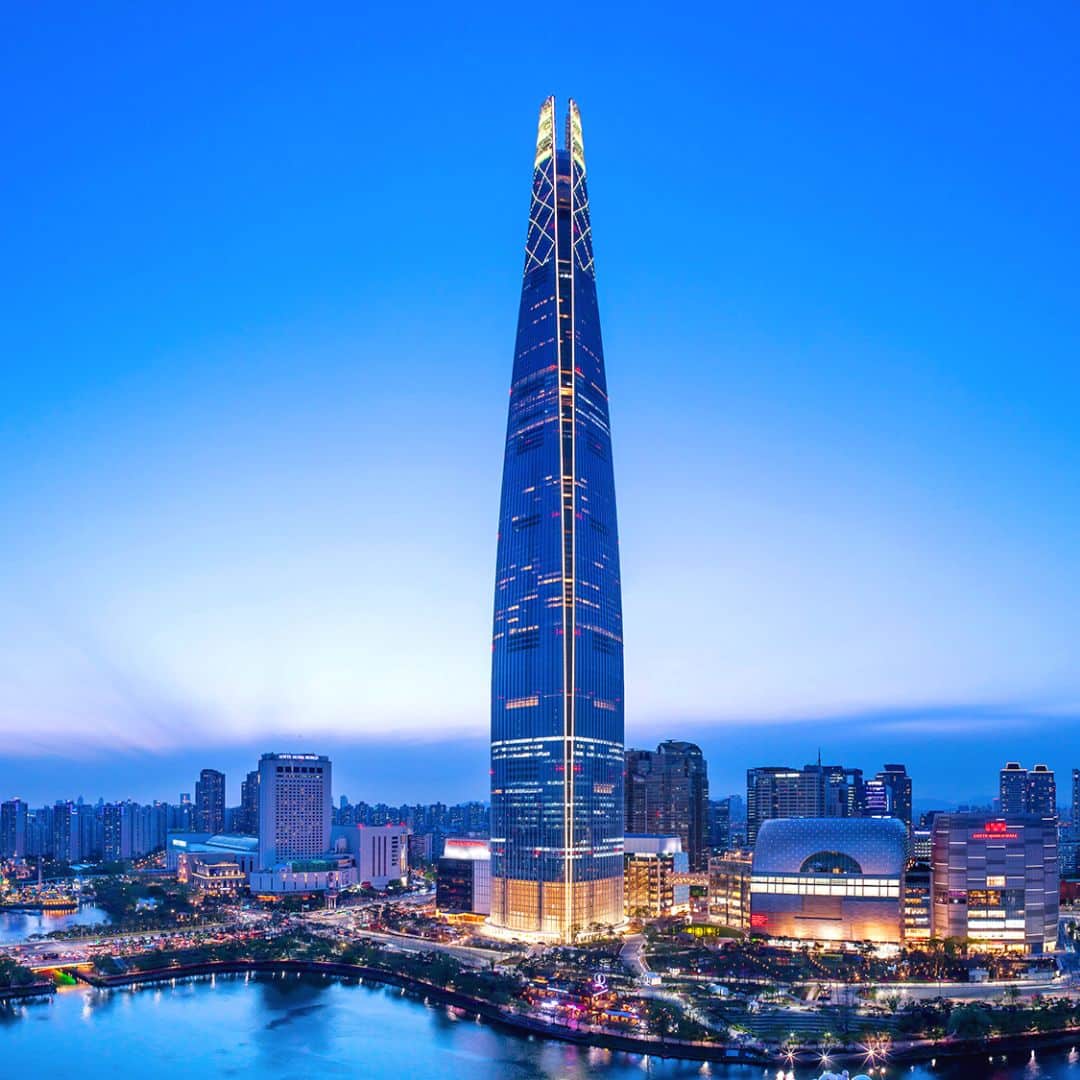
If you want the best Seoul has to offer, these luxury hotels are for you. Located in Seoul’s glitziest neighborhoods, these hotels are within walking distance of Michelin-starred restaurants, chic boutiques, galleries, museums, and the finest shopping experiences available.
Expect nothing but the best in terms of service and style at these luxury hotels. Silky soft sheets, immaculate rooms with the finest fixtures and fittings, and true 5-star service from the hotel staff. These hotels have sports, dining, and entertainment facilities to make you comfortable during your stay.
Airport transfers are available with these hotels, making your journey into and out of Seoul a breeze. Located in popular upmarket districts in Seoul, these neighborhoods have lots of local charm for you to discover, as well as allow easy access to other parts of the city with excellent transport options nearby.
Not only are these beautiful, comfortable hotels inside, but they are also located in some of the most iconic buildings or districts and provide amazing views over some of Seoul’s most interesting districts. The view from the first hotel is worth the cost alone.
Recommended Luxury Hotels In Seoul
Here are 3 of the best luxury hotels in Seoul that we recommend for an unforgettable stay in Korea’s capital:
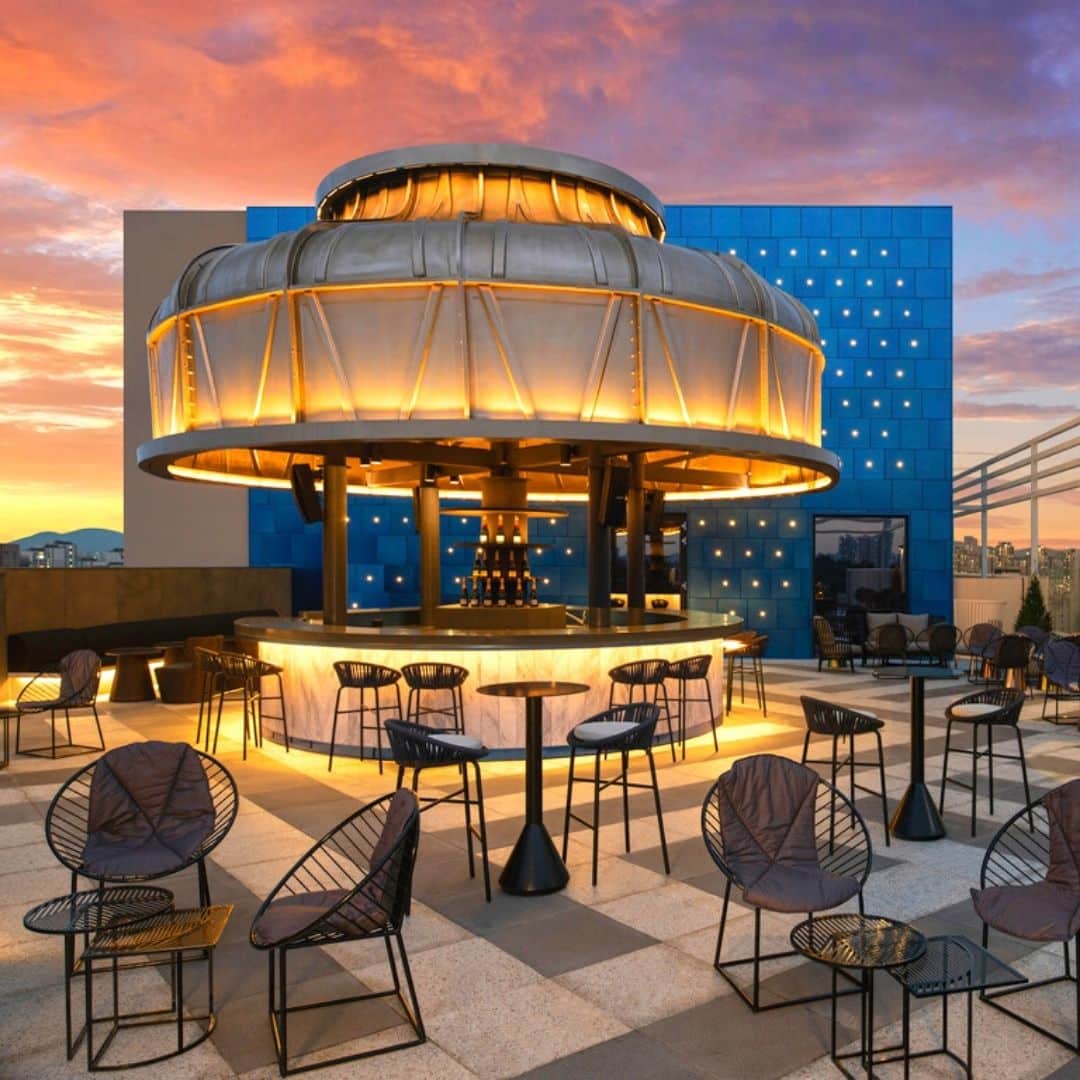
Families. couples and other travelers that want to experience the best of Seoul without breaking the bank can sleep easy with these mid-range hotel recommendations in some of Seoul’s trendy, vibrant districts, including Hongdae, Gangnam, and Myeongdong.
Encounter stylish accommodation in Seoul’s Hongdae districts, which is full of street culture and artistic scenes from the district’s eponymous Hongik University – one of Korea’s leading art centers.
Fashion lovers and shoppers will find lots to love in downtown Gangnam, with its wide streets and glassy storefronts bracketing narrow side streets and hidden delicacies.
Myeongdong is famous for its budget and mid-range accommodation options, including several hotels by the famous Lotte chain – one of Korea’s best mid-range brands.
Whichever mid-range hotel you choose in Seoul, you can be sure you’ll have fantastic city views, convenient subway access, and lots of unique cultural sights, sounds, and tastes to experience.
Recommended Mid-Range Hotels In Seoul
Here are 3 of the best mid-range hotels in Seoul that we recommend for an comfortable stay in Korea’s capital:
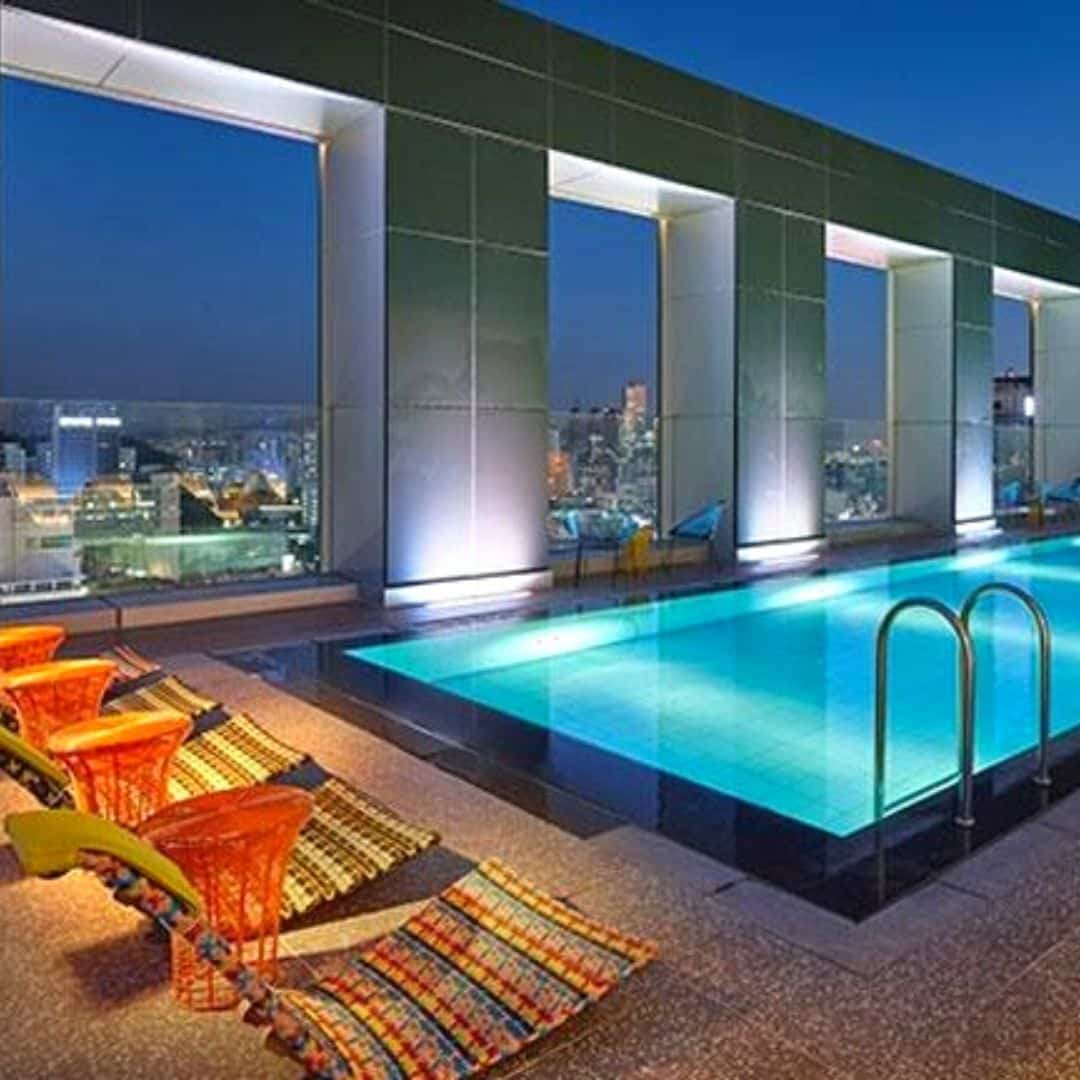
Seoul has a wealth of budget accommodation options that will help make your money go further. These hotels are all around $100 or less but offer the comfort and convenience that you’d expect to find in a mid-range hotel. One even has a beautiful rooftop pool.
Although these hotels are cheaper, don’t lower your expectations. You’ll always find great service in Korea. Save on sleeping to spend more on shopping, souvenirs, sights, and all the other fun things there are to do in Seoul.
These budget hotels in Seoul are also in great locations for shopping, enjoying local culture, and seeing the real side of Seoul and Korea. Hongdae offers bargain hunters the chance to get boutique fashion at market prices, Gangnam has plenty of cafes and cheap eats tucked away off the main avenues, and Myeongdong is a budget traveler’s paradise full of $1 street food and bargain souvenirs.
You won’t be disappointed with a night at any of these hotels. If you want to make your budget go further so you can spend more on some of the incredible day trips Seoul has to offer, definitely book a night at one of these hotels.
Recommended Budget Hotels In Seoul
Here are 3 of the best budget hotels in Seoul that we recommend for an affordable stay in Korea’s capital:

Korean Travel Tips
Korea is a unique country with a written language that looks nothing like English, fascinating etiquette rules , and an always busy lifestyle. Travelers may be lost trying to do even the simplest things.
These travel tips include the best options for staying connected, how to use public transportation easily and cheaply, great discount cards that will save you money as you travel, where to exchange money, and how to learn some basic Korean phrases for when you travel.
These essential Korean travel tips have been crafted by experienced travelers who love to save time and money. Only the best quality services and products are recommended here.
Here are our Korea travel essentials that’ll help you get around more easily, save you money, and let you get the most out of your trip.
Plan ahead now and you’ll have fewer troubles on your travels, giving you more time to enjoy your time in Korea.
If you’re traveling to Korea, you’re almost certainly going to want to get access to the internet to help you navigate, translate Korean, or even book tickets to attractions. Korea has one of the world’s best mobile internet and the prices are very reasonable. 5G mobile internet services are available across the country and Korea was one of the first to get the super-fast service. You won’t have problems connecting with a sim card or WiFi router when you travel.
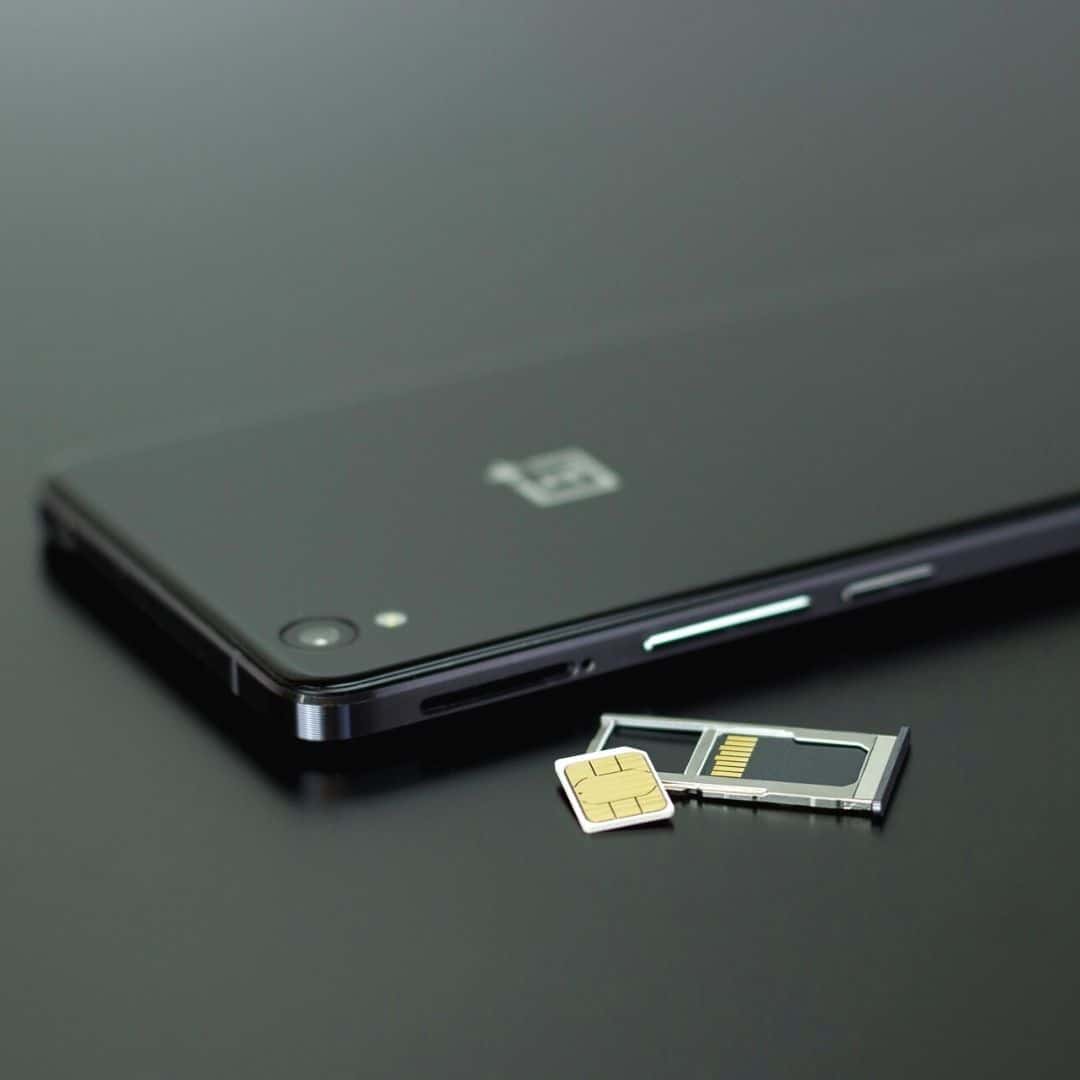
Sim Cards & Data Plans
A Korean sim card is a great way to get access to all your usual cellphone services when you travel to Korea. Sim cards come with data-only packages, or data and phone services combined.
Buying a Korean sim card will give you access to a Korean phone number, which is useful when using Korean apps. If you want to order food online in Korea, you need to have a Korean phone number to complete the order.
Korean Sim Card Costs
Prices start at W5,900 ($5) for a 1-day sim. You can also get 10-day sim cards (W34,700/$28) and 30-day sim cards (64,400/$52). These all come with unlimited data, domestic calls, and texts.
You can purchase a Korean Sim Card From Klook and collect it at the airport. This is a very convenient option as you can use it immediately to help navigate and check in back home.

Portable WiFi Routers
A Korean portable WiFi router will give you access to mobile internet throughout Korea by connecting to WiFi hotspots run by the major phone companies in Korea and comes with great coverage.
The major benefits of a portable WiFi router include a lower cost than a Korean sim card and also the ability to connect up to 3 devices to 1 router. That means that families and groups will be able to share the service.
Korean Portable WiFi Router Costs
The cost of a Korean portable pocket WiFi router is W3,200 ($2.60) per day. You can rent the WiFi router for as many days as you require and pay in advance and pay any excess days when you return it.
You can also purchase a Korean Portable WiFi Router From Klook and collect it at the airport. You can book online before you travel so that it’s guaranteed to be waiting for you.
Should I Get A Sim Card Or WiFi Router In Korea?
Both a sim card and WiFi router are great options for travelers to Korea and will almost guarantee a great reception for mobile internet. The choice between whether you should get a sim card or WiFi router in Korea really comes down to the costs involved and if you need a Korean phone number.
WiFi routers are cheaper and allow you to connect 3 devices, so they’re perfect for families. However, a sim card gives you a Korean phone number, which means you can call people and also register for Korean apps which require a phone number.
Check out our detailed article about the Best Sim Card & Portable WiFi options for traveling to Korea.
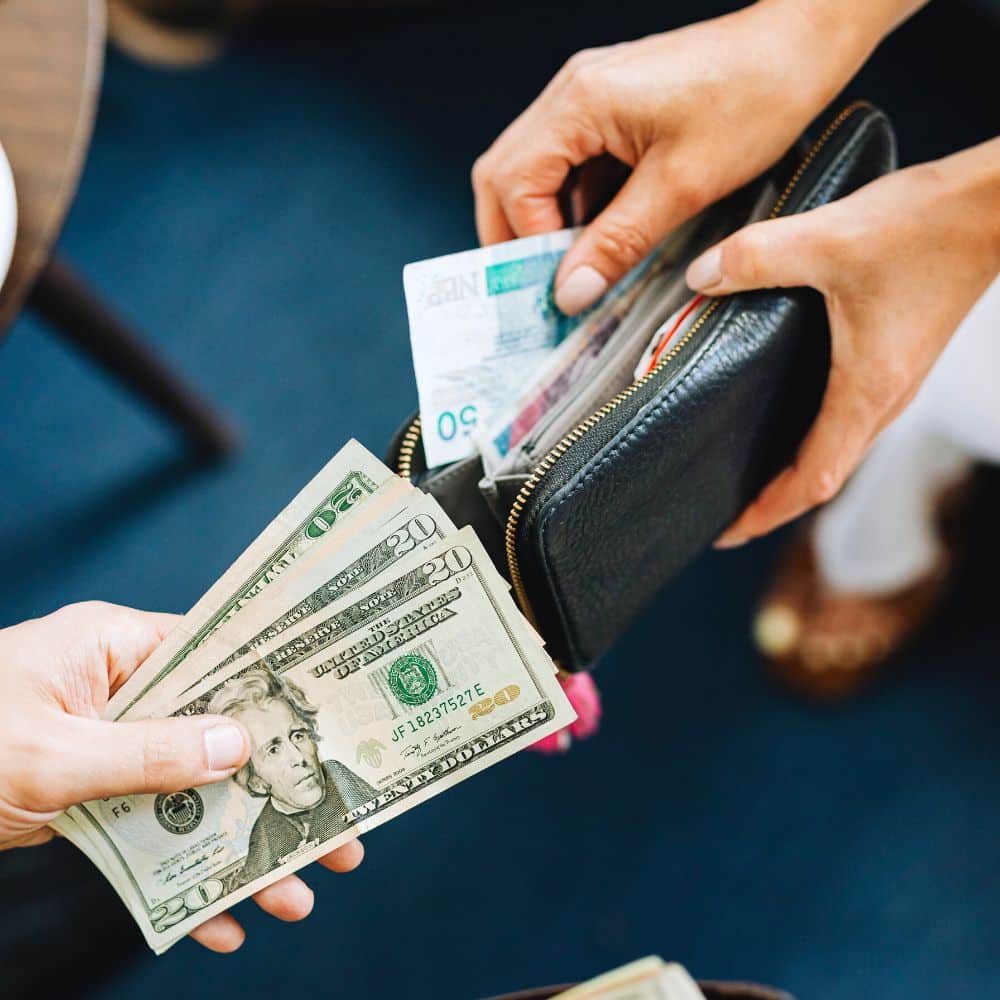
Korea is a safe, modern country and one that has pushed hard for the mass adoption of cards. Almost every location that deals with money is required to accept card payments. This is great news for travelers to Korea as you can use a card to pay for meals out, entrance tickets, trains, and lots more.
Cash is still needed for some things, such as topping up transportation cards like the T-Money Card (more on that soon) and for paying for small things like street food. Please note, as Korea doesn’t have a tipping culture, you don’t need cash for leaving a tip. In fact, if you try to leave a cash tip, it’ll be returned to you in most places.
Read on to find the best tips to avoid getting ripped off when exchanging money and how to pay the lowest fees when you use a card to pay in Korea. Be a smart traveler and save more money for shopping and souvenirs.
Korean Money Exchange Options
Once you arrive in Korea, there are several options for exchanging money. First, you can exchange money at a money changer in tourist areas such as Myeongdong. These money changers used to have the best rates in Seoul.
However, a better option these days is to use the currency exchange machines from WOW Exchange. These machines are located all over Seoul’s most popular tourist spots, stations, and hotels. They allow you to exchange foreign cash directly to Korean won, with better rates than at the airport. You can also use these machines to claim a tax refund for your shopping before heading to the airport. Both options require a passport.
Should I Change Money At The Airport?
Exchanging money at the airport is easy and convenient as you can instantly get cash to use for shopping, transportation, and general use. However, the exchange rate at the airport is usually much worse than you’ll find in other places in Korea, as mentioned previously. If you need cash as soon as you land, withdraw a small amount ($50) and then exchange the rest in Seoul.

Travel Money Cards For Korea
While cash is useful and familiar when traveling, a much better option is to use a travel money card (also known as a currency card). Travel money cards, such as the Wise Travel Money Card, allow you to pay for travel expenses without the need to carry cash or convert money.
A travel money card offers the convenience of using a credit card without high fees that a regular bank could charge. It also allows you to withdraw cash from an ATM without a fee (up to a limit), so you can avoid carrying any cash on the flight or using a money exchange. The exchange rate is the mid-market rate, meaning it’s better than you’ll find even at the money exchanges listed before.
Can I Use My Bank Card In Korea?
Credit cards are widely accepted in Korea. Visa and Mastercard users shouldn’t face a problem, but other cards aren’t as widely accepted. Debit cards and cash withdrawals might not work depending on the bank. Your bank may charge a fee when using it overseas, or give a bad exchange rate. Check with your bank before traveling.
The best option for travel money in Korea is to have a mixture of cash and cards, with a backup credit card just in case. Taking some USD with you is always a good option as you can find plenty of places to exchange it to Korean won and probably at a better rate than you’ll get in the US. If you want to withdraw money in Korea, look for the global ATMs in tourist areas.
Taking a travel money card will be safer, cheaper, and more convenient than relying on your own bank or credit card, too. These cards offer competitive rates and are widely accepted around the world so you can use them to visit other countries, too. If you use a travel money card and it gets lost or stolen, you can freeze the card instantly with the app and not have to worry about losing the balance on the card.
When you visit Korea, you’ll notice that most people pay for goods with a card or payment app, even for small purchases like a bottle of water. Unfortunately, the payment apps that are common in the US, such as Apple Pay or Google Pay, aren’t available in Korea. Korean apps, such as Kakao Pay, require a Korean bank account, and therefore aren’t an option for travelers.
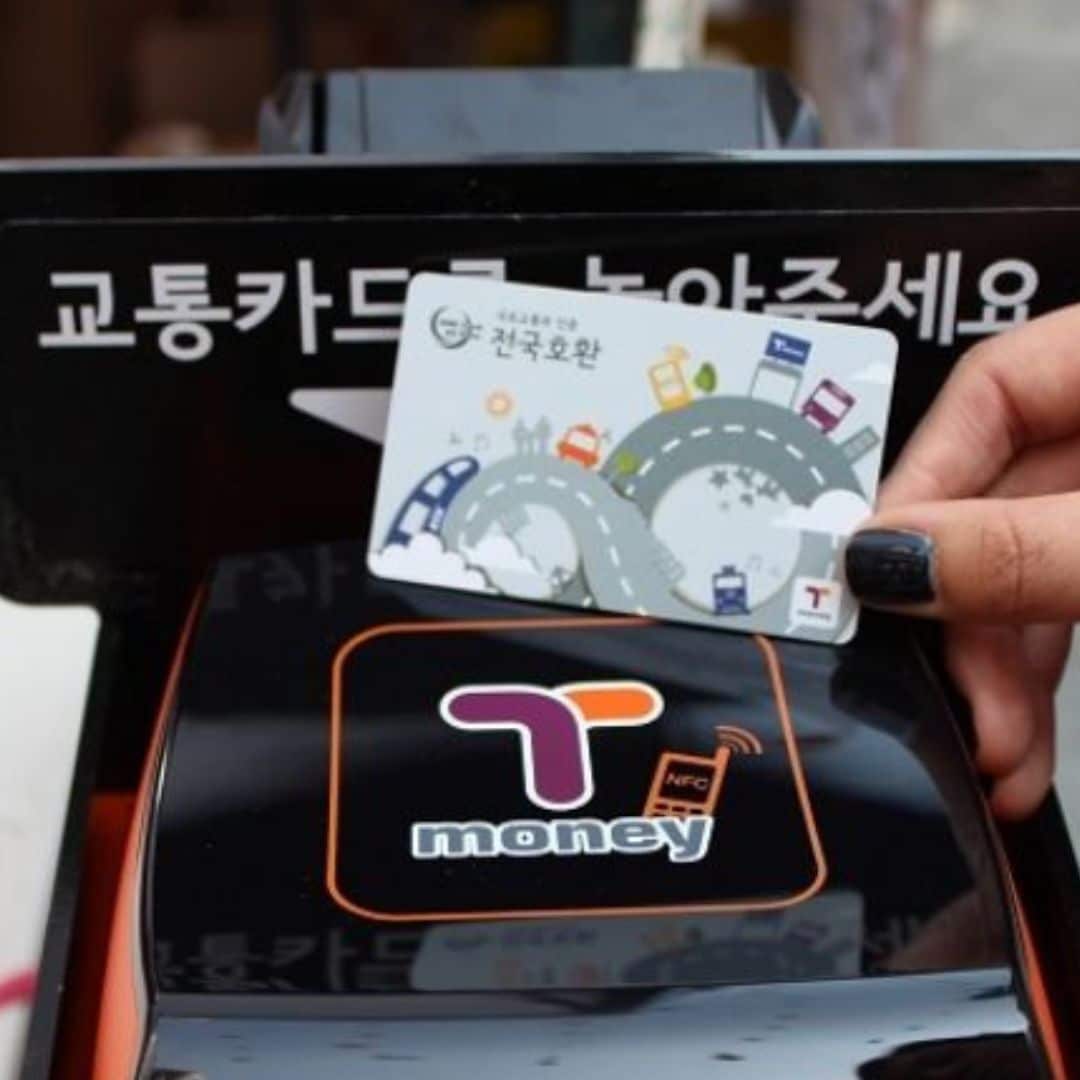
T-Money For Public Transport
The T-Money Card is an essential purchase for every traveler to Korea. The T-Money Card is a transportation card that allows contactless travel on Korea’s buses and subways. Simply buy a T-Money Card, top-up the card, then use it to travel.
Not only is this transportation card really convenient, it also saves you money. You’ll receive a discount on every bus or subway journey when you pay with the T-Money Card. These discounted fares are available in all cities across Korea, not just Seoul.
This isn’t the only use of the T-Money Card. You can also use to buy a coffee from Starbucks, get lunch in McDonald’s, shop for Korean cosmetics, and even to watch a baseball game. It’s a very useful card that can be used anywhere you see the T-Money Card.
You can get the T-Money Card in Korea from subway stations and at certain transport centers, including Seoul Station and Incheon Airport. The card costs 2,500 KRW. You can buy the card with a credit card, but to top-up the card, you need to use cash. If you buy a Discover Seoul Pass, this card includes the T-Money functions.
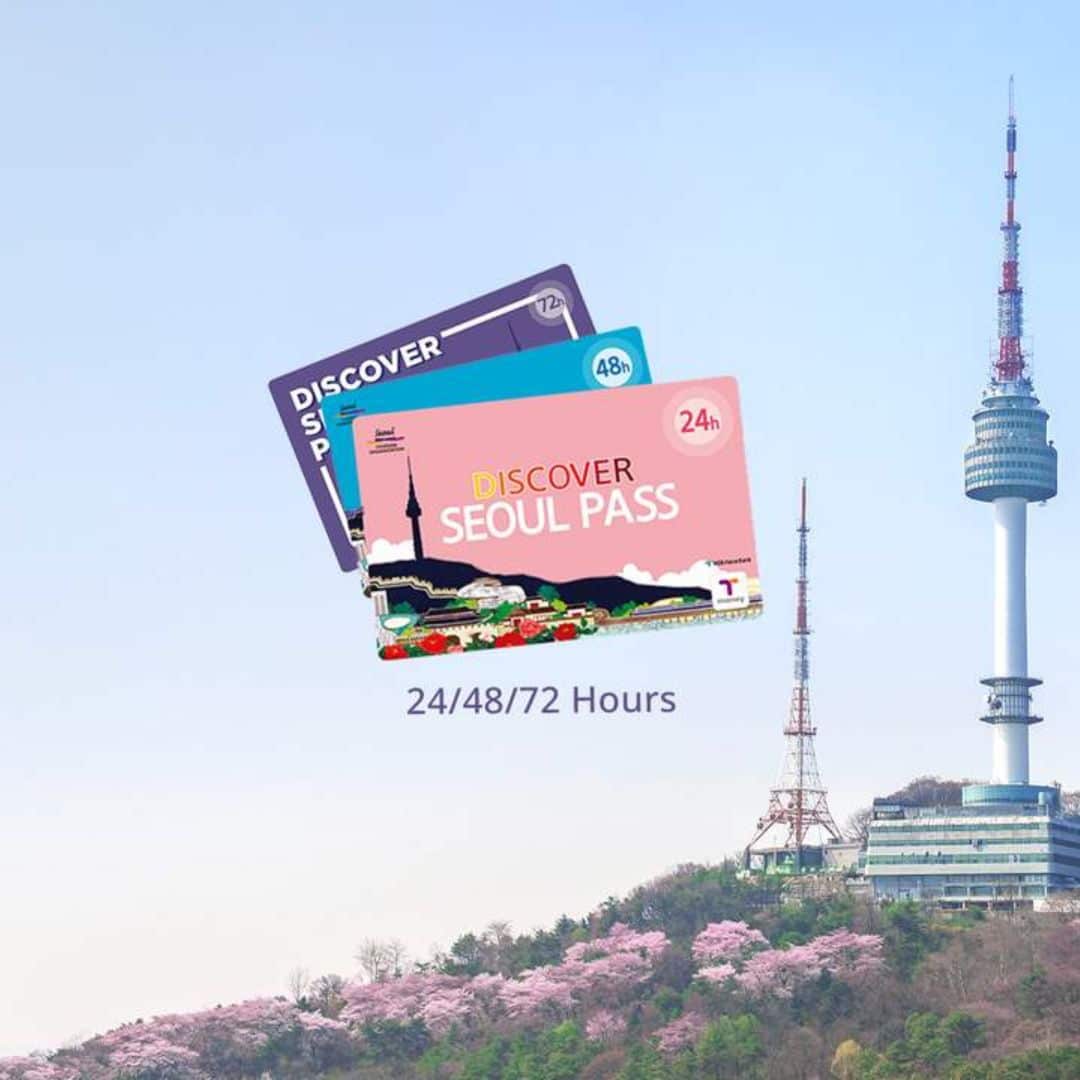
Save With The Discover Seoul Pass
Travelers to Seoul have a lot of options for incredible attractions to enjoy and experience. However, tourists, especially families, can find that the cost of these attractions quickly add up, especially when you are visiting many locations in a short time.
A great way to save money when you travel in Seoul is to buy a Discover Seoul Pass – a special card that offers you big savings on some of Seoul’s top attractions, as well as other benefits.
If you plan to visit Seoul’s Royal Palaces, N Seoul Tower, Lotte World Adventure Theme Park, the COEX Aquarium, Alive Museum, Seoul Zoo, or other premium attractions, you can gain free entry when you purchase a Discover Seoul Pass.
Not only that, you can also get a free river cruise, free hanbok rental, free ride on the Airport Express from Incheon Airport to Seoul, free City Tour Bus Ride, free T-Money Card and lots more.
The Discover Seoul Pass is valid for 24 | 48 | 72 hours and is valid from the moment you first use it until that many hours later.

Things To See & Do In Korea
If you want to build your own itinerary for South Korea, then this section of the South Korea Travel Guide will provide the building blocks you need to craft the perfect trip.
South Korea is a country packed with famous landmarks and sights, unique culture – modern & historical, family-fun activities, outdoor adventures, cozy cafe districts, and natural wonders. There’s more to do in Korea than you could imagine and it’s impossible to explore it all in one trip. Try to plan your itinerary by cities and locations. For example, plan your day in Seoul stay by district.
Here are some of the best things to see and do in South Korea, broken down into different themes so you can find things that interest you the most. The location of each of these attractions is included, too, so you can create a city by city itinerary, seeing the best South Korea has to offer.
These attractions are available all year round so whenever you go to Korea, you can enjoy them. There are plenty of things to see and do in Korea that only happen during certain seasons. Check out the Season Guide in this South Korea Travel Guide for more information about Korean festivals and seasonal events.
Here are 10 of the best Korean landmarks:
- Lotte World Tower (Seoul)
- Bukchon Hanok Village (Seoul)
- Nami Island (Gapyeong)
- Banwol ‘Purple Island’ (West Coast)
- N Seoul Tower (Seoul)
- Dongdaemun Design Plaza (Seoul)
- Seoraksan National Park (Gangwon Province)
- Hwaseong Fortress (Suwon)
- Cheonggyecheon Stream (Seoul)
- Gamcheon Cultural Village (Busan)
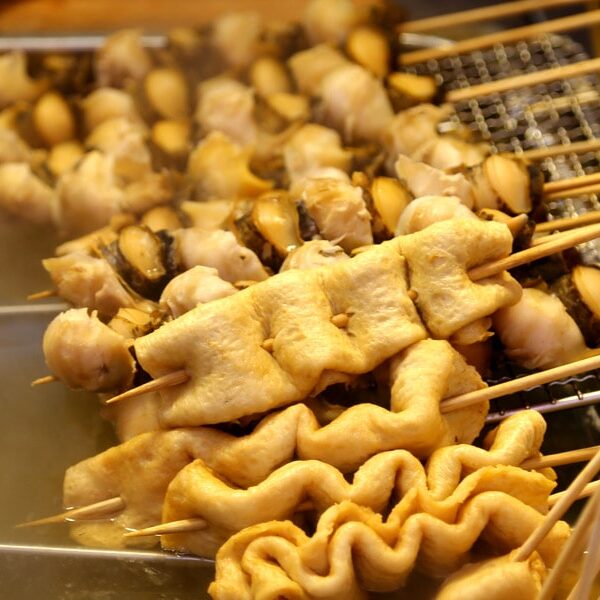
Why travel to a diverse country such as Korea and not embrace the local culture? Here are 10 of the best unique Korean experiences you can only enjoy fully in Korea. Be brave, try something new and create lasting memories of your Korean adventure.
Here are 10 of the best uniquely Korean experiences:
- Wear Traditional Korean Hanbok (Royal Palaces)
- Sing In A Korean Noraebang (Everywhere)
- Sleep In A Korean Hanok House (Hanok Villages)
- Visit The Kimchi Museum (Seoul)
- Eat Street Food (Traditional Markets)
- Experience A Korean Temple Stay (National Parks)
- Drink Makgeolli – Korean Rice Wine (Everywhere)
- Visit The World’s Most Dangerous Border – The DMZ
- Relax In A Korean Sauna (Everywhere)
- Visit A Korean Green Tea Field (Boseong, Jeju)

Here are 10 of the best Korean historic sights:
- Gyeongbokgung Palace (Seoul)
- The Secret Garden (Seoul)
- Bulguksa Temple (Gyeongju)
- Jeonju Hanok Village (Jeonju)
- Seoul Fortress Walls (Seoul)
- Haedong Yonggungsa Temple (Busan)
- Andong Hahoe Folk Village (Andong)
- Gyeongju Historic Area (Gyeongju)
- Baekje Historic Area (Gongju, Buyeo)
- Jangsaengpo Whale Museum (Ulsan)

Here are 10 of the best modern K-Culture spots:
- K-Pop Headquarters (Seoul)
- HYBE Insight (Seoul)
- COEX Artium (Seoul)
- K-Style Hub (Seoul)
- Hongdae Shopping Street (Seoul)
- Hallyu K-Star Road (Seoul)
- Asia Culture Center (Gwangju)
- Busan International Film Festival Square (Busan)
- MBC World Theme Park (Seoul)
As you’ll see, there’s just so much to see and do in Korea. You could spend a whole week in Seoul and not run out of exciting activities to do and sights to explore. Our advice is to try to avoid planning to do too many things in one day and adding in plenty of free time.
There’ll be many random things that catch your eye, such as a curious side street, or your nose, like the delicious smells from a food stall. Make sure you’ve got flexibility in your schedule to investigate these surprises and to take a rest if you need to – walking and traveling for days on end can get tiring.
Korea comes alive at night and markets and city streets are often best explored after the sun goes down. Drab concrete buildings come alive with neon signs, lanterns, and electric lights and are quite a sight to be seen. Visit popular tourist attractions such as the royal palaces and hanok villages during the morning as they’ll be less crowded.
If you plan to visit the Secret Garden in Changdeokgung Palace (you really should!), tickets are available on the day and sell out fast. Getting to these places early can guarantee you get tickets, see the sights unobstructed, and have time in the evening to soak up the night life and culture.
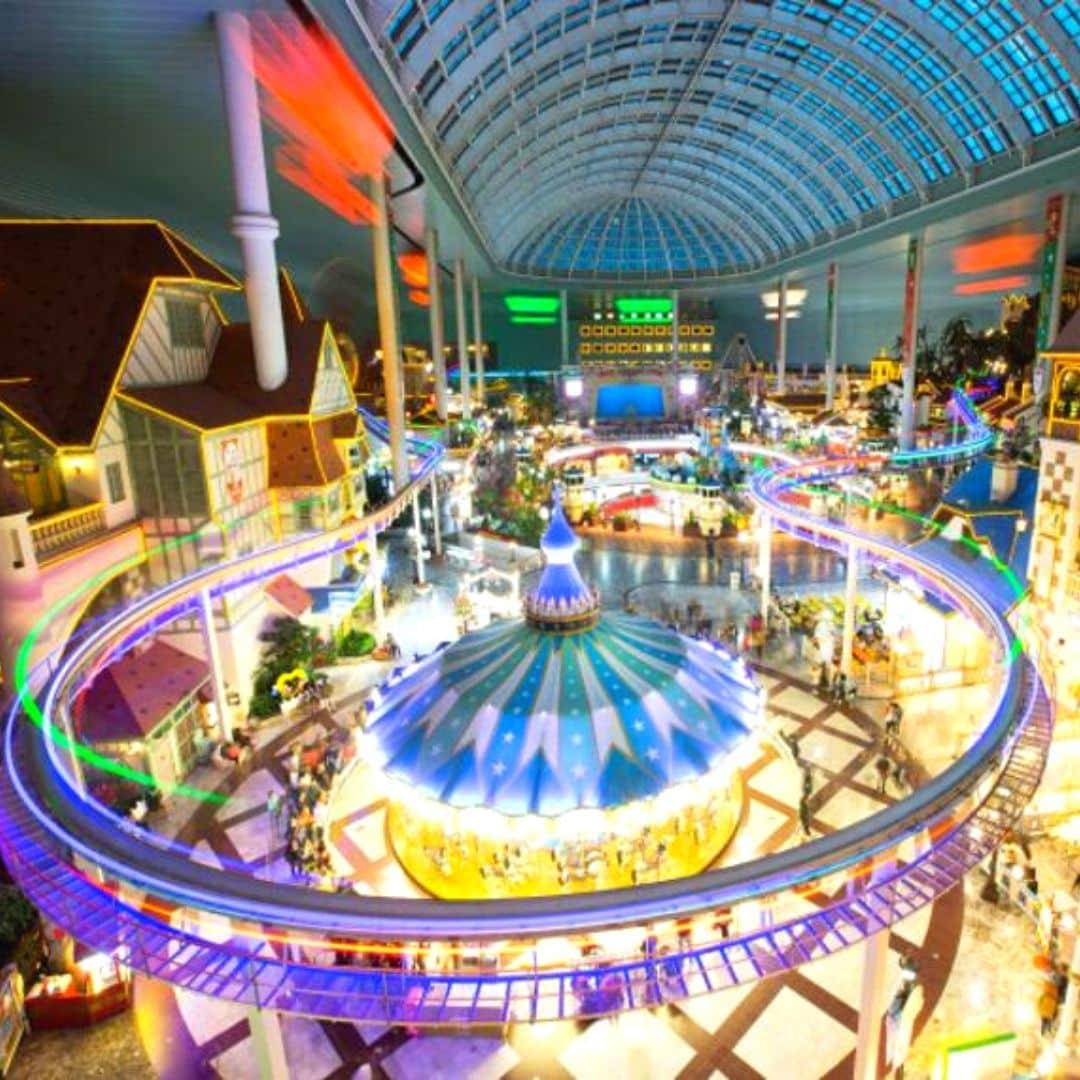
Here are the 10 best family-friendly activities in Korea:
- Nami Island & Garden of Morning Calm (Gapyeong)
- Seoul Grand Park & Zoo (Seoul)
- Lotte World Adventure (Seoul, Busan)
- Alive Museum & Dynamic Maze (Seoul)
- Seoul Children’s Grand Park (Seoul)
- Seoul Children’s Museum (Seoul)
- Everland & Caribbean Bay Theme Parks (Near Seoul)
- Sea Life Busan Aquarium
- Jeju Dinosaur Island (Jeju)
- Alpaca World (Gangwon Province)
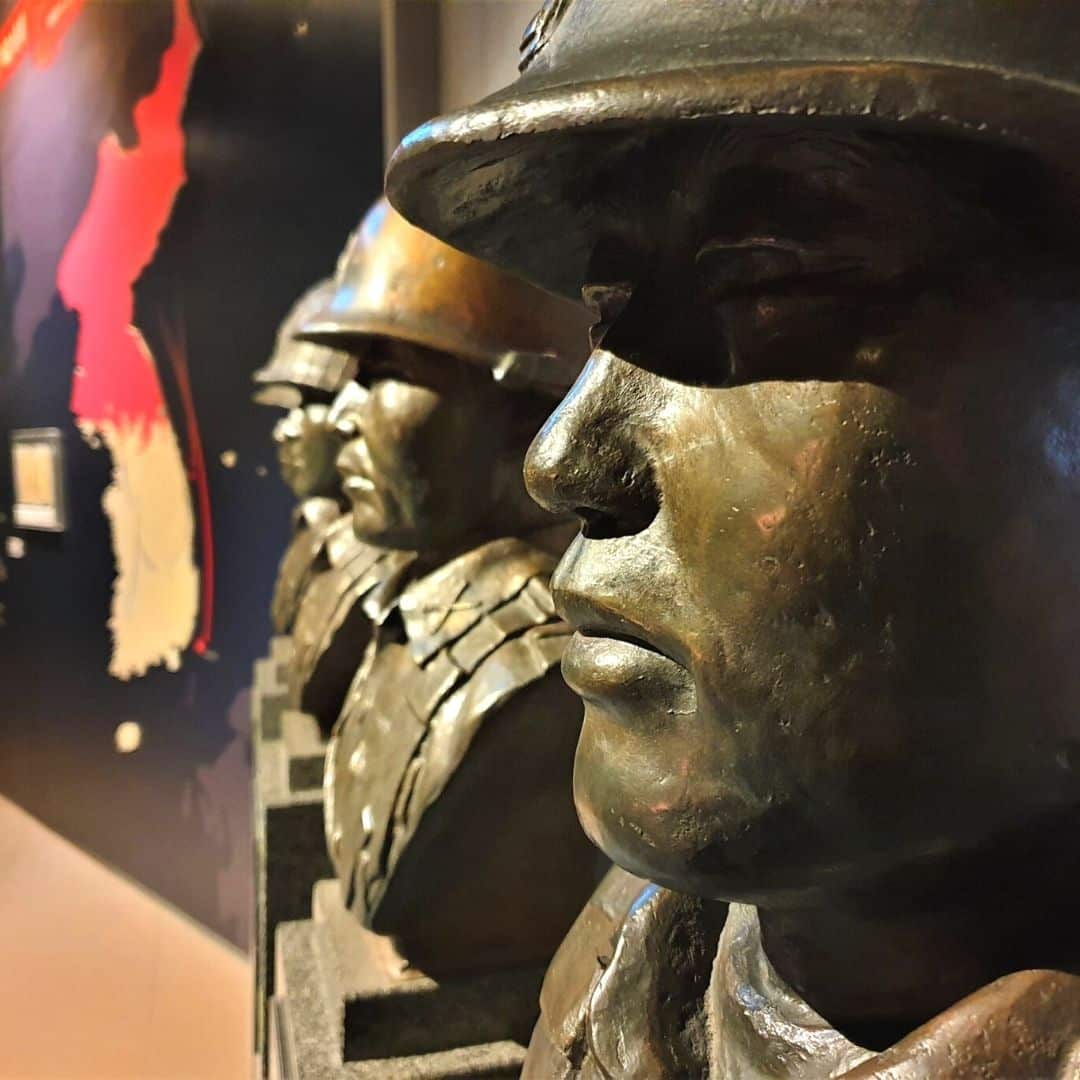
Here are the 10 best museums & galleries in Korea:
- National Museum of Korea (Seoul)
- Seoul Museum of Art (Seoul)
- Gyeongju National Museum (Gyeongju)
- War Memorial of Korea (Seoul)
- National Folk Museum of Korea (Seoul)
- National Maritime Museum (Busan)
- Seodaemun Prison History Museum (Seoul)
- Seoul Museum of History (Seoul)
- Museum Kimchikan (Seoul)
- Daegu Art Museum (Daegu)

Here are the 10 best cafe areas in Korea:
- Ikseondong Hanok Village (Seoul)
- Gyeongui Line Hongdae (Seoul)
- Samcheondong Cafe Street (Seoul)
- Jeonpo Cafe Street (Busan)
- Hwangnidan-Gil (Gyeongju)
- Gangneung Coffee Street (Gangneung)
- Sinsa-Dong / Garosugil Road (Seoul)
- Jukjeon Cafe Street (Seoul)
- Hwaseong Haenggung Area (Suwon)
- Kim Kwang Seok Gil Street (Daegu)

Here are 10 of the best Korean markets and shopping areas:
- Gwangjang Market (Seoul)
- Myeongdong Market Area (Seoul)
- Jagalchi Fish Market (Busan)
- Centum City Mall (Busan)
- IFC Mall (Seoul)
- Starfield COEX Mall (Seoul)
- Nambu Market (Jeonju)
- Seomyeong Underground Shopping Center (Busan)
- Seogwipo Maeil Olle Market (Jeju)
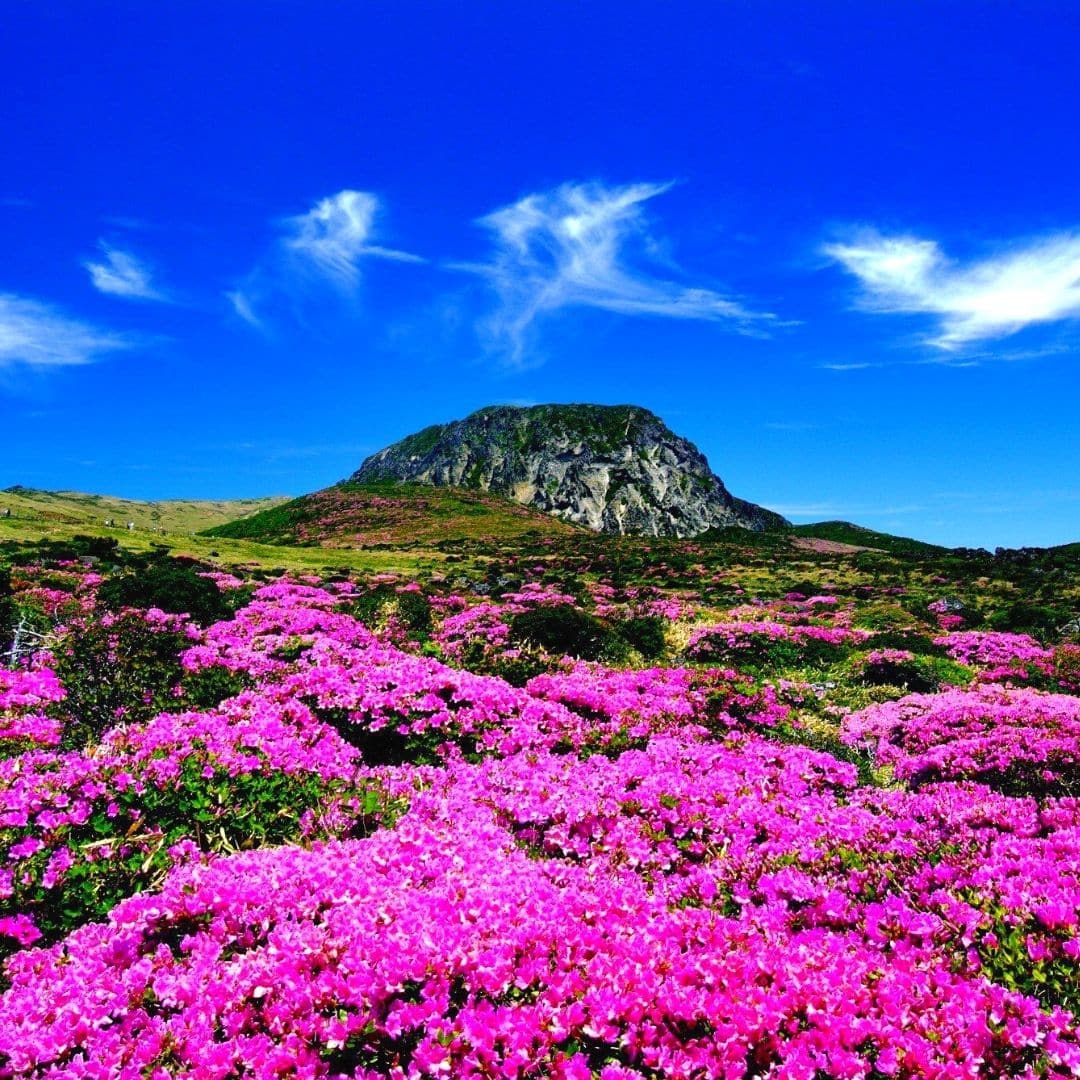
Here are 10 of the best natural sights in Korea:
- Hallasan Mountain (Jeju)
- Jirisan National Park (Jeollanam Provice)
- Seoraksan National Park (Gyeonggi Province)
- Seongsan Ilchulbong Sunrise Peak (Jeju)
- Damyang Juknokwon Bamboo Forest (Damyang)
- Boseong Green Tea Plantation (Boseong)
- Haeundae Beach (Busan)
- Udo Island (Jeju)
- Hwaamdonggul Cave (Gangwon Province)

Travel Itinerary For Korea
When planning a travel itinerary for South Korea, it’s best to think about what kind of experience you want when you travel to South Korea and build your itinerary from that. What kind of traveler are you and what do you want to take away from your Korea trip? Are you planning a trip for yourself, for your family, or as a romantic escape?
Do you want to learn about traditional Korean culture and history? Are you visiting to immerse yourself in modern Korean culture and maybe meet your idols? Are you planning to get out into Korea’s mountains to hike and join a Buddhist Temple Stay? Or are you going to eat, drink, shop, and make the most of Korea’s discounted goods? Or all of the above?
This section of this South Korea Travel Guide will offer some of the best one-week and two-week itineraries for South Korea. These itineraries are rough guides, created to help you begin planning your trip. Feel free to pick and choose the parts from them that you like to create your own travel itinerary for South Korea. We’ll be adding more great itineraries soon, be sure to check back for the latest ideas.
Classic 1 Week Itinerary For Korea: Seoul, Busan, Gyeongju
This is one of the most popular of the 1-week itineraries for South Korea and will take you to the most famous and interesting places that are top of most travelers’ South Korea bucket lists. Starting in Seoul, Korea’s capital, you’ll explore the best sights in this city before taking a day trip out to the lovely Gapyeong County to get a breath of fresh Korean countryside air.
From day 4, zip across the whole of Korea on the high-speed KTX train and explore Korea’s second city, Busan. See coastal temples, fish markets, wide beaches, and more in Busan before taking a day trip to Korea’s historic UNESCO World Heritage City, Gyeongju. On the last day, it’s time to return to Seoul to pack your bags full of the best souvenirs and snacks and say farewell in the highest part of the city.

Afternoon : Dressed in your hanbok, enjoy more traditional Seoul with a walk around the narrow streets of the Bukchon Hanok Village. Visit traditional Korean teahouses, galleries, markets, and more.
Evening : Check out the stalls and shops of artsy Insadong, contemplate Jeogyesa Temple, and take an evening stroll along the Cheonggyecheon Stream before dining in Myeongdong or the Jonggak Avenue of Youth. This Full Day Tour of Seoul will show you some of the hottest spots in the city, while this Customized Private Tour of Seoul will allow you to choose where to go.
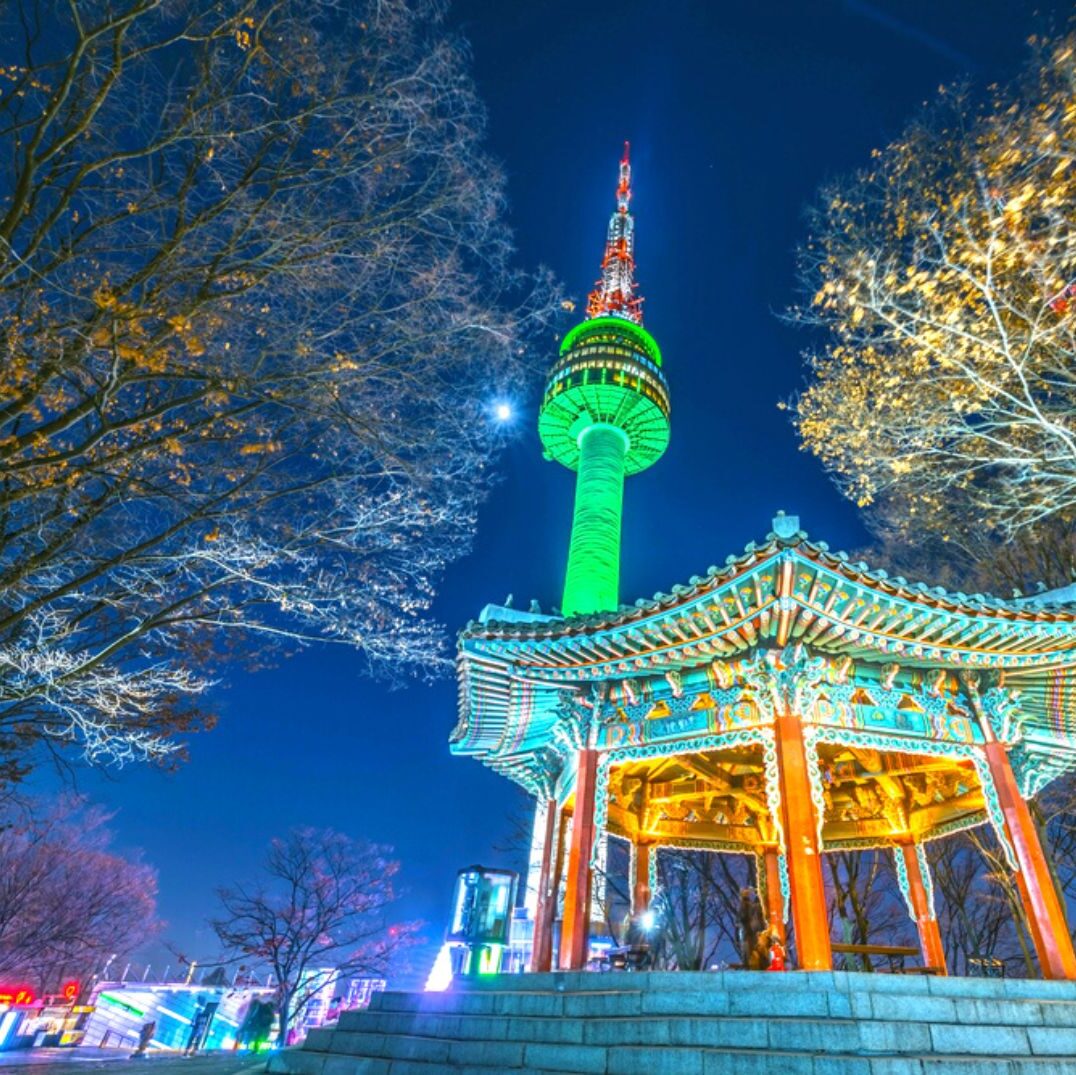
Afternoon : Head back to central Seoul and witness the bustling sights and delicious smells of Seoul’s traditional Gwangjang and Dongdaemun Markets. Try delectable Korean street foods here.
Evening : Take the Namsam Cable Car to the top of Namsan Mountain and watch the sunset from N Seoul Tower. See some of Seoul’s fortress walls before heading back down to go late-night shopping at Myeongdong Market.
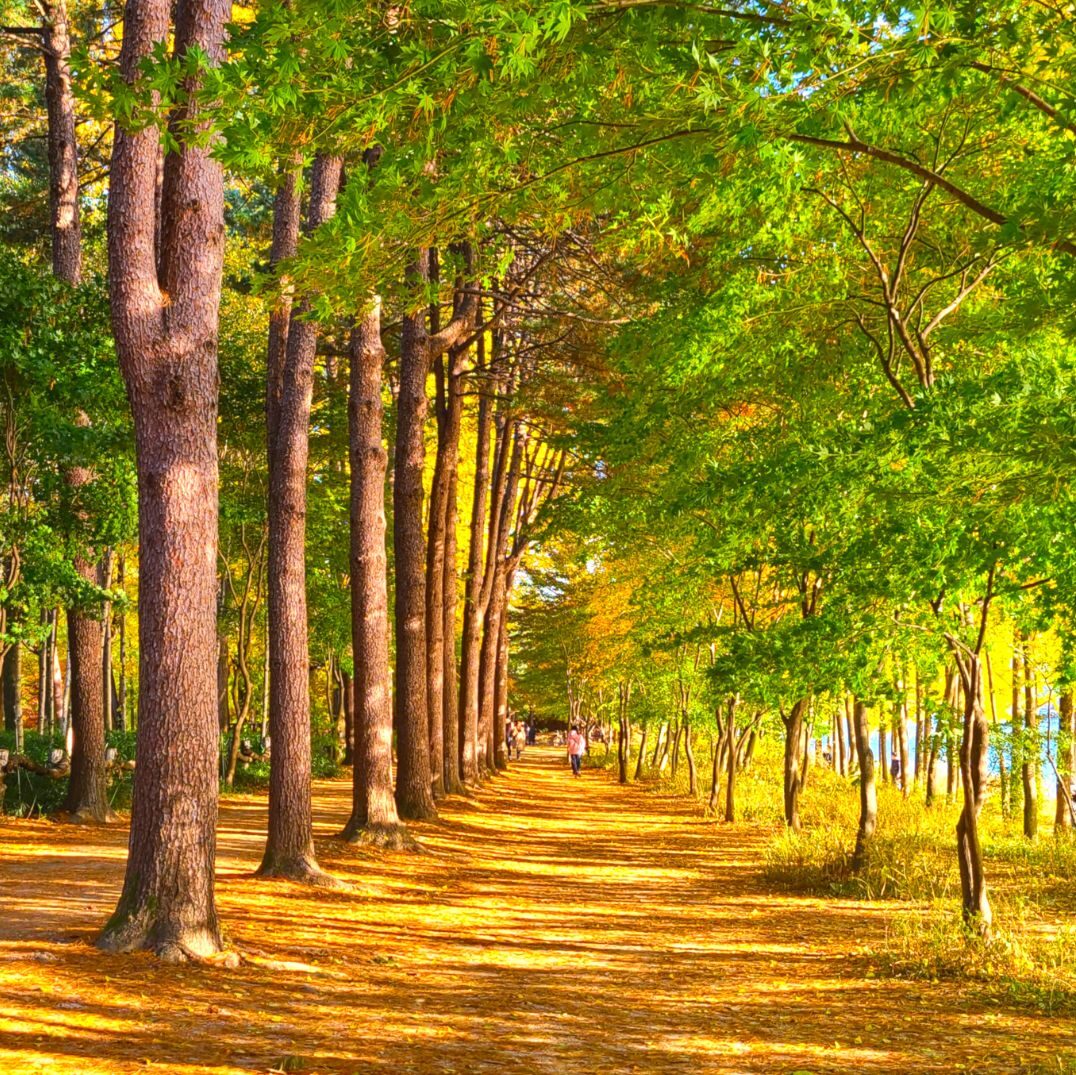
Afternoon : Zip line or sail over to Nami Island for impressive nature, bike rides, leafy walks, and cozy cafes. See popular scenes from K-dramas and even some wild animals, like deer and rabbits.
Evening : Pedal your way along an abandoned railway at the Gangchon Rail Bike Park before heading back to Seoul for fine dining in Gangnam’s Apgujeong Rodeo district.
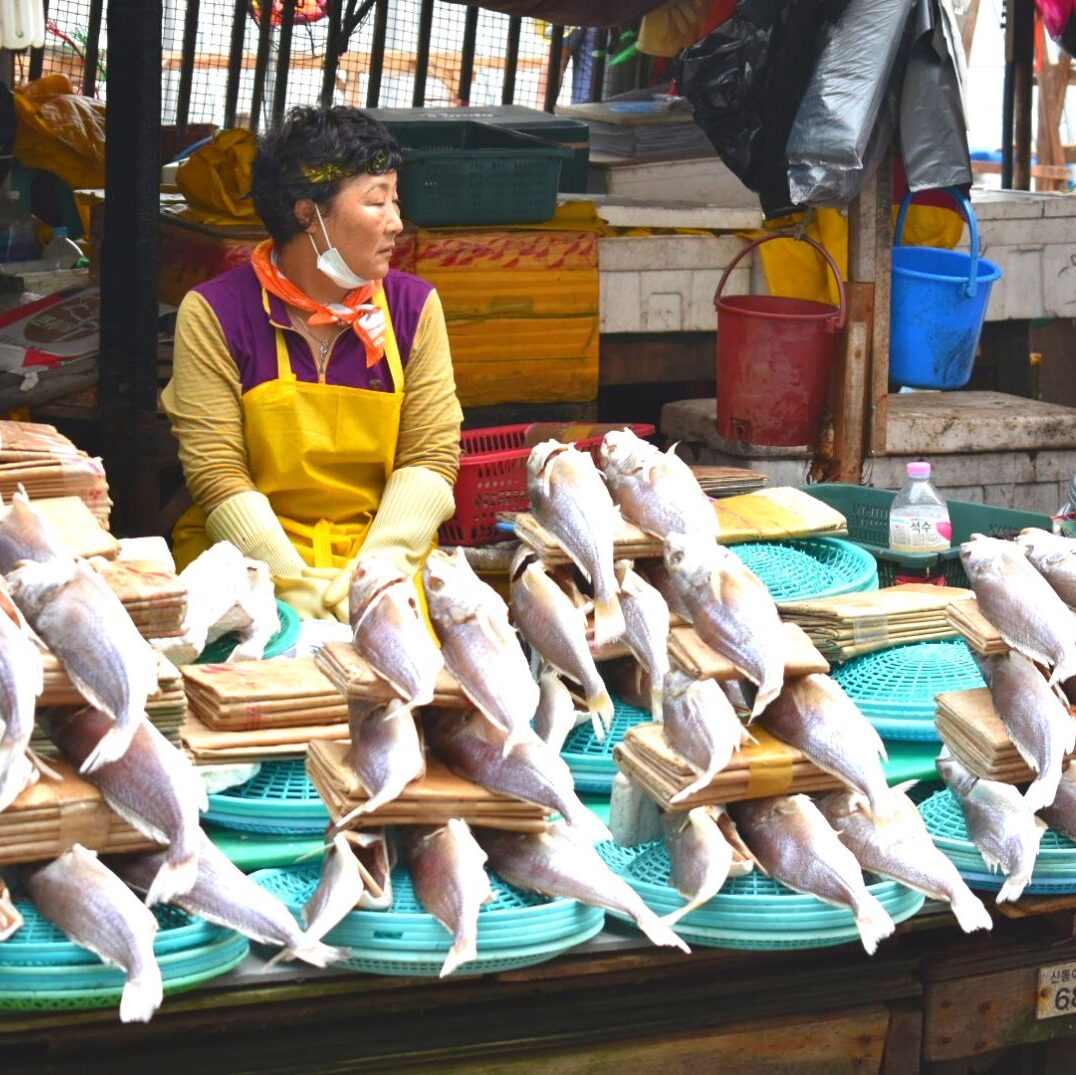
Afternoon : Head to the Nampo-dong near Busan Station and visit Jagalchi Market for a fresh seafood lunch. Then explore cosy Bosu-dong Book Alley or take a taxi to the Huinnyeoul Culture Village.
Evening : Take the subway up to Haeundae Beach for Busan’s best night-scenes. Grab dinner overlooking the beach, or at one of the market stalls. If you’re feeling brave, visit BUSAN X the SKY to see breathtaking views over the coast and city.

Afternoon : Head to the Gyeongju Gyochon Traditional Village for a traditional meal and to see the stunning Woljeonggyo Bridge. Gyeongju National Museum is nearby, too.
Evening : See the tranquil night views of Wolji Pond where palace buildings reflect perfectly in still waters. Stop at Hwangnidan-gil area for dinner and drinks before returning to Busan.
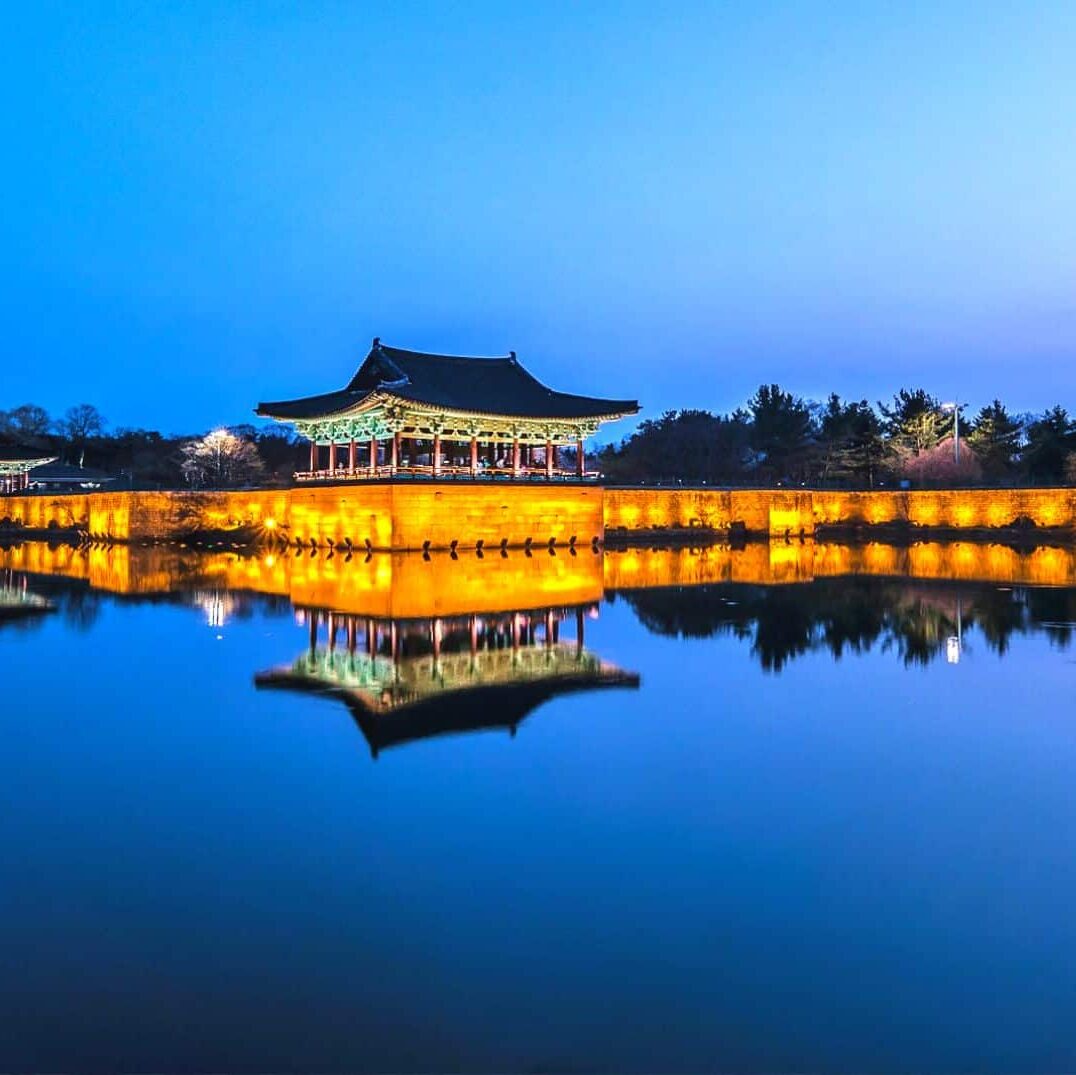
Afternoon : Explore the artistic shopping streets of Hongdae for last minute souvenirs and gifts for yourself. Take a break in one of the unique animal or artsy cafes.
Evening : Either take a night cruise along the Han River from Yeouido Hangang Park or dine in style at the Lotte World Tower in Jamsil, the world’s 6th tallest building. Both offer great night views of Seoul and unforgettable memories to take home.

Korean Seasons Guide
The best time to visit South Korea is during the warm spring or fall seasons. The weather is mild and clear, there’s a range of festivals and seasonal activities to enjoy, and you can travel to Korea comfortably.
The best months to visit are April, May, September, and October. These months are all during the Korean school semester, so there won’t be as many local travelers around during the weekdays. However, expect the weekends to be busy as people leave the cities to travel within Korea.
Large public holidays, including Chuseok (mid-autumn festival) in September / October) and Buddha’s Birthday (May), provides travelers with the opportunity to experience Korean culture and celebrations. These holidays change each year based on the lunar calendar.
Korean Weather & Climate
South Korea is a country that experiences four very distinct seasons, with temperatures ranging from 100 Fahrenheit in the summer to below 0 Fahrenheit in the winter. Each of South Korea’s seasons brings opportunities to see unique natural views and enjoy the different climates in Korea.
Spring has some of the gentlest weather, with light rain and a quick jump in temperature to the 60s and 70s by late March. Summer begins with the rainy season in late June and becomes extremely humid and hot throughout July and August before cooling again in September.
Fall has the best weather in Korea, with many warm, sunny days. Cold winter weather appears very quickly in mid-November and the first snow usually appears by late November. Winter is dry and sunny with the lowest chance of rainfall but is also very cold. Snow isn’t constant, but can fall for several weeks on and off during winter.
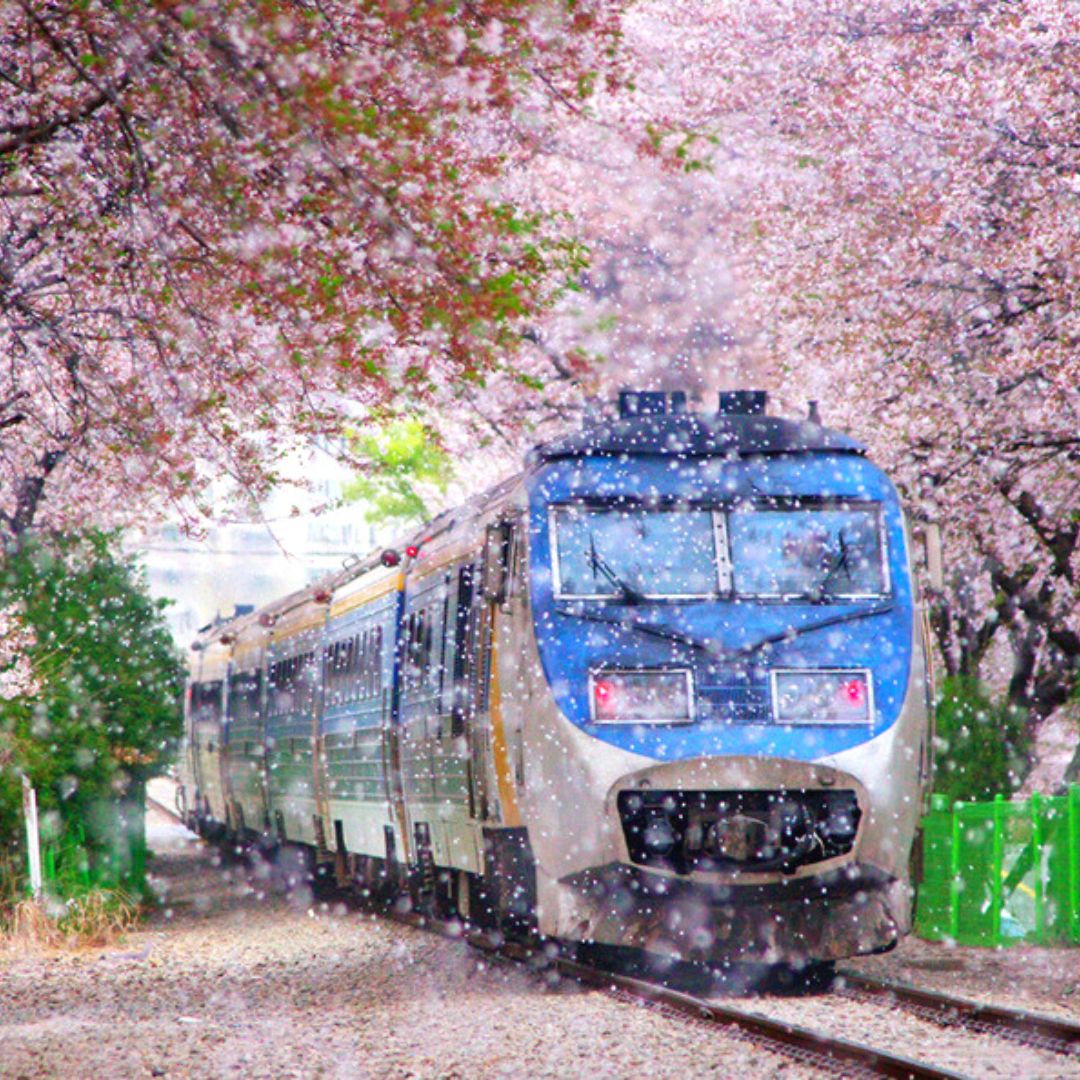
Visiting in spring offers the chance to see beautiful cherry blossoms stretch across the country, as well as many other spring flowers that brighten up Korea after a cold winter.
Spring starts in late March with the awakening of the cherry blossoms and ends in early June with the start of the rainy season. South Korea is a country with a close connection to nature, which can be witnessed in the many spring festivals and celebrations that happen throughout the year.
Some of the best spring festivals include the Jinhae Cherry Blossom Festival, Damyang Bamboo Forest Festival, Yeon Deung Hoe Lotus Lantern Festival, Jindo Sea Parting Festival, and Boseong Green Tea Plantation Festival.

The weather in summer is perfect for getting outside and relaxing on one of Korea’s many beaches. Some of the best activities include spending a weekend camping or glamping by the beach, hiking in shaded valleys in the national parks, and water sports such as surfing, kayaking, and scuba diving.
Unfortunately, the heat may put off some travelers, and high humidity makes it uncomfortable to move around too much. Fortunately, Korea is a modern country with lots of air-conditioning and ways to deal with the hot weather, including delicious summer dishes.
Cool down with a bowl of Korean bingsu (shaved ice dessert) or a cool latte in one of the many cozy Korean cafes in popular beach destinations.

Travelers to Korea in the fall are treated to spectacular fall foliage creeping far and wide. You can see it falling on palace grounds, sprawled on mountains in national parks, and along city streets.
The start of the fall foliage season in Korea coincides with the end of the hot and humid summer, with clear skies and cool weather, making it the perfect time to travel in Korea. Like spring, the fall season in Korea is one of the festivals and celebrations.
The Chuseok holidays in late September / early October are the biggest public holidays of the year, with cultural events held in popular tourist destinations. There’s also a range of cultural festivals, such as the Andong Mask Festival, Baekje Culture Festival, Jinju Namdang Yudeung Lantern Festival, Jeonju Bibimbap Festival, and the Seoul Kimchi Festival.

Winter, like summer, has more extreme weather than spring and fall, with temperatures often in the 20s and 30s and below. This season, however, is also one of the best for travelers who want to see clear, blue skies and experience good weather.
Winter is the driest season and it very rarely rains. If you don’t mind the cold weather, it’s perfect for traveling around South Korea. One of the biggest draws during winter is the chance to see snowy Korean landscapes, from snow-bedecked royal palaces to frosty peaks atop Korea’s many mountains.
Winter sports are popular in Korea, with ski and snowboard resorts aplenty. Winter also offers the chance for family fun with winter attractions including sledding, winter illuminations, and Christmas parades.

Cost To Travel To Korea
The cost to travel in South Korea largely depends on your personal style of travel. You can travel on a low budget in Korea, for under $50 per day, or you could also travel for 10 times that amount if you wished to.
Food costs range from a few dollars for a bowl of jajang (black soybean) noodles to hundreds for premium hanwoo (Korean beef) steak. The same applies to accommodation, with budget hostels costing $10 per night and premium 5 stars hotels costing hundreds.
Most travelers to Korea will already know what they want to prioritize their spending on. Some travel to Korea to eat, others to shop, and many more to experience the unique culture and history that Korea has to offer.
The costs in this section of our South Korea Travel Guide are based on the latest costs in Korea from this year. Examples of different costs have been covered to give you an idea of what to expect when you try to budget.
Please note, these prices are based on traveling in Seoul during non-peak times. Prices may be higher in peak times, which include cherry blossom season (Apr) and fall foliage season (Oct). Popular tourist cities, such as Gyeongju and Jeonju, may also have higher prices on weekends.
How Much Does It Cost To Travel In South Korea?
Travelers may find they want to spend more on hotels and less on eating out, or vice-versa, so don’t feel like you have to only follow the costs for one section. This is only a guideline to help you plan based on your own personal preferences.
To make it easier to figure out your expected costs to travel in Korea, this South Korea Travel Guide has broken down the costs into 3 different categories. These categories loosely fit 3 different types of travelers, as described below:
- Accommodation: $200+ per night, per room (double)
Korea has a wide range of luxurious hotel options, including rooms in the Lotte World Tower, historic hanok houses, and glamping for those who want to escape to the countryside.
- Food & Drink: $100+ per day, per person
It’s easy to spend a lot on food and drink in Korea as there are so many delectable restaurants. Fresh seafood, Korean steak, or the finest foreign foods are all available.
- Transportation: $20+ per day, per person
Taxis and transportation are relatively cheap in Korea. A taxi journey across Seoul can cost less than $20 for 30 minutes and even the 1st class options on Korea’s high-speed trains are under $100 for the longest journey (Seoul to Busan).
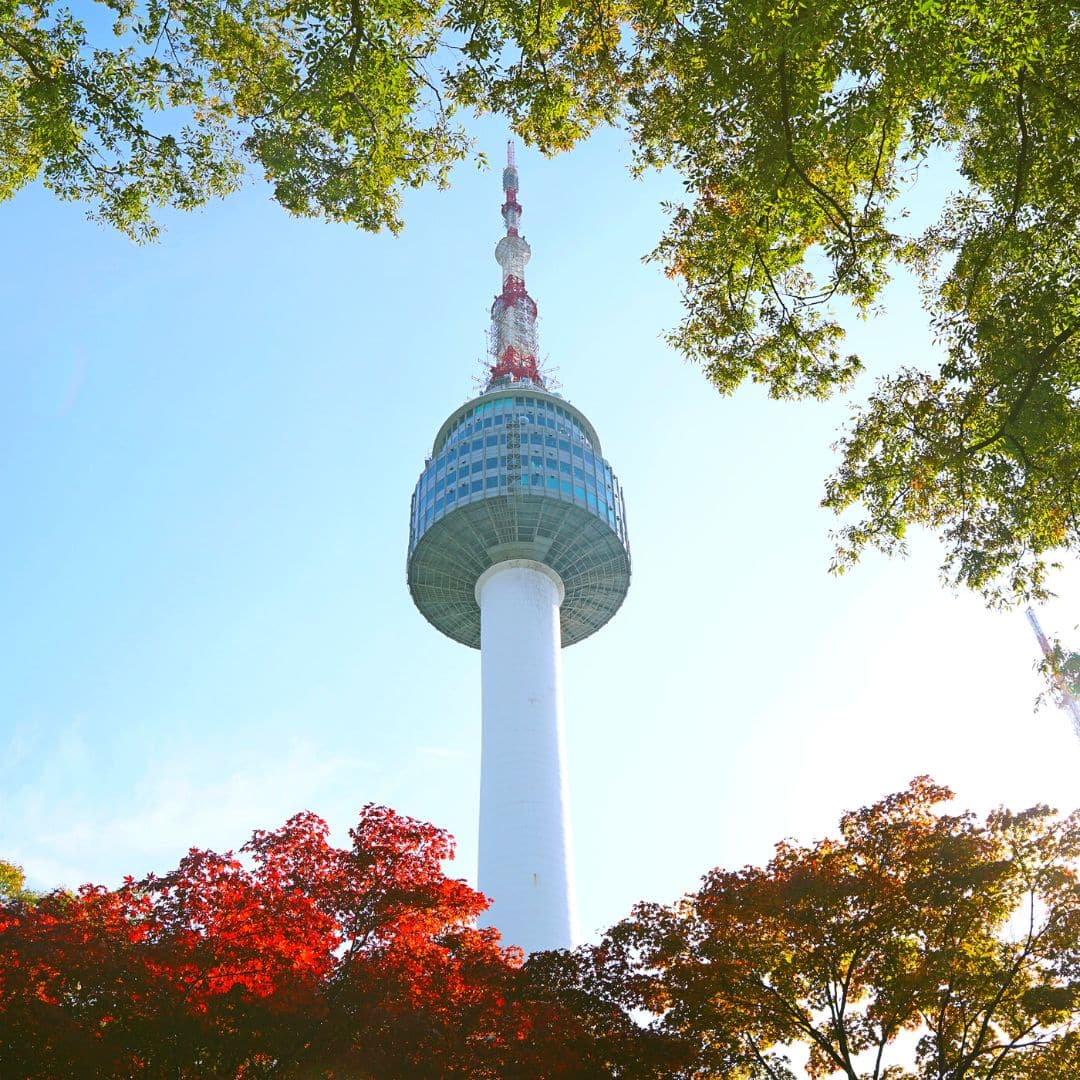
- Accommodation: $100 ~ $200 per night, per room (double)
You can book 4-star hotels in Seoul for very reasonable prices and enjoy both comfort and lower prices than you’d find at home. Korea has a wide range of comfortable mid-priced hotels.
- Food & Drink: $50+ per day, per person
With all-you-can-eat Korean restaurants that serve unlimited Korean BBQ and other dishes for under $20 or $30 per person, it’s easy to enjoy the best food Korea has to offer without breaking the bank.
- Transportation: up to $15 per day, per person
Use the subway and buses to get around the big cities and trains to travel further around Korea without breaking the bank. You can even splash out on a taxi and pay only a few dollars per person when traveling as a group for a few dollars extra.
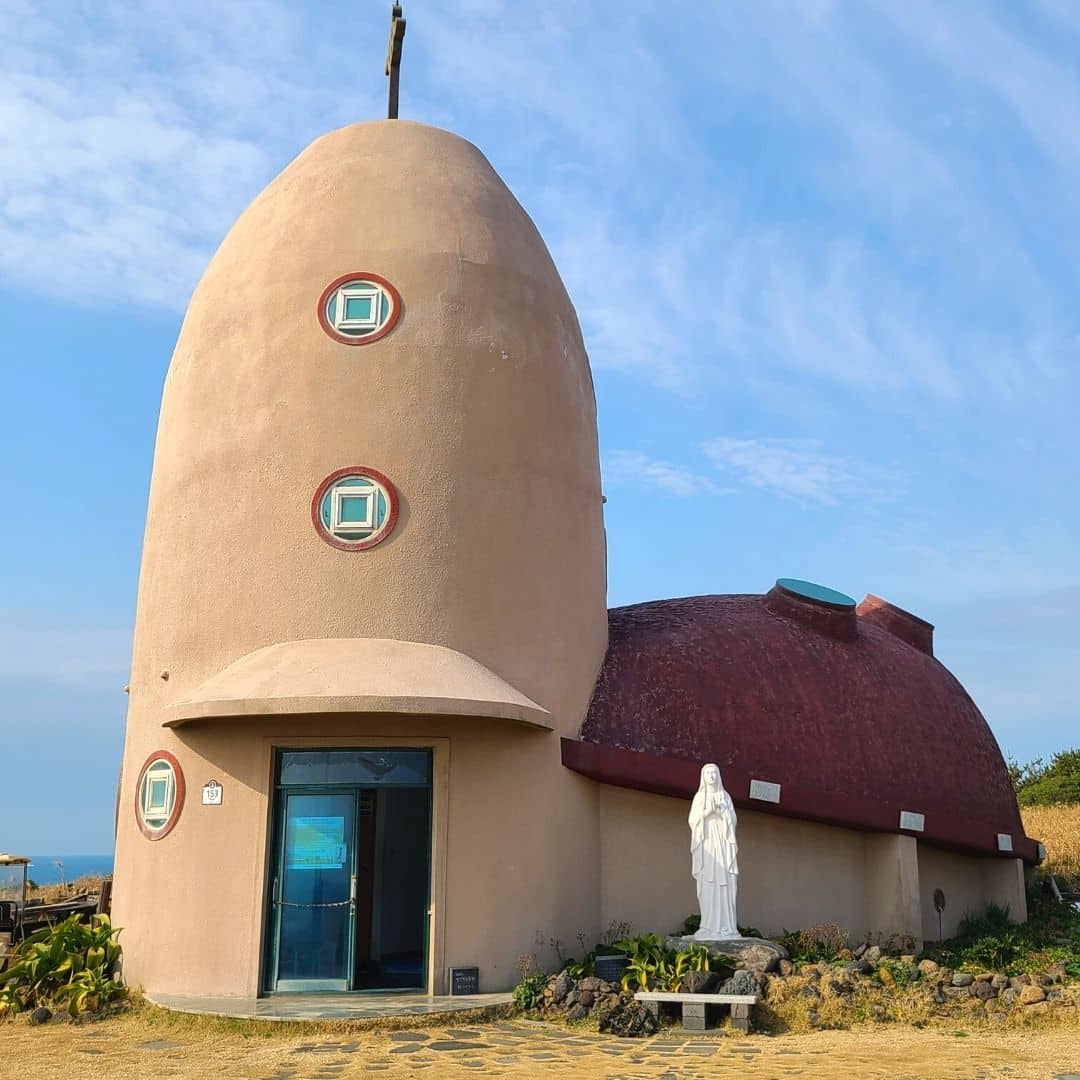
- Accommodation: up to $100 per night, per room (double)
Hostels and guesthouses can be found for under $50 per night and are perfect for somewhere to rest and recharge. If that’s all you need, save money here and spend it elsewhere.
- Food & Drink: $20 – $30 per day, per person
If you budget well and stick to street food, free hotel breakfasts, and convenience store foods, you can eat well and still have enough to splurge on good food for dinner.
- Transportation: up to $10 per day, per person
Walking and buses are cheap and convenient ways to travel around Korea’s biggest cities. Traveling from city to city is also cheap, with intercity buses costing less than $10 for 1-2 hour journeys.

Further Costs To Travel In South Korea
Besides these everyday costs to travel in South Korea, there are other costs that you’ll need to cover from time to time. These costs include internet & phone access, day trips, activities, souvenirs, travel insurance, and flights. These costs will be broken down into low and high-end costs that you can expect to pay in Korea.

Museums and galleries offer unique (and authentic) Korean souvenirs such as pottery, painting, tea & soju sets, and more. If you want something a bit more special, head to the underground markets near Gwangjang Market in Seoul and get your own handmade hanbok, which you can get posted back home to save luggage space.
- Small Souvenirs: $5+
- Korean Cosmetics: $5+
- Korean Artworks: $10+
- Korean Tea (box of): $10 to $20
- Korean Soju Set: $10 to $20
- Korean Handcrafts: $10+
- Tailored Hanbok: $200+
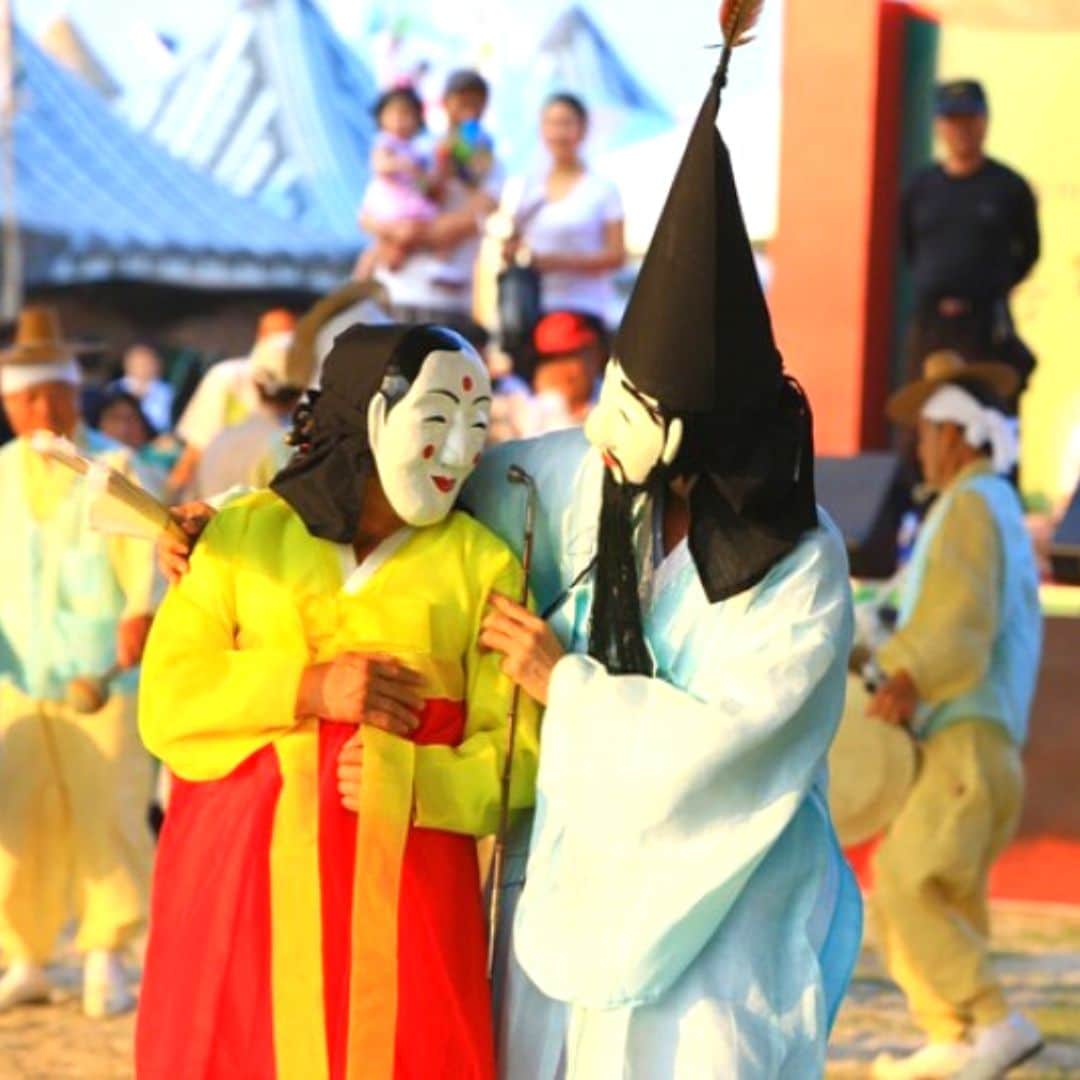
The day trip prices quoted below are the prices you can expect to pay with a reputable tour company like Klook or Trazy . Hiring a private guide will be a lot more expensive and might come to $200+ per day.
Please note: The prices quoted below are estimates and may change depending on the season or tour services.
- DMZ Tour – $50 to $120
- Nami Island Area – $40 to $70
- Everland Theme Park – $30 to $50
- Jeonju Hanok Village – $50 to $70
- Korean Folk Village – $50 to $60
- Seoraksan Mountain – $70 to $150
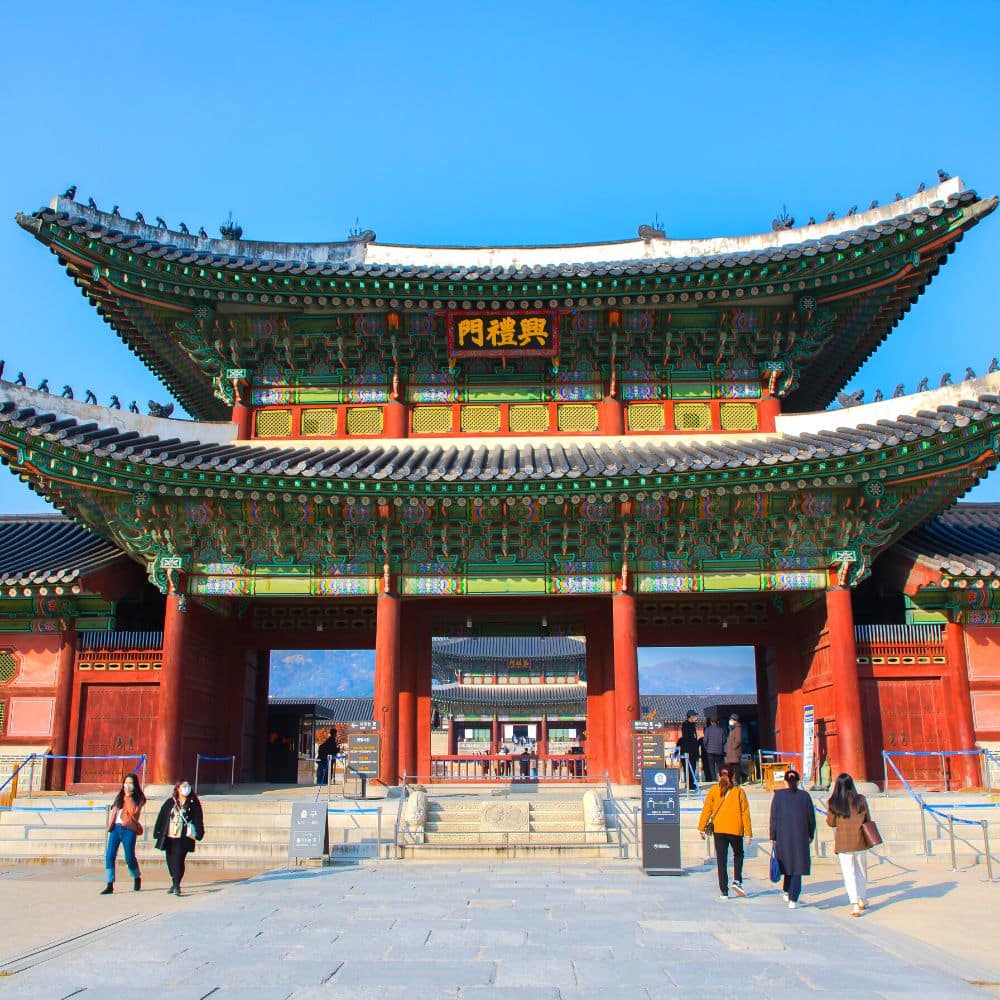
As mentioned earlier in this South Korea Travel Guide, buying a Discover Seoul Pass is a great way to save money on Seoul’s premium attractions.
- Royal Palaces – $3
- N Seoul Tower – $10
- Hanbok Rental – $10+
- Seoul City Tour Bus – $10
- Han River Cruise – $15 to $30
- Seoul Sky Observatory – $30 to $50
- Aquariums – $20 to $30
- Seoul Zoo & Seoul Grand Park $10
- Amusement Parks – $30 to $40
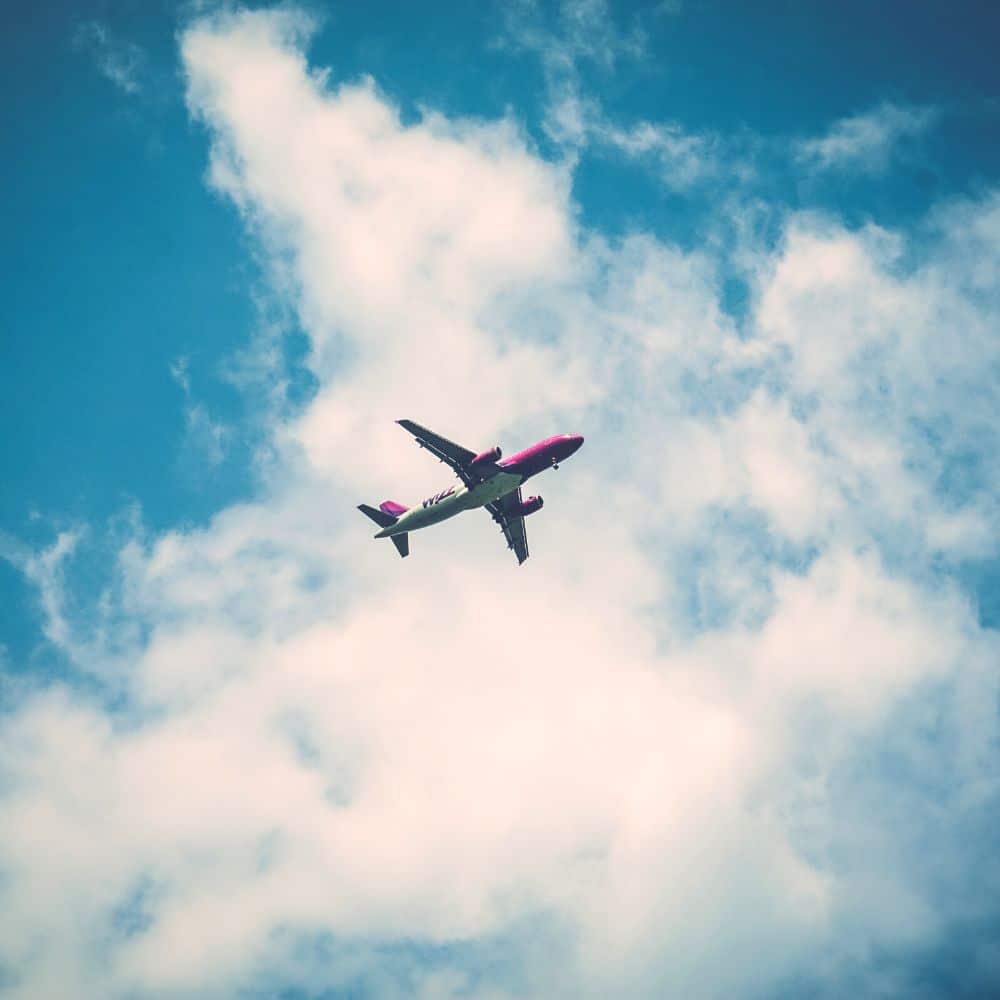
The cost to fly to Korea is more than twice the normal price right now. Fortunately, Korea ended the restrictions on the number of flights into the country from June 2022 and flight costs and availability should be improved in the near future.
Best of Korea recommends Skyscanner and Expedia for the best flight deals to Korea.

Why Travel To South Korea?
In recent years, travelers from around the world have been increasingly drawn to South Korea. The country is a must-see destination in Asia, with more than 17 million travelers in 2019. After reading this South Korea Travel Guide, you’ll understand what draws so many people to the Land of The Morning Calm, as Korea is also known.
There are myriad reasons why people visit Korea. Many come to experience life in a unique country, packed with historical and cultural sights that you won’t find elsewhere in the world. In the afternoon you can walk through a royal palace dressed in hanbok (traditional Korean clothes), sip green tea in a hanok (traditional Korean house), and pass Buddhist monks walking peacefully through an ancient temple.
Modern South Korean culture is conquering the world, with chart-topping acts that include BTS and Black Pink, Oscar-winning movies like Parasite, and phenomenally successful TV shows like Squid Game. This brings in legions of fans flocking to shooting locations and film sets to relive their favorite K-Culture moments. Some lucky travelers even get to catch sight of their favorite K-Stars walking around Gangnam, a hotspot for Korea’s most famous citizens.
Not only is Korea a beautiful country, it’s a country that will make you beautiful, with some of the world’s best fashion and beauty shops. Korea is famous for its K-Beauty products and is a beauty and fashion shoppers paradise. From the street fashions of Hongdae, to the luxurious fashion malls of Gangnam, and the wall-to-wall malls with discount clothes in Dongdaemun, you’re guaranteed to find something you can’t resist at a great price. If you prefer a cultural shopping experience, there are traditional markets all over Korea, where you can experience street food, buy novel gifts, and see how locals live and socialize.
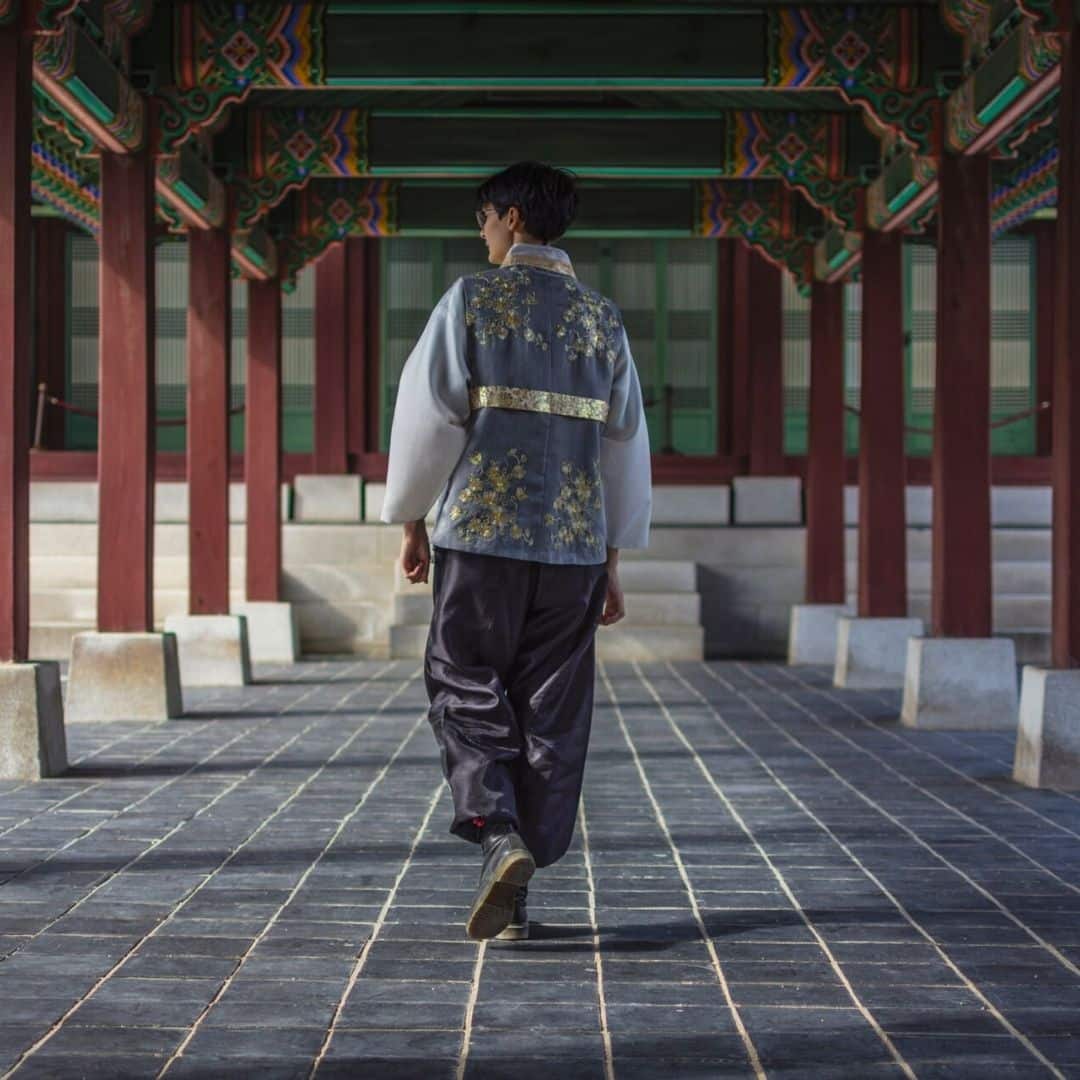
There’s so much more to South Korea than what you’ll find in the cities, however. South Korea, a country that’s 70% mountainous with coasts on three sides, offers so much to nature and adventure lovers. Hiking, South Korea’s national pastime, is a popular way to see more of the Korean countryside, looking down over rice fields, forested valleys, and pockets of urbanization. Skydiving, parasailing, scuba diving, water sports, cycling, rock climbing, white water rafting, and lots more are on offer and very reasonably priced. South Korea is a great place to enjoy the great outdoors.
The real jewel in South Korea’s natural crown, however, has to be Jeju Island – one of the New 7 Wonders of the Natural World. Explore lava caves, hike to the peak of the central dormant volcano (Hallasan Mountain), trek around the rugged coast, relax on a sandy beach in a modern cafe, and even try your hand at horse riding.
Whatever your reason to travel to South Korea, you’re sure to find more and more reasons to return again and again. Let this South Korea Travel Guide whet your appetite for your first trip, inspire you to plan a follow-up trip, and guide you to the best things to see and do in South Korea.

South Korea Travel Guide FAQs
Not sure about the South Korea travel restrictions and want to know more about visas, vaccinations, and what the rules are? This next section covers some of the most frequently asked questions about traveling to Korea now. If you have more questions that aren’t covered below, feel free to write to us on the Best of Korea Facebook page.
Do I need a visa to travel to South Korea?
US citizens and tourists from 111 other countries, including Canada and Mexico, don’t need a visa to travel to South Korea. The US government and South Korea have a visa-free travel arrangement and tourists can stay for up to 90 days.
What happens when I arrive in South Korea?
From September 2022 onwards it is no longer necessary to provide any vaccination status or take any PCR or RAT tests. A mandatory health check will be required, but this is only a simple form you can fill in on arrival.
What happens if I get a positive PCR result?
If you test positive for COVID-19 while in Korea, you will need to quarantine for 7 days at government facilities. Travelers who break the quarantine rules are subject to deportation or fines.
Can I travel to Korea if I'm unvaccinated?
Yes, you can still travel to South Korea if you’re unvaccinated. South Korea no longer restricts travel based on vaccination status (as of October 2022).
However, if a traveler (vaccinated or unvaccinated) tests positive for COVID-19 in Korea, they will have to self-quarantine until negative.
South Korea is a dynamic and culturally rich country that deserves a place on everyone’s travel bucket list. Known for its stunning blend of tradition and modernity, Korea features futuristic technology, bustling markets, and a thriving pop culture scene. Perhaps most importantly, visitors can expect a high level of safety and cleanliness while exploring the country and savoring its delicious cuisine.
This South Korea Travel Guide shows you where to go, what to see, and when to travel. Start your journey with itinerary ideas and pre-travel tips, the best day trips, and lots more essential Korean travel advice. Let’s go!
LATEST KOREA TRAVEL UPDATES
How to travel to korea, best destinations in korea, where to stay in seoul, korean travel tips, things to see & do, travel itineraries for korea, korean season guide, cost to travel to korea, further costs to korea, why travel to korea now, south korea travel faqs.
6/1/23 From June 1st, 2023, there is no longer any mandatory quarantine for COVID-infected people in Korea – both locals and travellers. The Korean government now recommends that infected people showing symptoms should self-isolate (voluntarily) for 5 days.
4/1/23 From April 1st, 2023, travelers from the USA and 21 other countries no longer need to apply for the K-ETA to travel to Korea. This will run until 31st December, 2024 and is designed to make it easier to travel to Korea.
3/20/23 From March 20th, 2023, the indoor mask mandate has been removed for public transport, including buses, trains, subway, taxis, and flights. The only remaining mask mandate is for medical facilities, including hospitals, care homes, and pharmacies.
How To Travel To Korea
Current Travel Restrictions For South Korea 2023
If you’re suspected of infection when you arrive (high temperature, feverish signs), you may be asked to take a PCR test. PCR tests are now free for travelers suspected of being COVID-19 positive within the first 3 days of arrival. This South Korea Travel Guide is regularly updated with the latest Korean travel restrictions.
Requirements To Travel To Korea
Here’s a simple 2-step guide about how to travel to Korea right now. Most restrictions have been lifted so travel to Korea is easier than ever. This applies to travelers from the US, Canada, and many other countries . As mentioned, it doesn’t matter whether you’re vaccinated or not.
Check the Korean Embassy if you’re not sure in either situation.
- When you travel to Korea, you will be asked to complete a self-check health questionnaire to show you’re not sick. You can do this when you arrive or complete it before you depart on the Q-Code website .
- You don’t need to do any testing before you fly, but it is a good idea to take a self-test to make sure you’re safe. If you’re infected in Korea, it’s necessary to do 7 days self-quarantine. You don’t need to bring copies of your vaccination records but printing a copy of the K-ETA is recommended.
No, travelers from the USA don’t need a tourist visa to enter South Korea. You can visit for up to 90 days visa-free. However, you must apply for the K-ETA before traveling and upload your travel plans and hotel details.
Here are 6 of the best destinations in Korea that you absolutely must visit, as well as some of the sights you’ll want to check out while you’re there. We’ll be bringing you lots more detailed destination guides in the future, so be sure to visit again soon

This Full Day Tour of Seoul will show you some of the hottest spots in the city, while this Customized Private Tour of Seoul will allow you to choose where to go.

Korea is a unique country with a written language that looks nothing like English, interesting Korean Cultural And Etiquette Rules , and an always busy lifestyle. Travelers may be lost trying to do even the simplest things.
If you’re traveling to Korea, you’re almost certainly going to want to get access to the internet to help you navigate, translate Korean, or even book tickets to attractions. Korea has one of the world’s best mobile internet and the prices are very reasonable. 5G mobile internet services are available across the country and Korea was one of the first to get the super-fast service. You won’t have problems connecting with a sim card or WiFi router when you travel
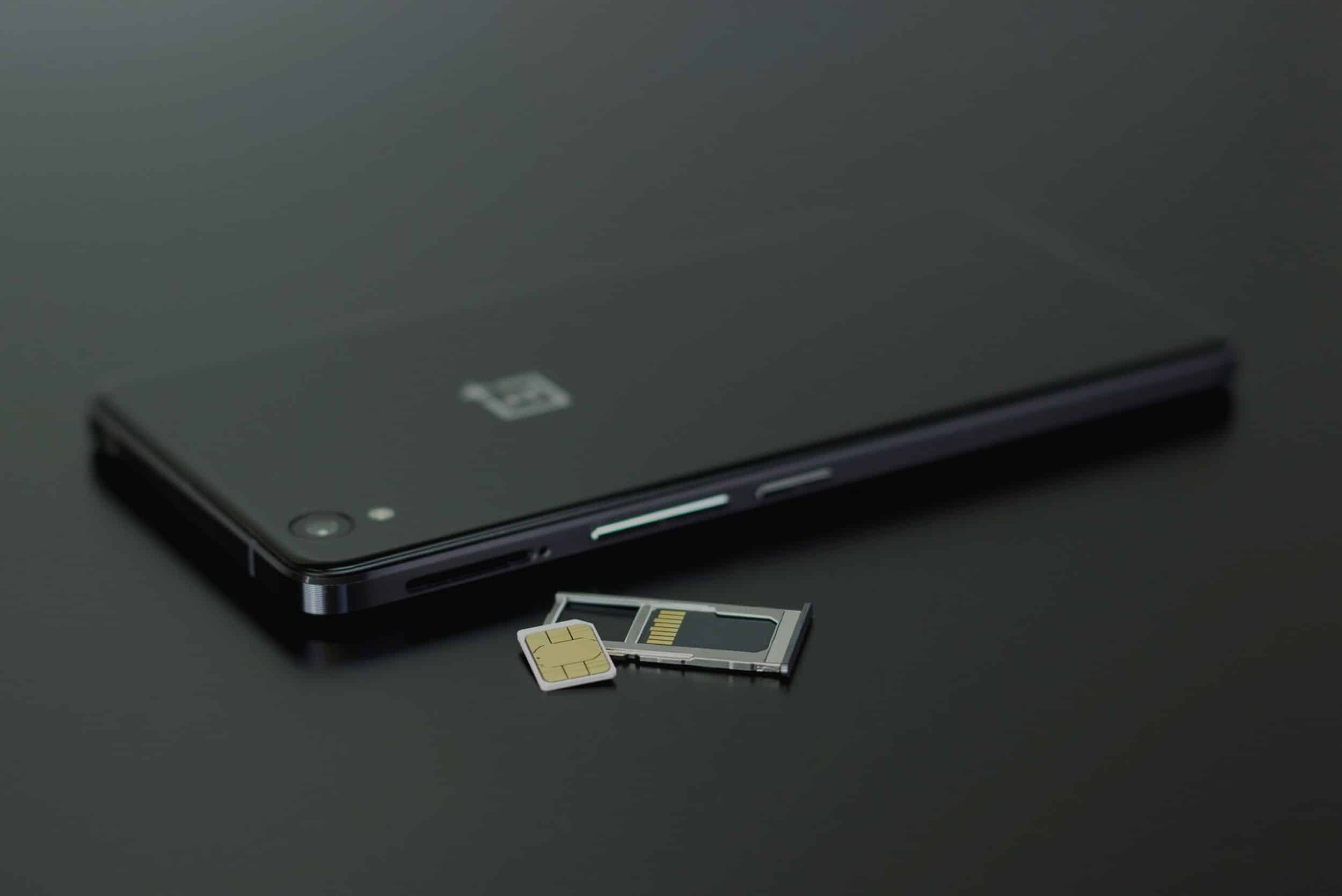
Traveling to any country involves potential scams, bad exchange rates, mistakes, and confusion when it comes to dealing with foreign currency. Fortunately, travelers to Korea have a wide range of options for travel money both before and while they travel.

South Korea is a country packed with famous landmarks and sights, unique culture – modern & historical, family-fun activities, outdoor adventures, cozy cafe districts, and natural wonders. There’s more to do in Korea than you could imagine and it’s impossible to explore it all in one trip. Try to plan your itinerary by cities and locations. For example, plan your day in Seoul and stay by the district.
Here are some of the best things to see and do in South Korea, broken down into different themes so you can find things that interest you the most. The location of each of these attractions is included, too, so you can create a city-by-city itinerary, seeing the best South Korea has to offer.
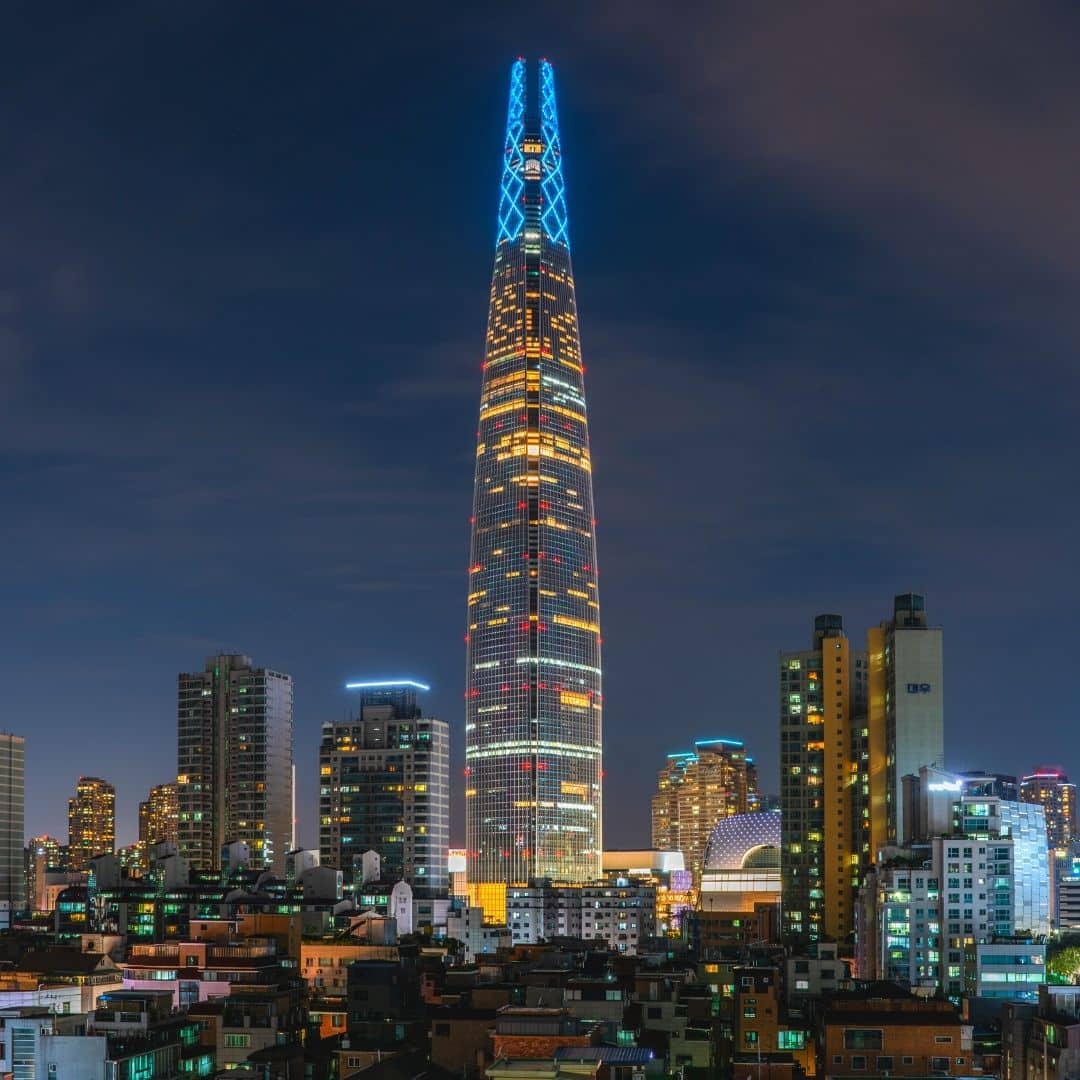
Any South Korea Travel Guide would be incomplete without thee top landmarks & famous areas in Korea. These unmissable Korean attractions offer some of the best sights in Korea, showing you Korean history, culture, design, and sense of humor.
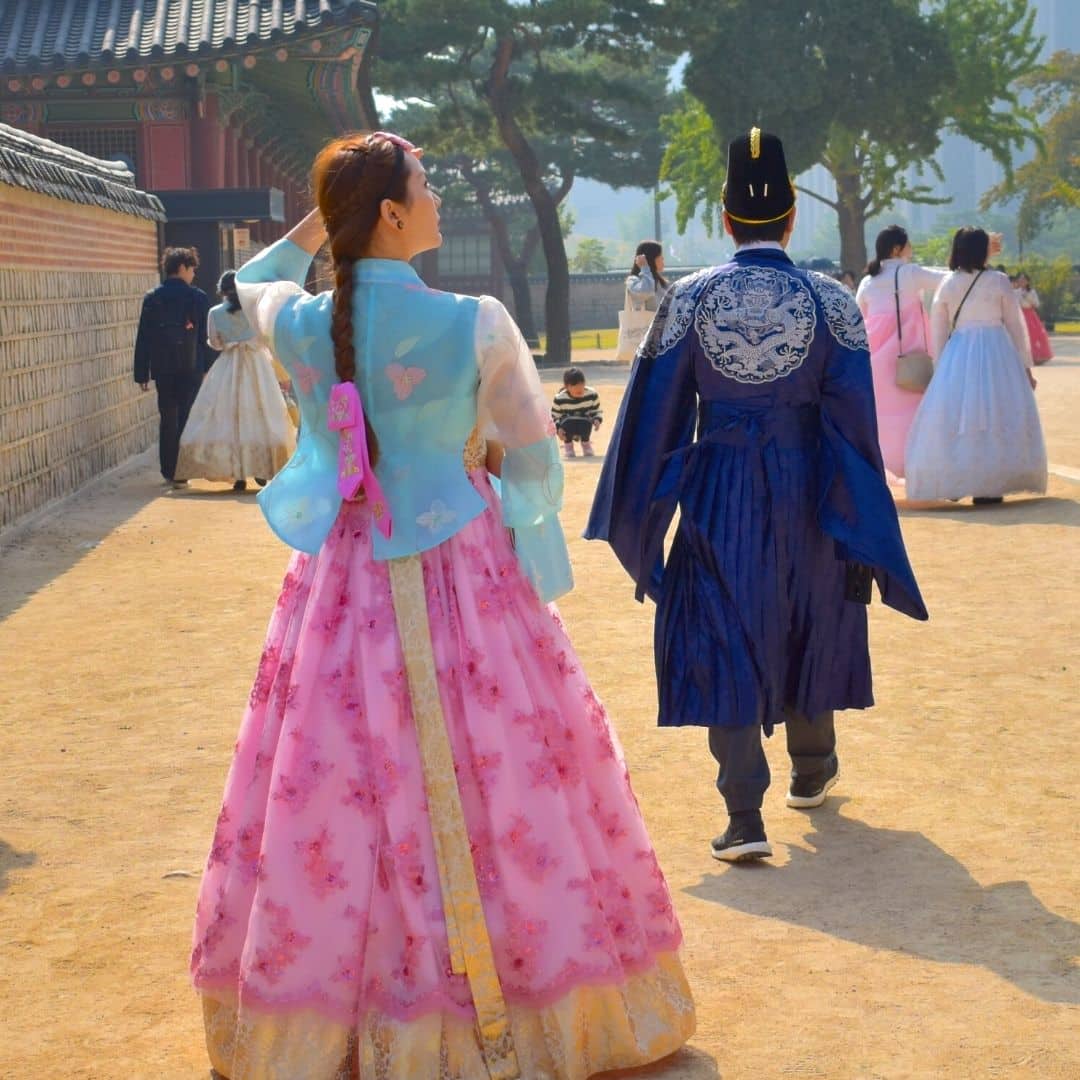
Learning about Korea’s past is not only enjoyable, it’ll also open your eyes to how modern Korean culture has evolved. Witness the majesty of grand palaces and the humble Buddhist temples and gain an insight into life in Korea with these fascination historical sights.

Are you a fan of Korean culture? Then check out these 10 modern K-Culture locations in Korea. Whether you’re ARMY or an arthouse cinema fan, you’ll love these sights. K-Drama fans, check out these K-Drama Filming Spots in Seoul .

If you’re traveling to Korea with your family, you don’t need to worry about the kids getting bored. There are plenty of family-fun attractions in Korea to keep them amused and to show them what Korea’s really like.

Culture lovers will find no shortage of places to learn about Korean, Asian, and world history & culture. Korea has a rich history and displays this through a range of museums. Learn about traditional life, Korean wars, the democracy struggles, and even kimchi .

Once a land of teahouses, Korea has now fully embraced coffee culture. Korea’s late-night culture makes cafes a great place to gather and chat. The rise of social media has also led to hundreds of insta-worthy cafes with photogenic decor, unusual coffee designs, and delicious desserts.

Many people travel to Korea just to shop, thanks to the low prices, haggling in the markets, and good quality items. From traditional markets to high-end designer goods, there’s somewhere to shop for everyone. Be sure to try authentic Korean street foods in the markets, too.

Korea is a country surrounded by sea on 3 sides and 70% mountainous, giving it a wealth of natural beauty. Besides Korean cherry blossoms , flowers, and fall foliage, there are sculpted gardens, shimmering ponds, riverside parks, and a volcano to see.

Morning : Explore Seoul’s historic royal palaces starting with Gyeongbokgung or Changdeokgung Palace in central Seoul. You get free entry if you’re wearing a Korean hanbok, so be sure to pick one up from the rental shops outside.
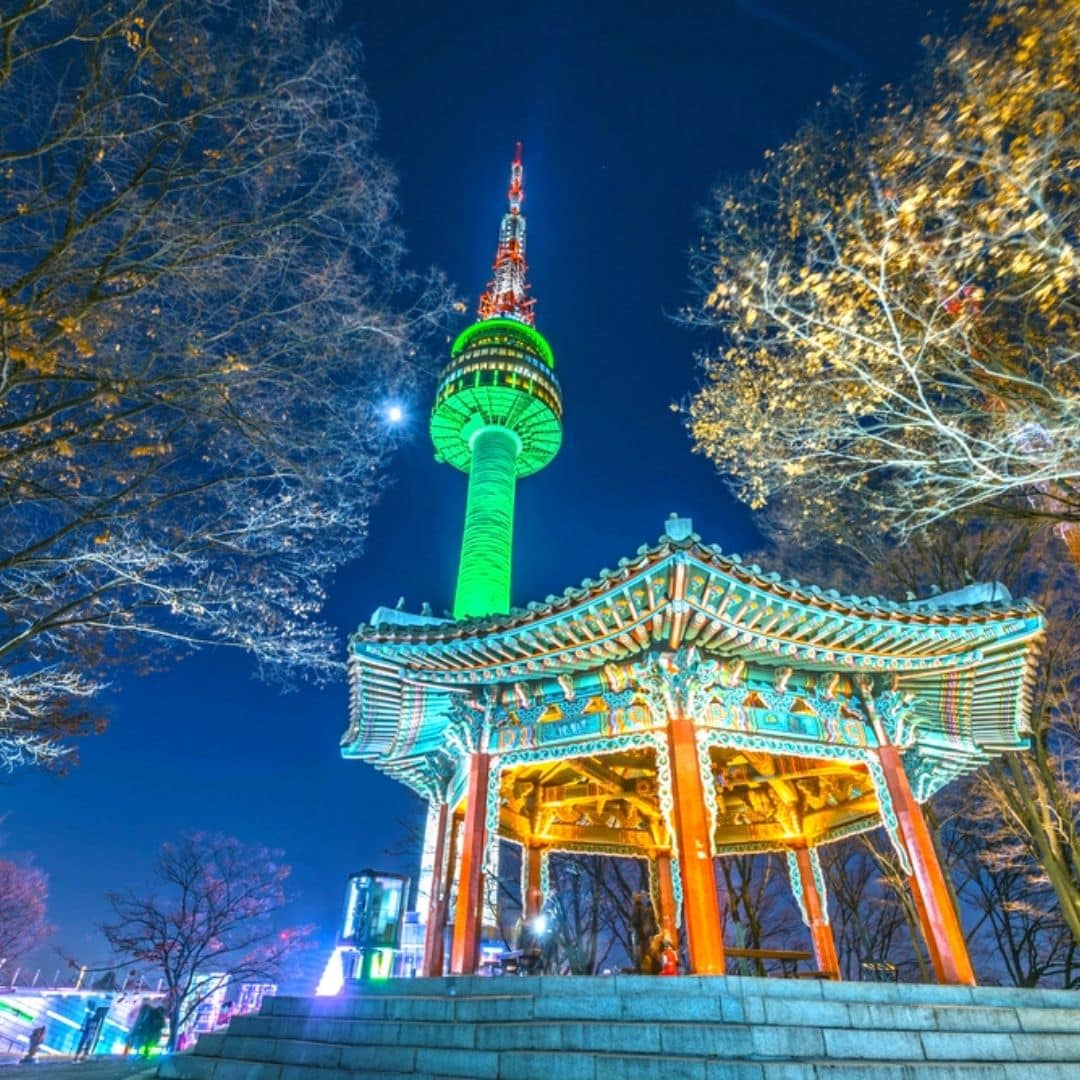
Morning : Learn about Korea’s history at the National Museum or War Memorial in Yeongsan. These fascinating museums have interactive exhibits and feature 1000’s of years of Korean history.

Morning : Take a day trip from Seoul to explore Gapyeong County. See the wonders of the Garden of Morning Calm and its idyllic nature. This is one of the most beautiful gardens in Korea.

Morning : Grab an early breakfast at Seoul Station and ride the high-speed KTX train directly to Seoul. It takes less than 4 hours and rides past rice fields, mountains, and the Korean countryside.

Morning : Take a day trip to the UNESCO World Heritage City of Gyeongju and roam the Gyeongju Historic Area. See Daereungwon Tomb Complex and Cheomseongdae Observatory.

Morning : Pack your bags and ride the KTX back to Seoul. Head to Hongdae for street food snacks or Michelin-starred delights in famous restaurants.

March to May

June To August

September to November

December to February
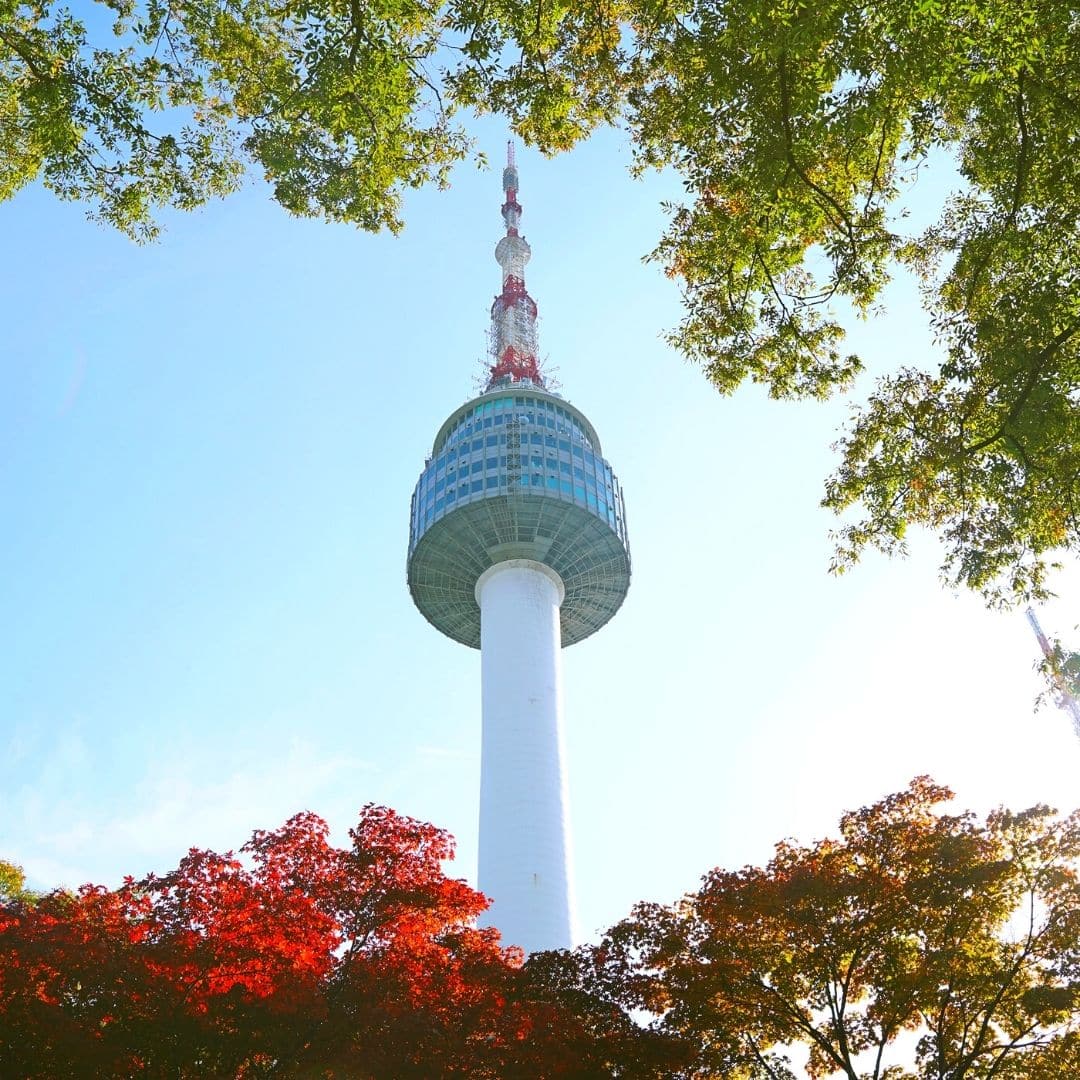
Korean Souvenir Costs
The best places to buy souvenirs in Korea are in the traditional markets and tourist areas. Insadong in Seoul has a lot of art and souvenir shops, as do the market streets around Bukchon Hanok Village. Hongdae offers lots of bargain snacks and souvenirs to take home.

Day Trip Costs From Seoul
A day trip from Seoul is a must to see a different side of Korea from what you’ll experience in the capital. Taking a day trip is a great chance to experience Korea’s countryside, nature, and hard-to-reach cultural attractions.

Korean Activity Costs
Seoul and other Korean cities have so much to offer to tourists. From historical palaces to exciting theme parks and attractions, it’s easy to have fun, explore, and discover more about Korea’s history.

Flight Costs To Korea
Flight costs depend on which airports you’re traveling from. A flight from Los Angeles to Incheon Airport (Korea’s main airport) costs around $1370 right now. Flight costs vary depending on the season and time of day.
Welcome to Best of Korea!
Please Sign Up for Updates
We hate spam. You can unsubscribe anytime.
Nomadic Matt's Travel Site
Travel Better, Cheaper, Longer
South Korea Travel Guide
Last Updated: July 17, 2023
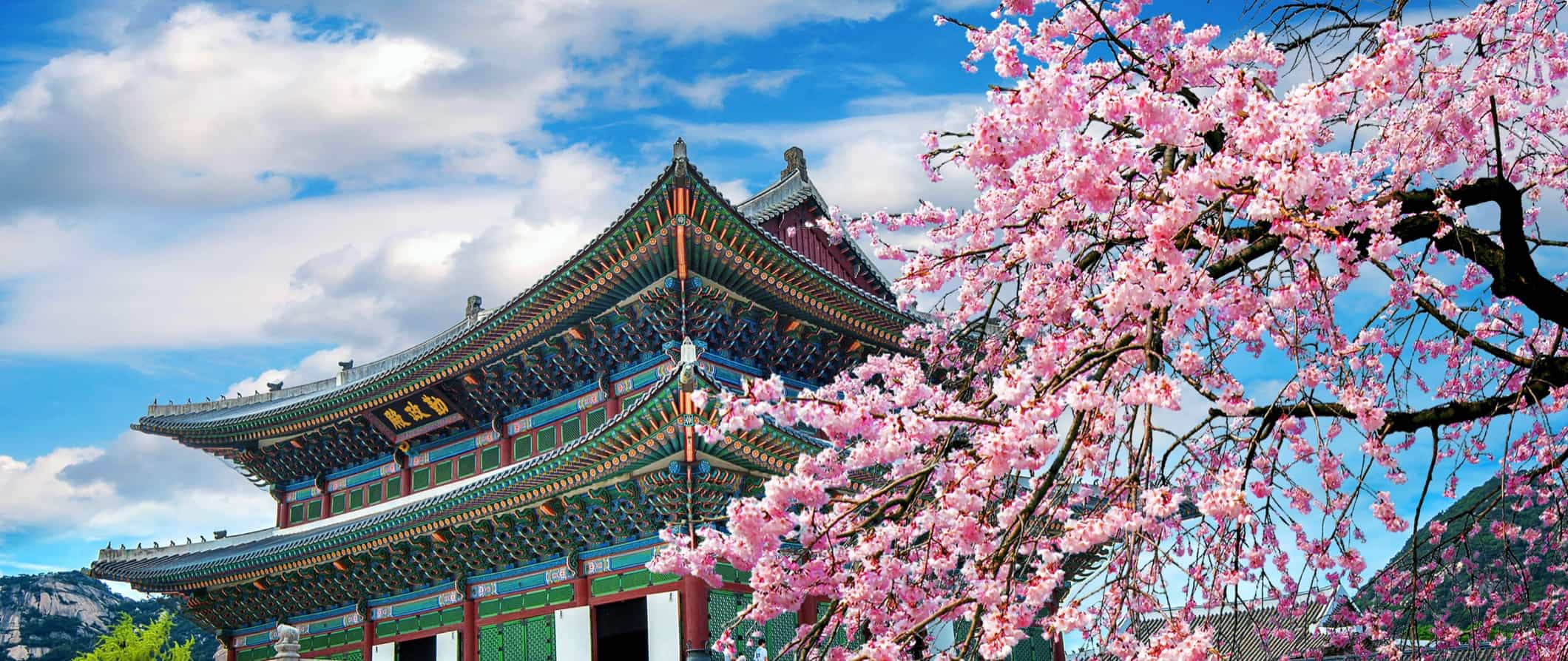
Though South Korea is small (about the size of the US state of Indiana), it punches well above its weight in terms of things to see and do. Boasting a vibrant culture, incredible history, natural beauty, delicious food, and a wild nightlife, it’s home to both major cities and untouched nature, offering something for every traveler.
Seoul, the capital city and fourth-largest metropolitan area in the world (over half the country’s population of 50 million is concentrated here), is a lively hub for food lovers and partying. But while it gets all the attention, there is much more to explore, including 22 national parks, lush Jeju Island, and the infamous Demilitarized Zone (DMZ) bordering North Korea.
Best of all, since South Korea is a manageable size, you can see a good portion of it in a limited amount of time. The transportation here is modern, clean, and efficient, so it’s easy to get around quickly.
The country is also a foodie’s paradise, with cheap street food and delicious dishes like bibimbap, kimchi, and the famed Korean barbecue.
It’s one of my favorite countries in the world and one that I think is super under the radar and often overlooked by travelers. You never see the tourist crowds found in other Asian countries.
This travel guide to South Korea can help you plan your trip, save money, and make the most of your visit.
Table of Contents
- Things to See and Do
- Typical Costs
- Suggested Budget
- Money-Saving Tips
- Where to Stay
- How to Get Around
- How to Stay Safe
- Best Places to Book Your Trip
- Related Blogs on South Korea
Top 5 Things to See and Do in South Korea
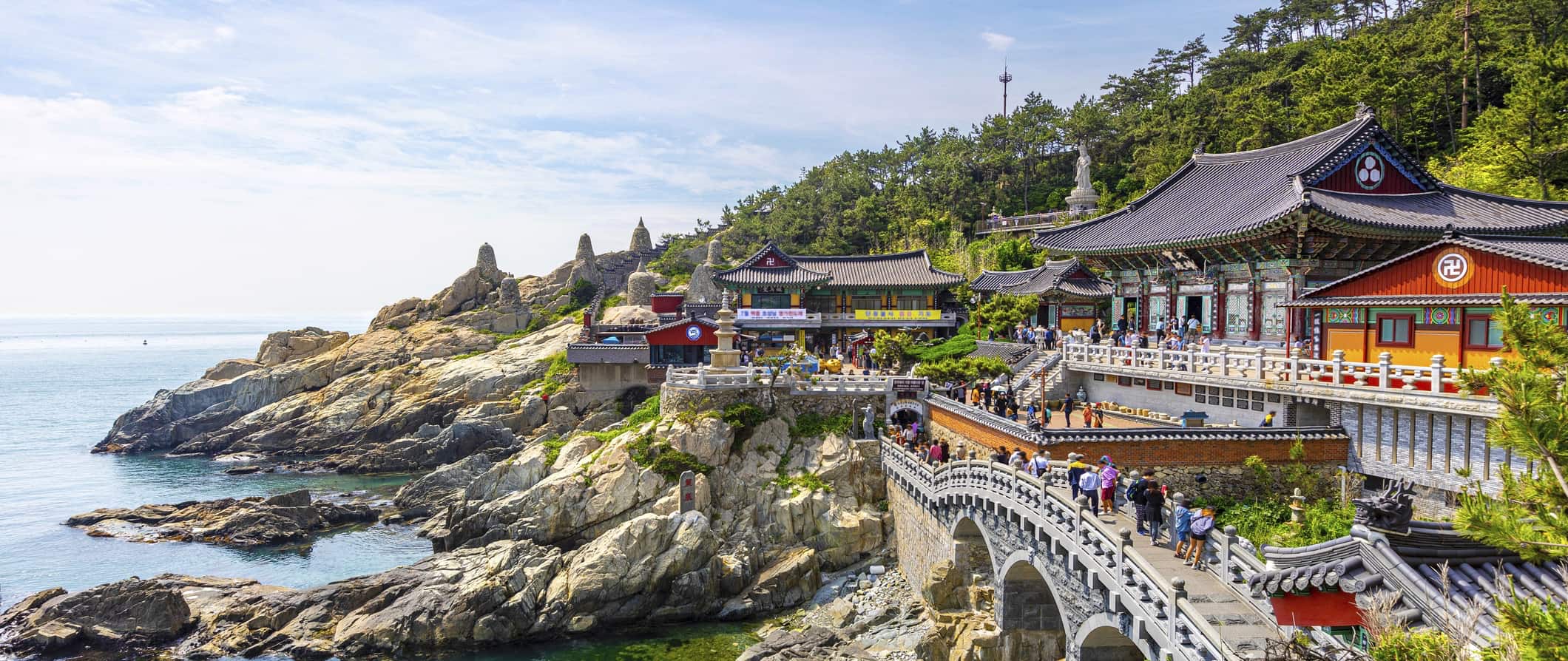
1. Explore Seoul
Korea’s capital has a little bit of everything. It’s a bustling metropolis and global technology hub, with sleek and modern neighborhoods like Gangnam and iconic sights like the Lotte World Tower, the sixth-tallest building in the world. Yet there is a lot of history here too, including many museums, palaces, and temples, among them five UNESCO World Heritage Sites. When you’re done exploring for the day, Seoul has a robust street food scene, countless trendy restaurants, and fast-paced, soju-driven nightlife. You could easily spend weeks here and never get bored.
2. Tour the DMZ
The Demilitarized Zone (DMZ) separates North and South Korea and, despite the name, is the most militarized border in the world. You can only visit the Joint Security Area (JSA), which has military personnel from both sides, on a guided tour, but it’s a unique experience and an important way to learn about this ongoing conflict (the war started in 1950 and has not officially ended). On the tour, you’ll be able to actually stand in North Korea, visit the Third Tunnel of Aggression (which North Korea dug to sneak soldiers across the border), see the Freedom Bridge, and catch glimpses of North Korea from the Unification Observatory. Guided tours of the DMZ start from 80,000 KRW.
3. Visit Jeju Island
This volcanic, semitropical island is a popular domestic vacation spot. It’s accessible via cheap daily flights from Seoul that take just one hour. Known as “the Hawaii of Korea,” it’s a natural paradise, home to the tallest mountain in Korea (Mount Hallasan), lava tubes, beautiful beaches, and countless hiking and walking trails. Other attractions include visiting mythic Jeju Stone Park, wandering the Yeomiji Botanical Gardens, and watching the haenyeo divers — women who dive without any protective equipment to gather underwater treasures like shellfish and seaweed, which they then sell on the beaches. You can visit the Jeju Haenyeo Museum as well to learn more about this cultural practice that dates back centuries.
4. Sing karaoke
Known as noraebang , this is a cultural phenomenon and something worth experiencing at least once while visiting Korea. While the karaoke machine was originally invented in Japan, Koreans have adopted the pastime and made it their own. Here, you rent out a private room with a group of friends (instead of singing in a public bar, as is often the case in Western countries). Pricing is determined by the hour, with rates varying wildly depending on the number of people, time of day, day of the week, and whether snacks and drinks are included. Average group karaoke rates range from 5,000 to 15,000 KRW.
5. Step back in time at a hanok village
Other things to see and do in south korea, 1. visit changdeokgung palace.
One of the Joseon dynasty’s Five Grand Palaces, this 15th-century complex in Seoul was built in harmony with the natural environment at the foot of Bugaksan Mountain. Changdeokgung, or “Palace of Prospering Virtue,” was the main royal residence for 13 kings over the course of three centuries. The complex sprawls over 110 acres, 60% of which is taken up by the beautiful Huwon Secret Garden, home to over a hundred species of trees, flowers, and other plants (some of the trees here are over 300 years old!). The main draw is wandering around the exterior, with its restored buildings and gates, though you can also go inside Injeongjeon Hall, the palace’s throne room. Admission to the complex is 3,000 KRW; the Secret Garden is an additional 5,000 KRW. There are guided tours in English as well.
2. Explore Busan
Korea’s second-largest city is located just two hours from Seoul on the KTX high-speed bullet train. A coastal city, Busan boasts great beaches, such as Haeundae Beach, with its miles of sand, and Gwangalli Beach, known for its sunsets. Gamcheon Culture Village, the “mural village of Korea,” is a hillside neighborhood rich in street art and covered in murals, and nearly all the houses are painted bright colors. It’s a great place to wander around for a few hours, popping into the unique shops, cafés, and restaurants.
3. See the National Museum of Korea
If you visit only one museum in Korea, make it this one. Located in Seoul, it covers all aspects of Korean culture, art, and history, from prehistory to the early modern era. It also contains many national treasures and artifacts that have been designated as having special importance and value in Korean culture and history. Some of the most important ones include the sixth-century inscribed Bukhansan Monument, detailing military expansions; sixth-century gilt-bronze Buddhist statues; and the 10-story Gyeongcheonsa Pagoda, which dates to the 14th century. Don’t miss the exterior gardens, which feature indigenous plants, reflecting pools, and traditional Korean sculptures and lanterns. Admission to the main exhibitions and children’s museum is free.
4. Take a food tour
As a foodie, learning about a culture through its food is one of my favorite things to do while traveling. Korea has an incredible variety of amazing dishes to try, as well as a bustling (and delicious) street food scene. Taking a food tour with an experienced guide is one of the best ways to gain a deeper understanding of Korean cuisine. O’ngo Food offers a variety of tours in Seoul, Busan, Jeonju, and Jeju, with prices starting from 70,000 KRW per person.
5. Visit Gyeongbokgung Palace
Originally built in the 14th century by the kings of the Joseon dynasty, this palace in Seoul served as the seat of the government for two hundred years until it was destroyed by a fire and abandoned for centuries. Since the 19th century (and still today), it has been undergoing renovations to restore the complex to its former glory. It is considered the most stunning of all five royal palaces in Seoul, featuring grand gates, open courtyards, and terracotta-topped buildings set against the backdrop of Mount Bugak. In addition to wandering through the complex, you can also go into the many administrative halls and residential chambers set up to resemble the palace’s heyday. You can watch the changing-of-the-guard ceremony as well, every day except Monday. The National Palace Museum and the National Folk Museum are also located in the complex. Admission is 3,000 KRW.
6. See the cherry blossoms
While cherry blossoms are often associated with Japan, festivities surrounding the blooms are incredibly popular in Korea as well. Here, the season runs from late March to late April, with many festivals throughout the country. Just be prepared for crowds at the more popular ones, like the Yeouido Cherry Blossom Festival in Seoul.
7. Try taekwondo
Korean’s native martial art, taekwondo, is characterized by high kicks and punches and, like all such disciplines, emphasizes mental training. An Olympic event since 2000, taekwondo has only grown in popularity in recent years and is a point of pride in Korean culture. Kang’s Global Taekwondo in Seoul offers classes to adults and foreigners that cost around 43,000 KRW for one hour.
8. Learn to cook classic Korean foods
If you’d like to take your knowledge of Korean food one step further, take a cooking class, where you’ll learn to prepare classics like bibimbap, kimchi, bulgogi, and Korean pancakes. Hello K Cooking in Seoul offers a class where you’ll learn how to cook three main dishes and one stew — recipes and skills that you can bring home with you. Classes are 107,000 KRW.
9. Go hiking
Korea is an incredibly mountainous country, so hiking is a favorite pastime for locals. Be sure to immerse yourself in nature while visiting this lush land. There are even hiking spots near the bigger cities if you don’t have enough time or don’t want to venture too far afield. Bukhansan National Park, just outside Seoul, is a popular place to go hiking, offering panoramic views over the capital (expect crowds due to its proximity to the city, though). Yet with 22 national parks spread across the country, there are plenty of opportunities to escape the crowds (including lots of guided hikes if you don’t want to organize one yourself). For a multiday hike, the Jirisan Ridge Trek in Jirisan National Park is one of the most famous — a four-day walk from mountain shelter to mountain shelter.
10. Wander around Seoul Olympic Park
In 1988, Seoul hosted the Summer Olympics, which was only the second time the summer games had been held in Asia (the first was in Tokyo in 1964). Today, you can visit the massive park where the games were staged, and while Olympic Park does have many sports facilities, there’s much more to explore here as well. The park is divided into four sections, focusing on the arts, history, nature, and sports. In the arts section, you’ll find the SOMA Museum of Art and a park with over 200 sculptures, while in the history section, you can see the third-century defensive Mongchontoseong Earthen Fortifications, excavated dugout huts and storage pits left in the state in which they were uncovered. You can easily spend an entire afternoon here. Admission to the park is free.
11. Discover Jirisan National Park
Located in the southern part of the country (Namwon is the nearest city), this park is named after Jirisan (Mt. Jiri for short), the tallest mountain on mainland Korea. As it’s South Korea’s first national park (as well as its largest), hiking trails and cultural sites abound. You can visit seven major Buddhist temples and see several of Korea’s national treasures of ancient carved stonework from the seventh to the tenth centuries. One of the most important sites here is Samseonggung, or Three Sages Palace, a mountainside shrine dedicated to the legendary founders of Korea. Admission to the park is 1,600 KRW.
South Korea Travel Costs
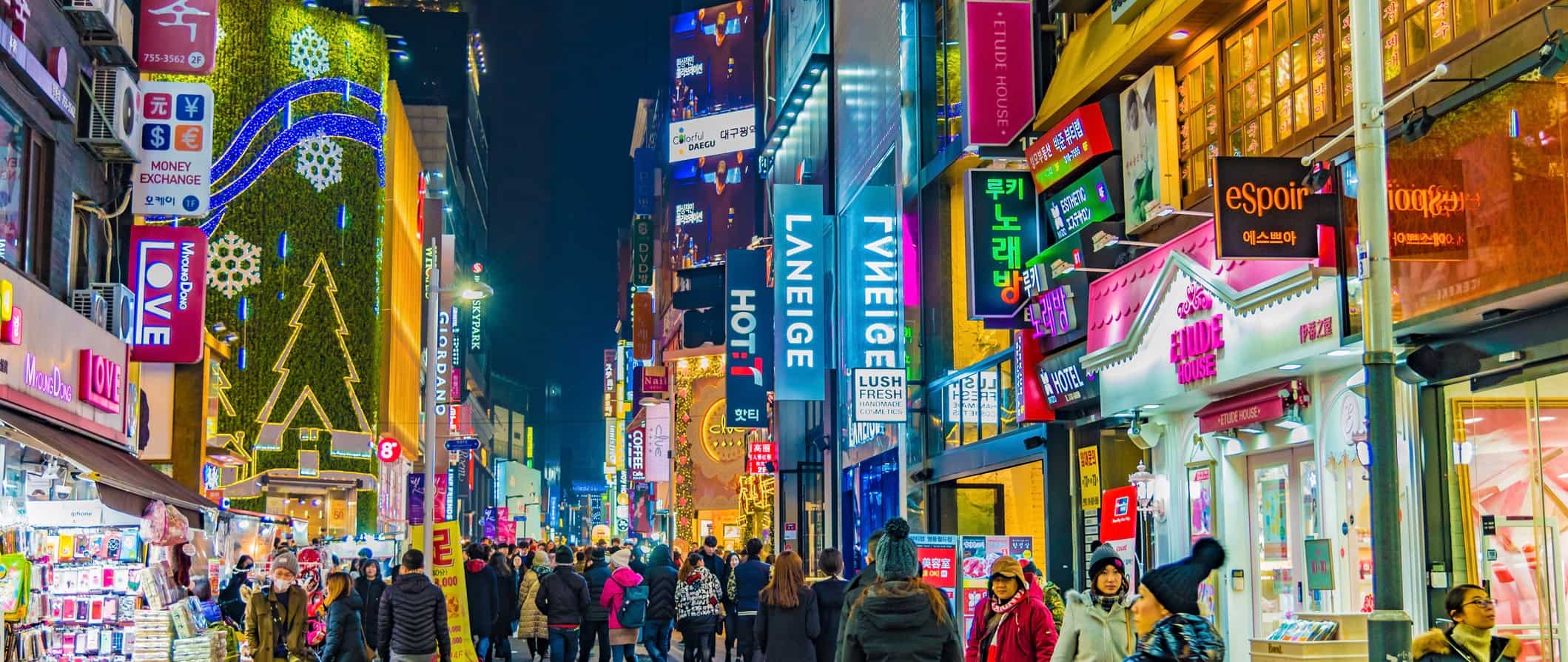
Cheap hotel rooms start at 28,000 KRW for a room that sleeps one, while a double room generally costs at least 40,000 KRW. Expect basic amenities like Wi-Fi, a TV, air conditioning, and an electric teapot. Breakfast is usually not included at budget hotels.
Airbnb is available around the country, with private rooms starting at 25,000-30,000 KRW. For an entire home or apartment, expect to pay at least 50,000-70,000 KRW per night.
While wild camping is illegal in Korea, there are plenty of campgrounds should you want to pitch a tent. Expect to pay 7,000-20,000 KRW for a plot with access to bathroom and shower facilities, and usually even Wi-Fi.
Food – Korean cuisine has developed its own traditions and flavors over the centuries, with a unique emphasis on using uncooked, fermented, and pickled vegetables. Traditional Korean meals are often composed of a variety of side dishes, eaten with short-grain rice. A meal isn’t considered complete unless there’s kimchi on the table.
Common dishes include bulgogi (marinated, grilled beef), samgye-tang (chicken and ginseng soup), bibimbap (a mixed rice bowl), chap chae (a glass noodle dish), and many other noodle and rice dishes. Popular street foods include hotteok (a sweet, filled pancake), tteokbokki (spicy cylindrical rice cakes), and bungeo-ppang (a fish-shaped pastry filled with red bean paste).
Dining out in South Korea is relatively inexpensive. A meal at a casual restaurant serving traditional Korean food is around 9,000-15,000 KRW, while a three-course meal at a mid-range restaurant is around 25,000-30,000 KRW. Expect higher prices in larger cities.
Western food is more expensive. Expect to pay at least 20,000 KRW for a pasta dish at an Italian restaurant.
In terms of fast food, a combo meal (think McDonald’s) is around 7,000 KRW, while a burger is around 4,500 KRW. A typical Korean street food dish is 1,500-3,000 KRW.
A pint of beer is 4,000-5,000 KRW, a glass of wine is 6,000 KRW and up, and a cocktail is 7,000 KRW and up. A latte or cappuccino is 5,000 KRW.
If you cook your own food, expect to pay 50,000-70,000 KRW per week for basic staples like rice, pasta, vegetables, and some meat. Shopping at local markets is the best way to get great fresh produce for cheap.
Backpacking South Korea: Suggested Budgets
On a backpacking budget of 75,000 KRW per day, you can stay in a hostel dorm, cook all your meals, use public transportation and intercity buses to get around, skip the alcohol, and do mostly free activities like walking tours and hiking.
On a mid-range budget of 135,000 KRW per day, you can stay in a private Airbnb or cheap hotel, eat out for most meals at casual restaurants, enjoy a few drinks, take the occasional taxi as well as trains between cities, and do more paid activities like museum visits and food tours.
On a “luxury” budget of 255,000 KRW or more per day, you can stay in a nicer hotel or entire Airbnb apartment, eat out pretty much anywhere you want, drink at the bar, get a high-speed rail pass, and do as many guided tours and activities as you want. This is just the ground floor for luxury, though. The sky is the limit!
You can use the chart below to get an idea of how much you need to budget daily. Keep in mind these are daily averages — some days you’ll spend more, some days less (you might spend less every day). We just want to give you a general idea of how to make your budget. Prices are in KRW.
South Korea Travel Guide: Money-Saving Tips
I find South Korea to be one of the best value countries out there. It’s a really affordable place to visit. Accommodation can add up but food and drinks are generally cheap. Here are some ways to save money when you travel around South Korea:
- Visit the free attractions – With countless museums, shrines, temples, historic neighborhoods, and parks, Korea is filled with opportunities to become immersed in its culture. Many of the nation’s museums and cultural attractions are free, so don’t pass them up!
- Purchase a KORAIL Pass – If you want to travel by train, getting a rail pass is the most economical way to do so. You’ll get unlimited train travel for the time period you choose (2-5-day increments). Prices start at 121,000 KRW.
- Get a transit pass – Most major cities in Korea offer a day pass for public transit, which means great savings if you plan to hop around using buses and subways. Seoul’s day pass costs 15,000 KRW, though the longer you stay, the more you’ll save (a seven-day pass is 64,500 KRW).
- Buy a city pass – If you plan on visiting a lot of attractions, buy a city pass . Seoul and Busan both offer ones that include admission to popular sights, a transit pass, and discounts to restaurants and other attractions. A one-day pass starts at 33,000 KRW.
- Eat from the convenience stores – Convenience stores in Korea offer not only snacks and drinks but prepared boxed meals and cheap alcohol. If you’re on a tight budget, shop in those.
- Take the bus – While the trains are fun, the cheapest way to get around Korea is by bus. They take longer but are much cheaper, so if you have the time, opt for long-distance buses. Just show up at the bus station to reserve your tickets in advance, as most websites and apps are in Korean.
- Stay with a local – Couchsurfing lets you stay with a local for free, cutting your accommodation costs drastically. You’ll get to spend time with someone who can share their tips and advice in exchange for your own travel stories and culture. You can also use the app to meet people for activities (coffee, museum visits, etc.) if you don’t feel comfortable staying with a stranger.
- Drink like the locals – Soju, the national alcohol of Korea, is incredibly cheap, as is domestic beer. Just be careful to not let it sneak up on you — both monetarily and physically. Korea’s drinking culture is infamous!
- Stay in capsule hotels – If you don’t want to Couchsurf or stay in hostels but still want to save money, capsule or pod hotels are great options. These offer just what you need to sleep (a small, basic pod) yet can be surprisingly comfy and much more affordable than a traditional hotel. Prices start as low as 45,000 KRW per night.
- Bring a water bottle – The tap water here is safe to drink, so bring a reusable water bottle to save money and reduce your plastic use. LifeStraw is my go-to brand, as its bottles have built-in filters to ensure that your water is always clean and safe.
Where to Stay in South Korea
South Korea has plenty of budget-friendly hostels and guesthouses. Here are some of my recommended places to stay when you visit:
- Time Travelers Relax Guesthouse (Seoul)
- Zzzip Guesthouse (Seoul)
- Time Travelers party Hostel (Seoul)
- INSIDE Busan (Busan)
- Jeju Hiking Inn (Jeju)
- Backpacker’s Home (Jeju)
How to Get Around South Korea
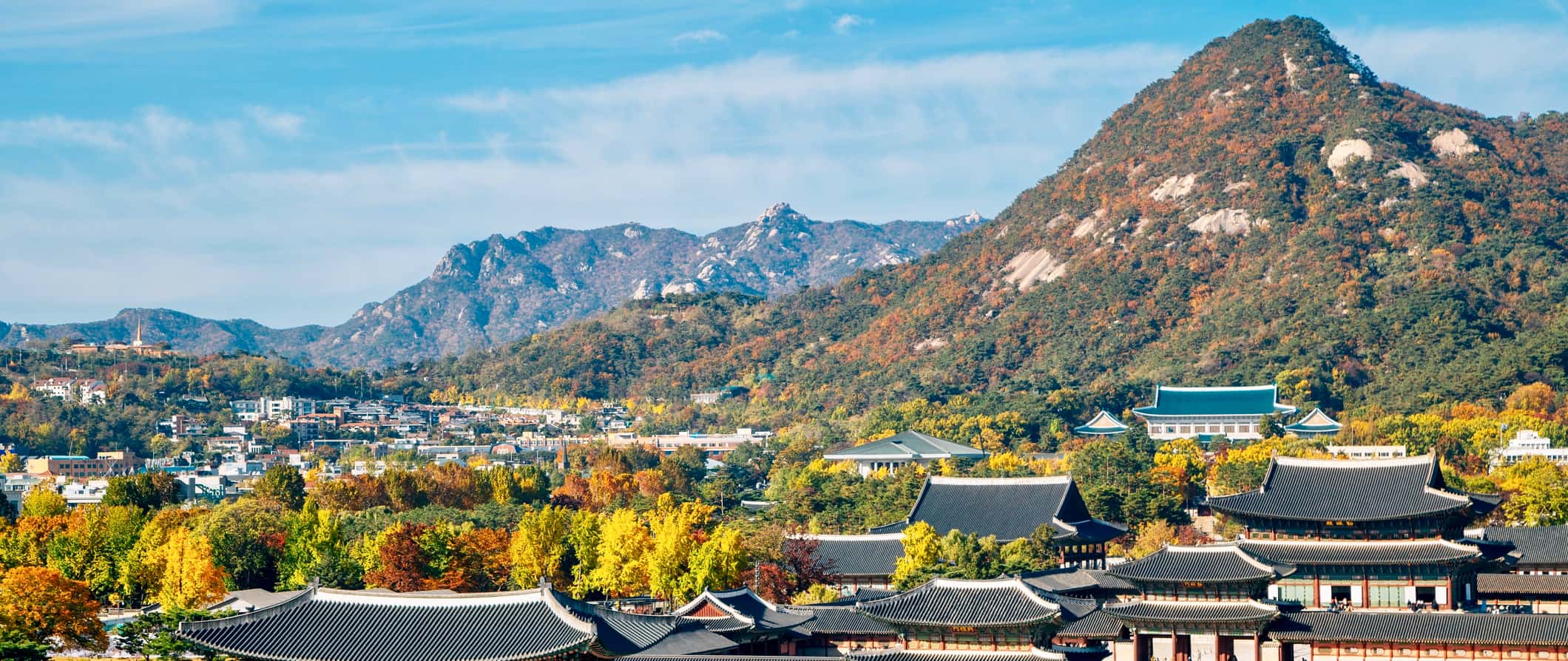
Bus – Taking a long-distance bus is the cheapest and most popular way to get around the country. There are two types: express (which makes few to no stops) and intercity (which travels between smaller destinations and makes more stops).
Your best bet for reserving tickets in advance is to go directly to the bus terminal, as most bus websites and booking apps are in Korean and only accept Korean credit or debit cards.
Pricing depends on what class ticket you choose: standard, luxury, or premium. The four-hour bus ride from Seoul to Busan costs around 36,000 KRW for a standard ticket, Incheon to Busan takes just over four hours and costs 38,000 KRW, and Seoul to Daegu is 29,000 KRW and takes just under four hours.
Train – South Korea has a robust train system that can take you all over the country. Korean Train Express (KTX) is the country’s bullet train, regularly running at speeds up to 305 kilometers (190 miles) per hour. However, these only go between major cities, have limited schedules, and are more expensive, so KTX may not always be the most convenient choice.
KORAIL (the national railway service) operates slower-speed, intercity trains that offer a wider range of schedules and destination choices. You can also get the unlimited KORAIL Pass, which is offered exclusively to international tourists. A two-day adult pass is 121,000 KRW; a five-day adult pass is 210,000 KRW.
As a comparison of the two train types: the journey from Seoul to Busan on a KRX train costs around 90,000 KRW and takes 2.5 hours, while on a regular intercity train, it takes 5.5 hours and costs 47,500 KRW.
The further out you book, the cheaper KTX train prices get, while intercity prices stay about the same. You can book up to a year in advance.
Flying – South Korea is so small that flying around the country doesn’t really make sense. Trains can get you anywhere pretty quickly. However, if you’re very pressed for time and have cash to burn, there are a few budget airlines offering domestic flights between major cities. Most are around one hour long.
The flight from Seoul to Busan is around 30,500 KRW, Seoul to Jeju is 55,000 KRW, and Busan to Jeju is 22,000 KRW. However, you can find flights even cheaper when you book further in advance.
Low-cost airlines in South Korea include the following:
Car rental – Renting a car isn’t incredibly cheap in South Korea. However, it is one of the best ways to explore all the natural wonders that the country has to offer, many of which are inaccessible by public transportation. Expect to pay around 50,000-55,000 KRW per day on a multiday rental. Drivers need to be at least 21 years old.
When to Go to South Korea
Generally, the best times to visit South Korea are March-May and September-November. During these periods, the weather is mild, with temperatures of 10-24°C (50-75°F); prices for accommodation and transportation are lower; and there are fewer crowds.
In the spring, the cherry blossoms are in bloom all over the country, while the fall brings the beautiful colors of the changing leaves. Also, if you plan on doing a lot of hiking, the fall is the best time to visit.
The summer starts with monsoon season, from June through mid-July, and the rest of the summer is hot and humid in the cities (though it cools down in the mountains and along the coasts). Prices for accommodation are also very high during this time.
Winters in South Korea get very cold, with temperatures dipping as low as -6°C (21°F), so unless you plan on skiing, visiting from December through February might not be the best option (though the temples and landscapes look beautiful covered in snow).
How to Stay Safe in South Korea
South Korea is an incredibly safe place to backpack and travel around. Petty crime is rare here, though it never hurts to be cautious on public transportation and around popular tourist landmarks. Always keep your wallet and valuables secure and out of reach, just in case. Violent crime is even more rare.
Solo female travelers should feel safe here. However, the standard safety precautions apply as always. For specific tips, consult one of the many solo female travel blogs on the web.
While scams are super rare in South Korea, to avoid getting ripped off, you can check out this list of common travel scams to avoid .
When hiking, always bring water and sunscreen. Be sure to check the weather before you depart and dress accordingly.
Earthquakes occur regularly in the region, so it’s best to be prepared and download the Emergency Ready app, which the Korean government developed to provide information in English to foreign residents and tourists. It has all kinds of advice and tips for natural disasters, shows you where nearby emergency shelters are, and sends out warnings and notifications should a disaster occur.
If you do experience an emergency, dial 112 for assistance.
Always trust your gut instinct. Make copies of your personal documents, including your passport and ID, and forward your itinerary along to loved ones so they’ll know where you are.
South Korea Travel Guide: The Best Booking Resources
These are my favorite companies to use when I travel. They consistently have the best deals, offer world-class customer service and great value, and overall, are better than their competitors. They are the companies I use the most and are always the starting point in my search for travel deals.
- Skyscanner – Skyscanner is my favorite flight search engine. They search small websites and budget airlines that larger search sites tend to miss. They are hands down the number one place to start.
- Hostelworld – This is the best hostel accommodation site out there with the largest inventory, best search interface, and widest availability.
- Booking.com – The best all around booking site that constantly provides the cheapest and lowest rates. They have the widest selection of budget accommodation. In all my tests, they’ve always had the cheapest rates out of all the booking websites.
- Get Your Guide – Get Your Guide is a huge online marketplace for tours and excursions. They have tons of tour options available in cities all around the world, including everything from cooking classes, walking tours, street art lessons, and more!
- SafetyWing – Safety Wing offers convenient and affordable plans tailored to digital nomads and long-term travelers. They have cheap monthly plans, great customer service, and an easy-to-use claims process that makes it perfect for those on the road.
- LifeStraw – My go-to company for reusable water bottles with built-in filters so you can ensure your drinking water is always clean and safe.
- Unbound Merino – They make lightweight, durable, easy-to-clean travel clothing.
- Top Travel Credit Cards – Points are the best way to cut down travel expenses. Here’s my favorite point earning credit cards so you can get free travel!
South Korea Travel Guide: Related Articles
Want more info? Check out all the articles I’ve written on Asia travel and continue planning your trip:
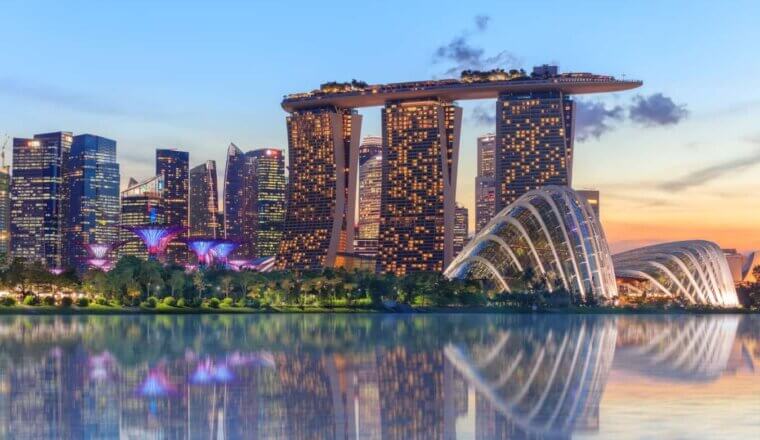
The 5 Best Hotels in Singapore
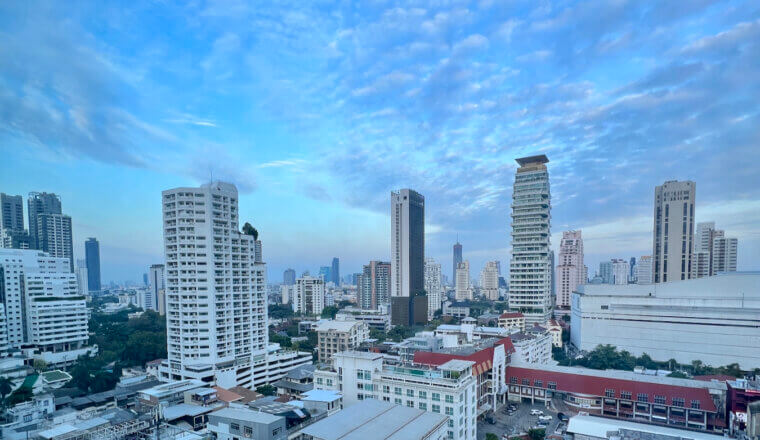
The 7 Best Hotels in Bangkok

The 4 Best Hostels in Singapore
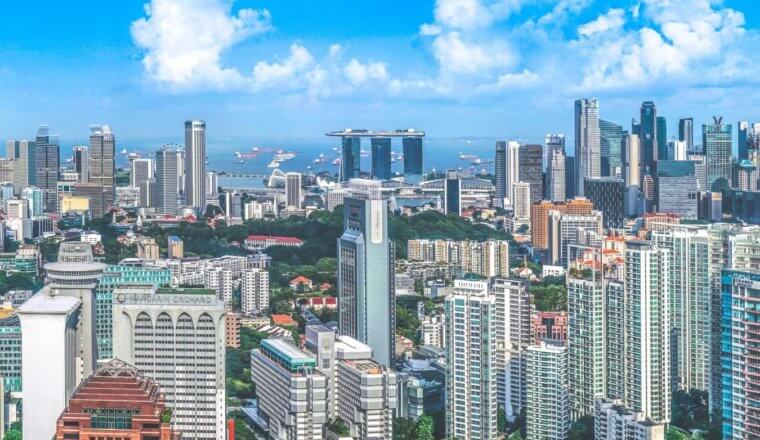
Where to Stay in Singapore: The Best Neighborhoods for Your Visit
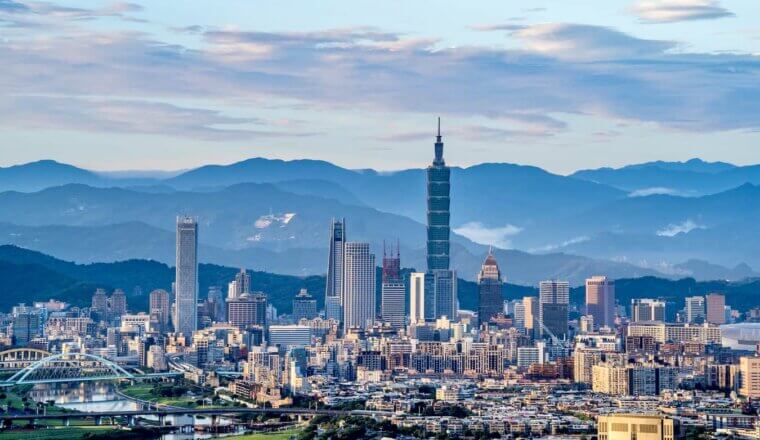
The 13 Best Things to See and Do in Taipei
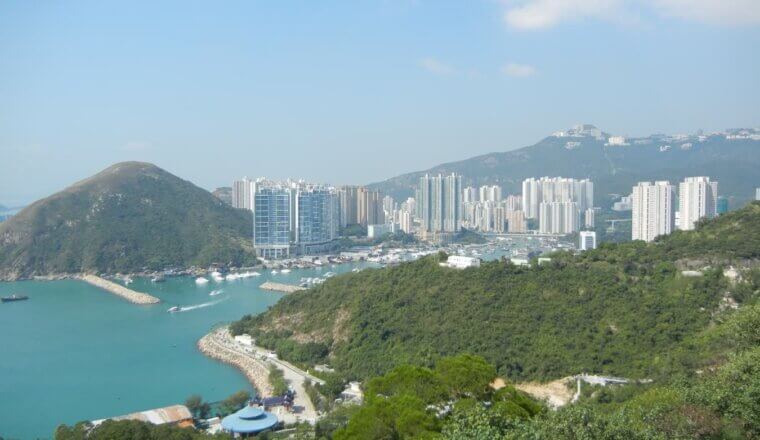
The 23 Best Things to Do in Hong Kong
Get my best stuff sent straight to you, pin it on pinterest.
- Where To Stay
- Transportation
- Booking Resources
- Related Blogs

- Accomodation
- Attractions
- Food & Drink
- K-Entertainment Tours
- Korean Culture
- Shopping Destinations
- Transportation
- Travel Essentials
- Travel Tips
- Travel News in Korea
- Gyeonggi-do
- North Gyeongsang (Gyeongsangbuk-do)
- North Jeolla (Jeollabuk-do)
- South Chungcheong (Chungcheongnam-do)
- South Gyeongsang (Gyeongsangnam-do)
- South Jeolla (Jeollanam-do)

First-Timer’s Ultimate South Korea Travel Guide – Things to Know Before Traveling to South Korea

5,001 total views, 3 views today

Before making your travel plans South Korea, check out this South Korea travel guide that will help you in finalizing your travel itinerary!
South Korea is a country of juxtaposition. You can find serene mountain valleys bumping against pulsing lights and rush of 24-hour cities. Korean tradition collides with ultra-modern fashion and design. To experience the depth and vibrancy of the country, you must see the serene countryside as well as rapidly changing cities.
There is something for everyone in the country, whether you like city-life, mountains, beaches, or anything in between. Planning can become a bit difficult as there is so much to see and do in South Korea.
Traveling to a new country like South Korea can be very exciting. It’s a whole new adventure waiting for you, but the entire planning and going to a different country can be a bit distressing. The culture, the people, and the laws governing the country are probably very different from where you are from. This is why we have compiled a guide for you of what to expect when you visit South Korea for the first time.
Table of Contents
South Korea Travel Guide
Most travelers do not need to get a visa to travel to South Korea. You can check the visa requirements on your country’s State Department website. Citizens from many countries have visa-free entry for a limited period under certain conditions. To check whether you can enter Korea without a visa issuance, please contact a Korean Embassy or consular offices in your country or visit the Ministry of Foreign Affairs to confirm.
There are some changes to visa requirements for Jeju Island in lieu of COVID-19 situation worldwide.
The local language is Korean, and it script is Hangeul. But there is no need to worry! There are lots of signs in and around the city in English as well. A lot of restaurant menus also include translations of main dish ingredients.
You can always learn a little Korean before you travel from apps like Duolingo . The locals are definitely going to appreciate your efforts!
Money Matters
The official currency of South Korea is ‘ Korean Won .’ Most places accept credit cards too. Small stores and mom-n-pop food outlets generally accept cash only.
Getting around in South Korea is very easy. There are domestic airlines, trains, and intercity buses. It’s easy to move around within the country. Even intercity travel is very convenient with all the available public transportation.
We have covered transportation in detail in the guide about understanding Korean culture.

Travel Apps
For first time travelers to South Korea, travel Apps are handy and can be useful as guide. The train and bus maps might look complicated, but you can use maps with English translations. Apps like KAKAO Maps and Naver Maps are especially for use in South Korea and are the preferred travel Apps. For more traveling tips, you can download the VisitKorea App. It can provide you with suggestions regarding food, tourist destinations, and many more.
Read More: 10 Best Apps for South Korea Trip You Must Download
There are quite a number of public toilets wherever we go, and they are generally clean. If you can’t find one right away, you can search in any of the travel map Apps “화장실,” which means toilet in Korean. On the other hand, it is challenging to find dustbins around, so you may have to carry your trash for quite a distance before you find one bin.
Read More: Understanding Korean Culture: Hygiene Culture in South Korea
South Korea has four distinct seasons — Spring, Summer, Fall, and Winter. Each season has something unique to offer visitors to the country, but depending on what you want out of your Korean experience, sometimes are better to travel than others. The best time of year to visit South Korea is generally the spring months of April, May & June, and the autumn months of September, October & November. During these two seasons, days are typically sunny and dry with comfortable average temperatures.
Read More: South Korea Travel Guide – When is The Best Time of Year to Visit South Korea?
Drinking-Water
Tap water in South Korea is drinkable. If you are not comfortable with it, you can purchase bottles of water from convenience stores or vending machines.
Accommodation
No matter what your budget is, you will find amazing places to stay during your trip to Korea. You can stay anywhere, ranging from a youth hostel to a luxurious hotel. For a unique cultural experience, you can also arrange a homestay like hanok stay via the Korea Tourism Organization.

Tour and Travel Services
Some places are only accessible with a tour guide or a tour bus to bring you around. The added benefit is that you can relax on the bus while you are going from one destination to the next.
Internet Connectivity
South Korea is a well-connected country. Wherever you are, you will have access to mobile data and public Wi-Fi. Did you know that you can get free WiFi in most of the buses in Seoul?
Read More: Korean Sim Card Guide for All the Travelers
Most tourists are familiar with Korean barbeque and look forward to having the authentic dish right from the source. You can find it in abundance no matter where you go in Korea! To avoid any goof-ups in restaurants, you can check out our restaurant guide . You can also check out the post on Netflix-fame street food places.

Read More: What to Eat in Seoul – Best Korean Food
Shopping Tips
The prices are pretty much fixed in stores. Most store owners hardly speak in English, even in tourist places. You won’t face such problems in popular shopping areas with big brand stores. Some of the shopping places in Seoul include Myeongdong, Dongdaemun, Common Ground , and many others.
Read More: 10 Exquisite Handmade Gifts You Can Buy in Seoul
Travel During COVID-19
The South Korean government raised the coronavirus disease threat alert level to its highest on February 23, 2020. Many attractions have been temporarily closed, and festivals have been postponed or canceled throughout the country. Travelers are recommended to check the attractions’ official website before visiting.
Korea aggressively maps and tracks infected cases. Self-quarantine is strictly monitored and enforced. The country also prohibits individuals who have been in contact with confirmed cases from exiting Korea during the day 14-day self-quarantine period. Korea provides advanced medical care to confirmed patients. The treatment is free-of-charge for both Koreans and foreign nationals.
The KCDC has urged everyone to participate in an enhanced social distancing campaign for the next 15 days (March 22 – April 5). The KCDC strongly recommended that all non-urgent international travel plans be canceled or postponed. Persons who are unable to avoid traveling for a critical reason are advised to refrain from visiting any enclosed facilities or healthcare facilities.
Starting March 22, the KCDC is conducting COVID-19 diagnostic testing for every inbound traveler entering from Europe. Asymptomatic Korean nationals (with domestic residence) will be directed into self-quarantine at home and get tested at their local public health center within 3 days of arrival. Foreigners will be quarantined at the facility and tested.
Apps to Track COVID-19 in South Korea
You can use a locally developed App like ‘Corona 100m,’ which, as its name implies, alerts users if they breach a 100-meter (328-foot) radius of the latest tracked whereabouts of the coronavirus patient. The person using the app can see how close they are to coronavirus patients. It also allows people to see the date that a coronavirus patient was confirmed to have the disease, along with that patient’s nationality, gender, age, and where the patient visited. It was launched on February 11 and had a million downloads in the first 17 days.
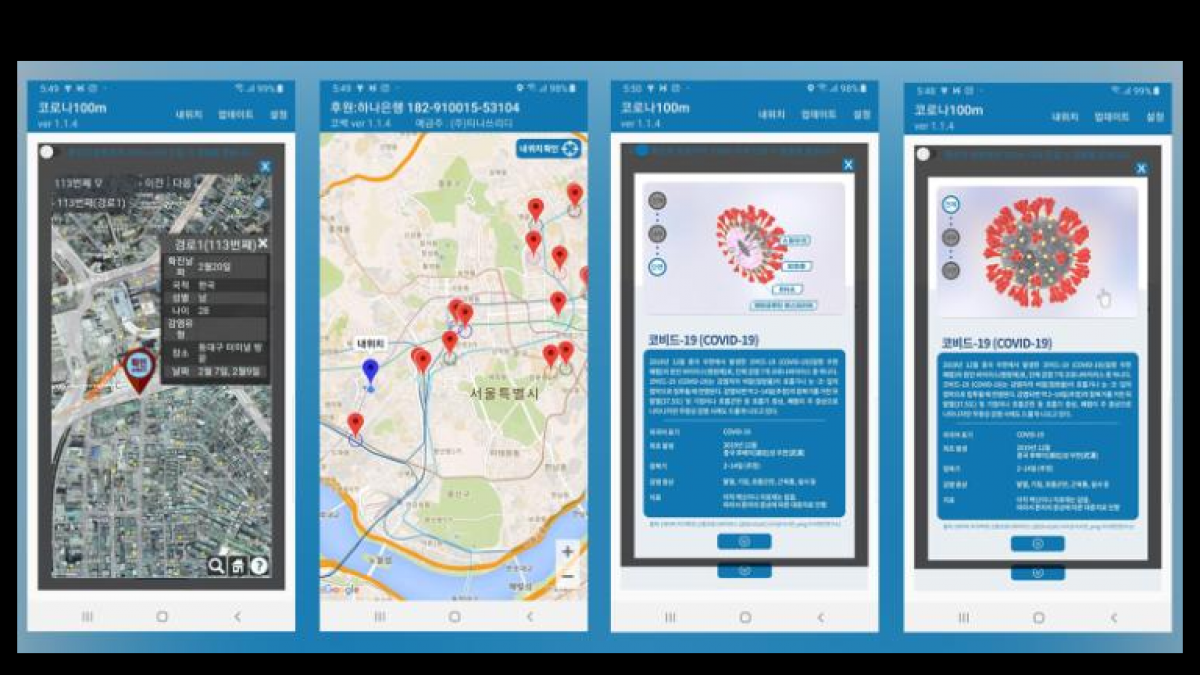
‘Corona Map’ is another such app that tracks the locations of people know to have COVID-19. Like Corona 100m, Corona Map plots the places where people known to have had COVID-19 have been, to make avoiding these areas easier.
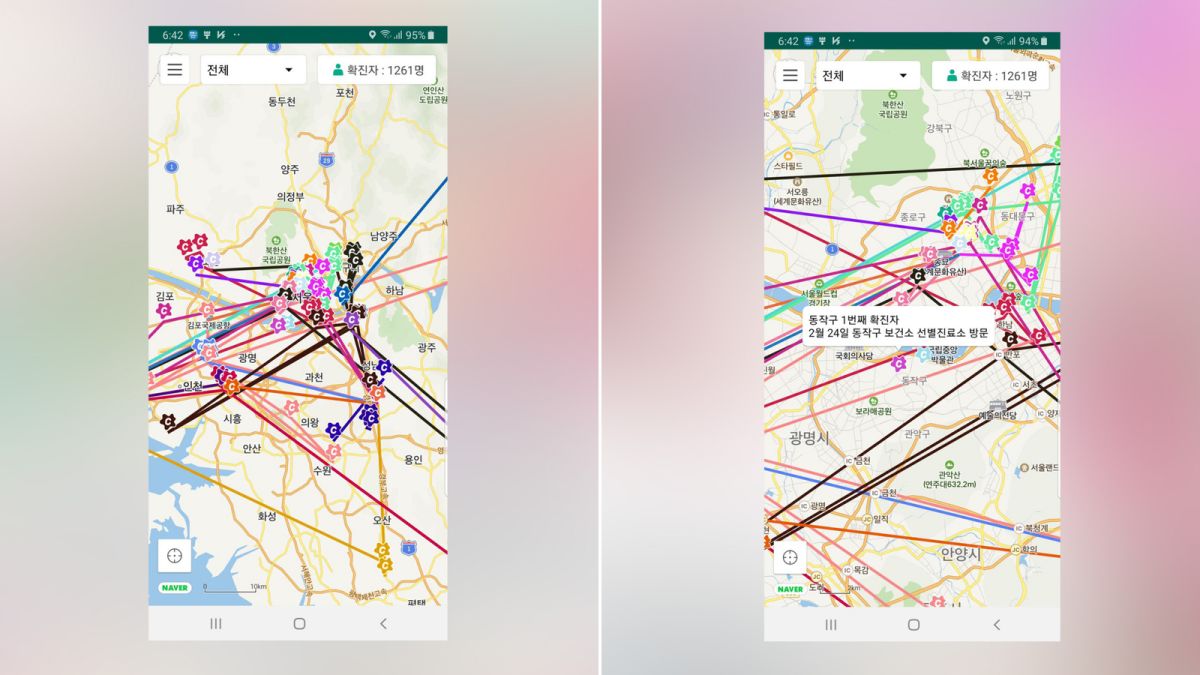
These are some of the essentials that you need to know before making your travel plans to South Korea and this travel guide will be helpful in making your itinerary!
KoreaTravelPost Editor
Hello there! I'm the Features Editor for KoreaTravelPost.
Related Posts
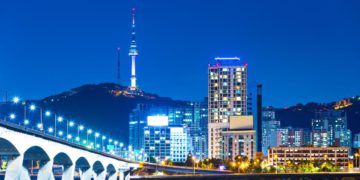
Explore Korea Like a Boss with InterparkTriple TRIPLE Korea
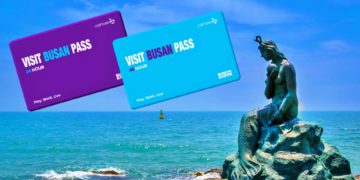
Temporary Suspension of VISIT BUSAN PASS Sales – Important Information for Travelers

Seoul Trip PASS App: Your Ultimate Travel Companion for Hassle-Free ID, Seamless Payments, and Instant Tax Refunds!
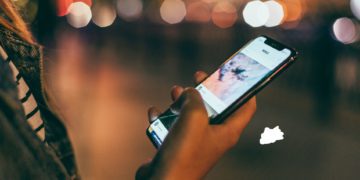
Best Korean to English Translation Apps for Your Korea Trip
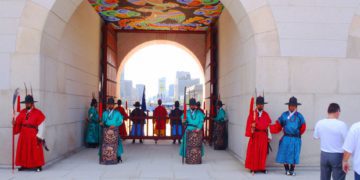
Discover South Korea with the Best: Top 10 Tour Operators
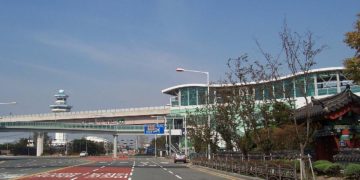
A Complete Guide to Gimhae International Airport

5 Best National Parks in South Korea
Leave a reply cancel reply.
Your email address will not be published. Required fields are marked *
Save my name, email, and website in this browser for the next time I comment.
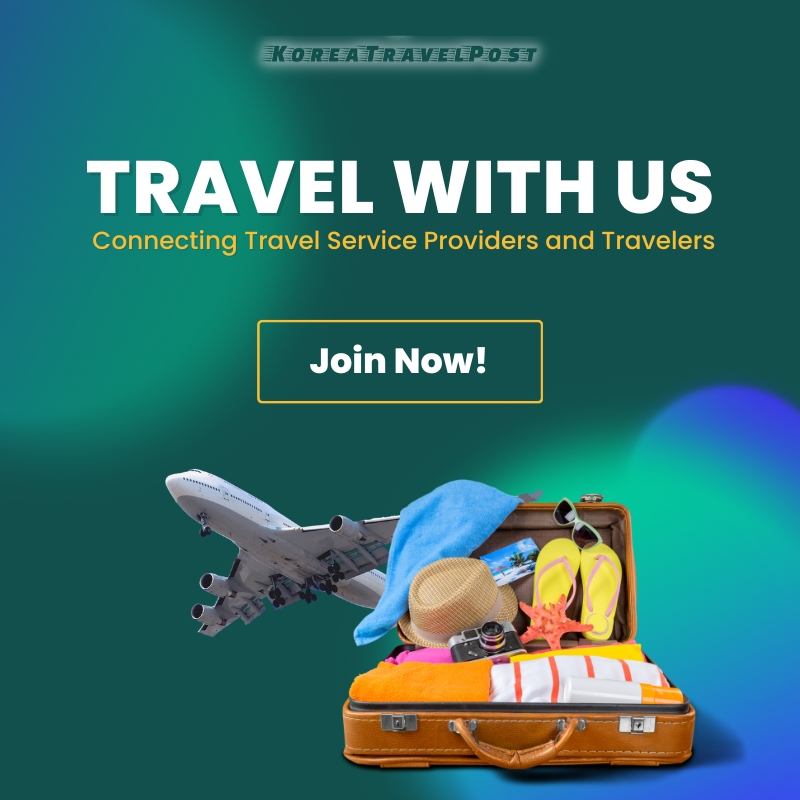
TESSAN Germany France Travel Power Adapter

Lonely Planet Korea 12

Korean Snack Box Variety Pack

OSULLOC Lovely Tea Gift Box Set
More from our network.

- Medical Tourism
FREE NEWSLETTER
Copyright © 2024 About Us| Terms of Use |Privacy Policy| Cookie Policy| Contact : [email protected]
Login to your account below
Fill the forms bellow to register
Retrieve your password
Please enter your username or email address to reset your password.

10 Days in South Korea: The Perfect South Korea Itinerary
South Korea may look relatively small on a map, but make no mistake about it – it’s packed with history, culture, and insanely good food. I’ll help you navigate the big cities and countryside villages to plan a perfect 10-day trip.
Few places embrace futuristic design the way that South Korea does in cities like Seoul – with a subway system and buildings like Dongdaemun Design Plaza that look like something straight from a science fiction epic.
But don’t get it twisted – there’s also a deep commitment to preserving traditional culture you’ll find in nearly every corner of the country, from the ongoing custom of wearing the ornate Korean hanbok dresses in smaller cities like Jeonju to the beautifully preserved urban palace and gardens at Changdeokgung.
I just got back from spending several weeks in this gorgeous country and I learned a ton from this trip. After returning from South Korea, I paged through my notebook (and memory bank) to develop a perfect travel plan so you can make the most of your visit.
Ready to learn more? Here’s everything you need to know for your South Korea trip.
PS: Wanna take a sneak peak? Watch the video on YouTube!
Watch on YouTube
South korea itinerary , days 1-2: seoul .
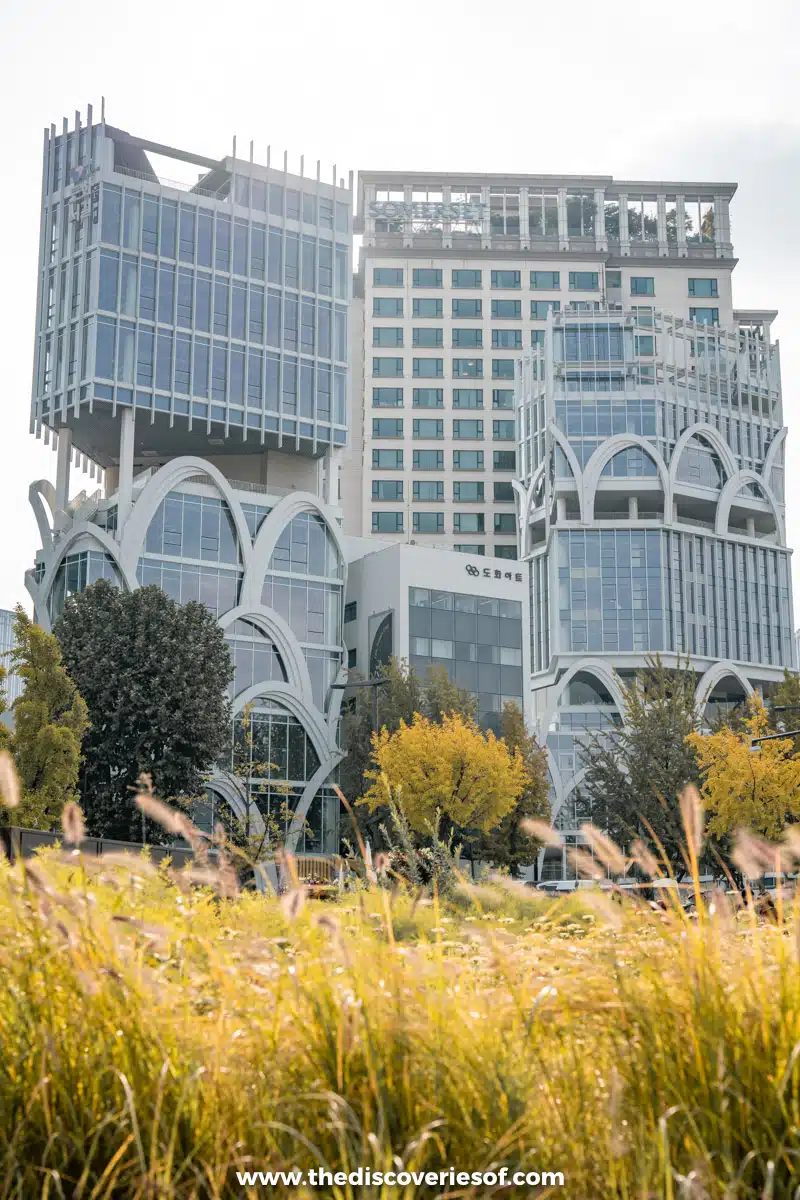
Few cities in the world balance old and new as well as Seoul does. Facts.
On my most recent trip, I found myself moving from ancient landmarks like the royal Joseon dynasty estate of Gyeongbokgung Palace to N Seoul Tower, where the bright neon lights from 237 metres (777 ft) encapsulate the city’s pursuit and perfection of modernity like no other vantage point I’ve seen.
Stroll through the charming Samcheong-dong area for some of the best shopping in the city and a look into the exciting neighbourhood filled with jazz clubs, cocktail bars, and hair salons where you might run into your favourite K-pop singer. The trendy boutiques featuring local art or K-beauty supplies seem perfectly at home near classic Korean Hanoks (houses) and bustling business districts, which speaks to the balance of history, commerce, and a trend-setting drive that makes Seoul one of the most interesting cities in the world.
Things to Do in Seoul
Visit changdeokgung palace.
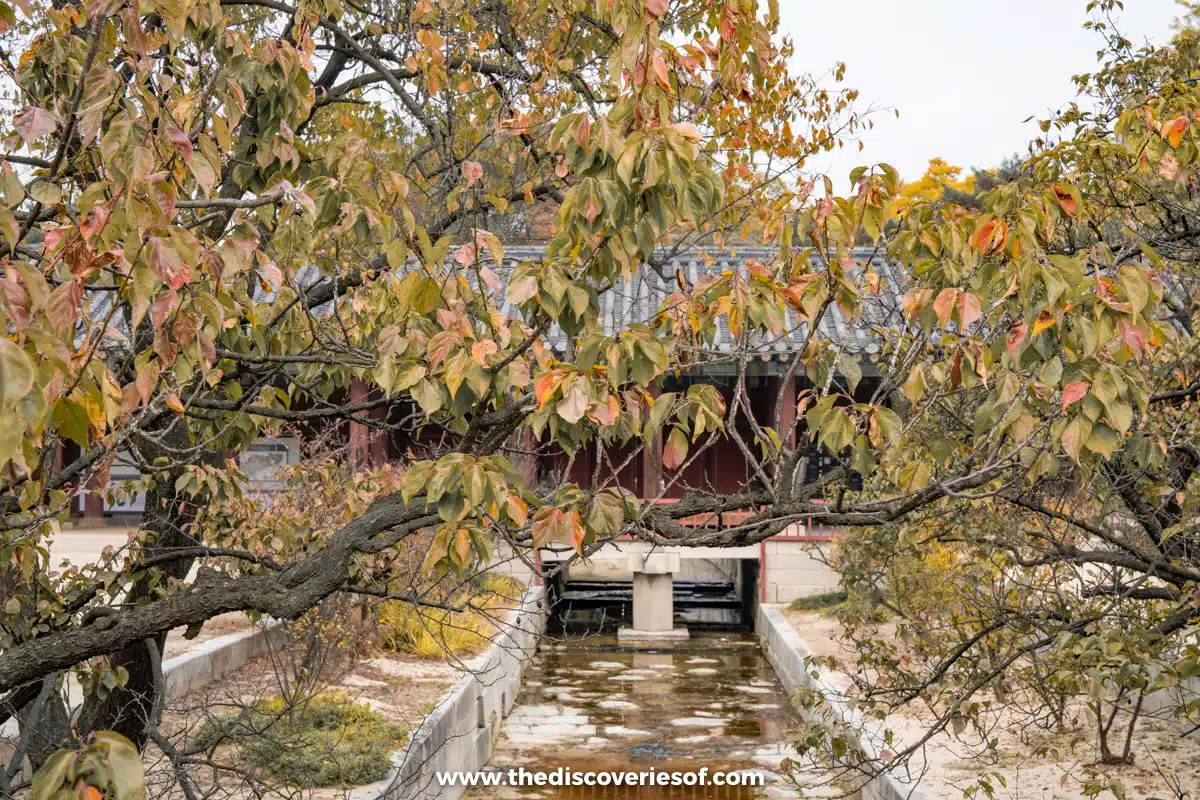
What’s the best way to kick off a 10 days in Seoul itinerary? Tap into the history and culture of the city. Visiting a Joseon Dynasty Palace offers a peek into the 500-year rule through a lesson in history and architecture. Changdeokgung Palace was my favourite, as the extensive palace and secret gardens really gave a sense of what life was like for Korean royalty for centuries. It’s an affordable tour, for just £6.10 ($7.70).
Alternatively, you can visit Gyeongbokgung Palace, where many of the original Joseon Dynasty Grand Palace buildings have been restored since being destroyed under Japanese occupation.
See the Views from N Seoul Tower
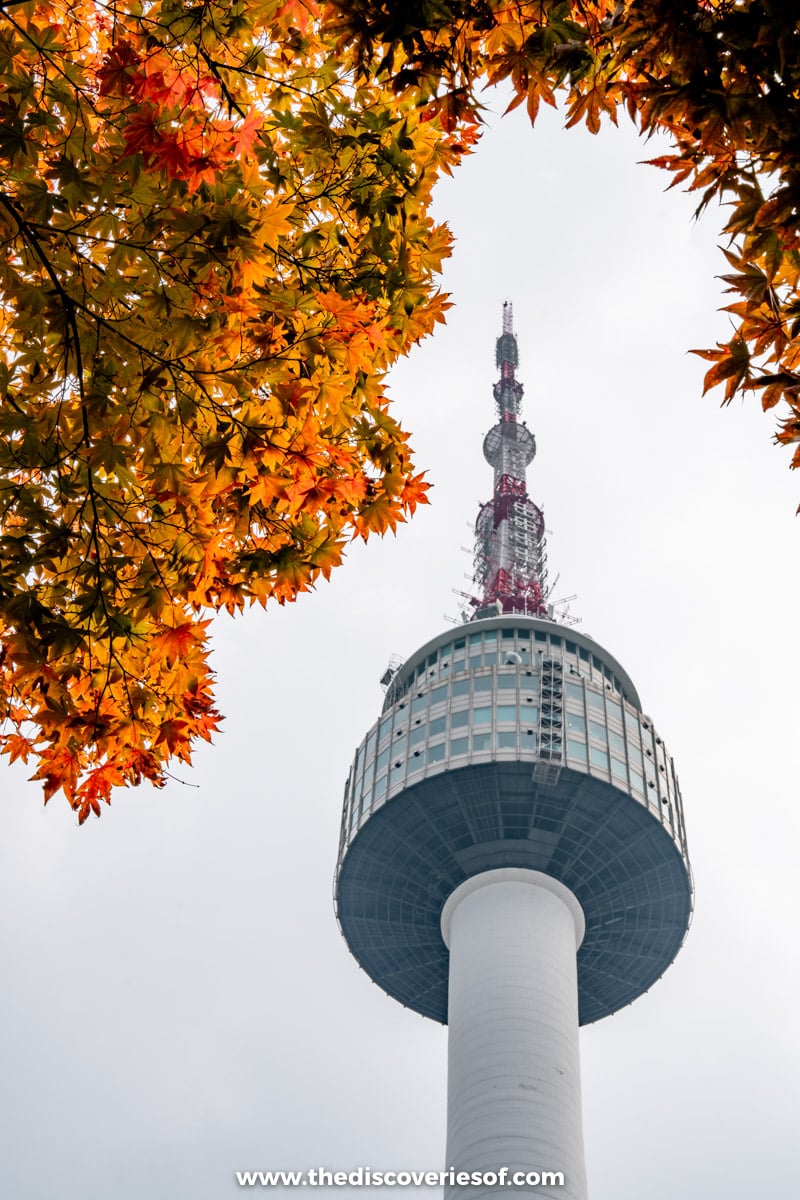
If you only make time for one viewpoint, you need to see the panoramic city views from the top of N Seoul Tower. High up on a hill, you can either walk or take the Namsan Cable Car to the top for gorgeous views from the landmark’s observation deck that doubles as a radio tower. I opted for the latter, and after elbowing my way to the window, my reward was spectacular views all the way up
Eat at Gwangjang Market
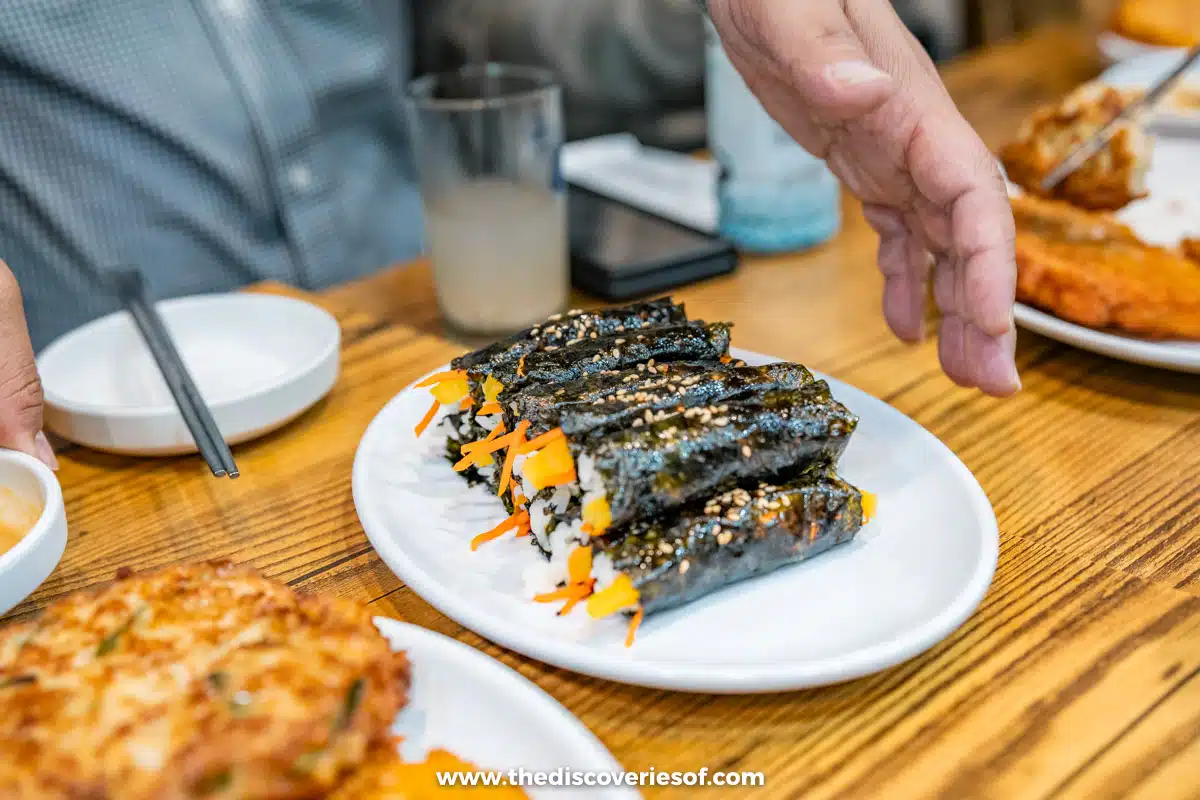
Whether you go for lunch, dinner, or both, visiting the iconic Gwangjang Market offers you a taste of why Seoul is literally heaven on earth for foodies. Try the fish cake soup (Eomukguk) and hand-cut noodles in anything you see. Only have time to try one dish? Try mung bean pancakes.
Head to Sunhui-ne Bindaetteok as early as possible to dive into the mung bean pancakes that are crispy, savoury, and oh-so-addictive.
Explore a Hanok Village
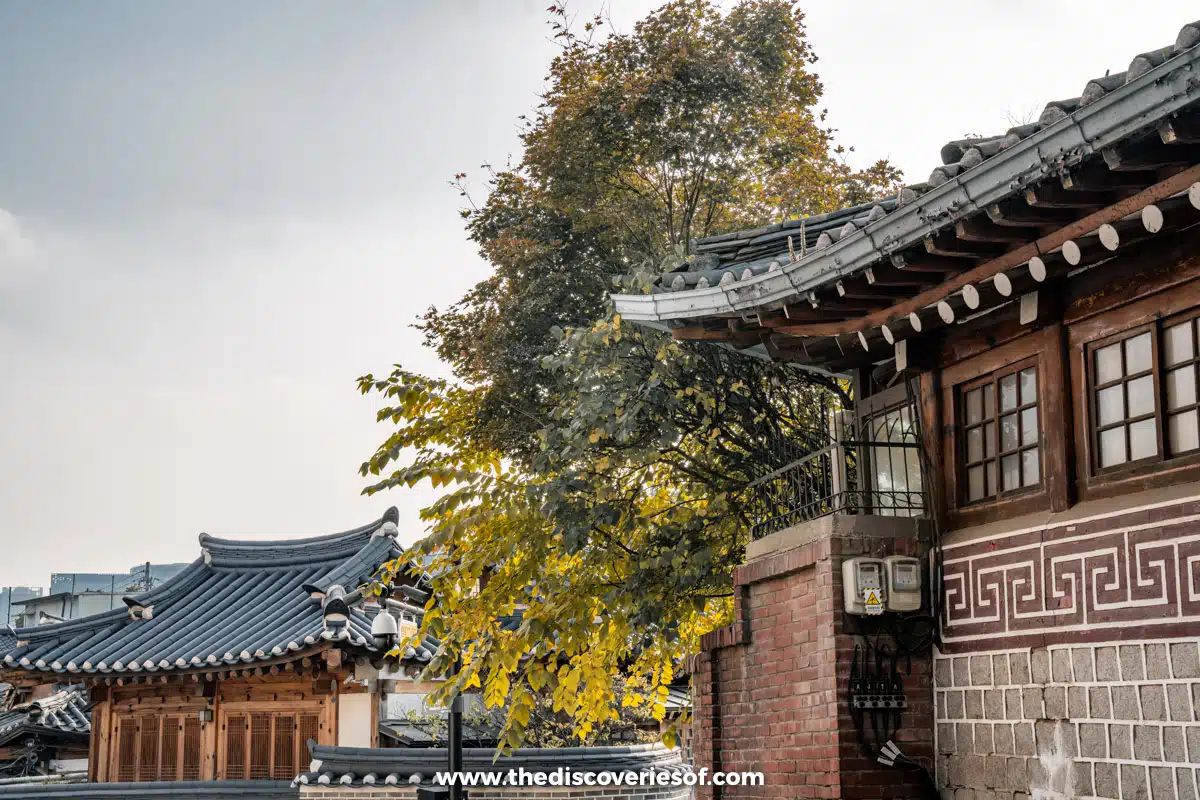
Whether you’re walking around the peaceful Namsangol Hanok Village, or exploring the bustling Bukchon Hanok Village, seeing the traditional homes made of pine, stone, and tile is another example of the well-preserved history in Seoul. The ancient homes (some dating back over 500 years) are now home to museums, shops, and tea houses, but Bukchon is still a functioning neighbourhood at its heart.
Unmissable Things to do in Seoul
Getting to Seoul
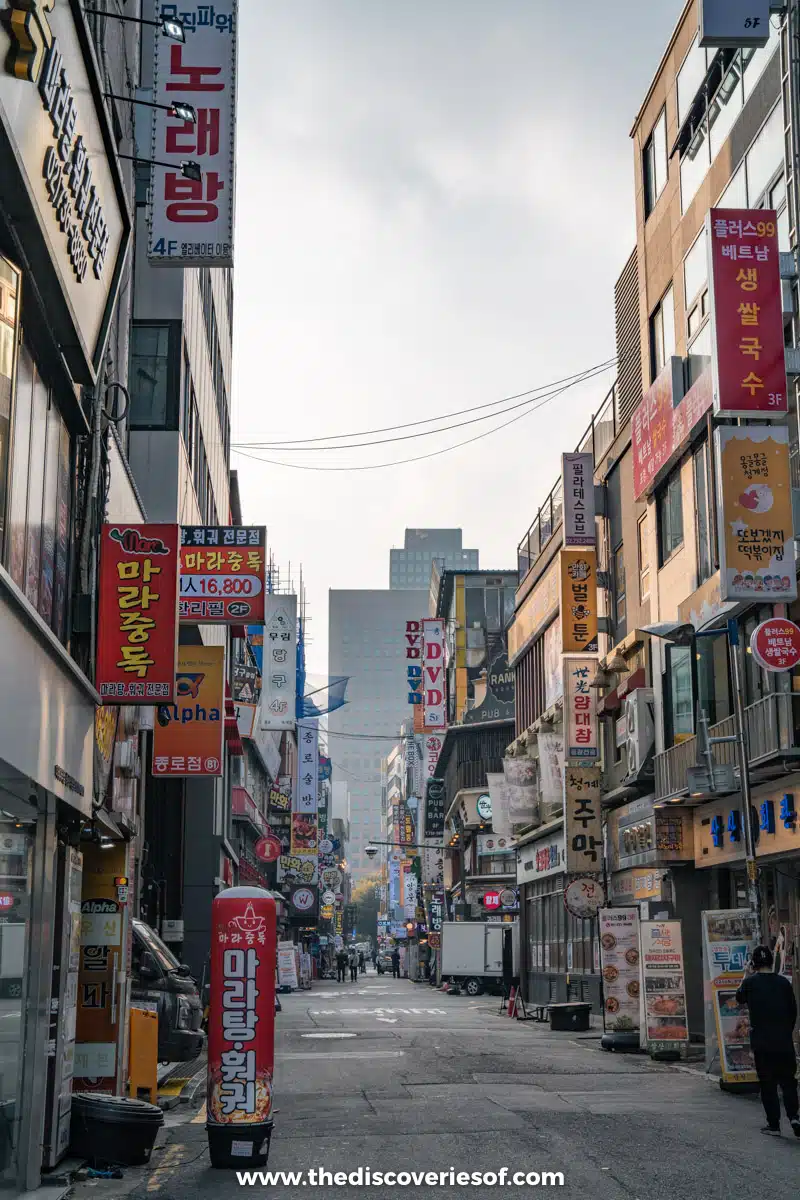
You’re most likely going to land at Incheon International Airport in Seoul, no matter which country you’re visiting from. From there, you can take a train from the terminal to Seoul Station before transferring to the Myeongdong Station and walking to your hotel. In all, it will take you just under 1.5 hours to get from your terminal to your hotel if you stay in Myeongdong.
Suggested Stay
Base yourself in Myeongdong when you’re in Seoul for access to the city’s top landmarks, restaurants, and transportation. The Four Points Josun Seoul Myeongdong offers comfortable (if a bit bland) accommodations that do have some of the better views of the gorgeous skyline. Rooms are on the small side but clean and cosy. The breakfast was a highlight, with Korean and Western options – my favourite was the made-to-order noodle station.
Check Prices and Availability for Four Points Josun Seoul Myeongdong Alternatively, Check All Accommodation in Seoul
Days 3-4: Andong
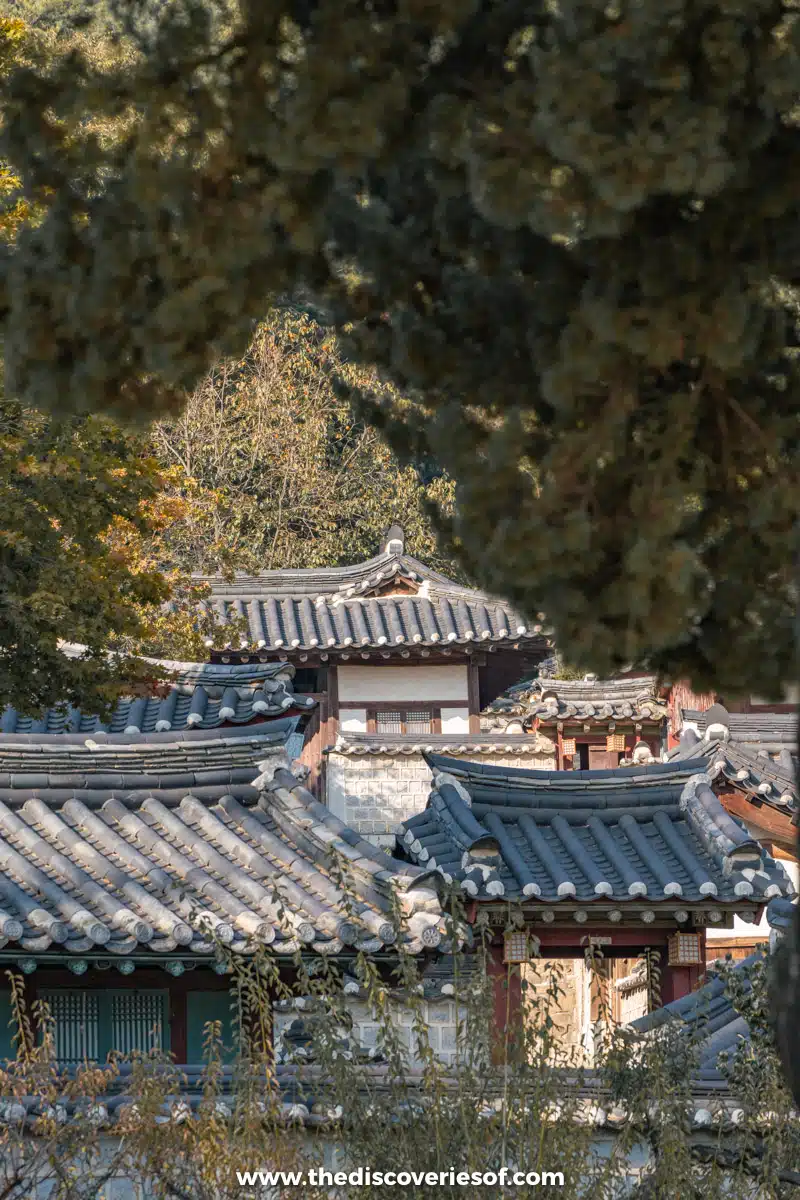
When you arrive in Andong, it’s not hard to notice a stark contrast from the bustling capital of South Korea. While walking through Seoul is an exercise in back-and-forth time travel from past to present to future, Andong is mostly rooted in centuries-old traditions and culture. I’m not complaining. I found it refreshing and enlightening to explore the UNESCO World Heritage sites like Dosan Seowon Confucian Academy, taste new (but ancient) flavours in places like Andong Set Menu Restaurant 한상채비, and walk across the Nakdong River on the country’s longest pedestrian-only bridge.
Things to Do in Andong
Dosan seowon confucian academy.
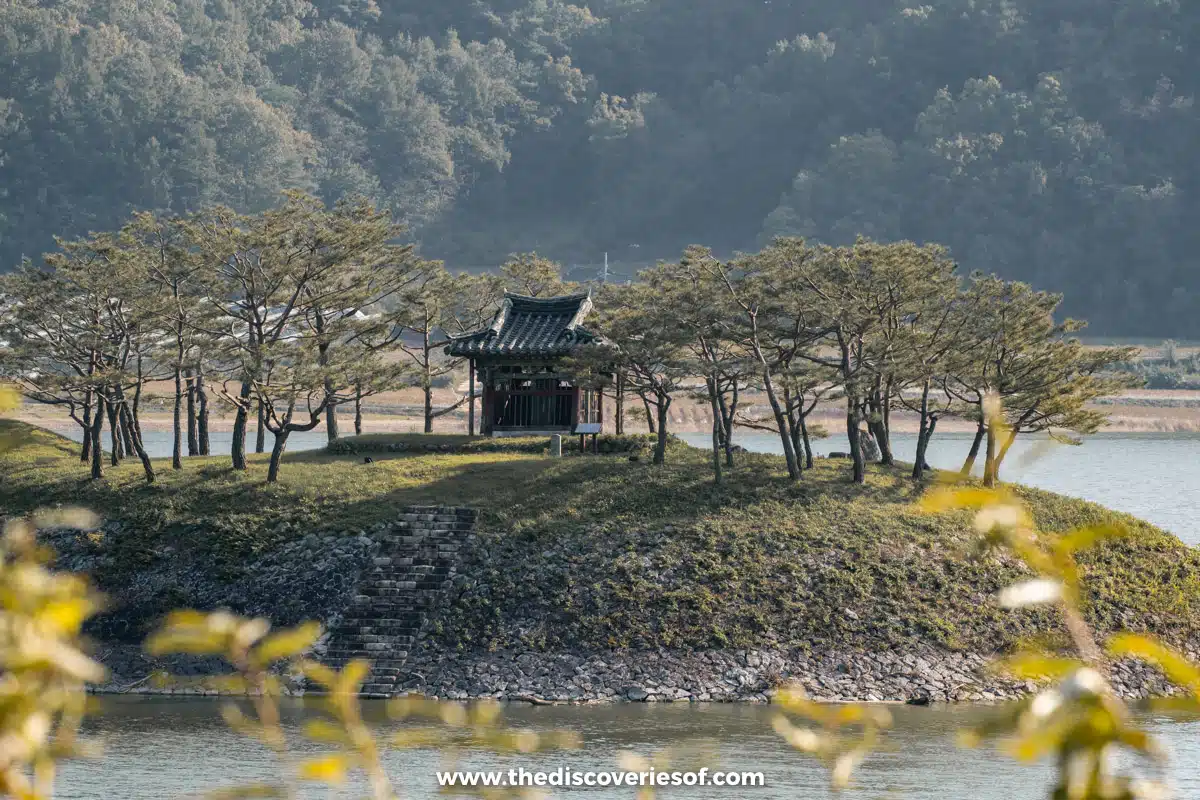
Confucianism is most commonly associated with China, but it also played a key role in Korean culture.
Yi Hwang was a well-respected Confucianist teacher in Andong, and his students created an academy after he passed away in the late 16th century. Confucianism began to fade away after the Joseon Dynasty no longer ruled Korea, but the Dosan Seowon Confucian Academy never closed. It’s a beautiful place with 17 beautiful Joseon-era buildings, and it’s no surprise it fostered deep thinking and centuries of teaching in its tranquil location by the large lake.
Dine at Andong Set Menu Restaurant 한상채비
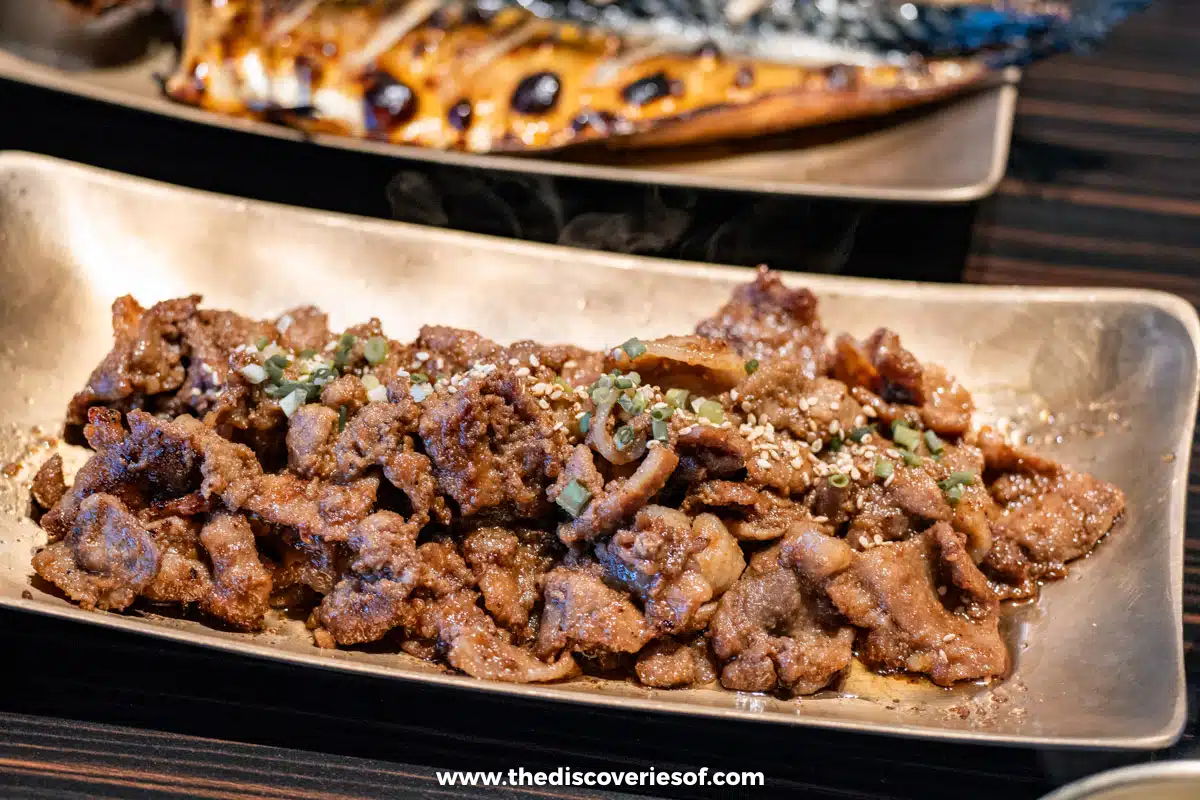
One of my favourite meals on my last trip was also the most traditional Korean restaurant I visited. The beef bulgogi, grilled mackerel, Jangajji (pickled veg), and every other dish at Andong Set Menu Restaurant 한상채비 were all spectacular.
You’ll need to go out of the way from Andong city centre, but it’s well worth the detour for the full South Korean dining experience on day 1 in Andong.
Start the Day at Nakgangmulgil Park
If you think Nakgangmulgil Park looks like a Monet painting, you’re not alone. The forests and ponds are picture-perfect and a beautiful place to wake up and enjoy the scenic side of Andong.
Try the Famous Chicken at Andong Old Market
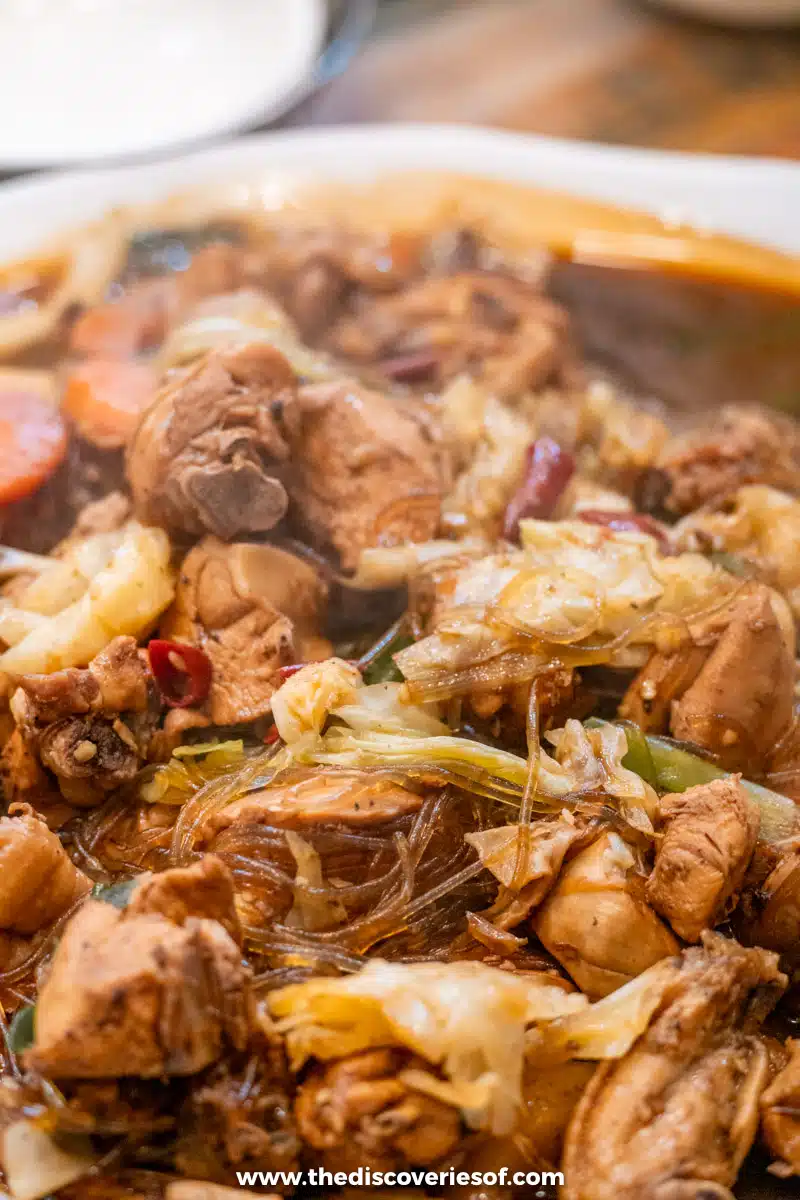
Walking past the lively stalls selling pastries, seafood, and fried chicken, you can’t help but fall in love with the aromas and flavours in this long-standing marketplace.
Don’t miss a chance to have a meal at Andong Shinsegae Jjimdak. The savory braised chicken over glass noodles is a classic dish in Korea, and there’s no better place to try it.
Go Wine Tasting at 264 Lee Yuk Sa Winery
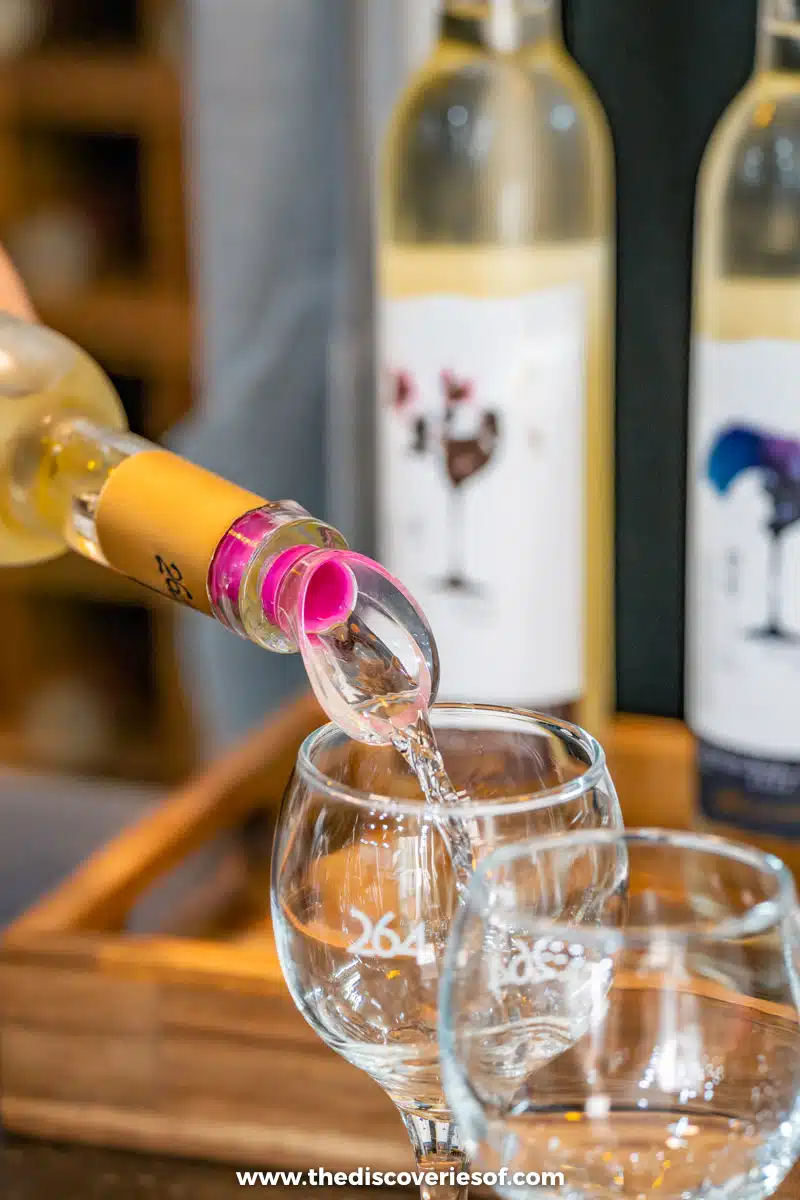
In an area so steeped in tradition; it’s a bit surprising to find a winery pushing the boundaries of local horticulture. But 264 Lee Yuk Sa Winery is a kind of tribute to famous poet and Andong hero Lee Yuk-sa, who died in a Beijing prison due to his affiliation with the Korean Liberation Army. Even though the winery is only a few years old, I thought they put out some impressive juice. The Cheongsu was a really fun white wine with a dry floral note that was better than I expected.
See the Light Show at Woryeonggyo Bridge
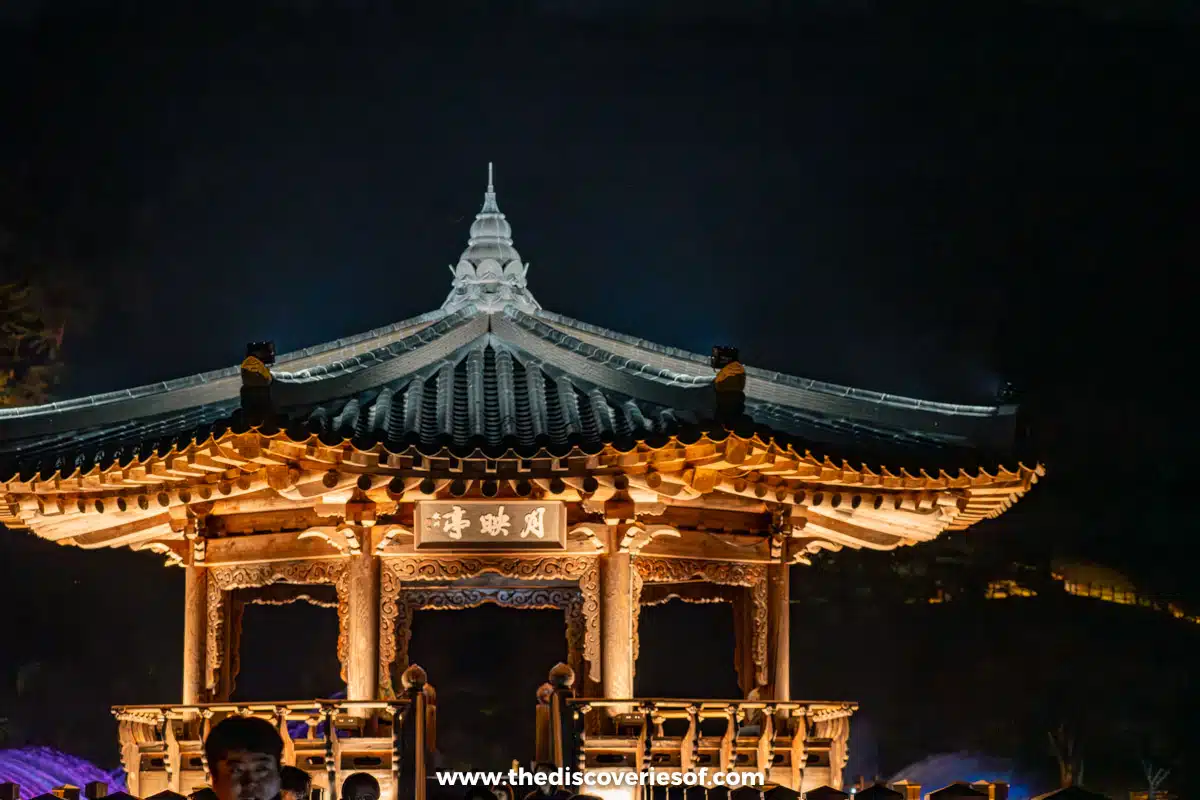
Take a walk on the longest pedestrian-only bridge in South Korea when you visit Andong. The Woryeonggyo Bridge is in a beautiful setting over the Nakdonggang River, but it’s especially striking at night.
Visit around 8 pm or 10 pm for a special show that lights up the water and temple in the middle of the bridge.
Getting to Andong
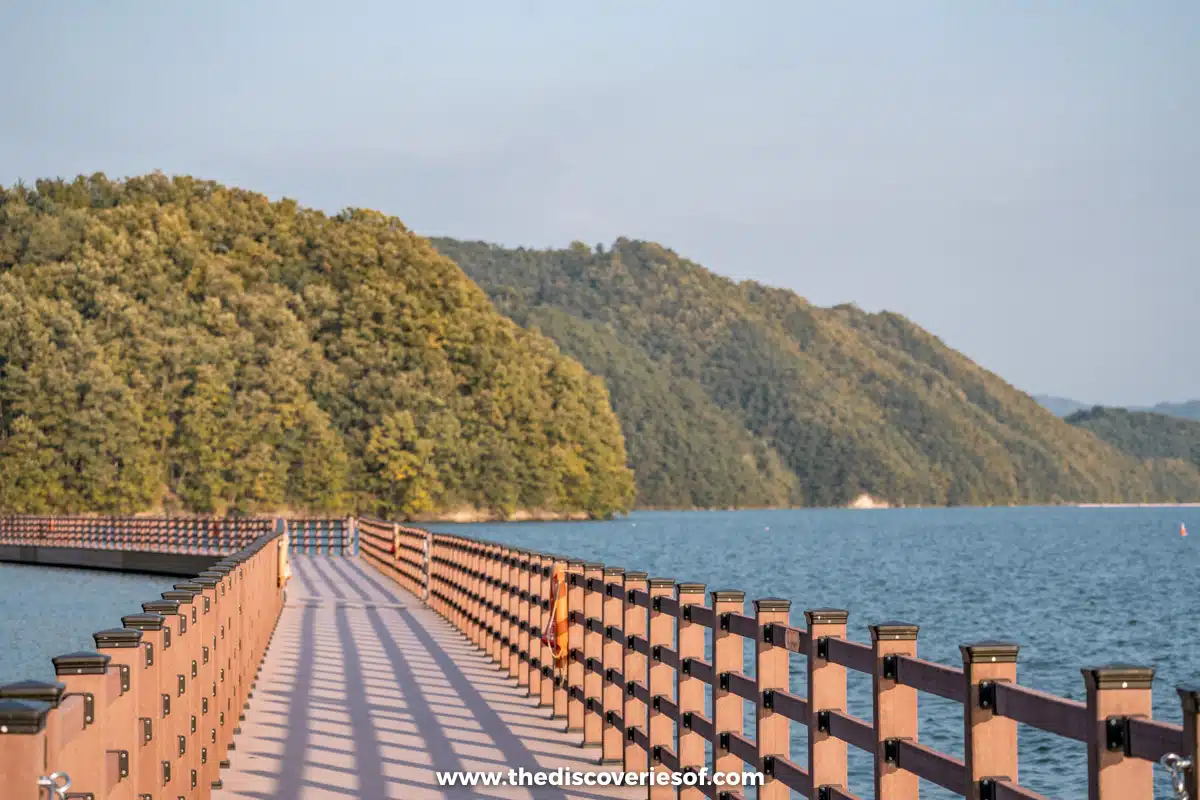
You can reach Andong from Seoul by bus or train. My advice? From the Cheongnyangni Station, take the high-speed KTX train, which will get you there in about 2 hours.
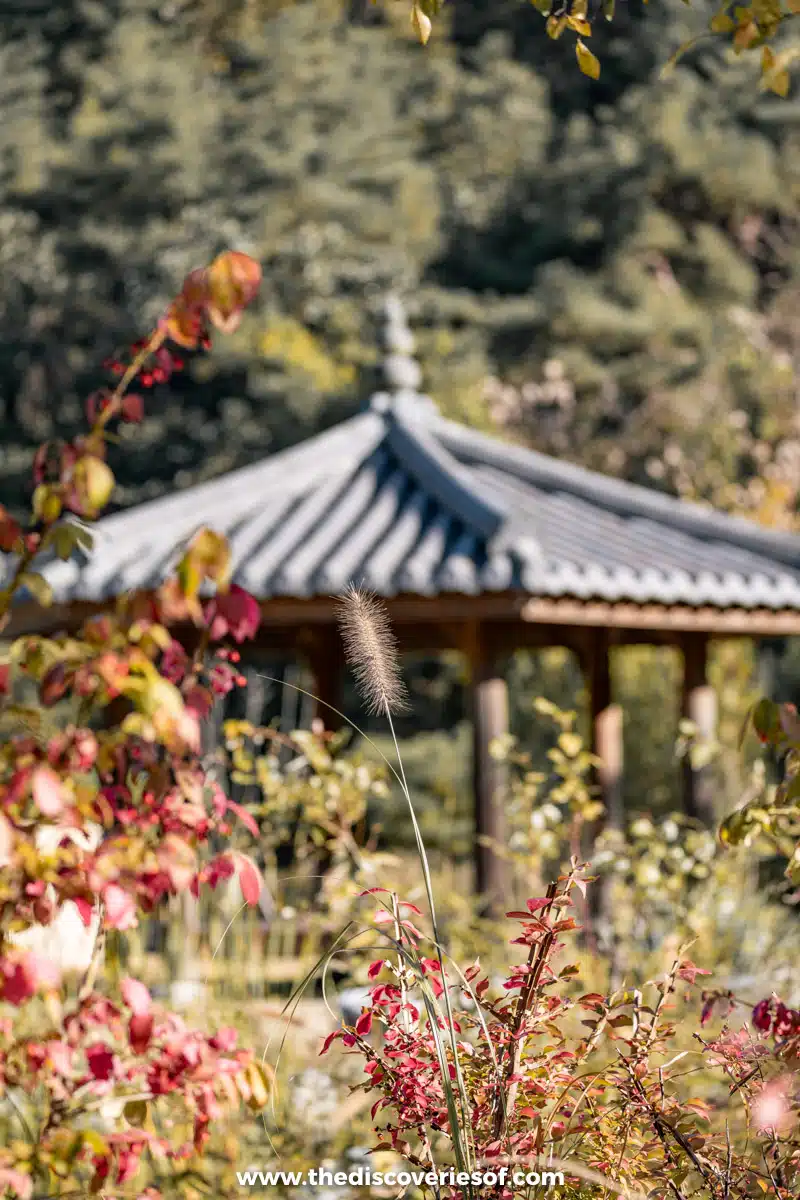
If you don’t mind going a bit out of your way, Andong Gurume Resort allows you to stay in a gorgeous Korean Hanok village. You can choose from several different room styles, each with a traditional design and a complimentary breakfast each morning.
Check Prices and Availability for Andong Resort Gurume Alternatively, Check All Accommodation in Andong
Days 5-7: Busan
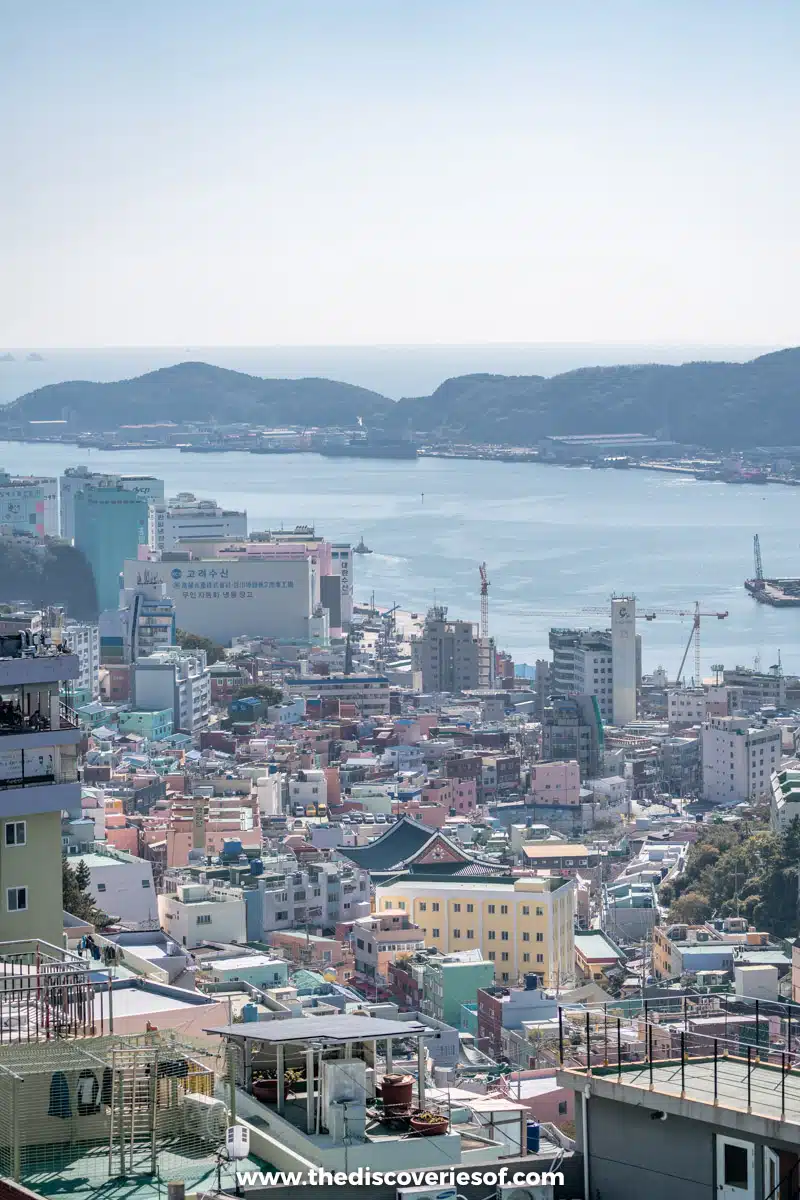
If you want to visit one of the most picturesque areas in the country, make sure you add Busan to your South Korea itinerary. The port city along the southern coast of South Korea is not only a delight for outdoor enthusiasts and foodies, but it also has a deep history related to the Korean War. Because it’s the 2nd largest city in the country and one of the most important ports, it was crucial that the UN helped defend the peninsula from the Korean People’s Army in the earliest months of combat. Now, Busan is home to the only UN Memorial Cemetery in the world.
Things to Do in Busan
Un memorial cemetery .
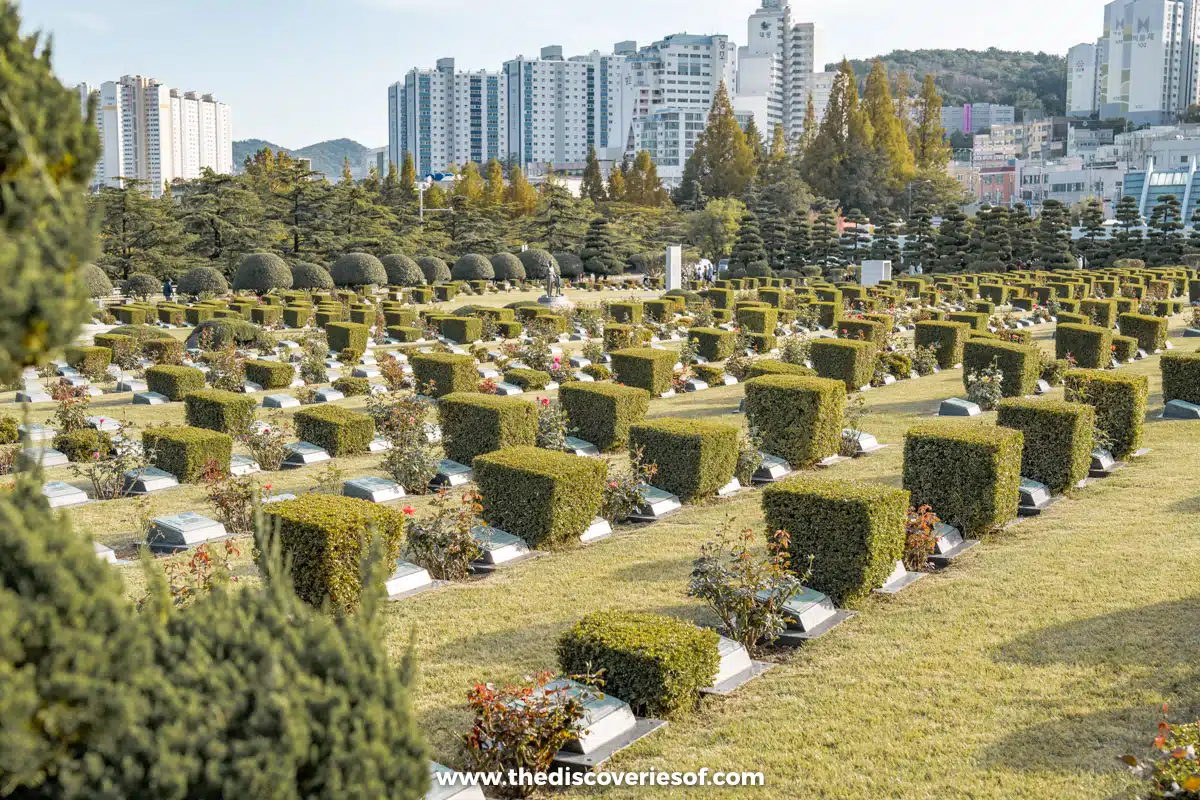
You can’t overstate the importance of Pusan (Busan) in the Korean War, and the UN Memorial Cemetery gracefully paints the tragic (but heroic) picture of the worldwide effort to retain South Korea’s independence. It’s the only UN cemetery in the world and a sobering reminder of the bloody war. Make sure you attend the UN flag raising and lowering and watch the educational video about the soldiers, which we were all in tears over by the time we left. This is a good way to learn more about the city’s history on your first day in Busan.
Try Korean Sashimi for Lunch
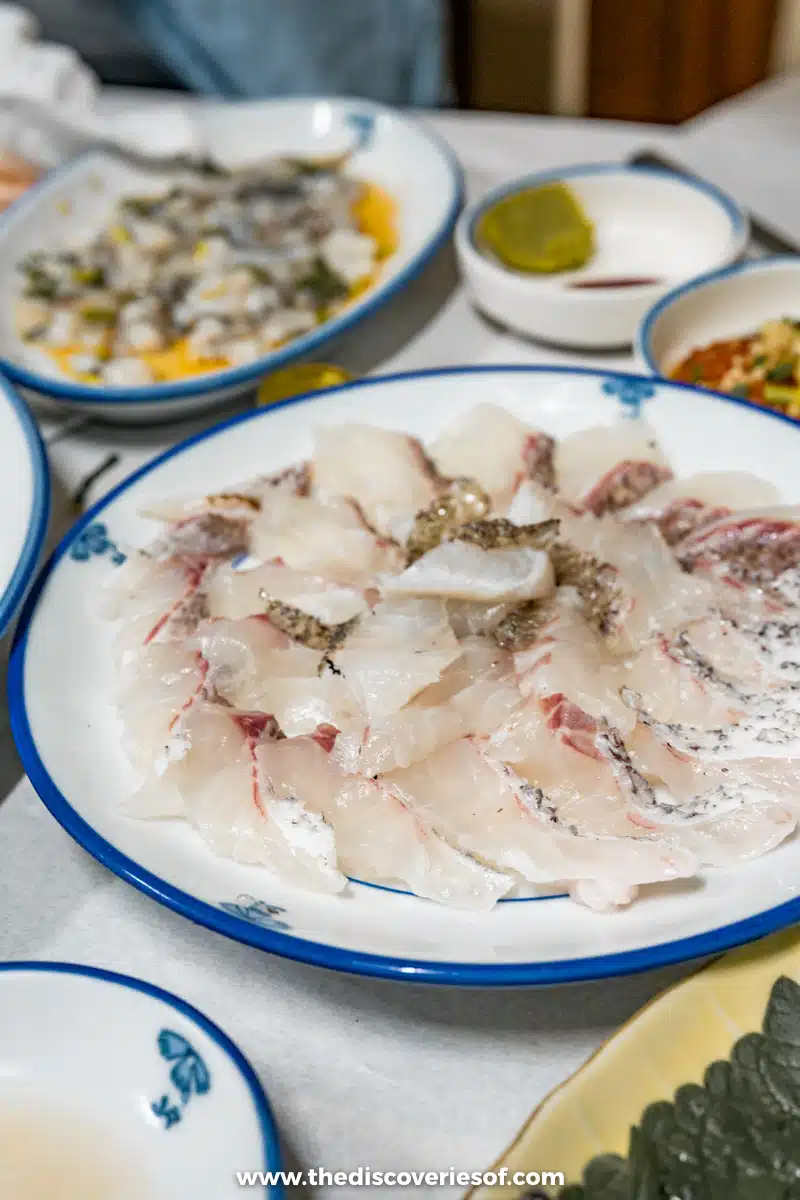
I know you may think sashimi is best in Japan, but hear me out – Koreans enjoy it just as much, and Bangpajae Hoetjip has it down to a science. Choose the fish of your choice when you walk in, and dive into anything from the fresh catch of the day to something a bit more adventurous, like the live octopus. I found the latter a bit challenging, but if you can get over the suckers trying to put up one last fight, it’s a dish with delicious flavours.
Ride the Busan Air Cruise
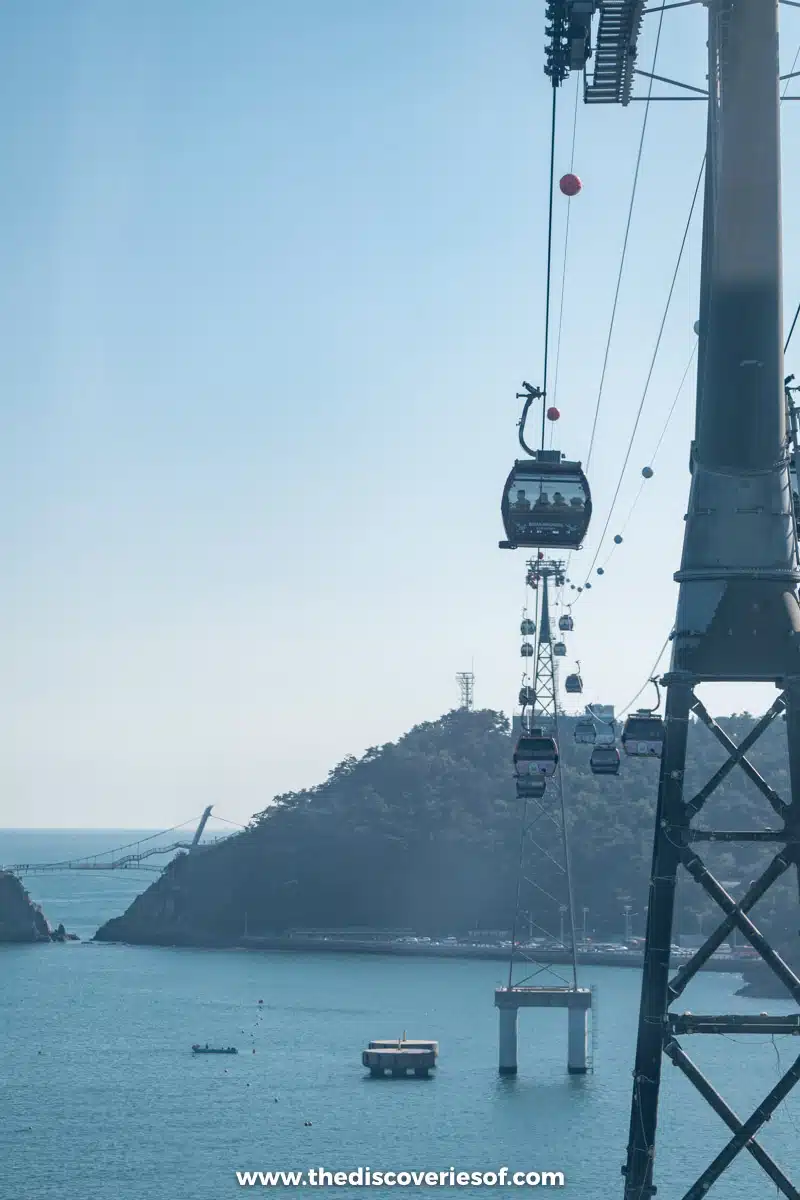
One of the best ways to take in any city is from an aerial perspective, and hopping aboard the Busan Air Cruise is one of the more impressive rides with a view I’ve taken.
Not only do you get incredible vantage points of downtown and Songdo Bay, but you’ll see the rugged cliffs and water right under your feet.
The museum on the top is kind of strange, but the city and ocean views are seriously amazing.
Splurge on a premium ticket for a better look from the glass floor below your feet.
Visit Gamcheon Cultural Village
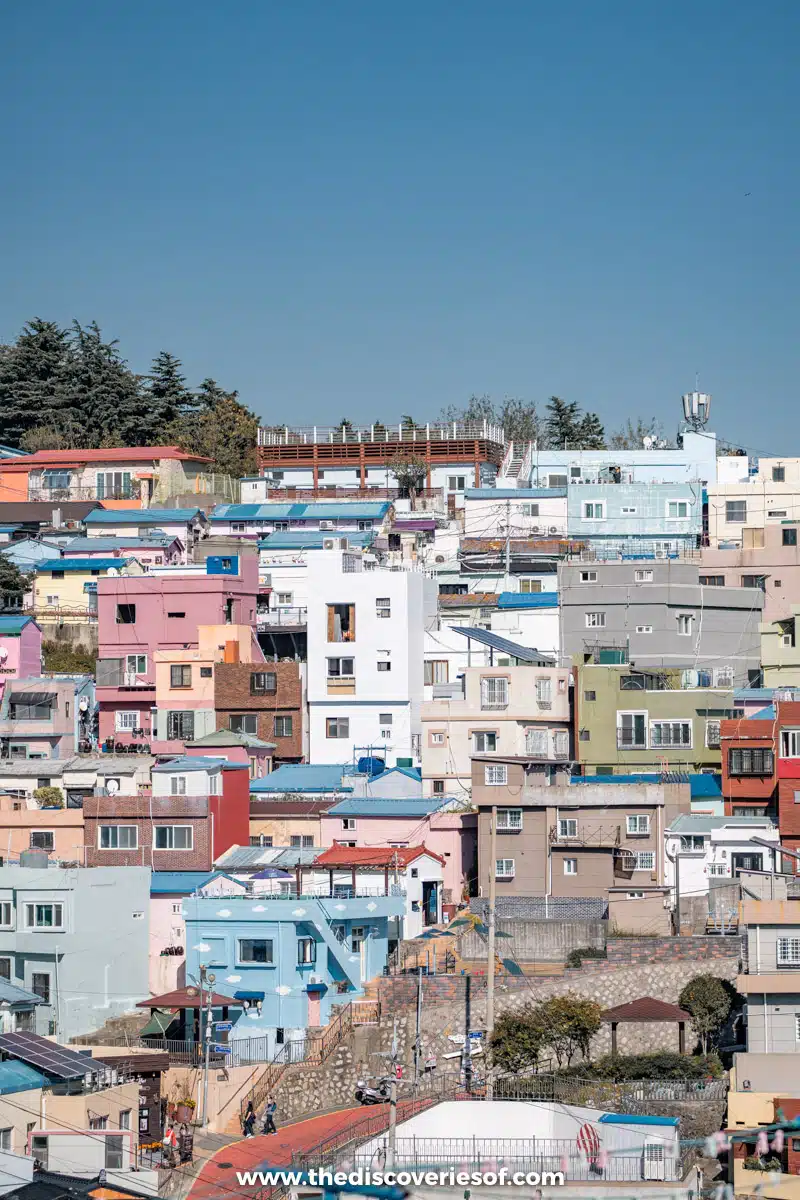
Start your second day in Gamcheon Cultural Village, which is quickly becoming a top tourist destination in South Korea. The historic neighbourhood got a bit of a facelift in 2009, and now the rows of densely packed hillside houses with colourful wooden facades and brightly painted street murals is one of the most photogenic areas in Busan.
Stand-Up Paddle Boarding at Gwangalli Beach
Try stand-up paddle boarding on Gwangalli Beach, where you’ll have picture-perfect views of the skyscrapers and Gwangan Bridge from a SUP. The best part? You can rent them right off the beach! The conditions can get a tad gnarly, but that’s part of the appeal. I think this is best at sunset, so plan for a late dinner.
Have Dinner at Korean Steak Grill
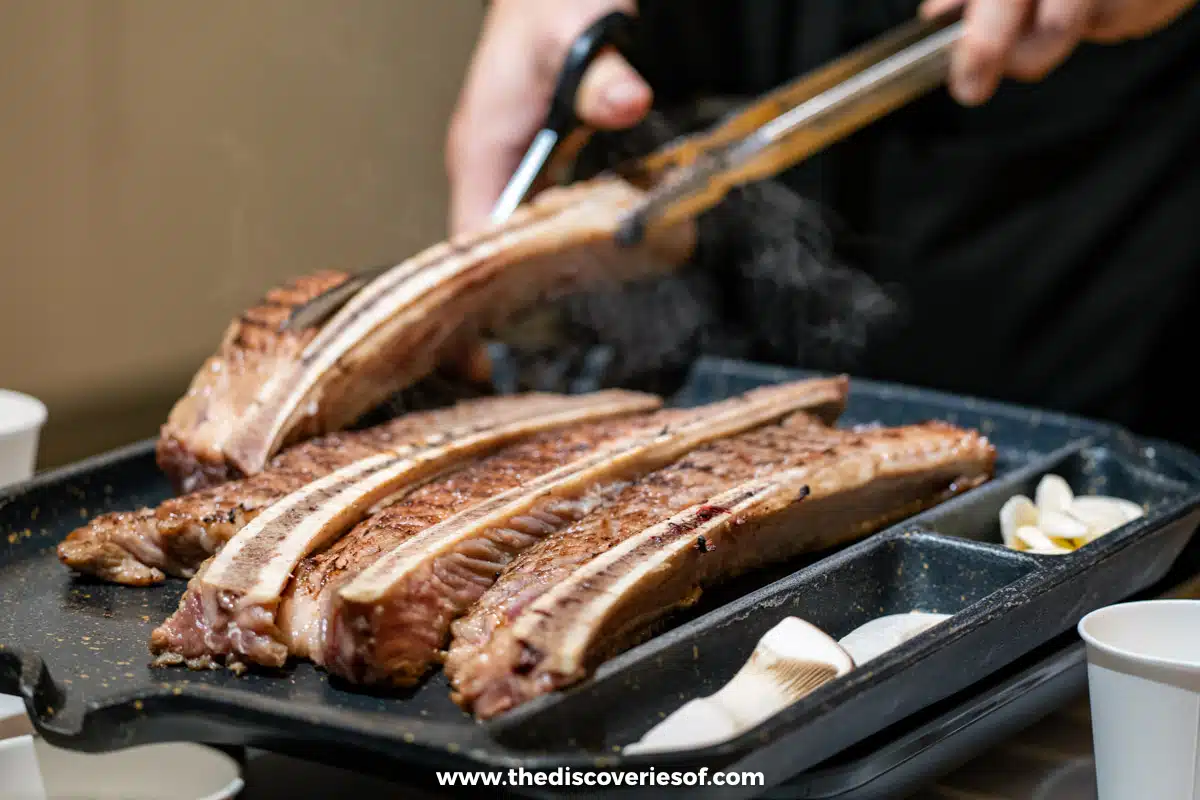
It’s really hard to narrow down my favourite restaurant in South Korea. Borderline impossible.
Nonetheless, this Korean Steak Grill (전설의 우대갈비 해운대직영점 ) between Haeundae Traditional Market and Haeundae Beach is what Korean BBQ dreams are made of (the views by the window are great, too).
So, what should you order? The steak on the bone is a must. It’s grilled at your table and then cut into small pieces for you to tuck into in sheer bliss. It’s divine.
Visit Haedong Yonggungsa Temple
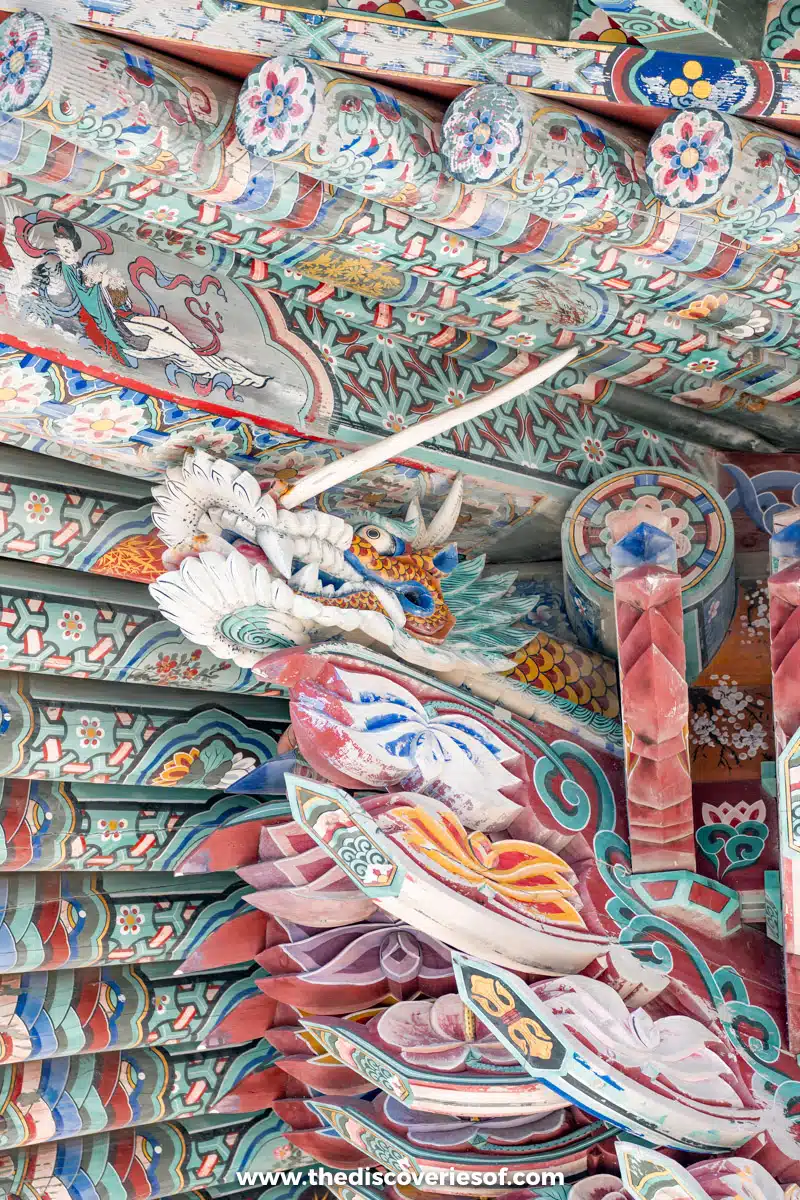
On your last day in Busan, take a day trip to Visit Haedong Yonggungsa Temple, just under an hour bus ride from Haeundae Station.
The oceanside landmark is a beautiful example of a Korean Buddhist Temple, with a rich history dating back to the 14th century and wonderful recreations of Joseon Dynasty-era architecture.
Take a full-day tour of Busan, with a stop at the iconic temple .
Watch the Sunset in Huinnyeoul Culture Village
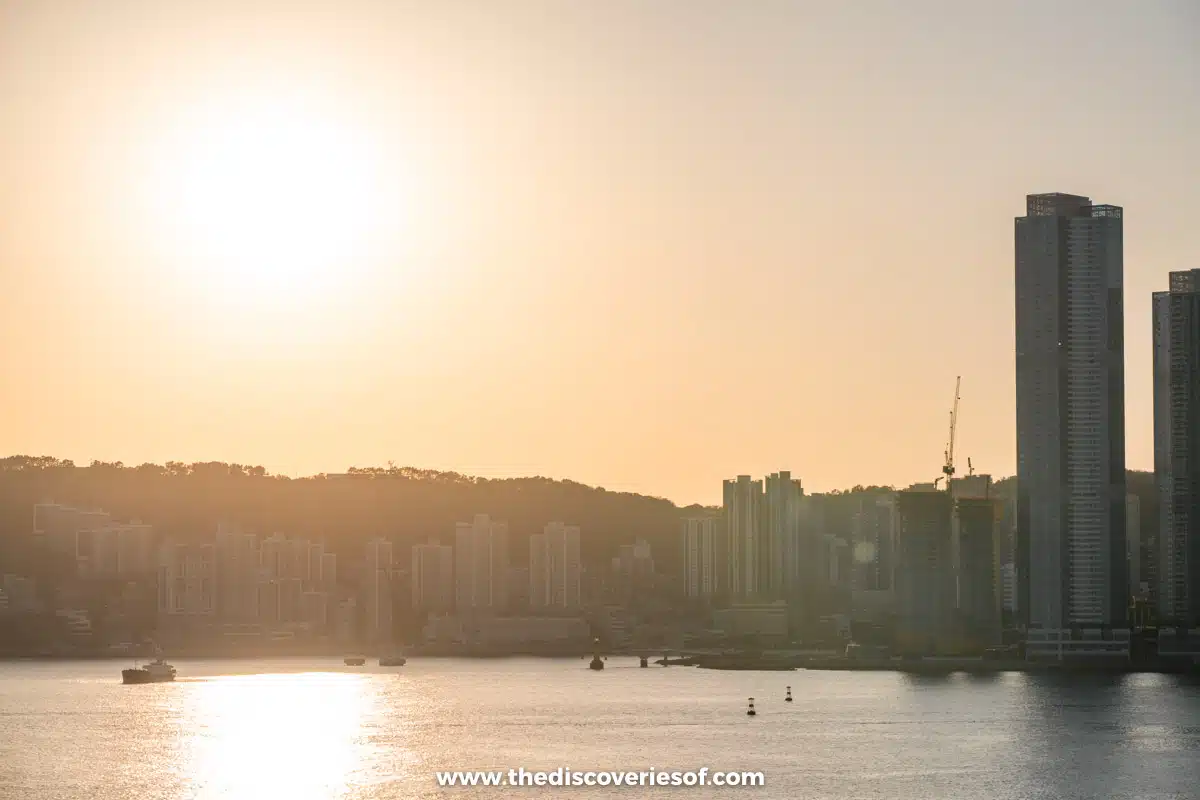
Save yourself time to visit the “Santorini of Korea” and go to Huinnyeoul Culture Village in the afternoon. You’ll find over a dozen murals (you can pick up an information guide near the village entrance) in the charming coastal village and some ridiculous sunset views from the Huinnyeoul Trail.
Spend 3 Days in Busan with this itinerary
Getting to Busan
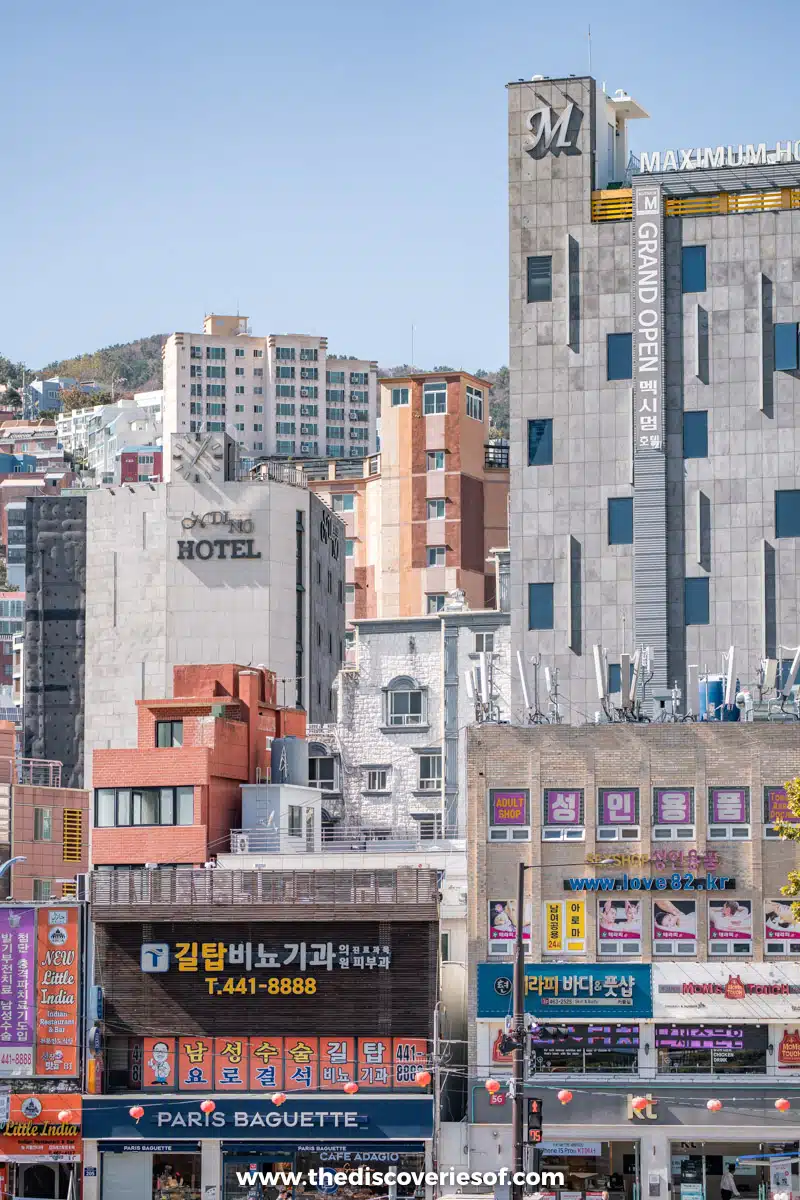
You can travel from Andong to Busan by train or bus. Both options will take around 2-2.5 hours, door to door, so either will work just fine.
Grand Josun Busan boasts sleek, modern rooms in a beautiful property near Haeundae Beach. The luxury hotel features a pool, spa, and stunning vistas from the rooms and suites
Check Prices and Availability for Grand Josun Busan Alternatively, Check All Accommodation in Busan
Days 8-9: Jeonju
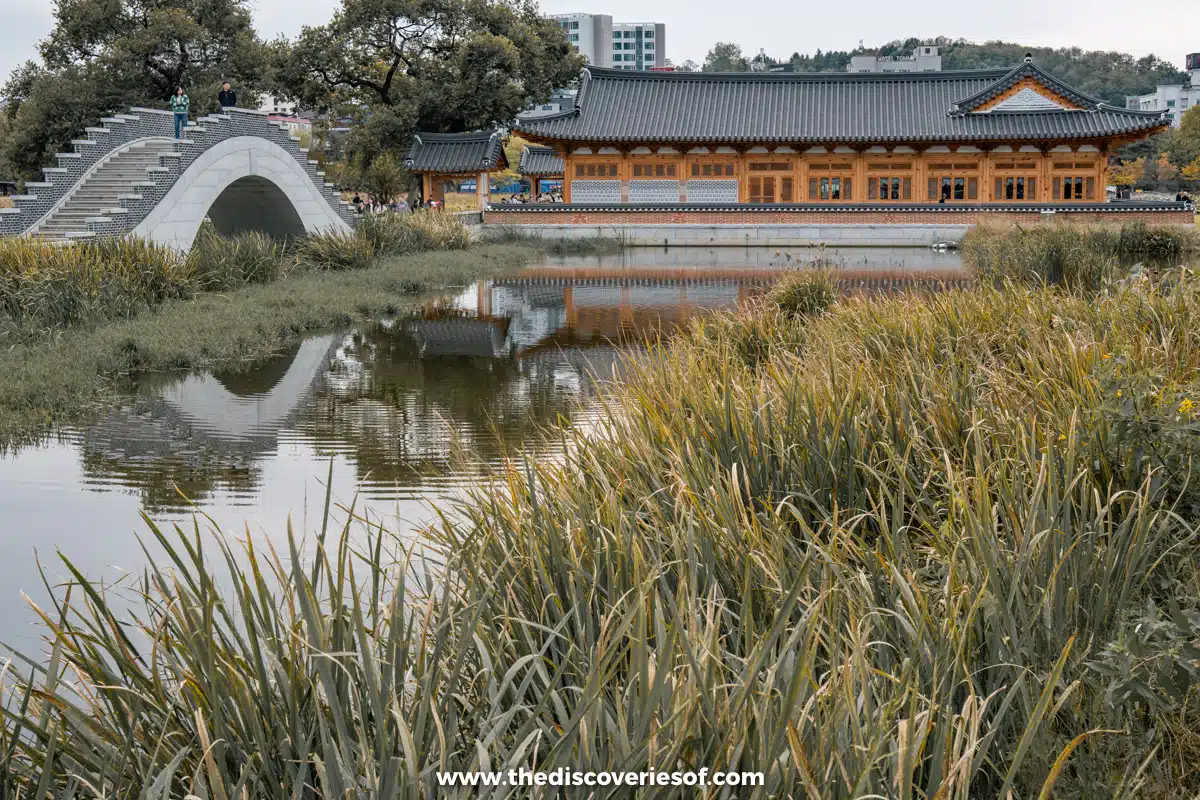
If you’re beginning to pick up on a theme in Korea, it’s that the food is absolutely incredible.
I’m not kidding when I tell you that each city I went to left me reeling about how exciting the culinary scene was. Jeonju might have been my favourite.
You’d expect no less out of the place where bibimbap originated, right? Oh yea, it’s also a UNESCO City of Gastronomy.
From making the Korean fermented beverage Moju to eating more pork in one sitting than I thought possible, culinary treats are around every corner in Jeonju. That said, I was surprised by how much there is to do here besides dive into the incredible food and beverage.
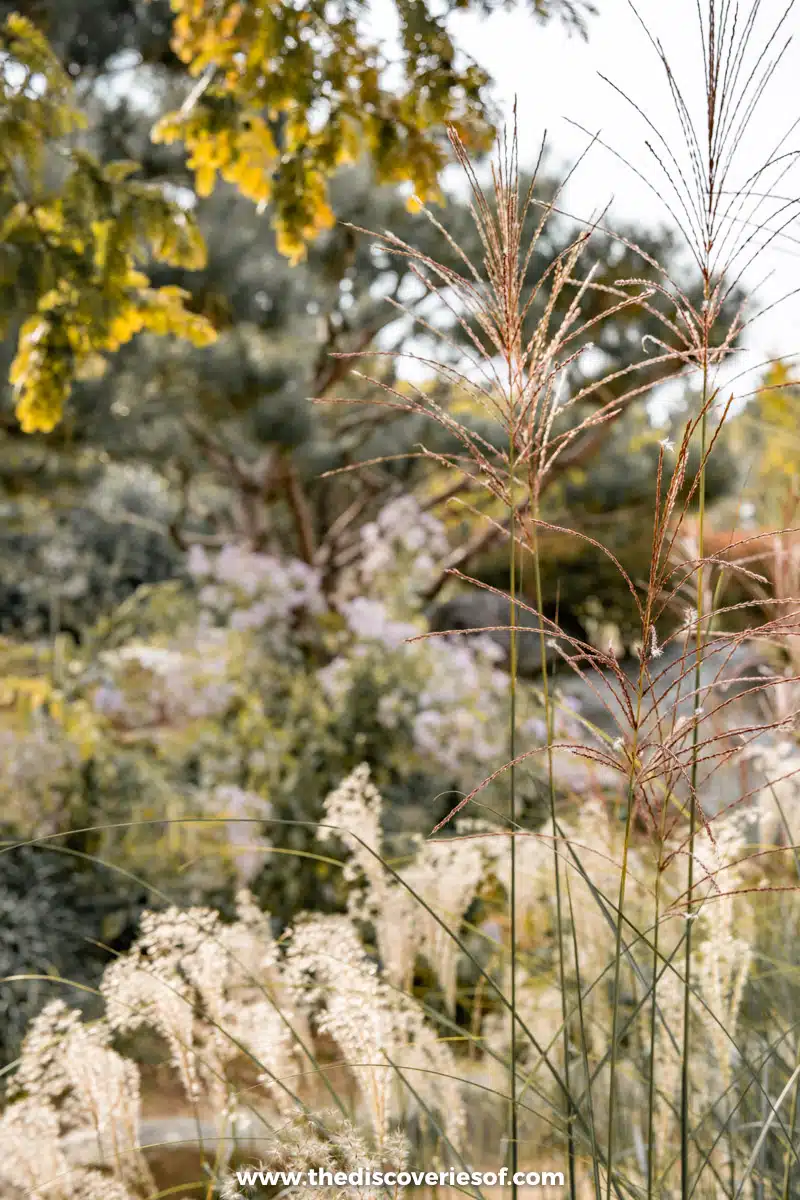
For starters, the gorgeous free open spaces like Jeonju Arboretum or the lakeside Deokjin Park are a welcome respite from the busy city streets. There’s also a deep commitment to education and the arts, which you can explore by signing up for cooking classes , pottery demos , or taking a stroll through the Yeonhwajung Library in a gorgeous Hanok. In all, Jeonju is so lovely that I would say you can’t plan a trip to South Korea without including it on your itinerary.
Things to Do in Jeonju
Jeonju arboretum.
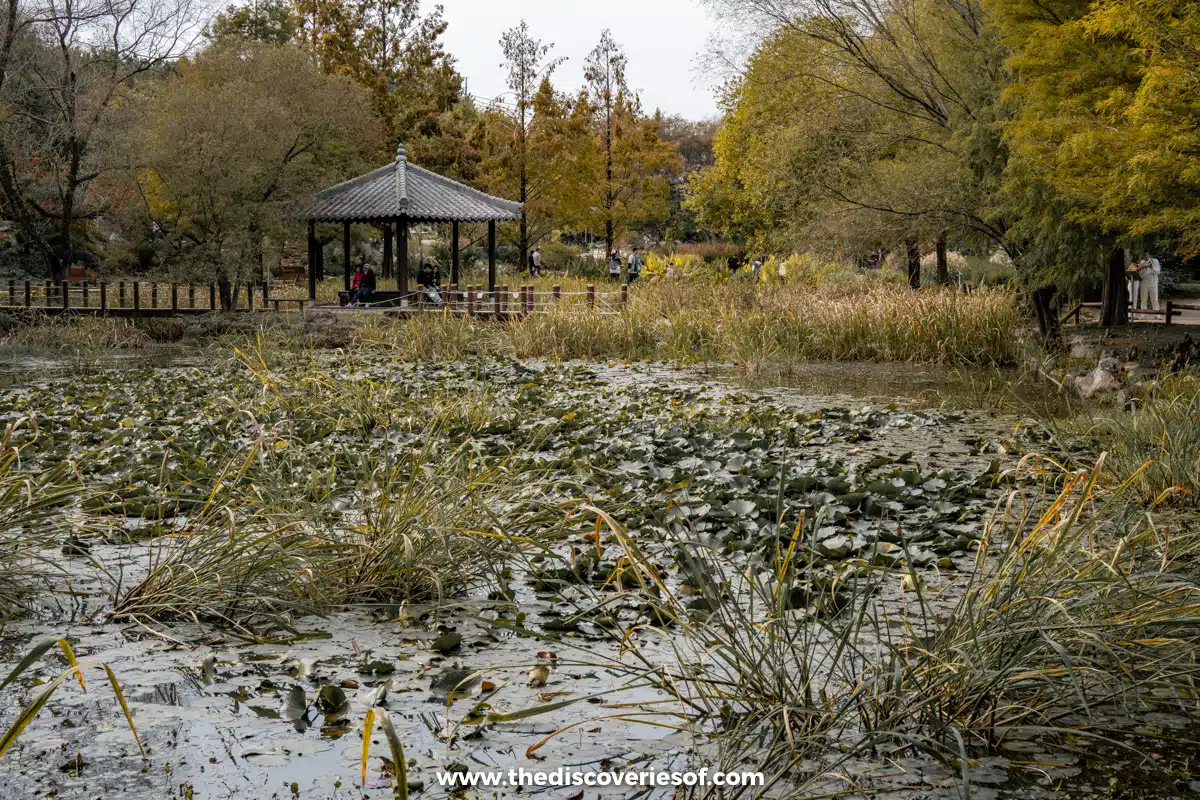
Jeonju Arboretum is home to one of the most beautiful parks in the city, and it’s even free to stroll through and look at the abundance of flora and fauna. It’s a stunning garden, which sprouted up after the expressway left the land in less than desirable shape. They transformed it into a tranquil space that is especially beautiful in the fall, when the pink muhly is in peak bloom.
Visit the Gyeonggijeon Shrine
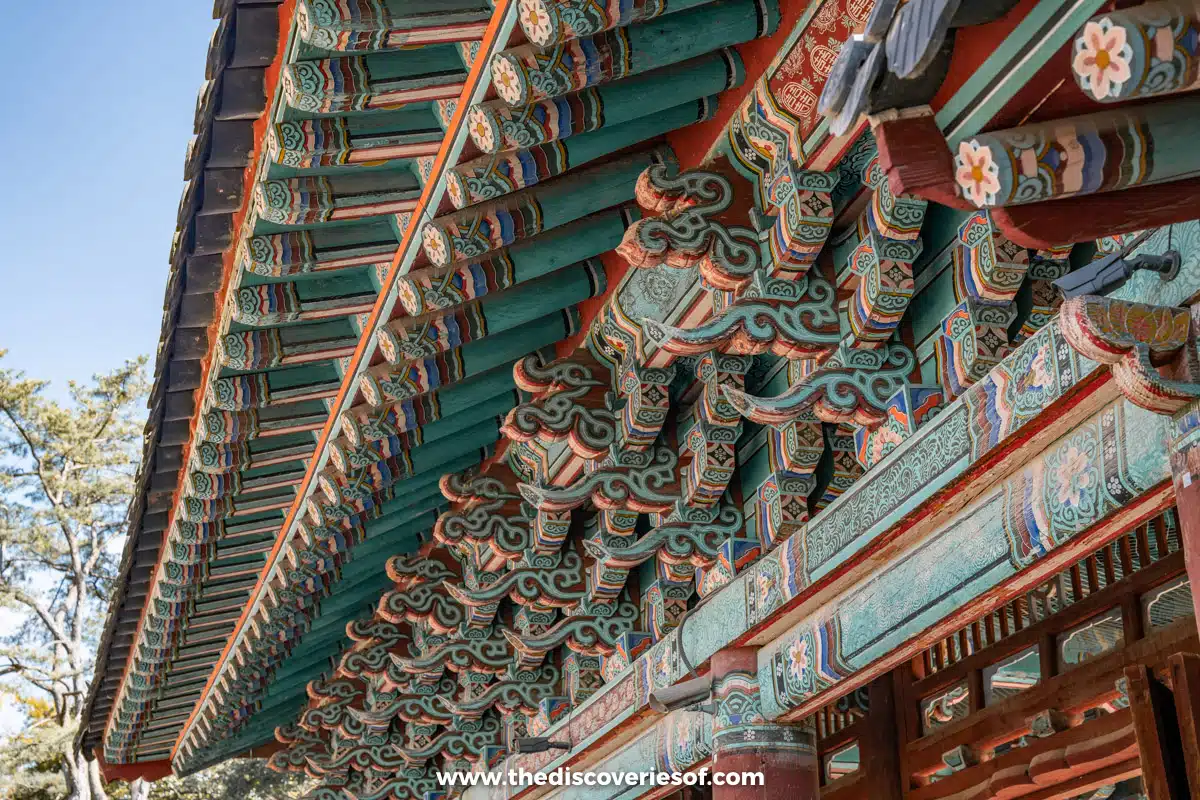
The 15th-century Gyeonggijeon Shrine is a beautiful example of Joseon Dynasty architecture in Jeonju and was built as the home of a portrait for the first ruler King Tae-jo. Despite being damaged during a Japanese invasion in the 16th Century, the building is still beautiful inside and out and home to portraits of numerous Joseon Dynasty royalty over the 400+ years of their rule.
Make Your Own Moju
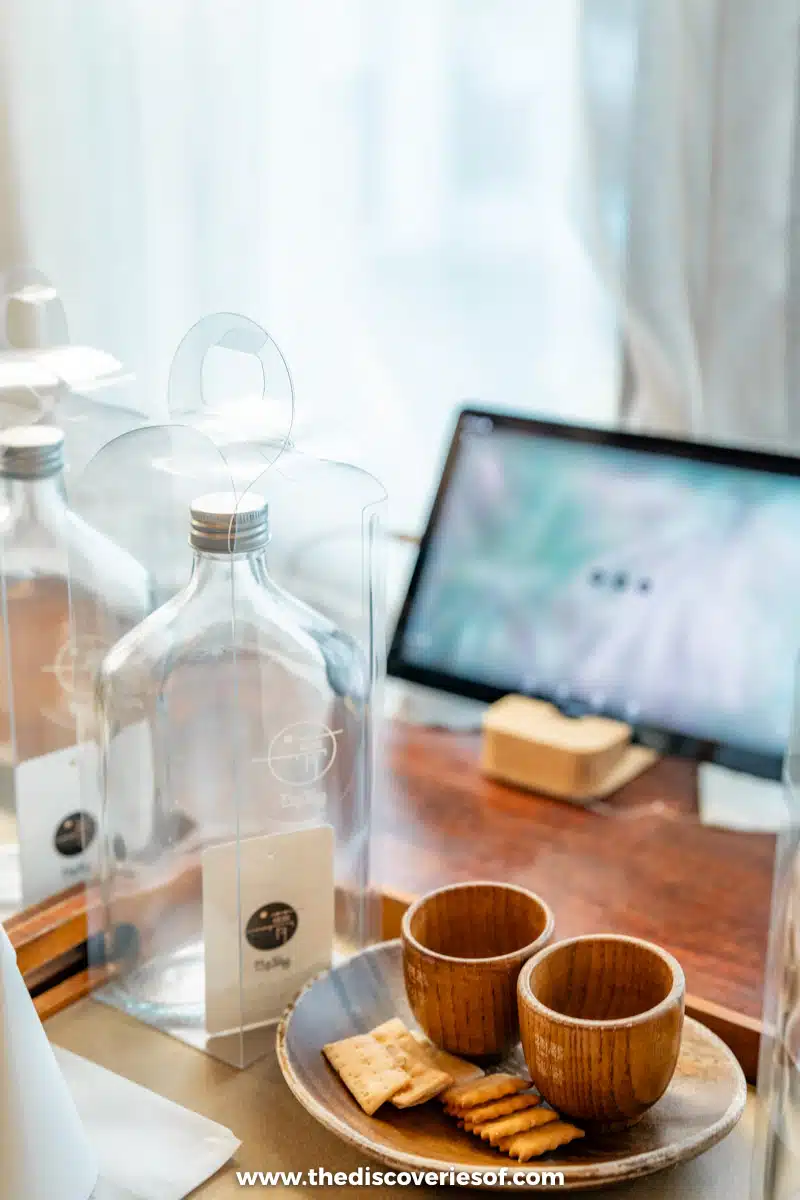
If you’re looking for a cool activity to try while you’re in town, try making the fermented Korean rice wine bevvy known as moju.
First time trying moju? Not to worry. You can choose from 3 different recipes, each with unique ingredients
Decide on your favourite in this fun guided class through Airbnb .
Explore Jeonju Hanok Village
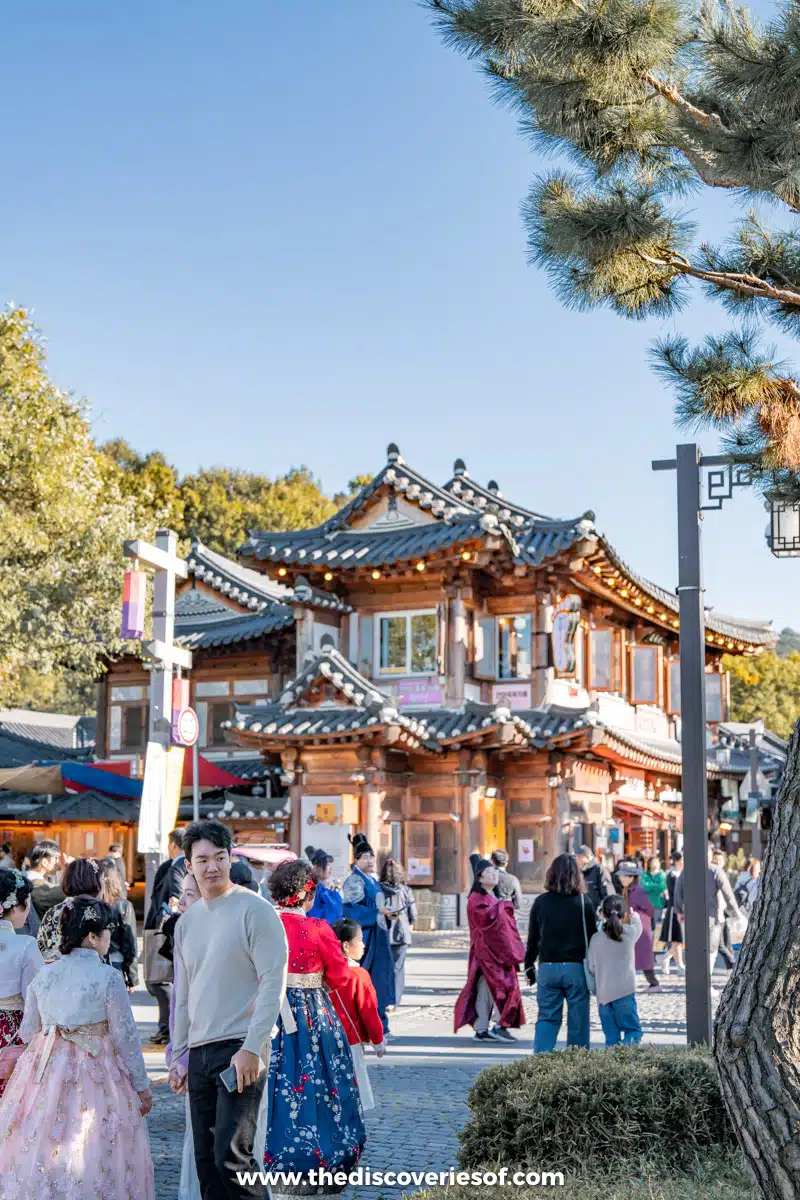
One of the best memories of my most recent trip was walking through Jeonju Hanok Village.
Locals and visitors dress up in traditional Korean hanbok dresses and stroll around the town, a beautiful reminder of the rich cultural traditions in Jeonju. You can even rent them at a local shop .
Head to the Jeonju International Film Festival in the spring, which helps bring to life a place that’s already brimming with tradition.
Dinner at 경성금돼지 – Pork Grill Restaurant
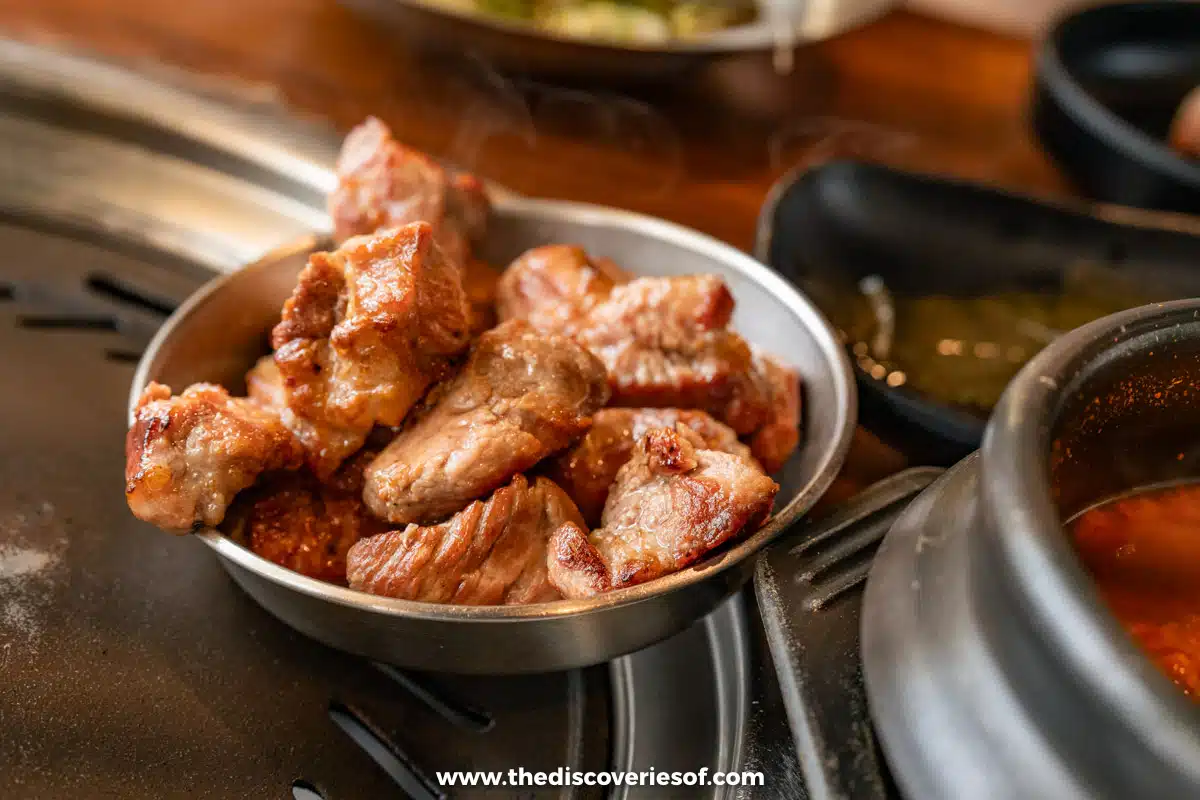
Had plenty of grilled meat? Sorry, but make room for more. This excellent restaurant dishes up unctuous cuts of pork grilled to perfection at your table. The prices are reasonable, and the atmosphere is festive and social. So, come hungry and enjoy some cold noodles and kimchi alongside too much meat for one person to comfortably take down.
See Deokjin Park at Night
After you enjoy dinner, head to Deokjin Park to see why locals love the beautiful urban green space after the sun goes down. The pond lights up from the lights along the walkways and nearby University buildings. Still, it’s the stunning Yeonhwajeong Library with its traditional Hanok facade that really lights up the park at night.
An insider’s guide to exploring Jeonju
Getting to Jeonju
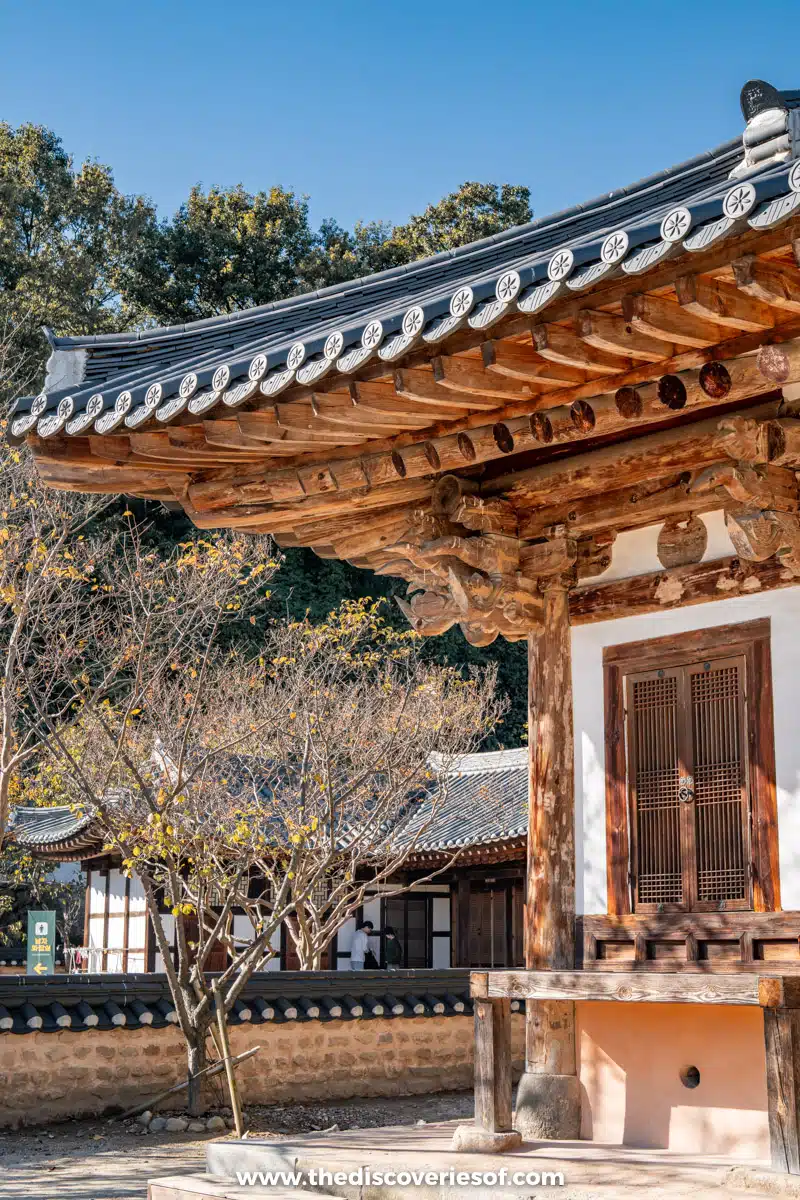
Jeonju is easy to get to from Busan. You can take KoBus and reach the city in 3 hours or take a train from Cheonan Asan Station, a short bus ride away from Jeonju.
Lahan Hotel Jeonju is a popular modern hotel overlooking the city and traditional Hanok village. The rooms are large, the beds are comfortable, and it’s a perfect location for exploring the city.
Check Prices and Availability for Lahan Hotel Jeonju Alternatively, Check All Accommodation in Jeonju
Day 10: Seoul
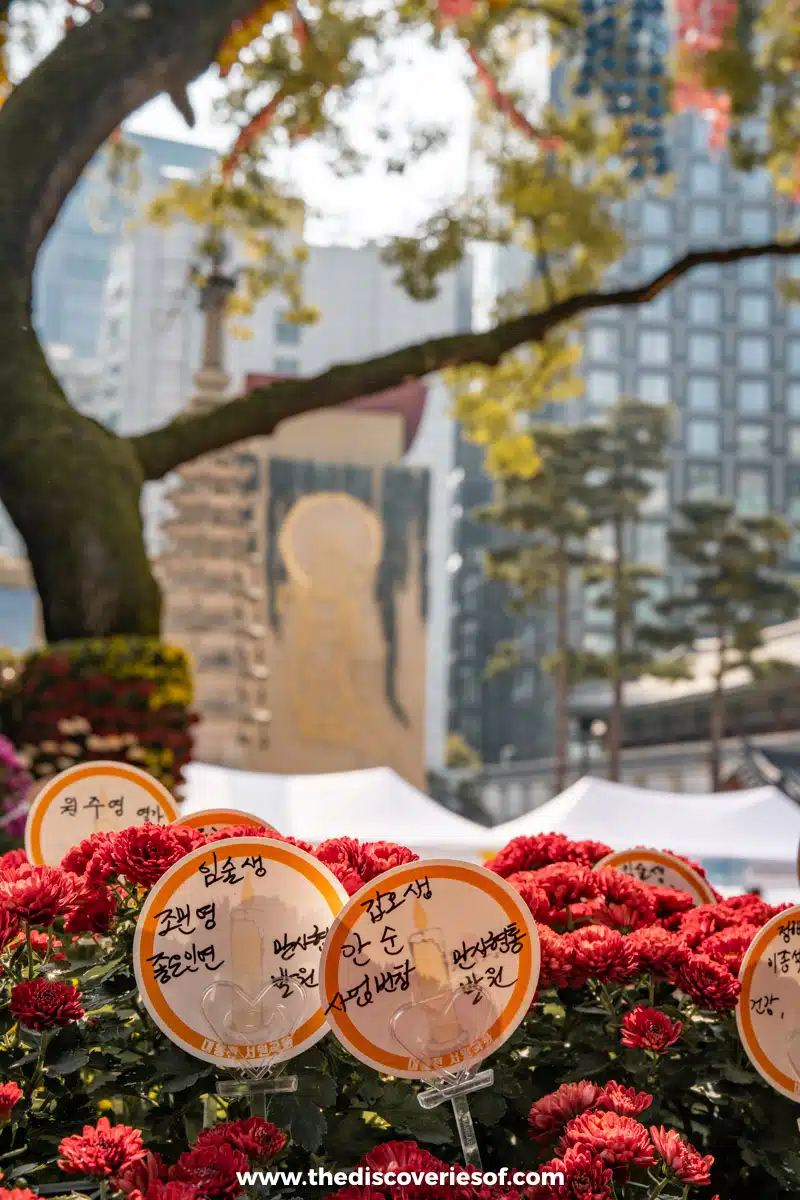
Now that you’ve checked a few of Seoul’s most popular tourist boxes, it’s time to see the city like a local. Start at Cheonggyecheon Stream, where you can hang out at numerous spots along the 10.9 km (6.7-mile) stream known for its street art, bridges, and famous Unicorn Horn art installation.
After that, check out the vendors at the bustling Gwangjang Market or explore the vibrant shopping and dining scene in Myeongdong; I promise when you start digging deeper into things to do in Seoul, you probably won’t want to leave.
Walk Around Yeouido Hangang Park and the Hyundai
Start your day at Yeouido Hangang Park, where you can take a stroll, hire a bicycle, or snap a selfie in front of the “I Seoul You” sign on the Han River. Then, visit The Hyundai Seoul for some shopping. Visit any of the pop-ups for a unique look at the rotating storefronts and kiosks, including exhibits by some of the most well-loved clothing brands and K-pop stars.
Dine at Insadong Hangane Bulgogi Jumak
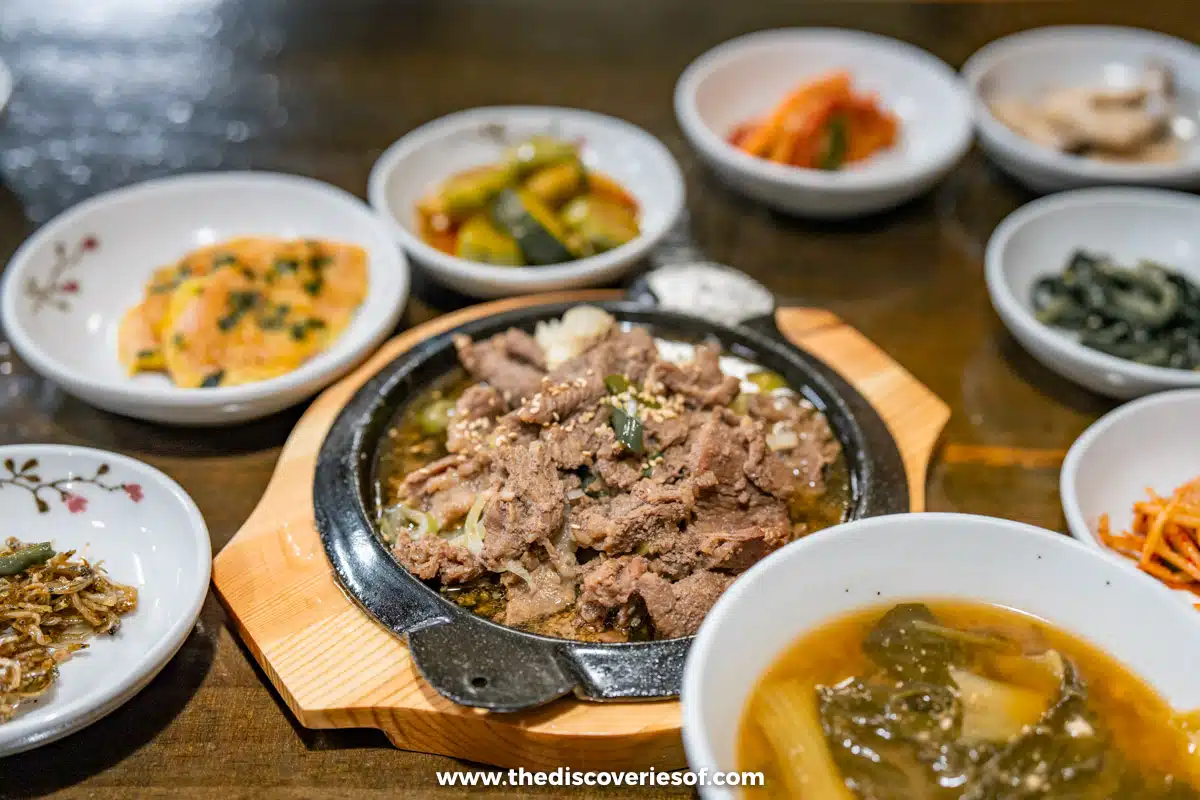
There are some cities where I feel like you need to hop around as many restaurants as possible until you’re uncomfortably full. Seoul is one.
But if you only have time for one, do the set menu at Insadong Hangane Bulgogi Jumak. For 18,000 won (£11), you’ll enjoy soup, rice, and pickled veggies. But the real star of the show is the beef bulgogi, which was buttery, rich, and a must-try when you’re in Seoul.
Jijimbang at Spa Lei Seoul
Be sure to schedule a session at a Korean spa. It’s a unique experience, and Spa Lei is probably the most accessible to Westerners and is also for women only. I wouldn’t say this is relaxing, but it’s totally invigorating. And for under £100 ($125), the massage and body scrub made me feel like an entirely new person before my long flight home.
Getting to Seoul
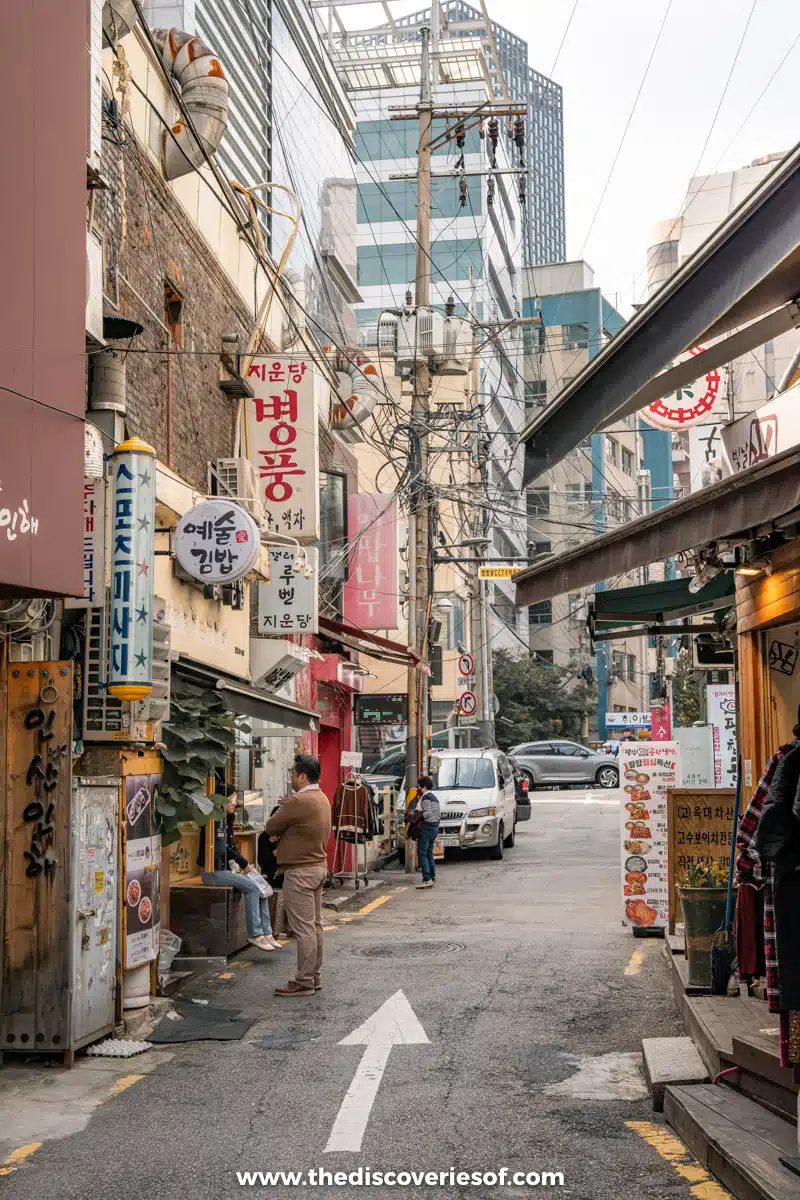
From Jeonju you can take a high-speed train from KTX to Seoul in around 2 hours. I thought the trains were extremely comfortable, and the views were spectacular – so don’t hesitate to book a ticket.
Suggested Stay
If you want to stay in a different part of town, I recommend Insadong for your second leg in Seoul.
The rooms are comfortable, there’s a 24-hour front desk with currency exchange available, and you can walk to the subway easily from the lobby.
Check Prices and Availability for Nine Tree Premier Hotel Insadong Alternatively, Check All Accommodation in Seoul
Have More Time? Add Gangneung To Your Itinerary
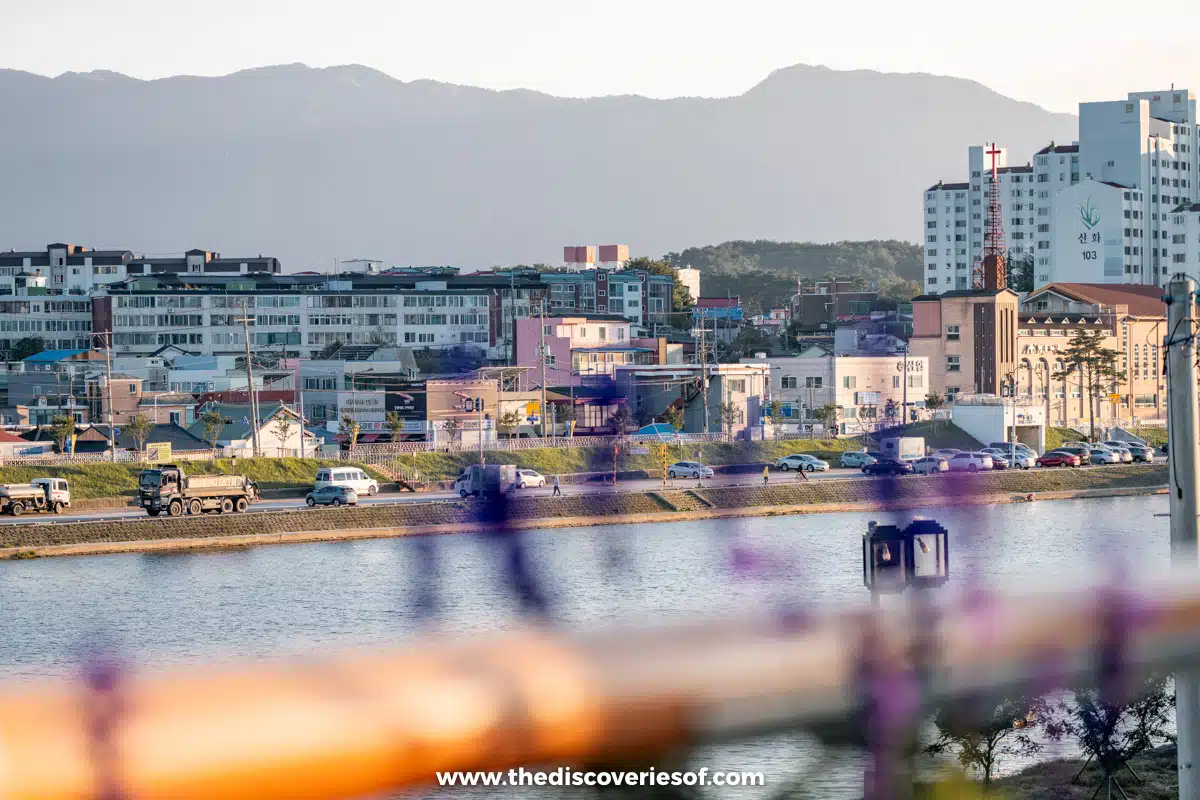
If you have more time, I highly recommend adding a couple of days in Gangneung .
For starters, the “City of Coffee” might just boast more artisanal cafes roasting their coffee than any place I’ve ever been. And pretty much every market and restaurant I tried was seriously incredible, so I’ll just mention a few.
Be sure to stop by Gangneung Jungang Market, where you can check out the traditional and underground fishery market, which has been open since the 1980s. Take your time to sample regional fare, but do not miss the Korean fried chicken from Baenni – an explosion of flavours and textures that was straight-up delightful.
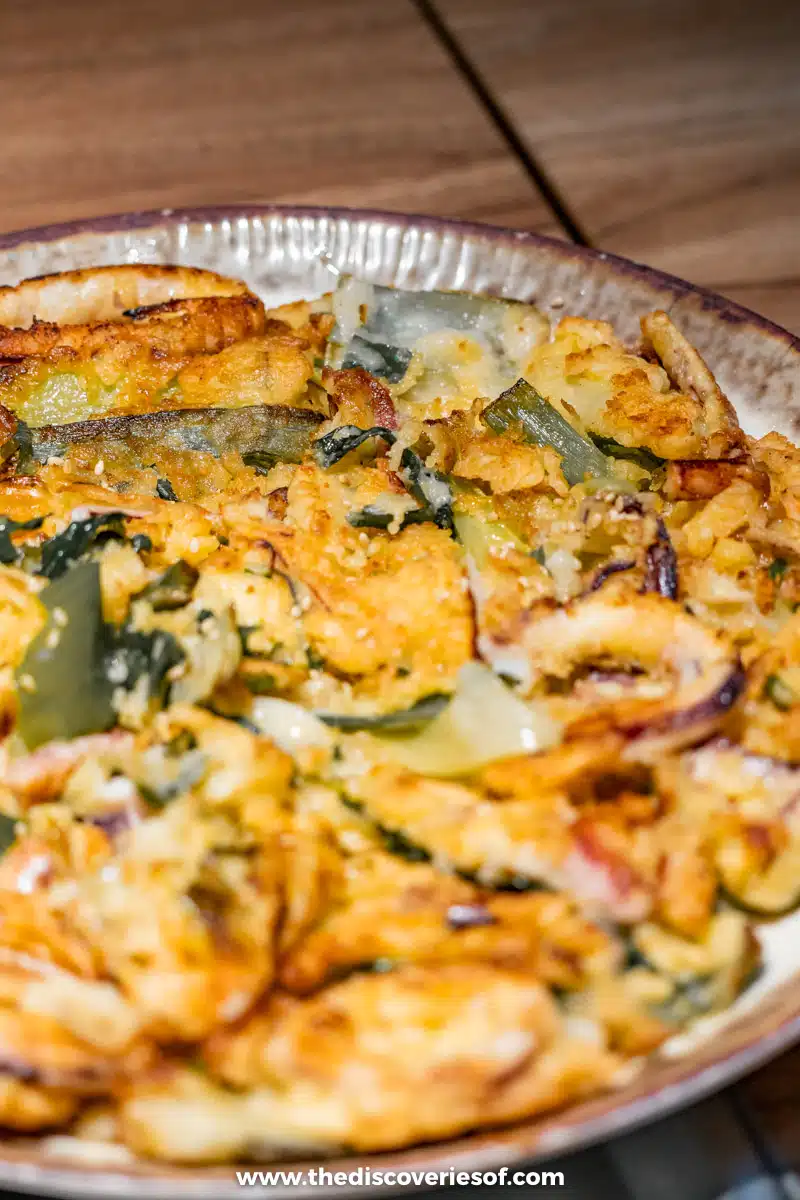
And if you only have time for one meal, Owole Chodang Korean Pancake Restaurant (오월에 초당) is the spot. The thick omelettes are bursting with fresh ingredients. Think crunchy on the outside, soft veg, and seafood on the inside – it was easily one of my favourite dishes from the trip.
Want to see a bit of the surroundings between chowing down? The city has a stunning coastline, with Gyeongpo Beach being the most popular place to spend a day lying on the white sands lined with fragrant pines.
Handy Tips for Planning Your Korea Trip
What to pack .
You’ll need to decide what time of year you’re visiting South Korea before you start planning your wardrobe. The weather is completely different in July than it is in January. You can see temperatures below -6.6°C (20°F) in the winter, where summer highs often reach over 26.6°C (80°F).
No matter when you visit, you’ll want to pack dressy clothes for restaurants and museums and lean a little towards conservative. I like choosing dresses or skirts with tops that are a bit less revealing, as it’s the custom in most areas of South Korea.
Bring a reliable pair of sneakers for getting around the city and subways, underseat luggage (or a small rolling suitcase ), and a mix of casual and formal clothes for sightseeing, dinners, and entertainment. Pack your best beachwear if you visit in the summer, but again, you might want to stick to conservative outfits like a one-piece or shorts and a cover-up.
Best Time to Visit
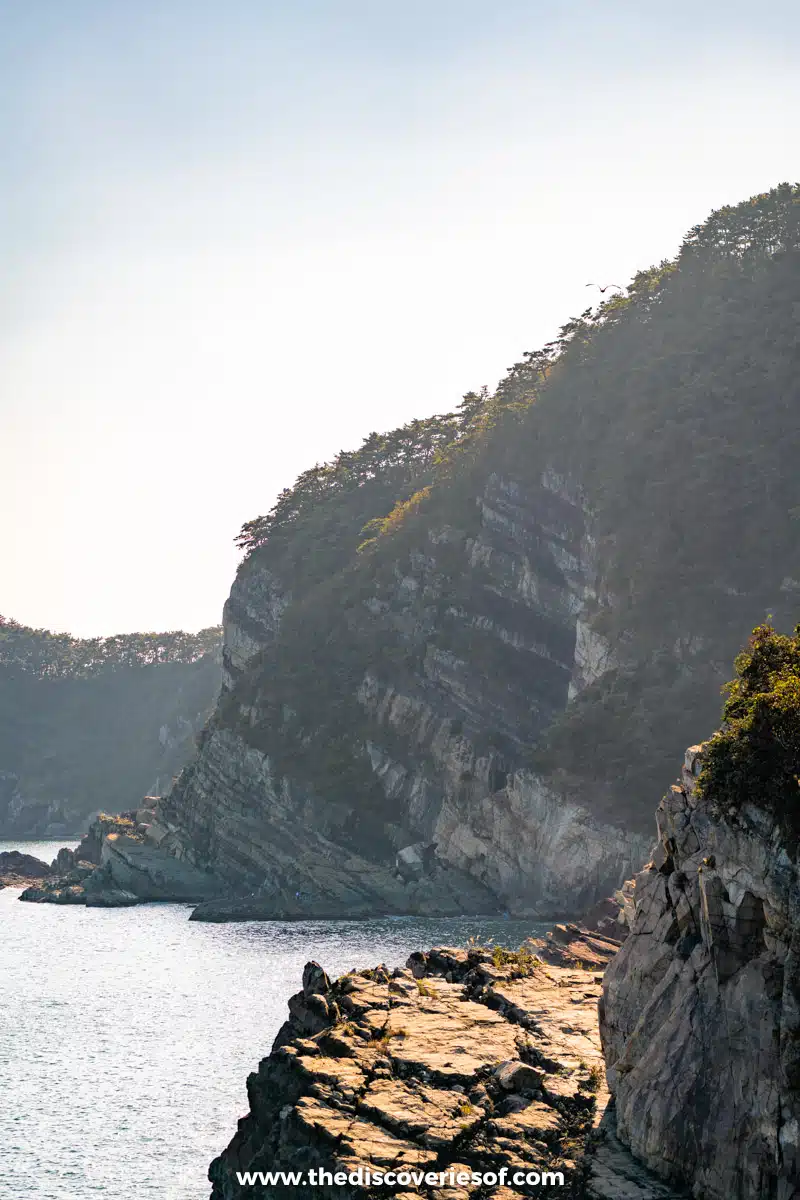
Winters are quite cold, and summers tend to be very hot. If you can, plan your holiday in South Korea for the Spring or Fall. Trying to visit when the weather is perfect? I’d aim for May or September when it’s generally between 13°C – 38°C (55°F – 75°F).
Getting Around
The public transportation system in South Korea is excellent. I used the bullet train to get between Jeonju and Seoul, and it was so comfortable, with beautiful views along the route. You can also rely on the bus system to get from city to city, with several companies offering consistent bus trips, depending on the region. BusTago and Ko Bus are 2 of the most popular options, but you can check Kakaobus or Rome2Rio for specific routes and times.
When you need directions, always use Naver or Kakao – Google Maps doesn’t work well in South Korea.
Group or Tour
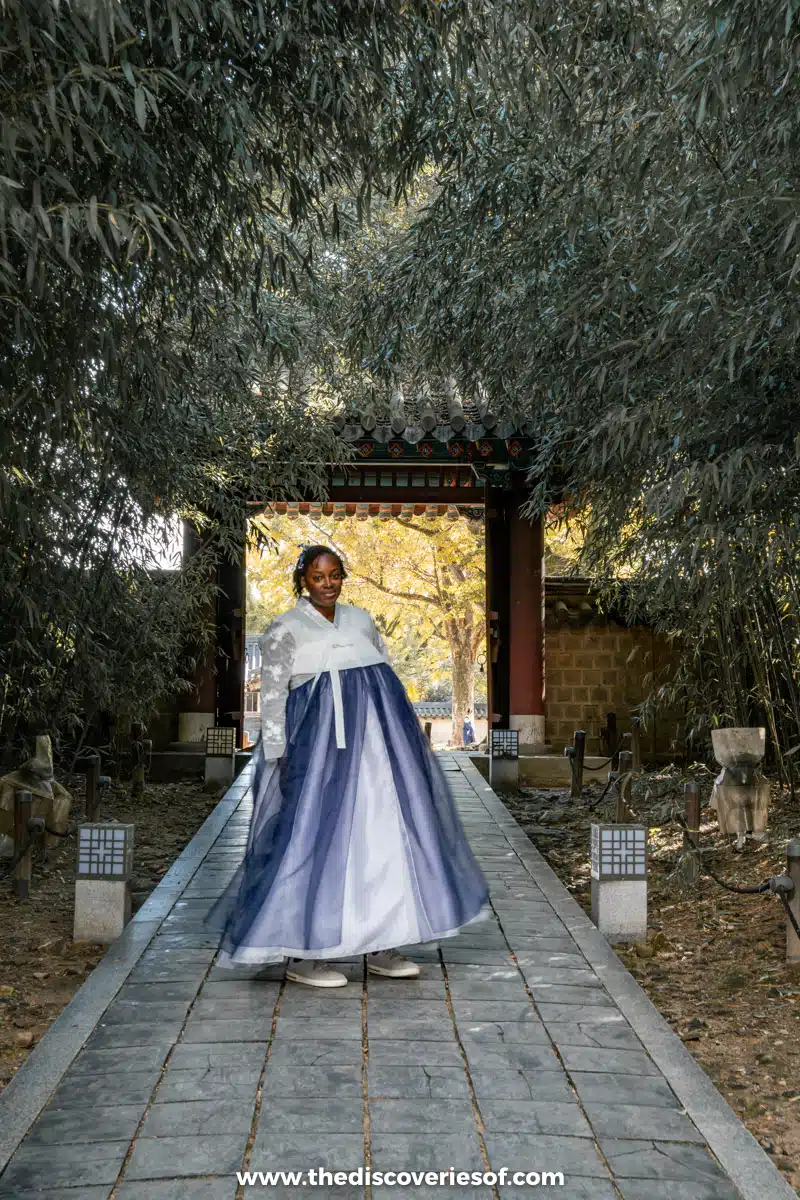
I just returned from a group trip to South Korea, and it was excellent. My only complaint is that I didn’t have just a bit more time to explore each city and town while I was there.
If it’s your first time in the country, I think a group tour is a wonderful way to learn more, especially if your tour guides speak Korean.
But this itinerary for 10 days in South Korea is perfect if you’d rather take your time and check out a few hidden gems I discovered on my most recent holiday.
South Korea Itinerary – Map
*I was hosted on a press trip by the Korean Tourism Organisation – as ever, all thoughts and opinions are my own.
Read More South Korea Guides
- Unmissable Things to do in South Korea
- How to Spend 3 Perfect Days in Seoul
- Unmissable Things to do in Busan
- A Complete Guide to Travelling to Jeonju
- A Complete Traveller’s Guide to Gangneung
- Insider South Korea Travel Tips for Your Trip
Love This? Save and Share on Pinterest
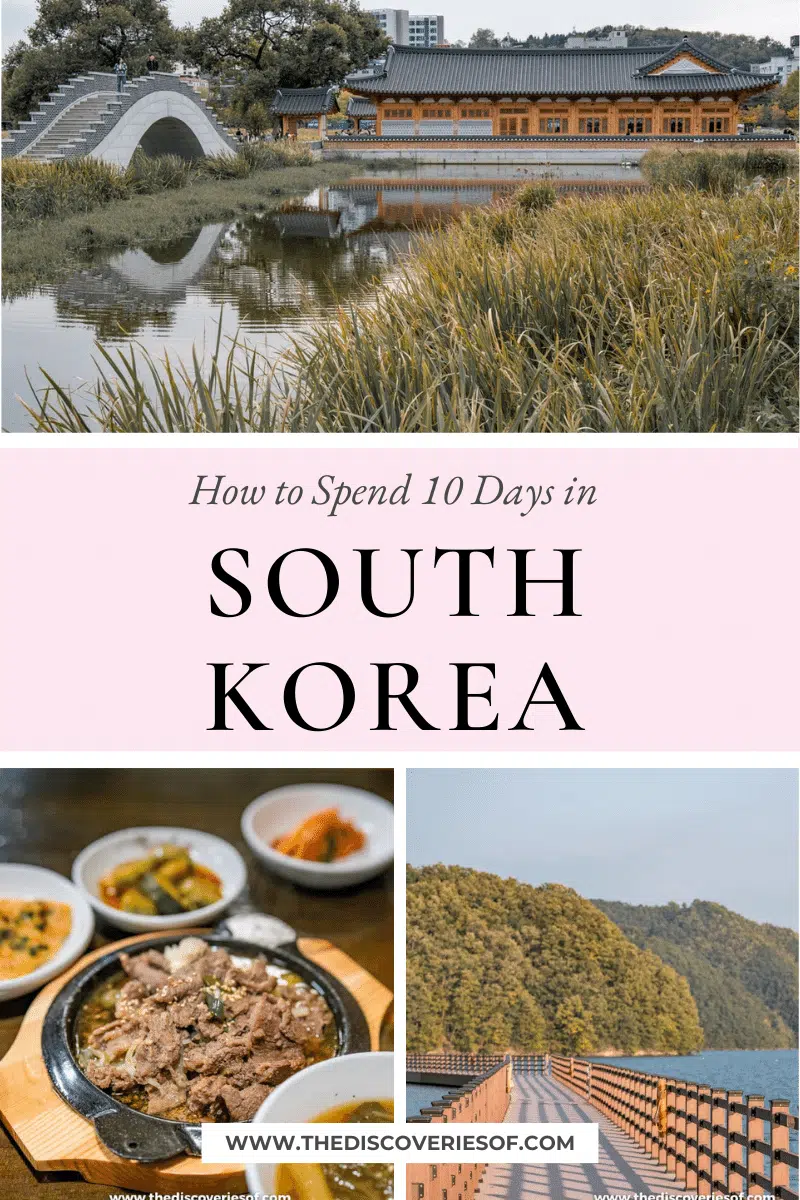
I’m Julianna Barnaby - a professional travel writer and geek extraordinaire. I started The Discoveries Of to help you to discover the best of new destinations from around the world.
Discovering new places is a thrill - whether it’s close to home, a new country or continent, I write to help you explore more and explore differently.
Related Posts
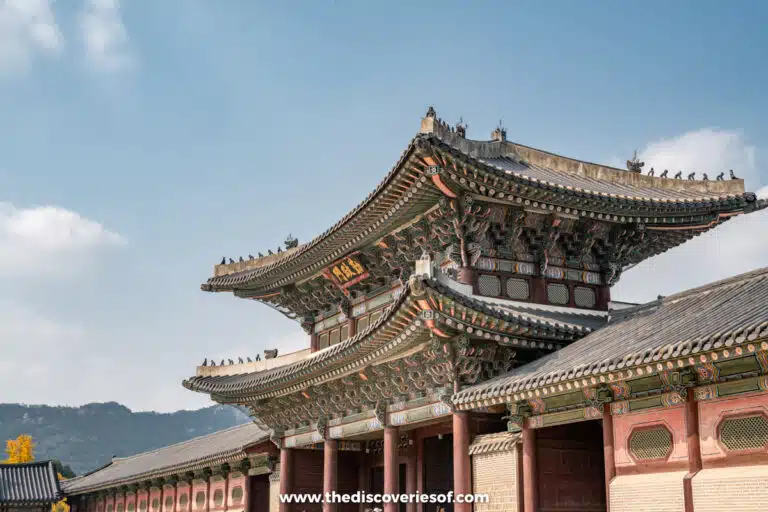
3 Days in Seoul: The Perfect Seoul Itinerary
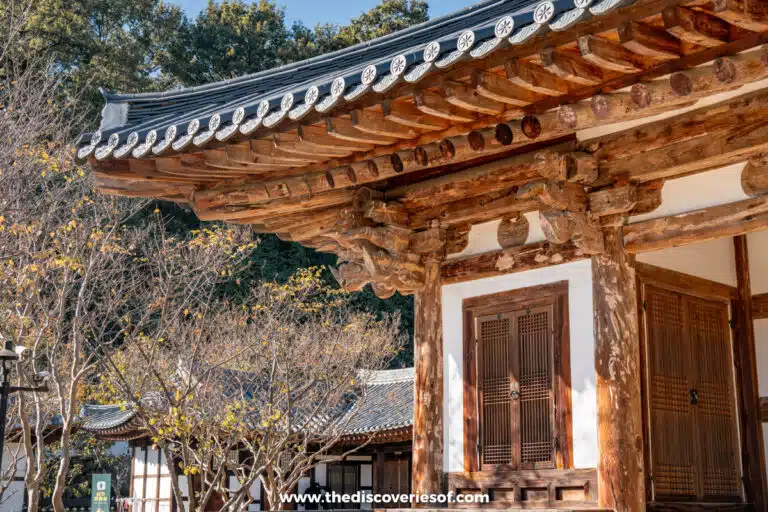
A Complete Guide to Jeonju, South Korea
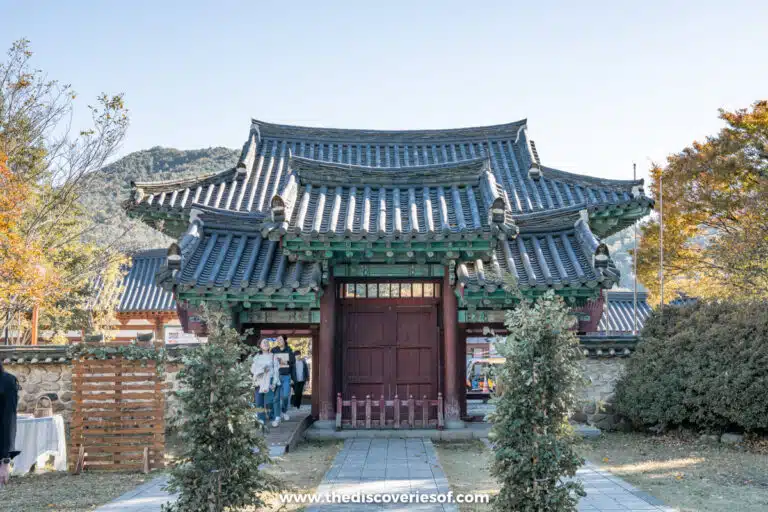
22 Things to Do in South Korea
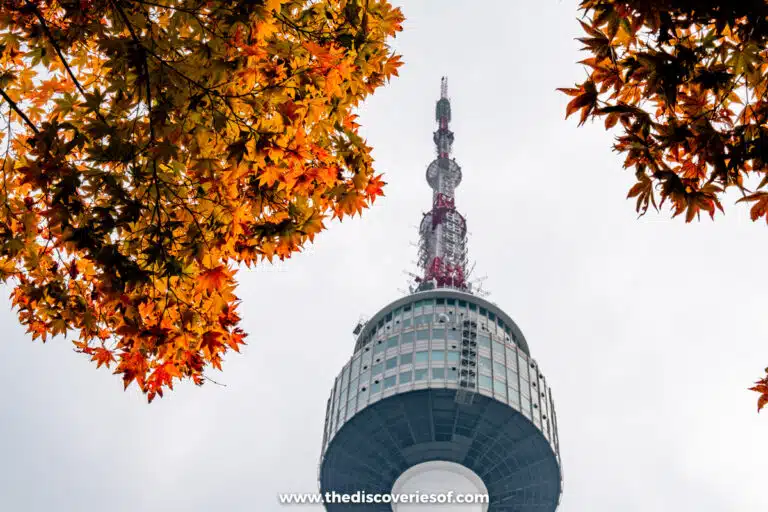
28 Brilliant Things to Do in Seoul

Follow me on Instagram for travel inspiration, tips, and guides.
Travel Guide South Korea
Book your individual trip , stress-free with local travel experts
- roughguides.com
- South Korea
- Travel guide
- Local Experts
- Travel Advice
- Accommodation
Plan your tailor-made trip with a local expert
Book securely with money-back guarantee
Travel stress-free with local assistance and 24/7 support
The Korean peninsula is a tantalizingly unexplored slice of East Asia – a pine-clad land of mountains, misty archipelagos and rice paddies of emerald green, studded with urban pockets of incomparable joie de vivre . While its troubled history has made Korea’s very existence nothing short of miraculous, amazingly its traditions and customs have largely survived intact – and for visitors, this highly distinctive culture is an absolute joy to dive into.
Where to go in South Korea
Country titles, the creation of hangeul, japanese occupation, the taegeukki, winter sonata, tailor-made travel itineraries for south korea, created by local experts.

14 days / from 3800 USD
Culture & Island life
Experience the highlights of Korea with a private guide by your side. Fascinating Seoul with a day trip to the DMZ, followed by days in Gyeongju and Busan. Afterwards, leave the mainland and fly to Jeju Island. Enjoy the crystal blue waters and island culture.

11 days / from 2400 USD
Highlights of Korea
From the skyscrapers of Seoul to traditional villages - this itinerary packs culture, history and cuisine in one compact itinerary. Enjoy a two-night temple stay as well as in-depth guided excursions in Seoul, Gyeongju, Yeosu, and Jeonju.

7 days / from 1950 USD
Temples and Nature in Korea
Start your Korean adventure in Busan. Continue to Yeosu and Suncheon, discovering temples and landscapes on the way. In Suncheon, you will stay at a Korean Buddhist temple. Proceed to the Bamboo Forest of Jeonju before heading to Seoul.
Tailor-made trips for South Korea
Having gone their separate ways in 1953 after the catastrophic Korean War – essentially a civil war, but one largely brought about by external forces, which left millions dead and flattened almost the whole peninsula – the two Koreas are now separated by the spiky twin frontiers of the Demilitarized Zone. North Korea has armed itself to the teeth since 1953, stagnated in its pursuit of a local brand of Communism and become one of the least accessible countries in the world. Unbelievably, many foreigners seem to expect something similar of South Korea , which shows just how well kept a secret this fascinating place really is: beyond the glittering city of Seoul, gimchi , dog meat and taekwondo , little is known about the country in the outside world (and in actual fact, one of those four has largely gone the way of the dodo anyway).
After the war, the South gradually embraced democracy and has since gone on to become a powerful and dynamic economy. Its cities , bursting with places to visit, are a pulsating feast of eye-searing neon, feverish activity and round-the-clock business. Here you can shop till you drop at markets that never close, feast on eye-wateringly spicy food, get giddy on a bottle or two of soju , then sweat out the day’s exertions at a night-time sauna. However, set foot outside the urban centres and your mere presence will cause quite a stir – in the remote rural areas life continues much as it did before the “Economic Miracle” of the 1970s, and pockets of islands exist where no foreigner has ever set foot.
And for all its newfound prosperity, the South remains a land steeped in tradition . Before being abruptly choked off by the Japanese occupation in 1910, an unbroken line of more than one hundred kings existed for almost two thousand years – their grassy burial mounds have yielded thousands of golden relics – and even the capital, Seoul, has a number of palaces dating back to the fourteenth century. The wooden hanok housing of decades gone by may have largely given way to rows of apartment blocks, but these traditional dwellings can still be found in places, and you’ll never be more than a walk away from an immaculately painted Buddhist temple . Meanwhile, Confucian-style formal ceremonies continue to play an important part in local life, and some mountains still even host shamanistic rituals.
As for the Korean people themselves, they are a real delight: fiercely proud, and with a character almost as spicy as their food, they’re markedly eager to please foreigners who come to live or holiday in their country. Within hours of arriving, you may well find yourself with new friends in tow, racing up a mountainside, lunching over a delicious barbequed galbi , throwing back makkeolli until dawn, or singing the night away at a noraebang . Few travellers leave without tales of the kindness of Korean strangers, and all of them wonder why the country isn’t a more popular stop on the international travel circuit.
Korea is still something of an unknown territory, and more than half of all its visitors get no further than Seoul. One of the largest and most technically advanced cities in the world, the capital regularly confounds expectations by proving itself steeped in history. Here, fourteenth-century palaces, imperial gardens, teeming markets and secluded tearooms continue to exude charm among a maze of skyscrapers and shopping malls. From Seoul, anywhere in the country is reachable within a day, but the best day-trip by far is to the DMZ, the strip of land that separates the two Koreas from coast to coast.

Gyeonggi, the province that surrounds Seoul, is a largely unappealing area dissected by the roads and railways that snake their way into the capital, but two of its cities certainly deserve a visit: Suwon, home to a wonderful UNESCO-listed fortress dating from the late eighteenth century; and cosmopolitan Incheon, where you can eat some of the best food in the country before making your way to the islands of the West Sea. By contrast, the neighbouring province of Gangwon is unspoilt and stuffed full of attractions – in addition to a number of national parks, of which craggy Seoraksan is the most visited, you can head to the unspoilt beaches and colossal caves that surround the small city of Samcheok, or peek inside a genuine American warship and North Korean submarine north of the sleepy fishing village of Jeongdongjin.
Stretching down from Gangwon to the South Sea lie the markedly traditional Gyeongsang provinces, home to some of the peninsula’s most popular attractions. Foremost among these is gorgeous Gyeongju; capital of the Silla dynasty for almost a thousand years, and extremely laid-back by Korean standards, it’s spotted with the grassy burial tombs of the many kings and queens who ruled here. There’s enough in the surrounding area to fill at least a week of sightseeing – most notable are Namsan, a small mountain area peppered with trails, tombs and some intriguing Buddhas, and the sumptuously decorated Bulguksa temple, another sight on the UNESCO World Heritage list. Although less picturesque as a town, Andong is almost as relaxed as Gyeongju, and a superb base from which to access Dosan Seowon, a remote Confucian academy, and the charmingly dusty village of Hahoe, a functioning showcase of traditional Korean life. The region’s rustic charm is actually best appreciated offshore on the windswept island of Ulleungdo, an extinct volcanic cone that rises precipitously from the East Sea, and where tiny fishing settlements cling barnacle-like to its coast. Thrills with a more urban flavour can be had in Busan, Korea’s second city, which has an atmosphere markedly different from Seoul; as well as the most raucous nightlife outside the capital, it has the best fish market in the country, and a number of excellent beaches on its fringes.
Even more characterful are the Jeolla provinces, which make up the southwest of the peninsula. Left to stagnate by the government while Korea’s economy kicked into gear, they have long played the role of the renegade, though this energy is now being rechannelled. Violent political protests took place in regional capital Gwangju as recently as 1980, though the city has reinvented itself to become one of the artiest and most business-savvy in the land. Jeonju has a similar feel, plus a delightful district of traditional hanok housing, and is justly famed for its wonderful, flavoursome cuisine. Earthy Mokpo is the hub for ferry trips to a mind-boggling number of West Sea islands, dotted with fishing communities where life has changed little in decades, while inland there are a number of excellent national parks.
The Chungcheong provinces at the centre of the country are bypassed by many travellers, but this is a shame, as they contain some fine sights. The old Baekje capitals of Gongju and Buyeo provide glimpses of a dynasty long dead, Daecheon beach hosts a rumbustious annual mud festival that may well be Korea’s most enjoyable event, and there are temples galore – the gigantic golden Buddha at Beopjusa is surrounded by 1000m-high peaks, while the meandering trails and vivid colour schemes at Guinsa make it the most visually stimulating temple in the land.
Lying within a ferry ride of the mainland’s southern shore is the island of Jeju, a popular honeymoon destination for Koreans. While it’s undoubtedly a touristy place, it has its remote stretches and anyone who has climbed the volcanic cone of Hallasan, walked through the lava tubes of Manjanggul or watched the sun go down from Yakcheonsa temple will tell you the trip is more than worthwhile.
And finally, of course, there’s North Korea. A visit to one of the world’s most feared and most fascinating countries will instantly earn you kudos – even experienced travellers routinely put the DPRK at the top of their “most interesting” list. Visits don’t come cheap and can only be made as part of a guided tour, but the country’s inaccessibility brings an epic quality to its few officially sanctioned sights.
Discover more places in South Korea

- Gyeongsang Travel Guide
- Jeolla Travel Guide
- Seoul Travel Guide
The Korean peninsula is split into the Republic of Korea (South Korea) and the Democratic People’s Republic of Korea (North Korea). The former is referred to throughout the site as “Korea”; this is how locals refer to their nation when talking to outsiders, though in Korean they use the term “ Hanguk ”. North Korea has, where necessary, been referred to as such, or as “the DPRK”; North Koreans’ own word for both country and peninsula is “ Choson ”.
One thing that will strike you on a trip around Korea is hangeul , the peninsula’s distinctive, almost Tetris-like alphabet. Amazingly, this was a royal creation, having been the brainchild of King Sejong in the 1440s. Most of this creative king’s subjects were unable to read the Chinese script used across the land at the time, so he devised a system that would be easier for ordinary people to learn. Sejong was forced to do much of his work in secret, as the plan did not go down well with the yangban – Confucian scholars who were even more powerful than the royalty at the time. As the only truly educated members of society, the yangban argued fiercely against the change in an effort to maintain their monopoly over knowledge.
Hangeul experienced periodic bursts of popularity, but was almost erased entirely by the Japanese during their occupation of the peninsula (1910–45). However, it’s now the official writing system in both North and South Korea, as well as a small autonomous Korean pocket in the Chinese province of Jilin; it’s also used in Bau-Bau, a small town in Indonesia.
The alphabet, while it appears complex, is surprisingly easy to learn , and demonstrating that you can read even a handful of simple words will generate gasps of admiration across Korea. Just a few hours of hard study should suffice.
• The Korean peninsula is split in two by the 4km-wide Demilitarized Zone (DMZ), sharing borders with China and – for about 20km, south of Vladivostok – Russia. These frontiers form a northern boundary with North Korea – the “Democratic People’s Republic of Korea” – whose population of around 24 million live in an area half the size of the United Kingdom. South Korea , also known as the “Republic of Korea”, is slightly smaller and has a population of 51 million, making it the world’s 26th most populous country.
• Ethnic Koreans dominate the peninsula's population, making North and South Korea two of the most ethnically homogeneous societies on earth. Before splitting, both were traditionally Buddhist nations – though deeply steeped in Confucianism and shamanistic ritual. Since then the North has followed Juche, a local brand of Communism, while in the South Christianity has become the most popular religion.
• Before the Japanese occupation in 1910, the Silla, Goryeo and Joseon dynasties were ruled over by an unbroken run of 116 monarchs , dating back to 57 BC.
• The economies of South and North Korea were almost equal in size until the mid-1970s. The “Economic Miracle” that followed in the South has propelled it to the cusp of the world’s top ten economies, while the North languishes just above 100th place.
On even a short trip around the country you’re more than likely to stumble across a special event of some sort. Many are religious in nature, with Buddhist celebrations supplemented by Confucian and even animist events. Most festivals are concentrated around spring and autumn, but there are many spread throughout the year. If you’re heading to one, don’t be shy – the locals love to see foreigners joining in with traditional Korean events, and those who dare to get stuck in may finish the day with a whole troupe of new friends.
Though there are some crackers on the calendar, it must be said that a fair number of Korean festivals are brazenly commercial, making no bones about being held to “promote the salted seafood industry”, for example. Other festivals can be rather odd, including those dedicated to agricultural utensils, clean peppers and the “Joy of Rolled Laver” – you’ll easily be able to spot the duds. The most interesting events are highlighted below, though bear in mind that celebrations for two of the big national festivals – Seollal , the Lunar New Year, and a Korean version of Thanksgiving named Chuseok – are family affairs that generally take place behind closed doors.
Cherry blossom festivals Usually early April. Heralding the arrival of spring, soft blossom wafts through the air across the country, a cue for all good Koreans to lay down blankets at parks or riverbanks, barbeque some meat and throw back the soju .
Jeonju International Film Festival w www.jiff.or.kr . Last week of April. Smaller and more underground than the biggie in Busan, JIFF focuses on the arty, independent side of the movie industry.
Buddha’s Birthday Late May. A public holiday during which temples across the land are adorned with colourful paper lanterns; there’s an even more vibrant night parade in Seoul.
International Mime Festival w www.mimefestival.com . May. Held in the Gangwonese capital of Chuncheon, this foreigner-friendly event is a showcase of soundless talent.
Dano Usually June. A shamanist festival held on the fifth day of the fifth lunar month, featuring circus acts, ssireum wrestling, mask dramas and a whole lot more. The city of Gangneung is host to the biggest displays.
July–August
Boryeong Mud Festival w www.mudfestival.or.kr . Late July. This annual expat favourite pulls mud-happy hordes to Daecheon Beach for all kinds of muck-related fun.
International Puppet Festival Aug. Puppets and their masters come from around the world to flaunt their skills in Chuncheon, a city in Gangwon province.
Firefly Festival Aug. Glow worms are the tiny stars of the show at this modest night-time event, which takes place over a weekend near Muju. One unexpected treat is the chance to don a firefly costume.
September–November
Gwangju Biennale w gb.or.kr. Sept–Nov. A wide-ranging, two-month-long festival of contemporary art, the biennale usually takes place on alternate autumns, though it has also been held in spring.
Andong Mask Dance Festival w www.maskdance.com . Late Sept or early Oct. Legend has it that if a person fails to attend a mask festival in their lifetime, they cannot get into heaven, so if you’re in Korea in the autumn you might as well have a crack at salvation by participating in one of the country’s most popular events – a week of anonymous dancing, performed by the best troupes in the land.
Busan International Film Festival w www.biff.kr . Usually Oct. One of Asia’s biggest such events, BIFF draws in big-shots and hangers-on for a week of cinematic fun (see Busan festivals ).
Baekje Festival w www.baekje.org . Early Oct. This annual event commemorating the Baekje dynasty is held each year in the old Baekje capitals of Gongju and Buyeo.
World Martial Arts Festival Usually Oct. A week-long series of international fisticuff action, held each year in Chungju.
Gimchi Festival Late Oct. In Gwangju. You’ll be able to see, smell and taste dozens of varieties of the spicy stuff, and there’s even a gimchi -making contest for foreigners keen to show off.
Pepero Day Nov 11. A crass marketing ploy, but amusing nonetheless – like Pocky, their Japanese cousins, Pepero are thin sticks of chocolate-coated biscuit, and on the date when it looks as if four of them are standing together, millions of Koreans say “I love you” by giving a box to their sweethearts, friends, parents or pets.
If you’ve done any sightseeing in Korea, you’ll no doubt have come across information boards telling you when, or how often, certain buildings were burnt down or destroyed by the Japanese. The two countries have been at loggerheads for centuries, but the 1910–45 occupation period caused most of the tension that can still be felt today. In this age of empire, Asian territory from Beijing to Borneo suffered systematic rape and torture at the hands of Japanese forces, but only Korea experienced a full-scale assault on its national identity . Koreans were forced to use Japanese names and money, books written in hangeul text were burnt and the Japanese language was taught in schools. These measures were merely the tip of the iceberg, and Japan’s famed attention to detail meant that even the tall trees were chopped down: straight and strong, they were said to symbolize the Korean psyche, and they were replaced with willows which drifted with the wind in a manner more befitting the programme. The most contentious issue remains the use of over 100,000 comfort women , who were forced into slave-like prostitution to sate the sexual needs of Japanese soldiers.
The atomic bombs that brought about the end of the World War II also finished off the occupation of Korea, which slid rapidly into civil war. This post-occupation preoccupation kept both factions too busy to demand compensation or apologies from Japan – they were, in fact, never to arrive. While some countries have bent over backwards to highlight wartime misdeeds, Japan has been notoriously stubborn in this regard – its prime ministers have regularly paid respects at Yasukuni , a shrine to those who died serving the empire, but notably also to at least a dozen Class A war criminals, and school textbooks have increasingly glossed over the atrocities. This has led to repeated and continuing protests; surviving comfort women, having still not been compensated, hold weekly demonstrations outside the Japanese Embassy in Seoul. Korea, for its part, has failed to debate successfully the role of local collaborators during the resistance, or to acknowledge fully in its own schoolbooks and museums the foreign influences that ended both the Japanese occupation and the Korean War.
South Korea’s national flag – the Taegeukki – is one of the most distinctive around, and is heavily imbued with philsophical meaning. The design itself has changed a little since its first unveiling in the 1880s, though its fundamental elements remain the same: a red-and-blue circle surrounded by four black trigams, all set on a white background. The puritanical connotations of the white are obvious, whereas the circle and trigrams offer greater food for thought. The four trigams make up half of the eight used in the I Ching , an ancient Chinese book of divination. Each can represent a number of different concepts: moving clockwise from the top-left of the flag, these may be read as spring, winter, summer and autumn; heaven, moon, earth and sun; father, son, mother and daughter; as well as many more besides.
The circle is split into the “Yin–Yang” shape, its two halves representing opposites such as light and dark, male and female, day and night. Though coincidental, connections with the divided Korean peninsula are easy to find, with two opposing halves forming part of the same whole – the red half is even on top.
Korean drama has recently enjoyed enormous popularity across Asia, with snow-filled Winter Sonata the biggest success to date. The story runs as follows: a boisterous girl named Yujin meets withdrawn Junsang on a bus. Despite being total opposites they fall in love and Yujin lends her gloves to her new man, who promises to give them back on New Year’s Eve. He doesn’t turn up, and Yujin hears that he died in a car accident on the way. Fast forward ten years to Yujin’s engagement ceremony, when she thinks that she sees Junsang – now, for some reason, choosing to wear pink lipstick – through the crowd. She later finds out that it isn’t Junsang but Min-hyung , a successful American architect. Yujin ends up working at the same company, and one further car crash later it transpires that unbeknown to Yujin not only is the man Junsang after all, but that he’s Yujin’s half-brother. As the pair part ways, Yujin hands him the blueprints for a beautiful house she’d designed as a farewell present. Of course, they’re not related after all, and when Yujin returns to Korea from France three years later she finds out that Junsang is in fact the half-brother of her erstwhile fiancé. She then happens across the house that she once handed Junsang in blueprint form, finds him inside – now blind, just to heighten the tragedy – and they fall in love once more.
Junsang got hearts racing all over Asia, and Bae Yong-jun , the actor who played him, is now an international superstar whose face is plastered across all kinds of merchandise – just look at the socks on sale in Seoul’s Myeongdong district. Nowhere was he more successful than in Japan, where he is now revered as Yon-sama , a title roughly equivalent to an English knighthood. Junsang also helped the stereotypically strong-but-sensitive Korean male replace the martial arts hero as Asia’s role model, and Korean men now enjoy considerable demand from females across the continent.
Travel advice for South Korea
From travel safety to visa requirements, discover the best tips for traveling to South Korea
- Eating and drinking in South Korea
- Getting around South Korea: Transportation Tips
- Travel Tips South Korea for planning and on the go
- Culture and Etiquette in South Korea
- How to get to South Korea
- Sports and Outdoor activities in South Korea
- Best time to visit South Korea
The Rough Guides to South Korea and related travel guides
In-depth, easy-to-use travel guides filled with expert advice.

Find even more inspiration here

Planning your own trip? Prepare for your trip
Use Rough Guides' trusted partners for great rates
written by Rough Guides Editors
updated 08.01.2024
Ready to travel and discover South Korea?
Get support from our local experts for stress-free planning & worry-free travels.
- Where to stay
- Travel advice
South Korea

- 3 Other destinations
- 4.1.1 Early history and founding of a nation
- 4.1.2 Japanese occupation and division
- 4.1.3 Republic of Korea
- 4.3 Government and politics
- 4.4.1 Holidays
- 4.5 Climate
- 4.6 Electricity
- 4.9 Visitor information
- 6.1 Entry requirements
- 6.2 By plane
- 6.3 By train
- 6.4 By boat
- 6.5 By land
- 7.1 Smart cards
- 7.2 By plane
- 7.3.1 Korail Pass
- 7.3.2 Rail cruises
- 7.5 By boat
- 7.7 By taxi
- 8.1 Traditional arts
- 10.2 Banking and payment
- 10.4 Tipping
- 10.5 Shopping
- 11.1 Etiquette
- 11.2 Restaurants
- 11.3 Barbecues
- 11.4 Rice dishes
- 11.5 Soups and stews
- 11.6 Noodles
- 11.7 Seafood
- 11.9 Dietary restrictions
- 12.1 Nightlife
- 12.2 Etiquette
- 12.4 Rice wine
- 12.5 Ginseng wine
- 12.8 Coffee
- 12.9 Other drinks
- 13.1 Motels
- 13.2 Hotels
- 13.4 Hostels and guesthouses
- 13.5 Minbak
- 13.6 Homestay
- 13.7 Pension
- 13.8 Jjimjilbang
- 13.9 Temples
- 14.1 Others
- 15.1 Teaching
- 15.3 Engineering
- 16.2 Racism
- 16.3 Traffic
- 16.4 Illegal taxis
- 16.5 Civil unrest
- 16.6 Local laws
- 16.7 Gambling
- 16.8 Wildlife
- 16.9 Natural hazards
- 16.10 Homosexuality
- 16.11 Conflict with North Korea
- 16.12 Emergency numbers
- 17 Stay healthy
- 19.1 Social etiquette and breaches
- 19.2 Sensitive issues
- 19.3 Business etiquette
- 19.4 National issues
- 19.5 Religion
- 19.6 Smoking
- 20.1.1 Mobile phones
- 20.2 By Internet
- 20.3 By mail
South Korea ( Korean : 한국, 韓國 Hanguk ), officially the Republic of Korea (대한민국, 大韓民國 Daehan Minguk ), is a country in East Asia .
Known as the "Land of the Morning Calm", Korea has served as a cultural bridge between its neighbors, China and Japan , for a long time. South Korea has emerged from the shadows of its turbulent past and cemented its place as one of the world's major economic powers. South Korean pop culture has been enormously popular across East and Southeast Asia since the turn of the 21st century, and has become popular globally since the 2020s, driving higher levels of tourism to this nation.
Regions [ edit ]
South Korea is divided into nine provinces, as listed below. The largest cities are separate government areas, but Wikivoyage includes them in the most relevant province.
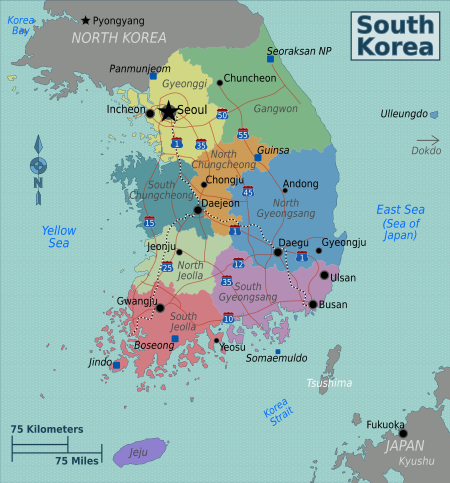
Cities [ edit ]

- 37.566 126.966 1 Seoul (서울) — the dynamic 600-year-old capital of South Korea, a fusion of the ancient and modern
- 35.166 129.066 2 Busan (부산, 釜山) — the second city and main beach destination
- 37.866 127.733 3 Chuncheon (춘천, 春川) — capital city of Gangwon province, surrounded by lakes and mountains and known for local dishes, dakgalbi and makguksu
- 35.9 128.6 4 Daegu (대구, 大邱) — a cosmopolitan city, rich with ancient traditions and sights
- 36.351 127.385 5 Daejeon (대전, 大田) — a large and dynamic metropolis in Chungnam province
- 35.166 126.916 6 Gwangju (광주, 光州) — the administrative and economic centre of the area, the largest city in the province
- 35.85 129.22 7 Gyeongju (경주, 慶州) — the ancient capital of the Silla Kingdom
- 37.483 126.633 8 Incheon (인천, 仁川) — second busiest port in the country, location of the country's largest international airport
- 35.82 127.15 9 Jeonju (전주, 全州) — once the spiritual capital of the Joseon Dynasty, now a leading center of the arts filled with museums, ancient Buddhist temples, and historical monuments
Other destinations [ edit ]
- 38.125 128.416 1 Seoraksan National Park (설악산국립공원) — spread out over four cities and counties, the country's most renowned national park and mountain range
- 36.567 128.716 2 Andong (안동시) — historically rich in Confucius traditions and home of living folk village
- 37.316 126.833 3 Ansan (안산시) — a city in Gyeonggi province on the coast of the Yellow Sea
- 37.956 126.68 4 Panmunjeom (판문점) — the only tourist site in the world where the Cold War is still reality
- 34.733 127.733 5 Yeosu (여수시) — one of the country's most picturesque port cities especially at night. Famous for its seafood and beaches, you can visit some of the islands in Hallyeo Ocean Park with cruise or watch sunset from its fabulous Dolsan Bridge or romantic cafes near marinas.
- 34.483 126.261 6 Jindo (진도) — commonly associated with the dog native to that area, the Jindo, every year people flock to the area to witness the parting of the sea and participate with the accompanying festivities
- 37.5 130.9 7 Ulleungdo (울릉도) — scenic remote island off the east coast of peninsula
- 37.561 128.487 8 Pyeongchang (평창군) — the host city of the 2018 Winter Olympics .
Understand [ edit ]
Positioned on the southern portion of the Korean Peninsula, South Korea is a country of dazzling scenic landscapes and a mixed representation of centuries-old traditions and contemporary society. It boasts a recorded history extending more than 5,000 years.
History [ edit ]
Early history and founding of a nation [ edit ].

Archeological finds of prehistoric toolmaking on the Korean Peninsula date back to 70,000 BC, and the first pottery is found around 8000 BC. Comb-pattern pottery culture peaked around 3500–2000 BC.
Legend has it that Korea began with the founding of Gojoseon (고조선, 古朝鮮, also called Ancient Chosun ) by the legendary Dangun in 2333 BC. Archaeological and contemporaneous written records of Gojoseon as a kingdom date back to around 7th–4th century BC. The Chinese Han Dynasty eventually defeated Gojoseon, and its territories were governed as four commanderies. The political chaos following the fall of the Han Dynasty in China allowed native tribes to regain control of Korea and led to the emergence of the Three Kingdoms of Korea (삼국시대, 三國時代), namely Goguryeo (고구려, 高句麗), Silla (신라, 新羅) and Baekje (백제, 百濟). Despite repeated attempts by China, namely the Sui Dynasty and later the Tang Dynasty, to conquer the Korean Peninsula, northern-based Goguryeo managed to repel them. Eventually, Goguryeo fell to a Silla-Tang alliance, which had earlier defeated Baekje, and unified Korea under the Silla Dynasty . A later invasion by the Tang was repelled by Silla forces, thus maintaining Korea's independence. The remnants of Goguryeo would go on to found another kingdom known as Balhae (발해, 渤海) in what is now Northeast China , which would last until 926 AD when the Khitans conquered it.
Unified Silla was replaced by the Goryeo Dynasty (고려, 高麗, also called Koryo ), from which the modern name "Korea" derives. One highlight of the Goryeo dynasty was that in 1234 the world's first metal movable type was invented by a Korean named Choe Yun-ui (200 years before Gutenberg's printing press). Goryeo was replaced by the Joseon Dynasty (조선, 朝鮮, also called Chosun ), after a coup by one of its generals. The Joseon dynasty ruled Korea from 1392 to 1910, being one of the longest actively ruling dynasties in world history. During the early part of the Joseon dynasty, Korean technological inventions such as the world's first water clock, ironclad ship, and other innovations took place. During the rule of King Sejong the Great, the world's first rain gauge was invented, and the Korean alphabet, known as hangul , was created.
Japanese occupation and division [ edit ]

Korea was invaded by the Japanese, led by Toyotomi Hideyoshi in the late 16th century, who was eventually defeated by an alliance between the Joseon dynasty and China's Ming dynasty. This defeat and the untimely death of Hideyoshi forced the Japanese to pull out of Korea.
Later, Korea's status as an independent kingdom under the Chinese sphere of cultural influence (사대 sadae ) ended in 1895 after China's defeat in the Sino-Japanese War and the signing of the Treaty of Shimonoseki. Under the treaty's terms, China recognized the severing of the several centuries-old, nominal elder-younger brother relationship between China and Korea, bringing Japan the window of opportunity to force Korea into its growing sphere of influence. Although the elder-younger brother relationship between China and Joseon was a voluntary diplomatic formality assumed by Joseon's rulers to receive the benefits of advanced Chinese culture and trade, it was a symbolic victory for Japan to achieve the breakage of this link. It put Japan in a position to take possession of Korea without fear of Chinese intervention. In 1910, Imperial Japan annexed Korea, thus beginning a 35-year occupation of the country. Despite armed rebellions and intellectual and cultural resistance by the Koreans, Japan maintained control of the peninsula and gradually advanced a cultural assimilation policy. During the occupation, many Korean women were forced to serve as "comfort women" in Japanese military brothels, which continues to be a major bone of contention in diplomatic relations between Japan and South Korea.
After Imperial Japan's defeat in World War II , Soviet forces occupied the northern half of Korea while U.S. forces occupied the southern half. North and South Korea each declared independence as separate states in 1948. Kim Il-Sung established a communist regime with the support of the Soviet Union in the north, and Syngman Rhee established a capitalist regime with the support of the United States in the south. After antagonism from both sides, North Korea invaded South Korea in 1950, starting the Korean War which destroyed much of the country. The U.S. and other U.N. forces intervened on South Korea's side, while the Soviet Union and China supported the North. An armistice was signed in 1953, splitting the peninsula along a demilitarized zone after the war had reached a stalemate with no significant territorial gains made by either side. However, as no peace treaty has ever been signed, the two Koreas officially remain at war, although without any ongoing combat.
Republic of Korea [ edit ]
Despite initially being economically outperformed by its northern rival, South Korea eventually emerged from the ashes of the Korean War. It achieved rapid economic growth starting in the 1960s under the iron-fisted rule of President Park Chung-hee. After Park was assassinated in 1979, a coup lead by Chun Doo-hwan established another military dictatorship in 1980 and suppressed democratic movements at that time, perhaps one of the most notorious event is the Gwangju massacre that caused at least 200 deaths among protesters.
As one of the East Asian Tigers, the South Korean economy's industrialization and modernization efforts gained traction in the 1980s and 1990s. Per capita income rose to 20 times that of North Korea. In 1996, South Korea joined the OECD. Today, South Korea is an industrialized and developed economy with some of the world's leading high technology corporations, such as Samsung and LG.
Demands for greater freedom of speech and human rights led to nationwide demonstrations that led to democratic elections in 1987, just prior to the South Korean capital of Seoul hosting the 1988 Summer Olympic Games.
South Korea is now a liberal democracy and an economic powerhouse. The peace process with the North is still underway at a glacial pace, with little sign that the status quo will change anytime soon. In 2012 the country elected its first female president, Park Geun-hye. However, she was dramatically ejected from power in 2017 and subsequently convicted of corruption and abuse of power after widespread demonstrations over corruption that involved personal connections and Korea's largest corporations.
The cultural phenomenon is known as the Korean Wave (한류 hallyu ) has swept most of Asia and many other parts of the world as South Korean film, television, music, food, and other aspects of culture have become popular. In 2012 Psy's Korean-language song "Gangnam Style" topped the charts in many Western countries.
People [ edit ]

South Korea is a very homogeneous country, with over 95% of the population identifying themselves as ethnically Korean and speaking the Korean language. However, the demographics are changing, with immigrants having passed the one million mark for the first time in history. The largest minority are the Chinese, numbering around 440,000, though the majority of them are Chinese citizens of Korean ethnicity. There is a smaller community of local-born Han Chinese residents numbering just over 26,000, mostly descended from early 20th-century immigrants from Shandong , known as Hwagyo (화교) in Korean. There are also workers from Mongolia, Bangladesh, Southeast Asia, and other parts of the world. A community of 20,000 English teachers from anglophone nations are spread out throughout the country. A long-standing 30,000 American military personnel are stationed here. South Korea's large and growing economy has attracted people from all over the world. Seoul's leading financial center has brought many financial workers from North America, Europe, and Japan. Rural areas have seen farmers seek out wives from other countries such as China, Vietnam, and the Philippines to address the general shortage of Korean women in the countryside, and these communities can be seen in even the smallest towns nowadays.
South Korea has the world's lowest birth rates of only 0.7 children per woman (as of 2023), and with it a rapidly aging and declining population. How the country will deal with this demographic problem is unclear, with little change to policies to address the general resistance to immigration, traditional expectations that women give up their careers after motherhood, increasing costs of housing and living as well as the very high effort of raising even one child in the ultra-competitive education system. If trends continue then South Korea's population will fall by 50% as soon as 2100.
Government and politics [ edit ]
South Korea today is a full, vibrant and relatively stable democracy, with executive, judicial, and legislative branches of government. Technically a democracy since establishment in 1948, the country nevertheless experienced political repression, military coups and effective dictatorships. The sixth republic was declared in 1987 and stable democratic government has been experienced ever since.
The president is the head of state and is elected for just one five-year term. Party composition and naming changes frequently in South Korean politics, although conservative, liberal, and progressive platforms are usually represented. In general, left-wing parties tend to support reconciliation and more cooperation with North Korea, while right-wing parties tend to support closer ties with the United States and Japan, whilst taking a tougher stance against North Korea.
Although the military remains a powerful force in Korean politics (not surprising given that Japan, China, and North Korea surround the country), it is widely considered that another military coup is very unlikely.
Culture [ edit ]
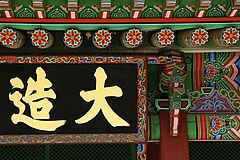
Having been in the cultural sphere of China for much of its history, substantial Chinese influences are evident in traditional Korean culture. Nevertheless, many fundamental differences remain, and Korea has retained a distinct cultural identity from its larger neighbor. Koreans are fiercely proud of their heritage and their resistance to outside domination.
During the Joseon dynasty, Korea's dominant philosophy was a strict form of Confucianism, perhaps even more stringent than the Chinese original. People were separated into a rigid hierarchy, with the king at the apex, an elite of officials and warriors and a small group of nobility (양반 yangban ) below him, a middle class of petty civil servants (중인 chungin ) below them, and then a vast population of commoners (상민 sangmin ) at the bottom. The educated were superior to the uneducated, women served men, and everybody stuck to a defined role or faced severe consequences. Korea adopted its version of the imperial examination system invented by and used in China to select officials, creating somewhat of a premodern meritocracy for the government like its Chinese counterpart, though, unlike the Chinese version, the Korean version was largely restricted to the yangban and chungin classes. Buddhism was suppressed mainly due to the widespread corruption and greed of monks and temples during the waning stages of the Goryeo dynasty. While the Joseon dynasty ceased to exist in 1910, its legacy lives on in Korean culture: education and hard work are valued above all else, employees are expected to be unquestioningly obedient to their bosses, and women still struggle for equal treatment.
Koreans believe that the things that set them the most apart from other Asian cultures are their cuisine, language, and Hangul script. Outsiders will note their extreme modernity, tempered by a well-developed artistic and architectural joyfulness. Nothing goes undecorated if it can be helped, and they have a knack for stylish interior design. South Korea also has a vibrant film and TV industry, and the country is one of only a few in the world where local films have a larger market share than Hollywood films.
South Koreans firmly hold on to many ancient traditions that go back thousands of years, yet paradoxically, they are often obsessed with the latest technology. Consumer devices with amazing advanced technology developed in Korea are often several years ahead of the rest of the world.
South Korea has a significant number of Christians (18% Protestants, 11% Roman Catholic) and Buddhists (23% practicing, 47% non-practicing), and churches can be found in the towns and temples, and monasteries on hills. Over a third of the country professes to follow no particular organized religion. However, most people (including Christians) are still strongly influenced by traditional Korean Buddhist and Confucian philosophies that seeped into the Korean cultural background. Islam and several religions of Korean origin also have a few followers in parts of the country.
The game of Go , called baduk in Korean, is a traditional pastime and some of the world's strongest players are Korean.
Holidays [ edit ]
Korea's traditional holidays mostly follow the lunar calendar and therefore fall on different days each year from the perspective of the Western Gregorian calendar. The two biggest, Lunar New Year and Chuseok , are family holidays where everybody returns to their hometowns en masse and all forms of transport are absolutely packed. It is worth planning your itinerary around these dates, as well as realizing that your best eating options may be noodle packets from a 7-Eleven! On the other holidays, you will not notice too much difference, however, all banks and government offices will be closed.

- New Year's Day (신정 Sinjeong ) — January 1
- Lunar New Year (설날 Seollal , also known as "Korean New Year" or 구정 Gujeong ) — 1st day of 1st lunar month (January–February) — Families gather together, eat traditional foods, especially tteokguk (떡국), and perform an ancestral service. The public holiday lasts for three days, which includes the eve and second day. Many shops and restaurants close for three days, so it is not ideal for visiting.
- Independence Movement Day (삼일절 or 3·1절 Samiljeol , lit. "3-1 Day") — March 1 — In commemoration of the March 1st resistance movement against the invading Japanese Imperial Army in 1919.
- Children's Day (어린이날 Eorininal ) — 5 May — It is a celebration of the value of children's personality and the pursuit of their happiness.
- Buddha's Birthday (부처님 오신 날 Bucheonnim Osin Nal or 사월 초파일 Sawol Chopail ) — 8th day of the 4th lunar month (April–May) —A legal holiday in South Korea commemorating the birth of Shakyamuni Buddha(석가모니).
- Memorial Day (현충일 Hyeonchung-il ) — June 6 — Commemorates Koreans who gave their lives to the nation.
- Constitution Day (제헌절 Jeheonjeol ) — July 17 — National Day of the Republic of Korea, commemorating the enactment and promulgation of the Constitution of the Republic of Korea (Constitution) on 17 July 1948.
- Liberation Day (광복절 Gwangbokjeol ) — August 15 — This day is actually the end of World War II with the official Japanese surrender to the Allied forces, which also meant Korea gaining independence after many decades of Japanese colonialism.
- Chuseok (추석, often translated as "Korean Thanksgiving") — 15th day of 8th lunar month (September–October) — Koreans celebrate by eating traditional foods, notably a rice cake called songpyeon (송편) and playing folk games. The public holiday lasts for 3 days and much like Lunar New Year, everything shuts down which makes visiting rather boring.
- National Foundation Day (개천절 Gaecheonjeol ) — October 3 — The holiday's name means "day of the open sky," hence the name. In celebration of the first formation of the nation of ancient Korea.
- Hangul Day (한글날 Hangeulnal ) — October 9 — Anniversary for the Korean alphabet
- Christmas (크리스마스 Keuriseumaseu , 기독탄신일 Gidoktansinil , or 성탄절 Seongtanjeol ) — December 25 — A full public holiday mostly celebrated by young couples spending a romantic day together. Although about 30% of the country is Christian, there is very little public religious celebration in the media or on the streets.
Climate [ edit ]
- Spring is an excellent time of year to be in Korea. The temperatures are warm, but not hot, and there's not too much rain either. However, spring is also when yellow dust storms blow over from China, making the air horrible to breathe. However, in May, temperatures are often closer to summer than spring.
- Summer starts with a dreary rainy season (장마철 jangma-cheol ) in June and turns into a steambath in July-August, with extreme humidity and the temperature heading as high as 35 °C. Best avoided unless heading to the beaches.
- Autumn , starting in September, is perhaps the best time to be in Korea. Temperatures and humidity become more tolerable, fair days are common and the justly renowned fall colors make their appearance.
- Winter is a good time to go skiing or hot-spring hopping, and the Korean invention of ondol (온돌, floor heating) helps defrost any parts that froze outside. However, January and February can be bone-biting cold due to Siberian winds from the north. The south of the country (including Busan and Jeju ) are relatively mild compared to the north ( Seoul ) during this season.
Electricity [ edit ]

South Korean households and hotels use the same dual round sockets for their electrical outlets as most of Continental Europe. Some hotels may provide an adapter for you to use; ask for one at the reception desk.
South Korean electrical outlets accept appliances with a voltage rating of 220 V at 60 Hz. If your appliance has this rating that includes 220 V (Such as 100-240 V that most laptop chargers now accept), you will be able to use the appliance with only a plug adapter. If it falls below or above this rating, you must purchase a transformer or a voltage adapter before leaving your country.
Some very old buildings and very new hotels and apartments are dual wired and have 110 V outlets (identifiable by the smaller dual flat sockets) and the regular South Korean variety, built specifically to accommodate the Japanese and Americans.
Read [ edit ]
A long and complicated relationship between the Western world and the South Korean nation has led to a plethora of literature on the country.
Books focused on Korean history:
- Battle for Korea: The Associated Press History of the Korean Conflict by Robert J. Dvorchak (1993) — Great journalistic photography accompanied by short descriptive narratives
- Korea Old and New: A History by Carter Eckert and Lee Ki-Baik (1991) — Simply stated writing, good overview of Korea's history
- Korea Witness: 135 Years of War, Crisis and New in the Land of the Morning Calm by Donald Kirk and Choe Sang Hun (2006) — Compilation of articles from foreign correspondents starting from 1871, notably from Jack London, a war correspondent from 1903–'04
- True Stories of the Korean Comfort Women by Keith Howard (1996) — Unflinching look at the atrocities committed during the Imperial Japanese occupation period
Books about Korean culture:
- The Koreans: Who They Are, What They Want, Where Their Future Lies by Michael Breen (1999) — Anecdotal accounts and insights of a British journalist on the country he spends half the year in; informative and entertaining
- Social Change in Korea published by Jimoondang (2008) — Compilation of articles written by academic experts on Korea
- The Discovery of Korea: History-Nature-Cultural Heritages-Art-Tradition-Cities by Yoo Myeong-jong (2005) — Amazing scenic views on Korea
Watch [ edit ]
South Korea has a substantial film industry, considering the size of the country. Many films can give you a good background to the country, and almost all DVDs will have good English subtitles.
The list below could include hundreds of films. However, the selection below will give you a good taste.
- Taegukgi: The Brotherhood of War (태극기 휘날리며) — A story of two brothers serving as soldiers during the Korean War.
- Joint Security Area (공동경비구역) — A rather haunting movie about soldiers on opposite sides of the Demilitarized Zone who strike up a tenuous friendship.
- May 18 (화려한 휴가) — Until 1987, South Korea was effectively a military dictatorship. This film is a historical drama set during the infamous Gwangju massacre when military dictator Chun Doo-hwan ordered the shooting of protesters in that city.
- 5th Republic (제5공화국) — Another history TV drama covering Chun Doo-hwan's rise to power and administration. The drama portrays historical figures at that time well, and some scenes and quotes have since became memetic in neighbouring countries.
- Spring, Summer, Fall, Winter... and Spring — A film set completely at an isolated lake in the mountains, which shows each season as a stage in the lives of a Buddhist monk and his adopted boy.
- Secret Sunshine (밀양) — A contemporary film about the nature of forgiveness set in the country town of Miryang .
- My Sassy Girl (엽기적인 그녀) — Romantic comedy that is often seen as a quintessential Korean movie experience, and especially well regarded by people from other Asian countries.
- The Host (괴물) — Monster horror film around the lives of a family in Seoul . A lot of footage of the Han river that flows through the middle of the city.
- Parasite (기생충) — Multi-award winning film tackling themes of class in Korea.
- Roaring Currents (명량) — It is based on the naval battle of Myeongnyang, which took place at the beginning of the Korean War against Japan.
- International Markets (국제시장) — The movie depicts a generation fleeing the Korean War and trying to make ends meet.
- To Busan (부산행) — A zombie movie from South Korea. Unlike conventional zombie movies, the zombies run around and move very fast.
- Snowy Train (설국열차) — It's an old favorite of director Bong Joon-ho, who made Parasite. Set on a train, it shows a very fresh and unconventional sense of class and direction.
- Assassination (암살) — Set in 1933 during the Japanese occupation of Korea, it shows the oppression of the country and the independence fighters who resisted it.
Visitor information [ edit ]
- Visit South Korea website
Talk [ edit ]

South Koreans speak Korean , and knowing a few words of this will come in very handy. The language is rather drastically different from any Western language in its grammar, and pronunciation is rather difficult for the English speaker to get right (though not tonal). Depending on which part of the country you go to, different dialects are spoken, though standard Korean, which is based on the Seoul dialect, is understood and spoken by almost everyone. Most notably among the dialects, the Gyeongsang dialect spoken around Busan and Daegu is considered to be rather rough and aggressive compared to standard Korean, and the Jeju dialect spoken on Jeju Island is known for being almost incomprehensible to speakers of standard Korean.
The Korean writing system is deceptively simple. Although it looks at first glance to be as complex as Chinese or Japanese, it is a unique and simple alphabetic writing system called hangul (한글 hangeul ) where letters are stacked up into blocks that represent syllables. It was designed by a committee and look like simple lines, boxes, and little circles, but it is remarkably consistent, logical, and quick to pick up. A royal document from 1446 describing hangul said that "A wise man can acquaint himself with them before the morning is over; a stupid man can learn them in the space of ten days."
Learning to read hangul before you arrive in Korea will make traveling easier, as many signs and menus are written in hangul only. Furthermore, the Korean words for many common products are often English loan words, but will be written in hangul, such as 주스 ( juseu , "juice") or 컴퓨터 ( keompyuteo , "computer"). If you can read hangul, you'll find surviving in Korea surprisingly easy.
Korean words can sometimes be written with much more complex Chinese characters, known as hanja (한자, 漢字) in Korean; these were largely abolished since the late 1960s, but occasionally appear in restaurant menus, signs and advertising as an aesthetic choice, and a few basic characters are still widely understood. Nowadays, hanja are mainly used for disambiguation if the meaning is ambiguous when written in hangul; in such instances, the hanja is usually written in parentheses next to the hangul. Hanja is also used to mark Korean chess pieces, country names in some newspaper headlines, and personal names in some legal documents.
The transliteration of Korean words in Roman letters can be quite inconsistent, and adjacent signs for the same place such as Gwangalli and Kwanganri are common. In 2000, the government standardized the Revised Romanization system also used in Wikivoyage, but you will frequently encounter older McCune–Reischauer spellings and just plain weird spellings. Notably, words beginning with g , d , b , j may be spelled with k , t , p , ch instead, and the vowels eo and eu may be spelled o and u . The letters l , r and n also get swapped often, and the vowels i and u are sometimes written as ee and oo respectively. In foreign words imported into Korean, f turns into p , so a cup of keopi ("coffee") or a round of golpeu ("golf").
Most South Koreans will have learned some level of English at school, and many younger adults can work with the basics. Increased tourism from around East Asia means that basic English is the common way to communicate in shops and restaurants. However, it less common to find locals conversant in English, and you may have difficulty with advanced queries even in hotels and airports. Generally reading and writing comes much easier.
A typical experience for Western travelers in South Korea is to be approached by children interested in practicing their English skills. They will often take a picture of you for their school class as proof that they really talked to you.
Older folks may also still speak some Japanese . The city of Busan , being a short trip from Fukuoka in Japan, has more Japanese speakers per capita, and the dialect in Busan is more similar to Japanese in the same way that the Japanese dialect in Fukuoka also has a large Korean influence. However, many Koreans (especially older ones) still resent the Japanese for the atrocities committed during the occupation, so always try to address a Korean in English before Japanese. Thanks to the Korean Wave ( hallyu ) of Korean pop music and soap operas throughout East Asia, many shopkeepers in touristy areas speak some Japanese, Mandarin, or Cantonese.
Korean Sign Language (한국 수화 언어 Hanguk Suhwa Eoneo , or just 수화 suhwa , "signing") is an official language of South Korea since 2016, equal in status with spoken Korean. It is mutually intelligible with Japanese and Taiwanese Sign Languages, but not with Chinese Sign Language, Auslan, American Sign Language, or others.
Get in [ edit ]
Prior to travel, eligible travelers must apply for a K-ETA or visa and must register their travel information and health status using South Korea's Q-CODE system.
For more information on entry regulations, see the Korea Tourism Organization's Travel Safety Website.
Entry requirements [ edit ]
- Citizens of Canada are allowed visa free entry for up to 180 days.
- Citizens of the European Union (except Cyprus , Portugal , and French territory of New Caledonia ), Antigua and Barbuda , Australia , Bahamas , Barbados , Brazil , Chile , Colombia , Costa Rica , Dominica , Dominican Republic , Ecuador , Egypt , El Salvador , Grenada , Guatemala , Haiti , Hong Kong , Iceland , Israel , Jamaica , Japan , Liberia , Liechtenstein , Macau , Malaysia , Mexico , Morocco , New Zealand , Nicaragua , Norway , Panama , Peru , Saint Kitts and Nevis , Saint Lucia , Saint Vincent and the Grenadines , Serbia , Singapore , Suriname , Switzerland , Taiwan , Thailand , Turkey , the United States / American Samoa (Except Guam ), Uruguay , and Venezuela can visit visa free for up to 90 days.
- Citizens from Lesotho , Portugal , and Russia can visit visa free for up to 60 days.
- Citizens of Albania , Andorra , Argentina , Bahrain , Bosnia and Herzegovina , Brunei , Cyprus , Eswatini , Fiji , Guam , Guyana , Honduras , Kazakhstan , Kiribati , Kuwait , the Marshall Islands , Mauritius , Monaco , Montenegro , F.S. Micronesia , Nauru , New Caledonia , Oman , Palau , Paraguay , Qatar , Samoa , San Marino , Saudi Arabia , Seychelles , South Africa , Tonga , Tunisia , Tuvalu , the United Arab Emirates , and Vatican City can stay visa free for up to 30 days.
Those arriving from a country or territory with visa-free arrangements must use the K-ETA electronic travel authorization system at least 72 hours before departure to South Korea. The electronic travel authorization costs ₩10,000 and is valid for two years.
Jeju is an autonomous island province where the K-ETA travel requirement is in place for visitors from visa-waiver nations. Besides the K-ETA, entry is permitted for everyone except citizens of Afghanistan , Bangladesh , Cameroon , Cuba , Egypt , Gambia , Ghana , Iran , Iraq , Kyrgyzstan , Kosovo , Myanmar , Nepal , Nigeria , North Macedonia , Palestine , Pakistan , Senegal , Somalia , Sri Lanka , Sudan , Syria , Uzbekistan , and Yemen for up to 30 days. If you enter Jeju without requiring a K-ETA and subsequently leave for the mainland, you will need to have a valid visa for the rest of South Korea.
South Korea is really good at keeping electronic track of everyone coming and going, so do not overstay your visa. Violations will likely result in you being banned from re-entering, and prosecution is a possibility.
Military personnel traveling under the U.S.–South Korea Status of Forces Agreement do not require a passport for entry, provided they hold a copy of their travel orders and a military ID. Their dependents, however, must have a passport and A-3 visa.
Most foreigners staying longer than 90 days must register with the authorities within 90 days of entry and obtain an Alien Registration Card. Contact local authorities for further information.
The Korean Immigration Service collects the biometric data (digital photos and fingerprints) of foreign visitors at ports of entry (international airports and seaports). Entry will be denied if any of these procedures is refused. Children under the age of 17 and foreign government and international organization officials and their accompanying immediate family members are exempt from this requirement.
By plane [ edit ]
South Korea has many international airports; however, only a few have scheduled services. South Korea has experienced an airport building frenzy over the last decade. Many large towns have dedicated functioning airports that handle only a handful of flights a week.
- Incheon International Airport ( ICN IATA ), about 1 hour west of Seoul , is the country's largest airport and is served by many international airlines. There are many options for flying there from locations throughout Asia, Europe, North America, and even routes to South America and Africa. It is also frequently rated as "the best run and best designed airport in the world". There are direct inter-city buses that travel from just outside the international arrival hall to many locations throughout South Korea. The airport has a metro line (express AREX 43 min and all-stop subway 56 min) that goes directly to both Seoul–Gimpo airport and Seoul Station.
- Seoul's Gimpo Airport ( GMP IATA ) offers domestic flights to most South Korean cities, and the international "city shuttle" services from Tokyo–Haneda, Beijing, Shanghai–Hongqiao and Taipei–Songshan are quite convenient. It is more centrally located to Seoul than Incheon. You can connect from Incheon airport either by train or by limousine bus.
- Busan 's Gimhae International Airport ( PUS IATA ) has international connections from East and Southeast Asia, as well as Vladivostok, Guam, and Saipan. Gimhae also has a few flights a day directly to/from Seoul–Incheon , which is much more convenient than changing to Seoul–Gimpo airport after a long international flight. This service is intended for connecting passengers only and cannot be booked separately. The airport has a light rail line connecting Gimhae and West Busan.
- Jeju ( CJU IATA ) has flights from many South Korean cities and international flights from Kuala Lumpur and major Taiwanese, Japanese, and Chinese cities. The Seoul (Gimpo)—Jeju route is the busiest flight corridor in the world, and the island is well-served from other Korean airports.
- Airports at Daegu , Muan (close to Gwangju and Mokpo ), Cheongju (close to Daejeon and Sejong), Yangyang also have international connections to major Japanese, Chinese, Taiwanese, and Vietnamese airports.
Flag carrier Korean Air (대한항공 Daehan Hanggong ) and Asiana (아시아나 항공 Asiana Hanggong ) are the principal full-service carriers from South Korea that fly around the world. Korean airlines' safety records have improved dramatically since the 1990s, and they are now just as safe as any Western airline. Several low-cost airlines offer domestic flights to Jeju from every airport in South Korea and international flights across Asia.
By train [ edit ]
Although there is a train track connecting the Korail network with North Korea and a (symbolic) Korail station on the border, there are no train services across to the North.
By boat [ edit ]
The services listed here may change frequently, and English language websites may not be updated with the current information. Verify before traveling.

Busan 's International Passenger Terminal is the largest seaport in the country and offers ferry rides mostly to and from Japan. Two services run from Fukuoka to Busan, with the JR Beetle hydrofoil service managing the trip in just under three hours several times per day and the New Camelia in 5.5 hours daily. All other links are slower overnight ferries, such as Pukwan Ferry Company 's services from Shimonoseki . A Busan– Osaka ferry is operated by Panstar Line Co., Ltd. . There are also multiple services from nearby Tsushima .
Incheon 's International Ferry Terminal (연안부두 Yeonan Budu ) has services from several cities in China, such as Weihai , Dandong , Qingdao and Tianjin . The largest operator is Jinchon [dead link] , but Incheon Port has full listings on their website .
Pyeongtaek Port has several connections to cities in Shandong province, as well as cargo hopping options. There are multiple operators, but information is provided in the port authority's website .
Gunsan International Passenger Terminal has daily ferry connections from Shidao in Shandong province ( Korean website [dead link] ).
There are also weekly departures from Vladivostok and Sakaiminato to Donghae operated by DBS Cruise Ferry Co [dead link] .
By land [ edit ]
Due to the political and military situation with North Korea, entering South Korea overland is not possible . The border between North and South Korea is considered the most heavily fortified border in the world, and while some unauthorized crossings have occurred at the truce village of Panmunjeom , an attempt to cross the border anywhere would risk your life and the lives of soldiers on both sides.
If your North Korean tour includes a visit to Panmunjeom, you can briefly cross into South Korea within the confines of one of the conference rooms straddling the border. However, the southern door will guarded by a soldier, and you will not be allowed to proceed any further.
Get around [ edit ]
South Korea is fairly compact, and you can get almost anywhere very fast by train. Boats and planes can get you to Jeju - the Seoul-Jeju route being the busiest air route in the world. Subways are available in most of the cities, including metropolitan Seoul. Larger cities have service or are developing subways. Travel by bus or taxi is readily available, although bus services are more economical.
As South Korean national security laws mandate that navigation processing be done only on local servers, Google Maps does not give driving or walking directions in South Korea and can also be not up to date for some regions, lacking information on recent infrastructure changes such as bridges. It is advisable to install Naver Map and KakaoMap on your mobile phone for English language searching and directions. Unfortunately, the desktop web sites are in Korean only.
Smart cards [ edit ]
Seoul 's public transportation smart card is known as T-money (티머니 Ti-meoni ) card. This can be used on many local buses and subways throughout the country and some taxis. Fares and transfers up to 30 minutes are calculated automatically; tap on and tap off when riding on buses and trains. (In some buses in the countryside, you only need to tap on; watch locals to see what they do.) It even gives you a ₩100 discount on bus and subway rides, which is even more reason to use it. The card costs ₩4,000; it can be purchased at convenience stores displaying the T-money logo and at ticket vending machines in subway stations. You can get back your credit in cash afterward, less a ₩500 fee. Some retail shops may also accept payment by T-money. T-money is also usable on the public transportation systems in many other cities, so it is a good option for traveling around South Korea.
Other cities may have their own public transportation smart cards as well, such as Busan 's Hanaro Card . Unlike T-money, these cards are often not usable outside their respective metropolitan areas, making them somewhat less useful for visitors unless you plan to only stay within that area.
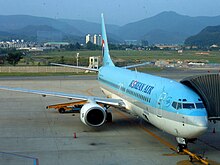
South Korea is a relatively small country with a fast and efficient train service, so flying is not the fastest way to get places unless you are going to the island of Jeju .
Nevertheless, plenty of airlines fly between the main cities at rates comparable to the KTX train. Most flights are with Korean Air or Asiana , however many new options exist with budget airlines such as T'way Air , Air Busan , Eastar Jet , Jin Air [dead link] and Jeju Air (which despite the name also serves the busy Seoul–Gimpo to Busan route). Service is similar between full service and low-cost airlines on domestic flights; low-cost airlines offer free soft drinks and 15 kg of checked luggage.
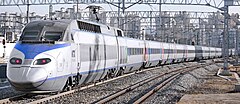
National train operator Korail ( KR ) connects major cities in South Korea. A large amount of money has been plowed into the network, and trains are now competitive with buses and planes on speed and price, with high safety standards and a good deal of comfort.
South Korea's flagship service is the high speed Korea Train eXpress ( KTX ) with services from Seoul to Busan , Yeosu , Mokpo , Masan , and Gangneung . The competing Super Rapid Train ( SRT ) also offers services on the core Seoul-Busan/Mokpo routes.
KTX and SRT trains use French TGV technology and Korean technology to travel at more than 300 km/h. The fastest non-stop trains travel between Busan and Seoul in just over two hours. There are vending machines on board that serve drinks and snacks and earphones, and cell phone chargers.
Non-KTX trains are poetically ranked as ITX-Saemaeul (ITX-새마을, "New Village"), Mugunghwa (무궁화, "Rose of Sharon", which is the national flower of Korea) and Tonggeun (통근, "commuter"), corresponding roughly to express, semi-express and local commuter services. All ITX-Saemaeul and Mugunghwa trains can travel at up to 150 km/h. ITX-Saemaeul trains are a little pricier than buses, while Mugunghwa are about 30% cheaper. However, ITX-Saemaeul trains are incredibly comfortable, having seats comparable to business class seats on airplanes. Since the introduction of the KTX, there are much fewer ITX-Saemaeul and Mugunghwa services, but they are worth trying out. Tonggeun are cheapest of all, but long-distance, unairconditioned services have been phased out, and they're now limited to short regional commuter services in Gwangju .
Also, there is a ITX-Cheongchun service between Seoul and Chuncheon . It's a special version of ITX at that line.
Saemaeul and some Mugunghwa trains are equipped with power plugs on laptop seats.
Smoking is not permitted on any Korean trains or stations (including open platforms).
Tickets are much cheaper than in Japan but more expensive than other Asian countries — although the damage can be lowered by traveling on local trains rather than KTX. Buying tickets is fairly easy: self-service terminals accepting cash and credit cards are in multiple languages and are very simple to use. Station staff can usually speak basic English. Most stations are clean, modern, and have good signposting in Korean and English, and compared to China or Japan, Korea's rail system is very user-friendly.
Pre-booking any train tickets a day prior (be they KTX, ITX-Saemaeul , or Mugunghwa ) is recommended for weekend trips, as all trains can be booked up for hours on end. On Sunday in particular, all but local trains may regularly be completely booked up. If you don't reserve tickets in advance when departing busy hubs such as Seoul or Busan, you may see your options reduced to "unallocated seating" on the slowest local trains (sitting on the floor in the un-air-conditioned space between carriages, or standing in the toilet for much of the trip). You are, however, free to sit on any seat that seems free until someone with the ticket to that seat shows up. If you are confident in your Korean, you can ask to reserve seats on available sections and travel standing up the rest of the way.
There are also tourist many trains that let you go to rural and scenic parts of Korea.
Seoul also has an extensive commuter train network that smoothly interoperates with the massive subway system, and Busan , Daejeon , Daegu , Gwangju and Incheon also have subway services.
Korail Pass [ edit ]
The Korail Pass is a rail pass only for non-resident foreigners staying less than six months in Korea, allowing unlimited travel for a set period on any Korail train (including KTX) and including free seat reservation. The pass is not valid for first-class or sleeping cars, but you can upgrade for half the price if you wish. The pass must be purchased at least five days before travel (preferably before arrival in Korea). It's not cheap as it needs a substantial amount of travel (e.g., Seoul–Busan round trip) to pay off and severe limitations on usage apply during Korean holidays and peak travel periods, including Lunar New Year and Chuseok . Prices as of May 2015 are for a 1-day pass ₩66,900, 3-day ₩93,100, 5-day ₩139,700, 7-day ₩168,400, and 10-day ₩194,400, with discounts for youth (age 13–25), students and groups.
Joint KR/JR Passes between Korea and Japan also exist, however, considering how much of a discount the JR Pass offers, and how strikingly little the KR Pass does by comparison, it usually makes sense to just get the JR Pass.
Rail cruises [ edit ]
Korail Tourism Development provides a rail cruise called Haerang , which enables the customers to travel to all the major sightseeing destinations in Korea with just one luxury train ride.
By bus [ edit ]

Buses (버스 beoseu ) remain the main mode of national transport, connecting all cities and towns. They're frequent, punctual, and fast, sometimes dangerously so, so fasten the belts you'll often find in the seats. Korean buses don’t have toilets, and rest stops are not standard on trips of less than 2 hours, so think twice about that bottle of tea at the terminal. Unlike trains, bus terminal staff and drivers are less likely to speak or understand English, and even signage is often only in Korean. Having your destination written down in hangul will be helpful.
There is a somewhat pointless division of long-distance buses into express buses (고속버스 gosok beoseu ), which use toll expressways and are thus slightly faster but also more expensive, and intercity buses (시외버스 si-oe beoseu ), which are a bit slower but go more places. Timetables, fares and tickets are available on their respective websites, which are Kobus and TxBus respectively. Whichever one you pick, you'll need to choose in advance, since in larger cities they depart from different terminals.
For additional comfort, look for udeung buses (우등 버스, glossed "Excellent" on the Kobus website) which have just three seats across instead of the usual four; these cost about 50% extra. However, some intercity buses use udeung buses without extra fares on highly competitive lines such as Seoul–Andong routes.
In addition, local inner-city bus (시내버스 si-nae beoseu ) networks often connect directly neighboring cities, and Incheon Airport has its own dedicated network of airport limousine buses .
Ferry boats surround the peninsula and shuttle out to Korea's many islands. The main ports include Incheon , Mokpo , Pohang , and Busan . The most popular destinations are Jeju and Ulleungdo .
There is a daily service from Busan to Jeju. There are mostly undiscovered and scenic islands near Incheon that can seem almost deserted.
By car [ edit ]
An International Driving Permit (IDP) may be used to drive around South Korea. In general, road conditions are good in South Korea, and directional signs are in both Korean and English. Car rental rates start from ₩54,400/day for the smallest car with a week's rental. South Korea drives on the right in left-hand-drive cars. South Korea also follows the American practice of allowing cars to turn right at red lights as long as they (in theory) yield to pedestrians. In contrast, left turns on green lights are illegal unless there is a blue sign pointing left saying 비보호 or green left arrow.
If you are traveling in the big cities, especially Seoul or Busan, driving is not recommended as the roads often experience heavy traffic jams, and parking is expensive and difficult to find. Many drivers tend to get reckless under such conditions, weaving in and out of traffic. Drivers often try to speed past traffic lights when they are about to turn red, and several cars (including fully-loaded public transit buses) will typically run through lights after they have turned red, whether pedestrians are in the crosswalk or not.
Koreans consider driving rules as guidelines only and don't expect to be punished for parking illegally or cutting through a red light. This means that if you want to drive, you will need to do so assertively by pushing yourself into an intersection and forcing other cars to yield.
A GPS is highly recommended while navigating Seoul or Busan. Lanes end or turn into bus lanes with little to no warning, and it may not always be obvious where turns are allowed. A good rule of thumb is to stay in the middle lane as cars will often illegally park in the right lane while the left lane will become a turning lane with little warning. However, Google Maps and Apple Maps cannot be used for navigation in South Korea due to national security laws prohibiting the distribution of mapping data to other countries. You should use Naver Map or Kakao Map instead.
By taxi [ edit ]

Taxis are convenient, if a somewhat pricey way of getting around the cities, and are sometimes the only practical way of reaching a place. Even in the major cities, you are extremely unlikely to get an English-speaking taxi driver, so it will be necessary to have the name of your destination written in Korean to show your taxi driver. Likewise, get your hotel's business card to show the taxi driver in case you get lost.
Although doing so is illegal, cab drivers, particularly the cheaper white cabs on busy Friday or Saturday nights, may deny service to short-distance fares. A very handy technique to counter this is to have your destination (hotel name, or the district (구 gu ) and neighborhood (동 dong ), in Korean of course) written in thick black ink on a large A4 sheet of paper and hold it to the traffic. Passing cab drivers responding to long-distance call outs, or with space in their cab in addition to an existing fare in that direction will often pick you up en route.
In particular, when hailing a cab, ensure you follow the local custom and wave it over with your hand extended but all your fingers extended downwards and beckoning as opposed to upwards in the Western fashion (this style is reserved for animals).
As of Nov 2023, it is illegal to refuse a short ride in a taxi, and it is also illegal to ride in a taxi while it is operating. By using apps such as Kakao Taxi, I.m Taxi, and uber, you can book a taxi without language difficulties and without worrying about being overcharged.
See [ edit ]
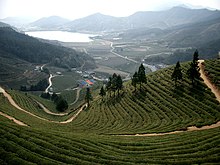
Asian tourists have long discovered South Korea as a prime shopping, culinary and sightseeing destination. It is a relatively new travel destination for the Western world, but has gained popularity fast. And for good reason, as South Korea offers a most pleasant combination of ancient Asian features and all the amenities you would expect from a modern, high-tech nation. Despite its compact size, it boasts a broad range of fine attractions, and excellent infrastructure makes getting around easy.
- Seoul Most journeys begin in the nation's capital that never sleeps. This ancient place has seen centuries and wars come and go but seems to have come out stronger than ever. Popularly called the "Miracle on the Han River", it's one of the largest metropolitan economies in the world. It's the country's industrial epicenter, the birthplace of K-pop, a hotspot for South-Korean nightlife and fine dining and home to countless museums. The fabulous history and art collection of the National Museum of Korea (국립중앙박물관) reigns supreme and a visit there is a day well spent. The city has been rediscovering its historical treasures and improving city parks, adding to its charm. Downtown Seoul, where the old Joseon Dynasty city was, is where you'll find most of the palaces , Gyeongbokgung (경복궁), Changdeokgung (창덕궁) and Gwanghwamun (광화문). It is surrounded by a Fortress Wall , with the famous Namdaemun , one of the eight gates, being perhaps the main attraction. The Banpo bridge (반포대교) turns into beautiful colours at night, and the Yeouido Island (여의도), apart from the famous 63 Building has splendid parks for rollerblading/biking. Other sights are the Secret Garden (비원), Seodaemun (서대문), or the Seoul Tower (서울타워) accompanied by the famous Teddy Bear Museum. To get away from the buzz, follow the locals to Cheonggyecheon (청계천), one of the urban renewal projects and a popular public recreation space, or enjoy an afternoon tea in a traditional teahouse in Insadong .
- Busan is the country's second city and most significant port. Called the nation's summer capital, Koreans flock to this city's fine beaches, seafood restaurants and festivals. Haeundae beach (해운대) in Busan is the most famous in the country, with an atmosphere is comparable to southern France or California in the summer.
- Korean Demilitarized Zone (DMZ) On July 27th 1953, The Demilitarized Zone (DMZ) was established as a cease-fire agreement with a boundary area of 2km between North and South Koreas. Panmunjeom aka Joint Security Area ( JSA ) is the ‘truce village’ of the DMZ where tourists can view North and South Korea without much hostility. Here you can also enter one of the buildings that are located on the border aka Military Demarcation Line (MDL), which means you can actually cross into the North when entering those buildings. The border is indicated by a line where North and South Korean soldiers face each other coldly. The tour includes the nearby bridge of no return that used to be the main controlled crossing point between the countries. Also, the Third Tunnel of Aggression , created by North Korea (1.7 km long, 2 m high and about 73m below ground), was discovered in 1978. This tunnel is not more than an hour or 44 km away from Seoul.
- Bukhansan is just a stone's throw north of Seoul and one of the most visited national parks in the world. Some 836 meters high, Mount Bukhansan is a major landmark visible from large parts of the city and the park is home to the beautiful Bukhansanseong Fortress . The popular hike to get up there is well worth it, as you'll be rewarded with great views of the metropolis. The country has over 20 national parks, mostly mountainous such as Seoraksan National Park , but some also focus on marine and coastal nature. The lush green tea fields of Boseong offer an equally nice and peaceful get-a-way.
- Jeju Island If you don't mind the crowds, this volcanic and semi-tropical island offers a spectacular scenery and numerous natural sights, a relaxing and warm (especially in winter) atmosphere and plenty of activities. Don't miss the Lava tubes , Seongsan Ilchubong , Loveland , and South Korea's highest mountain Hallasan (1,950 m).
- Gochang, Hwasun and Ganghwa Dolmen Sites is a World Heritage and home to a significant part of all the dolmen in the world. Apart from the impressive megalithic stones, it has brought forward a highly important collection of archaeological finds.
- Gyeongju Once the nation's capital, it boasts numerous royal burial and World Heritage cultural sites, as well as relaxing resorts.
- Folk villages If you'd like to see a bit of Korean folklore, Hahoe Folk Village near Andong , Yangdong , the living museum-like Korean Folk Village in Yongin or Hanok Village in Jeonju are among the best.
- Festivals Korea is a country of festivals. No matter where you go, there's likely something happening close by. Watching or even joining in the bustling celebrations is often a fabulous and colorful experience. The Boryeong Mud Festival (보령머드축제) is a popular pick, when participants drench themselves in mud and take part in everything from mud wrestling to body painting. The nearby beach becomes something of a party apocalypse.
- National Treasures South Korea retains multiple state-owned intangible treasures, which make them popular tourist attractions.
- Coasts The coastline of South Korea dominates three seas, including both East and West. Its waters range from rugged beauty to subtropical beach resorts, including Busan .
Traditional arts [ edit ]
Korea was traditionally home to two types of theatre: talchum (탈춤) and pansori (판소리).
Talchum is a traditional type of dance performed by people wearing masks, often accompanied with singing. It originated in Hwanghae province in what is now North Korea, though it has since spread around the country. Traditional Hwanghae-style talchum is also performed in the South, often by North Korean refugees and their descendants.
Pansori is a type of musical storytelling involving a storyteller and a drummer, with the storyteller usually expected to use their voices and facial expressions for dramatic effect. Following contact with Western styles of drama, pansori evolved into changgeuk (창극) in the early 20th century, which is essentially Korean opera, with actors and an accompanying orchestra.
Gisaeng (기생) or kisaeng are the Korean equivalent of the Japanese geisha (or more accurately, courtesans known as oiran ), and were historically sex workers trained in the arts of poetry, calligraphy and music, entertaining clients with their skills and conversation. While the tradition has largely died out in modern South Korea, gisaeng are often featured in Korean historical dramas, and many of their traditional arts are now being revived.
Do [ edit ]

For a definite list of activities refer to individual cities. However, some of the best ones are:
- Hiking With the country being covered in mountains, Korea is a fantastic destination with numerous hiking opportunities . Try Jirisan (지리산), Seoraksan (설악산) or go to South Korea's highest peak, the dormant volcano Hallasan on Jeju island. They offer great views, 1- to 3-day tracks, English sign posts/maps, huts (most of them heated), and can be organized easily. In autumn the leaves turn into beautiful colours, so the best seasons to go there are autumn and spring.
- Jjimjilbang Koreans love saunas! If you can get past everyone being naked, then this is an excellent way to feel refreshed after a hard day sightseeing. Even small towns will have one. They can also be used to stay overnight — this is especially convenient if you missed to make a reservation for an accommodation, everything is full or you are looking for a cheap accommodation. Weekends are extremely busy with families.
- Hot springs In common with their Japanese and Taiwanese neighbors, Koreans love their hot springs (온천, 溫泉 oncheon ), and resorts can be found throughout the country. Etiquette usually require bathers to be nude. Many places also have saunas connected.
- Snowboarding/Skiing The Gangwon province offers ski decent opportunities in winter, which is very beautiful when it snows. See the Seoul guide for close to the city destinations, which you can reach by free public (ski) bus within 90 minutes.
- Eat Perhaps you have had Korean BBQ in your home country. The reality of Korean food is so much more diverse and tasty. Try something new delicious every each day! (Seafood, meat or vegetarian)
- Winter surfing Owing to local tidal conditions, the best surf is in the winter! Pohang and Busan are two places you can try this
- Karaoke/Singing Rooms Noraebang (노래방) is the same as Japanese Karaoke palors, popular and hard to miss wherever you go in metropolitan cities.
- Martial arts Learn martial arts such as the famous Taekwondo (태권도), Hapkido (합기도), and the dance-like martial art Taekkyeon (택견). You can also go and watch a competition or performance — for instance cultural festivals may feature traditional martial arts.
- Temple Stay Spend a few days meditating and learning about Buddhism at a Korean monastery.
- Water amusement parks are plentiful in the Gyeonggi and Gangwon provinces, such as Caribbean Bay in Yongin , Ocean World in Hongcheon, with a more Ancient Egyptian setting, and Ocean 700 in Pyeongchang. Tourists and locals usually go there in the summer.
- Yeondeunghoe is a traditional festival held during Buddha's birthday when the streets are hung with colorful lotus lanterns and can also involve celebratory parades.
- The board game Go , called baduk in Korean, is quite common and several of the world's top professional players are Korean.
Sports [ edit ]
Baseball was brought to Korea by American missionaries in 1904 and is the most popular sport in the country. Most cities have a team and the biggest are sponsored by the largest South Korean companies, and many South Korean players have become famous Major League Baseball players in the United States. The top baseball league in South Korea is the KBO League , featuring 10 teams from 8 cities. The South Korean national baseball team is also regarded as one of the strongest in the world, finishing second at the 2009 World Baseball Classic.
Soccer is becoming more important to South Korea over time, and is a sport shared by North and South. South Korea is one of the strongest teams in Asia and some of their players work have had successful careers in the top European leagues. The sport gained an incredible amount of short term popularity when the South Korean national team reached the World Cup semi-finals in 2002, and even today the country stops for World Cup matches. Unfortunately the enthusiasm for domestic and friendly international games is extremely low, and stadiums are usually mostly empty.
Other popular sports include golf and basketball. Badminton, table tennis and bowling are also popular and facilities for the public are widely available in cities. Korean martial arts such as taekwondo (태권도) are also popular. Golf particularly has a strong following, with membership fees for Korea's top golf clubs being more expensive than those in neighboring Japan or the United States. Many of the world's top female golfers are from Korea or of Korean descent. Archery is also a popular sport, with South Korea dominating the archery events at the Olympics.
As for winter sports, speed skating (especially short track) and figure skating are extremely popular due to the repeated success of South Korea in the Winter Olympics, with South Korea dominating the short track speed skating events. The city of Pyeongchang hosted the 2018 Winter Olympic Games .
Buy [ edit ]
Money [ edit ].
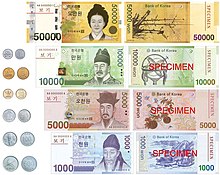
The currency of South Korea is the South Korean won , denoted by ₩ (ISO code: KRW ) and written 원 ( won ) in the Korean language.
Bills come in denominations of ₩1,000 (blue), ₩5,000 (red), ₩10,000 (green) and ₩50,000 (yellow). The ₩50,000 is very practical if you need to carry around a reasonable amount of cash, however it can be hard to use on goods or services with a value of less than ₩10,000. The ₩50,000 can be hard to find and often only provided by ATM's that display a picture of the yellow note on the outside.
₩100,000 "checks" are frequently used, and some of the checks go up to ₩10,000,000 in value. These checks are privately issued by banks and can be used instead of cash for larger purchases, such as hotel rooms.
Coins mainly come in denominations of ₩10, ₩50, ₩100 and ₩500. Very rare ₩1 and ₩5 coins do exist. Generally speaking it is rare to buy anything valued less than ₩100.
Banking and payment [ edit ]
Credit card acceptance in shops, hotels and other businesses on the other hand is very good, and all but the very cheapest restaurants and motels will accept Visa and MasterCard. Even small purchases such as ₩4,000 for a coffee are okay. This works well since credit cards have good exchange rates, however if you are using a foreign card then you should ensure with your bank that there isn't a fee for this foreign transaction.
ATMs are ubiquitous, although using a foreign card with them is rather hit and miss. There are however many special global ATMs which accept foreign cards. They can generally be found at Shinhan/Jeju Bank, airports, in areas frequented by foreigners, in major cities, some subway stations, and in many Family Mart convenience stores — most of the time indicated by the "Foreign Cards" button on the screen. Some banks, such as Citibank, have a fee of ₩3,500 for foreign cards. Before heading to the countryside where foreign cards are less likely to be accepted, be sure to have cash or another source of money.
T-money smart cards are an alternative source of payment accepted widely, especially for public transportation. (See § Smart cards .) Some other cities have their own smart cards, and topping up T-money outside of Seoul can be a problem but at Shinhan/Jeju Bank it should always be possible. You may need to ask the local cashier for help due to the Korean-only menus/buttons.
If you plan on staying in South Korea for a longer time, you'll probably want to set up a bank account at a Korean bank such as Woori Bank, which can then be used at the bank's ATMs throughout the country. (Even some non-local accounts can do this, e.g. Woori Bank accounts setup in China come with an ATM card that can be used with all its ATMs in South Korea.) Many banks will even allow you to open an account on a tourist visa, though the services you will be able to access will often be very limited. Some of the larger banks may have English-speaking staff on hand at their major branches.
Costs [ edit ]
South Korea is fairly expensive compared to most Asian countries, but is a little cheaper compared to other modern developed countries such as Japan and most Western countries. A frugal backpacker who enjoys eating, living and travelling Korean-style can easily squeeze by on under ₩60,000/day, but if you want top-class hotels and Western food even ₩200,000/day will not suffice. Seoul is more expensive than the rest of the country, and has become particularly expensive competing in many ways with Tokyo , but this has eased since the financial crisis.
Tipping [ edit ]
Tipping is not expected anywhere in South Korea and is not practiced by Koreans. It could be considered an insult between Koreans as it is regarded as giving someone charity, although people generally know of American tipping culture and would be understanding of a foreigner doing this.
Many hotels and a few tourist restaurants add 10% service charge on their bills. Bellhops, hotel maids, taxi drivers and bars frequented by Westerners will not reject any tips that you care to hand out.
Restaurants sometimes provide complimentary food or drinks to customers as a sign of generosity or to reward customer loyalty. Colloquially, this is known as "service".
Shopping [ edit ]

At certain retail outlets with a "Tax Free Shopping" or a "Tax Refund Shopping" sign, you can obtain a voucher and get a large percentage (approx. 10%) of your purchase refunded for individual purchases between ₩30,000 and ₩200,000, and with a total limit of ₩1 million. When you leave South Korea, go to customs and have it stamped then go to the "Global Refund Korea" or "Korea Tax Refund" counters near the duty-free shops. However, to get a refund you must leave within 3 months of purchase.
Bargaining is common at outdoor markets and applies to everything they may have to offer. However, do not state a specific monetary amount. Instead, say " ssage juseyo " (싸게 주세요, "Cheaper, please."). Doing this once or twice will suffice. However, you will rarely be discounted more than a few dollars.
Korea is the ginseng (인삼 insam ) capital of the world. Widely considered to have medicinal properties, it can be found in special mountain areas throughout Korea. A thick black paste made from ginseng is popular, as is ginseng tea and various other products. There are many grades of ginseng, with the best grades potentially fetching millions of US dollars at auctions. A good place to check out the different types of ginseng would be Gyeongdong Herbal Medicine Market in Seoul .
Visitors looking for traditional items to bring home can find a wide variety of choices. You can find a blue-jade celadon from the Goryeo Dynasty, handmade traditional costumes, paper kites and ceramic pieces that depict human emotions in their designs at the numerous markets and souvenir shops. Insadong in Seoul would be the first place to shop around. After a while one store might start to look like every other store but chances are you'll find what you need.
Keeping up with the latest fashion trends, shoppers and boutique owners alike flock the streets and markets every weekend. Centered largely in Seoul with popular places such as Dongdaemun, Mok dong Rodeo Street and Myeong dong, fashion centers can be divided into two large categories; markets and department stores. Markets are affordable and each shop will have trendy similar type clothing that appeal to the masses. Also, be aware that you cannot try on most tops. So better to know your size before shopping there. Though department stores will have areas or floors that have discounted items, they are considered overpriced and catering mostly to an older, wealthier crowd.
The traditional Korean garment known as the hanbok (한복), which is still worn by South Koreans for special occasions and historical re-enactments, and can be found in various garment markets. While a traditional hanbok requires visiting a specialist shop and customized fittings, making it rather expensive, more casual versions that are more practical for daily use and significantly cheaper can also be found. A popular place to get a traditional hanbok is the second floor of Gwangjang Market in Seoul , where you can find many traditional hanbok tailors, each with a wide array of fabrics to choose from. When wearing a hanbok, it should always be wrapped left over right; doing it the other way round is a major faux pass as that is only done when dressing the dead.
For all things considered antique , such as furniture, calligraphic works, ceramics and books, you can go to Jangangpyeong Antique Market in Seoul . Items over 50 years old cannot leave the country . Check with the Art and Antique Assessment Office at +82-32-740-2921.
Electronics such as mobile phones, tablets, laptops and other gadgets are widely available, especially in larger cities like Seoul and Busan . For the most part these same devices are available in most Western countries and the warranties may not be honored outside of Korea. You would also probably have to contend with having the instruction booklets and functions being written in Korean. Korean Rice Cookers are very popular with visitors from East Asia - with many more models and at a cheaper price than abroad - just be aware that 'voice activated' cookers may require you to speak Korean to them!

K-pop is a large element of the Korean Wave ( hallyu ) phenomenon that took much of Asia by storm at the beginning of the 21st century, and spread to the West in the 2020s, so you might want to stream the latest Korean music by popular K-pop singers and groups — and discover some of the lesser-known ones. K-pop artistes are signed by talent agencies and record companies at a very young age, and typically train arduously for many years before they are allowed to debut. These days, K-pop singers are recruited not just from South Korea, but also from across East Asia such as China, Japan, Thailand and Vietnam, and overseas Korean-American and Korean-Australian communities. Controversially, aspiring K-pop artists are made to sign contracts that give them little control over their private lives, often banning them from dating in order to maintain the illusion of "availability" to their fans. In terms of shopping, there are plenty of opportunities to buy merchandise — such as posters, t-shirts, mobile phone cases. Most music is now consumed as digital downloads, but there are still some music shops selling CD's to be found. And if you want to see them live , there is of course no better place than South Korea.
K-dramas are massively popular in Asia and streaming a drama will certainly last you many rainy afternoons. It is possible to visit many famous K-Drama locations and possibly buy related merchandize there. Many tourists like to hire traditional costumes from historical dramas and recreate the scenes. These days it is possible to stream recent K-Dramas around most of the world, although it is still possible to buy a series box set on DVD if you look hard enough (note that Korean DVD's will be locked to DVD region 3 and may not have foreign subtitles).
Eat [ edit ]

Korean cuisine is becoming increasingly popular outside of Korea, especially in other parts of East Asia and the U.S. It can be an acquired taste, with lots of spicy and fermented dishes, but it's addictive once you get used to it and Korean food is definitely in a class of its own, mixing spicy chilies and copious amounts of garlic with delicate ingredients like raw fish. Although Korean food is quite low in fat, a fact attested to by the observation that very few South Koreans are overweight, those with sodium-limited diets should beware, as Korean cuisine can be heavy in salt.
A Korean meal is centered around rice and soup and likely a fish or meat dish, invariably served with a vast assortment of small side dishes known as banchan (반찬). The humblest meal comes with three types while a royal banquet may well feature twenty types of banchan. In addition to kimchi, typical side dishes include bean sprouts (콩나물 kongnamul ), spinach (시금치 shigeumchi ), and small dried fish.
The ubiquitous kimchi (김치 gimchi ), made from fermented cabbage and chili, accompanies nearly every meal and ranges from mild to roaringly spicy. In addition to the common cabbage type, kimchi can also be made from white radish (깍두기 ggakdugi ), cucumbers (오이 소박이 oi-sobagi ), chives (부추 김치 buchu gimchi ) or pretty much any vegetable that can be pickled. Many different dishes are made using kimchi for flavoring, and kimchi is served as a side dish as well. It is not uncommon to find Korean tourists carrying a stash of tightly packed kimchi when travelling abroad.
Two more condiments found in almost every dish are doenjang (된장), a fermented soybean paste akin to Japanese miso , and gochujang (고추장), a spicy chili paste.
While many of these dishes can be found throughout Korea, every city also has its own regional specialties, such as dakgalbi (닭갈비) in the city of Chuncheon .
A common perception among Koreans is that foreigners don't like spicy food , so you might have to spend some time convincing people otherwise if you really want to eat something hot. And while Korean food undoubtedly has the neighboring bland-dieted Japanese and northern Chinese breathing fire, if you're accustomed to, say, Thai or Mexican food, you may wonder what the fuss is about.
Foreign food restaurants are also popular, albeit usually with a Korean twist. Fried chicken has been adopted and many believe it better than the American original. Pizzas are also ubiquitous although you may wonder quite where the inspirations behind the toppings came from. Vietnamese and Mexican food appeals to Koreans as well. Japanese restaurants of all varieties are very common. Strangely enough, authentic Chinese food is somewhat hard to come by, and Koreans often think of Korean Chinese dishes such as jajangmyeon (자장면, noodles topped with a thick brown sauce, derived from a northern Chinese dish) with tangsuyuk (탕수육, sweet and sour pork) as Chinese dining.
Etiquette [ edit ]

Korean utensils (수저 sujeo ) consist of a spoon (숟가락 sutgarak ) and chopsticks (젓가락 jeotgarak ). Unique in Asia, Koreans use chopsticks made of metal , which don't burn when used over a hot grill and are easier to wash and reuse. Restaurants typically provide stainless steel chopsticks, which unfortunately for the chopstick learner, are very difficult to use! These thin and slippery sticks are not as easy as the wooden or plastic chopsticks but you'll still manage with some fumbling.
Spoons are used to eat rice, soup, and porridge. (Koreans find it strange that their Asian neighbors eat rice with chopsticks.) Dongaseu (돈가스, Japanese-style tonkatsu or fried pork cutlet) is eaten with a fork and knife. Many Korean restaurants may also offer Western cutlery to a Westerner.
When eating as a group, communal dishes will be placed in the center and everybody can chopstick what they want, but you'll still get individual portions of rice and soup. Unless you are eating royal cuisine, most dishes are served family style.
In many traditional households, children were taught that it is impolite to speak during meals . Don't be surprised if there's complete silence while eating. People, particularly men, will use mealtimes to quickly eat up and move on to other things. This can be attributed to the short mealtimes during military service that most young Korean men must perform.
Some etiquette pointers:
- Do not leave chopsticks sticking upright in a dish, especially rice. This is only done when honoring the deceased. Similarly, a spoon sticking upright into a bowl of rice is also not a good sign.
- Do not pick up your chopsticks or start eating until the eldest at the table has begun to eat.
- Do not lift any plates or bowls off the table while eating, as Koreans consider this to be rude.
- Do not make noises by hitting your utensils on the food bowls and plates.
Restaurants [ edit ]
Going hungry in South Korea would be difficult. Everywhere you turn, there is always somewhere to eat. Korean restaurants can be divided into a few categories:
- Bunsik (분식) are snack eateries that have cheap, tasty food prepared quickly.
- Kogijip (고기집), literally meaning "meat house", are where you'll find grilled meat dishes and fixings.
- Hoejip (회집), "raw fish house", serve slices of fresh fish akin to Japanese sashimi , known as hwe in Korean, and free side dishes. You'll normally find these restaurants cluttering the shores of any waterway.
- Hansik (한식) serve the full-course Korean meal (한정식, hanjeongsik ), a Korean haute cuisine that originated with banquets given at the royal palace. Traditionally served all at once, restaurants today will serve courses separately. The meal starts with a cold appetizer and juk (죽, porridge). The main dish includes seasoned meat and vegetable dishes that can be either steamed, boiled, fried or grilled. After the meal, you are served traditional drinks such as sikhye or sujeonggwa .
- Department stores have two types of food areas: a food hall in the basement and full service restaurants on the top levels. The food hall areas have take-away as well as eat-in areas. The full service restaurants are more expensive, but typically have the advantage of picture menus and good ambience.
Barbecues [ edit ]
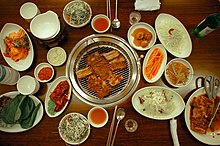
Korean barbecue is probably the most popular Korean dish for Westerners. In Korea, it's split into bulgogi (불고기, thin cuts of marinated meat), galbi (갈비, ribs, usually unmarinated), and a few other categories. In these, a charcoal brazier is placed in the middle of the table, and you cook your choice of meats, adding garlic to the brazier for spice. A popular way of eating it is to wrap the meat with a lettuce or perilla leaf, adding shredded green onion salad (파무침 pa-muchim ), raw or cooked garlic, shredded pickled radish (무채 muchae ) and ssamjang (쌈장, a sauce made from doenjang , gochujang , and other flavorings) to your liking.
The cost of a barbecue meal depends largely on the meat chosen. In most Korean restaurants that serve meat, it is sold in units (usually 100 grams). Pork is by far the most common meat ordered; it's much cheaper than beef and according to diners tastier. You'll rarely see filet mignon; instead, common cuts of meat include ribs, unsalted pork bacon (삼겹살 samgyeopsal ) and chicken stir-fried with veggies and spicy sauce (닭갈비 dak-galbi ). Unmarinated meats tend to be higher quality, but in cheaper joints it's best to stick with the marinated stuff.
Rice dishes [ edit ]
Bibimbap (비빔밥) literally means "mixed rice", which is a pretty good description. It consists of a bowl of rice topped with vegetables and usually shreds of meat and an egg, which you mix up with your spoon, stirring in your preferred quantity of gochujang , and then devour. Particularly tasty is dolsot bibimbap (돌솥비빔밥), served in a piping hot stone bowl (watch your fingers!) that cooks the rice to a crisp on the bottom and edges.
Another healthy and tasty option is gimbap (김밥), sometimes dubbed "Korean sushi rolls". Gimbap contains rice, sesame seed, a Korean variety of spinach, pickled radish, and an optional meat such as minced beef or tuna, all neatly wrapped in dried seaweed, topped with sesame oil and sliced. A single roll makes a good snack or a whole meal depending on your appetite, and they travel well. What differentiates Korean gimbap and Japanese sushi is how they prepare rice: gimbap usually uses salt and sesame oil to flavor the rice, while sushi uses sugar and vinegar. Also, gimbap usually does not feature raw fish.
More of a snack than a meal is tteokbokki (떡볶이), which resembles a pile of steaming intestines at first sight, but is actually rice cakes (떡, tteok ) in a sweet chili sauce that's much milder than it looks.
Fried rice (볶음밥 bokkeum-bap ) is also popular in South Korea, often as an add-on at the end of a meal that is cooked on a tabletop stove (like bulgogi or dakgalbi). It can also be ordered as a standalone dish in some places; kimchi fried rice (김치볶음밥 gimchi-bokkeum-bap ) is a popular comfort dish for South Koreans.
Soups and stews [ edit ]
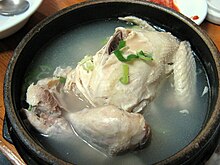
Soups are known as guk (국) or tang (탕), while jjigae (찌개) covers a wide variety of stews. The line is fuzzy, and a few dishes can be referred to with both (e.g. the fish soup-stew dongtae jjigae/dongtaetang ), but in general, jjigae are spicier and thicker while guk/tang are milder. Both are always eaten with plenty of white rice on the side.
Common versions of jjigae include doenjang jjigae (된장찌개), made with doenjang , vegetables and shellfish, and gimchi jjigae (김치찌개), made with — you guessed it — kimchi. Sundubu jjigae (순두부찌개) uses soft tofu as the main ingredient, usually with minced pork added, but there's also a seafood version called haemul sundubu jjigae (해물 순두부찌개) where the meat is replaced by shrimp, squid and the like.
Budae jjigae (부대찌개) is an interesting type of Korean fusion food from the city of Uijeongbu , where a U.S. military base is located. During the Korean War, the then-impoverished locals put together a dish using scraps from the American bases such as spam, sausages, and pork and beans, and while recipes vary, most of them involve large quantities of fiery kimchi. Most places will bring you a big pan of stew and put it on a gas stove in the middle of the table. Many like to put ramyeon noodles (라면 사리) in the stew, which is optional.
Popular tang soups include seolleongtang (설렁탕), a milky white broth from ox bones and meat, gamjatang (감자탕), a stew of potatoes with pork spine and chilies, and doganitang (도가니탕), made from cow knees. One soup worth a special mention is samgyetang (삼계탕), which is a whole spring chicken stuffed with ginseng and rice. Thanks to the ginseng, it's often a little expensive, but the taste is quite mild. It's commonly eaten right before the hottest part of summer in warm broth in a sort of "eat the heat to beat the heat" tradition.
Guk are mostly side dishes like the seaweed soup miyeokguk (미역국) and the dumpling soup manduguk (만두국), but a few like the scary-looking pork spine and ox blood soup haejangguk (해장국), a popular hangover remedy, are substantial enough to be a meal.
Noodles [ edit ]

Koreans love noodles, and the terms kuksu (국수) and myeon (면) span a vast variety of types available. They're often sold in fast-food noodle shops for as little as ₩3000. Wheat-based noodles are a staple of Korea.
Naengmyeon (냉면) are a Korean specialty, originally from the north . The thin, chewy buckwheat noodles served in ice-cold beef broth are a popular summer dish — although it's traditionally a winter food! They're also a classic way to end a heavy, meaty barbecue meal. The key to the dish is the broth (육수 yuksu ); the recipes of well known restaurants are usually closely guarded secrets. Generally comes in two distinct styles: Pyongyang mul naengmyeon with a clear broth, and Hamhung bibim naengmyeon with a spicy dressing and chewier potato noodles.
Japchae (잡채) are yam noodles, which are fried along with some vegetables (commonly cabbage, carrots, onions) and sometimes beef or odeng (fishcake). Mandu (만두) dumplings are also very popular and are served up in steamed or fried as an accompaniment to other foods, or boiled in soup to make a whole meal.
Ramyeon (라면) is Korea's variant of ramen, often served with — what else? — kimchi. Korean ramyeon is well known for its overall spiciness, at least when compared to Japanese ramen. The Shin Ramyun brand of instant noodles are exported to over 100 countries.
Jajangmyeon (자장면) is considered to be Chinese food by Koreans, being derived from northern Chinese zhájiàngmiàn , a wheat noodle dish served with a black sauce that usually includes minced pork, onions, cucumber, and garlic. It's typically served at (what are liberally described as) Chinese restaurants. Its sauce contains some caramel and therefore makes the overall dish sweet. A popular combination is jajangmyeon with "Chinese" sweet and sour pork and chicken.
Jjamppong (짬뽕) is a "Chinese" noodle dish comprising of noodles in a red spicy pork or seafood broth, originally derived from the Shandong dish chǎomǎmiàn . Often served with jajangmeyon in a special bowl split down the middle, this combination is known as jjamjjamyeon (짬짜면).
Finally, udong (우동) are thick wheat noodles, akin to Japanese udon .
Seafood [ edit ]
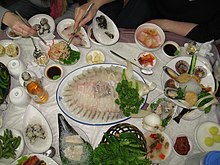
Since Korea is a peninsula, you can find every type of seafood (해물 haemul ), eaten both cooked and raw. Restaurants where you pick your own fish — or bring it from the fish market next door — are popular, but can be very expensive depending on what you order.
Hoe (회, pronounced roughly "hweh") is raw fish Korean-style (similar to sashimi), served with spicy cho-gochujang sauce (a mixture of gochujang and vinegar). Chobap (초밥) is raw fish with vinegared rice, similar to Japanese sushi. In both dishes, the bony parts not served raw are often made into a tasty but spicy soup called meuntang (매운탕).
Another cooked specialty is haemultang (해물탕), a spicy red hotpot stew filled crab, shrimp, fish, squid, vegetables and noodles.
Whale meat is available in a few restaurants in the cities and at festivals in smaller coastal towns, but is not easy to find and unlike Japan is not considered part of national culture. The city of Pohang has a long history of whaling, and its seafood market still openly offers whale. South Korea has outlawed whaling following the International Whaling Commission international moratorium in 1986, although makes an exception for whales caught by accident during regular fishing. Whale meat sourced from Japan has been sold in some restaurants, which is illegal (although the law is usually ignored). Whale restaurants are easy to identify, with pictures of whales on the outside leaving you in no doubt. If you choose to eat whale then you should understand that the species in question could be endangered and therefore a decision left to your own moral compass.
Other [ edit ]
Jeon (전), jijimi (지짐이), jijim (지짐), bindaetteok (빈대떡) and buchimgae (부침개) are all general terms for Korean-style pan-fried pancakes , which can be made of virtually anything. Pajeon (파전) is a Korean-style pan-fried pancake laden with spring onions (파 pa ). Haemul pajeon (해물파전), which has seafood added, is particularly popular. Saengseonjeon (생선전) is made of small fillets of fish covered with egg and flour and then pan fried, and nokdu bindaetteok (녹두빈대떡) is made from ground mung bean and various vegetables and meat combined.
If barbecued meat is not to your taste, then try Korean-style beef tartar, known as yukhoe (육회). Raw beef is finely shredded and then some sesame oil, sesame, pine nuts and egg yolk are added, plus soy and sometimes gochujang to taste. It's also occasionally prepared with raw tuna or even chicken instead.
Sundae (순대, pron. "soon-deh") are Korean blood sausages made from a wide variety of ingredients, often including barley, potato noodles and pig blood. Sundae is very tasty in spicy sauce or soup.
A squirmy delicacy is raw octopus (산낙지 sannakji ) — it's sliced to order, but keeps wiggling for another half hour as you try to remove its suction cups from your plate with your chopsticks. Sea squirts (멍게 meongge ) are at least usually killed before eating, but you might be hard-pressed to tell the difference as the taste has been memorably described as "rubber dipped in ammonia".
Dietary restrictions [ edit ]
Vegetarians will have a hard time in Korea. As in most of East Asia, "meat" is understood to be the flesh of land animals, so seafood is not considered meat. Spam can also be confused as not being meat, so be specific in explaining what you do not eat. If you ask for "no gogi (고기)" they will probably just cook as usual and pick out the big chunks of meat. One good phrase is to say you are " chaesikjuwija " (채식주의자), a person who only eats vegetables. This may prompt questions from the server, so be prepared! It is probably best to have a very explicit list of foods you do and do not eat in Korean on a card or piece of paper to show restaurant servers and cooks. (See Korean phrasebook § Eating .) Or look for namul (나물), a variety of Korean-style edible grass and leaves dishes.
Most stews will use fish stock, especially myeolchi (멸치, anchovy). This will be your bane, and outside of reputable vegetarian restaurants, you should ask if you are ordering any stews, hotpots, or casseroles.
Spicy (red) kimchi will almost certainly have seafood, such as salted tiny shrimp, as an ingredient. Since it disappears into the brine, you will not be able to visually identify it. It is possible to find vegan spicy kimchi, as it is made by some Buddhist temples, but you will have to spend some effort to find some. Another type of kimchi called mulgimchi (물김치, "water kimchi") is vegan, as it is simply salted in a clear, white broth with many different vegetables. If you are willing to eat something flavored with brine shrimp, then kimchi will certainly take you a long way in Korea.
For lactose intolerant people, avoiding dairy products is straightforward as they are uncommon in traditional Korean cuisine.
As per Korea's Buddhist tradition, vegans and vegetarians are safe at Korean temple cuisine (사찰음식 sachal eumsik ) restaurants, which uses no dairy, egg, or animal products, except perhaps honey. This cuisine has been in vogue, but it is considered to be a form of fine dining and tends to be rather expensive. Temple stays usually include vegetarian meals as part of the package.
There is an increasing number of vegetarian restaurants in Korea — most are in the larger or medium-sized places. Some of these are run by Seventh-Day Adventists or Hindus.
When out and about, the following vegetarian and vegan food is relatively easy to find and safe to order:
- Many of the banchan side dishes served with most meals are vegetarian, although the kimchi usually is not.
- Bibimbap (비빔밥) is a great vegan option of mixed rice and vegetables and found pretty much everywhere! Still, be careful because it is occasionally offered with ground beef, and often with a fried egg.
- Somandu (소만두) are Korean dumplings with vegetable and glass noodle filling. Stay clear of almost any other kind of dumpling.
- Japchae (잡채) are cold glass noodles in a vegetable broth, often with ice, but ensure that beef chunks are not added. Delicious in summer.
- Gimbap (김밥) are Korean sushi rolls with rice and pickled vegetables, and can be found everywhere. There are many varieties, but you should look for the ones without Spam or fishcake in the middle.

Drink [ edit ]
Drinkers rejoice — booze is cheap and Koreans are among the heaviest drinkers in the world. Due to the strict social norms in effect at the workplace, the drinking hall tends to be the only place where inhibitions can be released and personal relationships expressed. Significant business deals are closed not in the boardroom, but in the bar. Promotions, grants, and other business advancements are secured over drinks at singing rooms, late night raw fish restaurants, and restaurant-bars. Many Korean men are what would be considered heavy drinkers in the west, and as alcoholism is being recognized as an ailment, public moves have begun to attempt to curb alcohol intake. Don't be surprised to see businessmen in suits lying around sleeping it off, and be careful not to step in the puddles of vomit common on the sidewalks in the mornings.
The drinking age in South Korea is 19 .
Nightlife [ edit ]
Compared to Western drinking habits, Koreans have adopted slightly different ways to enjoy their night out. Sure, you can find Western style bars easily, but going to a Korean style bar can be an interesting experience. Hofs (호프 hopeu , from German Hof , "court" or "yard" as in Hofbräuhaus ) are just normal beer places, which serve beer and side dishes. The pojangmacha (포장마차), often shorted to just pocha (포차), is a roadside stall with a tent over it, serving soju along with numerous popular Korean comfort dishes to go with it. Customers are generally expected to order some side dish to go along with their drinks at most drinking establishments in Korea. Due to growing competition, many hofs have started to install various gadgets for entertainment.
Booking clubs are the Korean version of night clubs. What makes them interesting is the "booking" part of the name. It's basically a way to meet new people of the opposite sex by introduction of the waiters (who usually bring women to visit tables of men, but increasingly vice-versa). Booking clubs are slightly more expensive than normal bars and hofs, but can be extremely fun. These can be different from American-style clubs, in that in addition to a cover charge, you are pretty much expected to order booze and side dishes (which can be quite pricey in ₩200,000-₩500,000 range and up). But other than that, the dancing and atmosphere is about the same.
One of the customary things to do at a booking club is to "dress-up" your table or booth by purchasing expensive liquors and fruit plates, which signals your "status" to the other patrons of the club (especially your gender of interest). Scotch whisky is especially marked up a great deal in Korea, so don't be surprised to pay very high prices for that innocuous bottle of Johnnie Walker. On the other hand, it is a better value overall to buy a bottle of liquor or a "liquor set" than to purchase drinks individually.
On the other end of the spectrum, many locals go out to drink and eat with their friends at the many Korean grillhouses found throughout the city. It is not uncommon for people to consume several bottles of soju each, and mixing beer and hard liquor is encouraged. Group bonding over liquor and food is a cultural feature across South Korea.
For those who love singing as well as drinking, karaoke is popular and therefore widely available in South Korea, where it's called noraebang (노래방). In addition to Korean songs, larger establishments may include some Chinese, Japanese and English songs.
There are a few etiquette rules to observe when drinking with Koreans. You're not supposed to fill your own glass ; instead, keep an eye on others' glasses, fill them up when they become empty (but not before), and they'll return the favor. It's considered polite to use both hands when pouring for somebody and when receiving a drink, and to turn your head away from seniors when drinking.
Younger people often have a difficult time refusing a drink from an older person, so be aware when asking someone younger than you if they want to drink more as they will often feel unable to say no to you. Of course, this works both ways. Oftentimes, if an older person feels you are not keeping up with the party, he may offer you his glass, which he will then fill and expect you to drink. It is considered polite to promptly return the empty glass and refill it.
Soju [ edit ]
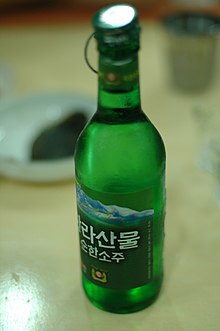
The national drink of South Korea is soju (소주), a vodka-like alcoholic beverage (usually around 20% alcohol by volume). It's cheaper than any other drink — a 350 mL bottle can cost slightly over ₩3,000 at bars (as little as ₩1,100 at convenience stores!) — and also strong. It's usually made by fermenting starch from rice, barley, corn, potato, sweet potato, etc., to produce pure alcohol which is then diluted with water and other flavors. The manufacturing process leaves in a lot of extraneous chemicals, so be prepared for a four-alarm hangover in the morning, even after drinking a comparatively small amount.
Traditionally, soju was made by distilling rice wine and aging it, which created a smooth spirit of about 40%. This type of traditional soju can still be found, for example Andong Soju (안동 소주) — named after the town of Andong — and munbaeju (문배주). These can be expensive, but prices (and quality) vary considerably.
Historically, there were numerous brewers throughout the country until late Chosun dynasty and before Japanese colonization. However, by the Japanese colonization and the oppressive and economy-obsessed government in the 1960-'70s, using rice for making wine or spirits was strictly prohibited. This eliminated most of the traditional brewers in the country, and Korea was left with a few large distilleries (Jinro 진로, Gyeongwol 경월, Bohae 보해, Bobae 보배, Sunyang 선양, etc.) that basically made "chemical soju". Brewery distribution and markets were regionalized, and until the 1990s it was difficult to find a Jinro soju anywhere else than Seoul (you would have to pay premium even if you found one), Gyeongwol soju outside Gangwon, or Sunyang outside Chungcheong.
Also, there are soju cocktails such as "socol" (soju + Coke), ppyong-gari (soju + Pocari Sweat, a Japanese isotonic drink like flavorless Gatorade), so-maek (soju + beer), etc., all aimed at getting you drunk quicker and cheaper.
Rice wine [ edit ]
Traditional unfiltered rice wines in Korea are known as takju (탁주), literally "cloudy alcohol". In the most basic and traditional form, these are made by fermenting rice with nuruk (누룩), a mix of fungi and yeast that breaks down starch in rice into sugar and then alcohol over 3–5 days. Then this is strained, usually diluted to 4–6% and imbibed. However, as with the case of traditional soju, unless explicitly stated on the bottle most takju are made from wheat flour and other cheaper grains. Makgeolli (막걸리) is the simplest takju , fermented once and then strained, while in dongdongju (동동주) more rice is added once or more during the fermentation to boost the alcohol content and the flavor. Typically you can find a couple of rice grains floating in dongdongju as a result.
Yakju (약주) or cheongju (청주) is filtered rice wine, similar to the Japanese rice wine sake . The fermentation of rice is sustained for about 2 weeks or longer, strained, and then is kept still to have the suspended particles settle out. The end result is the clear wine on top, with about 12–15% alcohol. Various recipes exist, which involve a variety of ingredients and when and how to add them accordingly. Popular brands include Baekseju (백세주) and Dugyeonju (두견주).
Those with an interest in the wine production process and its history will want to visit the Traditional Korean Wine Museum in Jeonju .
Ginseng wine [ edit ]
One expensive but tasty type of alcohol you can find in Korea is Korean ginseng wine (인삼주 insamju ), which is believed to have medicinal properties and is particularly popular among the elderly. It is made by fermenting Korean ginseng, just as the name implies.
Beer [ edit ]
Western-style lagers are also quite popular in Korea, with the three big brands being Cass , Hite (pronounced like "height") and OB , all of which are rather light and watery and cost around ₩1,500 per bottle at a supermarket. Hofs serve pints of beer in the ₩2,000-5,000 range, although imported beers can be much more expensive. You are expected to order food as well, and may even get served grilled squid or similar Korean pub grub without ordering, for a charge of ₩10,000 or so.
Tea [ edit ]

Like their Asian neighbors, Koreans drink a lot of tea (차 cha ), most of it green tea (녹차 nokcha ). However, the label cha is applied to a number of other tealike drinks as well:
- boricha (보리차), roasted barley tea, often served cold in summer, water substitute for many household
- insamcha (인삼차), ginseng tea
- oksusucha (옥수수차), roasted corn tea
- yujacha (유자차), yuzu jam with hot water, sweet and fragrant
- yulmucha (율무차), a thick white drink made from a barley-like plant called Job's tears
Like Chinese and Japanese teas, Korean teas are always drunk neat, without the addition of milk or sugar. However, Western-style milk tea is available at Western restaurants and the usual American fast-food chains.
Coffee [ edit ]
Coffee (커피 keopi ) is an obsession in South Korea and widely available.
Coffee shops can be seen virtually everywhere in the country. There are a large number of chains such as Cafe Bene and Angel in Us as well as Starbucks, where a cup of milk-based coffee costs around ₩5,000. Do note that you are mostly paying for the cafe atmosphere rather than the quality of the coffee. It is worth to hunt out smaller independent coffee shops that take great pride in their coffee and charge a more reasonable price. Even in small countryside towns, the ubiquitous bread shops Tous le Jours and Paris Baguette will give you a decent latte for around ₩2,000. Aside from coffee, these cafes will usually sell food such as sandwiches, toasties, paninis and quesadillas as well as sweet options such as bingsu (Korean shaved ice), Korean-style toast, pastries and a wide variety of cakes, some even vegan. They tend to have much longer opening hours than their western counterparts and can be found open late into the night. 24-hour establishments can be found in the larger cities.
Younger South Koreans, in particular, drink a lot of iced Americano ('아이스 아메리카노' or commonly just '아아'/'Ah-Ah'), even during the coldest winter days! It's usually two shots of espresso with water and ice.
Streetside vending machines that will pour you a cupful of instant coffee mix for as little as ₩300, usually sweet and milky, but there is often a plain option. 24-hour self-service cafes (with no staff) with regular coffees and lattes are becoming common as well.
Other drinks [ edit ]
Some other traditional drinks worth keeping an eye out for:
- Sikhye (식혜), a very sweet, grainy rice drink served cold
- Sujeonggwa (수정과), a sweet, cinnamon-y drink made from persimmons served cold
Sleep [ edit ]
There’s plenty of accommodation in all price brackets in South Korea. Prices in Seoul are typically about twice that of anywhere else in the country.
Some higher-end hotels offer a choice of Western-style and Korean-style rooms. The main feature of Korean rooms is an elaborate floor-heating system known as ondol (온돌), where hot steam (or, these days, water or electricity) heats stone slabs under a layer of clay and oiled paper. There are no beds; instead, mattresses are laid directly on the floor. Other furniture is typically limited to some low tables (you're also expected to sit on the floor) and maybe a TV.
Motels [ edit ]
Some of the cheapest accommodation in South Korea are in what are called motels (모텔 motel ) or yeogwan (여관), but a more accurate name would be sex hotels . Since Koreans often live with parents and extended family, motels are generally very cheap hotels targeted at young couples aiming to spend personal time together, complete with plastic beds, occasionally vibrating, with strategically placed mirrors on the ceiling, as well as a VCR and a variety of appropriate videos. However for the budget traveller, they can simply be inexpensive lodging, with rates as low as ₩25,000/night.
The easiest way to find a motel is to just look for the symbol "♨" and gaudy architecture, particularly near stations or highway exits. They're harder to find online, as they rarely if ever show up in English-language booking sites.
In some motels picking your room is very easy, as there will be room numbers, lit pictures and prices on the wall. The lower price is for a "rest" (휴식 hyusik ) of 2–4 hours, while the higher price is the overnight rate. Press the button for the one you like, which will go dark, and proceed to check-in. You'll usually be expected to pay in advance, often to just a pair of hands behind a frosted glass window. English is rarely spoken, but the only word you need to know is sukbak (숙박, "staying"). You may or may not receive a key, but even if you don't, the staff can usually let you in and out on request — just don't lose your receipt!
Hotels [ edit ]
Full-service hotels can be found in all larger towns in Korea. Cheaper hotels blend into motels with rooms from ₩40,000, while three and four-star hotels are ₩100,000-200,000, and five-star luxury hotels can easily top ₩300,000. Outside peak season you can often get steep discounts from the rack rates, so be sure to ask when reserving.
Hanok [ edit ]
Hanok (한옥) are traditional Korean houses . Once considered to be old-fashioned and an impediment to modernization, many of these houses dating back to the Joseon dynasty are being renovated and opened to paying guests, operating similar to B&Bs or Japanese ryokan or minshuku . Amenities range from very basic backpacker-style to over-the-top luxury, with prices to match. Higher-end establishments typically provide the option of having a traditional Korean dinner, as well as a choice of either Western or traditional Korean-style breakfast. Guests would usually sleep on mattresses on the floor. Hanok accommodations can typically be found in old towns such as Bukchon in Seoul , as well as historical towns and cities such as Hahoe and Gyeongju .
Hostels and guesthouses [ edit ]
While not as common in South Korea as in other parts of Asia or the world, hostels and guesthouses can be found. Major cities, such as Seoul, will have a few dozen, while smaller cities may have a handful. Prices can vary widely, even within one hostel. In Seoul, mixed dorms average ₩15,000-25,000 per person; private rooms with a shared toilet and shower average ₩20,000-30,000 per person; and private ensuite rooms average ₩25,000-40,000 per person. Many hostels will have a common room with free TV, games, computers, and internet; some will have a public full kitchen and other amenities.
Minbak [ edit ]
In rural areas in and near national parks, you can find a minbak (민박). Most of these are just a room or two in someone's home — others are quite fancy and may be similar to motels/ yeogwan or hotels. Generally, they have ondol rooms with maybe a TV and that's about it. You don't usually get your own bathroom in your room, although some of the fancier ones do have an en suite. Minbak usually run around ₩20,000 off-season, though the price may go up quite a bit during high season.
Homestay [ edit ]
Very similar in concept to a minbak, these aren't limited to just rural areas or near national parks. Since the World Cup in 2002, many families around the country have opened their doors and hearts to foreigners looking for a great place to sleep and a breakfast included in the price. These can run between ₩30,000 and ₩35,000 per night.
Pension [ edit ]
A fancier and costly version of rural minbak. Most of them are European-style detached bungalows, equipped with private shower/bath, TV, air conditioner, private kitchen and camping grills. Pensions usually run around ₩60,000-150,000 off-season and over ₩200,000 peak season depending on the size of the house. Pensions near Seoul (Gyeonggi, Incheon) usually costs twice or more the price.
Jjimjilbang [ edit ]
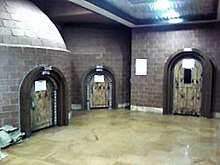
For the budget traveller, public bath houses known as jjimjilbang (찜질방) can offer a great way to sleep, besides a relaxing bath and sauna. (Some Korean spas don't offer overnight stay, like the "Spa Land Centum City" in Busan, and some can be limited in time, like the "Dragon Hill Spa" in Seoul, but they are exceptions.) Entrance costs around ₩5,000-12,000, and includes a robe or T-shirts/shorts (for mixed facilities and sleeping hall) to wear. However, when you leave, you have to take everything with you and pay to get back in.
The facilities can be expansive, including showers, public baths, restaurants, computer/video game rooms, a room with DVD movies, and a warm hall to sleep, mostly with mattresses and sometimes soft head rests available. These places are generally used by families or couples during the weekend, as well as Korean working men from the countryside on weekday evenings, but travellers are welcome. A jjimjilbang is no more awkward than any Western public bath — so go ahead.
Usually two lockers are provided, one for the shoes (at the entrance) and one for your clothes and everything else (near the bath entrance). A very large backpack may not fit, although you can usually leave it at reception.
Temples [ edit ]
South Korea offers many temple stays in all parts of the country. The basic idea is that you stay for one or more days living with the monks and participating in some of their rituals.
Jogye (조계사), Korea's largest Buddhist sect, runs a popular temple stay program where visitors get to spend 24 hours living at a Buddhist temple. Speaking Korean helps but is not necessary at some temples, but you will be expected to work at the temple and get up at 03:00 or 04:00 to participate in morning prayer with the monks, and all food served will be vegetarian. In exchange for two to three meals and a basic bed for the night, a donation of ₩50,000-80,000 is expected. Reservations are necessary and can be made at the Temple Stay site or via Korea Travel Phone (+82-2-1330).
Learn [ edit ]
Education is taken very seriously in South Korea, often to the point of obsession, and the country is home to several world class universities. For a country that has limited natural resources, Koreans believe that the only way to become competitive in a global world is to absorb knowledge. This militant drive for educational excellence and success is exactly why South Korea became a developed country in less than a century.
While this may sound impressive, the South Korean educational system does have its drawbacks. The brutally competitive nature of the system means that Koreans are faced with a lot of pressure from their parents and peers to succeed academically, and the system is often blamed for the country's high suicide rate and high underemployment rate.
The most prestigious general universities, collectively known as SKY, are Seoul National University (SNU) , Yonsei University and Korea University , the former of which is widely regarded as the undisputed number one university in South Korea. Korea Advanced Institute of Science and Technology (KAIST) and Pohang University of Science and Technology (POSTECH) are regarded as the top universities specializing in science and engineering. Admission to these universities are fiercely competitive for South Koreans, but considerably easier for foreigners if your Korean language ability is up to scratch.
Others [ edit ]

- Taekwondo [dead link] (태권도 taegwondo , literally "the way of kicking and punching") — The quintessential Korean martial art that is also an Olympic sport, and you can study at any of the numerous schools all over the country.
- Kimchi — Many tourist packages nowadays include learning how to make a Korean staple dish kimchi.
- Changgeuk (창극) or pansori (판소리) — If you like music, this will be good for you. It's a unique traditional Korean form of singing. If you want to learn about pansori through film, Seopyeonje (서편제) (1993) would be an excellent choice.
- Korean language — Seoul National University, Korea University, Sogang University, and Yonsei University (in Seoul ) provide Korean language programs. You can meet people from all over the world while studying Korean.
- Korean traditional dance — You can go to a dance studio and learn Korean traditional dance. You will wear hanbok , Korean traditional clothes.
- Baduk (바둑) — Korean name for the ancient Chinese board game called Go in English and Japanese. Many Koreans play the game, and among them are some of the world's finest players. There are professional tournaments and even schools that specialize in baduk.
- Janggi (장기) — Also known as Korean chess, a board game similar to Chinese chess, with which it shares its origins, though the rules of the two games have diverged significantly.
Work [ edit ]
Working in Korea can be a great way to experience the country. For English teachers the hours and pay are reasonable, however for other professions bear in mind that South Korea has some of the longest working hours globally , and frequent obligatory after-work drinking can be demanding. In addition, Korea isn't yet really set up to make entering the job market easy for foreigners. Reading and speaking Korean will definitely open up many more opportunities for you.
Foreigners must obtain an Employment Visa in order to legally work in South Korea, and will usually require a company based in South Korea to sponsor your application. For prospective teachers the school will almost always arrange this on your behalf. Citizens of Australia, New Zealand, Canada and Japan may apply for a one year Working Holiday Visa which allows for short term employment whilst on holiday in Korea.
The work culture is extremely hierarchical and formal . You are expected to wear suits (for men) or business dresses (for women) and be unquestioningly loyal to your superior(s) — ask them for permission before you do anything, obey orders from them without hesitation, arrive before they come to work, leave only after they have left, and work on weekends when they ask you to. Korean authority figures take any attempts to challenge their authority extremely seriously and will not hesitate to put you in your place if you say or do anything that makes them feel challenged.
Korean companies prioritise group efforts (collaboration and cohesiveness) over individual efforts. If you are managing a team of Korean workers, know that you are expected to demonstrate and exhibit good morals and good leadership qualities; they expect you to be a guide to them.
Korean workers are also expected to go out for food and drinks with their colleagues after work multiple times a week, which means getting home only when it is really late.
Teaching [ edit ]
Work as an English teacher is the most common type of work available to foreigners from English speaking countries, with the requirements of being able to speak English and a minimum level of education being a Bachelor's degree. Schools prefer native English speakers and many prefer North American accents. In most instances, native English speakers from the United States, Canada, Australia, New Zealand, South Africa, Ireland, and the United Kingdom are the only applicants that are usually considered.
The main employer of native English speaking teachers are private academies called hagwon (학원). Many parents enroll their children in order to catch up or overtake their peers, and therefore scheduled classes are often in the evenings and Saturdays. People interested in these teaching positions often find them via professional recruiters. There are pros and cons to teaching ESL in the hagwon system. On the plus side the money can be quite good. As of 2016, the average monthly salary is approximately ₩2,000,000 and basic housing is usually provided. It's often possible to live comfortably on half of one's salary and to save the rest.
On the negative side, hagwon are privately run and strictly for profit, and may only operate for a few years. As such it is important to research and evaluate each prospective employer before accepting an offer, since there are plenty of horror stories of unscrupulous academy owners and incompetent directors. Although you will have full employment rights in South Korea, there is practically very little you can do when an issue or dispute arises. The majority of English teachers have a good experience through the hagwon system.
University employment is also possible. Those who have a graduate-level degree, preferably in TESOL (Teaching English as a Second or Other Language), may find professional opportunities at the post secondary level preferable to teaching in private academies.
Some of the best positions are in the public sector, although in Seoul and Busan, schools have been phasing out foreign English teachers and replacing them with English-speaking South Koreans. Still, year-long public school positions are available through the government-funded EPIK Program in most provinces and the rapidly contracting GEPIK Program in Gyeonggi, with a few also handled by recruiter companies. Alternately, the TALK Program runs 6-month rural public school positions for non-graduates.
For more information about teaching English in Korea through the private-sector, visit Eslcafe , Worknplay [dead link] , Eslstarter and Englishspectrum [dead link] . For the public-sector, see the aforementioned EPIK program.
Daejeon full-time public elementary school positions stand apart from most in the country in that they consist of multiple part-time support positions at different schools. Most public school and university positions start at the beginning of March or September, however these are the more desirable jobs and must be applied for months before the start date.
South Korean Immigration is constantly changing the visa regulations for E-2 visa holders, so keep abreast of updates.
IT [ edit ]
South Korea is often promoted as the world's most wired country, and as such has a massive IT infrastructure. There is plenty of IT work if you can speak Korean , although local rates are much lower than in western countries.
Engineering [ edit ]
South Korea has a lot of opportunities for engineers, and often doesn't have a requirement for Korean language. Port cities such as Busan , Ulsan and Geoje have a demand for marine engineers.
Stay safe [ edit ]
Crime [ edit ].
South Korea is a very safe country, with reported crime rates much lower than in the U.S. and most European Union countries. Crime rates are comparable to other safe places such as Japan , Singapore and Hong Kong , and it is generally safe for women to walk around the streets alone at night. Violent crime is rare toward locals and tourists alike. For the most part, the only foreigners who encounter trouble in South Korea are drunken ones that provoke fights at bars or clubs.
If you do happen to encounter any trouble, police stations are located in every district, usually in walking distance from subway entrances and bus stops. While most police officers won't understand English, they do have interpreters on-call that can assist you.
Especially in Korea, there is a ritual of not touching other people's things, so if you go to a cafe or on the street, you may see people leaving their expensive laptops and cell phone bags on the seats to use the restroom.
Be careful when picking up lost items dropped on the street, since the legal system here can regard that as theft in itself.
Racism [ edit ]
South Korea is one of the most ethnically homogeneous countries in the world, and for many South Koreans, this is a point of pride. Racism in South Korea is systemic and gets featured in the news from time to time. There is no anti-discrimination legislation whatsoever, and non-Koreans and half-Koreans are often subjected to abuse and discrimination. The rise in immigration in recent years has increased visibility of racism. A small number of businesses, typically bars, nightclubs and saunas, have been known to ban foreigners (although in areas where American soldiers are based, this is often just to avoid the possibility of fights). Negativity aside, South Korea is gradually changing.
In South Korea, lighter skin has historically been associated with beauty, purity, and higher social status. This is precisely the reason why fair-skinned people will receive better treatment — for instance, easy access to employment and teaching opportunities from Koreans, whereas darker skinned people may be treated with a degree of derision and suspicion.
Most visitors to South Korea are extremely unlikely to encounter any problems at all. If you do experience racial abuse then you can call on the police to help, although realistically if no other offense has been committed then they will at most just try and reason with the abuser.
People from North Korea also experience discrimination in society, partly out of suspicion (North Korea has sent assassins and spies disguised as refugees) and partly out of the difficulty to integrate themselves into a vastly different society. Ethnic Koreans from China are also often regarded poorly due to being associated with low economic status and crime. People from Southeast Asia are also discriminated against since most immigrant workers in low-paid jobs come from that region.
If you feel strongly about having been racially discriminated against, then you can register a complaint with the National Human Rights Commission of Korea . This is an official government agency, although with limited enforcement powers.
Traffic [ edit ]
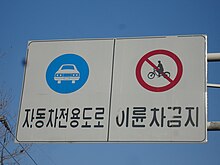
With one of the highest rates of traffic deaths, South Korean motorists will speed through pedestrian crossings, jump red lights and come within a hair-width distance to pedestrians and other cars alike. Even when the light turns red, drivers will not stop. Motorcyclists are particularly reckless weaving in and out on crowded sidewalks. It is up to you to avoid them.
There is a lot of discussion about the reason for this, although it basically comes down to Koreans regarding traffic laws as guidelines that are nice ideas rather than rules to be obeyed.
Pedestrian crosswalks stay green for a very short period of time. When the walk signal is flashing and you are still at the curb, do not cross . Instead, you should wait and be ready for the light to turn green. The moment it turns green, wait for about 3 to 5 seconds and see if other pedestrians start to cross, and if all the traffic has indeed stopped, then walk briskly to cross safely. It is safer to take underground passageways at busy intersections. Most mopeds prefer to weave through pedestrians rather than wait with the rest of the traffic.
There are plenty of marked pedestrian crossings in Korea, and they are essentially ignored by all drivers. As a foreigner you can use them by stepping onto the crossing and directly staring down any approaching cars and they will usually yield. It is important for you to stay alert while crossing the roads. Taxis, buses, freight trucks, and delivery scooters are more likely to ignore traffic rules, since many of them are pressured to ignore rules by harsh timetables or their customers.
Illegal taxis [ edit ]
Illegal taxis are a problem and run even from the airport. Each Korean city has a different taxi scheme with a specific car color, so check out your destination city's taxi scheme before you arrive. At the airport, ignore anyone asking if you want a taxi at arrivals and head out to the official taxi rank.
Civil unrest [ edit ]
In the heart of the political center of Seoul , near Gwanghwamun and City Hall, you may witness political activists of one sort or another in the city center and demonstrations can grow to tens of thousands. You'll have to use discretion as violence during political demonstrations can happen, often with water cannons and tear gas, and also large crowds may pose safety issues. Fighting is always between the demonstrators and police, and foreigners are not targeted. Also, South Korean legislation prohibits non-South Koreans from engaging in political activities.
Local laws [ edit ]
South Korea has a draconian National Security Act (국가보안법, Gukga Boanbeop ) that restricts any unauthorized contact with North Korea and its citizens. North Korean slogans, symbols, stamps, propaganda, websites, and literature are strictly prohibited in the country. Foreigners are not exempted from this law — a Chinese student who expressed pro-North Korean views on the Internet was prosecuted and deported from South Korea in 2014.
Gambling [ edit ]
Gambling is illegal for South Korean citizens, although a limited number of casinos are available for foreigners only in Seoul , Busan and Jeju island. You will need to bring your passport to enter these establishments.
Wildlife [ edit ]
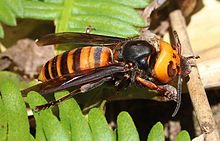
The Asian giant hornet (장수말벌, jangsu malbeol ) or "commander bee" is usually seen around summer time; it is about 40 mm (1.6 in) long and can sting repeatedly and painfully. A hornet defending its nest or feeding spot will make a clicking sound to warn away intruders; if you encounter one, retreat. If you are stung, receive prompt medical attention, as prolonged exposure to the venom could cause permanent injury or even death.
There are very few other animals that can be dangerous in Korea. The Siberian tiger is sadly no longer found on the Korean Peninsula. Large wild boars can sometimes be found in forested areas and can be very dangerous if they attack. If you see a boar with piglets then keep well away since the mother will not hesitate to protect them.
Large sharks including the great white and hammerhead are being sighted more frequently off the coast of South Korea. To date there has never been a recorded attack on swimmers, although a few abalone divers have been killed in the past 20 years. The most popular beaches are closely monitored, and this is unlikely to be a real risk to you.
Stray cats are still common, and it is advisable to avoid them - they can scratch and bite.
Natural hazards [ edit ]
South Korea is considerably less prone to natural disasters than its neighbors. Earthquakes are rare occurrences, though minor ones occasionally occur in the southwest of the country. Tsunamis are a recognized hazard in coastal areas, although Japan's strategic position prevents most tsunamis from ever reaching Korea. While typhoons do not occur as often as in Japan , Taiwan or the Philippines , they are nevertheless an almost yearly occurrence, and are occasionally known to be deadly and cause major property damage.
Homosexuality [ edit ]
Although same-sex relationships are not recognized by the government, there are no laws against homosexuality in South Korea. Gay clubs and bars exist in the larger cities, though openly displaying your sexual orientation in public is still likely to be met with disapproval. South Korea has a large number of Evangelical Christians who generally strongly disapprove of homosexuality. Nevertheless, verbal and physical attacks against gay people are rare.
Conversely, platonic displays of physical affection between same-sex friends are very common, particularly when alcohol has been consumed, and holding hands with a same-sex romantic partner may be viewed in this light.
Conflict with North Korea [ edit ]
An understandable concern about traveling to South Korea is the possibility of war. However, while war has remained a distinct possibility ever since the end of the Korean war over 60 years ago, the North Koreans appear to have become very skilled at saber-rattling and limited provocations that are never allowed to escalate into out-and-out warfare. This is not to say that miscalculations could not spiral out of control, but simply that the odd missile launch, or loudly publicized border closure does not mean war is nigh.
If a full-scale war did break out between the North and South, it would almost certainly result in many casualties, military and civilian alike. If this were to happen when you are visiting Seoul, it would definitely be life-threatening. There was a great deal of brinkmanship following the appointment of Kim Jong-un as North Korea's leader, and open conflict seemed to become more likely. However, no big conflagration has broken out, and it is safe to say that the possibility of all-out war is very low, though it would be reasonable to weigh the risks when planning to visit South Korea.
There isn't really much you can do to mitigate the risk of military action. Find out the contact details of your embassy and be aware of the current situation when traveling. Most embassies will have an evacuation strategy for their nationals in the case of war. Also be aware that Seoul 's Incheon International Airport is relatively close to the North Korean border, so therefore it may not be advisable to run there looking for a flight out.
Be extra careful when visiting the Korean Demilitarized Zone . Any attempt or pretence to cross the border line into North Korea and risk putting your life, the lives of your tour group members and military personnel on both sides at risk.
Emergency numbers [ edit ]
- Police: 112
- Fire and ambulance services: 119
Emergency-service English interpreters are available 24 hours a day.
Stay healthy [ edit ]
South Korean healthcare is known for its excellence in both research and clinical medicine, and most towns will be able to offer a high quality of healthcare. The sheer number of hospitals and specialized clinics in the country will also offer you a greater amount of choice. Healthcare is subsidized by the government and is relatively cheap compared to most western countries. Expatriate workers who have the required medical insurance card will experience further discounts. South Korea also promotes medical tourism where quality operations can be had for a fraction of the price of many other developed countries.
South Korea is especially known for having a thriving plastic surgery industry, and the vast majority of South Korean celebrities have undergone cosmetic surgery to one degree or another. It is also common for parents who can afford it to pay for their daughters to go under the knife to achieve the "perfect look". The downside is that seeing the top plastic surgeons is usually very expensive.
Most South Korean doctors can communicate well in English, being the most highly educated in the country. (Indeed, many have achieved their medical qualifications in the United States.) However, you may find them a little difficult to understand due to their Korean accent, so do ask them to slow down and go through things with you clearly. On the other hand, nurses will very rarely speak much, if any, English.
Traditional Chinese medicine , along with traditional Korean medicine (한의학 hanuihak or 향약 hyangyak ), is highly regarded in South Korea and involves many traditional methods including acupuncture, heating and herbal medicine. Traditional Chinese medicine has deep roots and practitioners must undergo strict government certification in order to practice. Typically Koreans use Oriental medicine for chronic ailments such as back pain and Western medicine for sudden injuries. Due to the holistic nature of Oriental medicine (i.e. treating the whole body rather than a specific ailment) it is very hard to measure its effectiveness, but nevertheless it is a widely trusted part of the Korean medical system. Western medicine, however, does not generally recognize the effectiveness of the procedures in Oriental medicine.

Pharmacies are available everywhere, and are indicated by one very large word 약 ( yak ). As hospitals in South Korea are not allowed to dispense take-home prescriptions there will almost always be a separate pharmacy available there.
Although there are no official vaccinations that are required or recommended for visitors, Hepatitis A is known throughout the country and attacks the liver after the host ingests contaminated food or water. Once infected, time is the only cure. The Center for Disease Control [dead link] designates the prevalence of infection in South Korea to be intermediate . A vaccine is available for Hepatitis A, so you might want to consider getting vaccinated before you travel to be safe.
Tap water in South Korea is perfectly safe to drink, although you may want to follow the local habits of boiling and filtering if only to get rid of the chlorine smell. Bottled mineral water from Jeju Island is also very popular. Fresh mountain spring water is available directly in wells around the country (especially Buddhist monasteries), and although these are generally safe, the water has not been treated in any way and could be unsafe.
Spring water Koreans are especially fond of drinking mountain spring water when hiking through mountains or at monasteries, although this water is completely untreated. If you see plastic (or metal) ladles provided that are obviously in use, then the water is probably safe. Some places in Korea have communal wells set up that supply fresh water, and in theory the local government will test from time to time in order to certify the safety. The certification (or warning) will be in Korean, so you may not know if a particular water source is safe.
Cope [ edit ]
Media [ edit ].
South Korea has several English language media sources for daily news and other information, such as the Yonhap News Agency .
Daily newspapers in English include the Hankyoreh , The Korea Times , The Korea Herald and The Chosun Ilbo .
For television, there is an English-language channel called Arirang TV available throughout the world on some cable subscriptions. AFN Korea is available to U.S. military community or via cable.
There are some English-language radio stations in South Korea such as TBS e-FM (101.3 FM) and AFN channel (1530 AM and 102.7 FM in Seoul).
Respect [ edit ]
Coming from a land of strict Confucian hierarchy and etiquette, Koreans are regarded as reserved and well-mannered. As a visitor, you will not be expected to know every nuance, but making an effort will certainly be appreciated. The further you are away from metropolitan areas the more conservative the people are. Nevertheless, most South Koreans are welcoming towards foreign tourists, and as long as you show a modicum of respect towards their culture, will do their best to make your visit a pleasant one. American visitors can expect a particularly warm welcome, as most South Koreans admire American culture.
Social etiquette and breaches [ edit ]
- Much like their neighbours, Koreans place a solid emphasis on "saving face", thus, Koreans are generally indirect communicators . That being said, they tend to be a bit more straightforward and assertive than people in other East Asian countries. A "yes" doesn't mean "yes"; you have to read between the lines to figure out what someone means.
- Gestures and facial expressions are not commonly used when conversing, giving some the impression that Koreans are "stern".
- Personal appearance is very important. Korean women and men generally pay very close attention to their physical appearance. To get the most amount of respect, dress smartly and conservatively and groom yourself well.
- Koreans bow to each other to show their respect when they meet. They may also shake hands. (When shaking hands, particularly with someone older, support your right arm with your left hand.) However, with people you know well, a quick nod of the head and a simple " Annyeonghaseyo " (안녕하세요, "Hello") should suffice.
- It is very important to remove your shoes when entering many places in Korea. You are always expected to take off your shoes in someone's home. It is also required in many good restaurants (especially family-run ones), smaller hospitals, medical clinics and dentists. Leave your shoes by the front door; indoor slippers may be provided.
- It's common for Koreans to ask you personal questions. If you feel a question is too personal, answer indirectly.
- Koreans respect their elders and authority figures. If anyone in a position of authority (policeman, your superiors at work, a teacher) requests you to do something, you are expected to respect them and do it. In public transportation, you are always expected to give up your seat to someone older than you. Remember to compose yourself and behave maturely around those much older than you; elders and authority figures generally don't take kindly to being spoken to or addressed inappropriately.
- When picking something up or taking something from somebody older, always use two hands. If you have to use one hand, you can support your right arm with your left hand.
- South Korean households often have strict rules about recycling : for example, one bin may be for paper only and another in the kitchen may be for food/drink containers. Each district in Korea has its own unique recycling scheme. Garbage bags must be purchased from a supermarket and must be of the type designated for your local community.
- Never pour your drink when dining with Koreans, but always take the initiative to pour for others. When dining with Koreans, the oldest or most senior should always eat first.
- It is common to hear people talking loudly in restaurants as a sign of being happy and enjoying the food.
- Do not be surprised or taken aback if your Korean counterpart subtly denies praise or compliments coming from you. Koreans believe that denying a compliment shows humility and modesty. If you compliment a Korean, expect them to say " anieyo " (아니에요, "No"), " geureon malsseum maseyo " (그런 말씀 마세요, "Please don't say that"), or a variation thereof. Don't say "thank you" to a compliment.
Sensitive issues [ edit ]
Pride in the nation forms one of the key pillars of Korean culture. Saying what you like about the country might get you on someone's good side, while criticism of the country by a foreigner is likely to elicit a hostile response from Koreans.
Koreans are neither Chinese nor Japanese; they are a separate people with a unique culture, and will be deeply offended if you confuse them for anything else.
Avoid talking about North Korea . Relations between the two Koreas are incredibly tense: praising or talking positively about North Korea will engender strong reactions from people. On the other hand, do not criticize North Korea either, as its people are still regarded as fellow Koreans, and you are a foreigner.
There is significant ongoing friction with Japan because of the country's wars with and occupation by Japan, especially with the status of comfort women.
Cultural and historiographical disputes with China can be a sensitive issue, and South Koreans often accuse China of appropriating Korean history and culture, such as cuisine and clothes. This is further complicated by the fact that China today has territory that was part of historical Korean kingdoms , and a large ethnic Korean minority . Protests about these are generally less vocal than contemporary issues with Japan however.
Business etiquette [ edit ]
Business cards (명함 myeongham ) in particular are treated very respectfully and formally. How you treat someone's business card is seen as representing how you will treat the person. Make sure to pack more than you'll need, as not having a business card to present is a serious faux pas. There's a lot of nuanced etiquette, but here are some basics:
- When presenting a business card, orient it so it's readable by the person you're giving it to, and use both hands to present or receive one. Juniors give their cards to seniors first; people of equal rank can exchange simultaneously using your right hand to give yours and left hand to receive theirs. Take the time to read the card and confirm their name and job title. (Korean business cards are often bilingual, sometimes on opposite sides of the card.)
- You can ask permission to write notes on the back of a card if you need to. It's disrespectful to fold a card or place it in your back pocket (where you'll sit on it!). Instead, you should arrange cards on the table (in order of seniority) to help you remember who's who. When it's time to leave, then you can pack the cards in a nice case to keep them pristine; if you don't have one, hold on to them until you're out of sight before pocketing them.
National issues [ edit ]
Given the long history of unwanted intervention in Korea by foreign nations, Koreans are understandably rather sensitive about political discussions . You should avoid discussing the following topics since they are never going to achieve anything but getting you onto someone's bad side:
- Japan 's annexation and brutal colonization of Korea until 1945. In particular, do not display the Rising Sun Flag, such as on your t-shirt or badge on your backpack.
- Japan's perceived lack of sufficient recognition and apology over the sexual enslavement of Korean "comfort women" during World War II
- Japan's recurring territorial claims over the South Korean island of Dokdo
- The Korean war and anything to do with North Korea
- Bad behavior of individual members of the United States military stationed in South Korea
- Any deference of the South Korean military towards the United States military
- Any international sporting controversies where South Korean athletes are involved
- Do not refer to the sea east of South Korea as the "Sea of Japan" (even though this is by far the most accepted name internationally). Always refer to it as the "East Sea" (동해 Donghae ).
- Domestic politics — as elsewhere in the world presently, Korean politics is bitterly divided between left and right. Many of the ideological issues are however quite different from those you may be familiar with in your home country, and Koreans generally do not take kindly to foreigners commenting about their domestic politics, even if your views happen to align with theirs.
Should your hosts bring any such topics up, it is best to just listen and avoid any debates.
Religion [ edit ]
Religion in South Korea has changed a great deal over time, with today's main religions of Buddhism and Christianity both having been oppressed over the past centuries. Today just under half of Koreans state that they have no religious affiliation. There are practically no tensions at all between the different groups, with religion being usually regarded as a personal choice.
Buddhism was historically the main religion in Korea (albeit often suppressed in favor of Confucianism), and Buddhist temples are major tourist attractions throughout the country. As in India , China , and other countries there are Buddhist swastikas representing good luck on display at religious buildings. You will notice they are actually drawn in reverse to the one used in Nazi Germany, and they in no way represent antisemitism. When visiting Buddhist temples you should be respectful by not making too much noise, eating or drinking.
South Korea has a high proportion of Christians (18% of the population are Protestant and 11% are Roman Catholic) and dozens of churches can be found in absolutely every major city. Protestants in South Korea tend to be strongly conservative and frequently highly evangelical, sending a large number of missionaries abroad (rivaling the United States in this regard). Catholics often combine elements of Buddhism, Confucianism and Korean shamanism into their faith. South Korea is also home to a myriad of new religions based on Christianity (such as the Unification Church), which may be deemed as controversial sects or cults or as apostasy or a heresy by others. It is common for both strangers and acquaintances to ask you to come to their church, although offense will not usually be taken if you decline.
Korean Shamanism , also known as Muism, is the indigenous religion of the Korean people since ancient times. Although it is professed by less than 1% of South Koreans today, its practices and beliefs are known to most and to some extent still practiced by many people, having been incorporated into both Christian and Buddhist rituals.
Confucianism was often promoted as the state ideology during Korea's history, and although it is not as strictly adhered to as in the past, the majority of Koreans will be familiar with its teachings and practices, and even today government officials are still required to sit Confucian examinations.
Smoking [ edit ]
While smoking in South Korea is not quite as popular as in Japan or China, many Korean men and an increasing number of South Korean women smoke, and it's fairly cheap compared to much of Europe and America. A pack of twenty costs around ₩5,000 and cigarettes can be bought from all convenience stores. Koreans favor mild cigarettes (around 6 mg tar) so Korean-made cigarettes may taste bland and flavorless compared to those from America or Europe, and even the South Korean-produced Western cigarettes are much lighter than the originals (e.g., full-strength Marlboro Reds in South Korea have only 8 mg tar, the same as Marlboro Lights in the U.S.). If you prefer stronger cigarettes, it's wise to bring some duty-free cigarettes with you.
Smoking is forbidden in public buildings, public transport and restaurants. Various establishments will tacitly allow smoking despite the ban, although they will never explicitly tell you that you can smoke, for fear of legal repercussions. Smoking in public is also banned, but this is largely unenforced and designated smoking areas are sparse.
Dedicated smoking rooms can be found around transport hubs and other large buildings.
Female smokers may give a negative impression to some Koreans, as smoking is not considered feminine here.
Connect [ edit ]
By phone [ edit ].
For calls to South Korea, the country code is +82 . International dialing prefixes in South Korea vary by operator.
Mobile phones [ edit ]
South Korea shut down its last 2G network in 2021, so 2G (GSM or CDMA) mobile phones do not work. However, if you have a 3G phone with a 3G SIM card, you can probably roam onto the UMTS/W-CDMA 2100 networks of KT or SK Telecom; check with your home operator before you leave to be sure. 4G LTE has been made available in Korea; again, check with your provider. While 5G is also becoming available, providers have only so far made it available to select postpaid plans or inbound roaming agreements; prepaid users purchasing a local SIM in South Korea will not have access to 5G (as of August 2021).
The country has three service providers: KT [dead link] , SK Telecom and LG U+ [dead link] . They offer prepaid mobile phone services ("pre-paid service" or "PPS"). Incoming calls are free. Phones and prepaid services can be acquired at any retail location found on any street (for Koreans). Second-hand phones are also available at selected stores in Seoul .
Mobile phone coverage is generally excellent, with the exception of some remote mountainous areas. SK Telecom has the best coverage, followed by KT and LG U+.
As a foreigner without Korean residency your choices are:
- Buy a prepaid SIM card from a KT Global or airport provider store
- Rent a phone from an airport (expensive — best for short visits)
- Using roaming on your phone if available from your home provider
- Borrow a phone from a Korean resident
- Have a Korean resident acquire another SIM card and lend it to you
- Use Internet telephony (e.g. Skype) over the many Wi-Fi spots available
You should be able to get a prepaid SIM card at one of the KT Global locations. Due to a loosening of the regulations, there is no longer a requirement that you have been in the country for 3 days already; you can apply for a prepaid SIM immediately upon arrival. The fee for a prepaid SIM card is ₩5,500, and you have to charge at least ₩10,000 at the spot. You must also have a compatible phone. All modern iPhones (3GS and later) should work.
SK Telecom and LG also offer mobile phone rental services, and some handsets also support GSM SIM roaming. They have outlets at the Incheon, Seoul–Gimpo and Busan–Gimhae airports. You can find service centers for KT SHOW and SK Telecom at Jeju airport as well.
You can rent a 4G WiBro device between ₩5,000–10,000 a day for unlimited access, although coverage is not always available outside larger cities and in enclosed areas.
The 1330 Korea Travel Phone service is a very useful service provided by the Korea Tourism organization. It is a 24-hour service and offered in four different languages (Korean, English, Japanese, and Chinese). The operator will answer questions on bus schedules, accommodation, museum hours, etc.
The internationally popular messaging app WhatsApp is not popular in South Korea. Most South Koreans use the local app KaKaoTalk instead.
By Internet [ edit ]

South Korea is the world's most wired country and Internet cafes, known as PC bang (PC방), are ubiquitous through the country. PC shops are becoming more than just a place to go online and play games, they're becoming a place to eat. In fact, you'll be hard-pressed to find a food item you don't want to order, whether it's ramen, snacks, or burgers, as well as rice bowls, grilled pork belly, tonkatsu, or tteokbokki. You usually top up your card with a voucher for a PC through an unmanned terminal, and for food, you order through a message installed on your computer. Nowadays, you can also use Kakao Pay to pay with a QR code.
In addition, smoking is not allowed in PCCs, and you can only smoke in designated smoking rooms.
There is also a lot of free Wi-Fi available throughout South Korea.
Most households in South Korea do have broadband connections with Wi-Fi, and most are encrypted by default.
ollehWiFi is one of the most common Wi-Fi hotspots available and requires payment. The service is fast (30Mbps+) and prices are cheap at ₩1,100/hour or ₩3,300/day. You can buy the service on your device by credit card, or by cash or card in most convenience stores. ollehWiFi is available at most convenient stores, coffee shops, some marts, restaurants, intercity buses, and on all subways and subway stations in the Seoul Metropolitan Area.
The Starbucks Coffee chain also offers Wi-Fi, however you will require a South Korean phone number to use it. Many other coffee shops offer free Wi-Fi with no registration required. ollehWiFi should also be available in all Starbucks stores.
South Korean websites frequently require Windows and Microsoft Internet Explorer, especially those involving online payment. As elsewhere in Asia, a lot of services are becoming available primarily for mobile phones, with Kakao Talk being the most popular.
Especially in South Korea, free public Wi-Fi is available everywhere, thanks to wireless routers installed on public transportation. However, it's best to avoid doing security-critical work on public transportation or public Wi-Fi in public facilities.
By mail [ edit ]
Korea Post is fast, reliable and reasonably priced. Postage for a postcard anywhere in the world is ₩660, while letters and packages start from ₩480. If you want actual traditional stamps, be sure to ask for them, or else you will just get a printed label. On request, fancy "tourist" cancellations ( Gwangwang Tongsin Ilbuin ) for your stamps are available at selected post offices without additional charge. Korea Post accepts Visa and MasterCard for purchases over ₩1,000.
From October 01, 2014, it was changed from an old address unique to a "Road or Street Name"( Road Addresses ) address. " Postal Code Finder by Korea Goverment Finder Site " , Most post offices are open only M-F 09:00-18:00 .
Larger post offices also open Saturday mornings, and central offices in the main cities stay open late and are open on Sundays as well.
- Has custom banner
- Has mapframe
- Has map markers
- Has caution box
- Articles with dead external links
- All destination articles
- Usable countries
- Usable articles
- Country articles
- Has Geo parameter
- Pages with maps
Navigation menu

- Jun 24, 2023
South Korea Travel Guide - All You Need to Know (Seoul, Jeju, Busan)
Welcome to the ultimate South Korea Travel Guide, where we unveil all you need to know for an unforgettable adventure in this captivating country.
From the bustling cityscape of Seoul to the serene landscapes of Jeju and the vibrant coastal charm of Busan, South Korea offers a kaleidoscope of experiences. Whether you're a culture enthusiast, a food lover, or an outdoor adventurer, this diverse nation promises to captivate your heart and senses.
In this comprehensive guide, we'll delve into the must-visit attractions, hidden gems, local delicacies, and practical travel tips to help you navigate through the vibrant cities of Seoul , the picturesque beauty of Jeju Island, and the alluring port city of Busan. So, get ready to embark on a journey that combines tradition with modernity, nature with urban allure, and above all, warm Korean hospitality that will leave a lasting impression on your wanderlust soul. Let's dive into the enchanting world of South Korea!

How to get to South Korea?
The capital of South Korea is Seoul and the closest international airport isn't really in Seoul, but in Incheon. To get to other parts of Seoul, most travellers would enter via Seoul (Incheon International Airport) before taking a connecting or domestic flight out.
From Singapore, various airlines fly to Seoul:
Direct - Singapore Air, Asiana Airlines, Korean Air, Tway Air, Scoot
1 stop via KUL - AirAsia, Malaysian Airlines
1 stop via TPE - Scoot
1 stop via MNL - Cebu Pacific
1 stop via SGN - Vietjet, Vietnam Airlines
1 stop via PEK - Air China
To maximise your time, we do recommend you to take a direct flight there. Also, the price difference between full-fledge carriers and the low-cost carriers aren't that much. For instance, you can get tickets for about $600 on Singapore Air and Asiana Airlines (if you book in advance), while Air Asia and Scoot tickets cost about $400. The $200 difference to while away precious time during transit may not really be worth it. But, as mentioned in our previous post on how you can get cheap tickets on low-cost carriers (Read also: How we spend <900 sgd on a 5D4N trip to Hokkaido ), if the difference comes up to >$200, it is certainly a tempting offer.
P.S. For people living in Singapore, now you can even fly directly to Jeju on Scoot , or catch the plane to Busan with Jeju Air !

How to get around South Korea?
One tricky thing about South Korea is that it is quite difficult to use your google maps to get around. But not to worry, there will be handy maps that you can pick up at the tourism office. In tourist populated areas, there will also be guides where you can ask for directions!
KORAIL Trains
You can either book the train tickets online , on Klook , or purchase them from ticket machines and ticket counters at the train station. However, we do suggest that you book the train tickets in advance for the popular routes. For instance, the famous train to busan (Seoul - Busan), as well as the Yongsan - Gapyeong route to Nami Island .
Both Seoul and Busan have metro stations that connect to the major tourist attractions. We recommend that you get the T-money card for a small discount each time you ride the metro.
Buses are convenient to take you places which the metro does not cover (e.g. Everland, Han River Park, etc).
Taxis in South Korea also isn't very expensive when you need to get to places nearby. For instance, from Gapyeong Station to the Nami Island pier. Do consider this option if you need to get to a place that the metro doesn't.
Alternatively, if you're going to the outskirts of major cities and the suburbs, you can consider chartering a private car or rent a car and go on a self-drive trip. Especially if you're going to cities like Jeju, driving is the best way to get around!

What is the weather like in South Korea?
South Korea enjoys four seasons and how it looks and what activities to do during these different season varies. Travellers looking to South Korea should time their travels according to their needs and preferences.
Spring in South Korea (April to June)
Spring in South Korea is the best time for those looking to see the cherry blossoms. Everywhere you go, you'll find beautiful pink blossoms in its vast open spaces. This is one of the most popular season and travellers should consider the crowds. Temperatures range from 11 degree celsius in April to a comfortable 21 degree celsius in June.
Summer in South Korea (July to August)
Summer in South Korea is warm but not scorching like those in Spain, Portugal or Turkey. Yet, this season is often shunned by many as the monsoon season also falls during this period of time. But if you are a sunshine lover, then grab your sunscreen from one of the many Olive Young stores and enjoy South Korea!
Autumn in South Korea (September to November)
We believe that this season is the best season to visit South Korea. Aside from the beautiful fall colours that paint the city, it also has much fewer visitors. If cherry blossoms isn't on your agenda, head to South Korea during Autumn . You will experience many days of sunshine.
We visited in the tail end of Autumn and we must say that we are thoroughly impressed with the fall colours and the crowds during this time of the year. Though it got quite chilly towards the end of our trip, a good jacket goes a long way!
Winter in South Korea (December to March)
Many travellers in the tropical Southeast Asian countries still look to South Korea as a winter destination. Especially with the korean dramas and variety shows that is now popular in Vietnam and Indonesia, you should still expect some crowds during this period. Winter in South Korea can also get really cold. Even though its lowest temperature is -4 degree celsius, the strong winds would make it feel as though it is -10 degree celsius! Do pack more layers during this season and get heat packs to survive the cold!

Where to Stay in South Korea?
Hotels, Airbnbs, Hostels, Hanok (traditional houses) stays are all available in South Korea. Some religious folks may also choose to try out the various temple stays available in South Korea.
For us, we preferred staying in hotels for a fuss-free experience. In hotels, you will get most of your amenities and do not have to worry about additional cleaning fee, late check-in fees that some airbnbs have. We also didn't want to be worrying about scams or no-shows for airbnbs.
We usually use Booking.com to book our hotels but this time, we also used Accorhotels.com since we recently became their silver members (perks like late-check out, free welcome drinks, etc.)!
Where to stay in Jeju?
Hotel Robero Jeju ( 61.72 sgd / night)
Jeju Stay Hotel ( 50.24 sgd / night)
Eins Hotel ( 69.45 sgd / night)
We prioritised cost and convenience in our Jeju hotels and tried three different hotels for our three nights there. Of which, Eins Hotel at Seogwipo is highly recommended!
Review of Eins Hotel : For the price paid, the room was modern, clean, and comfortable. They also provided free breakfast and valet parking services for your car. It was also a short walk to the main shopping street in Seogwipo which was great for those who do not drive, and there's also 24 hours mart a 3-minute walk away.
Where to stay in Busan?
Ibis Ambassador Busan Haeundae Beach ( 83 sgd / night)
Review of Ibis Ambassador Busan Haeundae Beach : We enjoyed our stay in Ibis Ambassador Busan Haeundae. We chose this hotel based on its location to Haeundae Beach and its price point. The rooms were modern and youthful. We really liked the orange theme Ibis hotels have. This hotel is also located within walking distance of the beach, and the Haeundae food market. However, do note that Haeundae Beach is a distance away from many of the Busan sights. For a one-day trip to Busan, you may wish to stay closer to Busan Station instead.

Where to stay in Seoul?
Ibis Ambassador Insadong ( 77.70 sgd / night)
Review of Ibis Ambassador Insadong : We chose to stay at Insadong because it is much cheaper than Myeongdong and Dongdaemun. We also wanted to avoid the crowds in the latter two locations. We also found out an added advantage of staying in Insadong during our trip! Many of the restaurants there served amazing food that were not tourist-traps and were much less crowded than those in Myeongdong and Dongdaemun.
Nine Tree Premier 2 Myeongdong (80 sgd / night)
Review of Nine Tree Premier 2 Myeongdong: More recently on our trip to Seoul in 2022, we stayed at this property. While everyone flocked to the hotels in Hongdae , driving up prices, Myeondong is a good and central location to base if you're thinking of visiting all the sights in Seoul.
How to get Data Roaming in South Korea?
Data travel.
Getting data roaming in South Korea is a straightforward process that ensures you stay connected throughout your journey. Before your trip, contact your mobile service provider to inquire about their international roaming plans or packages for South Korea. Many major carriers offer specific data roaming options for various destinations, including South Korea.
4G Local SIM Cards
Alternatively, you can also purchase a local SIM card or e-SIM card. I highly recommend the LGU+ SIM card which I've gotten on my countless trips to South Korea. This one in particular also comes with a free T-Money card which settles everything for you easily. The LGU+ counters can be found easily once you've arrived in Seoul or Busan, which is a fuss-free way to get data. And LGU+ also has an e-SIM version . The QR code is delivered directly to your email address and you can set it up before you arrive in Korea.
If all those doesn't fit your travel plans, you can also easily purchase a local SIM card from one of the numerous telecom kiosks at airports, train stations, or convenience stores. These SIM cards often come pre-loaded with data and can be inserted into your unlocked phone, granting you instant access to reliable data services. With data roaming activated, you can effortlessly navigate unfamiliar streets, share your travel adventures, and stay connected with loved ones, ensuring a smooth and enjoyable experience in the captivating land of South Korea.
4G Pocket Wifi Rental
If you are travelling in a big group, consider renting a Pocket Wifi. It connects up to 3 devices and only costs $3.80 per day. Book it online here , and you can collect them at the Incheon, Gimpo, or Gimhae Airport.
This post is part of our South Korea Travel Series, read also our other blog posts on:
How to get from Incheon Airport to Seoul?
How to get from Incheon Airport to Gimpo Airport?
Where to stay in Seoul, South Korea?
What to do in Seoul? Ride the Gangchon Rail Bike!
Visit Lotte World, Seoul, South Korea
How to get to Everland, Seoul, South Korea?
12 dishes to eat in Seoul, South Korea
How to get from Jeju Airport to Jeju City / Seogwipo?
Renting a car to drive in Jeju Island, South Korea
Udo Island in Jeju
TikTok Famous Blue Line Park in Busan
Lotte World Adventure in Busan
Things to do in Daegu
Recent Posts
10 things to do and eat in Busan, South Korea Travel Guide
Things to do in Daegu: The Unexplored Gem of South Korea's Travel Scene
What to buy at Olive Young: Must-Have Beauty Products and Shopping Haul Tips in South Korea

- Work With Us
- Blogging Bootcamp

- Van Conversion Academy
- Campervan Shop
- Campervan Rentals
- Plan a Trip
- Itineraries
- Destinations
- Responsible Travel
- Family Travel
- Budget Travel
- Scuba Diving
- Travel Credit Cards
- Digital Nomad
- Teach English Abroad
- Blogging Resources
- Income Reports
- Travel Shop
- Meet Katie & Ben
- About Two Wandering Soles
- Personal Stuff
- Portfolio & Press
South Korea Travel Guide
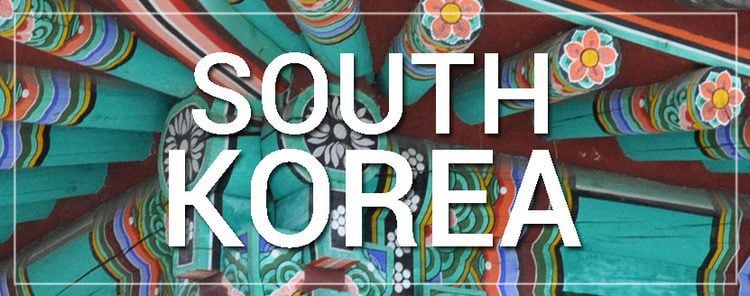
South Korea is known to be a place of wild contradictions and stark contrasts. It’s where you will see ancient temples beside skyscrapers; experience the hustle and bustle of the city life with the serenity of nature nearby, and where both technology and tradition coexist.
While teaching English through the EPIK program, we have traveled many parts of this amazing country. From Seoul to Busan, and numerous hiking treks and festivals, we wanted to experience everything South Korea has to offer.
South Korea Travel Guide Contents
Important Info | Best Time to Visit | Things to Do | What to Eat | Typical Budget
Travel Tips | What to Pack | South Korea Articles | Book Now
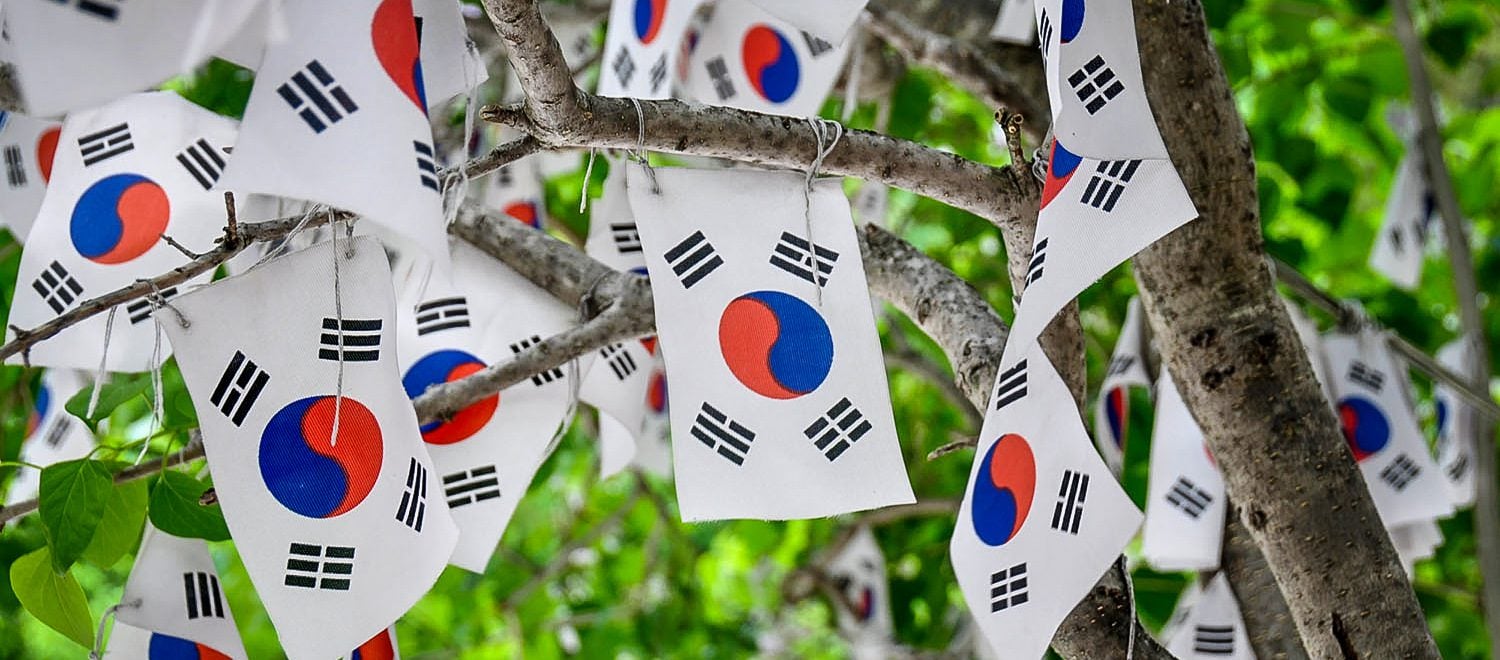
Important Information about South Korea
South Korea at a Glance: South Korea is home to some of the friendliest people on Earth. Here, you will find colorful hanboks and historical places in the middle of Seoul, South Korea’s capital. All around the country, you will also see temples, fortresses and palaces. When it comes to nature, South Korea boasts a lot of hot springs, sandy beaches, mountain peaks and national parks.
Currency in South Korea: won | 2018 Conversion Rate: ₩1000 = $0.88 USD
Tipping in South Korea: Korea has a no-tip culture . Everyone from cab drivers, hotel and restaurant staffs don’t expect any tip.
Language & Helpful Phrases: Korean
Hello = an-nyeong-ha-se-yo
Thank you = gam-sa-ham-ni-da
Beer = maeg-ju
Delicious = mas-issneun
Where’s the bathroom = hwa-jang-siri eodiyeyo
How much? = ige eolmayeyo?
Too expensive = neomu bissan
Don’t want = wonhaji anh-a
Religion and Culture: While a little less than half of South Koreans practice a religion, there are a few throughout the country. The major three are Protestant Christianity, Catholicism and Buddism.
Transportation around South Korea: Transportation in Korea is excellent, probably one of the best in the world. Buses always leave on time, the trains are really cheap and metros are super clean. Most signs in are in English as well as Korean, so it is very easy to travel in Korea.
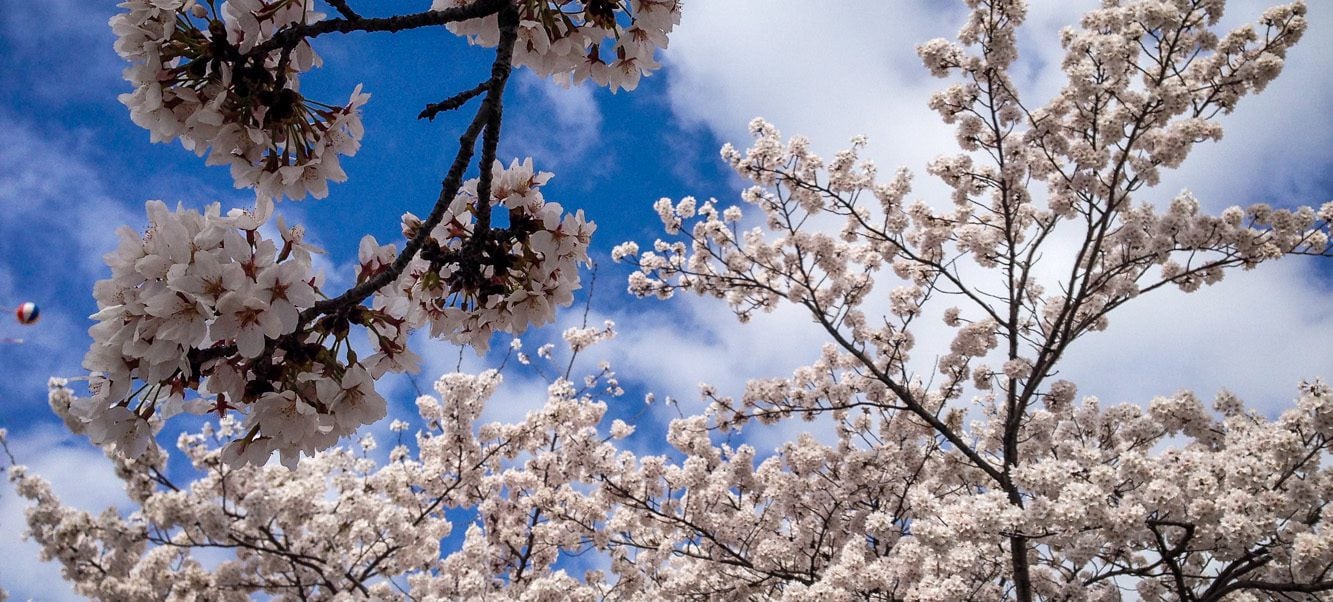
Best Time To Visit South Korea
Climate in south korea.
Korea experiences all four seasons and each one of these bring different experiences. If you want to see the cherry blossom season, plan your trip around the first two weeks in April.
Seasons are similar to most northern hemisphere countries:
Spring: March to May
Summer: June to August
Autumn: September to November
Winter: December to February
Peak season for tourists is in summer. Most, if not all, things in the city get pricier and busier. The month of August is typically summer vacation from school so expect that there will be a lot of people.
Times to avoid traveling in South Korea
By all means, avoid going to South Korea in summer, especially in August. It’s the most expensive and crowed time of the year. Not only that, but the weather tends to be humid.
Major Festivals in South Korea
Andong International Maskdance Festival , late September to early October: During this festival a massive display of mask dancing takes place. People from all over the world come here to showcase different traditional mask dances.
Boryeong Mud Festival, second weekend of July: Experience something unique during this festival by taking a dip in a mud bath, try mud wrestling and mud sliding.
Namwon Chunhyang Festival, April: Basically, this festival is a celebration of one of the most famous Korean folk story characters – Chunhyang from Chunhyangjeon.
Seoul Lantern Festival, First Friday of November: Every year, the theme here changes. As a lantern festival, you can expect to see many lanterns light up the Cheonggyecheon area of Seoul.
Hwacheon Sancheoneo Ice Festival , January: This festival is voted to be one of the best in Korea. Celebrated during winter, activities during this time include catching fish with bare hands, sledding and ice sculpting.
*These festivals follow the Lunar calendar, so the exact dates vary each year

FREE e-Book
We Traveled the World for 4 years on a Budget with these 21 Brilliant Travel Hacks!
[30 pages, money-saving trips, and 100% FREE]
Get your copy NOW!
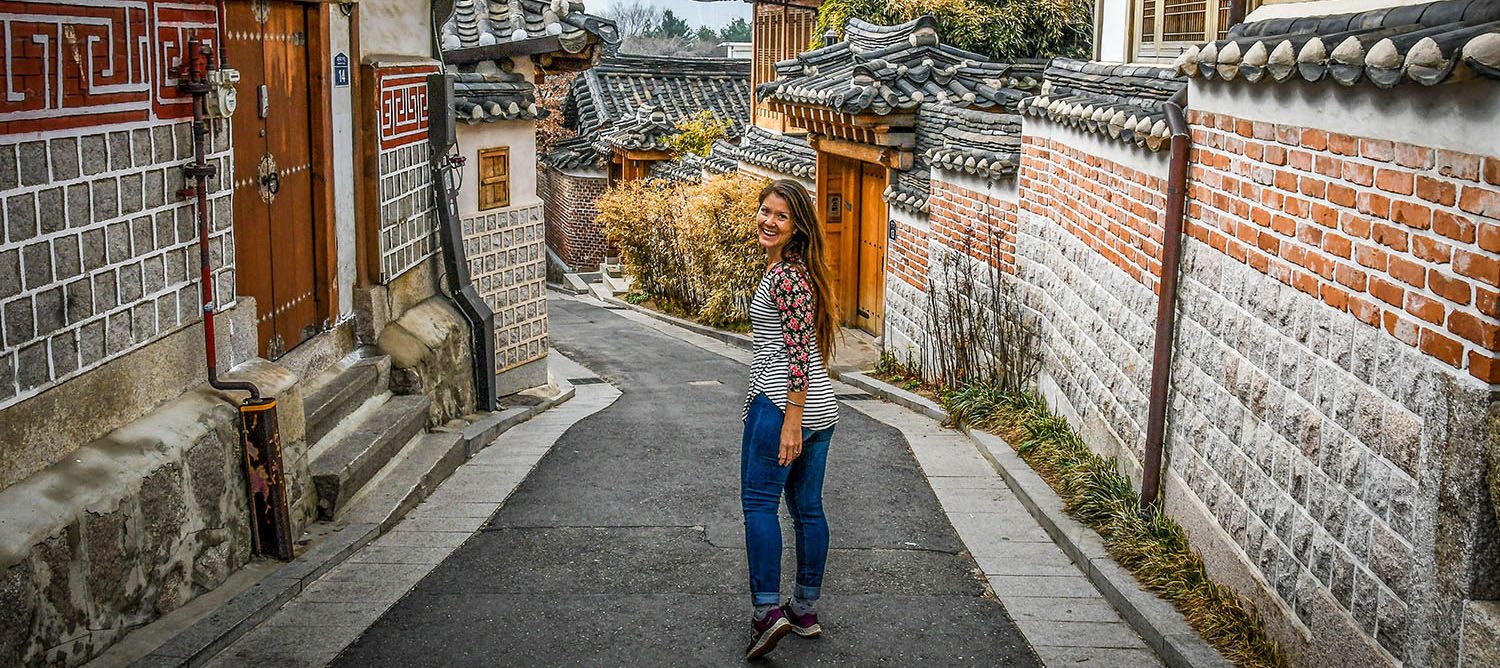
Top Things to Do in South Korea
Get naked at a jjimjilbang.
A jjimjibang is one of the spa retreats that you should try when going to South Korea. Here, you can relax at different temperature hot tubs or try an exfoliating body scrub. You won’t regret it when you see how smooth your skin will become. Read about our jjimjilbang experience in Busan .
Sing in a Noraebang
One of the best ways to feel Korean is to get a group of friends together (and some beers) and sing your hearts out in a Noraebang, a Korean karaoke room). You’ll have a wide variety of songs to choose from, mostly 90’s favorites, and take turns belting out the lyrics along with your friends.
See the Cherry Blossoms in Bloom
Just like Japan, Korea has its fair share of cherry blossoms, and it’s typically less expensive to see them compared to Japan. Annually, for two weeks in April, South Korea becomes a tourist spot for its cherry blossoms.
Explore Jeju Island
Most famous for its blue turquoise waters and mountain views, Jeju Island is one of the most popular places in South Korea. Here, you can experience swimming in a naturally formed swimming pool, hiking to a volcanic crater and chase waterfalls. Read about our experience in Jeju for a weekend .
Eat Live Octopus
If you love taking a bite of exotic food, you shouldn’t miss the chance to try eating a live octopus.
Insider Tip: You can head to any fish market in South Korea and ask for some ssanakji. They will give you a live octopus and give you details to a nearby restaurant where it will be prepared and served to you with some side dishes. We have more details in our Top Things to Do in Korea article.
Are you thinking about teaching English in Korea? Check out our guide to Teaching English Abroad and how to get your TEFL Certification.
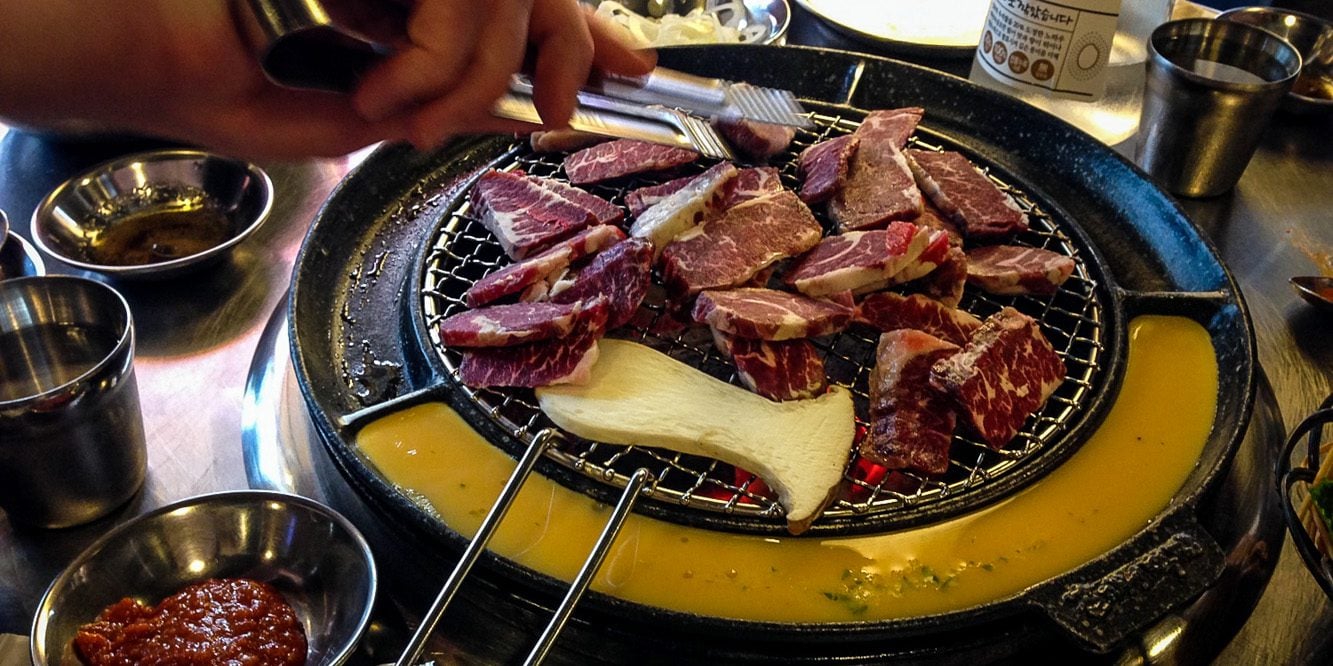
Best Food to Eat in South Korea
All around Asia, South Korea has one of the best cuisines. Often, the first things that come to mind when you think of Korean food is Korean BBQ and Kimchi. These are a must try, but trust us, there is so much more!
When it comes to Korean cuisine, the typically meals are a combination of rice, vegetables and meat. So without further ado, here are some of our favorites:
Samgyeopsal (Korean BBQ): To eat samgyeopsal, you are the grill master and you’ll doing the cooking from the grill on the table. You can either order pork or beef and many side dishes will also be served here.
Jjim dak: Created in the historic city of Andong, jjim dak is a mix of flat noodles, potatoes, delicious sauce, chunks of chicken and some peppers. You can also add some cheese for that heavenly taste.
Kimchi: Kimchi is probably the only food in Korea that you’ll see everywhere you go. It’s the staple food served with every meal all year round.
Bulgogi: For all you meat lovers out there, you’re definitely going to love bulgogi. This is a pile of marinated beef and mixed vegetables that you grill at your table.
Bibimbap: When roughly translated, bibimbap means ‘mixed rice’. It is typically a mixture of greens, mushrooms, radishes, carrots, bean sprouts, gochujang sauce, and of course, rice.
Kimbap: Kimbap are Korea’s rolls of goodies. It can be considered as the sushi of Korea and comes in several varieties like bulgolgi and shrimp. Great for a meal on the go or picnics.
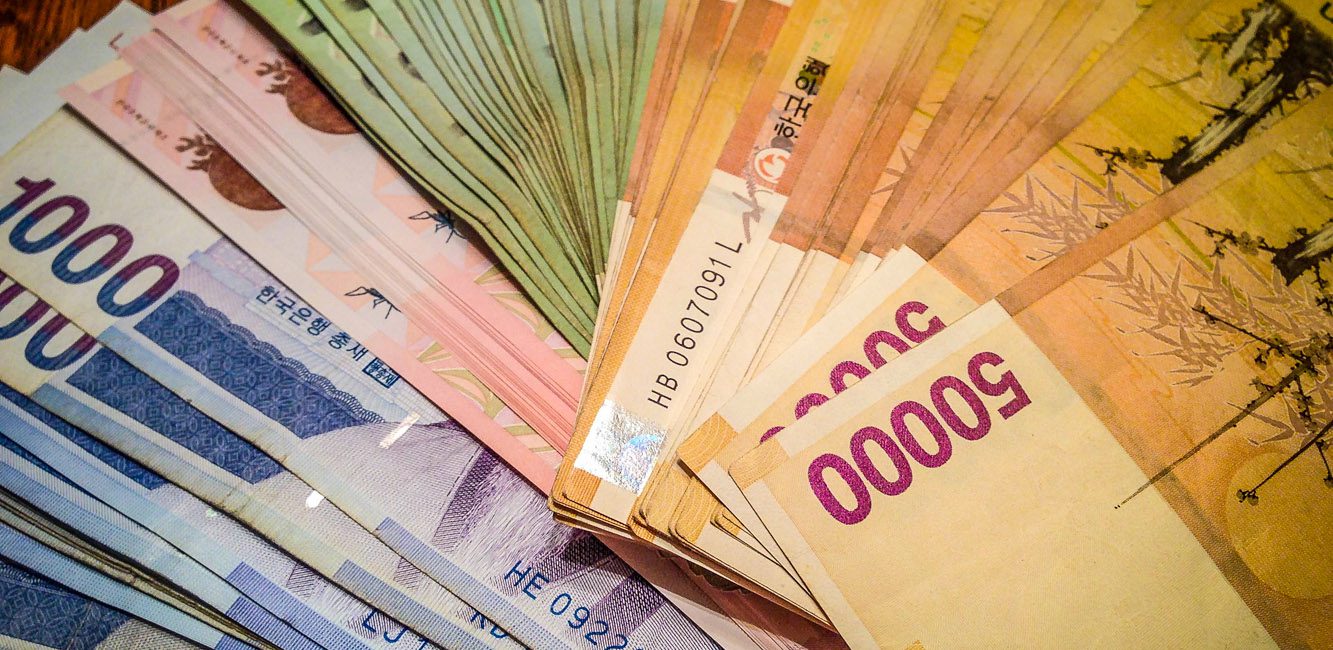
Typical Budget for South Korea
The cost of living in South Korea is relatively low, but it is increasing. Travelers can find many options to suit their travel budgets.
Good to know: For transportation, you can save some money when you get yourself T-Money to pay for your fares on the bus, taxi and subway.
How Much to Budget in South Korea Per Day
Budget traveler: If you are on a tight budget, watch your spending closely, $30 – $40 could be a sufficient budget.
Mid-range traveler: If you want to have a few splurges and stay in nicer accommodation, plan to budget $50 – $100 per day.

Dorm bed = $18-$30
Jjimjilbang = $6-$13
Budget room = $40
Mid-range = $60
Luxury hotel = $170+
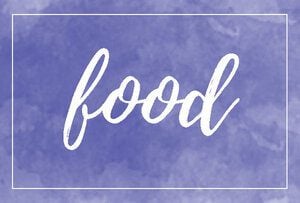
Street food = $1-$5
Restaurant = $5-$17
Local beer = $3-$9
Soju = $1-2

Train = $6-$7
Subway = $1-$2
Taxi = $3-$4

DMZ Tour = $50-80
Jjimjilbang (Scrub and Massage) = $20-$70
Everland = $50
Lotte World = $45
Nami Island = $7
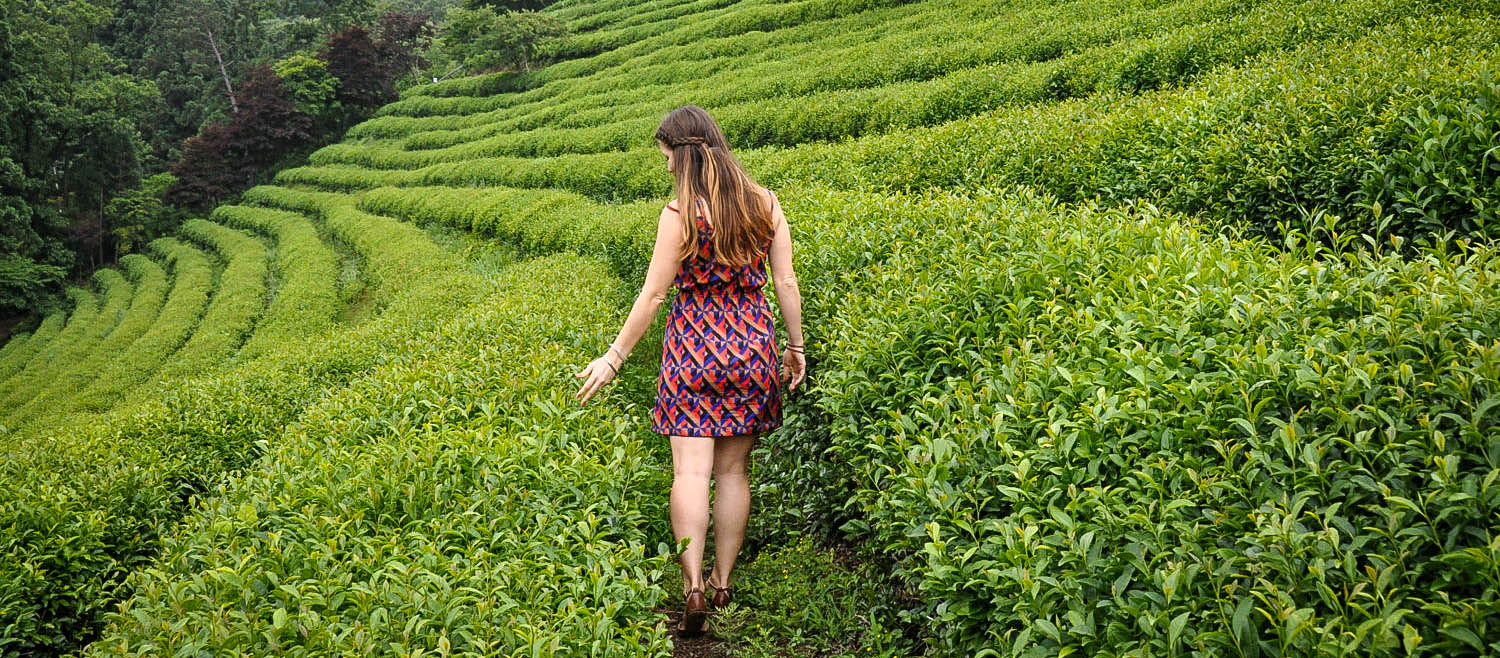
Responsible Travel Tips in South Korea
We are passionate about sharing tips anyone can use to travel more responsibly . Here are some easy ways you can travel better in South Korea.
1. Leave no trace
Only leave your footprints. Nothing else. Bring all your waste and dispose them properly. There are tons of trash bins in the bigger cities in Korea. However, in smaller towns street cleaners come by frequently to collect trash piles. If you have rubbish and you can’t find a trash can, please place it in a trash pile. (I know, not ideal, but it is part of their culture.)
2. Be aware
Check the restaurants and shops before buying or eating there. Only choose ones that don’t promote exploitation or cruelty of endangered species.
Before you leave your accommodation, check that appliances and lights that are not in use should be unplugged. Please turn off your A/C as well.
4. Hang hotel towels
That’s right. Do you even need them replaced every day? Help conserve water by hanging your towels to reuse them during your shorter stays.
5. Do your research
While this is a travel guide, you can tweak it to your liking. Also, read about the country’s culture, religion, language and rules before your trip.
Related Article : Eco-Friendly Travel Gear Packing List
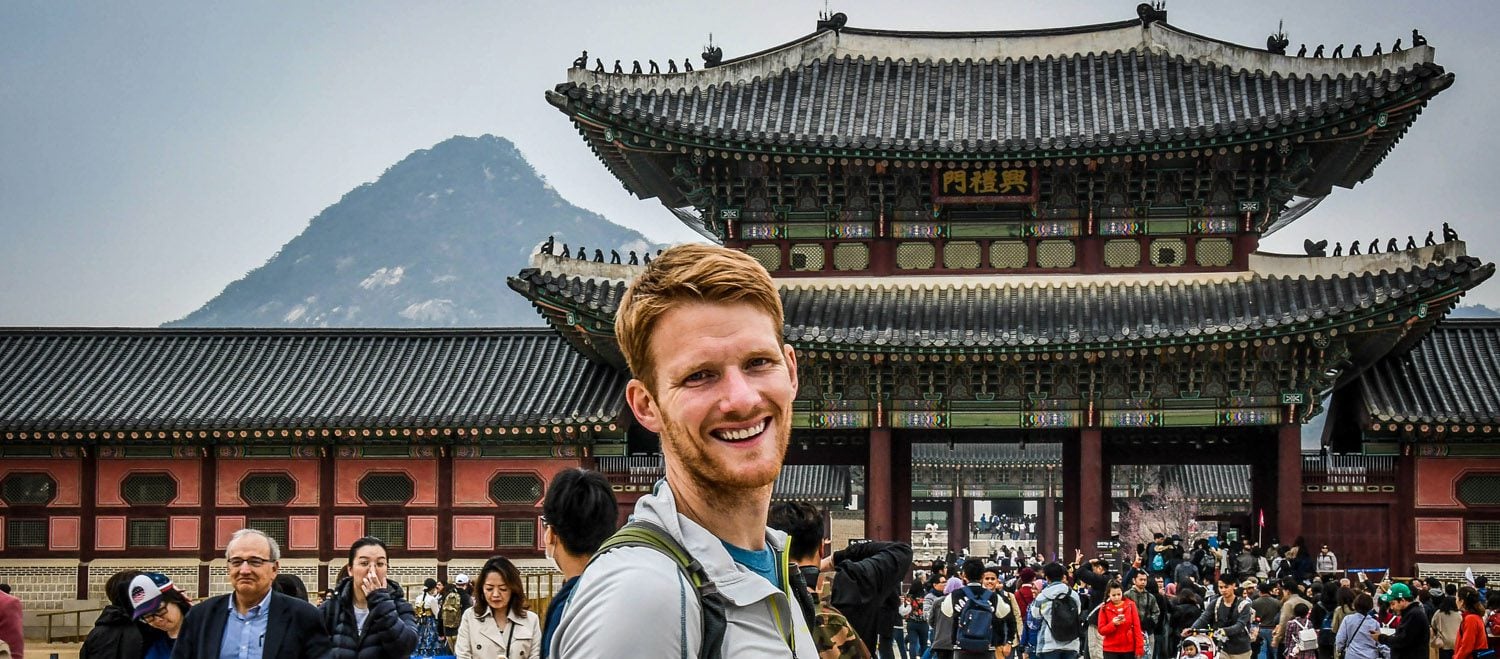
What to Pack for South Korea
You might feel a bit overwhelmed about which stuff to bring when planning your perfect trip. Don’t worry, we got you covered. And if you’re moving to South Korea to teach English, we have exactly what we brought (and what we wished we left at home) in our Moving to Korea Packing List .
Here are some South Korea-specific items we’d recommend packing:
bug repellant (solids are the way to go)
plug adapter
reef safe sunscreen
insulated water bottle (we love our Hydro Flasks )
reusable straw & reusable bag ( say no to single-use plastic! )
fleece jacket (for fall or spring)/hardshell jacket (for winter)
rain jacket (it can rain during any season, so you’ll want to be prepared!)
Skyroam Pocket WiFi (10% off Coupon Code: TWOWANDERINGSOLES)
Chaco sandals (we’d recommend these instead of hiking boots as they are less bulky and are good for walking through water)
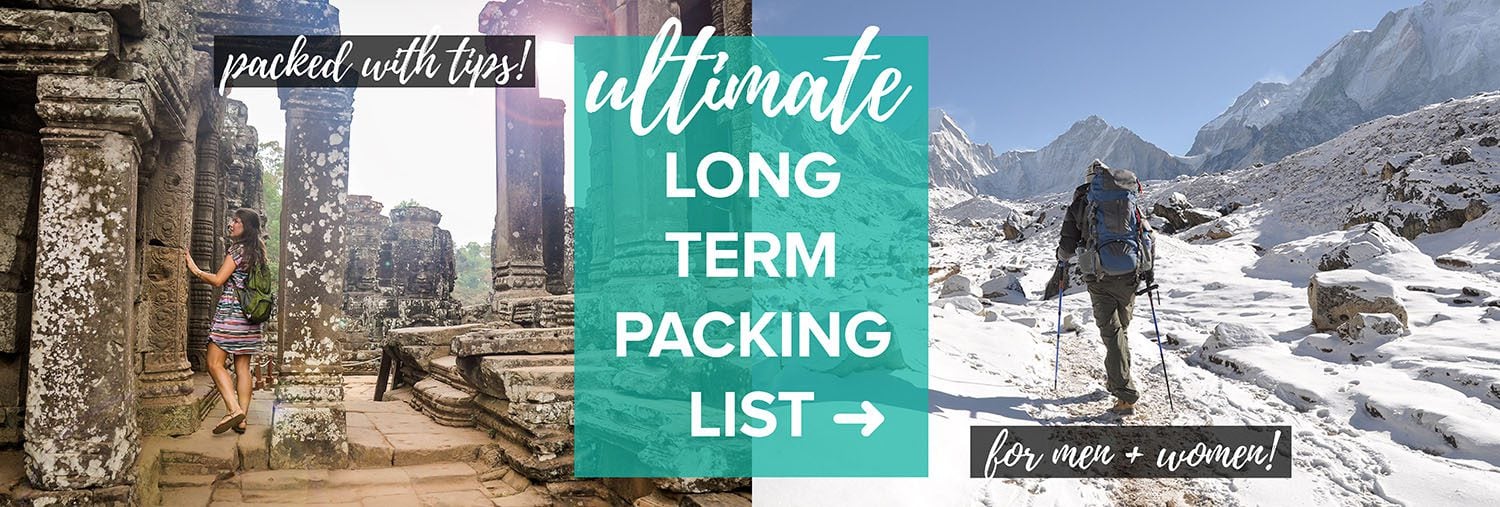
South Korea Articles
To help you plan your dream vacation to South Korea, here are some of our articles to guide you. From fun things to do to detailed itineraries, we’ve got it all!
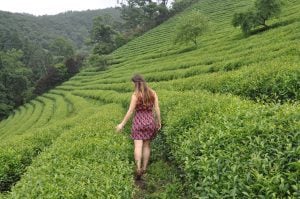
22 Fun Things To Do in South Korea
If you are living in South Korea - or even just visiting for a short...
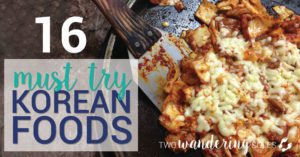
16 Must Try Korean Foods
Ever since we left Korea, the cravings for one of our favorite cuisines has grown...

How to Save $22,000 in One Year Teaching English in South Korea
How can you save $22,000 teaching in South Korea too? This is a breakdown of...
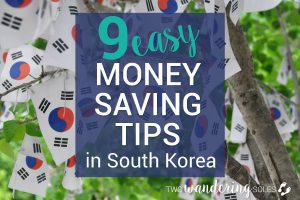
9 Easy Money Saving Tips in South Korea
We managed to save even more money than we expected while teaching English for a...
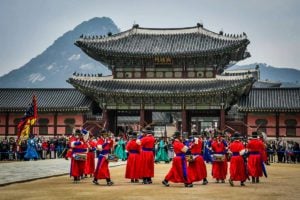
18 Unique & Fun Things to Do in Seoul
Seoul, South Korea is not like any other big city, with so many unique and...

Visiting Dokdo and Stunning Ulleungdo, South Korea
When we were offered the chance to visit these hard-to-get-to islands through a trip entirely...
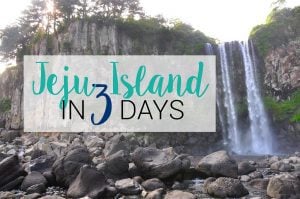
Jeju Island in 3 Days
Follow our journey around Korea's famous Jeju island as we explore waterfalls, volcanic caves, and...
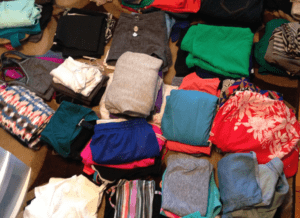
Moving to Korea: The Ultimate Packing List
If you're moving to South Korea to teach English, you're likely wondering what to pack...
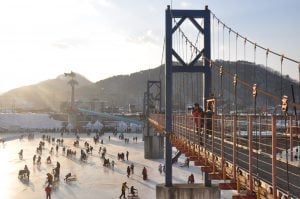
Hwacheon Ice Fishing Festival
I have a confession. Until last weekend, I had never gone ice fishing in my...
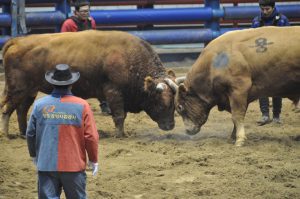
Korean Bullfighting & Persimmon Wine
Think bullfighting happens just in Spain? Think again. Korea has it's own version of this...

A Naked Christmas
Yes, I mean "naked" in the literal sense. No clothes. Nude. Au naturel. Call it...
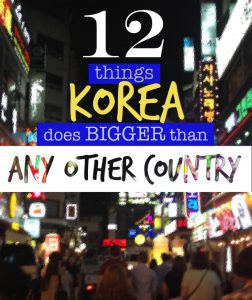
12 Things Korea Does Bigger Than Any Other Country
From super fast shipping to theme cafes, there are just some things that South Korea...
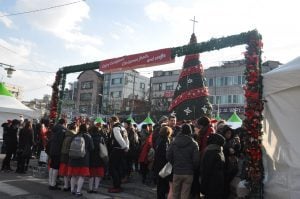
Seoul Christmas Markets & Craft Beer
One of my most magical holiday memories is visiting the Christmas markets in Austria. So...
EPIK Life Video Contest Winner
I am beyond excited and truly honored to share that I was chosen as the...
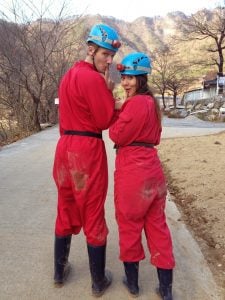
Adventure Korea: Caving & Bare-Handed Fishing
I have been craving one last weekend spent outdoors before it gets too cold to...
Korean Apartment Tour
When we finally opened the door to the place we would be calling "home" for...
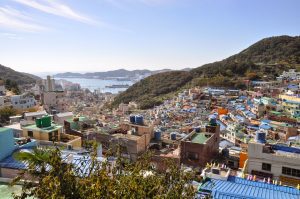
2 Days in Busan, Korea: Best Things To Do
Known for beaches, temples, markets and nightlife, Busan is well worth a stop during your...
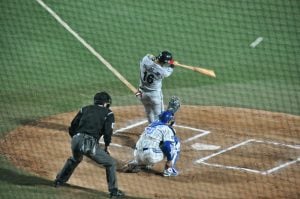
Take Me Out to the (Korean) Ball Game
We’d heard from our co-teachers and friends that Korean baseball games are an experience not...
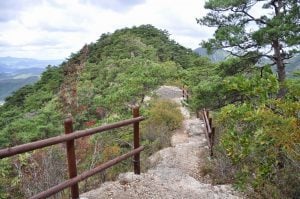
Camping… Korean Style
We’ve been extremely lucky to find a group of friends here in Korea that has...
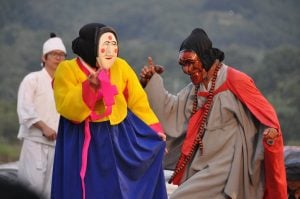
Andong Mask Dance Festival
It is rumored that in 1999, Queen Elizabeth asked to be taken to the “most...
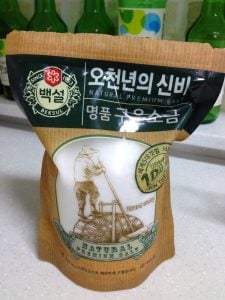
Korean Struggle
Though we are beginning to feel settled in, there are many parts of our daily...
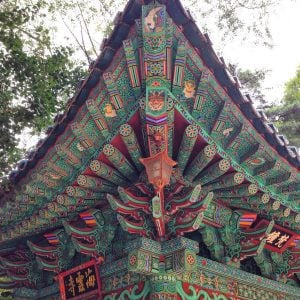
Korean Surprise!
One of the more insightful lecturers warned us about a phenomenon she amusingly referred to...

A lot of people have asked us, Why Korea? Our answer is complicated.

Save this page on Pinterest for later!
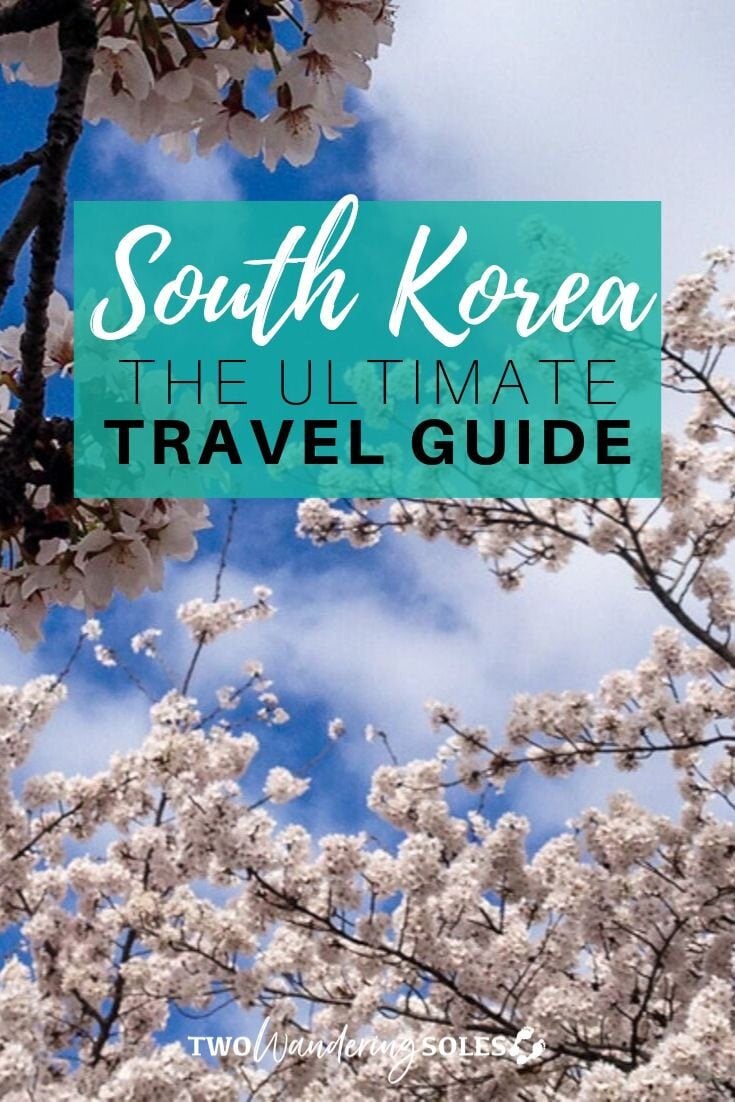
Book Your Trip Now

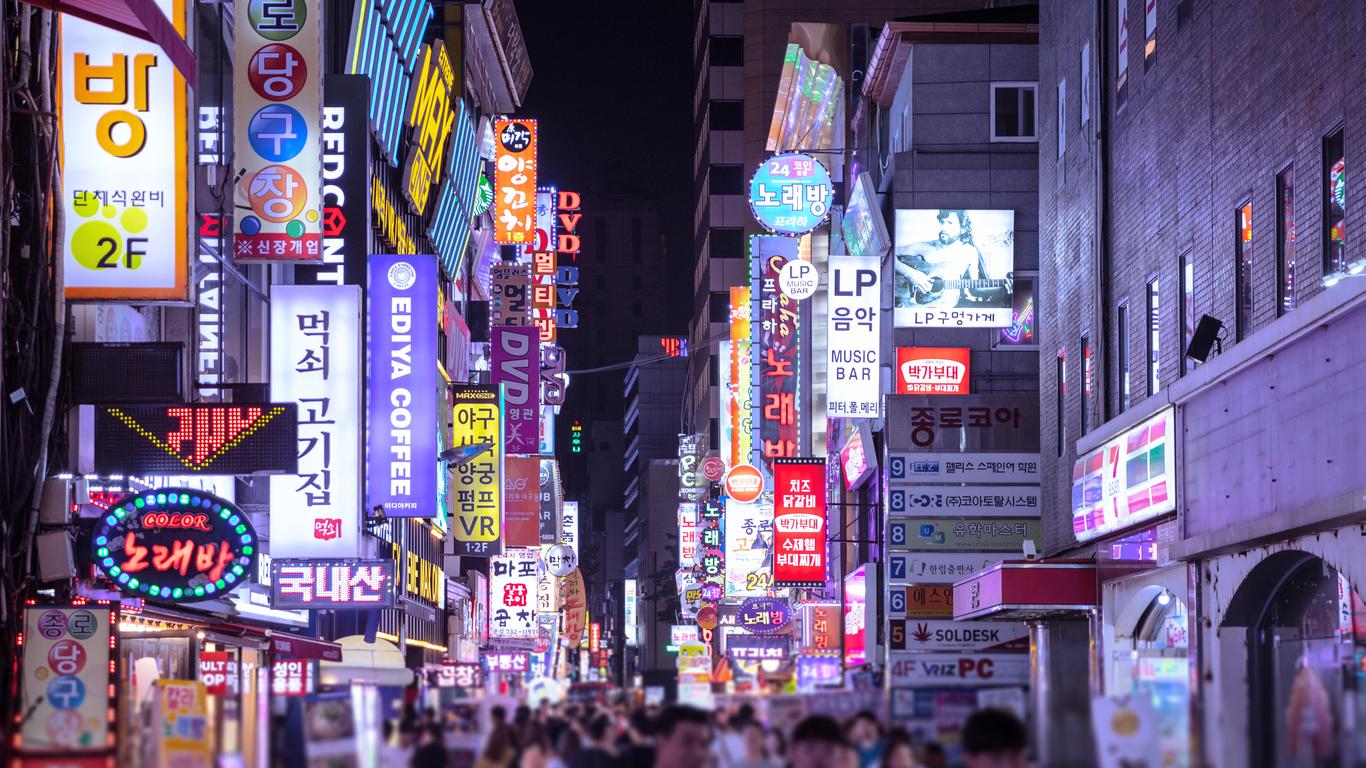
South Korea travel guide
South korea tourism | south korea guide, you're going to love south korea.
A world of culture and history, the sights, the food and the experiences in South Korea will fascinate and excite you.
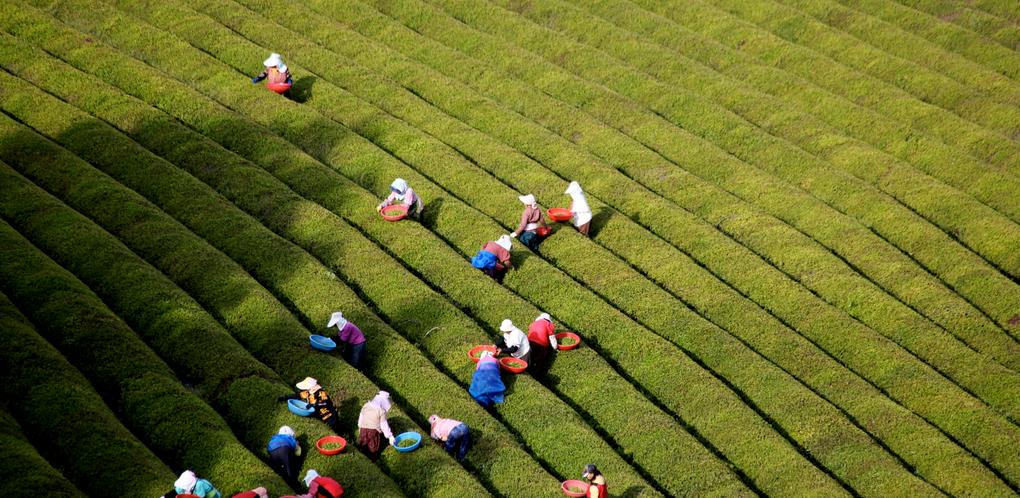
What to do in South Korea
1. visit the palaces of seoul.
The five palaces of Seoul are worth exploring, especially Changdeokgung, which is listed as a World Heritage Site. Take some time to discover other parts of the city, such as Bukchon Hanok Village and the Seoul Tower, and go shopping in the Myeong-dong district.
2. Explore Busan
South Korea's second largest city, Busan offers magnificent beaches, the colorful Gamcheon culture village, and the largest fish market in Korea.
3. Try the Street Food at Gwangjang Market
Originally a fabric market, Gwangjang Market is now the busiest food alley in Seoul, with street food vendors spread among the fabric shops. While here, you must try the Nokdu Bindaetteok, a mung bean pancake that is normally paired with milky rice wine or makgeolli.
4. Spend a Day at Lotte World
Head to the world's biggest indoor theme park with the kids and spend the day going on fun rides, watching shows and visiting the aquarium and water park.
5. Experience the Boryeong Mud Festival
South Korea's 10-day Mud Festival is held every July and attracts millions of people. You'll be able to go on the mud super slide, splash in muddy pools and go into the mud rain tunnel.
When to visit South Korea
The best times to visit South Korea are the spring months from March to May and the autumn months from September to November. The summer is usually hot and humid, while winters are icy and cold.
How to Get to South Korea
Entry requirements.
Citizens from a large number of countries will receive a tourist visa on arrival for durations ranging from 30 to 180 days. For visitors coming from other countries, a visa must be applied for prior to arriving.
The two main international airports are located around Seoul and Busan, and the main national airline Korean Air offers nonstop flights to around 150 destinations. Budget flights can be found to and from Asia with airlines such as Air Busan, Jin Air and Eastar Jet.
Ferries connect the city of Busan in South Korea to various destinations in Japan, including Fukuoka and Osaka. Incheon is also connected by ferry to several cities in China, while a cruise ferry is available from Donghae to Vladivostok in Russia.
Popular airports in South Korea
Popular airlines serving south korea, where to stay in south korea.
A large variety of accommodation is available in South Korea. Minbaks can be found in national parks and rural areas, Jjimjilbangs are a type of budget accommodation available in bath houses, and for something a bit different, glamping is a very popular option, especially among Korean teens.
Where to stay in popular areas of South Korea
Most booked hotels in south korea, how to get around south korea, public transportation.
South Korea is very well-connected by public transport, including subway systems in the 6 main cities, trains and buses.
Korail is the national rail network and connects the major cities in South Korea. Trains are available in 3 different speeds, with the Korea Train Express being the high speed train, the ITX-Saemaeul slightly slower, and the Mugunghwas the slowest train.
Buses are the main mode of long-distance transport, and there are two types of buses that service the country. Express Buses are faster when it comes to long distances and Inter-City Buses service more locations.
If you are looking to rent a car while in South Korea, you will need an international driving permit. Driving in the big cities is not recommended due to traffic and expensive parking; however, it is a great way to see the rural areas.
Domestic flights are available through local airlines Asiana and Korea Air, as well as 5 different low-cost airlines, including Air Busan, T'Way Airlines and Jin Air.
Best car rental deals in South Korea
Intermediate
5 Adults, 3 Bags
5 Adults, 5 Bags
The Cost of Living in South Korea
The price of an average inexpensive meal in South Korea is about 7,000 KRW (6 USD), while a 3-course meal at a mid range restaurant will cost around 40,000 KRW (34 USD), and a monthly public transport pass will cost around 55,000 KRW (47 USD). Credit and debit cards are widely used around the country; however, you might need cash for small purchases or for buying from smaller merchants.

- 2 Weeks for Couple
- 2 Weeks for Family
- Thailand Lantern Festival
- Indonesia(Bali)
- South Korea
- China (HK, Taiwan)
- Itinerary Ideas
- Asia Highlights Travel Reviews
- Thailand Travel Reviews
- Vietnam Travel Reviews
- Cambodia Travel Reviews
- Japan Travel Reviews
- Myanmar Travel Reviews
- China Travel Reviews

South Korea Travel Guide: Customize a Personalized Trip
South Korea has become an exciting destination, thanks to the immense popularity of K-POP music, movies, and mouthwatering Korean barbecues. This makes it an excellent choice for a family getaway, especially if you have teenagers who are into these trends.
Popular South Korea Private Tours
Sign up for your favorite tours or simply seek inspiration. We can craft a trip around you and help you realize your own holiday dreams.
8-Day South Korea Tour
10-day south korea tour.
Discover real reviews of Highlights Travel Family 's best-rated service across trusted platforms.
Popular Asia Tours Including South Korea
14-day classic japan and south korea tour.
- 16-Day South Korea and Japan Cultural Adventure Tour
17-Day South Korea and Taiwan Tour
17-day japan and south korea tour, 11-day south korea and bali tour, how to plan a trip to south korea & japan, how to plan a trip to south korea, best (and worst) times to visit south korea.
- How to Plan a 12-Day Trip in Japan and South Korea
- How to Plan a 2-Week Itinerary in Japan and South Korea
South Korea Weather by Month
South korea weather in january, south korea weather in february, south korea weather in march, south korea weather in april, south korea weather in may, south korea weather in june, south korea weather in july, south korea weather in august, south korea weather in september, south korea weather in october, south korea weather in november, south korea weather in december, why asia highlights (10,000+ reviews & 98.8% 5-star rating).
- Save Your Time:
- Less research, more enjoyment!
- Real-time 1V1 expert planning
- Maximize Your Flexibility:
- Personal local guide and ride
- Explore at your own pace
- Celebrate Your Journeys:
- Specially-crafted family adventures
- Celebrate milestones with style!
- 8-Day South Korea Tour to Visit Highlights of Seoul, Busan and Jeju
- 10-Day South Korea Tour to Visit Seoul, Sokcho, Andong and Suncheon
- 17-Day Classic South Korea and Taiwan Tour
- How to Plan a Trip to South Korea in 2024/2025
- 10 Days in South Korea: Best 4 Itineraries for a First Visit 2024/2025
- Japan Weather in January: Travel Tips for First-Timers
- Japan Weather in February 2024: Travel Tips for First-Timers
- Japan Weather in March 2024: Travel Tips for First-Timers
- Japan Weather in April 2024, Travel Tips (for First-Timers)
- Japan Weather in May 2024: Travel Tips for a First Visit
- Japan Weather in June 2024: Coolest Summer Month, Travel Tips for First Visit
- Japan Weather in July 2024: Full of Festivals, Travel Tips for First Visit
- Japan Weather in August 2024: Travel Tips for First Visit
- Japan Weather in September, Travel Tips (for First-Timers)
- Japan Weather in October 2024: Travel Tips for First-Timers
- Japan Weather in November 2024: Best Autumn Month, Travel Tips
- Japan Weather in December 2024: Travel Tips for First-Timers
Get Inspired with Some Popular Itineraries
At Asia Highlights, we create your kind of journey — your dates, your destinations, at your pace. You can have any trip tailor made for your travel.
More Travel Ideas and Inspiration
Sign up to our newsletter.
Be the first to receive exciting updates, exclusive promotions, and valuable travel tips from our team of experts.
Why Asia Highlights
Where can we take you today.
- Middle East
- African Safari
- Travel Agents
- Our Differences
- Privacy Policy
Address: Building 6, Chuangyi Business Park, 70 Qilidian Road, Guilin, Guangxi, 541004, China

Seoul Itinerary: Ultimate DIY Travel Guide for South Korea for 5 Days (More or Less)
by Aileen Adalid Itineraries , South Korea 134 comments
- 15 Best Facebook Groups for Travelers You Should Be a Part Of (2024)
- Best Hotels in Bali, Indonesia: From Cheap to Luxury Accommodations and Places to Stay
- Best Hotels in Osaka, Japan: From Cheap to Luxury Accommodations and Places to Stay
- Mt. Fuji Tour from Tokyo, Japan (Travel Guide & Itinerary Ideas)
- How to Apply for a Danish Schengen Visa for Filipino Tourists (Manila, Philippines)
- Best Hotels in Bohol, Philippines: From Cheap to Luxury Accommodations and Places to Stay
- Canada Facts & Trivia: 10 Things Foreigners Should Know
- Ultimate New Zealand Road Trip with Wild Kiwi (Tour Review)
- Arigato Japan: Tokyo Walking Food Tour to Non-Touristy Spots in Yurakucho, Ginza, & Shimbashi
- Top 10 Instagrammable Film Locations of Crazy Rich Asians in Singapore
One of my recent adventures was to the dynamic metropolis of Seoul in South Korea — a bustling city that not only holds a strong presence in Asia but also in the rest of the world. To date, this influence is largely due to Seoul’s cutting-edge technology, a strong economy, and vibrant culture (I’m sure that a majority of you have encountered K-pop , K-dramas, Korean cosmetics, and Korean food among many others at least once in your life!) (Seoul Itinerary)
TRIVIA : Seoul has 25 districts ( gu ) that are further subdivided into 522 sub-districts ( dong ), and with the Han River that runs through the middle of the city, there are distinct 2 sections: Gangbuk (the northern area that’s more traditional) and Gangnam (southern area that’s more modern). But… asking for the “center” of this whole metropolitan area is a difficult thing to answer because Seoul’s districts can somehow each function like a city center itself.
It actually baffles me that I didn’t go to Seoul sooner; nevertheless, the important thing is, I’ve finally seen this city for myself, and well… I just LOVED it! I am totally smitten about how it is constantly brimming with incredible things-to-do of sorts — all of which are enough to satisfy any kind of traveler out there.
Where to Stay in Seoul?
Come and check out my list of the ‘ Best Hotels in Seoul ‘ which features the top recommended choices for cheap to luxurious accommodation choices PER district.
Clearly, the days I spent there were not enough and I would have absolutely loved to stay longer. And now, as I recall the vast array of activities and sights that could be done and seen, I’ve decided to whip up this comprehensive Seoul itinerary travel guide that spans 5 days/nights to help travelers (like you) to plan a trip with ease and speed.
Rest assured, the Seoul itinerary below is totally customizable to fit any number of days that you might be spending — but first, here are some important tips for your travel to South Korea!
Table of Contents
South Korea Travel Guide
» quick travel planning.
- Top tours & experiences
- Find flights to Korea
- Visa requirements
- Best hotels & hostels
- Travel insurance (5% discount)
- Stay connected
– – –
» Best Time to Visit
I suggest coming during autumn to see the amazing fall foliage , but of course, if you want to witness cherry blossom season then spring is a considerable option too.
- Spring : The city becomes a hit with all the flora that start to bloom and bud. And of course, much like Japan, the city has cherry blossoms which tourists often seek. Given this demand, there tends to be a slight increase in costs, but the weather and season are quite desirable.
- Summer : This is arguably the peak season in the city so things get busier and costlier. It doesn’t help either that this is the vacation month of schools and Korean companies so everyone is out and about. That’s why if I were you, you should avoid these months — also because the weather can get quite humid with occasional downpours.
- ★ Autumn : (This is the best time to visit Seoul because the weather is pleasant, prices are more affordable, and crowds are thinner. Not to mention the number of great destination must-sees for viewing vibrant leaves of autumn in South Korea . However, do take note to avoid Chuseok or Korea’s autumn harvest festival.
- Winter : As the temperatures drop, prices and airfare also drop. Take note though that it can get very chilly; but, supposing you’re not that sensitive to the cold, this can be a fun time given all the amazing ski resorts and festive atmosphere.
Other South Korean blooms to watch out for?
See this list of the most popular spring flowers in Korea — when to see them and where to go!
ADDITIONAL TIP: Arrive and start your Seoul itinerary before the weekend. For example, if you’re visiting for 5 nights, make sure to come from Wednesday to Sunday. I say this because most places, museums, and shops close on Mondays and Tuesdays. Moreover, a lot of cosmetic stores hold sales starting on Thursdays and up to the weekend .
- WINTER: Dec to Feb
- SPRING: March to May
- SUMMER: June to Aug
- AUTUMN: Sept to Nov
» Getting in to South Korea
International visitors typically arrive at the main airport called Incheon International Airport (ICN) . To get here, I recommend browsing through Skyscanner to find the best flight deals from your point of origin. If you’re from the Philippines like me, Skyscanner also scans through budget airlines such as Air Asia and Cebu Pacific in order to find which of the 2 has the cheapest rate on the dates you choose.
From ICN, below are the following modes of transportation to get to Seoul…
By train. AREX (Airport Railroad Express) or ‘airport train’ connects ICN to Seoul station and Gimpo Airport, operating from 5:20AM to 12:00AM (midnight). There are 2 types of AREX, namely ‘express’ and ‘all-stop’. As the name suggests, ‘express’ is fast as it goes directly to Seoul Station (43 minutes) whereas ‘all-stop’ will arrive at 12 stations before finally arriving at Seoul Station (53 minutes). ‘Express’ tickets typically cost ₩8,000 but if you purchase online , you can get it at a discount for about ₩6,500~ only — and if you use code AILEEN5OFF , you’ll get an additional 5% off! Contrarily, in case you hold a Discover Seoul Pass , you can avail of one (1) FREE one-way ride.
By private transfers . If you want the utmost convenience and ease, especially without having to drag your luggage around, I recommend booking a private transfer to your hotel for only $63~ (or Php 3,300~ / ₩67,000~). This works best if you’re coming together with other people so that you can share the cost and save more. Otherwise, there are taxis at the airport that charge around ₩60,000 to ₩90,000 depending on your destination (take note that if the taxi passes by a road toll, you’ll have to pay for it).
By airport limousine/bus or shared transfers. There are limousine buses that travel directly to major areas and big hotels in Seoul and are a great option when you’re traveling with a lot of luggage. To get a discounted rate on this at about ₩14,000~ only, book with KAL or via shared transfer .
» Visa for South Korea
If you’re NOT a citizen of any of South Korea’s exempted countries , you are then required to avail of a visa beforehand. (If you’re from the Philippines, you can read my guide on how to get a South Korea visa in Manila here .)
- Check full visa requirements here as per your nationality.
» Where to Stay (South Korea Accommodations)
To search for the best hotel accommodation in South Korea at the best prices, I suggest cross-checking hotel prices between Agoda and Booking.com . But if you’re rather interested in renting comfortable houses or apartments, you should search through AirBnB .
Otherwise, if you’re interested in seeing the top picks per district in Seoul, see here .
» South Korea Currency
South Korean Won (KRW / ₩) wherein KRW 1,000 is equal to about USD $0.9~, €0.7~ or Php 49.00~ (this is as of May 2021). In the event that you want to exchange your money for KRW, I highly advise that you do NOT exchange your money at the airport since the rates there are not competitive.
- How to best exchange your currency? Either exchange your money at a bank or at a money exchanger in your home country or in Seoul’s city center. Better yet, just withdraw from an ATM with your debit/credit card (do one big withdrawal to minimize fees with your bank) . Speaking of cards, a lot of Seoul’s establishments accept credit cards but it’s always advisable to have cash on hand.
» Cost of Travel in Korea
While the cost of living in South Korea is far from being cheap, your trip doesn’t have to break the bank! To give you an idea, you should expect to travel in South Korea with an average daily cost of about USD $35~ per person on a budget, or at least $100~ if you want to experience more comfort on activities, tours, hotels, and more. (Values below show low budget to medium budget ranges).
- Hotels: $20 to $100 USD / day
- Food: $10 to $30 USD / day
- Fun: $10 to $25 USD / day
- Transport: About US$1 per subway ride*
*Buy a T-Money card that saves you ₩100 on all trips.
» How to Get Around Seoul
I would recommend using Naver Map ( iOs / Android ) for researching your day-to-day route on your Seoul itinerary because it will show in detail the fastest connections you can do (by walking, by car, by bus, and by subway). To make this work, get your own pocket WiFi or SIM Card .
You might be wondering why I am not recommending Google Maps which is the app that I typically use in my travels. Well… this is because Google Maps’ driving and walking directions don’t work in South Korea. This is mainly due to the country’s old security laws that were set after the Korean War (I guess, as a way to protect their detailed topography from North Korea).
By subway . Seoul’s metro is impressive, well-connected, and cheap. To save time and make the most of the fares during your stay, it’s best to buy a T-Money card which is basically a stored value smart card that you can recharge and use between buses, trains, and subways while saving you ₩100 on all trips. You can buy this online beforehand at a cheaper rate — otherwise, it can be purchased at most of Seoul’s subway stations, newspaper kiosks, and convenience stores.
Take note that a T-money card is applicable to other locations as well in South Korea such as Gyeonggi-do, Incheon, Busan , Daegu, Daejeon, and Gwangju buses — plus Incheon, Busan, Daegu, Daejeon, and Gwangju Metropolitan Subway networks.
However, if I may give you a tip, you can actually avoid paying the cost of acquiring this card (₩3,000) if you have a Discover Seoul Pass (which I will discuss in the next section below).
NOTE : Single-ride cards cost about ₩1,200~ and they can be purchased on vending machines which accept coins and bills only. Reloading your T-Money Card can also only be done with cash. Meanwhile, remember that the last train usually departs by midnight (the subway does NOT operate for 24 hours).
By bus. The city also has an extensive and well-connected bus service that similarly makes use of the T-Money card. Just always remember to tap your card before exiting the bus or else you’ll be charged the maximum fare possible on that bus’ route. If you’re rather looking for an unlimited hop-on-hop-off bus to the city’s major spots, you can check this out.
By foot . Seoul technically isn’t too huge of a place and most of the city highlights can be reached by foot.
By taxi. There are various taxi types in Seoul and in order to learn more about them and their corresponding fares, read here . (It’s also possible to book an Uber car) .
» Money-Saving Tips in Seoul
I advise that you purchase a Discover Seoul Pass for your Seoul itinerary because it is an amazing cost-effective card that is offered only to foreigners. To illustrate, below are the range of benefits that you can get from this pass:
- Gyeongbokgung Palace
- Deoksugung Palace
- Changgyeonggung Palace
- Changdeokgung Palace
- Jongmyo (Royal Shrine)
- N Seoul Tower Observatory
- Seoul City Tour Double-Decker Bus
- COEX Aquarium
- TrickEye & Ice Museum
- Hello Kitty Island in N Seoul Tower
- PooPoo Land
- Lotte World Adventure
- Eland Cruise
- LOTTE Duty Free
- NO WORRIES! Using your Discover Seoul Pass as a T-Money card for public transportation does NOT activate it. The Discover Seoul Pass will only activate when you first use it on its listed attraction s.
To get the best rate for a Discover Seoul Pass, you can purchase it online (it’s available in 24H and 48H options), and then pick it up either at Incheon International Airport or at Myeongdong’s Tourist Information Center.
- TIP : The last Wednesday of each month has been designated as a “Culture Day” in Korea since 2014. During this day, participating museums, galleries, and other cultural facilities will offer FREE or discounted admissions. Examples are the royal palaces, Jongmyo Shrine, National Museum of Korea, Korean National Ballet etc.
» Staying Connected in South Korea
South Korea is said to have the fastest internet in the world (and yep, it’s true!) so you’ll be assured of great connection wherever you go. To add, most places even offer FREE WiFi — but in order to consistently stay connected online during your Seoul trip, I recommend getting your own pocket WiFi or SIM Card ; otherwise, consider getting an eSIM for a hassle-free experience.
» Safety in South Korea
The Republic of Korea or South Korea remains to be one of the safest countries in the world — and also one of the safest countries for solo female travelers . Petty theft may happen but they are quite rare; so, just practice common sense at all times and you’ll be fine!
- HOW TO: Find the right travel insurance for you
» Helpful Korean Phrases
English is not widely spoken in South Korea even if it is taught in a lot of schools, but you’ll have better luck in the capital of Seoul where a lot of people put time, effort and money in learning English. Nevertheless, it doesn’t hurt to learn a bit of the local language!
- RELATED READ: Best translation apps for travel
Hello (formal): Annyeong haseyo Hello (informal): Annyeong Thank you: Gamsahamnida You’re welcome: Cheonmanyeyo Yes: Ye/Ne No: Aniyo Goodbye (to person leaving): Annyeonghi gaseyo Goodbye (to person staying): Annyeonghi gyeseyo Goodbye (informal): Annyeong
Excuse me (getting attention): Sillyehamnida I’m sorry: Joesonghamnida Is there someone here who speaks English?: Yeogi-e yeong-eoreul hasineun bun gyesimnikka? Help!: Dowajusipsio! Cheers!: Geonbae!
Other F.A.Q.
It is not customary in South Korea to tip, and sometimes, much like in Japan, they consider it as an insult so tipping is not recommended at all. In hotels and some restaurants though, you will sometimes see a 10% service charge on your bill.
South Korea typically uses type F (two round pins). The country operates on a 220V voltage and a frequency of 60Hz.
Please check their latest travel advisories page for more details.
All visitors to South Korea must have a passport that is valid for at least 6 months after the period of their intended stay (as well as have 2 blank pages).
There is and you can easily claim a tax refund for being a tourist; simply read this page for more info.
It is legal to fly a drone in the country but one of the top restrictions is to NOT fly above 150 meters and if your drone is more than 250 grams, it needs to be registered. For more info, see here .
Seoul Itinerary Guide
Take note that the 5-day Seoul itinerary below does not take into account your arrival day in Seoul — at any rate, if you’re staying longer in the city, you can make use of the last tab called ‘ Extra Days ‘ to see the other activities or trips you can do for filling up the rest of your vacation days.
TIP: It’s best to arrive and start your Seoul itinerary trip before the weekend. So for example, if you have 5 whole days, make sure to arrive on Tuesday and then start your whole tour from Wednesday to Sunday . I say this because most places, museums, and shops close on Mondays and Tuesdays. Moreover, a lot of cosmetic stores hold sales starting on Thursdays and up to the weekend so it would be a good idea to take advantage of that.
NOTE: The following section is in a tabbed format; so, in order to see the next day’s contents, just click the headings below.
DAY 1: Explore and enjoy Korean culture in a hanbok!

Photo by: Shutterstock
◘◘ Rent a hanbok and explore some of Seoul’s cultural highlights
(Nearest subway station: Gyeongbokgung Station, Exit #4) You must never leave the city without trying on the elegant Korean traditional clothing called ‘ hanbok’! Much like how Japan has kimono rental shops, South Korea has hanbok rental shops for tourists. Through these places, you can borrow and wear hanbok for a day (or more ) whilst you venture out to the cultural spots in Seoul to snap wonderful photos.
This is certainly a MUST-do activity in your Seoul itinerary because aside from the fact that you can have the chance to feel as though you’ve been transported back to the Joseon period or to a set of an old K-drama, the experience itself is also supported by the Koreans as a part of promoting their history (so yes, it’s one way of immersing yourself with their vibrant culture too). And if those reasons are not enough, wearing a hanbok grants you FREE entry to the palaces in the city!
TRIVIA : The term ‘hanbok’ literally means “Korean clothing” but it just basically refers to the traditional clothing for both men and women from the Joseon period.
There are a LOT of hanbok rental shops in Seoul but if you want the best, I highly recommend renting with Seohwa Hanbok . Apart from its prime location, it has more intricately-designed hanbok garments that are set at an affordable price! For a more comprehensive guide on this, read my ‘ Hanbok Rental ‘ post here .
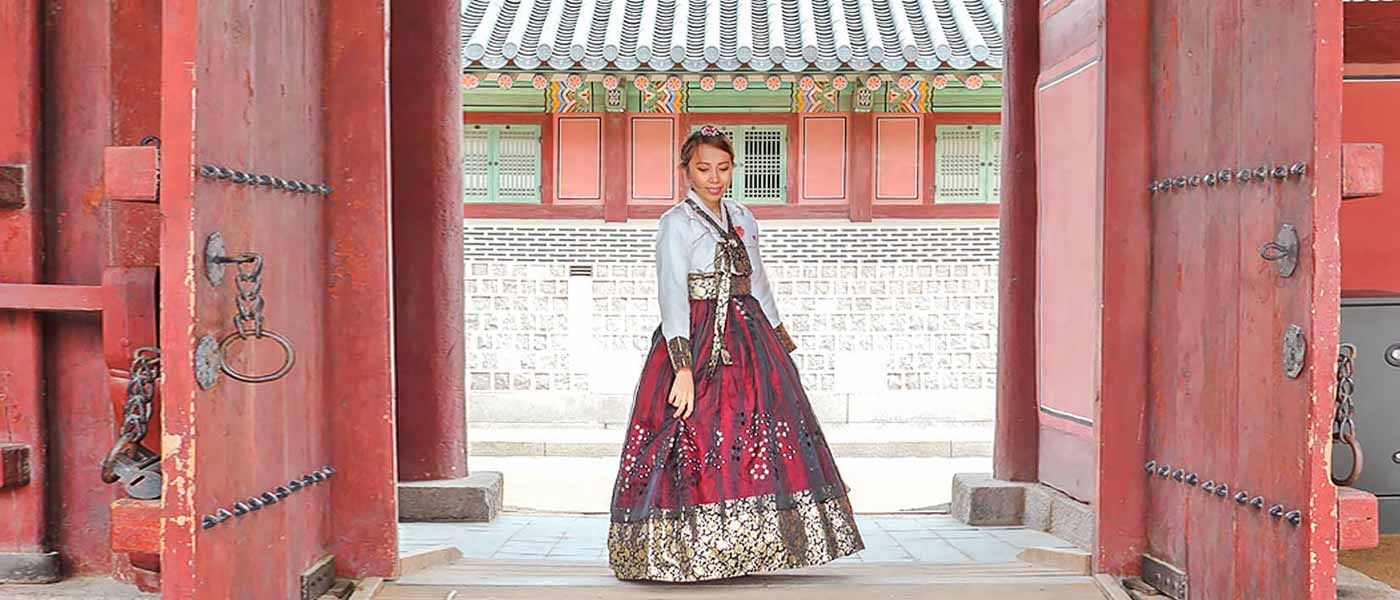
As you would see on the online booking platform , Seohwa Hanbok has 3 rental options: 4 hours, 1 day, or 2 days .
NOTE: If you have purchased the Discover Seoul Pass (no matter if it’s the 24H or 48H option), it’s preferable that you do NOT activate it on this day because you’ll already be given FREE entry to 4 of the ‘Five Grand Palaces’ if you’re wearing a hanbok. Not to mention that this whole hanbok activity will already likely fill up your whole day, so it’s best to activate the pass the next day. . Unless of course, you plan to avail the FREE hanbok rental use instead that’s under the Discover Seoul Pass’ perks. Personally, I think it’s best that you avail a hanbok rental separately for longer hours because the free hanbok rental under the pass is only for 90 minutes).
Once you are clad in a hanbok of your own choosing, I recommend doing the following route:
- The Changing of the Royal Guard ( Sumunjang ) ceremony is held for FREE daily, except Tuesdays, at 10:00AM and 2:00PM in front of Gwanghwamun or the main gate of Gyeongbokgung. If you can’t make it to these time slots, you can also witness a Guard-on-Duty Performance at Gwanghwamun gate at 11:00AM and 1:00PM or a Sumungun (Gatekeeper) Military Training in Hyeopsaengmun Gate at 09:35AM and 1:35PM.
- If you’ve got time, you can check out the huge golden King Sejong Statue at the nearby Gwanghwamun Square. (King Sejong is best remembered as the inventor of ‘Hangeul’ or the Korean alphabet.)
- ★ Changdeokgung: This was the 2nd palace that was built after Gyeongbokgung and it has since been recognized as a World Cultural Heritage site by UNESCO in 1997. An interesting feature of this place is its ‘Secret Garden’ because there are only a limited number of admission slots per day that are given out. If you’re lucky, you can get the chance to go in if you want to!
- Deoksugung: This palace is famous for its picturesque stone-walled road (which is often featured in K-dramas like Goblin). And much like Gyeongbokgung, Deoksugung Palace has a Changing of the Royal Guards Ceremony and it is held at 11:00AM, 2:00PM, and 3:30PM daily, except on Mondays.
- Changgyeonggung: This used to be the residential quarters for queens and concubines of the king, and it later became a park with a zoo and a botanical garden during the Japanese colonial rule (today though, the zoo and garden are relocated to Seoul Land ).
- Gyeonghuigung: Located near Deoksugung Palace, this site served as the secondary palace for the king in the latter half of the Joseon period. For a time, Gyeonghuigung was of considerable size but most of its major structures have long been disassembled and moved to other parts of Seoul. .
- To get here, look for Bukchon-ro street. It will be hard to miss because the tourism board had recently appointed staff there in red clothing to help tourists and distribute maps. Basically, there are 8 major viewpoints to see in Bukchon Hanok Village and those that you must NOT miss are the Gaehoe-dong areas that are typically appointed as Views #3 to #7. If you’re coming with elderly companions, take note that there are a few uphill climbs in this area.
- Unlike other hanok villages (like Namsangol Hanok Village), Bukchon was not built for tourists as it is rather a residential village inhabited by Seoulites. Therefore, make sure to keep quiet so as not to disturb the locals.
- As you leave Bukchon, drop by the nearby neighborhood of Ikseon-dong . Much like Bukchon, it’s one of the oldest hanok villages in Seoul; but in case you want to escape the crowds, it would be a great idea to explore this hidden gem! .
- Lunch: You can either have it at Bukchon Hanok Village or at Insa-dong. There are a lot of cafes and restaurants in these areas so you won’t have a difficult time picking a place; though if I may put in my two cents, do check out Jokagbo at Bukchon (across the street near the entrance to the village) or Gogung at Insa-dong for their bibimbap (mixed rice bowl). For other food or restaurant options, click the “Extra Days” tab on top of this section — or go to this link to see a list of restaurants that you can book online at special deals. .
- Drop by Insa-dong: (Nearest subway station: Anguk Station, Exit #6) As you make your way to the last stop of this route, you must not skip on the neighborhood of Insa-dong in the Jongno-gu district of Seoul. After all, its streets are one of the best places in Seoul when it comes to culture and crafts (perfect for souvenirs!). If I may also share another tip, try to stop by Ssamziegil which is a unique building wherein each of its levels is connected in the form of a spiraling walkway! .
- (OPTIONAL) Visit Namsangol Hanok Village: (Nearest subway station: Chungmuro Station, Exit #3) Located at the foot of Namsan, this village was built to feature 5 traditional houses of different social classes from the Joseon era, all relocated to this spot from different locations in Seoul in order for guests to understand the daily lives of its past people. Of all these 5 houses or hanok, only one is open to the public which is the house of Yoon-ssi of Okin-dong. It has been transformed into ‘Yoon’s Tearoom’ where visitors can learn about Korea’s tea culture. If you’re interested, you could join the tea ceremony program for only ₩7,000. (For a list of other activities in this village, see this link ).
Is it possible to just try on a hanbok for FREE? Yes. If you hold a Discover Seoul Pass , you can wear a hanbok of your choice outdoors for 90 minutes via HANBOKNAM, or take photos with a hanbok in the indoor studio of Namsan Seoul Tower Hanbok Experience Center . However, if you do not have a Discover Seoul Pass, Korea Tourism Office’s Main HQ allows you to wear simple hanbok and take shots of yourself in it indoors. . Is there a service where I can just rent a hanbok indoors and have a professional photographer take photos of me? Of course! You can book this kind of experience online for just ₩15,000~ (or USD$14~ / Php 730~). It even has the option of doing outdoor shots.
◘◘ Visit the awe-inspiring structure of Dongdaemun Design Plaza
(Nearest subway station: Dongdaemun History & Culture Park Station, Exit #2)
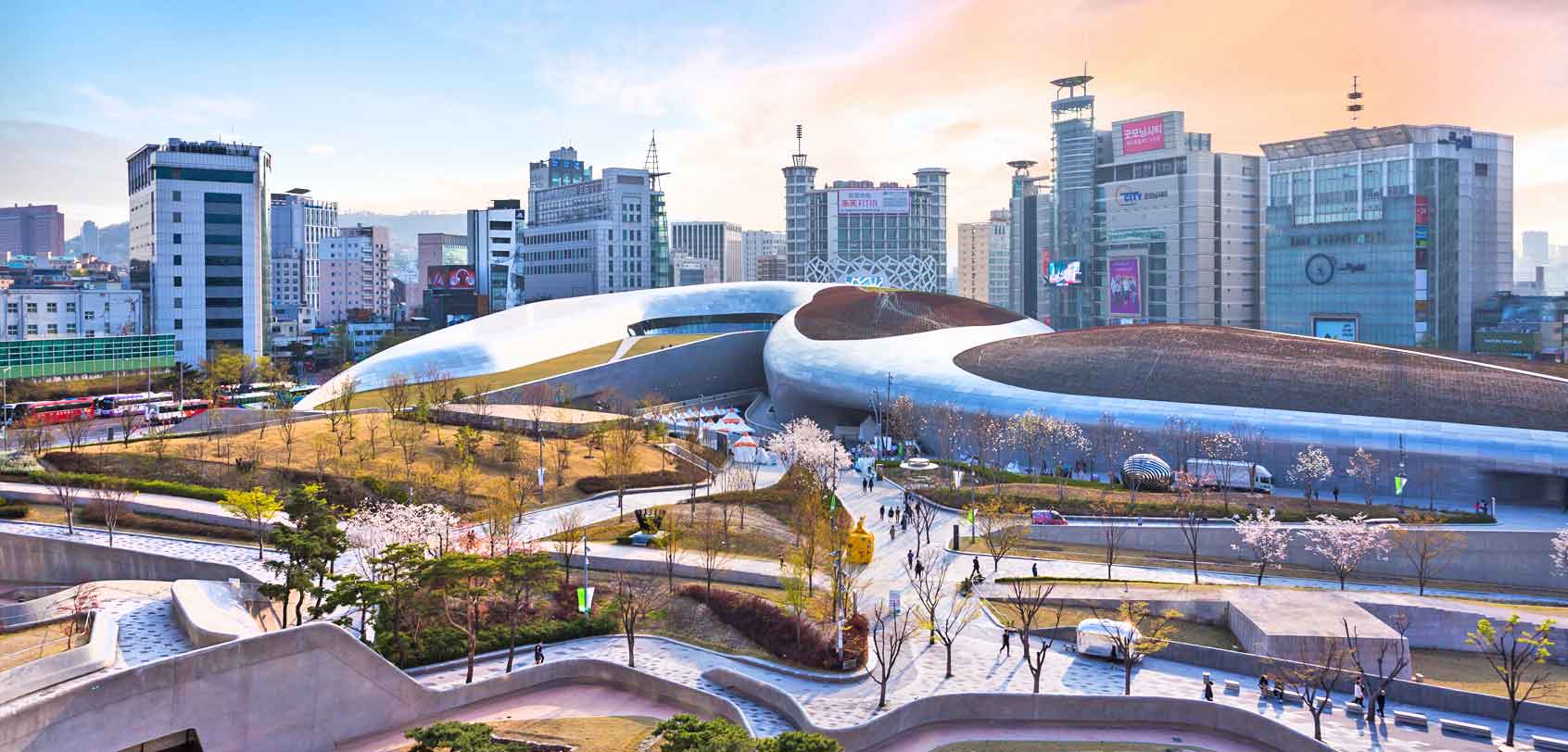
Also called “DDP”, this structure is a new major urban landmark in the heart of Seoul which has a distinctly futuristic design made by world-renowned architect, Zaha Hadid. As such, it’s not strange that it is one of the most Instagrammed locations in Korea.
Other than enjoying its grand outer architecture for your Seoul itinerary, you can also stroll through DDP’s huge 5 halls namely, Art Hall, Museum, Design Lab, Design Market, and Dongdaemun History and Culture Park — places where you can shop and watch various exhibitions, fashion shows, and performances among many others.
- From late May to late October every year, Seoul Bamdokkaebi (Goblin) Night Market will open in DDP from 6:00PM to 11:00PM, so don’t forget to make a stop here to not only buy a variety of food and goods but to also enjoy the various performances made available during this event.
- TRIVIA : This display was first put up on National Liberation Day in 2015 which is in celebration of Korea’s 70th year of independence. Hence, the number of 25,550 comes from 365 days multiplied by 70.
BONUS: If you still have some time, drop by Ihwa Mural Village, a picturesque neighborhood in Seoul that is famous for its amazing murals — as well as for its fascinating cafes and shops. It’s no wonder that a lot of K-dramas and movies have started to do their filming here. You can basically find this near Naksan Park (which also yet another hidden gem that provides great views of the cityscape).
◘◘ Eat and shop through any of Seoul’s night markets
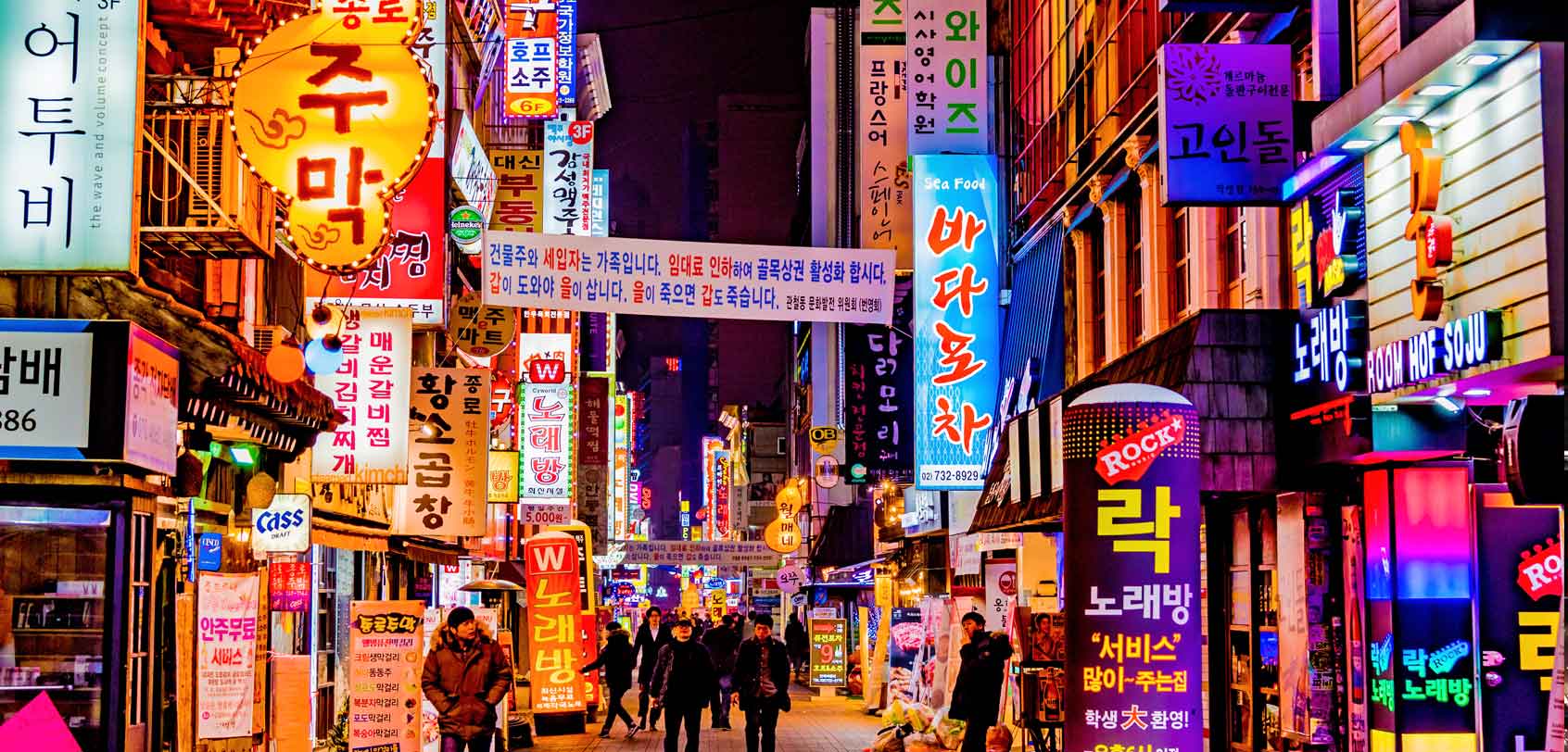
Like the rest of Asia, Seoul has no shortage of vibrant night markets, so for dinner, go and drop by any of the following spots ( it’s best to choose only one! )
- Bamdokkaebi (Goblin) Night Market: (Nearest subway station: *various spots*) Like I’ve written above, this night market opens from May to October. It originally opened in Yeouido (Yeouinaru Station, Exit #3) but has since expanded to several locations such as DDP. The other remaining places would be Cheonggyecheon Stream (Jongno5(0)ga Station, Exit #7) and Banpo Hangang Park (Express Bus Terminal Station). .
- Dongdaemun Night Market: (Nearest subway station: Dongdaemun History & Culture Park Station, Exit #4) Take note that this is different from the night market found in DDP. Apart from the retail haven found in this vicinity, you will also find the ‘Open market’ with its bright yellow tents, all selling various apparel, souvenirs, and items at affordable prices starting from 10:00PM up to 5:00AM. If you’re rather looking for delicious Korean eats during your Seoul itinerary, drop by Mukja Golmok (“Let’s Eat Alley” at exit #8 of Dongdaemun Station) to feast on snacks like tteokbokki (rice rolls). .
- ★ Myeongdong Night Market: (Nearest subway station: Myeongdong Station, Exit #7) Even if this is not one of those ‘traditional’ night markets, it remains to be a popular destination for travelers as it is set in the bustling shopping district of Myeongdong that holds some of the biggest stores like Lotte and Shinsegae as well as cosmetic brands of all kinds. Starting from 5:00PM and onwards, you will start to see food stalls filling up the main street with fares like gyerangbbang (Korean egg bread), dak-galbi (spicy stir-fried chicken), etc. .
- ★ Namdaemun Night Market: (Nearest subway station: Hoehyeon Station, Exit #5) Open from 11:00PM till 4:00AM, this traditional night market is the largest in Seoul and it holds every possible thing that you can think of — from food to clothing, they have it all! .
- Gwangjang Market: (Nearest subway station: Jongno 5(o)-ga Station, Exit #8) If Namdaemun is the largest, then Gwangjang would be the oldest in Seoul, making it a common go-to place for many Korean shoppers. You can actually find this close by Dongdaemun and DDP so it’s possible to check off several of those night markets in the same night if you will it so! (TIP: This place is best if you’re looking to buy a hanbok for yourself). .
- ★ Noryangjin Fish Market: (Nearest subway station: Noryangjin Station, Exit #1) Operating 24 hours a day, this place is more than just a night market. If you come in the early morning, you can witness a bustling fish auction (reminiscent of Japan’s Tsukiji Fish Market). Anyhow, the fun part about this place is that you can buy some fresh seafood and then have it cooked by a restaurant located on the 2nd floor — and if you’re brave enough, maybe you can try the infamous Korean activity of eating a LIVE octopus?
TIP : Want a hassle-free foodie experience? With the help of a local guide, you can join a Korean Food Walking Tour or a Korean Night Dining Tour .
◘◘ Watch the famous Nanta Show
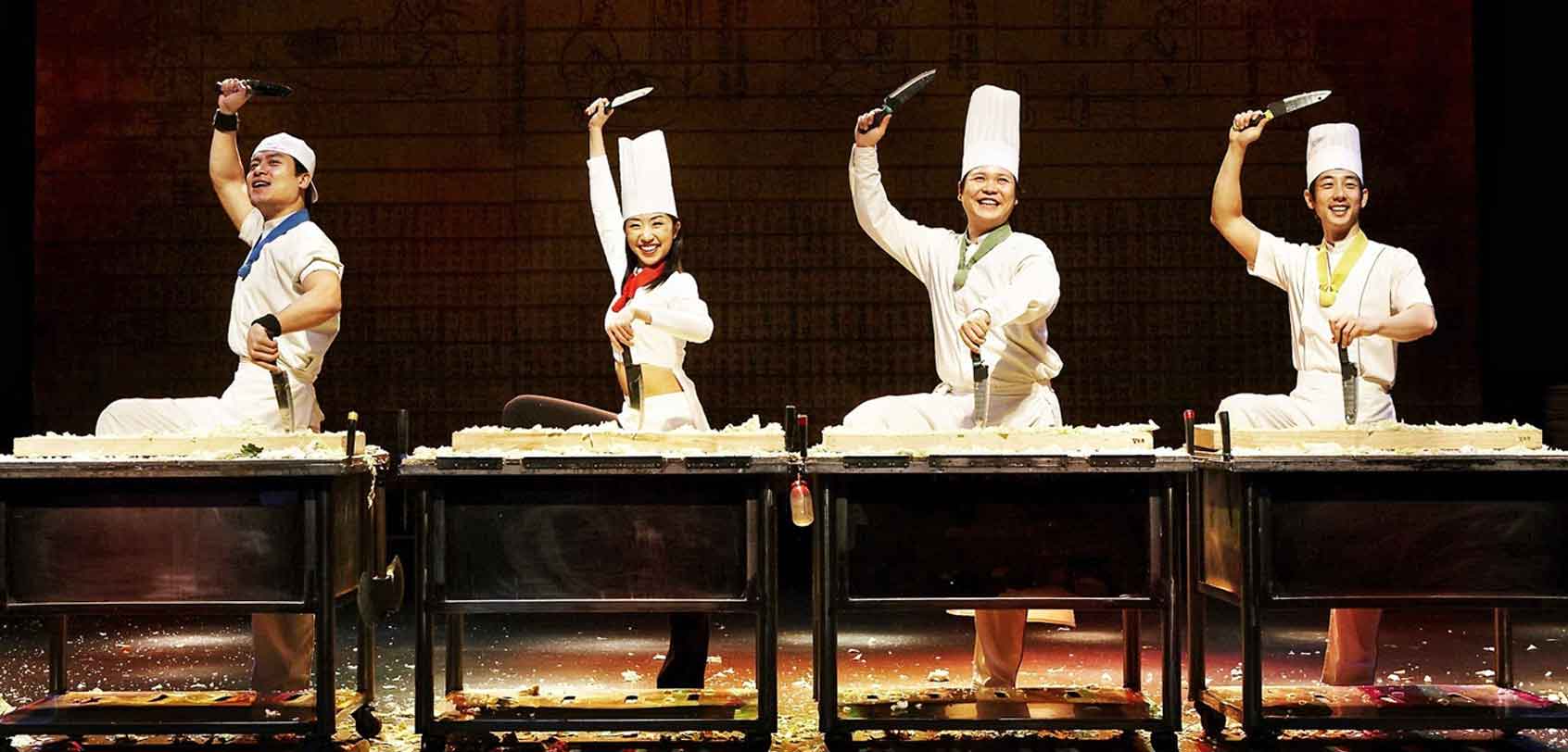
If there’s one show that you should NOT miss for your Seoul itinerary, it will be witnessing the award-winning long-running NANTA Show at Myeongdong Theatre. This is basically a non-verbal comedy show (so it’s fine even if you don’t know Korean) that incorporates traditional ‘ samul nori ‘ rhythm (which is a genre of percussion music distinct to Korea) as they do a slapstick play that mimes the story of cooks who are preparing for a wedding.
I’ve seen this show myself and it was quite entertaining as I saw knives fly and fire blasting from pots — but don’t worry, it’s all safe! But I must say that it did have a distinct sense of humor that may or may not work for you. Either way, it’s an energetic performance that has garnered distinctions and awards from Edinburg Fringe Festival and on New York’s Broadway, so I say: give it a try!
NEAREST SUBWAY: Myeongdong Station, Exit #7 BOOK: Online to get 30% off on tickets
DAY 2: “Discover” more of Seoul!
NOTE: If you have purchased the Discover Seoul Pass (no matter if it’s the 24H or 48H option), this would be a good day to start its activation.
◘◘ Explore and shop in Myeongdong and Hongdae

Myeongdong: (Nearest subway station: Myeongdong Station) This is is arguably the shopping mecca of Seoul and its 2 main streets meet in the center — the first spanning from Myeongdong Subway Station and the second from Lotte Department Store at Euljiro.
For the shopaholics, there is a wide range of branded shops and department stores that line Myeongdong’s streets and alleys (e.g. Lotte Department Store, Shinsegae Department Store, Noon Square, etc.), and they are often set relatively cheaper than the other shopping areas in the city like Cheongdam-dong.
Of course, let’s not forget that Myeongdong is a beauty lover’s dream too given the number of Korean cosmetic stores that regularly hold insane sales for their high-quality products.
As an example, I went here to shop for face masks and one piece averaged at only USD$0.40~ or Php 20~! Some of the top stores you need to check are: Innisfree, Nature Republic, Holika Holika, Tony Moly, Nature Republic, and Laneige. (If you have heard of the Instagram-famous place called as Style Nanda Pink Hotel , you can find it here in this neighborhood or ‘dong’).
TIP : Try to NOT buy from the first shop that you set foot into because most of the time, they will hand out free samples and masks, which could be quite a treat! In fact, I know that some people would hop from store to store just to collect samples, haha. Anyhow, in case you want to check out other places because you’ve got some time, shops in Hyehwa and Sincheon neighborhoods can have cheaper cosmetic products too. And oh, of course, do NOT ever forget claiming your tax refund!
Hongdae: (Nearest subway station: Hongik University Station, Exit #9) It’s no surprise that this area is often compared to Japan’s Harajuku because of its hip and youthful ambiance — with a dash of unique cafes and indie fashion shops here and there. Aside from strolling through ‘ Hongdae Walking Street’, ‘ Picasso’s Street ‘ and ‘ Club Street’ , below are some of the places in and around Hongdae that you should consider stopping by for your Seoul itinerary:
- Hongdae Free Market: Open on Saturdays from March to November at Hongik Children’s Park. You will find here an array of local artist works.
- Trickeye and Ice Museum: TrickEye museum is an interactive 3D space that gives off impressive optical illusions; whereas Ice Museum, as the name implies, is a space where you can enjoy a cool icy environment (e.g. a living room with a TV and couch made of ice and more). Entering these places is free if you hold a Discover Seoul Pass , but if you don’t have the pass, you can reserve your tickets online .
- If you’re looking to spend some time in cute cafes, go to ‘ Chuu ‘ or ‘ Zapangi’ .
BONUS: Ewha Woman’s University is an educational institute with picturesque grounds, but more than this, it’s actually smacked in a shopping area that sells a variety of affordable and stylish clothes for young people; therefore, this is also a good place to shop.
◘◘ Get lunch
It’s time to feast on a delicious Korean BBQ meal! While you’re already in Hongdae, try out either of these places: Gogigo or Old House Charcoal Meat Restaurant .
For other food or restaurant options, click the “Extra Days” tab on top of this section — or go to this link to see a list of restaurants that you can book online at special deals.
◘◘ Make full use of your Discover Seoul Pass
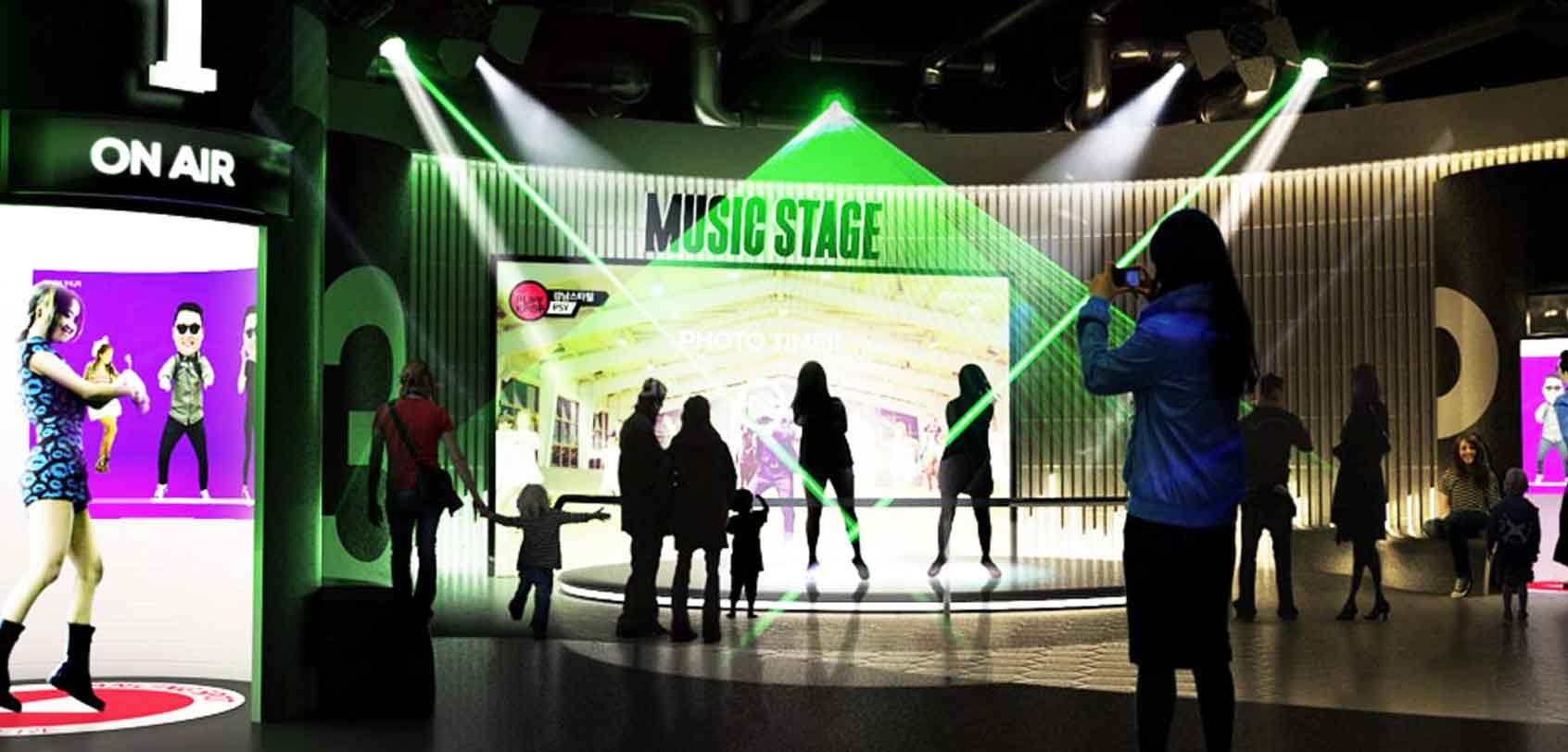
If you’ve followed my advice and got yourself a Discover Seoul Pass , you can enter any of the establishments below for FREE during your Seoul itinerary! Take your pick from any of the following to fill up the rest of your day ( best to pick 2 at most ).
For a complete list of FREE admissions under the Discover Seoul Pass, you can also visit this page .
- MBC World: (Nearest subway station: Digital Media City Station, Exit #9) Are you a fan of K-pop, K-dramas, or Korean stars — or just ‘ hallyu ‘ (Korean Wave) in general? Then MBC World is a great destination for your Seoul itinerary, as it will give you the chance to experience hologram K-pop concerts, virtual reality drama sets, and more. (If you don’t have the Discover Seoul Pass and want to separately book a ticket, go here ) . .
- SM Town Museum: (Nearest subway station: Samseong Station, Exit #6) Still in line with the ‘hallyu’ fever, this place is dedicated to famous K-pop artists under the powerhouse of SM Entertainment in South Korea. Avid fans can tour through their training rooms, recording rooms, and so much more. (If you don’t have the pass and want to separately book a ticket for this, go here ) . .
- Grévin Museum: (Nearest subway station: Euljiro 1-ga Station, Exit #1) This is like Korea’s version of Madam Tussauds. You can find about 80 wax figures of Korean and international celebrities, as well as several thematic interactive experiences. (If you don’t have the pass and want to separately book a ticket, go here ) . .
- 63 Square: (Nearest subway station: Yeouinaru Station, Exit #4) Other than gaining access to panoramic views of Seoul, you can also enter in 63 Square the first aquarium in Korea called Aqua Planet 63. If you’re a K-drama fan, this is actually the aquarium used in ‘Legend of the Blue Sea’ and where a Mermaid Show is regularly held. (If you don’t have the pass and want to separately book a ticket, go here for combination tickets or here for the aquarium only. .
- COEX Aquarium: (Nearest subway station: Bongeunsa Station, Exit #7) This place has the largest collection of marine life in Korea and you can watch feeding shows and interactive exhibits here too. (If you don’t have the pass and want to separately book a ticket, go here ). .
- Seoul City Tour Double-Decker Bus: Go on a hop-on-hop-off bus tour through the center of Seoul to get a glimpse of all of its past and present glory. (If you don’t have the pass and want to separately book a ticket, go here ). .
- Alive Museum: (Nearest subway station: Euljiro 3(sam) Station, Exit #1) This place is similar to TrickEye Museum but it is arguably larger with several other exhibits such as the ‘Dynamic Maze’ (where participants must work together to overcome challenges) and the ‘Black Wonderland’ (where fairy tales like Alice in Wonderland, Frozen, Cinderella and Aladdin can be experienced in the dark ). If you don’t have the pass and want to separately book a ticket, go here . .
- Seoul Zoo and Skylift: (Nearest subway station: Seoul Grand Park Station, Exit #2) Seoul Zoo is South Korea’s largest zoo with over 330 species of animals, inclusive of a botanical garden and a forest park. The icing on the cake? You can even ride the Sky Lift which can transport you to several places such as the Seoul Land theme park and more. (If you don’t have the pass and want to separately book a ticket for your Seoul itinerary, go here ). .
- Running Man: (Nearest subway station: Euljiro 1-ga Station, Exit #3) Do you want to be a part of Korea’s popular variety show, Running Man? Well with this thematic experience, you can do so! This will surely be a hilarious and fun adventure for you and your travel companions as you make your way through 6 zones, including Maze Battle. (If you don’t have the pass and want to separately book a ticket, go here ). .
◘◘ Visit Namsan Park and N Seoul Tower
(Take Namsan Shuttle Bus, Circulation Bus No. 2, 3, or 5)

Mt. Namsan’s Namsan Park is a symbolic place in the center of Seoul. To get up here, you can ride a cable car, a bus, or just simply walk up its stairway path. Most visitors come to this place to enjoy nature, to see the city skyline, or to do some of the hiking trails — but a majority makes a stop at the famous N Seoul Tower which is the first tower-type tourism spot in South Korea.
Rising at almost 480m above sea level, it is certainly one of the tallest towers in Asia. Once you set foot on its premises during your Seoul itinerary, you can explore its other attractions such as the LED tunnel, Hello Kitty Island, Ssentoy Museum & Showroom, and more.
- BOOK: Online to get a discounted ticket to the tower’s observatory as well as grab great combo deals.
- TIP : Other than N Seoul Tower, you can also find Palgakjeong Pavillion (octagonal hall) and Bonghwadae (beacon mounds that were used to signal incoming enemy invasions in the past).
◘◘ Grab dinner
I have two options for you, depending on what you fancy:
- A traditional royal Korean cuisine dinner: Feast on fresh and high-quality Korean cuisine set in a traditionally-styled restaurant called Myongdongjeong . What’s more? You can also rent their hanbok for free while eating to really feel as though you’ve been transported to a royal palace. .
- A cruise buffet dinner through Hangang River: Hangang or Han River is a major river in South Korea, and it is best enjoyed during the night with Eland Cruise as you glide through the waters and taste a delectable food buffet. Before the end of your cruise, you can even witness a firework show and a front-row view on the colorful Banpo Bridge Rainbow Fountain Show. To reserve your spot, go here .
For other food or restaurant options, click the “Extra Days” tab on top of this section — or go to this link to see a list of restaurants that you can book online at special deals for your Seoul itinerary.
◘◘ Walk through Cheonggyecheon Stream
(Nearest subway station: Jongno5(0)ga Station, Exit #7 )
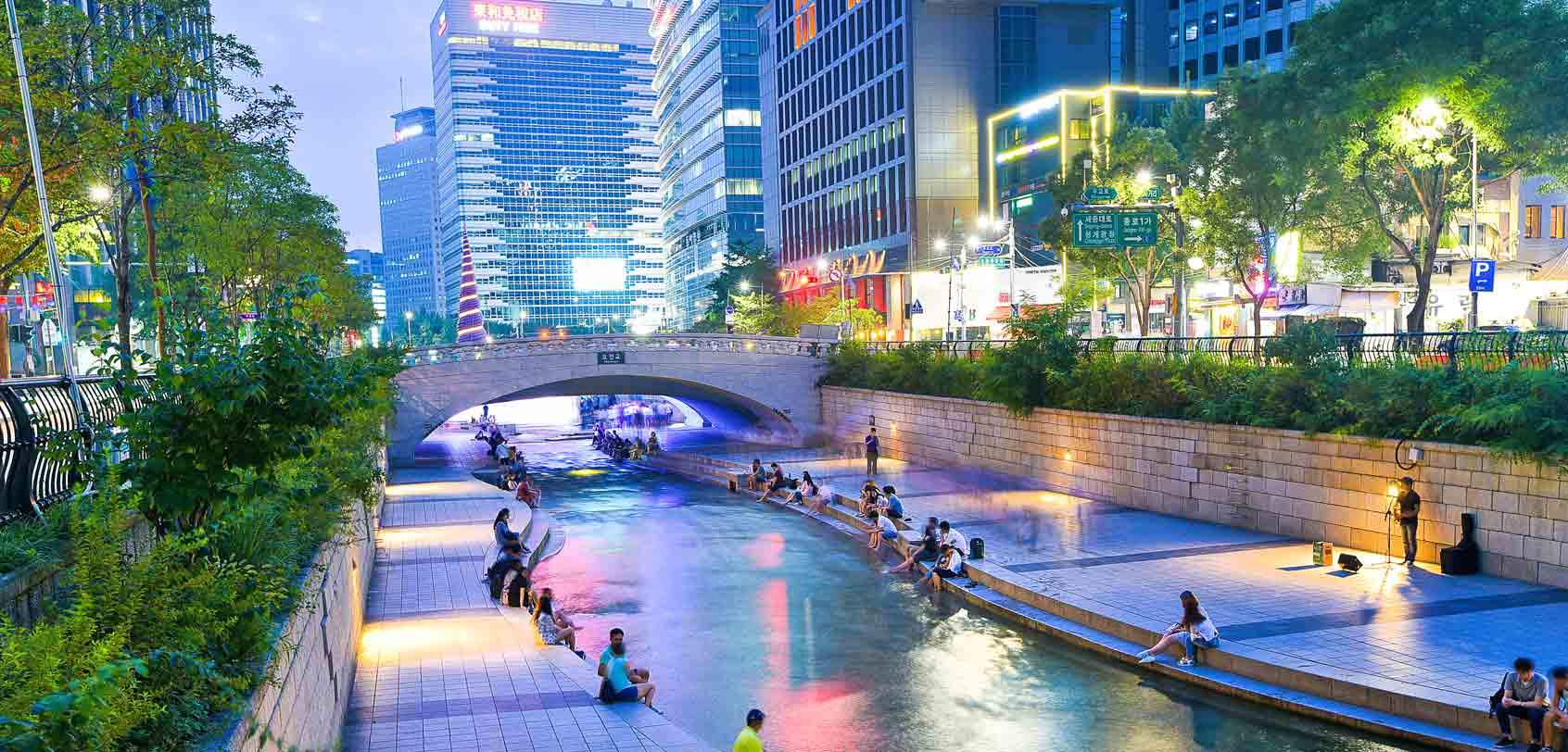
Cheonggyecheon is a picturesque 11 km-long modern stream that runs through a total of 22 bridges before flowing into the Hangang or Han River. Some examples of the beautiful bridges that it has are the Narae Bridge (which represents a butterfly) and Gwanggyo Bridge (depicting the harmony of the past and the future).
A lot of Seoulites wind down to this spot to chill and bask under the city lights, the lush ambiance, and the surrounding man-made waterfalls, if not partake in the Bamdokkaebi (Goblin) Night Market from May to October — so why not do the same during your Seoul itinerary?
DAY 3: A chill kind of day
◘◘ Do a “ Discover Seoul Pass ” or “Extra Days” activity
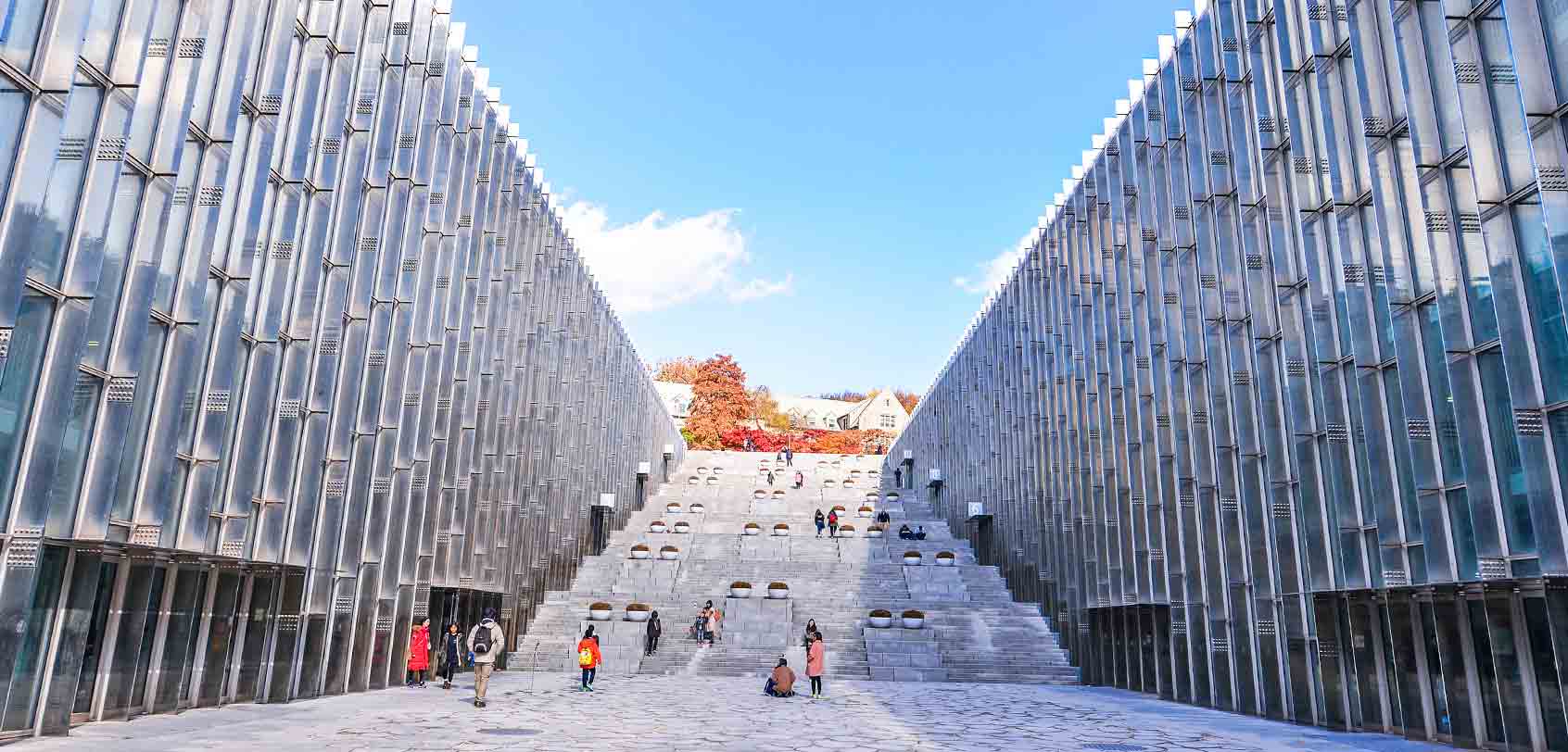
I recommend that you pick up an activity that you prefer from any of the previously listed things to do that I’ve written under Day #2’s ‘Discover Seoul Pass’ options of this Seoul itinerary. If not, you can also browse through the “Extra Days” tab above.
If you ask me, doing a cooking class , a kimchi class or a K-pop dance class will be a LOT of fun! (Read more about my Kpop dance class experience here ).
Did you ever want to try spending a day with a Korean ‘oppa’ (older brother)? Join this walking tour that’s led by a local guide!
◘◘ Grab lunch
- Hangaram: (Nearest subway station: Express Bus Terminal Station) Hangaram is a great choice if you want to taste some of the beloved Korean staples like bibimbap (mixed rice bowl), bulgogi (stir-fried beef), japchae (stir-fried glass noodles), kimchi (fermented vegetables) , etc. .
- Tosokchon Samgyetang: (Nearest subway station: Gyeongbokgung Station, Exit #2) Another Korean dish that you need to taste is samgyetang or ginseng chicken soup, and this restaurant is often lauded as the BEST place to eat in.
For other food or restaurant options, click the “Extra Days” tab on top of this section — or go to this link to see a list of restaurants that you can book online at special deals for your Seoul itinerary .
◘◘ Shop for highly discounted Korean food and snacks at Lotte Mart!
(Nearest subway station: Seoul Station, Exit #4 ). Naturally, going through any of the night markets I’ve listed under Day #1 will already grant you access to the cheapest food and snacks possible. However, other than those, I think that you should also go on a crazy chow shopping spree at Lotte Mart’s Seoul Station Branch! Why so? Well… as one of the leading discount store chains in South Korea, they sell ridiculously low-priced goods.
I swear to you, I bought only USD$20-worth of snacks here, yet it was enough to gift them to more than 20 people! (On top of the discounted items, you can get at most an 8% tax refund, and more to that, they also provide a free self-packing station so that you can pack all your purchased items in sealed boxes).
- For the must-buy snacks? It would be tteokbokki junk food, Binggrae banana-flavored milk, choco pies, yogurt jelly, honey butter chips, fire noodles (called also Buldak Bokkeum Myeon ), Lotte stick biscuits, and honey butter almond among many others!
- TIP: While you’re here, don’t miss dropping by the nearby newly-opened sky garden walkway called Seoullo 7017!
◘◘ Walk around Gangnam
(Nearest subway station: Gangnam Station)

There’s probably not a soul in this world who hasn’t heard of ‘Gangnam’ (and we have PSY to thank for that) .
For your info, Gangnam is Seoul’s upscale modern center that is home to high skyscrapers, designer brands, high-end restaurants, and pulsating nightclubs — so yes, it’s the home to many wealthy Koreans. In fact, you can think of it as the ‘Beverly Hills’ of Seoul. To make the most of your visit here during your Seoul itinerary, stop by the following ( it’s best to pick 3 at most ).
- Gangnam Terminal Underground Shopping Centre: You’ll find this from the moment that you step foot in Gangnam Station’s subway. With an array of accessories, clothing, cosmetics, and shoes, I have found a lot of sweet bargains here myself! .
- Gangnam Square: Right outside Gangnam Station’s Exit #5 is the spacious Gangnam Square which has a small section built as a tribute to PSY’s ‘Gangnam Style’ hit song, as well as the Gangnam-daero Road that’s speckled with various shops. .
- Apgujeong Rodeo Street and Cheongdam Fashion Street: (Nearest subway station: Apgujeong Rodeo Station, Exit #1 and Exit #3 respectively.) If you haven’t had enough of shopping but are looking for more upmarket shops. .
- Hallyu K-Star Road: K-pop fans must not skip this! Found between Apgujeong Rodeo Station and Cheongdam Station are adorable GangnamDols that are each autographed by K-pop groups like EXO, BTS, Super Junior, and more. For a detailed list, you can check here . .
- Garosu-gil Road: (Nearest subway station: Sinsa Station, Exit #8) This Gingko tree-lined street is a popular, trendy street in the city of Seoul and it is even often called an ‘artists street’ due to the number of quaint cafes and designer stores. Some charming cafes that you can choose from are Gingko Avenue, Line Friends Cafe, Cafe de Paris, and IKOVOX . .
- Starfield COEX Mall: (Nearest subway station: Bongeunsa Station, Exit #7) This mall is a shopping mecca, but more than this, it has interesting amenities too that are not limited to the COEX Aquarium and the Starfield Library. The latter is the newest built facility on the premises and it features 50,000 books and magazines in a grand yet relaxed setting. .
- SM Town Museum: (Nearest subway station: Samseong Station, Exit #6) This place is dedicated to famous K-pop artists under the powerhouse of SM Entertainment in South Korea. Avid fans can tour through their training rooms, recording rooms, and so much more. (If you don’t have the pass and want to separately book a ticket, go here ) . .
- Lotte World: (Nearest subway station: Jamsil Station) As Seoul’s largest indoor and outdoor amusement theme park, you will actually need a full day to enjoy this place — but I still felt like including this here, just so you know that it’s located in this Gangnam area. So if you have a spare day in your Seoul itinerary, it would be great to visit Lotte World. Another theme park choice would be Everland , but if you want other options, check the “Extra Days” tab above.
◘◘ Go up to Lotte World Tower
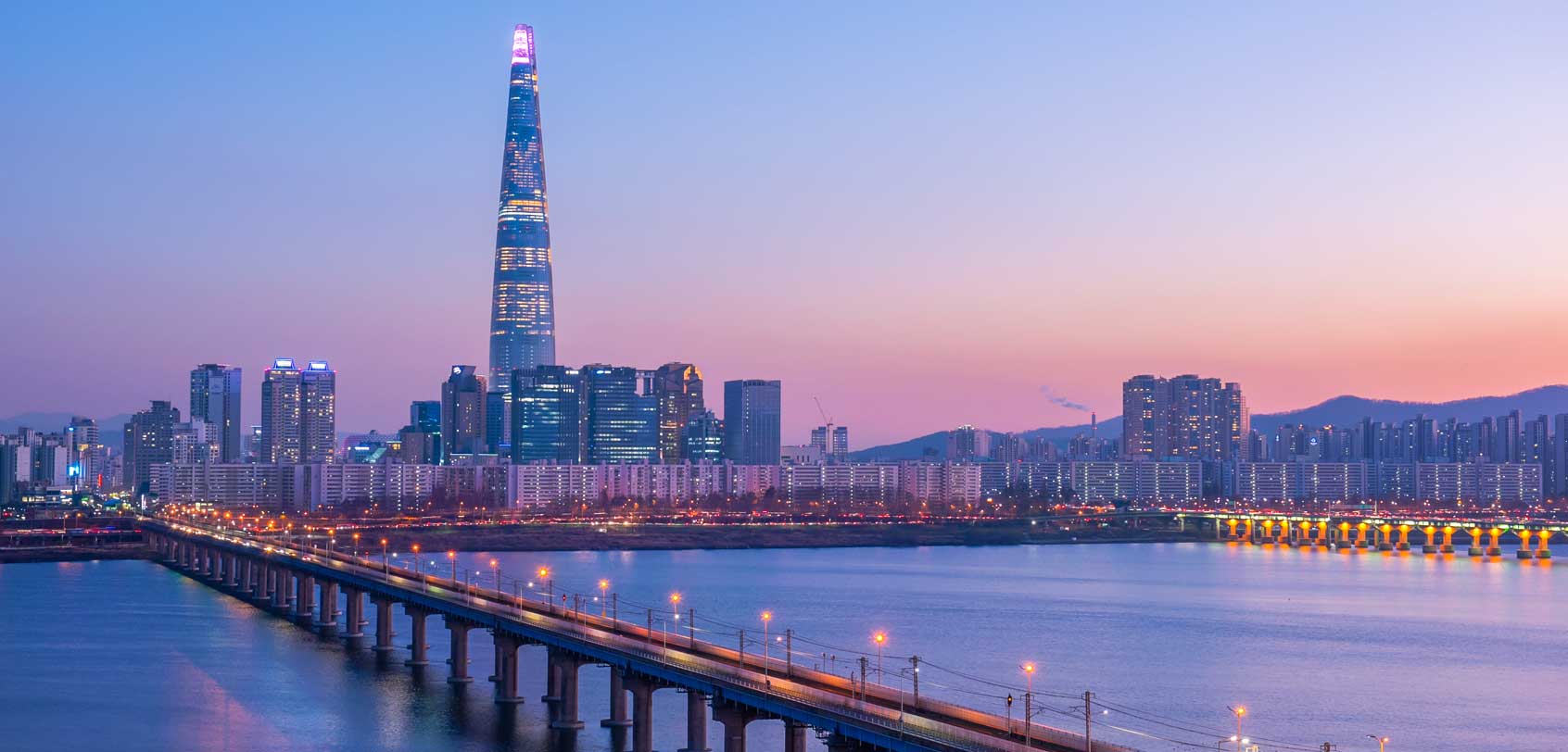
Towering at 554 meters, this new 123-floor skyscraper just opened last 2017 and it is currently the tallest building in Seoul and the 5th tallest in the world. It contains several cafes, galleries, a luxury hotel, a skywalk, and an observation deck.
Obviously, this is the best place for viewing panoramic views of the cityscape and I highly suggest that you go up to the observatory not only to enjoy the view with a cup of coffee but to also experience its glass floors! Though it was nerve-wracking at first, it was really cool to feel as though I was floating up in the air like that! (Another thing you can enjoy nearby is Lotte World Mall).
NEAREST SUBWAY: Jamsil Station, Exit #2 BOOK: ₩27,000 for adults and ₩24,000 for children (Pay less if you book online ).
BONUS : From April to October, head over to the Han River’s Banpodaegyo Bridge by 8PM (plays every 20 minutes until 9PM) to watch their famous Moonlight Rainbow Fountain show.
I think it’s time to have a meal with the guidance of a local during your Seoul itinerary, so why not try a Seoul street food tour for instance? If you’re not game for that, you can find other food or restaurant options under the “Extra Days” tab on top of this section — or go to this link to see a list of restaurants that you can book online at special deals for your Seoul itinerary.
DAY 4: All About JSA
◘◘ Visit the Korean Demilitarized Zone (DMZ)
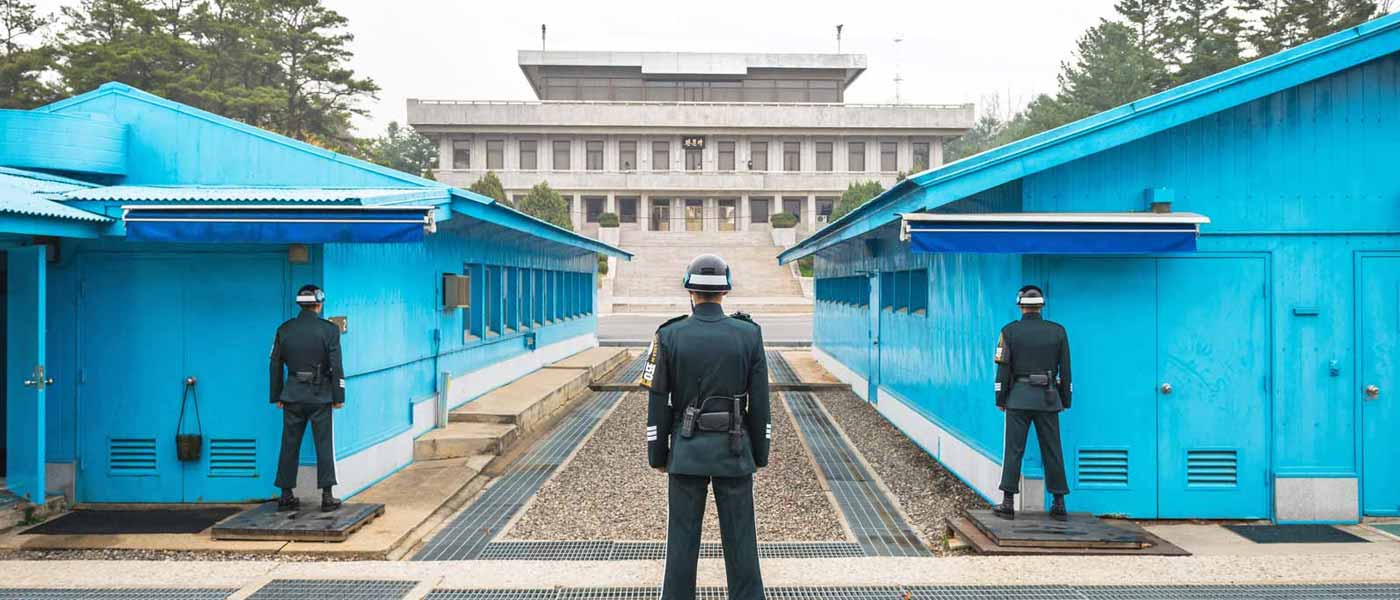
It’s no news that the Korean peninsula has long been divided into two countries: North Korea and South Korea. Unfortunately, it was not at all a peaceful separation given the infamous 250km-long buffer zone of the Demilitarized Zone ( DMZ ) that separates the two since 1953.
Today, it is referred to as the most heavily guarded area in the world with battle-ready armies, fences, landmines, and fences on both sides — it’s absolutely one of the scariest places in the world! …And yet, it continues to be a popular major tourist attraction in South Korea that attracts a lot of history buffs and curious folks worldwide who are seeking to witness this surreal land for themselves (people like me).
The available tours currently being held are as follows:
- Panmunjom Joint Security Area (JSA) Tour: This is the most sought-after tour by travelers to South Korea’s DMZ because this is the closest place to North Korean soil that anyone can step into without getting arrested or shot. A tour to JSA will only be possible through an organized tour that is approved by the government and it will basically take the guests to the iconic blue UN building that is smacked on the border — with both North and South Korean soldiers facing one another (as if they’re on a staring showdown). .
- North Korea Center of Unification Board: Shows over a hundred photos and documents showing the stark reality of North Korea.
- Mangbaedan Alter: The spot where Koreans separated from their families in the North. Koreans typically visit this place on New Year’s Day and Chuseok (Korean Thanksgiving) to perform ancestral rites to their home and relatives in the North.
- Bridge of Freedom: Where South Koreans crossed when they were released from North Korea. You will witness a lot of ribbons tied to the fences that each contain messages of hope, peace, and love.
- Dora Observatory: From here, visitors can look closer into North Korea with binoculars as they witness things like the North Korean propaganda village, Kaesong city, and others.
- Dorasan Station: This is the northernmost train stop on South Korea’s railway line and locals hope that it would one day connect North and South Korea when peace finally prevails.
It is possible to combine the two tours above for a whole-day experience during your Seoul itinerary (see here ).
BOOKING LINKS (use promo code AILEEN5OFF to get a 5% discount ) :
- Panmunjom Joint Security Area Tour (JSA) only = ₩85,000~
- Third Tunnel of Aggression only = ₩63,800~
- Panmunjom Joint Security Area Tour (JSA) & Third Tunnel of Aggression combo = ₩130,000~
◘◘ Visit a spa or a jjimjilbang
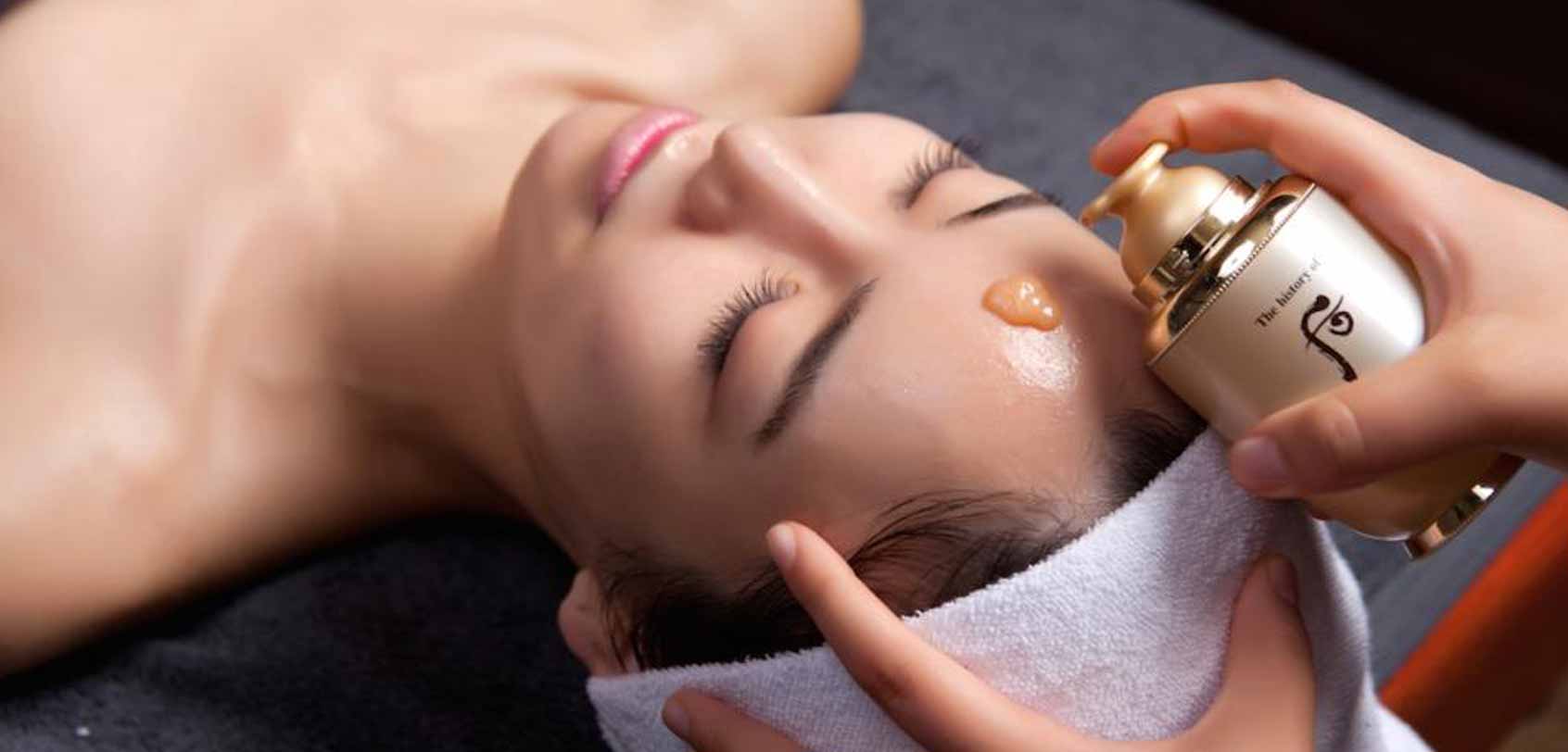
After your tense morning tour to DMZ, how about you relax and pamper yourself with Korea’s well-liked spa services? Apart from getting a Korean massage , I urge you to experience jjimjilbang or a large gender-segregated public bathhouse complete with hot tubs, showers, traditional Korean kiln saunas, and massage tables.
If you’re a fan of K-dramas, you will probably be familiar with this because it’s a common place that Koreans frequent for spa services. For this, you can visit Dragon Hill Spa (or if you hold a Discover Seoul Pass , it gives you free admission to Sealala jjimjilbang).
NEAREST SUBWAY STATION: Itaewon Station, Exit #3 BOOK: Go to this link to get a discounted rate
ALTERNATIVE : If you rather want to relax in nature during your Seoul itinerary, go over to the World Cup Park, a humongous space that used to be a landfill but has now been turned into a park with 5 different sections: Pyeonghwa (Peace) Park, Haneul (Sky) Park, Noeul (Sunset) Park, Nanjicheon Park, and Nanji Hangang Park. A crowd favorite would be Haneul Park as it’s the highest elevation of the five parks.
I have two options for you for your Seoul itinerary, depending on what you prefer:
- Buffet: Taste all kinds of gourmet food at Tavolo 24 .
- Korean gopchang: Taste the popular stir-fried Korean dish made up of small intestines from cattle or pork (often best paired with soju ) at Aunt’s Grilled Intestines Restaurant .
TIP : You can also check this link to see a list of restaurants that you can book online at special deals.
DAY 5: Day tour to Gapyeong County
◘◘ Explore Gapyeong County’s wonders

It’s time to venture out of Seoul’s busy metropolis to get some fresh air and tranquility. For this, a day trip to Gapyeong County’s top attractions is recommended for your Seoul itinerary!
READ: My detailed guide on this tour by clicking [ here ].
- Petite France: This is a charming place that serves as both a cultural village and a youth training facility with over 16 French-styled buildings. Petite France is also recognized as a top filming location for Korean dramas like ‘Secret Garden’ and ‘My Love from the Star’. With its European ambiance, it is also somewhat of a tribute to Saint-Exupery, the author of the famous French Novel: ‘Le Petit France’. ~Entrance fee: ₩10,000 adults / ₩5,000 children .
- Nami Island: A half-moon-shaped island nestling inside an artificial lake known for being the filming grounds of the well-known K-drama ‘Winter Sonata’. Nami Island is home to rows of majestic trees, roaming animals, and art exhibits, making it a sought-after destination in every season! I highly recommend that you rent a bike when you’re here; otherwise, there are other activities you can do such as water sports, trying on the roller skating rink, going to the shooting range, and more. ~Entrance fee: ₩13,000 .
- Garden of Morning Calm: This grand 30,000 sqm garden is open all year round and it is regarded as the oldest private garden in Korea with an artistic space that’s sure to leave anyone in awe. The Garden of Morning Calm becomes even more magical during winter (December to March) when they set up hundreds of multi-colored lights to create themed gardens, so make sure that this is on your Seoul itinerary! ~Entrance fee: ₩9,500 adults / ₩6,000 children .
- Gangchon Rail Bike: Built on a discontinued trail line, Gangchon Rail Bike is a fun attraction where you can pedal through old railroad tracks while taking in the amazing Bukhangang River scenery. Rest assured, it doesn’t require much effort to pedal the makeshift carts because the rail lines are slightly sloping downhill. ~Entrance fee: ₩30,000 for a two-seater .
- Edelweiss Park: Edelweiss Park is similar to Petite France, but instead, it focuses more on being a Swiss-based cultural village, so it’s filled with Swiss architecture, establishments, and sceneries. ~Entrance fee: ₩10,000 .
For a hassle-free experience on your Seoul itinerary, it would be advisable to go on a guided tour. Nowadays, there are different packages so feel free to take your pick from any of the combinations below (they often already include a delectable dak-galbi lunch, but there is also a halal option ; don’t forget to use promo code AILEEN5OFF to get a 5% discount ):
- (2 stops) Nami Island + Alpaca World
- (2 stops) Nami Island + Petite France
- (2 stops) Nami Island + The Garden of Morning Calm
- (3 stops) Nami Island + Alpaca World + The Garden of Morning Calm
- (3 stops) Nami Island + The Garden of Morning Calm + Gangchon Rail Bike
- (3 stops) Nami Island + Petite France + The Garden of Morning Calm
- (3 stops) Nami Island + Petite France + Gangchon Rail Bike
- (3 stops) PRIVATE TOUR: Nami Island + Petite France + Gangchon Rail Bike
- (4 stops) Nami Island + Petite France + The Garden of Morning Calm + Gangchon Rail Bike
If not, you can take the ‘Gapyeong Tourist Bus’ which can bring you to all of these locations for only ₩6,000 — the downside though is that the buses run only once every hour, and with the crowds that go to all of these places, it’s likely that the spots get filled quickly. (This is why I suggest going on a guided tour instead.)
I have two options for you, depending on what you prefer:
- Samgyeopsal : Taste this hearty grilled pork belly dish at Palsaik which is very popular with locals.
- Jokbal: Try this Korean dish consisting of soft pig’s trotters cooked in soy sauce and spices at Manjok Ohyang Jokbal .
TIP : You can also check this link to see a list of restaurants that you can book online at special deals for your Seoul itinerary. (Use promo code AILEEN5OFF to get a 5% discount).
Explore other TOP destinations in South Korea
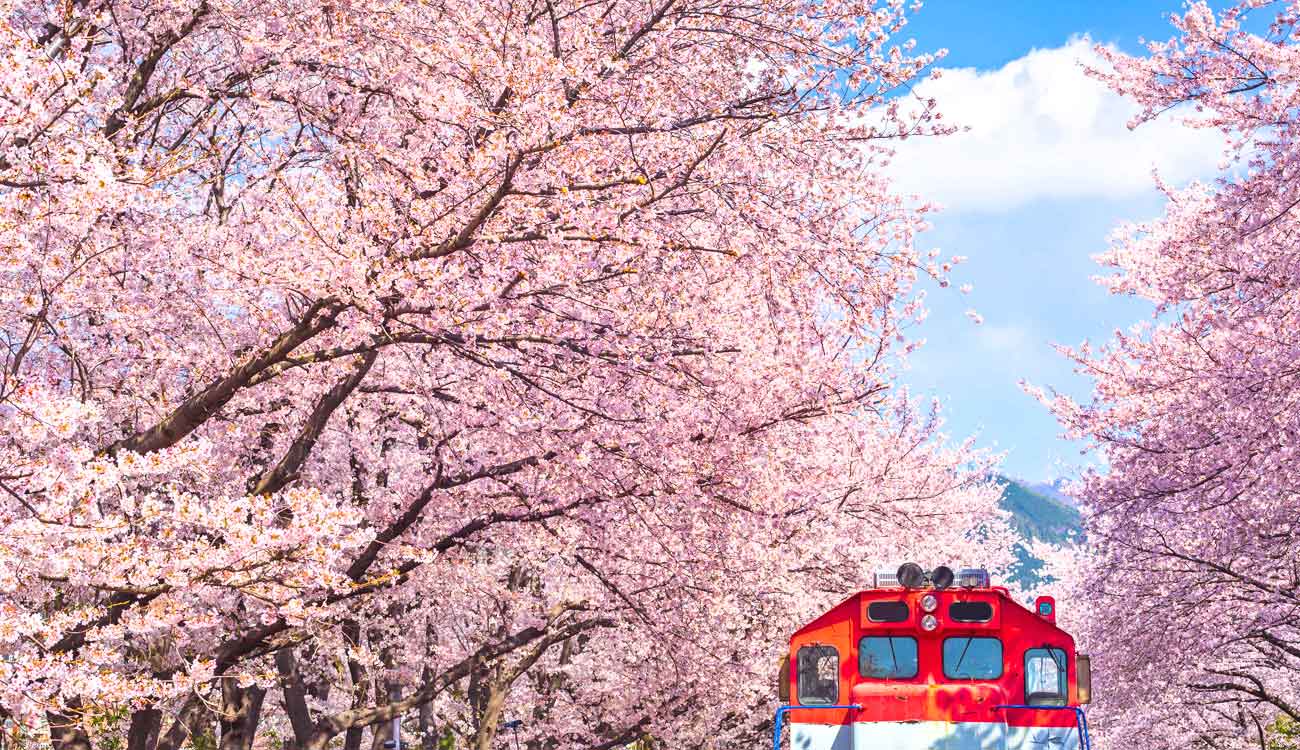
BUSAN Known for its colorful houses, mountains, and the largest fish market in Korea!
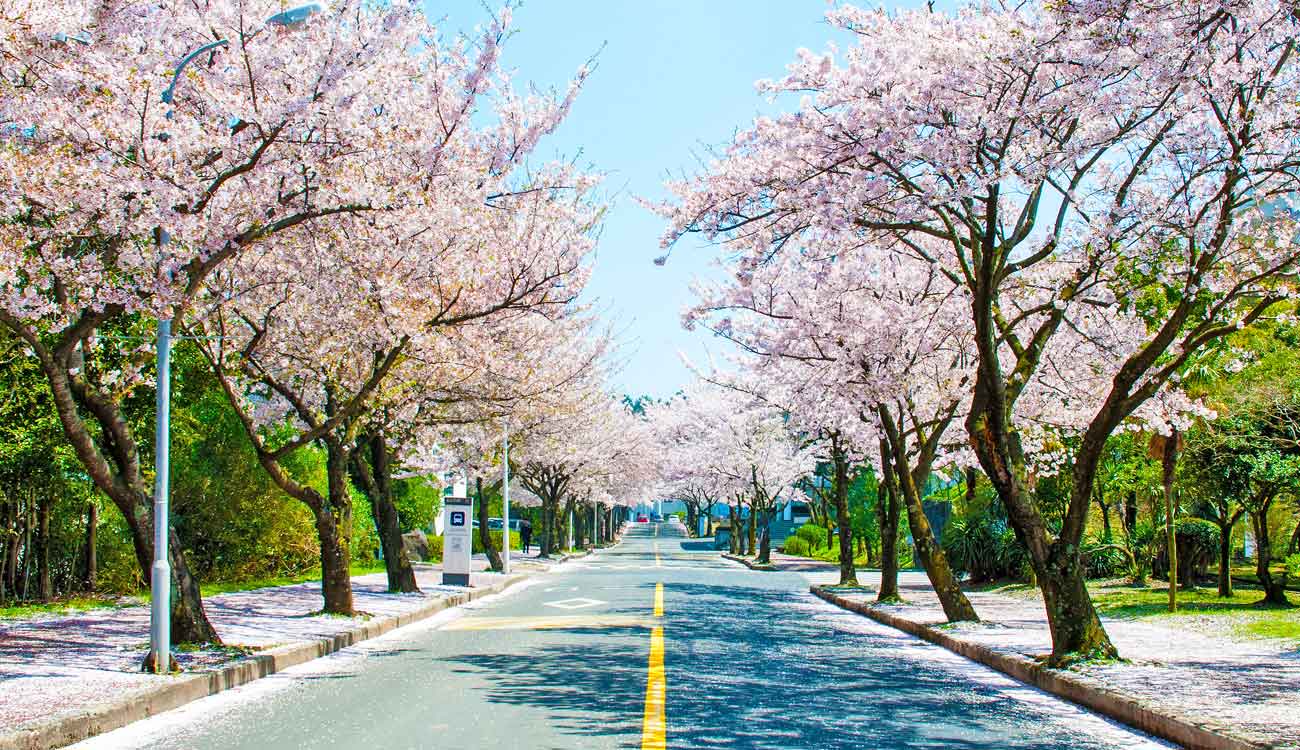
JEJU ISLAND South Korea’s top island destination beloved by tourists and locals alike.
TIP : Check out all of the top Instagram spots in Busan to fill up your feed and Seoul itinerary!
◘◘ Family Fun ◘◘
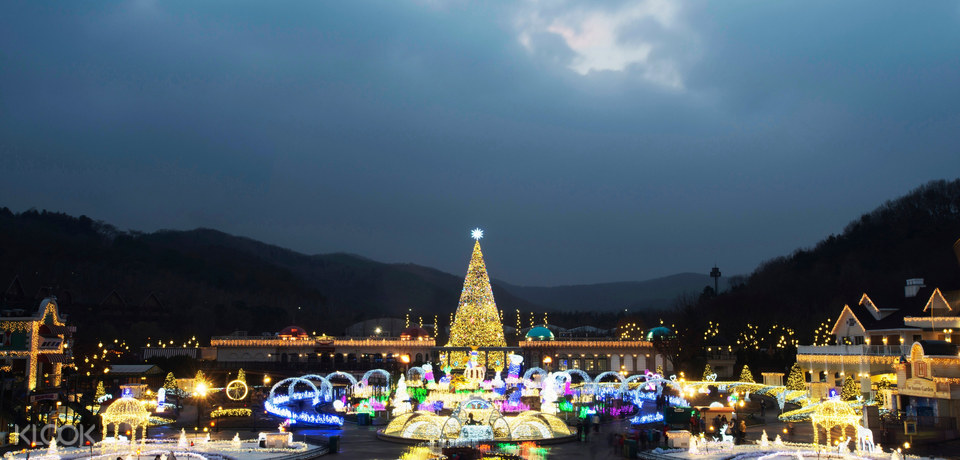
Everland Park South Korea’s largest attraction park.
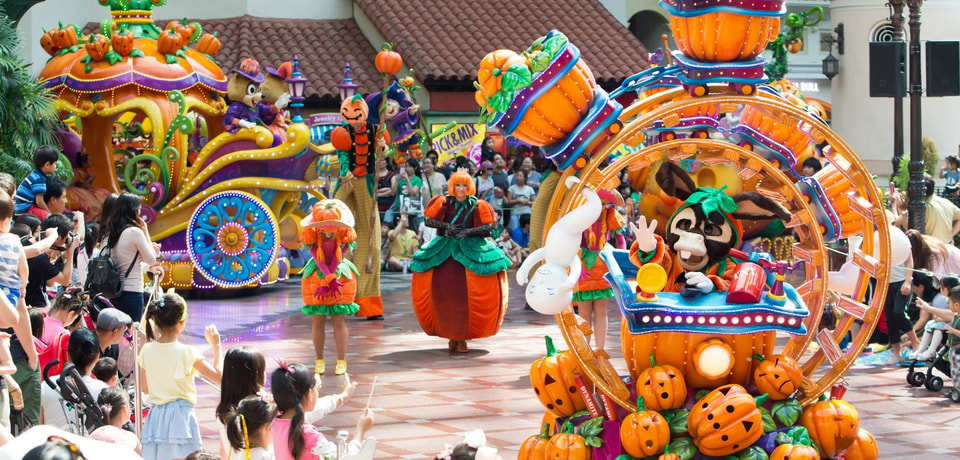
Lotte World Large indoor and outdoor theme park.
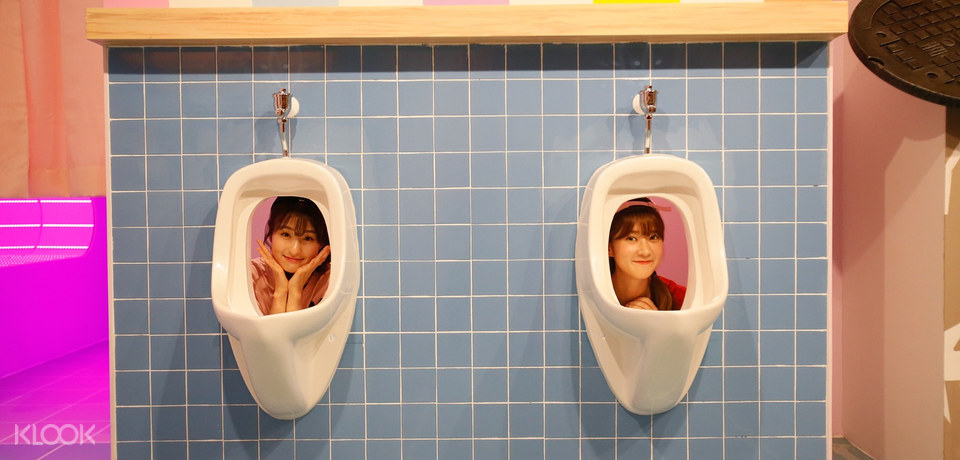
Poo Poo Land Unique and fun place for photo-ops and learning.
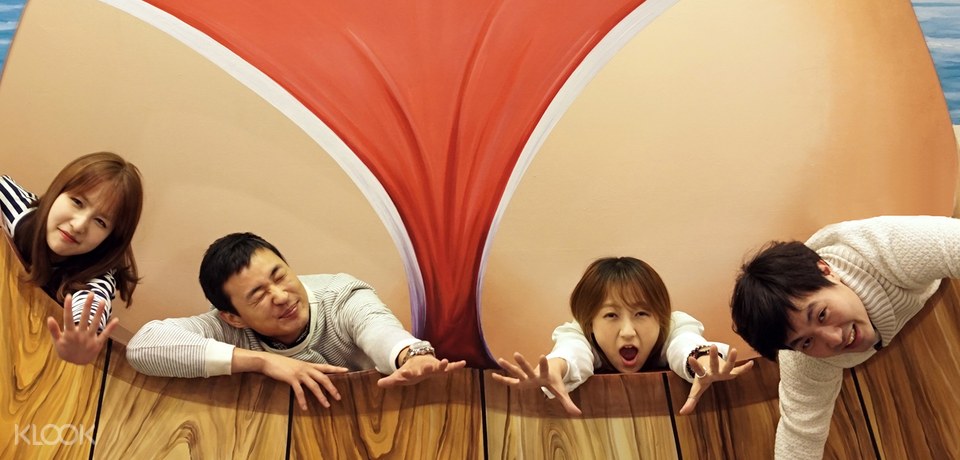
Love Museum Seoul’s first and only museum for adults!
◘◘ K-Drama & K-Pop ◘◘
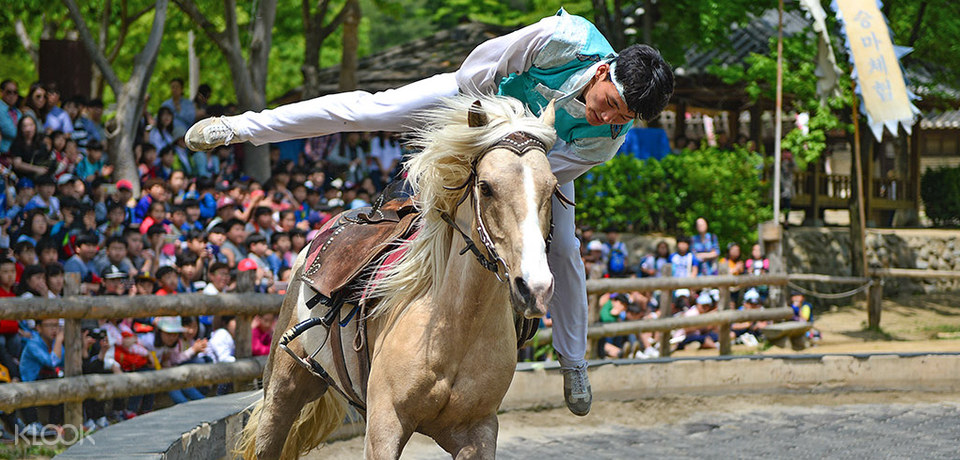
MBC Dae Jang Geum Park Tour Largest historical drama open set in Korea.
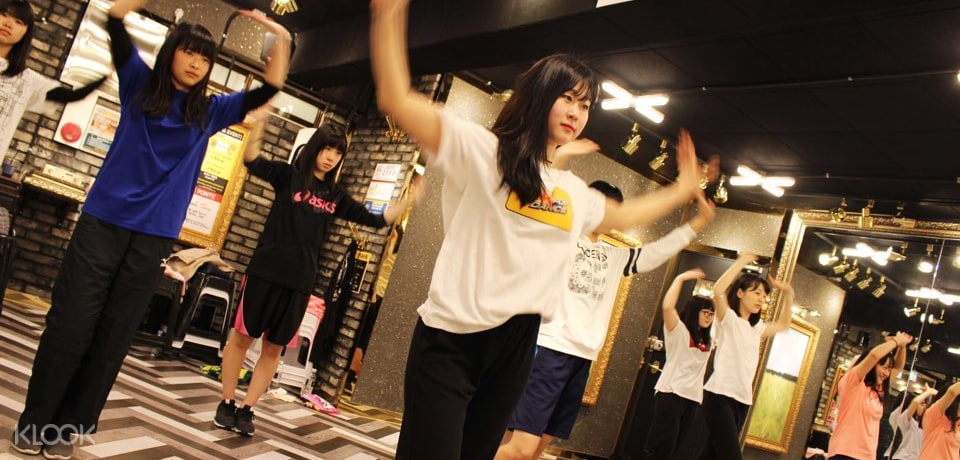
K-pop Dance Studio Class Learn popular K-pop dances and choreography.
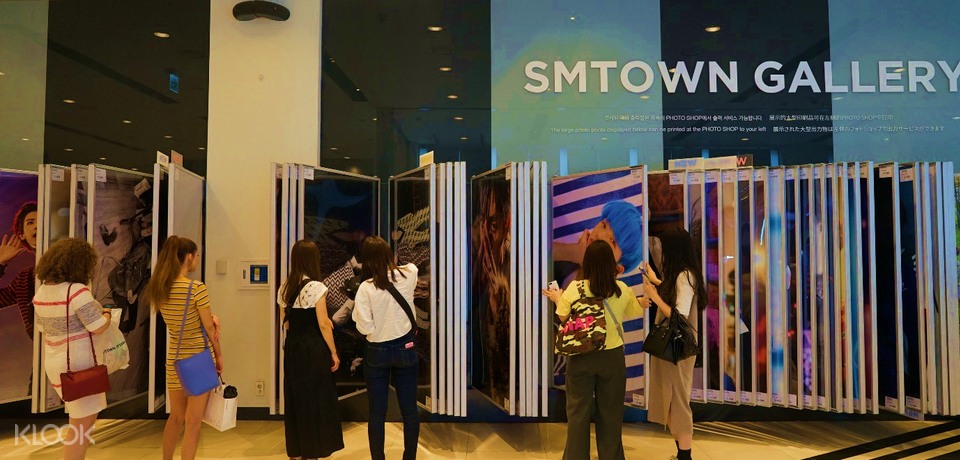
Seoul Hallyu Kpop Tour Ultimate KPop experience for your Seoul itinerary!
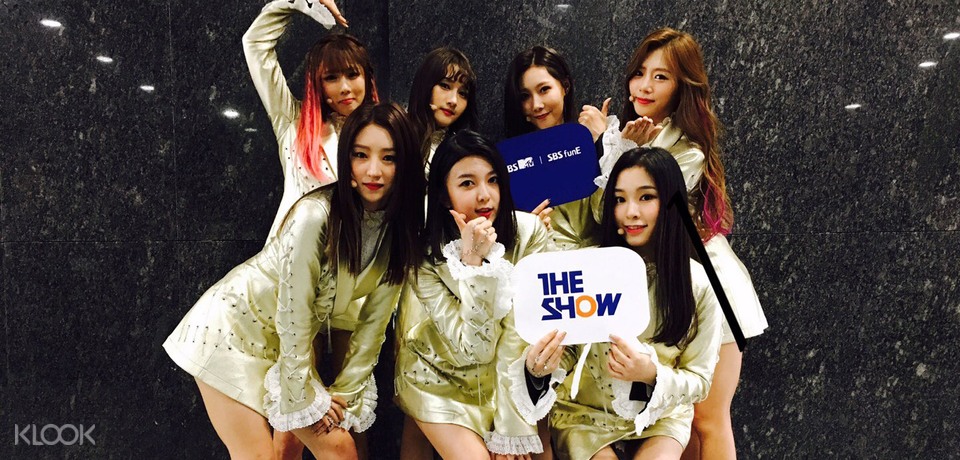
SBS MTV “The Show” Package Backstage access to live sets and broadcasts.
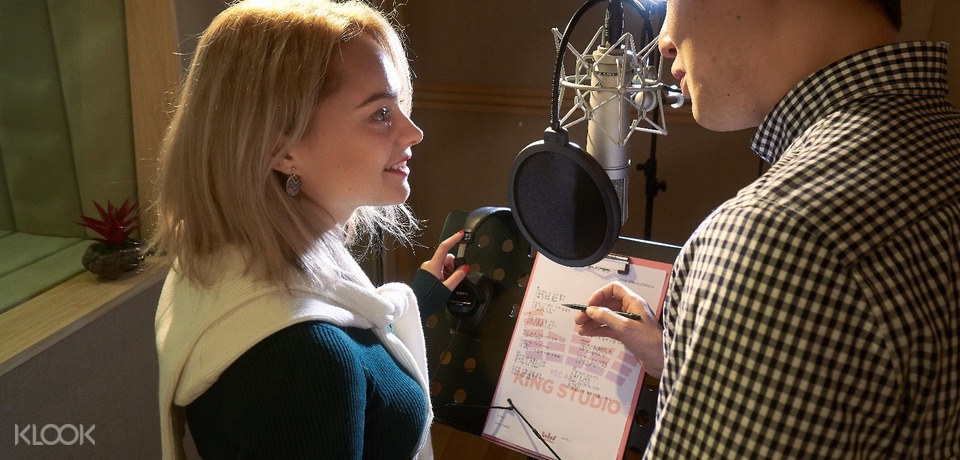
Everland Park Record your own K-Pop song at King Studio.
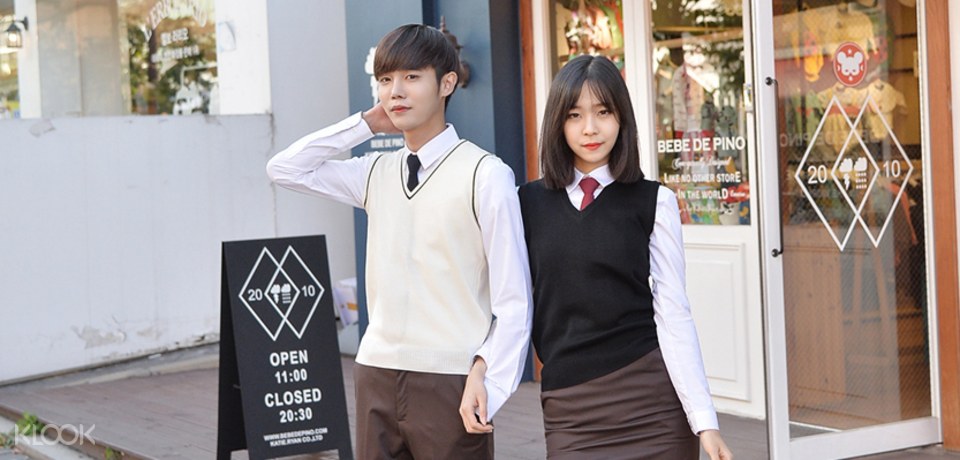
Korean School Uniform Rental Day rental of a Korean school uniform.

“Oppa” Tour Tour Seoul with an attractive “oppa”!
◘◘ Korean Performances ◘◘
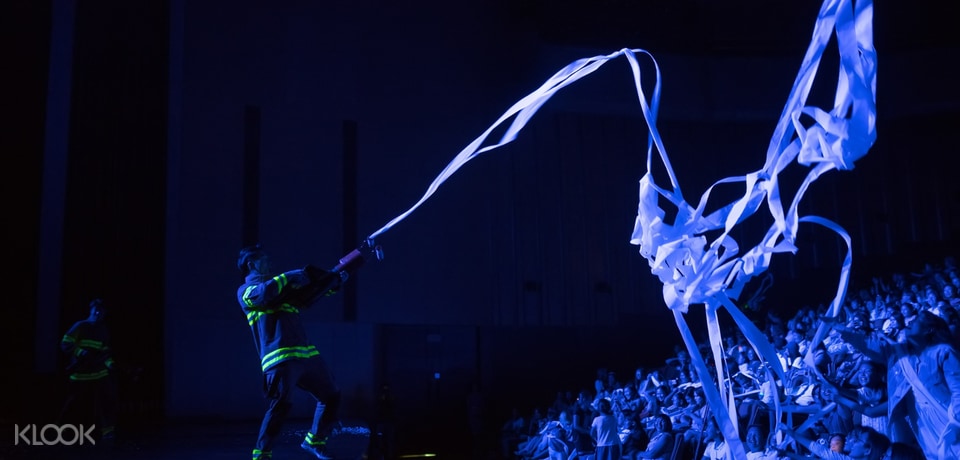
Fireman Show Action-comedy show full of stunts.
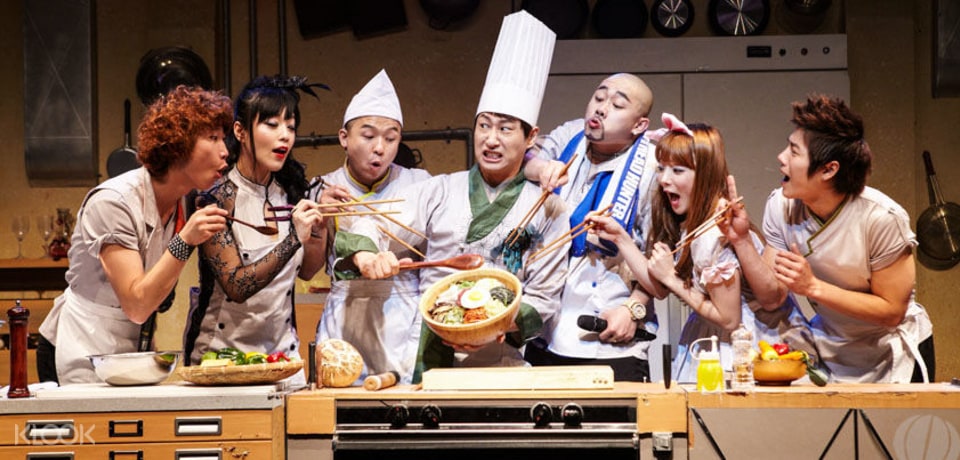
CHEF: Bibap Show One of the best Korean musical shows..
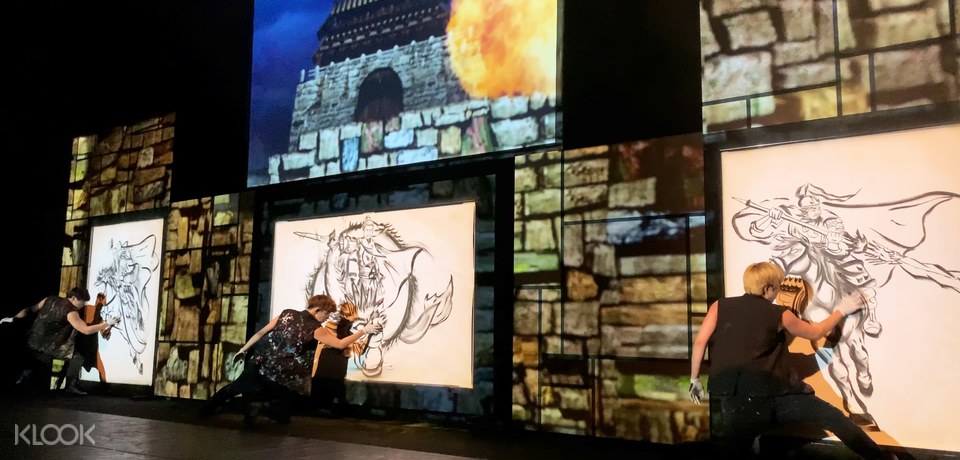
The Painters HERO Famous live painting non-verbal performance.
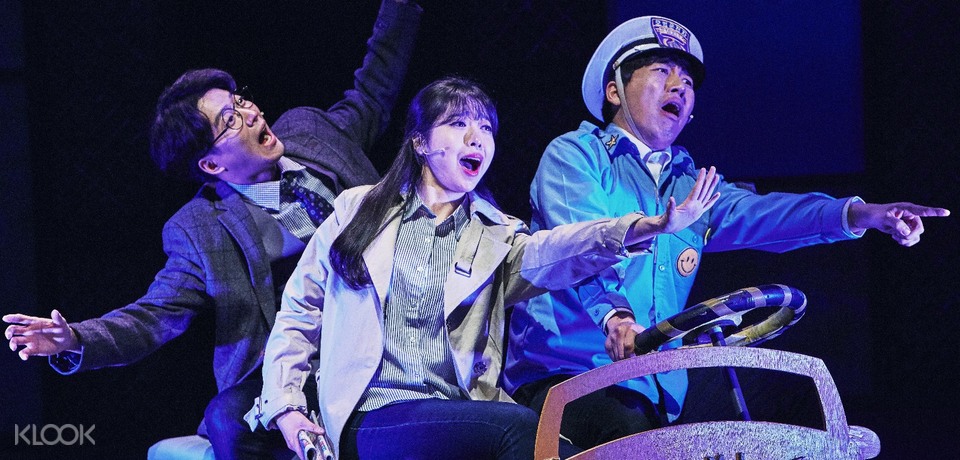
Finding Mr. Destiny Korean musical with subtitles.
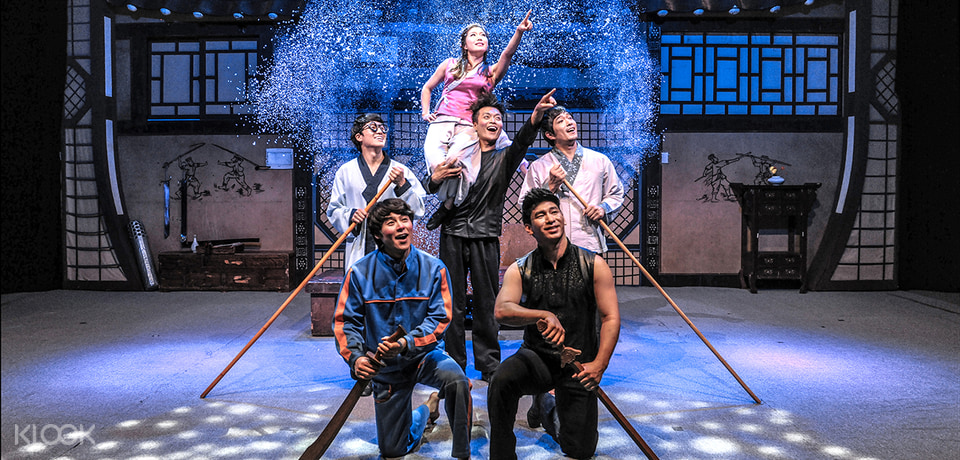
Jump – Martial Arts Show Seoul’s favorite martial arts theatre show.
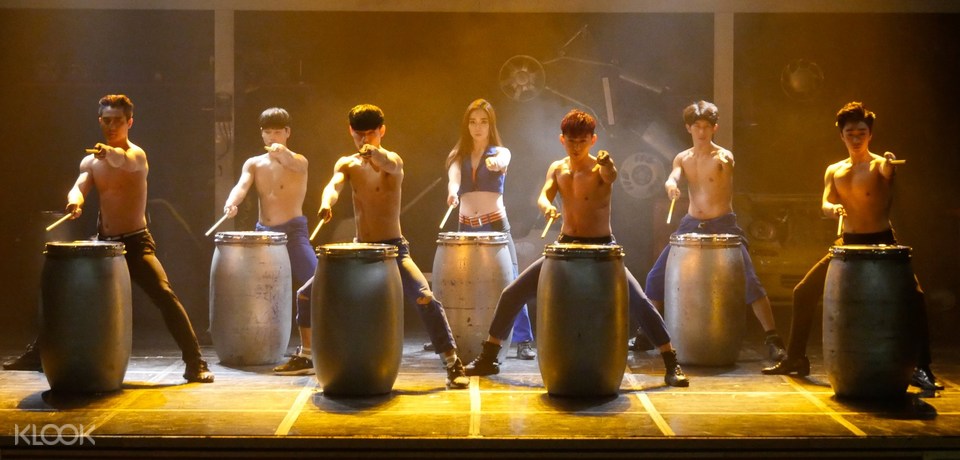
Fanta Stick Show Powerful percussion show.
◘◘ Beauty ◘◘
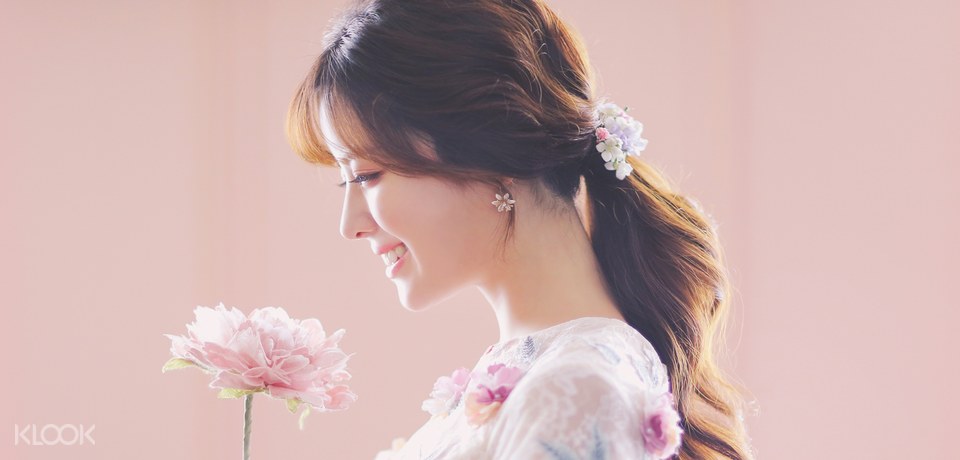
KPop Shoot & Makeover Full makeover at a famous studio.
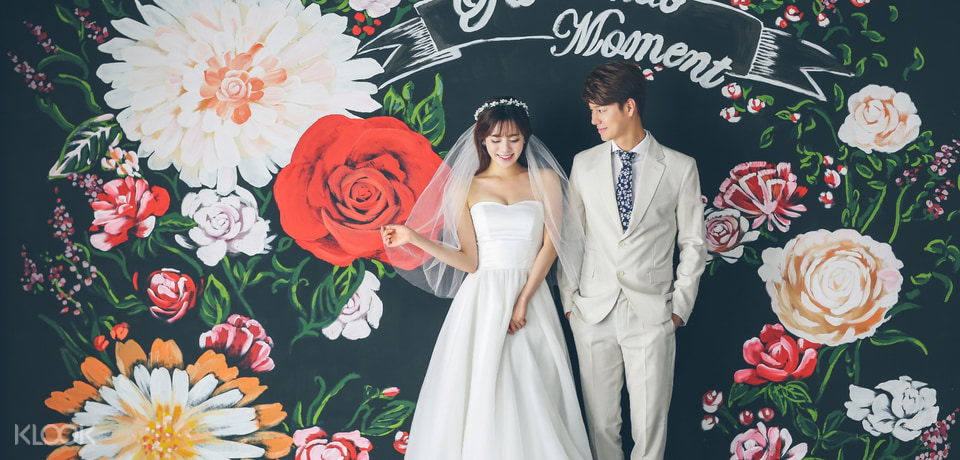
Pre-nup Photoshoot Pre-nup shoot with makeup, hair, and clothes.

Korean ID Shoot ID shoot in Korean style makeup and hairstyle.
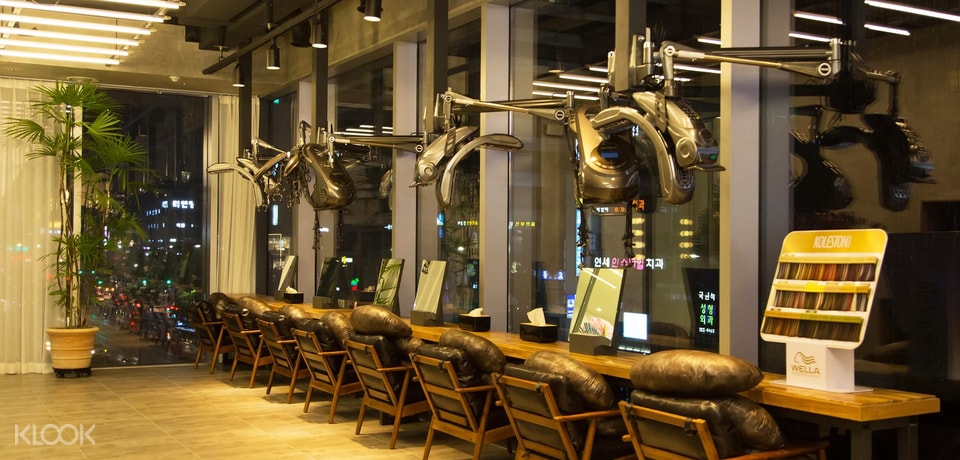
Korean Salon Service Style your hair in Gangnam’s top salon.
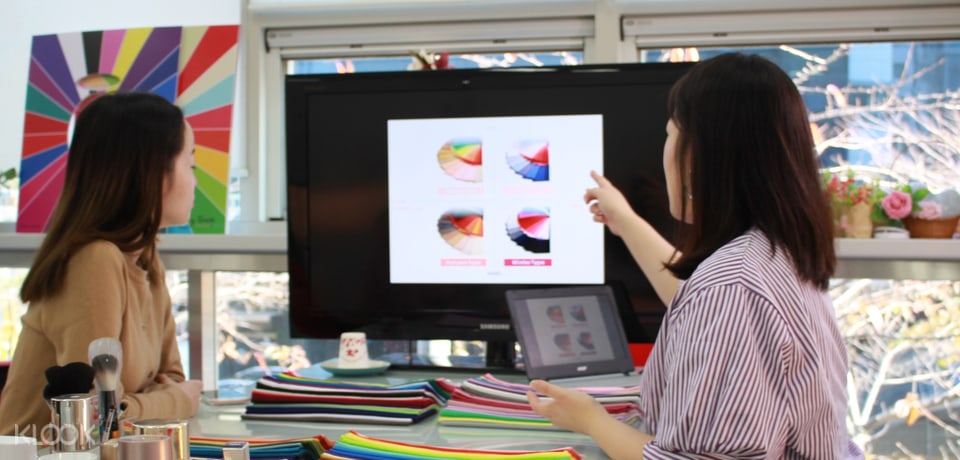
Professional Korean-Style Beauty Consultation Learn about your own personal color based on your skin, etc.
◘◘ Workshops ◘◘
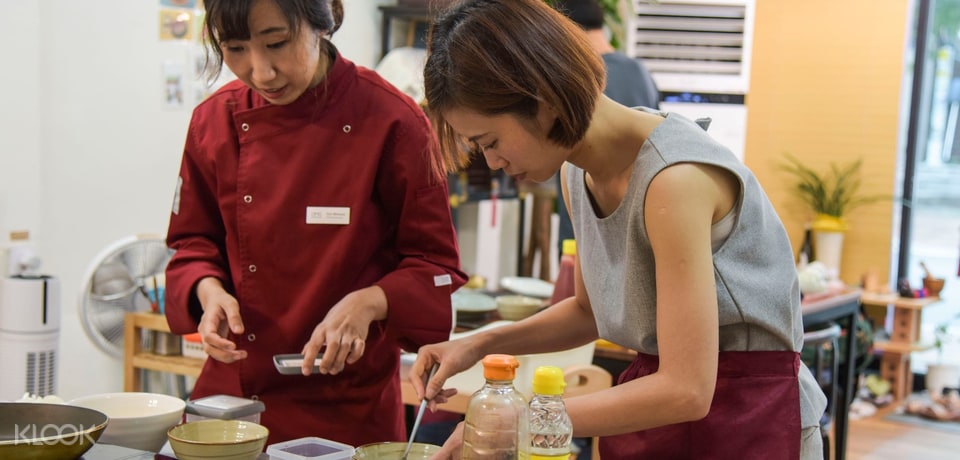
Cooking Class Cook authentic Korean dishes with a local.
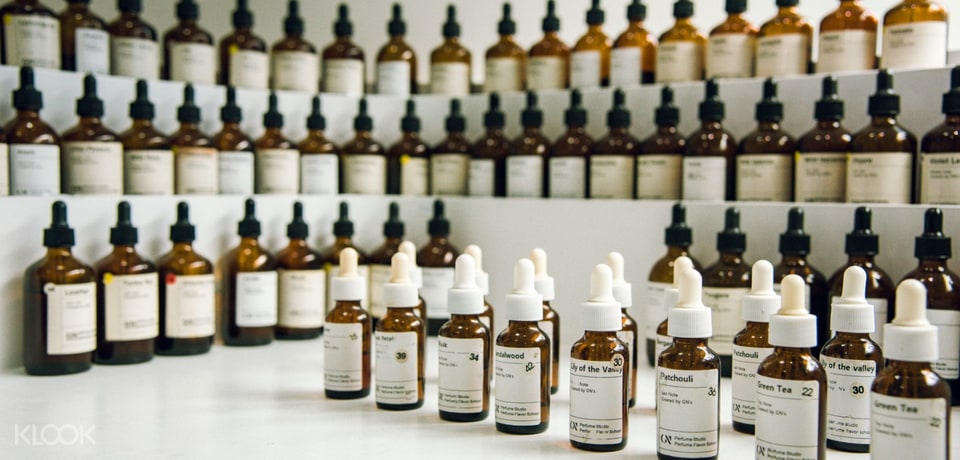
Perfume-Making Class Create your own signature scent.
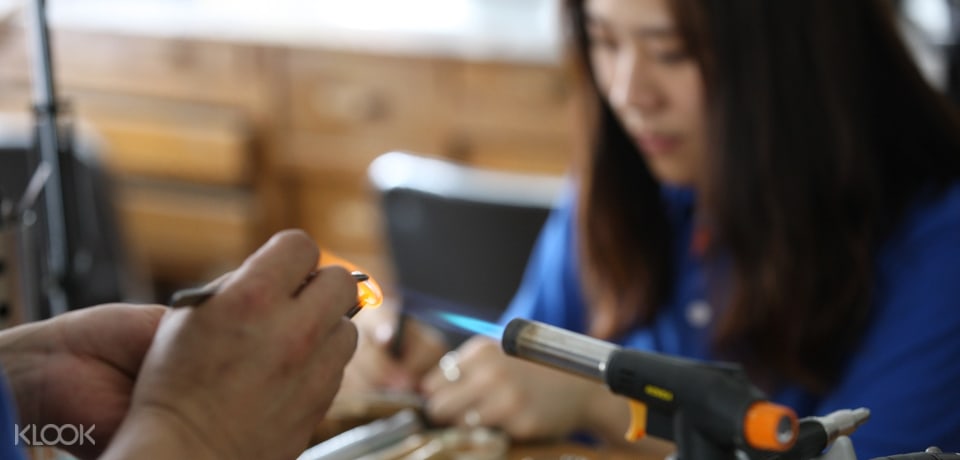
Ring-making Workshop Create your own unique accessories!
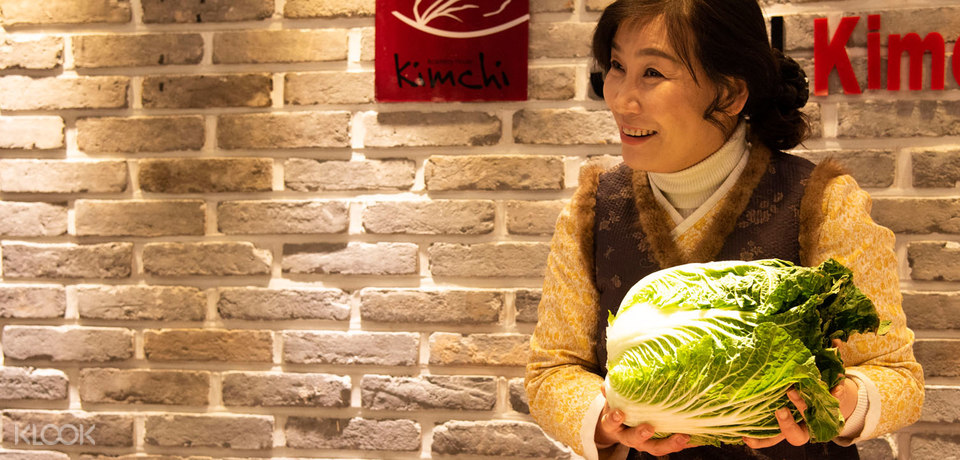
Kimchi Class Learn how to make kimchi and topokki!
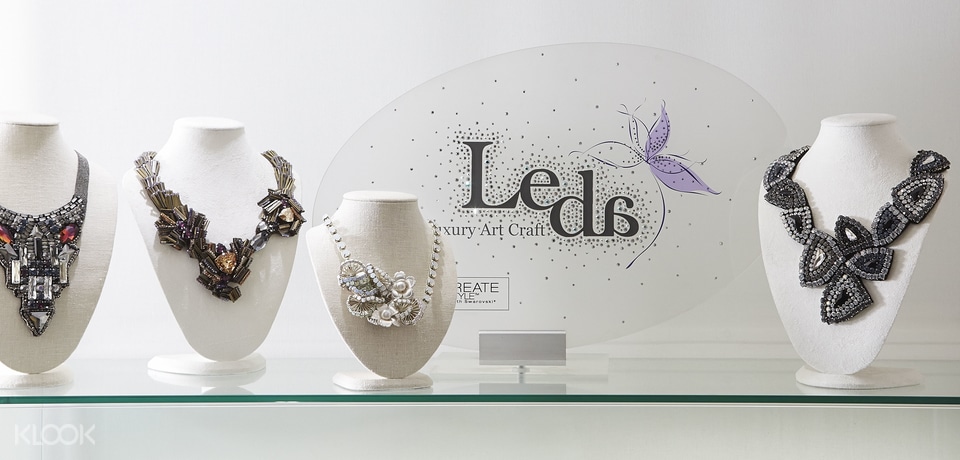
Handmade Jewelry Experience Learn hands-on exquisite art of jewelry making.
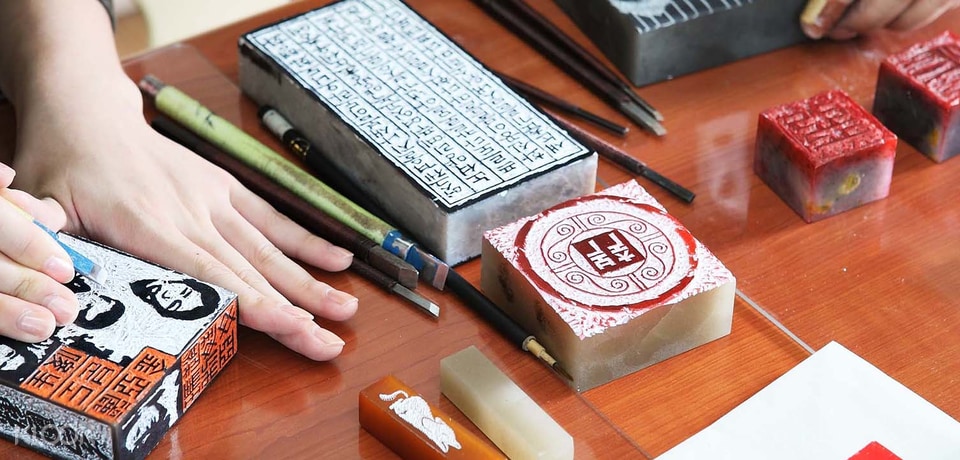
Handmade Stamp Engraving Create your own Korean-style hand engraved seal.
◘◘ Food & Restaurants ◘◘
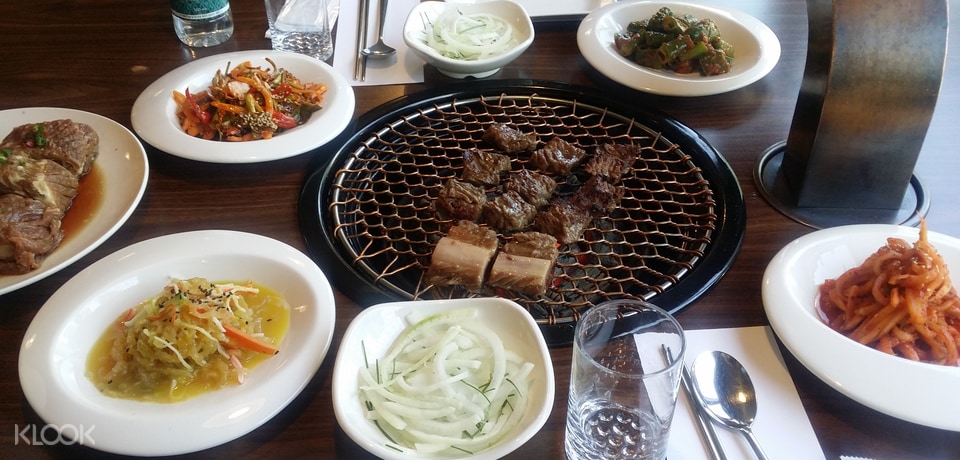
Assorted Grilled Beef Enjoy a Korean BBQ meal
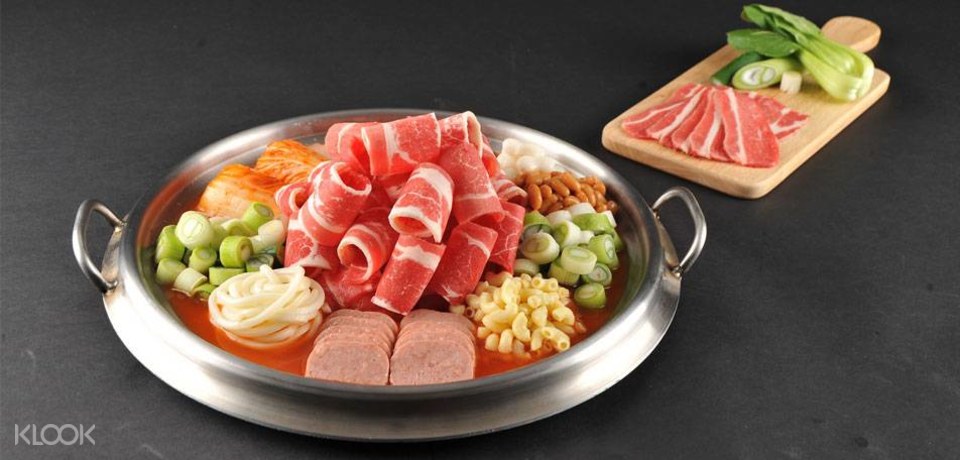
Budae Jjigae Try budae jjigae, the iconic Korean ‘Army Stew’.
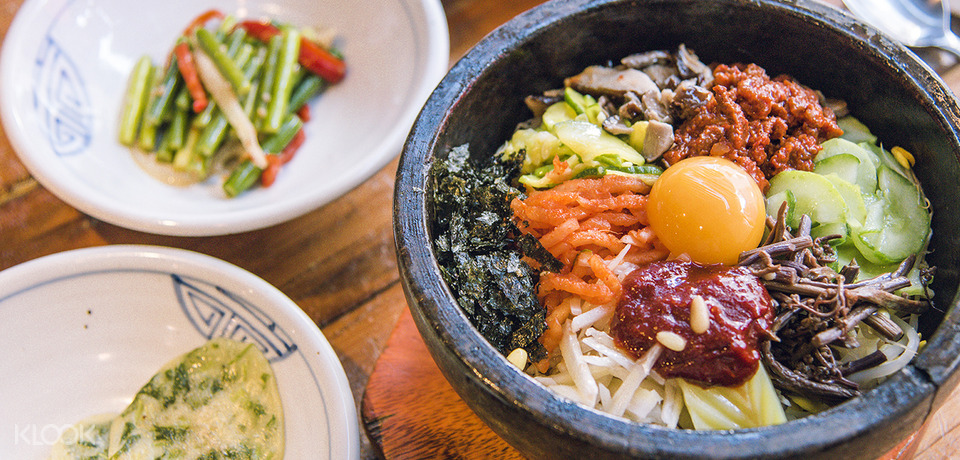
Gogung Bibimbap Specializes in authentic Bibimbap dishes!
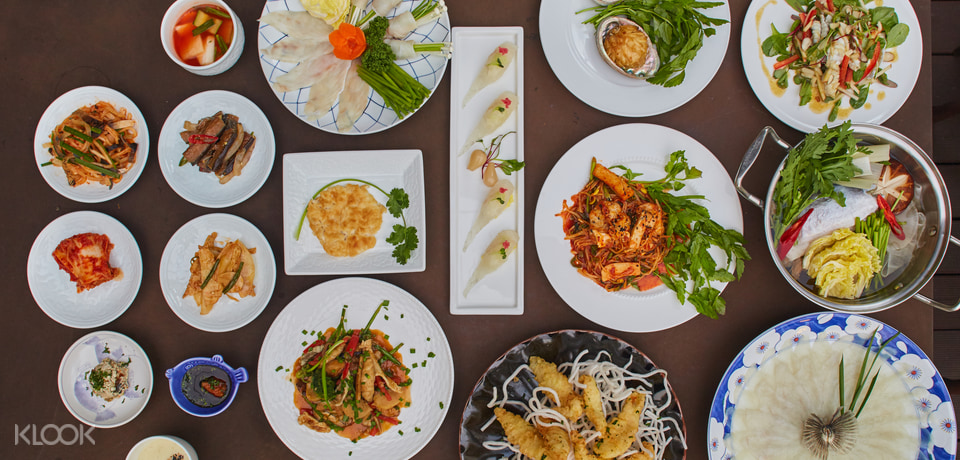
Puffer Fish Set The first puffer fish restaurant in Seoul.
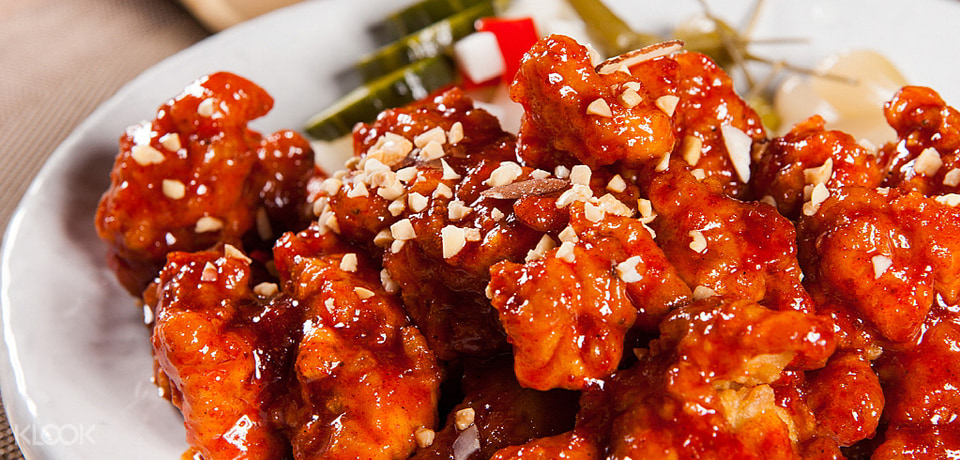
Korean Street Food Experience Korean eating and drinking culture!
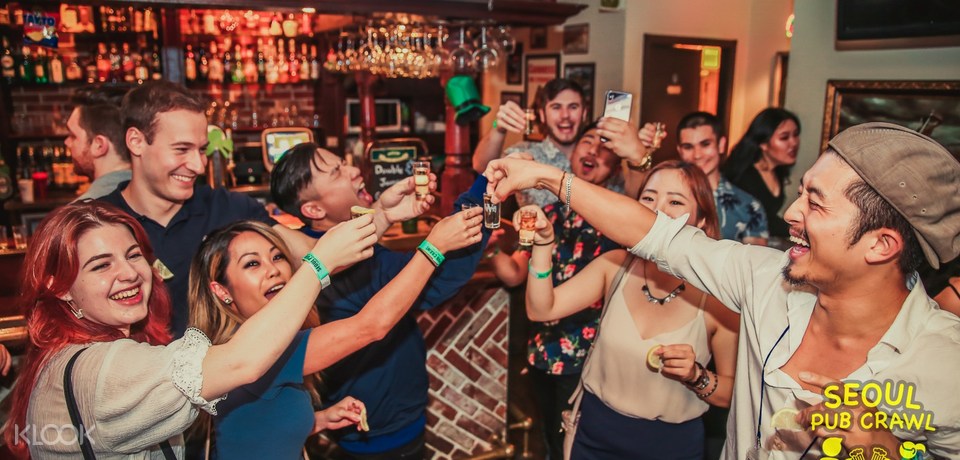
VIP Seoul Pub Crawl Experience Seoul’s vibrant nightlife!
◘◘ Day Trips from Seoul ◘◘
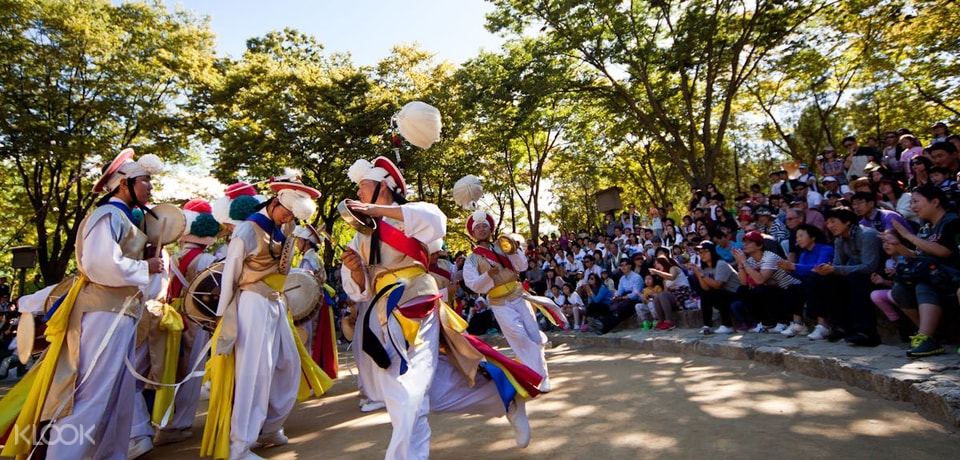
Minsok Korean Folk Village + Gwangmyeong Cave & Uiwang Rail Bike Day Trip.
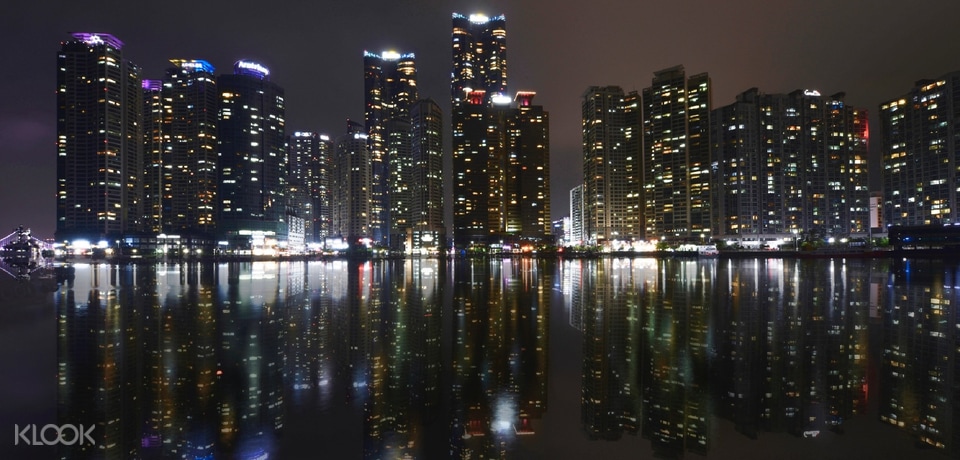
Busan Experience the best of Busan.
Booking Essentials

TIP: It’s a good idea to crosscheck the prices with other popular travel insurance providers like World Nomads and HeyMondo (as my reader, you get 5% off)! . However, take note that a travel insurance’s affordability typically means lesser coverage; so please always ensure that you read the fine print in order to decipher which travel insurance company is the right fit for you and your trip!
The Best Tours in South Korea?
Come and check out this list of the top things to do in South Korea which features the best activities and tours to do in Seoul, Busan, Jeju and more!
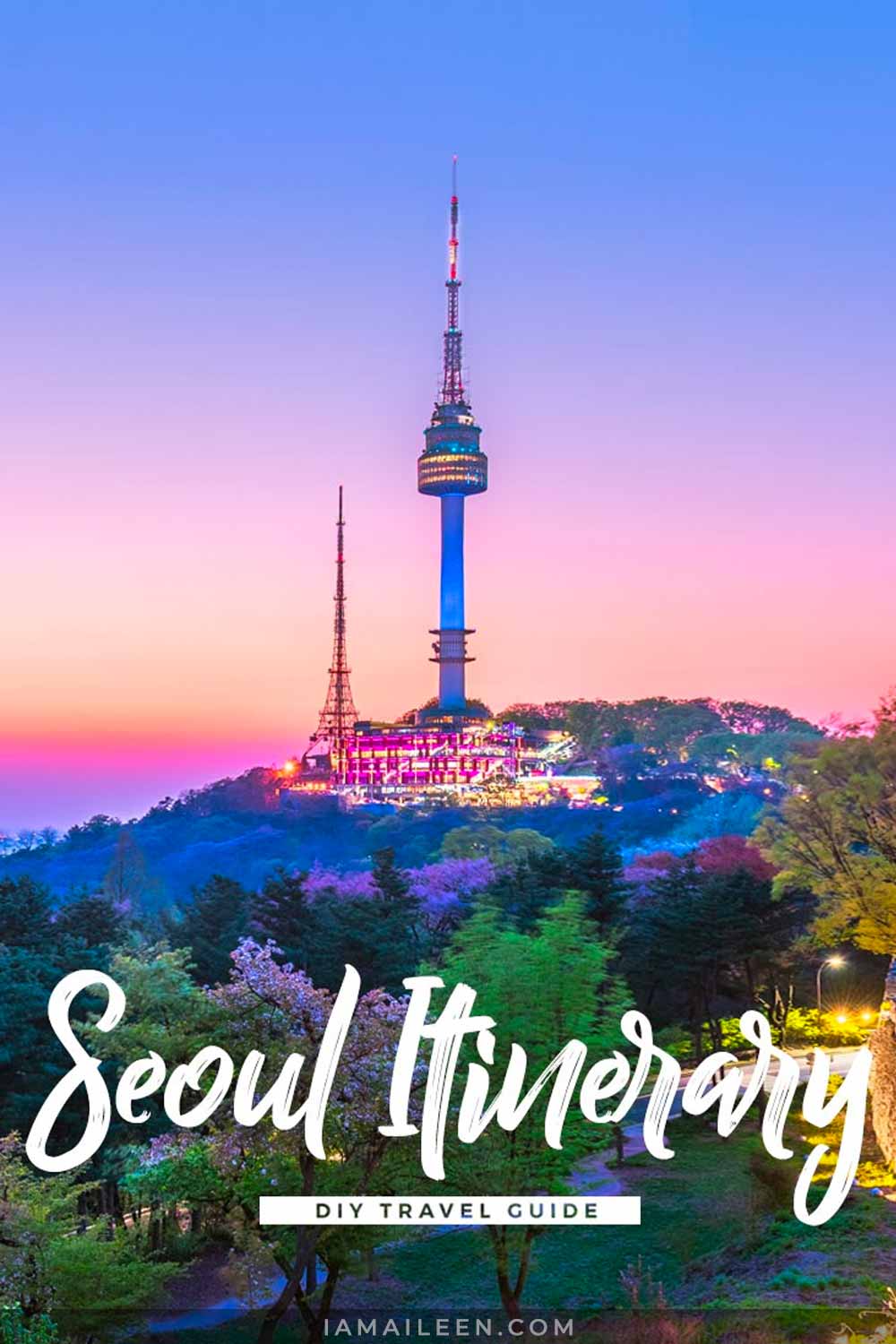
There’s still so much to see in Seoul! …But I believe that my Seoul itinerary travel guide here is already a good start.
Please feel free to tweak this itinerary and make full use of my extra activity suggestions in order to make your trip shorter or longer and better fitting for your travel style. Enjoy and do let me know how your trip goes!
Have you seen my latest vlog?

Hey there! I am Aileen Adalid. At 21, I quit my corporate job in the Philippines to pursue my dreams. Today, I am a successful digital nomad (online entrepreneur, travel writer, & vlogger) living a sustainable travel lifestyle.
My mission? To show you how it is absolutely possible to create a life of travel no matter the odds — and I will help you achieve that through my detailed travel hacks, guides, resources, tips, and MORE!
Follow Along
CURRENTLY BASED IN: The Philippines
- 100k Followers
- 51k Followers
- 80k Followers
- 10k Followers
- 23.1k Followers
Join over 1 million readers worldwide and get my FREE packing checklist, gain exclusive access to travel giveaways and more!
Success! Next, please check your email to confirm your subscription.
GET FREE PRINTABLE NOW!
Trending Now
Korean visa application requirements for filipino tourists in manila, philippines (single / multiple entry).
Make your South Korea travel dreams come true and get a single or multiple South Korean visa in Manila, Philippines!
Top 10 Things to Do on a Trip to South America
South America is one of the most diverse continents — full of natural wonders and fascinating cultures. Join us as we explore the top 10 things to do.
Top 10 Things to Do for Your First Tibet Travel
Make the most of your Tibet travel with these top 10 must-do activities, from exploring ancient monasteries to trekking mountains!
Geisha of Japan: Understanding the Facts, History & Myths
Japan’s geisha are cloaked in mystery & secrecy resulting in a number of false ideas about them — so let’s get the facts straight!
Maximizing Your Miles: Unlock Budget-Friendly Travel Hacks & Tips
Start traveling smart! Take note of these travel hacks that will help you in maximizing your miles or do points hacking.
Latest Posts
Learn Today
How to start a successful blog, 134 comments.
Your Seoul itinerary guide is a dream come true for wanderers like me! Planning a trip can be overwhelming, but your detailed 5-day plan simplifies everything. From activities to sights, you’ve covered it all. Seoul, here I come—thanks to your fantastic guide! ❤❤❤❤
Going to Paju would be another great option for a day trip from Seoul, especially during the week. It is close, easily reached by bus, and offers amazing landscapes no matter the season.
Seoul is one of my favorite cities in the world! I’m dying to return and explore it more.
If I was given a chance, I would love to go to Seoul. Seoul is one of my dream places to go in the near future and your blog really helps and encourages me to never stop dreaming. Thank you for this :))
Submit a Comment Cancel reply
Your email address will not be published. Required fields are marked *
Be notified of follow-up comments by email
Be notified of new posts by email
Submit Comment
Pin It on Pinterest
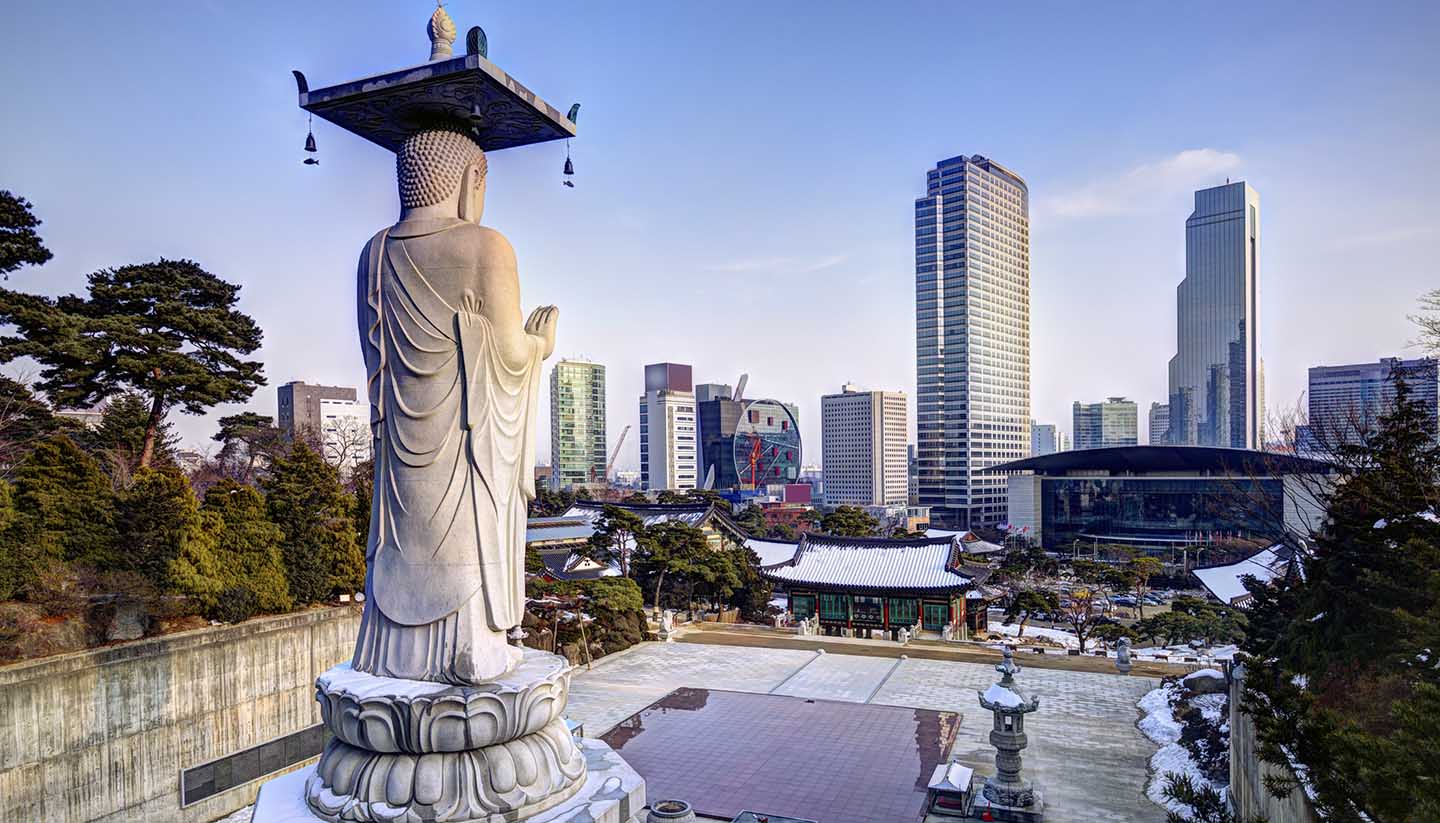
Introducing South Korea
About south korea.
- Images of South Korea
- History, language & culture
- Weather & geography
- Doing business & staying in touch
Plan your trip
- Travel to South Korea
- Where to stay
While you’re there
- Things to see & do
- Shopping & nightlife
- Food & drink
- Getting around
Before you go
- Passport & visa
- Public Holidays
- Money & duty free
Book your flights
- Busan Gimhae International Airport
- Seoul Incheon International Airport
South Korea travel guide
South Korea can come across as inscrutable at first glance. It’s a land of stark contrasts and wild contradictions; a place where tradition and technology are equally embraced; where skyscrapers loom over ancient temples; and where the frantic pace of life is offset by the serenity of nature. The country’s unique customs and etiquette can seem like a trap laid for foreigners, but arrive with a smile and a respectful attitude and you will be welcomed with open arms by some of the friendliest folk on the planet.
Koreans are fiercely proud of their country, and with good reason. The Korean peninsula has a storied history and this colourful heritage is woven into the fabric of this land. The capital, Seoul, is home to a number of historic highlights, including the spectacular Joseon-era Gyeongbokgung Palace, “the great south gate” of Namdaemun and the eerie Seodaemun Prison – all tucked away amid gleaming offices, giant shopping centres, world-class restaurants and hipster bars.
The rest of the country is also littered with fortresses, temples and palaces. Visitors will enjoy the grassy burial mounds of ancient kings in Gyeongju, the Seokbulsa Temple in Busan, which has been carved out of a rock, and the infamous demilitarised zone, a biodiverse no-man’s-land separating South and North Korea. It is a scary place, where acres of barbed wire are patrolled by heavily-armed guards on both sides, yet the tension is so trumped up it feels like you’ve stumbled onto a Hollywood film set.
But it's not all about history. When it comes to nature, South Korea is wonderfully diverse, with spectacular national parks, remote sandy beaches, hot spring islands and rugged mountain peaks. Gastronomes are well catered for, too, but you may have to open your mind before your mouth; local specialities include kimchi (pickled cabbage) and makgeolli (rice wine).
South Korea can sometimes seem like the most foreign place on Earth; an unfathomable destination of curious customs, strange food and jarring paradoxes. Ultimately, that’s what makes it so exciting.
99,720 sq km (38,502 sq miles) excluding demilitarised zone.
50,503,933 (UN estimate 2016).
492.5 per sq km.
President Yoon Suk-yeol since 2022.
Han Duck-soo since 2022.
Travel Advice
The Foreign, Commonwealth & Development Office ( FCDO ) provides advice about risks of travel to help British nationals make informed decisions. Find out more about FCDO travel advice .
Before you travel
No travel can be guaranteed safe. Read all the advice in this guide as well as support for British nationals abroad which includes:
- advice on preparing for travel abroad and reducing risks
- information for women, LGBT+ and disabled travellers
Follow and contact FCDO travel on Twitter , Facebook and Instagram . You can also sign up to get email notifications when this advice is updated.
Travel insurance
If you choose to travel, research your destinations and get appropriate travel insurance . Insurance should cover your itinerary, planned activities and expenses in an emergency.
This advice reflects the UK government’s understanding of current rules for people travelling on a full ‘British citizen’ passport from the UK, for the most common types of travel.
The authorities in South Korea set and enforce entry rules. If you’re not sure how these requirements apply to you, contact the South Korean Embassy in the UK .
COVID-19 rules
There are no COVID-19 testing or vaccination requirements for travellers entering South Korea.
Passport validity requirements
If you are visiting as a tourist for up to 90 days, your passport must have an ‘expiry date’ after the date you are leaving South Korea.
If you are entering South Korea on a long-term visa, your passport should have an ‘expiry date’ at least 6 months after the date you arrive.
Check with your travel provider that your passport and other travel documents meet requirements. Renew your passport if you need to.
You will be denied entry if you do not have a valid travel document or try to use a passport that has been reported lost or stolen.
Visa requirements
You do not need a visa to visit South Korea as a tourist for up to 90 days. You must have an onward or return ticket. It’s illegal to work on a tourist visa, whether as a teacher or in any other capacity.
If you are travelling for any purpose other than short-term business or tourism, check visa requirements with the South Korean Embassy in the UK .
For those in South Korea on a work visa, all employment changes must be authorised by Korean Immigration.
Re-entry permits for long-term visa holders
Most foreign nationals in South Korea on long-term visas are allowed to re-enter South Korea within one year of departure without the need for a re-entry permit. Check with the Korea Immigration Service .
If you are resident and intend to spend more than a year outside of South Korea, in most cases, you must apply for a multiple re-entry permit via the Hi Korea website before departure. If you require a re-entry permit, engage early with the immigration authorities and apply for a re-entry permit at least 4 working days ahead of any planned travel.
Visas for working as an English teacher
To get a visa to teach English in South Korea, you must have a 3-year university degree. A Teaching English as a Foreign Language ( TEFL ) qualification alone is not enough. If you are found to have a teaching visa by deception, you will be detained and deported.
British nationals teaching English in South Korea have sometimes found living and working conditions to be below their expectation or have had difficulties getting the correct visas and residence permits. Some also report more serious problems such as breach of contract, confiscation of passport, payment being withheld and inadequate insurance.
Check all terms and conditions of your employment carefully. If possible, speak to other teachers from the place where you plan to work before accepting any offer. If you are in South Korea and in need of assistance, you should contact British Embassy in Seoul .
Vaccination requirements
At least 8 weeks before your trip, check the vaccinations and certificates you need in TravelHealthPro’s South Korea guide .
Customs rules
There are strict rules about goods you can take into or out of South Korea . You must declare anything that may be prohibited or subject to tax or duty.
There is a high threat of terrorist attack globally affecting UK interests and British nationals, including from groups and individuals who view the UK and British nationals as targets. Stay aware of your surroundings at all times.
UK Counter Terrorism Policing has information and advice on staying safe abroad and what to do in the event of a terrorist attack. Find out how to reduce your risk from terrorism while abroad .
Terrorism in South Korea
Although there’s no recent history of terrorism in South Korea, attacks cannot be ruled out.
Political situation
The level of tension and the security situation on the Korean Peninsula can change with little notice. Tensions can rise after missile tests by North Korea and during the regular South Korean-US military exercises, which take place throughout the year. You should follow the advice of local authorities and keep up to date with developments, which will be reported on news broadcasts.
The demilitarised zone ( DMZ ) separates North Korea and South Korea. Peace has been maintained under an armistice agreement, but no formal peace treaty has ever been signed. If you’re in the area of the DMZ , you should exercise caution and follow the advice of the local authorities.
National service
If you are a British male of Korean origin whose name appears on the Korean family register, you may be liable for military service even if you are travelling on your British passport.
Demonstrations
Public demonstrations in South Korea are common. These gatherings are mostly peaceful and well-policed. Be aware that under Korean law, it is illegal for foreign nationals to take part in political activities when in the country.
Civil emergency exercises and advice
South Korean authorities sometimes hold civil emergency exercises. You’ll hear sirens to mark the start the exercise. All vehicles must stop and sometimes people will have to descend into designated metro stations or basements. You do not need to participate but do follow any instructions from officials during these exercises.
Contingency planning
The government’s Emergency Ready App, available on iOS and Android , explains the possible civil emergency alerts which would be pushed to your mobile in an emergency.
As part of your own contingency planning, make sure you have easy access to your passport and other important documents such as nationality documents and birth and marriage certificates, as well as any essential medication. Consider saving the contact details for the embassy so that you can access them quickly if needed. Make sure to share your contact details with your family and friends.
Crime against foreigners is rare but there are occasional thefts. Take extra care of passports, credit cards and money in crowded areas and in areas visited by foreigners, such as Itaewon.
While most reported crimes are thefts, there have been cases of assault, including sexual assault, particularly around bars and nightlife areas. Take care when travelling alone at night and only use legitimate taxis or public transport.
Laws and cultural differences
Personal id.
Carry some form of identification at all times and make sure you’ve written the emergency contact details in the back of your passport.
Illegal drugs and prison sentences
If you’re convicted of possession, use or trafficking of illegal drugs you can face a long jail sentence and heavy fines. This applies even to personal use of small amounts of marijuana. British nationals have been detained solely on the basis of drug tests.
Transport risks
Road travel.
If you are planning to drive in South Korea, see information on driving abroad and read the Korea Tourism Organization’s driving in Korea guidance . The guide lists driving regulations and other legal requirements you need to be aware of.
You’ll need to have both the 1949 international driving permit ( IDP ) and your UK driving licence with you in the car when you drive in South Korea. You cannot buy an IDP outside the UK, so get one before you travel.
The police take the position that car and motorbike drivers are at fault in accidents involving cyclists or pedestrians. If you injure someone in an accident, you are likely to face criminal charges and heavy penalties, even if guilt is not proved.
The legal limit for alcohol in South Korea is less than half the limit in England, and penalties for drink-driving include prison and fines.
Taxi drivers tend to speak little or no English. It is helpful to have your destination written in Korean – if possible with a map.
Extreme weather and natural disasters
If there is a natural disaster, or the threat of one, the South Korean government will publish updates in Korean and English to the Natural Disaster Safety Portal .
The government’s Emergency Ready App, available on iOS and Android , explains the possible alerts which would be pushed to your mobile.
Find out what you can do to prepare for and respond to extreme weather and natural hazards .
The typhoon season normally runs from June to November. You should monitor the progress of approaching storms with the Korea Meteorological Administration or call 131 in Korea to get an accurate weather forecast in English. Always follow any advice given by the local authorities.
Flooding and landslides
South Korea has heavy rainfall across the country during the summer rainy season, usually in June and July. Torrential rain may cause flooding near rivers and creeks, including in built-up areas. Flash floods are common in areas downstream from large reservoirs or rivers, even after relatively short periods of intense rainfall. Landslides are possible in hilly and mountainous areas.
You should monitor forecasts for heavy rainfall with the Korea Meteorological Administration and follow any advice given by the local authorities.
Earthquakes
Strong earthquakes are unusual in South Korea but do happen. Most earthquakes in South Korea are relatively weak. The Korea Meteorological Administration publishes information on earthquakes.
Read up on the any guidance from local authorities on safety procedures in an earthquake and check the safety tips from the Seoul Metropolitan Government .
Before you travel check that:
- your destination can provide the healthcare you may need
- you have appropriate travel insurance for local treatment or unexpected medical evacuation
This is particularly important if you have a health condition or are pregnant.
Emergency medical number
Call 119 and ask for an ambulance.
Contact your insurance company promptly if you’re referred to a medical facility for treatment.
Vaccinations and health risks
At least 8 weeks before your trip check:
- the latest information on vaccinations and health risks in TravelHealthPro’s South Korea guide
- where to get vaccines and whether you have to pay on the NHS travel vaccinations page
Tick bites, and tick-borne encephalitis, are a risk throughout South Korea. Read more about avoiding tick and insect bites on TravelHealthPro .
Air pollution, including yellow dust pollution, is common, especially during spring months. Follow local media reporting and check the Korean Meteorological Administration website. On days when concentrations are high, most residents will stay indoors or use face masks outside. It’s also important to drink plenty of water.
The legal status and regulation of some medicines prescribed or bought in the UK can be different in other countries.
South Korean customs authorities allow you to bring small amounts of medication for your personal use, if it is kept in carry-on baggage. Take an English language prescription from your doctor at home for both your prescription drugs and non-prescription medicines. Consult the website of the South Korean Ministry of Food and Drug Safety before you travel to South Korea.
Read best practice when travelling with medicines on TravelHealthPro .
The NHS has information on whether you can take your medicine abroad .
Healthcare facilities in South Korea
Medical and dental care in South Korea is usually of a good standard, but can be expensive. Staff may not speak English. Make sure you have adequate travel health insurance and accessible funds to cover the cost of any medical treatment abroad and repatriation.
If you need to stay in a South Korean hospital, particularly if your condition is severe, the hospital may ask you to bring a guardian or ‘bohoja’ to assist you with basic care needs such as trips to the bathroom, washing and exercise. It is possible to find agencies who will provide a caregiver or ‘ganbyungin’ for a fee, but these caregivers generally do not speak English. If you know that you may need to enter a Korean hospital, you should try to organise a guardian such as a friend or relative in advance.
FCDO has a list of English-speaking doctors in South Korea .
There is also guidance on healthcare if you’re living in South Korea .
Medical tourism
If you are travelling to South Korea for elective treatment, such as cosmetic surgery or a dental procedure, consider that no medical procedure is risk-free. Make sure that your travel health insurance covers complications that may arise and repatriation to the UK if required.
COVID-19 healthcare in South Korea
If you think you might have COVID-19 while in South Korea, contact the Korea Disease Control and Prevention Agency on 1339 (support is available in English).
You can buy antigen tests at pharmacies or get a PCR test for a fee at most hospitals .
Travel and mental health
Read FCDO guidance on travel and mental health . There is also mental health guidance on TravelHealthPro .
The Foreign, Commonwealth & Development Office ( FCDO ) cannot provide tailored advice for individual trips. Read this travel advice and carry out your own research before deciding whether to travel.
Emergency services in South Korea
Ambulance: 119
Police: 112
Contact your travel provider and insurer
Contact your travel provider and your insurer if you are involved in a serious incident or emergency abroad. They will tell you if they can help and what you need to do.
Refunds and changes to travel
For refunds or changes to travel, contact your travel provider. You may also be able to make a claim through insurance. However, insurers usually require you to talk to your travel provider first.
Find out more about changing or cancelling travel plans , including:
- where to get advice if you are in a dispute with a provider
- how to access previous versions of travel advice to support a claim
Support from FCDO
FCDO has guidance on staying safe and what to do if you need help or support abroad, including:
- finding English-speaking lawyers , funeral directors and translators and interpreters in South Korea
- dealing with a death in South Korea
- being arrested or imprisoned in South Korea
- getting help if you’re a victim of crime
- what to do if you’re in hospital
- if you’re affected by a crisis , such as a terrorist attack
Contacting FCDO
Follow and contact FCDO travel on Twitter , Facebook and Instagram . You can also sign up to get email notifications when this travel advice is updated.
Help abroad in an emergency
If you’re in South Korea and you need emergency help from the UK government, contact the British Embassy in Seoul .
You can also contact FCDO online .
FCDO in London
You can call FCDO in London if you need urgent help because something has happened to a friend or relative abroad.
Telephone: 020 7008 5000 (24 hours)
Find out about call charges
Risk information for British companies
The Overseas Business Risk service offers information and advice for British companies operating overseas on how to manage political, economic, and business security-related risks.

Book a Hotel
© Columbus Travel Media Ltd. All rights reserved 2024
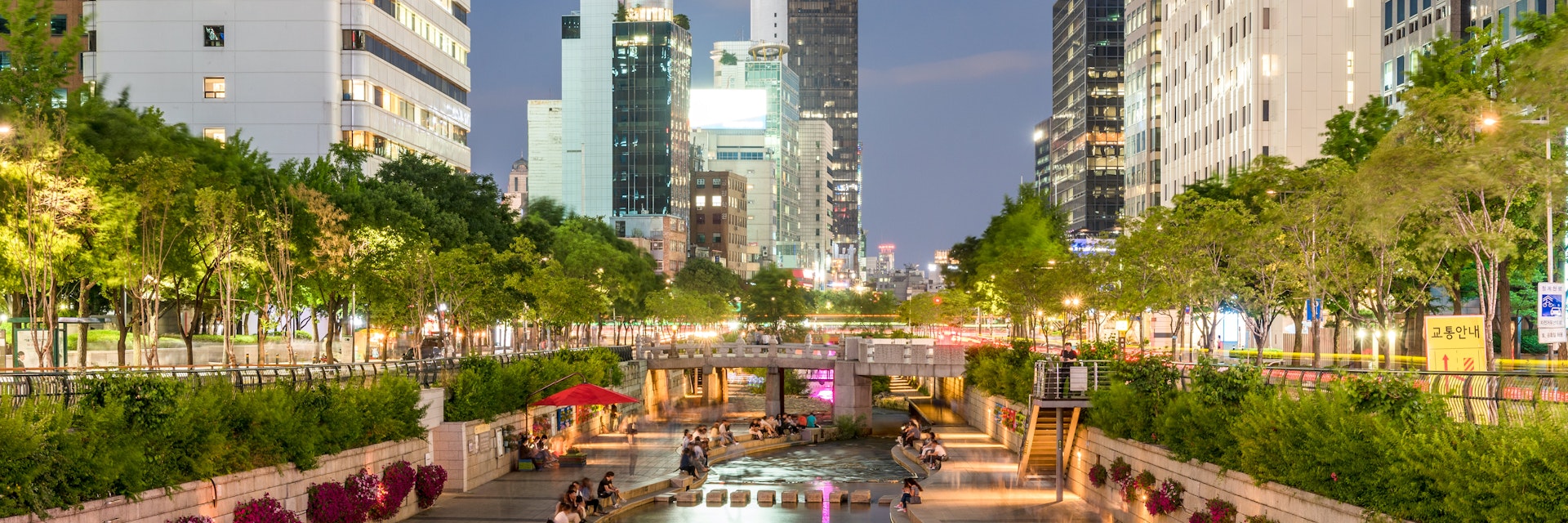
Getty Images
Fashion- and technology-forward but also deeply traditional, this dynamic city mashes up palaces, temples, cutting-edge design and mountain trails, all to a nonstop K-Pop beat.
Best Time to Visit
Best things to do, your next trip starts here.
Go from dreaming to planning with trip planning options made to help you craft your ideal itinerary.
Attractions
Must-see attractions.
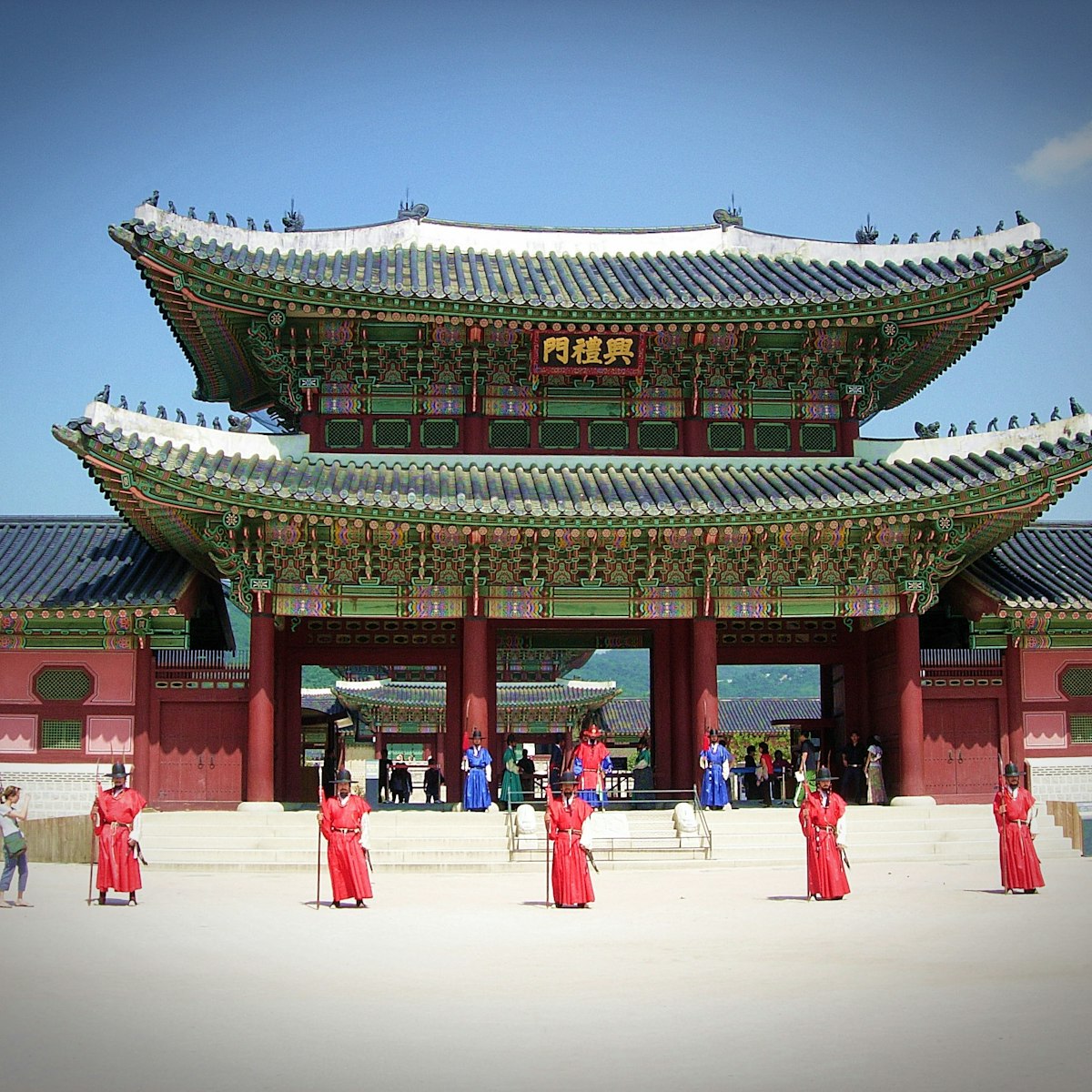
Gyeongbokgung
Gwanghwamun & Jongno-gu
Like a phoenix, Seoul’s premier palace has risen several times from the ashes of destruction. Hordes of tourists have replaced the thousands of government…
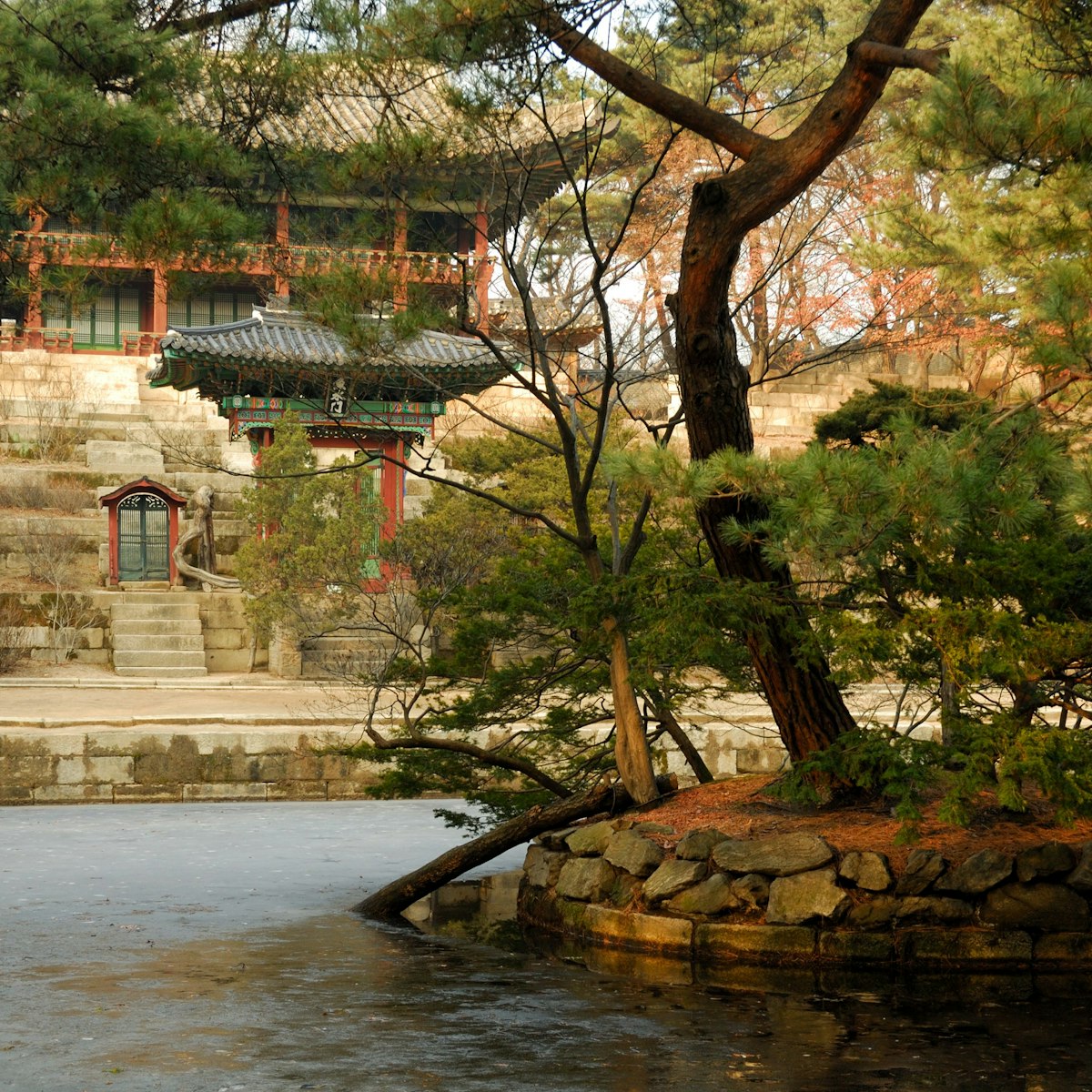
Changdeokgung
The World Heritage–listed Changdeokgung is the most beautiful of Seoul's five main palaces. You must join a one-hour guided tour to look around. English…

Leeum Samsung Museum of Art
Itaewon & Yongsan-gu
Amid the celebrity-owned apartments on the leafy southern slope of Namsan is Korea's premier art gallery. Beautifully designed and laid-out, it balances…
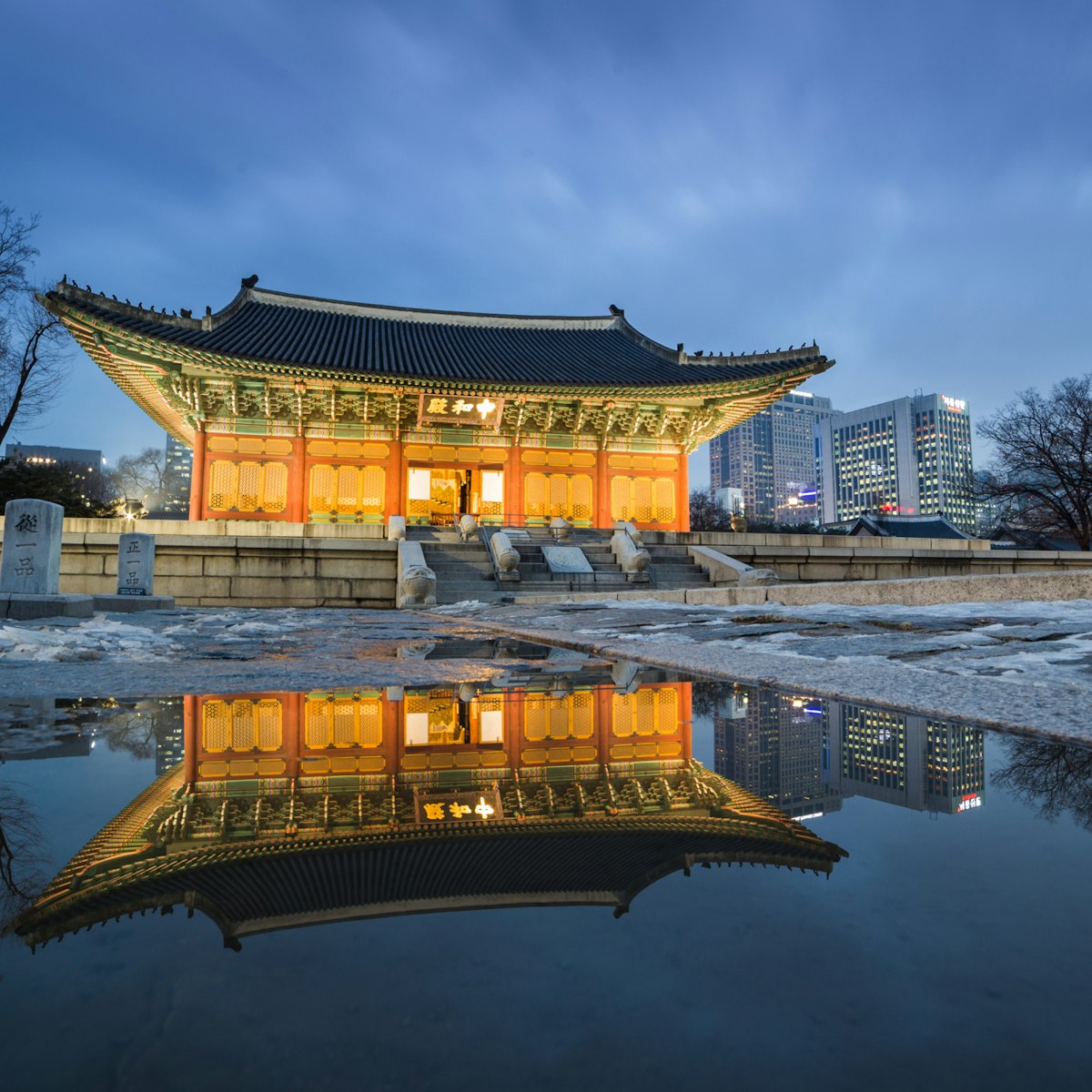
Myeong-dong & Jung-gu
One of Seoul's five grand palaces built during the Joseon dynasty, Deoksugung (meaning Palace of Virtuous Longevity) is the only one you can visit in the…
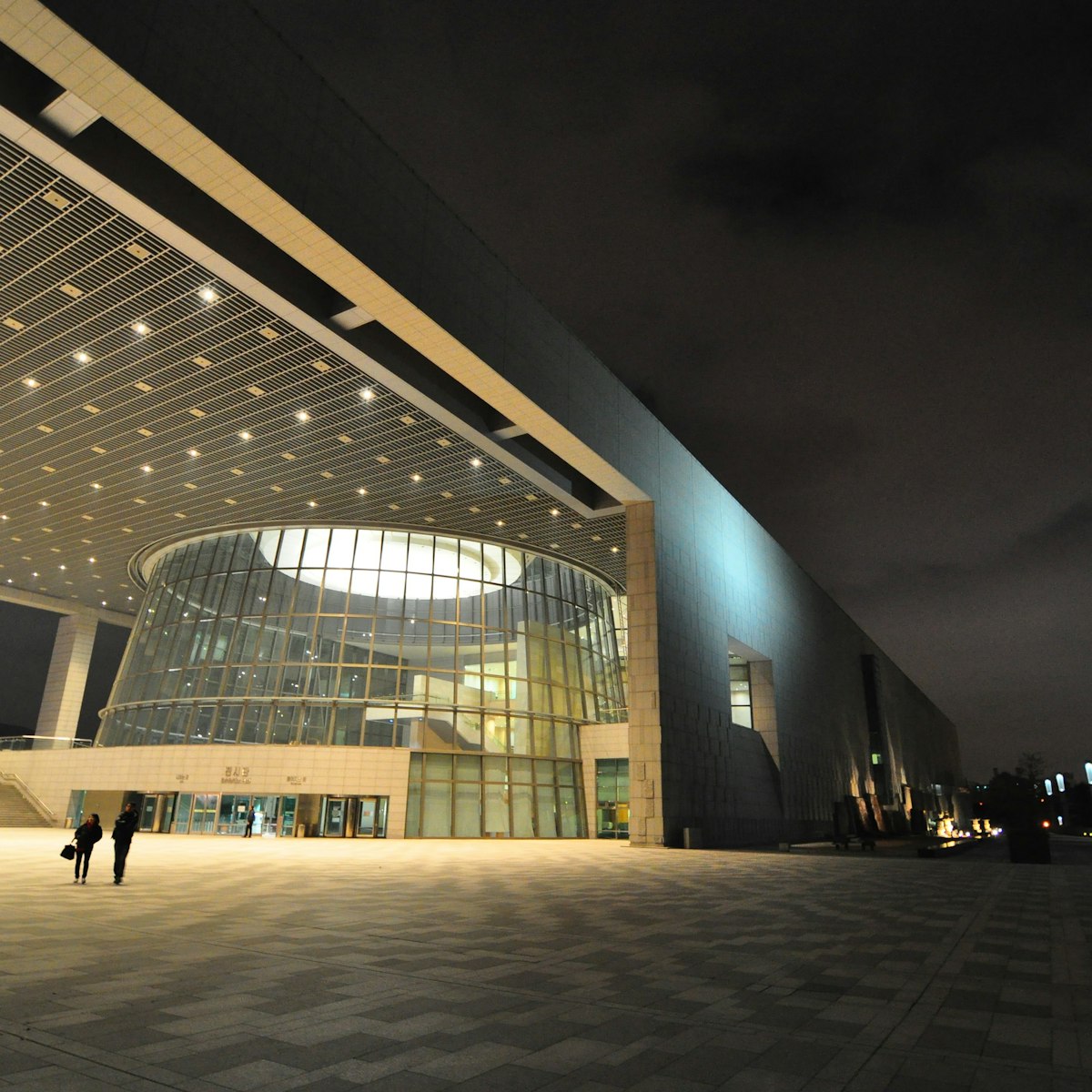
National Museum of Korea
This vast and imposing concrete slab of a museum takes visitors on a fascinating journey through Korea's past from prehistory all the way to the Korean…
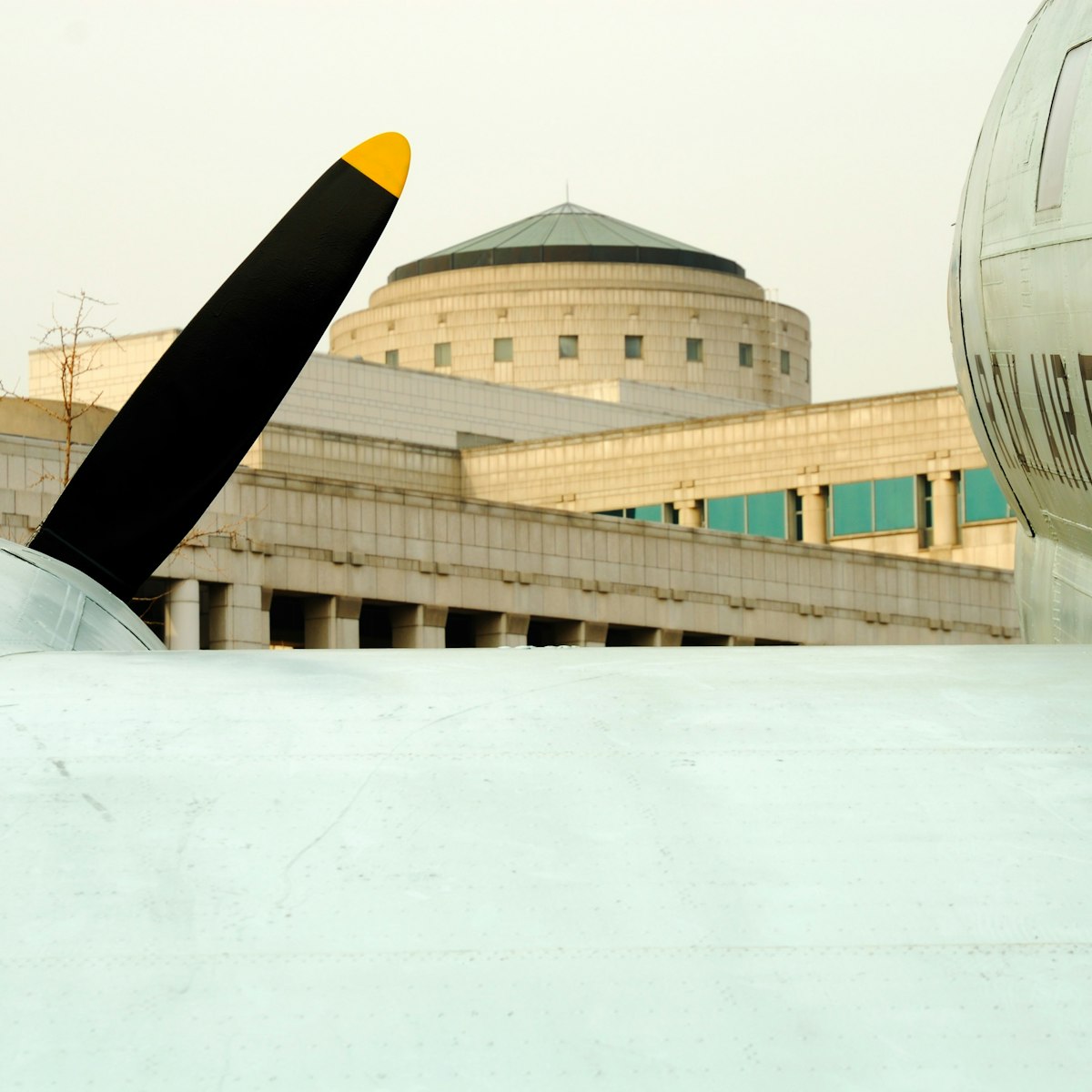
War Memorial of Korea
This huge museum documents the history of the Korean War (1950–53) using multimedia exhibits and black-and-white documentary footage, along with artefacts…
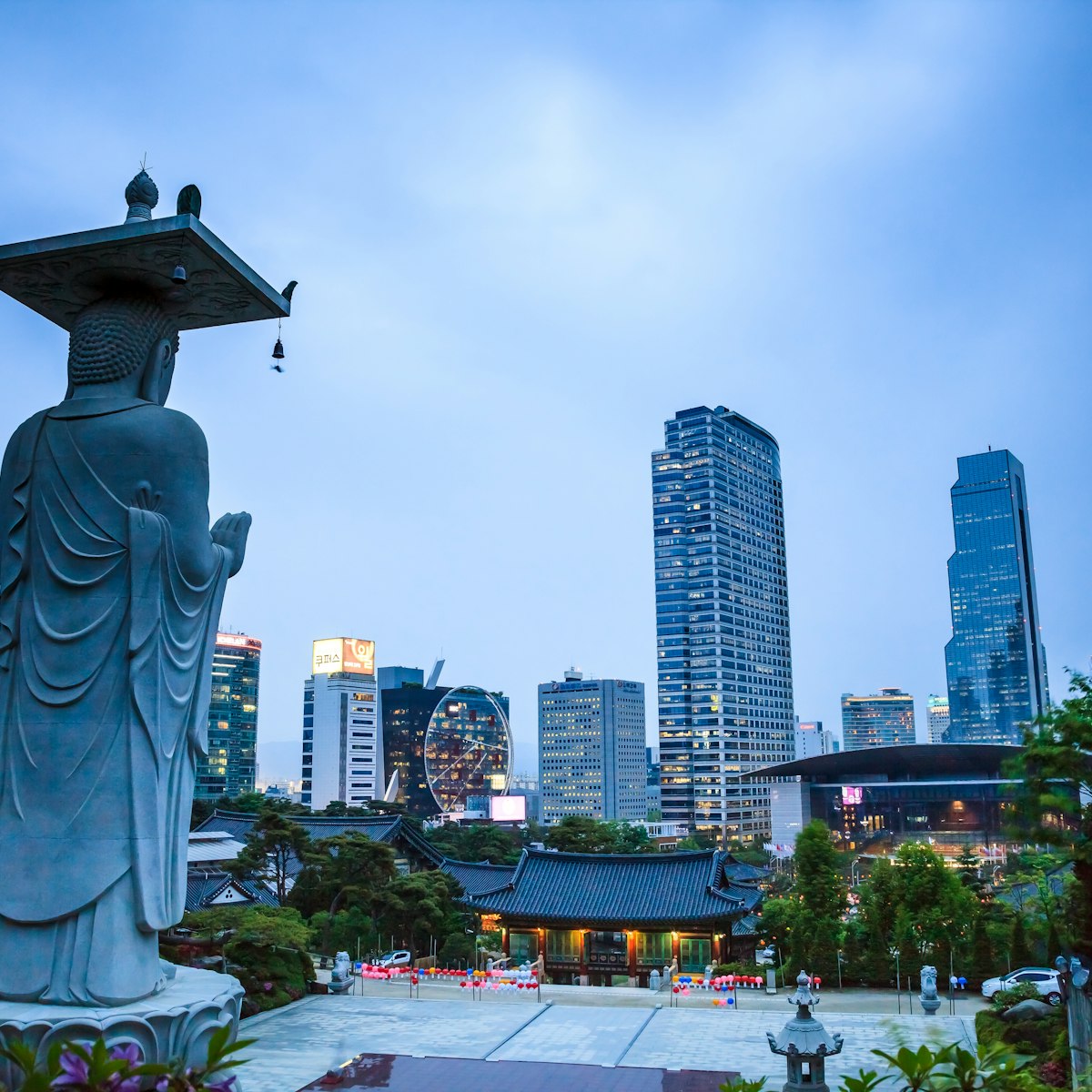
Gangnam & Southern Seoul
Located in the heart of ritzy Gangnam, the shrines and halls of the Buddhist temple Bongeun-sa, with its tree-filled hillside location, stand in direct…
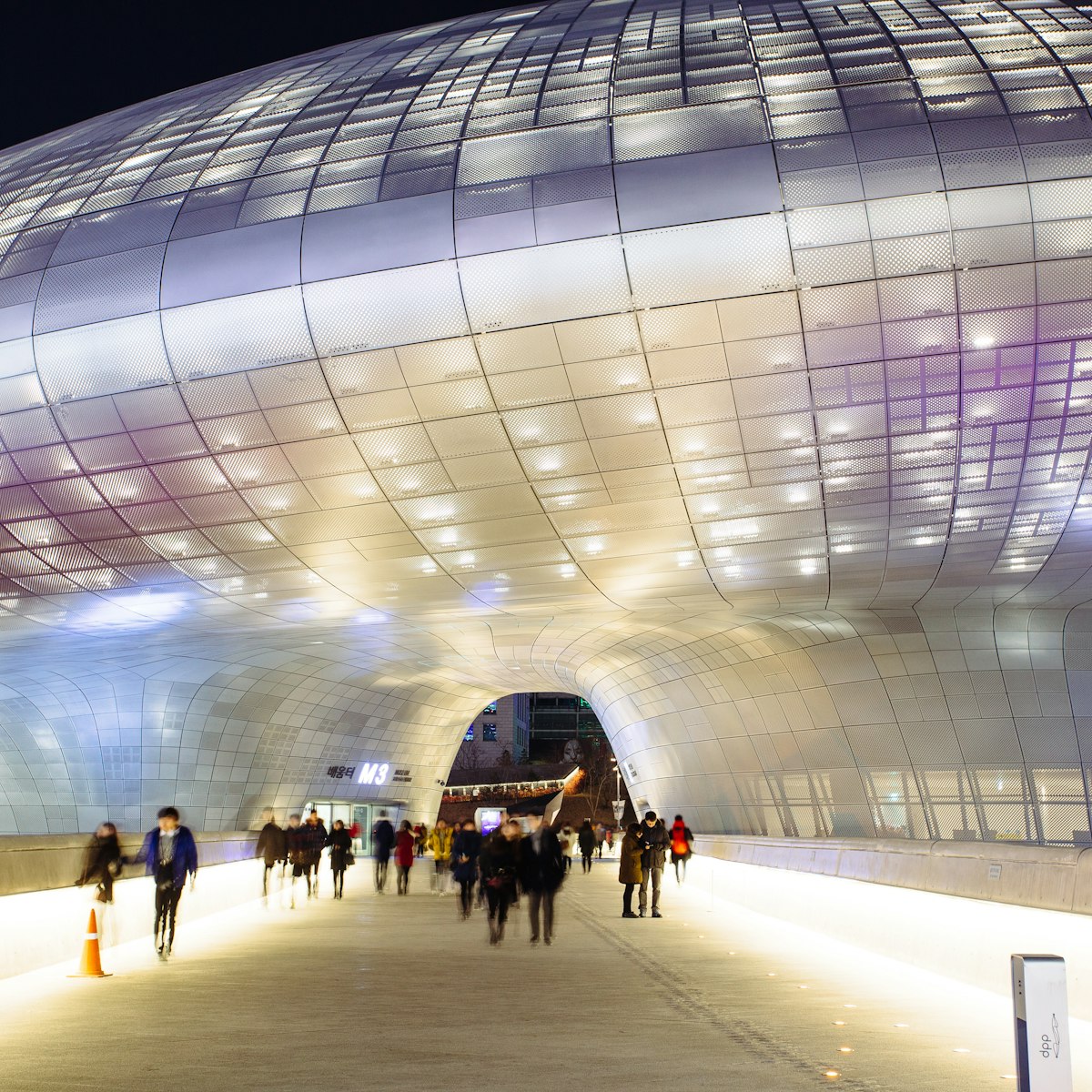
Dongdaemun Design Plaza & Park
Dongdaemun & Eastern Seoul
Designed by the late Zaha Hadid, this neofuturistic cultural complex was commissioned to replace the Dongdaemun Stadium, built during Japanese rule in the…
Top picks from our travel experts
13 of the best things to do in seoul, south korea.
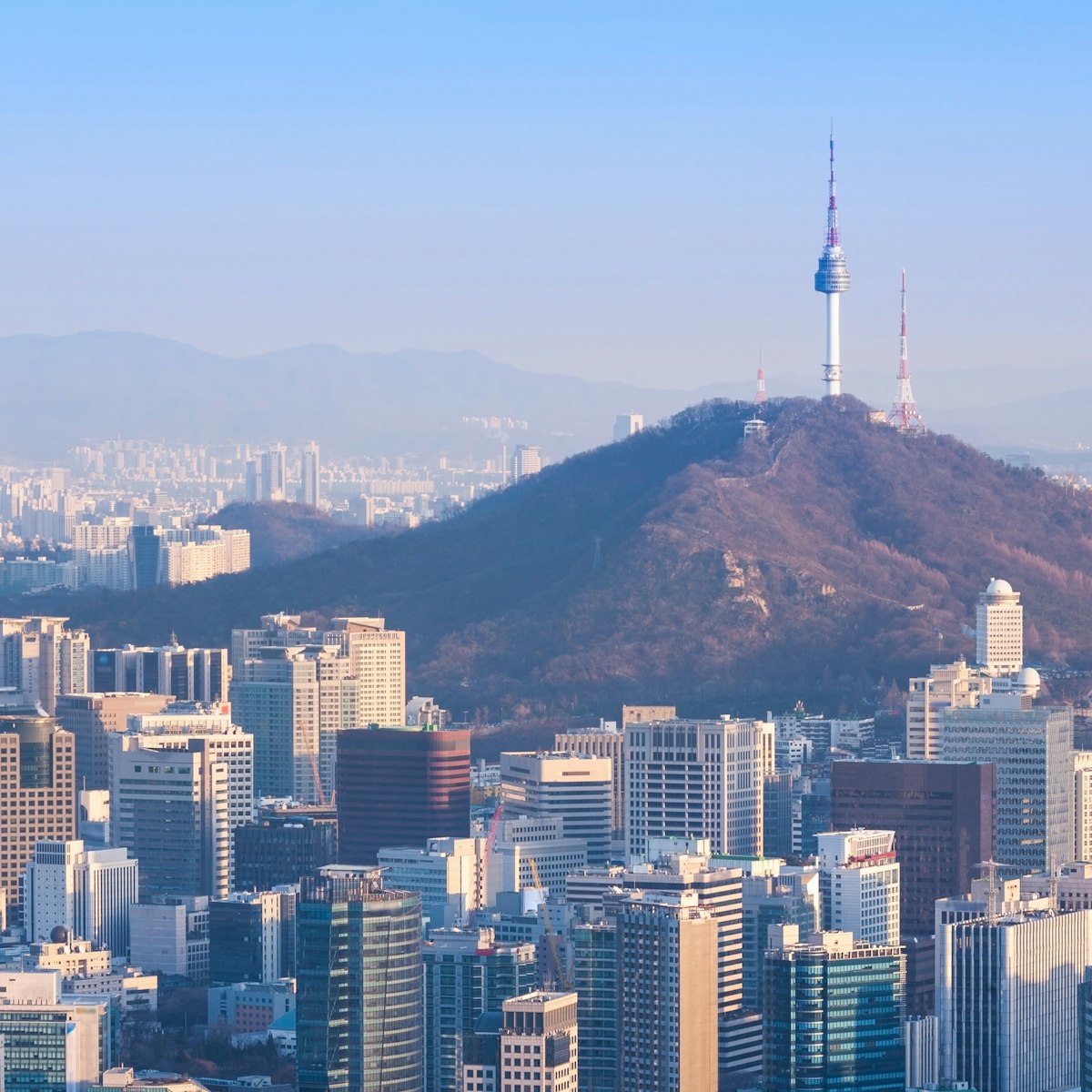
N Seoul Tower & Namsan
The iconic N Seoul tower (236m), atop the city’s guardian mountain Namsan, offers panoramic views of this immense metropolis from its observation deck…

National Folk Museum of Korea
Give yourself at least an hour to do justice to this excellent museum. It has three main exhibition halls, covering the history of the Korean people, the…

Cheong-gye-cheon
With its landscaped walkways, footbridges, waterfalls and a variety of public artworks, such as the enormous pink-and-blue shell entitled Spring in Cheong…

K-Star Road
Gangnam's 'Hallyuwood Walk of Fame' pays homage to K-Pop stars in the form of cutesy bear sculptures dedicated to K-Wave singers and actors.
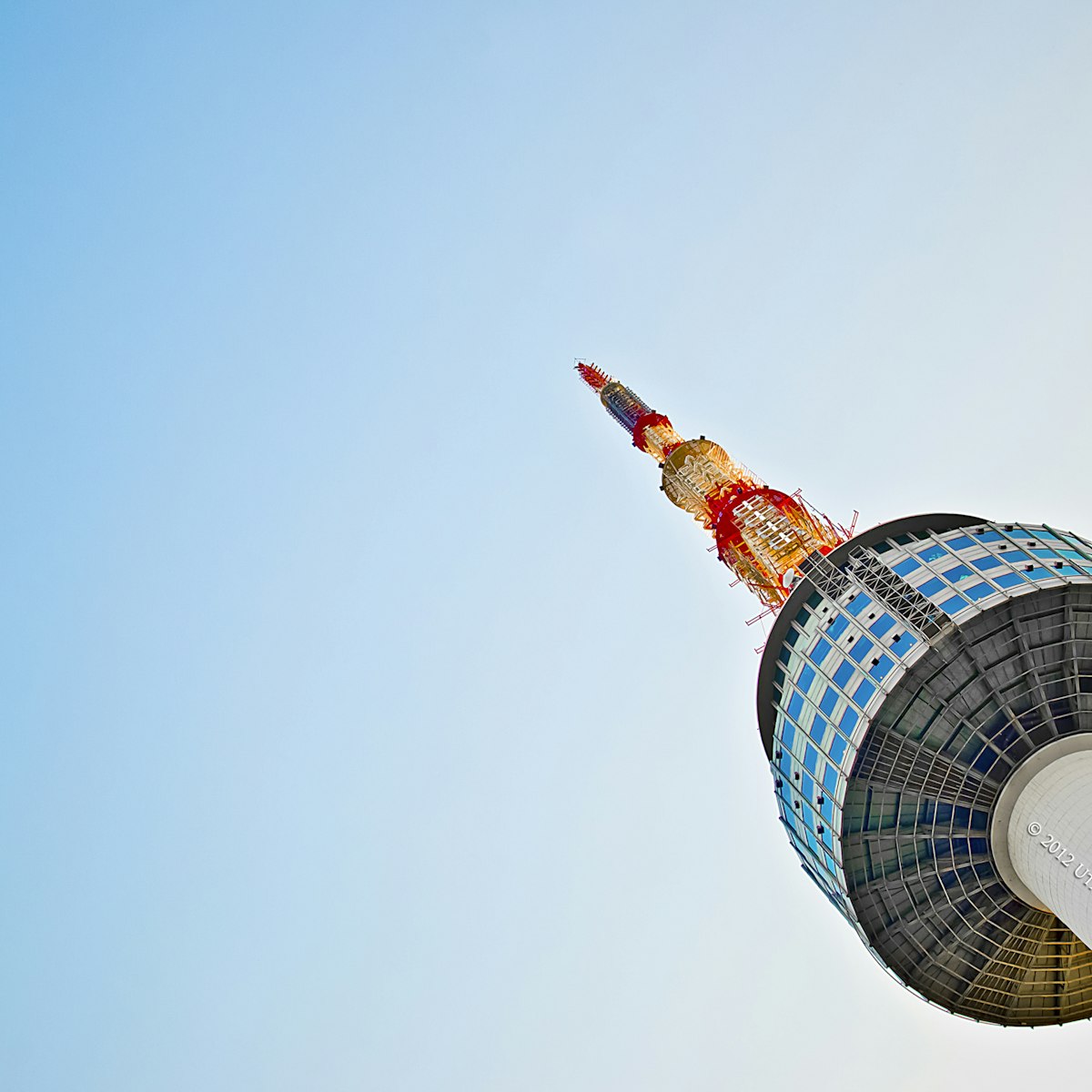
Namsan Park
Beloved by locals as a place for exercise, peaceful contemplation and hanging out with loved ones, Namsan was a sacred shamanistic spot when the Joseon…

Stylenanda Pink Hotel
One of the most popular brands for affordable, young women's casual fashion, Stylenanda's flagship store is especially notable for its pink design. The…

Gwanghwamun
The impressive main gate to Seoul's premier palace is flanked by stone carvings of haechi, mythical lion-like creatures traditionally set to protect the…

Bukchon Hanok Village
Meaning ‘North Village’, Bukchon, between Gyeongbokgung and Changdeokgung, is home to around 900 hanok, Seoul’s largest concentration of these traditional…
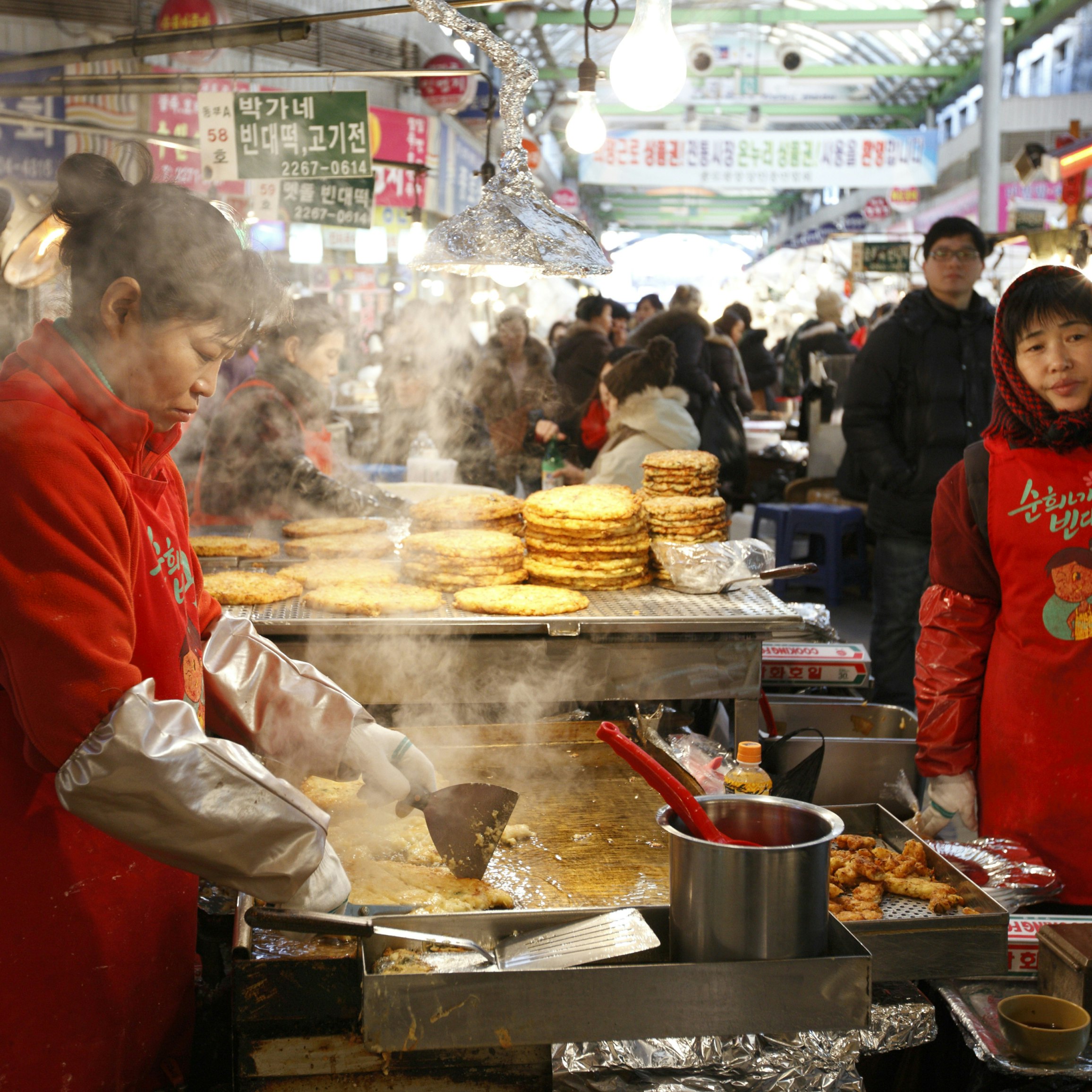
Gwangjang Market
This sprawling fabric market is now best known as Seoul’s busiest meokjagolmok (food alley), thanks to the 200 or so food stalls, kimchi and fresh-seafood…
Free your Seoul: 26 of the best no-cost things to do

Northern Seoul
This modern hillside temple is a pleasure to visit at any time of the year, but particularly in May when the grounds are festooned with lanterns for…

Seoul Museum of History
To gain an appreciation of the total transformation of Seoul down the centuries, visit this fascinating museum, which charts the city's history since the…

Cheong-gye-cheon Museum
To fully comprehend what a mammoth and expensive effort it was to resurrect Cheong-gye-cheon, Seoul’s long buried east–west stream, pay a visit to this…
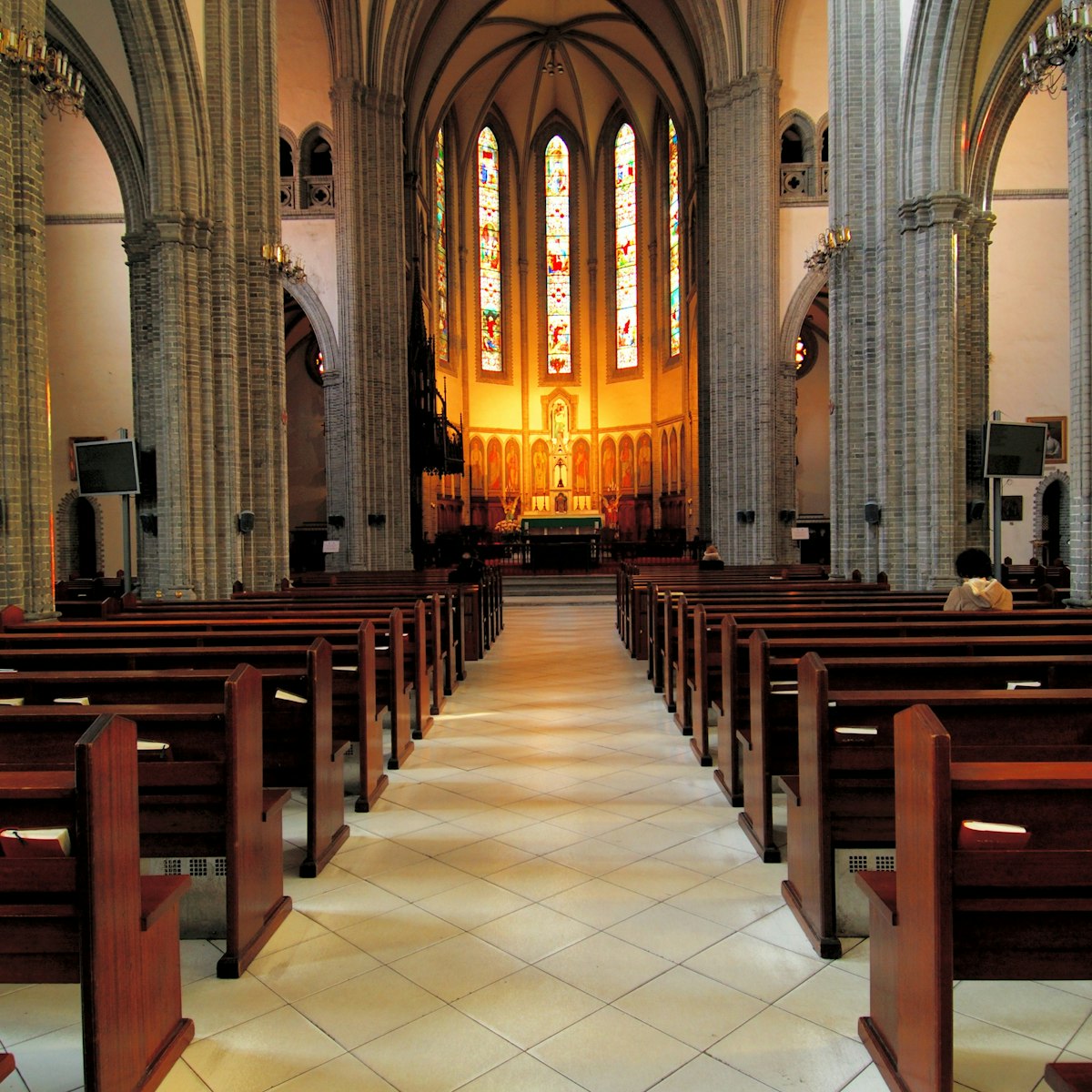
Myeong-dong Catholic Cathedral
Go inside this elegant, red- and grey-brick Gothic-style cathedral, consecrated in 1898, to admire the vaulted ceiling and stained-glass windows. The…

Gyeonghuigung
The Palace of Shining Celebration, completed in 1623, used to consist of a warren of courtyards, buildings, walls and gates spread over a large area. But…

Seoul Museum of Art
Hosting world-class exhibitions that are always worth a visit, SEMA has ultramodern, bright galleries inside the handsome brick-and-stone facade of the…

Ihwa Mural Village
High on the slopes of Naksan is one of the city's old daldongnae (literally ‘moon villages’) where refugees lived in shacks after the Korean War. Sixty…

Gyeongui Line Forest Park
This 6.3km park, named for the former Gyeongui Line (on which it was built), is a narrow, long green space that runs along the discarded railroad tracks…
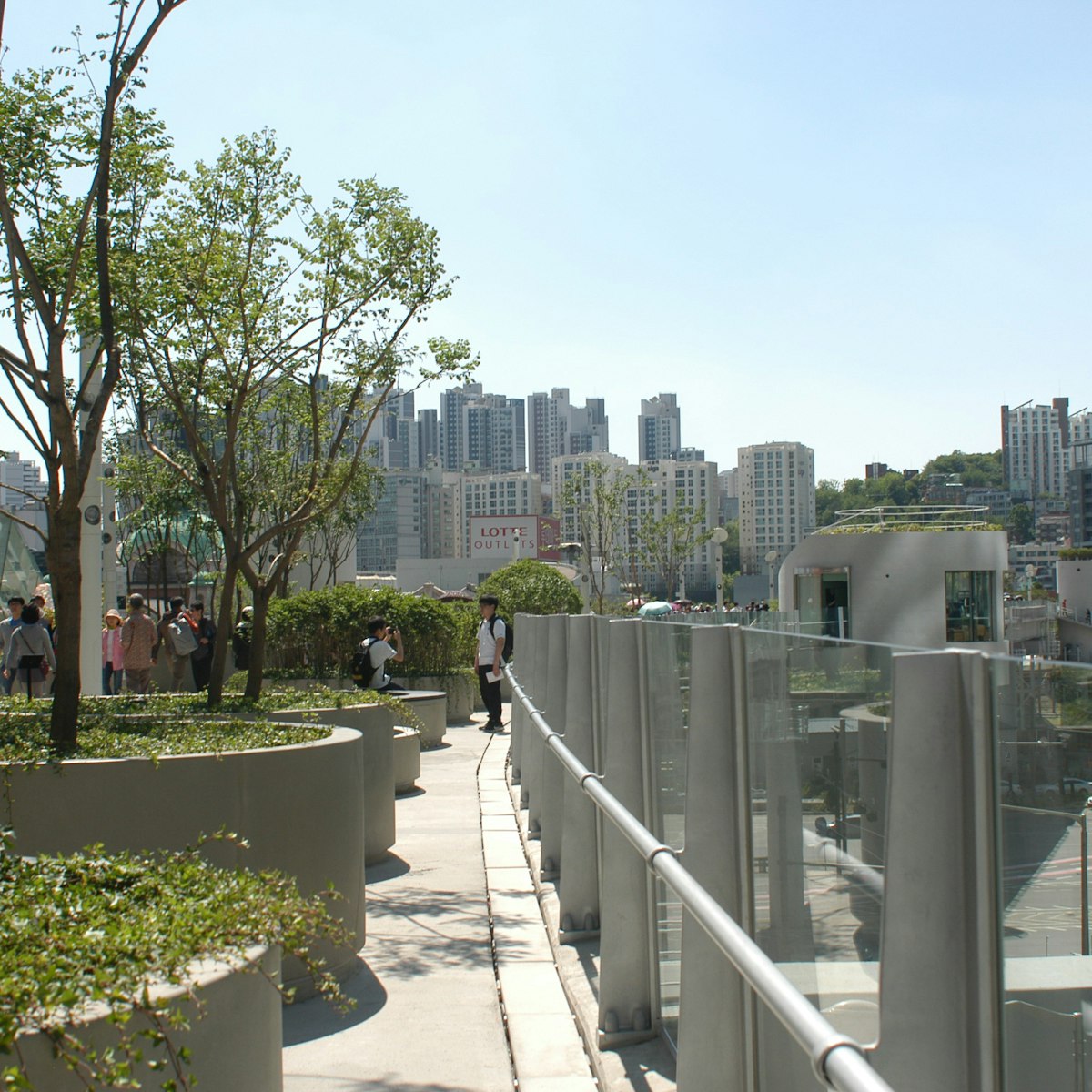
Seoullo 7017
This overpass-turned-park is a green space in the heart of the city. About 24,000 plants are grown here, including various types of flowers and trees, all…

Oil Tank Culture Park
Originally built after Korea’s first oil crisis in 1973 and reopened in 2017, this cultural centre is made up of five abandoned oil tanks. Planted in a…

One of Seoul's premier malls and the world's largest underground mall, the shiny COEX is a vast maze of department stores loaded with shops selling…

Banpo Bridge Rainbow Fountain
Covered with 10,000 lights, the Banpo Bridge Rainbow Fountain's coloured water rains down in messy arcs from the double-decker Banpo Bridge. More…

Naksan Park
The lofty slopes above Daehangno offer fantastic city views and contain an impressive section of the Seoul City Wall, which you can follow in either…
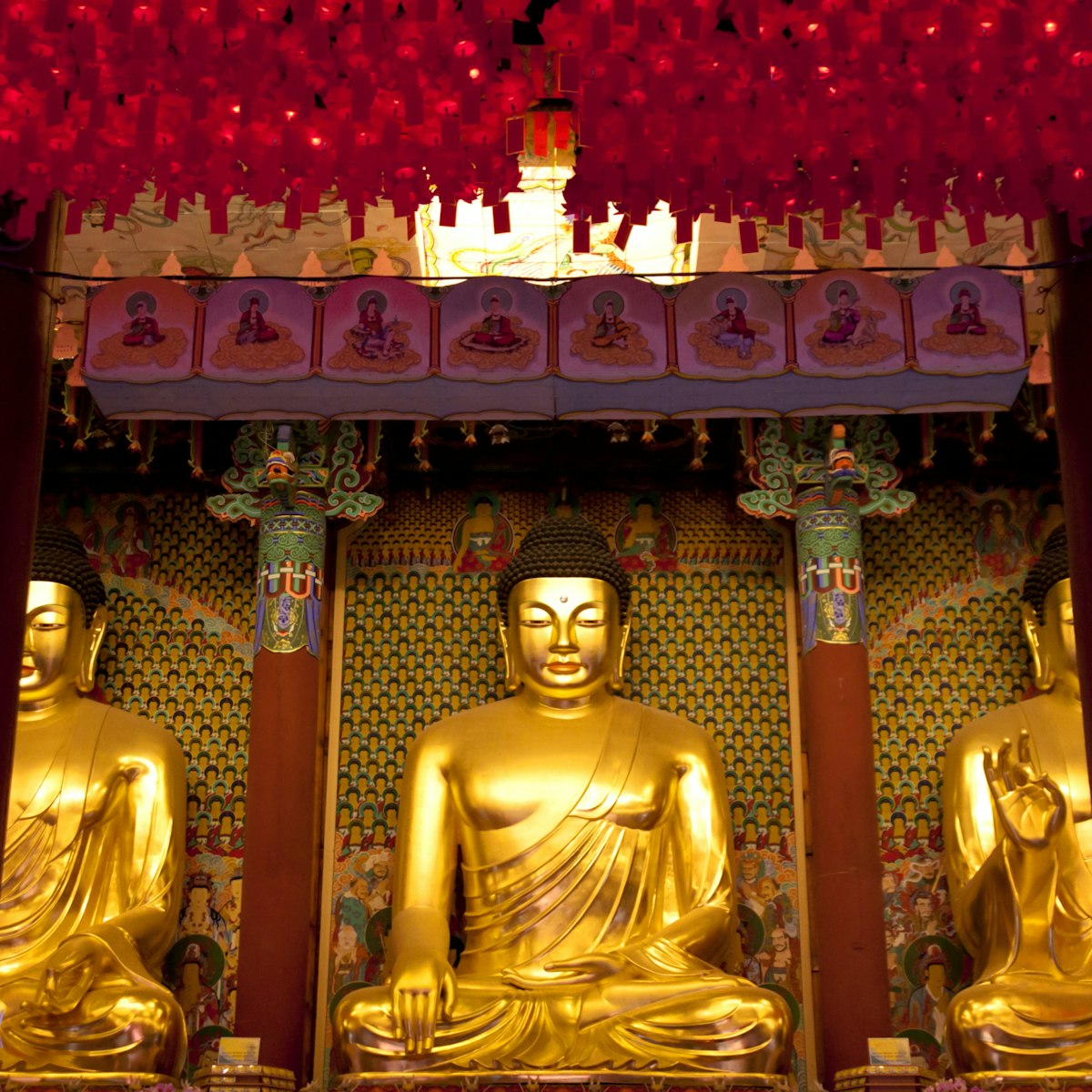
The focus of Jogye-sa is the grand wooden hall Daeungjeon, Seoul's largest Buddhist worship hall and the epicentre of Korean Buddhism. Completed in 1938,…

Jeoldusan Martyrs' Shrine
Jeoldusan means ‘Beheading Hill’ – this is where up to 2000 Korean Catholics were executed in 1866 following a royal decree, most thrown off the high…

Seonyudo Park
A former water-filtration plant on an island in the Han River has been transformed into this award-winning park. The old industrial buildings have been…
Planning Tools
Expert guidance to help you plan your trip.
Things to Know
If you’re planning a trip to Seoul, follow these solid tips to guide you through everything you need to know, from etiquette to transportation.
Best Neighborhoods
Get to know exciting Seoul by exploring the South Korean capital’s neighborhoods, from happening hot spots to quiet backstreets.
So over Seoul? Delve deeper into South Korea's history and culture with these day trips from the capital.
Money and Costs
Stretch your budget in Seoul with these top money-saving tips and a guide to daily costs.
Transportation
Make the most of Seoul's incredible public transport but don't miss out exploring on foot.
Free Things to Do
Visiting Seoul on a budget? These temples, parks and viewpoints offer the best of the South Korean capital – for free.
Latest stories from Seoul
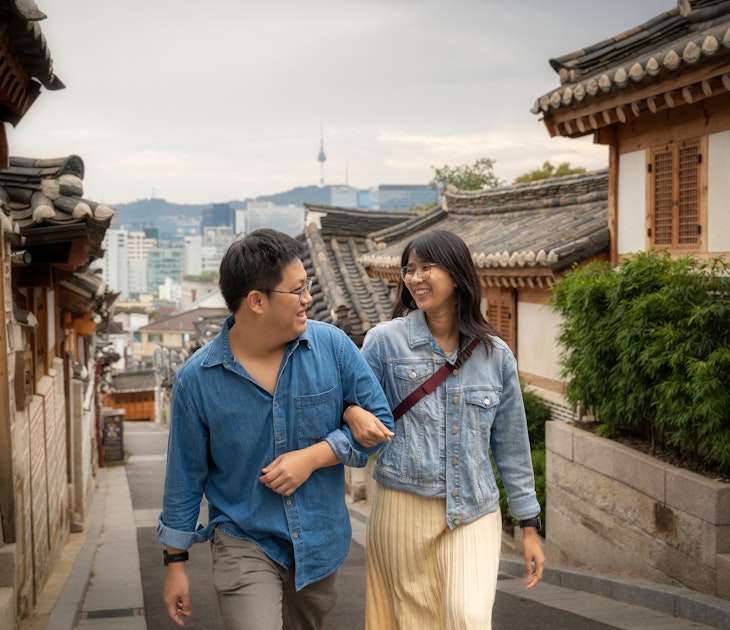
Budget Travel
Feb 17, 2024 • 6 min read
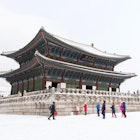
Feb 11, 2024 • 3 min read
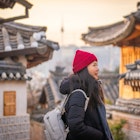
Feb 11, 2024 • 6 min read

Feb 10, 2024 • 10 min read
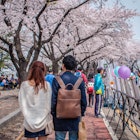
Feb 10, 2024 • 8 min read
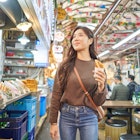
Feb 4, 2024 • 8 min read
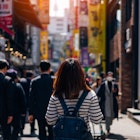
Feb 3, 2024 • 6 min read
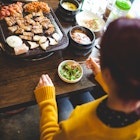
Aug 31, 2022 • 12 min read
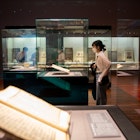
Jun 22, 2022 • 7 min read
in partnership with getyourguide
Book popular activities in Seoul
Purchase our award-winning guidebooks.
Get to the heart of Seoul with one of our in-depth, award-winning guidebooks, covering maps, itineraries, and expert guidance.
Seoul and beyond
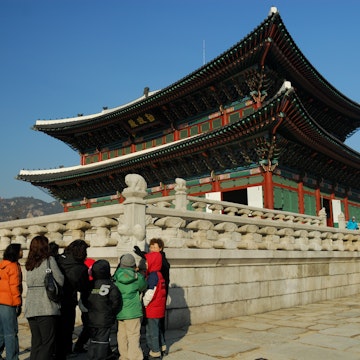
TheKoreanGuide is a reader-supported site. Purchases made through links may earn a commission.
Seoul Travel Guide: What To Do and Must-Visit Attractions

With airports opening back up and tourism increasing in the past year, there’s plenty of destinations for you to choose from.
One of those places is Seoul, South Korea, which is home to brilliant exhibits of culture and art. What is there for you to do in Seoul, and is it worth it?
Seoul, South Korea is a large city filled with culture and tourist activities that make it worthwhile. Not only is Seoul a very safe city to visit, but it is rising in popularity due to the impacts Korean culture, entertainment, and business has had on the rest of the world. Seoul is among the most visited cities in the world.
The rest of this article will cover what to do in the city, where to stay, what Seoul is known for, and a brief conclusion.
What To Do In Seoul
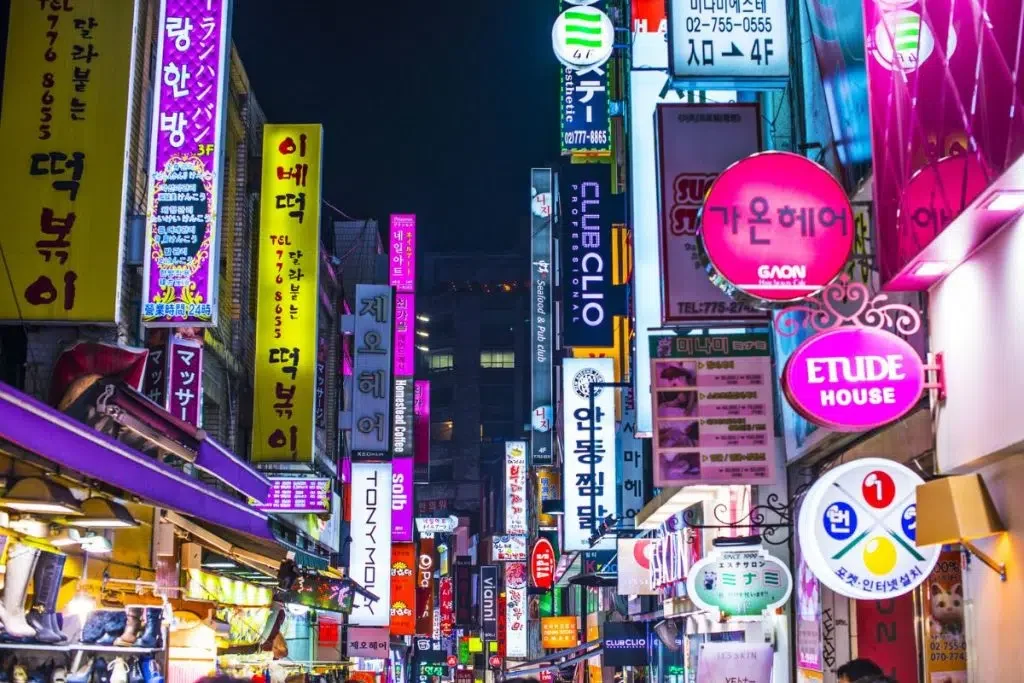
Seoul (서울) is a vibrant city with gorgeous sights and culture you have to see. But before we get into that, we have to talk about one of the most important parts of South Korean culture: the food. Between side dishes, street food, and stews, South Korea has a versatile cuisine!
Side Dishes
A staple of Korean culture are the side dishes served with each meal. Called Banchan (반찬) by Koreans, side dishes is an idea that dates back to the Korean royal court cuisine, which consisted of anywhere between 2 to 12 side dishes.
Cheaper restaurants tend to serve less, but each side dish is tasty and compliments the meal. Banchan arrives before meals, but don’t confuse them with an appetizer.
They are included in the cost of the meal, and the best part: they have free, unlimited refills!
Some common side dishes are: kelp noodle salad (cheonsachae salad or 천사채), spicy Korean coleslaw, sweet and salty soybeans (kongjabean or 콩자반), sweet and salty lotus roots (yeonkeun jorim or 연근조림), and Korean style sausage stir fry.
Street Food
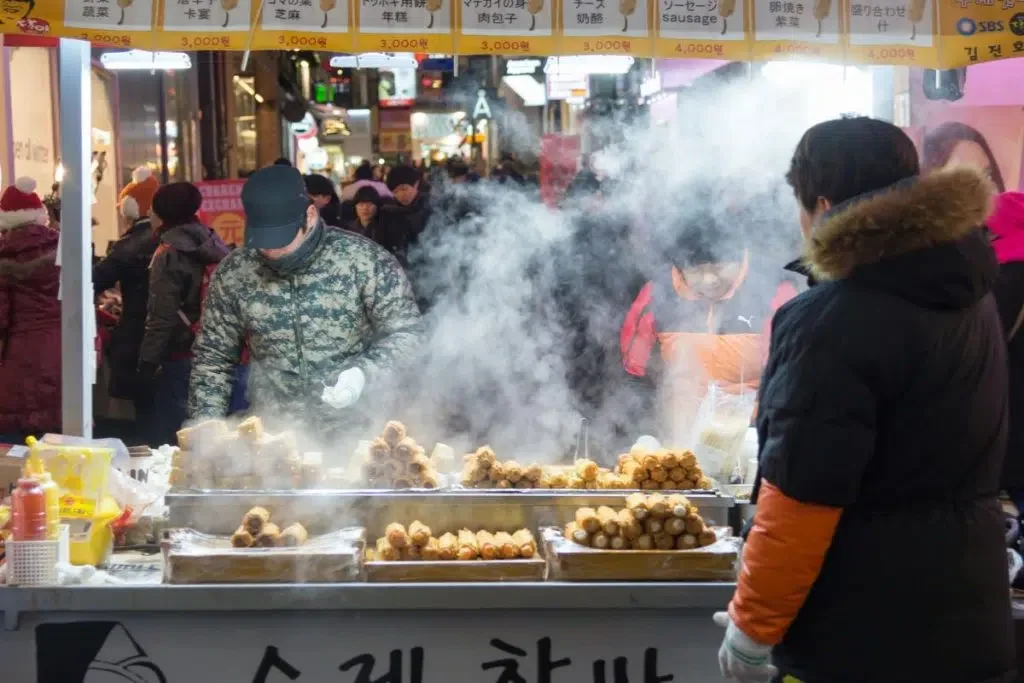
If you’re looking for an alternative to dine-in restaurants, street food is just for you! Street food is ready-to-eat food you can buy from local vendors.
Even better: vendors are easy to find and are lined up and down the Seoul streets, all you have to do is find the one that suits you!
There are plenty of foods to choose from, so get your chopsticks ready. For starters, you have to try Korean style fried chicken. It’s a must when you’re in Seoul.
Street vendors will absolutely sell Korean fried chicken, and you should at least try them while you’re there!
There’s also bibimbap (비빔밥). Bap (밥) in Korean literally means rice, or meal. Therefore, bibimbap translates to mixed rice.
Bibimbap has warm rice and sauteed and or seasoned vegetables. A raw or fried egg and sliced meat, normally beef, are included as well.
Korean dumplings ( mandu or 만두) are another commonly served street food dish. There are many different types of dumplings you can get such as vegetable dumplings, beef dumplings, and or pork dumplings. These foods are all super tasty and super affordable!
With Seoul having a cool climate, soups and stews are a significant portion of a Korean’s diet. One popular stew is known as Army stew.
This stew has American processed meat such as Spam, ham, bacon, and hot dogs. Those meats are mixed into a Korean stew with kimchi .
Kimchi-jjigae (김치찌개) is a stew made with kimchi and various other ingredients such as pork or seafood, scallions, onions, and diced dubu. This stew is a popular choice in South Korea, and it’s a common stew to find in Seoul.
Lastly, another popular stew is Korean crab stew (kkotgetang 꽃게탕). This stew is pretty self-explanatory. It’s a stew with a flower crab as the primary ingredient.
There’s also Korean radish, garlic, dried anchovies, and other ingredients that vary by the recipe.
The Sights In Seoul, South Korea
Seoul itself is an architectural landmark. There are specific sights in Seoul that are places you have to visit while you’re there.
A few of those places are: N Seoul Tower, the Ansan Starlight Village, and the Jogyesa. There’s also entertainment like underground shopping.
N Seoul Tower
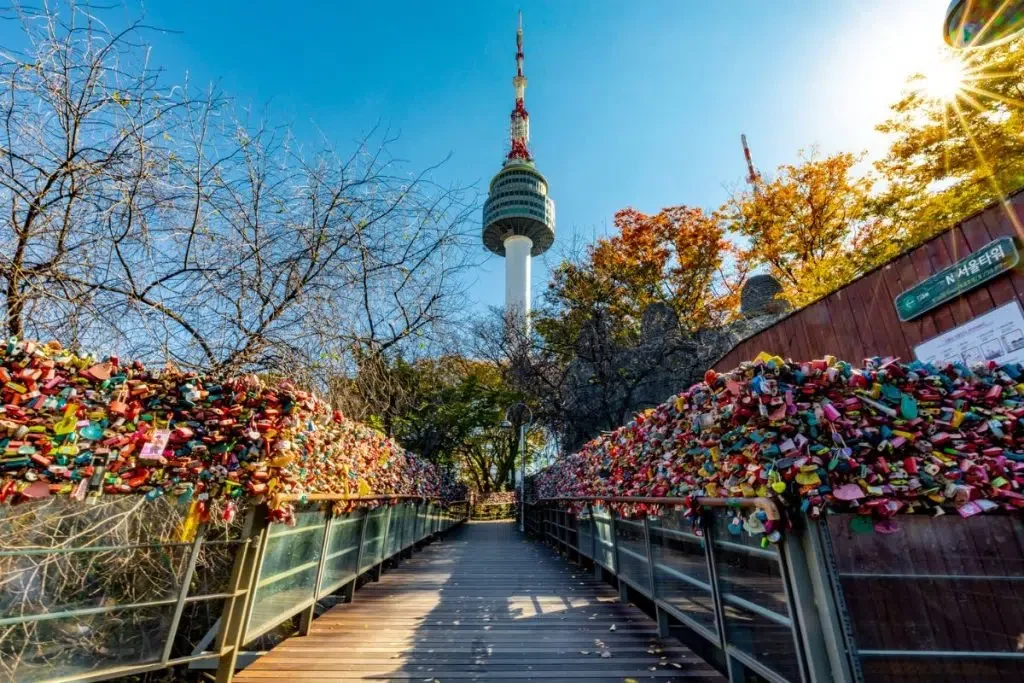
The N Seoul Tower is famous for its location and height allowing access to the gorgeous skyline of Seoul.
Back in 1969, it was utilized as Korea’s first general radio wave tower. TV and radio broadcasts would play from the N Seoul Tower to the surrounding metropolitan area.
This tower is 236 meters high and is the second-highest point in Seoul. It is a communication and observation tower on Nam Mountain.
The N Seoul Tower is in the center of Seoul, which is why the height and location is so perfect for tourists looking to get amazing pictures.
Ansan Starlight Village
Perhaps the brightest pick on this list, the Ansan Starlight village is a radiant garden along the expressway of Ansan.
It is known for being festive and romantic all-year-round, and displays of over 200 animals are there. These animals include: owls, cranes, swans, elephants, and more.
Not only does it provide an astonishing atmosphere for relaxation and Instagram posts, but it’s also an area that sparks romance.
Marriage proposals are a common occurrence there due to the perfect lighting and activities.
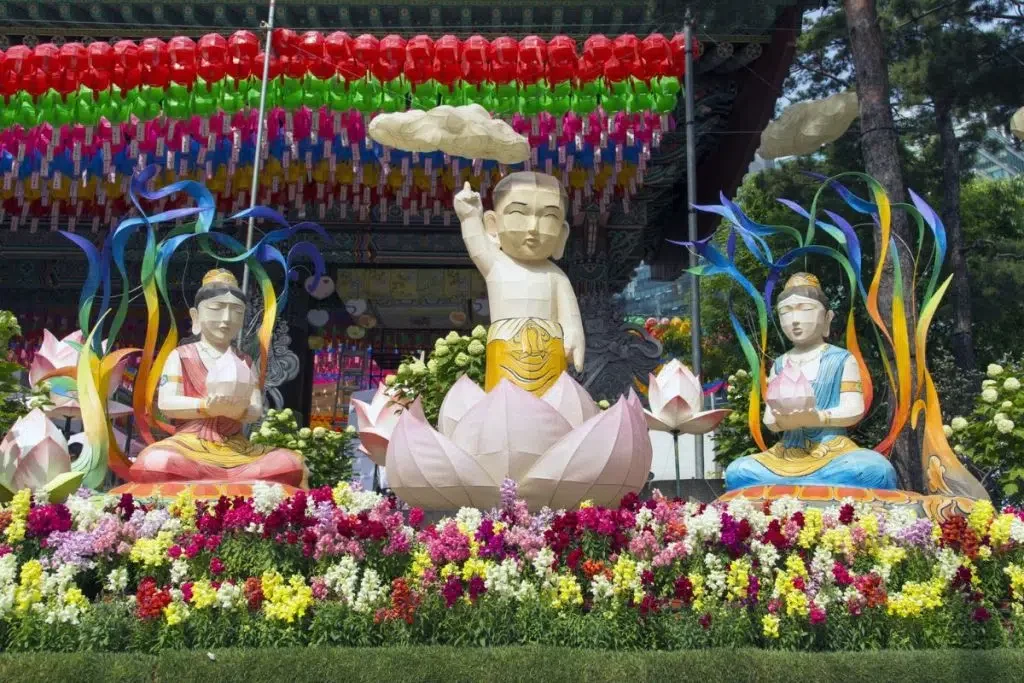
The Jogyesa (조계사) is a Korean Buddhist temple. It is the chief temple of the Jogye Order. The building itself dates back to the 14th century, becoming the chief temple in 1936. It is located in central Seoul, and it is known for its zen environment.
Not only is the architect magnificent, but the nature surrounding it is fresh and preserved, just like the temple.
The Jogyesa is a common tourist site for experiencing royal palace life. You can tour the building with a guide and see all the history and architecture with your own eyes.
Underground Shopping
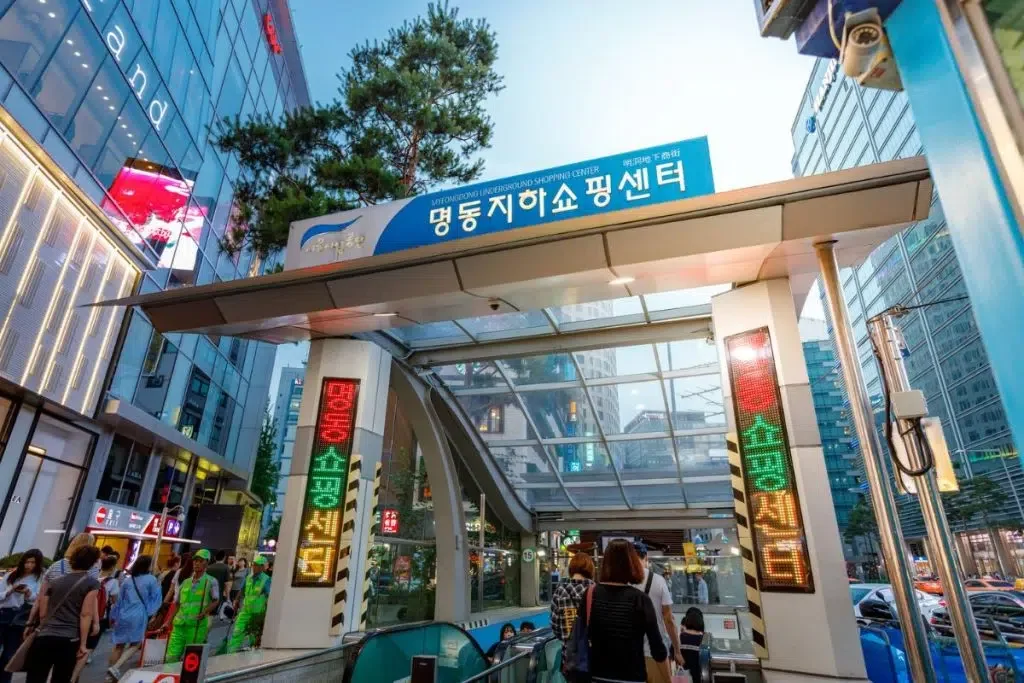
A famous activity in Seoul is underground shopping. Two examples of underground shopping areas are the Express Bus Terminal Underground Center and the Gangnam Underground Shopping Center.
These shopping areas are perfect for good finds, even on a rainy day.
Many of the shopping centers, both above ground and underground, are located in Myeongdong , the shopping district of Seoul.
Underground shopping centers don’t risk putting a large dent in your budget. They’re cheap yet fashionable and useful.
Some tips for underground shopping are to bring cash with you and check out the trendy stores. Some items require cash, no credit.
As for the trendy stores, you can find the latest fashion trends at underground stores for more affordable prices, so be on the lookout for that!
Where To Stay In Seoul
When it comes to the size of South Korea, it’s not as large as other countries like America. So, their compromise was to build their buildings upwards to make more space, not side-to-side. This means there are many apartment buildings and hotels all around Seoul.
There are 5 main districts in Seoul you should consider staying near: Myeongdong , Hongdae , Gangnam , Itaewon , and Jamsil .
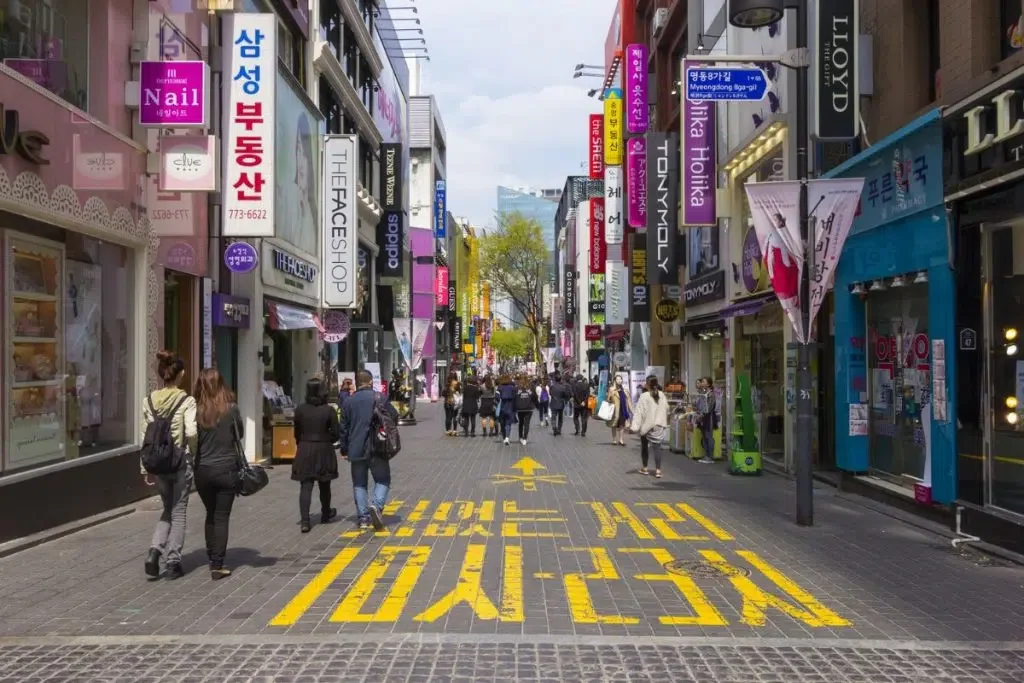
Prices and quality depends on which area you choose. There’s Myeongdong (명동), which is known for being a huge shopping district.
The Westin Josun Seoul Hotel is only a 5-minute walk away from the bustling life of Myeongdong. It’s a highly rated hotel with many activities inside.
The shopping district has everything you’ll need from body care items you misplaced to trinkets and K-pop albums. There are department stores, shoe stores like Adidas, perfume shops, skincare stores, H&M, and many more for all your traveling and souvenir needs.

Hongdae (홍대) is for those craving an adventure more indie and fashionable. It’s a creative district with plenty of cafes and Korean BBQ. Mono House Hongdae is a minimalist housing property that’s affordable and only 5 minutes away from the Hongik University Subway Station.
The entertainment value at Hongdae is incredible. The Tricky Eye Museum Seoul relies on visual tricks to keep you on your toes and show you various art. There’s also clubs for dancing and music. Hongdae as a whole values urban arts, indie music culture, and entertainment.
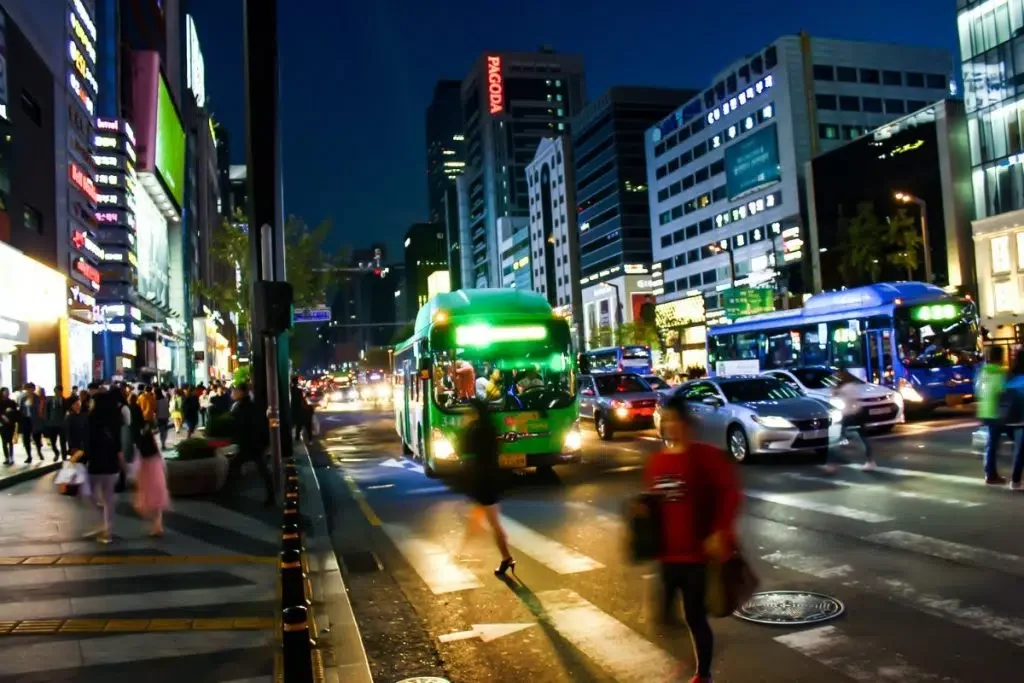
Gangnam (강남구) is a wealthier district of Seoul, meaning higher quality living, but at the cost of much higher prices. The Park Hyatt Seoul is an expensive 5-star hotel that has a relaxing spa and gorgeous views of Gangnam. It’s worth the price for the views alone!
There’s also the Aloft Seoul Gangnam. This is a cheaper, 4-star hotel that’s the better option for those wishing for a taste of the high life without losing a significant amount of money in the process. It includes business services, an on-site restaurant, free Wi-Fi, and a lounge.
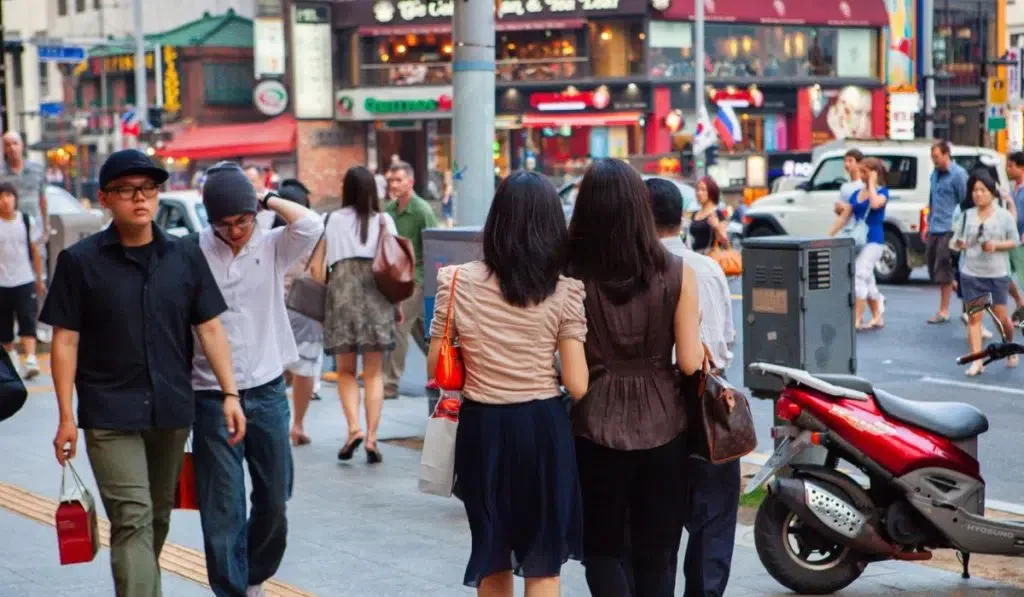
If you were called the life of the party growing up, Itaewon (이태원) is for you. It’s nicknamed the “Western Town” of Seoul due to the variety of international cuisine and entertainment offered there. It has multiple unique bars, restaurants, and activities around town all worth visiting.
The Grand Hyatt Seoul is a 5-star hotel with over 600 rooms and over 50 suites. It’s close to both Itaewon and Myeongdong, but it is expensive. However, it may be worth it since some amenities include an on-site restaurant, an indoor pool, and free Wi-Fi.
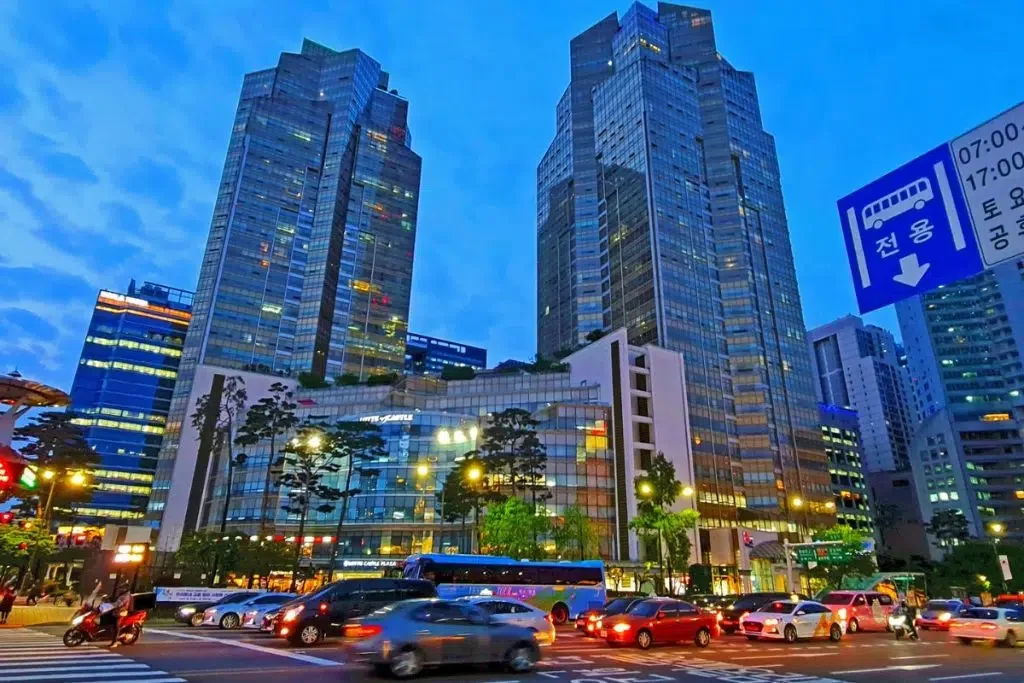
Jamsil (잠실동) is the best spot for families. It’s also great for those who love sports. Jamsil is home to not one, but two professional Korean baseball teams: the LG Twins and Doosan Bears. It’s rich with K-pop culture, and it’s also home to Lotte World, an amusement park.
The Lotte World Hotel is right beside the amusement park of the same name, and it is a 5-star hotel that also sits on top of Jamsil Subway Station.
It’s the perfect hotel for your family to travel across Seoul and Jamsil, experiencing the amusement park as well as the culture.
What Seoul Is Known For
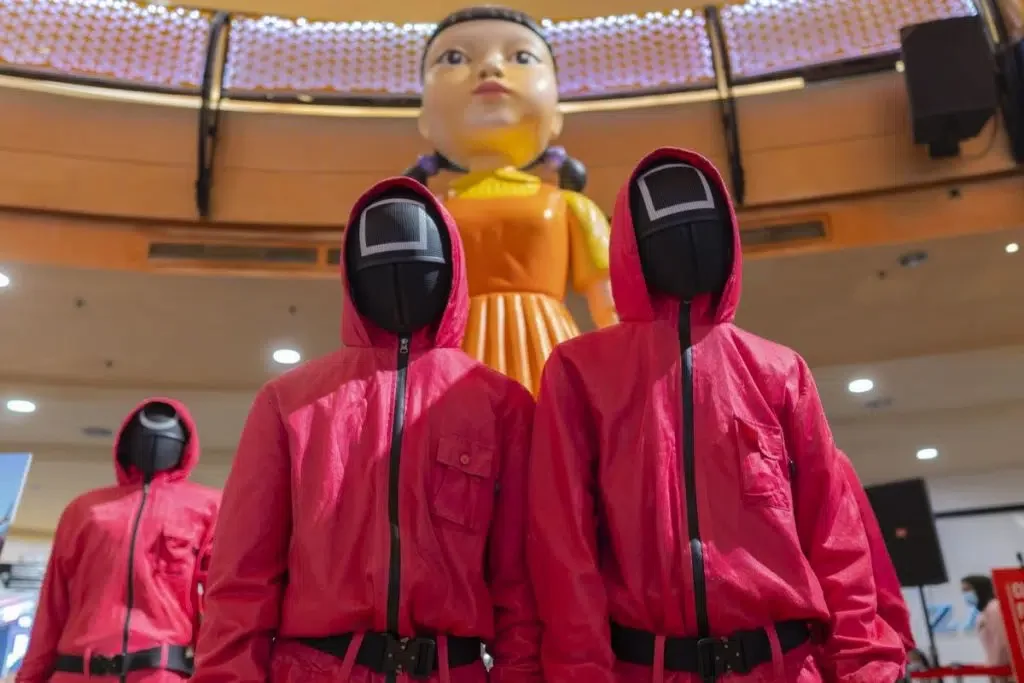
It would be impossible to talk about Seoul without mentioning the entertainment industry that has brought us popular K-dramas such as Squid Game, and the K-pop industry that brought us the worldwide superstars BTS. Seoul is overflowing with creativity and art.
Fun fact: Seoul is the birthplace of K-pop. Although the term wasn’t coined until 1999 by Cho Hyun-jin, Korean music groups rose from Seoul.
History and culture is thriving in the city, and that’s what tourists go to visit. Places like the Gyeongbokgung Palace (경복궁) are famous destinations.
One of the most famous aspects of Seoul is the street food. Street food is cheaper than restaurant food and it still tastes yummy. It’s a perfect alternative to when you don’t want to spend a lot of money, and you want to wander around the streets of Seoul while eating.
South Korea is known for its beauty standards and skincare . Koreans use natural ingredients to keep their skin clean and smooth. In the west, Korean skincare products and routines are popular because of the glowing skin they cause. Many of these products come from Seoul.
Lastly, Seoul is known for the preserved royal temples around the land. There are more than 900 traditional Buddhist temples that are centuries old. In total, there are over 20,000 temples in Seoul.
Seoul is a beautiful and safe city for tourists that has grown in popularity over the years. It is known for its rich culture, entertainment, skincare, K-pop, and preservation of traditional Buddhist temples.
The food is a must-have. There are various types of food such as side dishes, street food, and stews that will keep you invested in the culture surrounding you. There’s also the sights of Seoul like the N Seoul Tower, and those sights encourage you to snap countless pictures.
Lastly, the 5 main districts of Seoul you should consider visiting are: Myeongdong, Hongdae, Gangnam, Itaewon, and Jamsil.
Each individual place has its own lifestyle and culture. There’s the shopping, the indie culture, the wealthy, the partying, and the amusement park.
Don’t forget to check out Ulsan , Sejong , and Daejeon .
Enjoy the article?
You'll love my daily email! Learn something new about South Korea every single day. It's completely free. <3
About The Author
You May Also Like

10 Best Korean Toners for Dry Skin (2024 Updated)
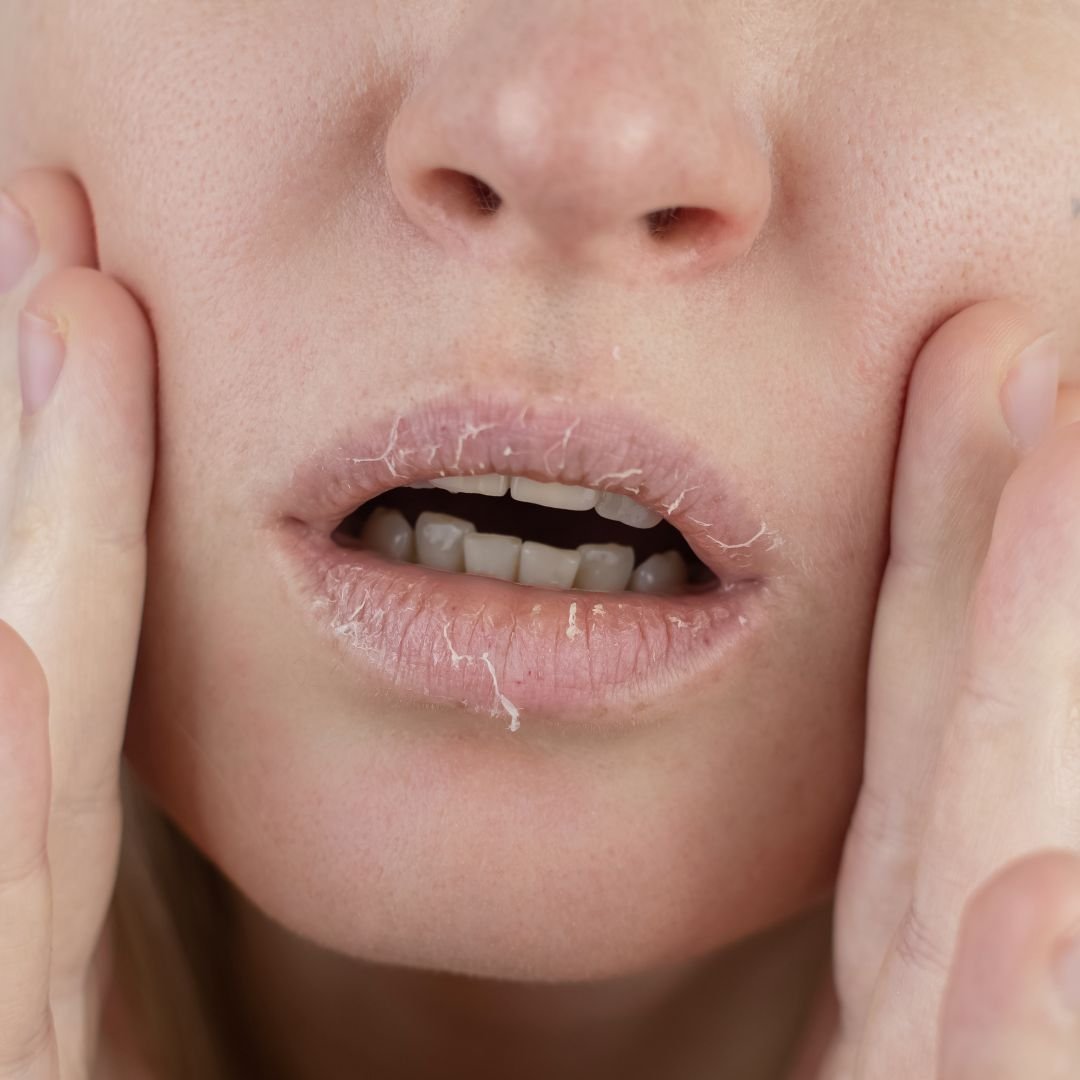
The 8 Best Korean Essences for Dry Skin (2024 Updated)

24 Best Korean Skincare Brands of All-Time

Is Korean Skincare Cheaper in Korea?
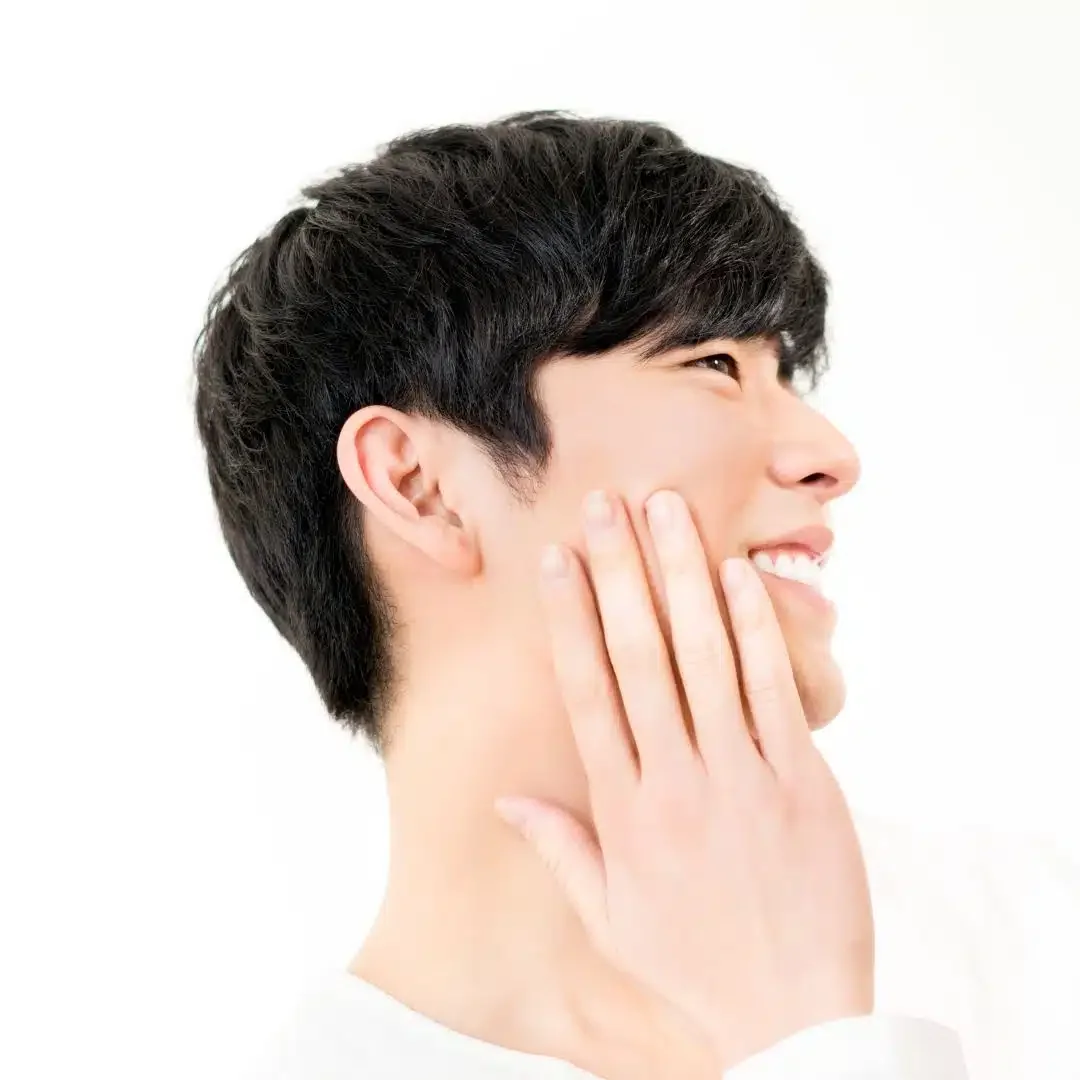
How Long Does It Take for Korean Skincare to Work?
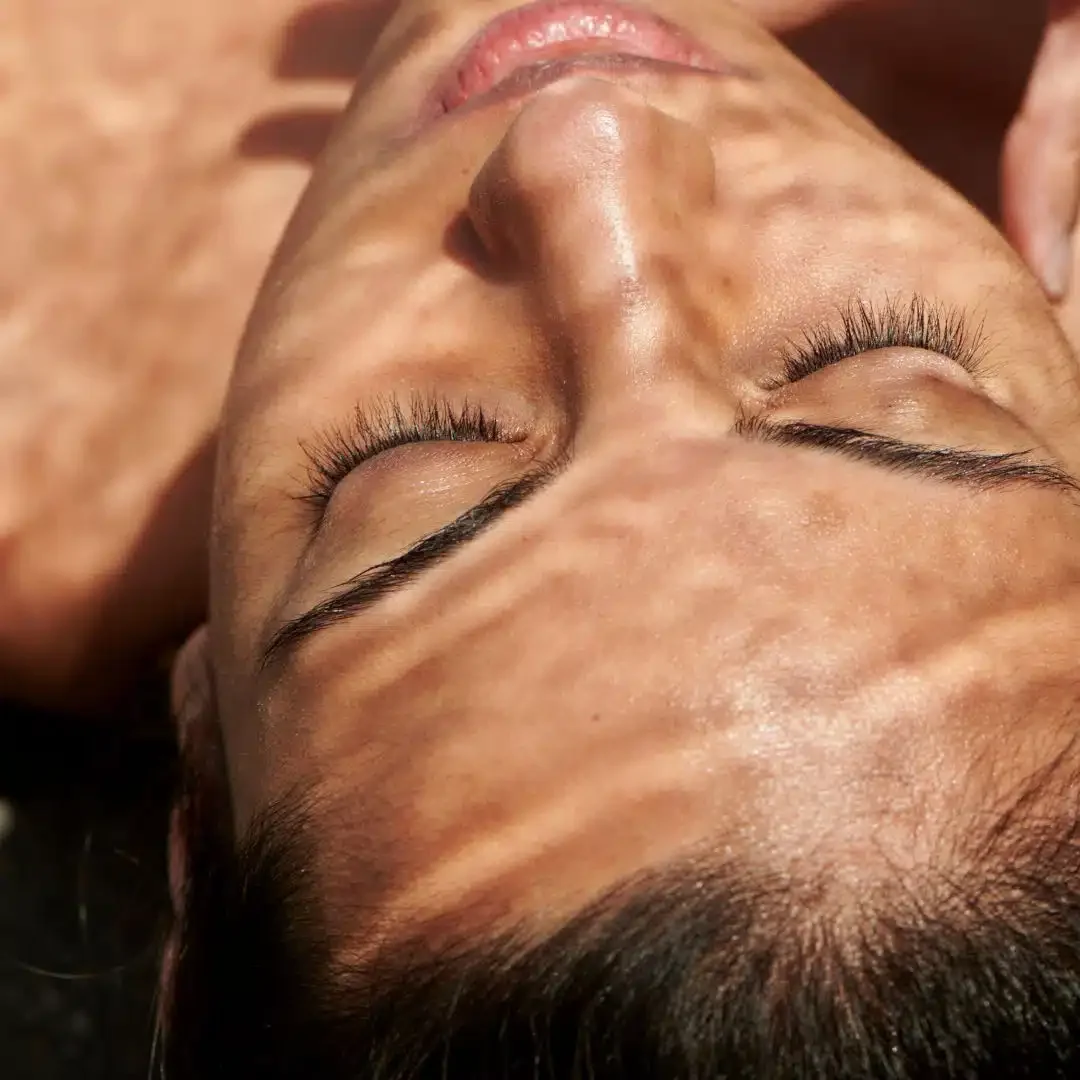
Is Korean Skincare Similar to Japanese?

© 2024 TheKoreanGuide.com | As an Amazon Associate, I earn from qualifying purchases.

South Korea
Travel guide, let us help you plan the trip of a lifetime to south korea.
Are you planning a trip to South Korea but feeling overwhelmed by the possibilities? Look no further than our comprehensive South Korea Travel Guide! Whether you’re a seasoned traveler or a first-time visitor, we’ve got you covered with everything you need to know about exploring this beautiful and fascinating country.
Our guide is packed full of information on where to go, what to see, and when to travel. From the bustling streets of Seoul to the stunning natural landscapes of Jeju Island, we’ll help you create the perfect itinerary based on your interests and preferences. Plus, we provide pre-travel tips to ensure you’re fully prepared for your journey and make the most of your time in South Korea.
We’ll also guide you through the best places to explore in Korea’s diverse and varied cities. Whether you’re interested in historical sites, modern architecture, or delicious food, we’ve got insider tips to make your trip unforgettable. Our season guide will help you plan your visit based on the weather and local events, and we’ll provide information on how much money you’ll need for your travels.
But that’s not all – our guide is filled with essential travel advice to help you make the most of your time in South Korea. We’ll recommend the best souvenirs to buy and where to find them, as well as suggest the top day trips and experiences to enhance your trip. With our South Korea Travel Guide in hand, you’ll be ready to experience everything this incredible country has to offer.
So what are you waiting for? Dive into our guide and start planning your South Korea adventure today. Happy travels!
Best Destinations In Korea
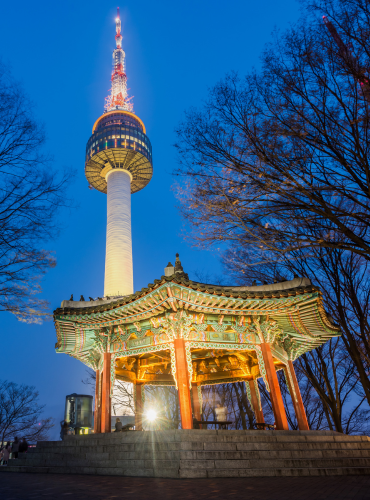
Seoul, the capital of South Korea, is a captivating destination for travelers seeking a mix of rich history, vibrant culture, and modern charm. Explore the city's iconic landmarks, such as Gyeongbokgung Palace and N Seoul Tower, or immerse yourself in the energetic atmosphere of trendy neighborhoods like Hongdae and Gangnam. Indulge in delicious street food, shop at bustling markets, and discover the city's thriving K-pop and entertainment scene for an unforgettable travel experience in Seoul.

Busan, located on South Korea's southeastern coast, is a vibrant coastal city renowned for its stunning beaches, picturesque mountains, and bustling seafood markets. Explore the golden sands of Haeundae Beach, hike up the scenic trails of Geumjeongsan Mountain, and indulge in fresh seafood at the lively Jagalchi Market. With its mix of natural beauty, cultural attractions like the colorful Gamcheon Culture Village, and delicious culinary delights, Busan offers a diverse and captivating experience for travelers.

Incheon Trip
Incheon, a bustling port city in South Korea, offers a unique blend of modern development and natural beauty. Known for its sleek international airport, Incheon is also home to picturesque islands like Muuido and Wolmido, where visitors can enjoy sandy beaches, scenic walks, and delicious seafood. Explore the vibrant shopping districts, experience the local culture and history at places like Incheon China Town, and savor the flavors of Incheon's diverse culinary scene for an enriching travel experience.
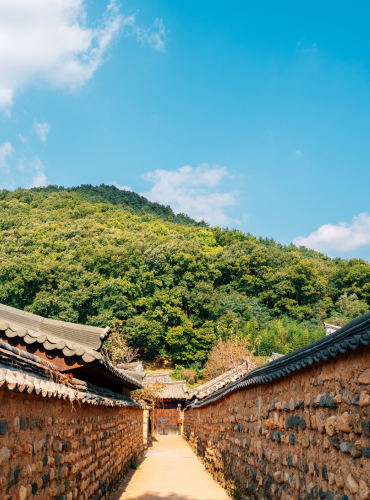
Daegu, located in the southeastern part of South Korea, is a city rich in history and culture. Explore the ancient treasures at sites like Daegu Yangnyeongsi Museum of Oriental Medicine and Donghwasa Temple, known for its giant Buddha statue. Immerse yourself in the city's vibrant fashion and shopping scene at areas like Dongseongro, and savor the local culinary delights, including the famous Daegu-style spicy chicken dish, dakgalbi.

Gwangju Trip
Gwangju, a vibrant city in southwestern South Korea, offers a captivating blend of history, culture, and artistic expression. Explore the city's rich historical sites, such as the 518 Memorial Park commemorating the Gwangju Uprising, and the majestic Gwangju Biennale showcasing contemporary art. Delight in the local cuisine, renowned for its diverse flavors, and immerse yourself in the city's lively street markets and bustling nightlife for an unforgettable experience in Gwangju.

Suwon, a city located near Seoul, is a captivating destination known for its blend of historical landmarks and modern attractions. Explore the impressive Hwaseong Fortress, a UNESCO World Heritage Site, with its imposing walls, gates, and pavilions. Discover the vibrant atmosphere of Suwon's bustling markets, indulge in delicious local street food, and visit the Korean Folk Village to experience traditional culture firsthand. Suwon offers a perfect balance of history, culture, and culinary delights for an enriching travel experience.
High Life Travel
High Life Travel: Unlock the World, Prepaid and Hassle-Free!
Join the travel revolution today and discover the incredible benefits of High Life Travel. Say yes to hassle-free, prepaid travel and unlock a world of possibilities. Don’t let your vacation dreams remain just dreams—turn them into reality with High Life Travel. Visit our website or contact us now to learn more and start your journey towards unforgettable experiences.

“Original and with an innate understanding of their customer’s needs, the team at Love Nature are always a pleasure to work with.”
Jane Miller
Whether you’re curious about features, a free trial, or even press, we’re here to answer any questions.
About South Korea
South Korea is well known for its rich culture, delicious food and stunning landscape. Found in the southern half of the Korean Peninsula Korea is one of the most densely populated countries in the world with a population estimated at over 51 million people.
FREE Resources
Don't miss out on my FREE travel tips and recommendations for traveling in South Korea on my blog!
Popular Blog Posts
Korea Travel Essentials
1. Data & Connectivity 📶
Why should I buy a SIM Card or WiFi Egg?
1) You can share your travel experiences in real-time on social media.
2) You will always have data access to use for navigation apps such as Naver Maps or KakaoMaps. You will need to have a connection to data otherwise you WILL get lost.
3) You can stay in contact with your loved ones from back home easily.
SIM Card vs Pocket Wifi
Whether you choose to use a SIM card or WIFI egg depends on what will work best for your travel needs for your trip. I personally always buy a SIM Card over a WIFI egg based on the PROS.
1) There is no need to carry an extra device i.e. Pocket WiFi
2) Possible to MMS/SMS/Call
3) Provides a local Korean phone number - Some places such as restaurants and cafes require visitors to put down a Korean phone number for a waiting line. If you want to book an appointment e.g. hair or make a reservation for a workshop then having a Korean phone number will allow you to do this.
1) Need an unlocked phone to use a SIM card
POCKET WiFI
1) There is no need to swap your original SIM Card
2) Pocket WiFi can provide a larger amount of data compared to a SIM card. I've generally found I've never 'run out of data' when using a SIM Card. This ultimately depends on what you're using the data for. I mainly use it for basic tasks like navigating around places, translation services, updating my social media and communicating with loved ones back home.
3) Can be connected to multiple devices. This makes it perfect for traveling with family and/or friends and you can split the cost.
1) You need to carry an extra device. This can add weight to your bag, which makes a difference if you're already carrying your phone, camera and other essentials.
2) If you rent a portable WiFi router you will need to return it. This can take up time on your trip which can be used instead for more exploration on your travels.
3) The battery life of a pocket wifi can run out of charge. The battery life drains really quickly if it is used simultaneously.
BEFORE getting a SIM CARD 🚨
Please make sure you check this information before you purchase a SIM Card.
1. Check if your phone is unlocked or not. To check whether your phone is unlocked you can call your mobile phone carrier to unlock it. If you are from Japan, Canada, or the US check with your phone carrier before your trip to Korea. If your phone is locked then you won't be able to use some of the prepaid SIM Cards.
2) Check to see if your device supports GSM network frequencies. To see if your phone is compatible with Korean mobile carrier networks use the link below. Afterwards check if your device supports one of the GSM network frequencies below:
3G Bands: HSDPA 2100MHz/HSDPA+
4G LTE Bands: Band 1(2100MHz), Band 3(1800MHz), Band 8(900MHz)
CHOOSING the right SIM Card Type ❗️
It is recommended that you buy a universal type USIM card, which is compatible with phones using any type of SIM card (Standard, Micro, or Nano-SIM). Most Android phones use a Nano or Micro SIM whilst most iPhones use a Nano-Sim.
If you are choosing to pick up your SIM card in Korea, choose a location that coincides with your arrival destination in the country. For example if you are flying into Incheon Airport, make sure it can be collected at this location.
Where can I buy a SIM card or Pocket WiFi? 💸
The easiest and most convenient way to purchase a SIM card or Pocket WiFi is online before your trip. Alternatively, if you want to buy it in person, you can purchase it at Incheon Airport or at outlets operated by Korean mobile services such as KT, SKT, and LG U+. You can also find SIM cards at convenience stores like Seven-Eleven, CU, and GS25.
Instant Connectivity to Data
To get instant access to data abroad I recommend Airalo. This is an app that allows you to download a prepaid eSIM to your phone in over 190 countries. You can skip waiting for your SIM card to arrive at your home address or pick it up at the location.
Recommendations for SIM Cards & Pocket Wifi ✨
SIM Cards (PICK UP) 📱
I'll talk about T-Money Cards in the section below.
SIM Cards (DELIVERY) 📱
The following options allow purchasers to buy the SIM card online and get it delivered to their home address.
WiFi Pocket 📱
Remember to select the correct pick up destination for your WiFi Pocket.
Staying connected abroad is important for safety and travel. If you don't plan on ordering s SIM card or a pocket WiFi consider getting a VPN. A VPN ensures that your personal information isn't accessed easily by third parties. By using NordVPN to access websites in your home country and have protection when you use public WiFi.
Staying connected abroad is important for safety and travel. If you don't plan on ordering s SIM card or a pocket WiFi consider getting a VPN. A VPN ensures that your personal information isn't accessed easily by third parties. By using NordVPN you can also access websites in your home country and have protection when you use public WiFi.
I've been using NordVPN ever since I moved abroad to South Korea and it has been a lifesaver! Not only does it allow me to access Australian sites and added protection when I connect with WiFi at any airbnbs or hotel.
If you sign up using my link you'll be able to get 63% off a plan!
2. Travel Essentials
Important Etiqutte
🚊 Don't sit in priority seats
💵 There is no tipping culture ~ don't give tips.
🍚 Don't stick your chopsticks in your rice
🤲🏻 Never receive items with one hand. Always use both hands when giving and receiving.
✍🏻 Don't write names in red
🤧 Don't blow your nose at the table
Important Numbers
✆ Tourist Information Center: 1330 (for any other tourism-related assistance)
✆ Emergency Medical Information Center: 1339 (medical assistance for international visitors)
✆ Fire Department: 119 (for general accidents and ambulance)
✆ Police Department: 112 (for theft, assault, and other crimes)
The currency used in South Korea is Korean Won (₩ or KRW). I recommend before you visit South Korea that you exchange money. If you have to exchange money do NOT do it at the airport because you'll get the worst exchange rate.
Travel Insurance
If you’re traveling overseas, don’t forget to purchase travel insurance. I always recommend World Nomads as my preferred travel insurance.
Where Can I Find the Best Flight deals to South Korea?
In order to find the best and most affordable deals I always recommend using a combination of booking websites and the airlines' websites. You'll want to compare the prices as well as what is included in terms of baggage, layovers, etc.
You will most likely be flying into Incheon International Airport, which is located in the city of Incheon.
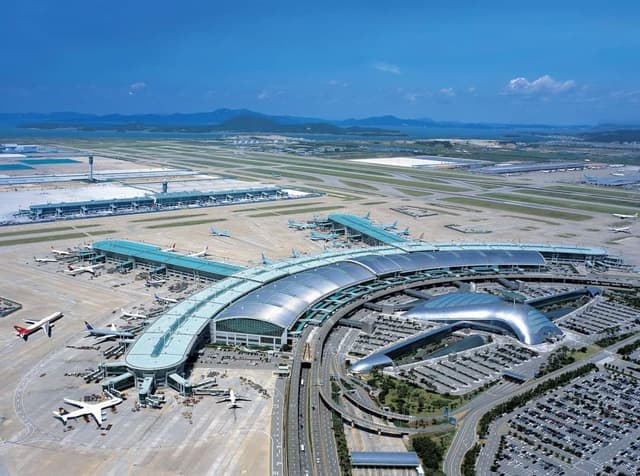
Here are my recommendations for price comparisons.
Accommodation
Where can I find the best local and affordable stays in Korea?
I use a variety of booking platforms for hostels, hotels and airbnbs in South Korea.
If you want all the best stays in South Korea (best areas in each city, recommendations for a temple stay and hanok) check out my guide below.

Activities & Tours
Where can I find and book local tours, activities or tickets for attractions in Korea?
I use a combination of travel booking sites. This isn't sponsored I've just had great experience with both sites for my travels overseas. When I traveled solo in South Korea and to other countries it was great having everything planned for me and I also got to meet some other travelers on my trip.
RECOMMENDATIONS
Don’t miss out on top-rated excursions, attractions, and sightseeing tours in South Korea. From guided local tours to private day trips, Get Your Guide has something for every traveler to enjoy.
Use Klook to find activities, tours, cars, hotels, and tickets to attractions at affordable prices. I love how easy it is to book in advance saving me $$ and time on my trip planning. Klook also offers seasonal activities and tours for South Korea. So if you're visiting in autumn, winter, or spring you'll have to check out the unique local experiences they have to offer. From summer sports, cherry blossom tours, or fall foilage day trips.
Travel Adaptor
Korea has Type C and F plug sockets with a standard voltage of 220. Although you can buy an individual adaptor with these plug sockets I strongly recommend buying a universal or 'world' travel adaptor.
I started using Universal or 'World' travel adapters for my travels instead of buying individual adaptors for every country I would visit. Not only are they affordable but you'll also be saving money in the future because you can re-use them for your future travels to other countries.
Don't miss out on these travel adaptors recommendations!
I've also listed other essential items I use for my travels.
3. Must-Have Apps for South Korea📱
These are essential apps you should download to help your travel, shop, and navigate around Korea.
Reminder - Download the Thatch App.❗️
Download the FREE Thatch app so you can access this interactive guide while you are traveling!
1. Navigation Apps 📱
Kakao Map and Naver Map will be your best friend for navigating and finding recommended cafes and/or restaurants in South Korea. Do NOT use Google Maps because it is not supported and kept up to date. You will often get inaccurate map directions and locations if you use Google Maps.
Both apps are in Korean by default but the mobile apps are available in English. Naver Map is also more English-friendly but I personally found using both apps as the best way for navigate and finding points of interest in South Korea.
Download Naver Map
Download Kakao Map
2. Transportation 🚆
Subway Korea (Navigation & Transportation) 🚆
No, it's not the sandwich place but a subway map app. It provides the most up-to-date maps of the subways in Korea. Simply put your starting station and the destination and it will map out the directions for you.
4. What are the best transport passes?
Korea Rail Pass
The Korea Rail Pass (KR Pass) provides unlimited rides on almost all the trains operated by South Korea’s major railway provider KORAIL.
There are different options for KR Passes including booking a pass to cover trains for flexible 2 or 4 days or 3 or 4 consecutive days. Not only does the KR pass covers 80 routes and +600 stations. The pass offers discounts only available for foreign tourists including on tourist attractions and accommodation.
Seoul Pass
If it's your first time visiting Seoul and you're planning on visiting a lot of sightseeing attractions that require a lot of paying admission consider the Discover Seoul Pass.
The Seoul Pass doubles as a T-money card and an admission ticket to top attractions in Seoul. Not only does this pass give you a T-money card that can be topped up and refunded for any remaining balance.
The pass also gives you discounted tickets to over 101 tourist attractions (within 24, 48, and 72 hours) and free access to over major attractions. If you plan on visiting multiple sightseeing attractions in Seoul that require tickets for admission this is a great option to save money for your travels around Seoul.
Busan Pass
If you're heading to Busan make sure to add this pass to save money on admission to tourist attractions and discounts on public transport fares.
The Busan Pass offers a 24 or 48-hour ‘free pass’ around the city. This includes access to free entry to over 30 major tourist attractions in Busan, special discounts on restaurants, shopping, and tourist attractions, and free use of the city tour bus and pre-paid use of the subway.
Want more insider information about Korea?
I go into more depth about what you need for your trip to South Korea in this one-stop survival guide for Korea! Keep an eye out for the 'Korea Survival Travel Guide' on my Thatch page my subscribing for new releases!
Why Should I Get the Survival Travel Guide?
As an Australian expat that has lived in South Korea since 2022, I know firsthand how it can be overwhelming navigating a new country. That's why I've personally curated a list of places, tips, and information from living and traveling in South Korea. You'll be getting personal recommendations from someone that has lived in Korea compared to the ordinary tourist providing recommendations.
Curious about me? Check out the 'ABOUT ME' section on my website. You can find out about my personal story and FAQS I get asked from my +22k community.
Features of Korea Survival Travel Guide
❗️ Korea Travel Essentials (Data Connectivity, Transport, Language, +8 More Must-Have Apps & More)
🚶🏻♀️ Must Things to know for your trip (Things NO ONE tells you about Korea)
🙋🏻♀️ Answering FAQS about traveling in South Korea (Language Barrier, Best Times and Spots to Visit, Best Ways to Travel, Luggage Storage & More!)
🇰🇷 Essential Korean Vocabulary & Phrases
🚆Getting around South Korea (Transportation) ("What's the best way to travel?")
🛍️ Recommendations on where to shop (shopping districts, brands)
📍Recommended Places to Travel (Seoul and Beyond + Hidden Gems)
.... and lots more!

FAQs about South Korea ❓
In this section I'll be answering frequently asked questions about travelling in South Korea.
Where can I store my luggage?
There are so many different luggage storage options in cities around Korea. From short-term options in subway lockers to long-term storage in the airport and subway stations. You'll be able to reserve a couple of hours, a day, or a multiple-day service. If you want map links for storage lockers and recommended luggage services I've linked them in my Korea survival guide.
When is the best time to visit South Korea?
I personally think Spring or Autumn is the best time to visit South Korea. This is based on my personal preferences because I absolutely loved the cherry blossoms and the autumn foliage. The weather during these seasons is also warmer which makes it perfect for a lot of activities you'll want to experience in Korea such as rental hanboks (traditional Korean dress), day trips exploring the cultural attractions outside, etc.
Note that during spring and autumn, these are peak travel times for both tourists and locals. Expect to find a lot of accommodation and travel (KTX tickets) to be booked out well in advance.
However, I will say that each season in Korea is beautiful and has its own unique charm. These recommendations are based on my personal preferences. As an Australian who prefers warmer weather, I generally prefer travelling in spring or autumn. In Winter, it's still beautiful and there are a lot of fun seasonal activities you'll enjoy.
Must-Know Things For Your Trip
If you're planning a trip to South Korea make sure to read up on these FREE 10 tips for your trip. I'll be covering all the essentials on planning for your trip, Visa requirements, how you can save money on bookings, the best places to visit and more.
Cafe Culture
Where do you recommend for cafe hopping in Seoul?
If you're looking for an one-stop area for cafe-hopping look no further than in Hongdae in Mapo-gu or Garosu-gil in Gangnam. Both areas are known for their trendy local cafes. If you're looking for more charming traditional cafes I'd recommend exploring Samcheong-dong in Jongno-gu.
Here are a few cafe recommendations in Seoul
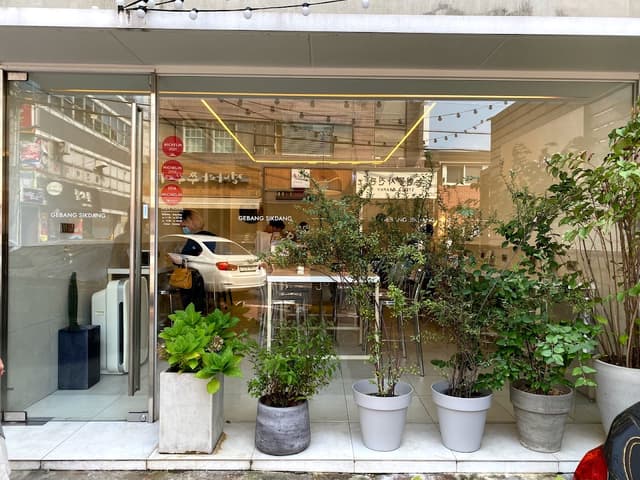
If you want a more in-depth guide on how to find local restaurants and cafes in Korea I go into more detail in my 'Korea Restaurant & Cafe Hopping Guide.' I also share my personal local cafe and restaurant recommendations from living in Korea since 2022.
Want more local cafe & restaurant recommendations?✨
If you're looking for more recommendations for local cafes and restaurants and want more tips on cafe hopping check out my guide below.
Guide Features
☞ More ways to find HIDDEN & local eateries (like a local)
✩Things I Wish I Knew Before about Cafes & Restaurants in Korea
✓Over 290 recommendation cafes & restaurants (Includes Map Links!)
☑︎ Over 30 essential Korean phrases & vocabulary
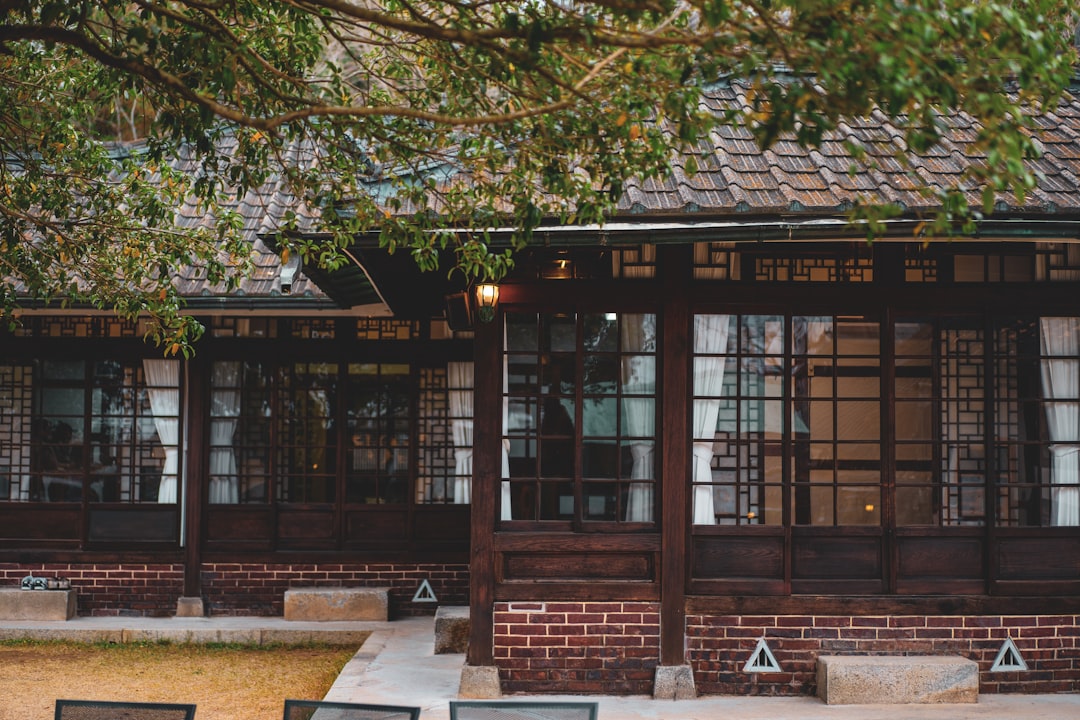
Korean Culture 🇰🇷
How are Koreans reacting to foreigners in your opinion?
I hate to generalise because I think everyone’s experience will differ. As an Asian foreigner in Korea, I’ve never felt like I was going to get scammed or discriminated against (mind you I often get mistaken as Korean). I think Koreans are getting more used to foreigners as tourism is increasing a lot. In general, I think Koreans might be mistaken as a ‘bit cold at first’, and most often it is because they are shy or intimidated to speak English. As long as you show them respect and appreciation they are likely to show the same in return.
Language Barrier 👩🏻🤝👨🏼
Is it easy to get around Korea speaking Korean?
This depends if you are planning to just visit or work here. If you’re only visiting for a trip then I don’t think it’s essential to know Korean but it will make your experience more comfortable and rewarding. You’ll definitely find navigating and ordering at restaurants more easily. I would recommend as a bare minimum to know at least the Korean alphabet (hangeul) as sometimes not all restaurants and cafes have English menus. Knowing a few basic common phrases will also go a long way in making you navigate more easily and perform daily tasks on your travels like ordering at a restaurant, shopping, etc.
TRAVEL ESSENTIAL PHRASES
Yes/ No [네/아니요.] = Ne \ Aniyo
제 이름은 (Kelly) 입니다. = Je ireumeun (Kelly)imnida = My Name is (Kelly)
(실례합니다) = Sillye hamnida = Excuse me
한국말 못 해요 = [hanguk-mal mot haeyo] = I don't speak Korean
죄송합니다. 이해 못 해요 = [Joe-song-ham-nida. ihae mot hae-yo] = I'm sorry, I don't understand.
[영어 할 줄 아세요?] = Yeongeo haljul aseyo? = Can you speak English?
안녕하세요. [an-nyeong-ha-se-yo.] = Hello.
안녕히 계세요. [an-nyeong-hi gye-se-yo.] = Good bye. (When you are the one leaving.)
감사합니다. [gam-sa-ham-ni-da.] / 고마워요. [go-ma-wo-yo.] = Thank you.*
죄송합니다. [joe-song-ham-ni-da.] / 미안해요. [mi-an-hae-yo.] = I’m sorry.*
If you want an entire guide for 'Essential Korean Phrases' for shopping, cafes, restaurants, directions, navigations, and more. Check out my 'Korea Survival Guide' there are over 100 essential phrases to help you speak like a local and help you travel in Korea.
Can you recommend Korean learning resources?
Check out these free Korean learning resources. I've used a combination of these resources at the beginning of my Korean learning journey before investing into paid resources.
Is it necessary to have a Korean phone number (Prepaid SIM Card)?
I would recommend getting a sim card as it makes it easier and more convenient for traveling like navigation and also making reservations, waiting lists, and booking appointments.
Refer to the 'Data & Connectivity' section for more information.
Would you recommend solo travel in South Korea?
It's an awesome idea! You'd be surprised at how many people come to Korea alone as a visitor, exchange students, or for work. For me, I came alone at 23 years old to work as a teacher and I've had an amazing experience. I've also had friends who came here by themselves for solo travel and they felt safe and it was relatively easy to navigate in Korea.
Based on my personal experience, I always recommend Korea as one of the best places for solo traveling as it is quite safe compared to other countries I've been to (France, London, Hong Kong, South Africa, Japan). I totally understand your fear about solo travel it's completely normal. Obviously, it's always good to be mindful of your surroundings no matter where you go. If you are nervous stick to traveling to the main cities like Seoul and Busan.
I'm also hosting a group trip to South Korea in April of 2024. You are more than welcome to join! Here's a post answering all the frequently asked questions and information about the group trip.
How long do you recommend for a trip to Korea?
This really depends on your personal circumstances and preferences. For example, what is your budget and what do you really want to see and experience in South Korea? Generally, I'd recommend around 1.5 to 2 weeks for a visit to South Korea. As a minimum, I would suggest 8 days, but this is really making you squeeze everything in a short time and I personally would feel rushed. If you're just doing two or three cities in Korea I think it is manageable you'd just have to carefully plan what you're doing each day.
If you're planning a visit to Korea make sure to read up on these 10 must-see places in Seoul, Korea.

Want more travel recommendations on places, activities, and tours for South Korea? Check out my Korea Survival Guide for a breakdown of over 20 cities to visit in Korea. I go beyond exploring tourist traps helping you explore local finds in Korea.
Where to Stay in Korea (Accommodation) 🛌
Where do you recommend staying in Seoul?
This depends on what you will be doing here and what you want to see and visit. So if you think you will spend most of your time in an area e.g. Hongdae, then it would make sense to stay in this area since you will be conveniently located there.
For tourists exploring Seoul, I would recommend staying somewhere central such as Euljiro or Myeongdong just because of how convenient it is so transit to and from (often between lines 2 and 3 which are the two major metro lines). As a general rule whenever you do end up staying in Korea always make sure that it is near public transport (subway stop or bus stop) because it will make your life much easier in getting to and from places.
Where do you recommend for a hanok stay?
If you're looking for recommendations on a traditional Korean stay experience I'd recommend looking in Seoul or Jeonju.
For hanok stay experiences in Seoul refer to this article.
If you want a more in-depth guide on where to stay in Korea in over five cities check out my 'Accommodation Guide in South Korea.' I'll also be sharing insider tips and recommendations on how to find the best accommodation deals as a budget traveler. As well as sharing personal recommendations on where I've stayed (best hanok stays, areas, linked hotels & Airbnb) across Korea from Seoul, Busan, Jeonju, and more!
Features of the Korea Accommodation Guide
🙋🏻♀️ Must Things To Know For Booking your Travel Accommodation (Save $ on your stays in Korea & overseas)
✨ Helping you avoid tourist traps & overrated spots by giving you local hidden gems.
Tips for booking accommodation ("What resources do you use to find the best accommodation for traveling?")
🛏️ Where to stay in South Korea in five cities (Recommended Areas in the Cities) ("Where is the best areas to stay in Busan/Seoul etc.?)
✨Recommendations for a Temple Stay & Hanok Stay
💵 Exclusive discount code for another guide!
...... and more!
Must Try Activities in Korea
Local Tour
Why should I do a tour?
1) If you're traveling solo it's a great way to meet like-minded travelers. I've met some amazing people from these tours that I now regularly hang out with in my free time.
2) They organise all the activities and transfers for you. If you're a bit nervous organising all the details and navigating the language barrier this is a great solution for you.
3) You'll get local inside from an expert guide!
Tours for Foodies 🍴
Eat your way around Seoul with this guided foodie walking tour. You'll get to try freshly made local dishes from dumplings, rice rolls, tteokbokki and more!
Tours for Adventurers 🪂
If you're feeling a bit adventurous and want to do some sightseeing at the same time these activities are for you.
Hiking Experience🥾
Enjoy a guided trip from Seoul on a short hike to Korea's stunning Mt Seorak National Park. You get the option to either visit the ancient Naksansa Temple or stroll through beautiful tree-lined walks on Nami Island.
Luge Racing Adventure ⛰️
Ride from the top of the mountain and get stunning views of the countryside at this Luge racing park. This activity is both for adults and kids.
Morning Seoul Tour ☀️
Get a taste of Korean heritage in this morning tour around Seoul. You'll get to discover the beautiful historic buildings with a local guide from it
Seoul Night Tour 🌃
Han River Night Cruise & Park Picnic 🧺
Immerse yourself in Seoul's nightlight at Han River Park. Have a local experience by exploring Korean games, culture and food. You'll get to discover the city's skyline and history on the night cruise and a picnic.
Busan Night Cruise 🛳️
Discover Busan at night by exploring all the best viewpoints in the city with this evening cruise.
Day Trip from Seoul
Demilitarised Zone (DMZ)
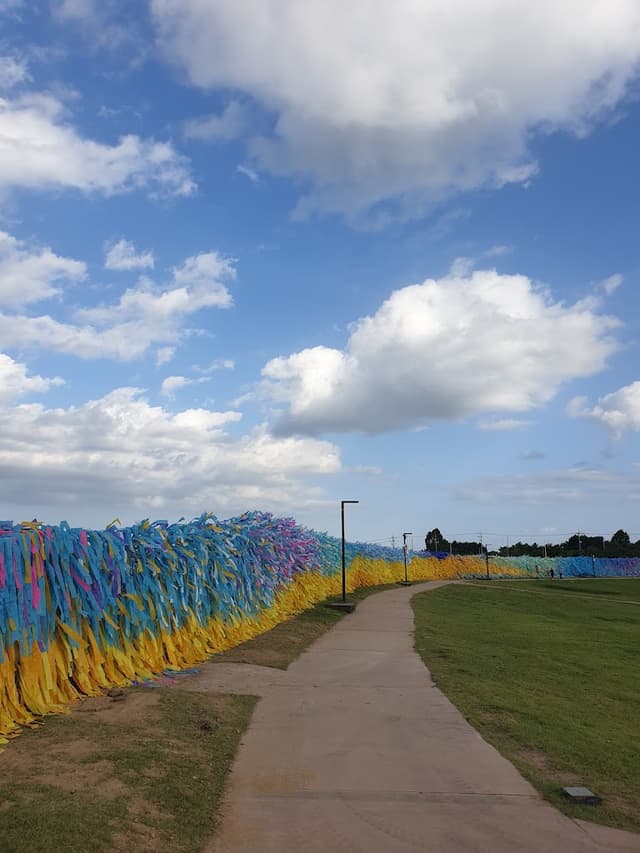
If you’re visiting Korea you’ll want to add the demilitarised zone in Korea to your travel bucket list. The easiest way to visit is through a guided DMZ tour which includes transfers and a local expert to learn about the history of the Korean War. Here are a few recommendations to choose from.
DMZ, 3rd Tunnel & Suspension Bridge
In this DMZ day trip tour from Seoul you'll be able to visit the 3rd infiltration tunnel, Dora Observatory, and suspension bridge for scenic views and learn more about Korea's war story.
Half Day or Full Day DMZ Day Trip Tour
Half Day DMZ Tour from Seoul (Peace Gondala)
Discover the history and monuments of the DMZ on a half-day tour from Seoul. You can also enjoy a Peace Gondola ride for a birds-eye view of the DMZ.
Ganghwa Island
Ganghwa Island also called Ganghwado (강화도) is Korea’s fifth largest island located a few hours away from Seoul. Ganghwa is a hidden gem away from the bustling Seoul that offers an ideal escape for those seeking to explore Korea’s rich history, captivating landscapes, and unique attractions without crowds. From ancient relics to picturesque landscales, Ganghwa offers a variety of attractions for every type of traveler.
If you’re planning a day trip visit to Gangha here is everything you need to know about visiting Ganghwa Island. From 20 must things to do in Ganghwa, how to get to Ganghwa from Seoul, and more.

Nami Island 🌳
If you’re looking to escape the bustling crowds of Seoul. Take a day trip to Nami Island for the beautiful scenery and immerse yourself in local activities including ziplining, cycling around the island, and checking out the local eateries.
It involves a bit of planning and booking multiple transfers (public transport) to get to the island from Seoul. So I recommend booking a day trip tour as they include transfers and admission onto the Island.

Nestled along the eastern coast of South Korea, Pohang emerges as a hidden gem that promises an unforgettable adventure. From pristine beaches to cultural landmarks, this city offers a plethora of activities that cater to diverse interests.
Find out these 20 things to do in Pohang.
Read the full travel guide for in-depth tips for traveling to and around Pohang.
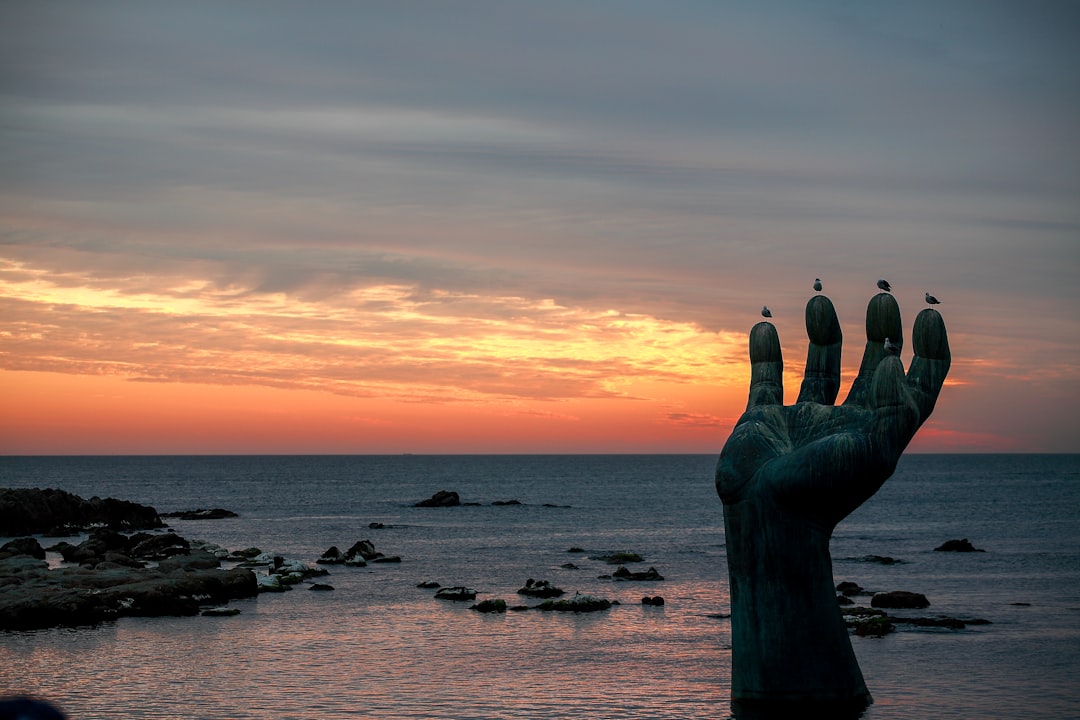
Visit a Cultural Village

Visit a Palace
If you're visiting Seoul make sure to check out at least one palace in Korea.
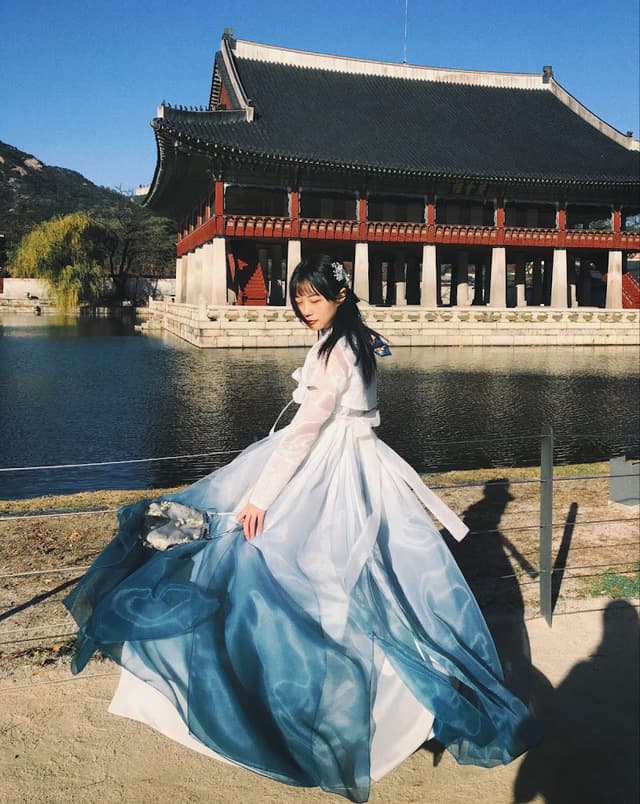
Don't forget to add these places in Seoul to your Korea itinerary!
Try a Workshop
There are so many fun workshops you can try not only for an authentic experience but also you can make your own unique personal souvenir for yourself or loved ones.
Try a Perfume Workshop
Experience a unique perfume-smelling tour and design your own fragrance at the GN Perfume Studio in Seoul.
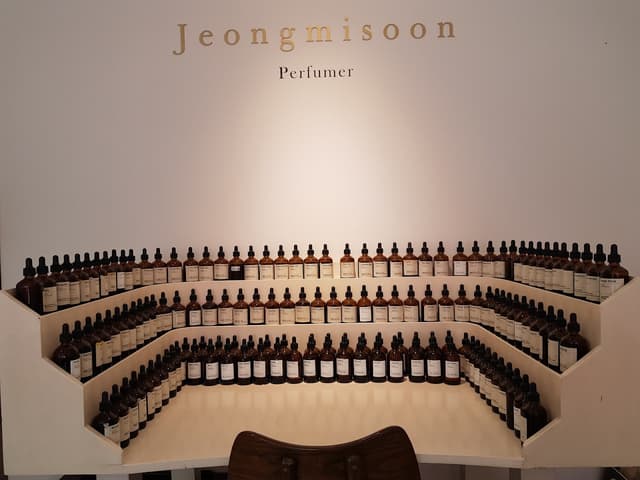
Handmade Stamp Engraving
Take home a personal souvenir by creating your own South Korean-style hand-engraved seal. You'll get to engrave your own name or custom logo onto a personalized seal.
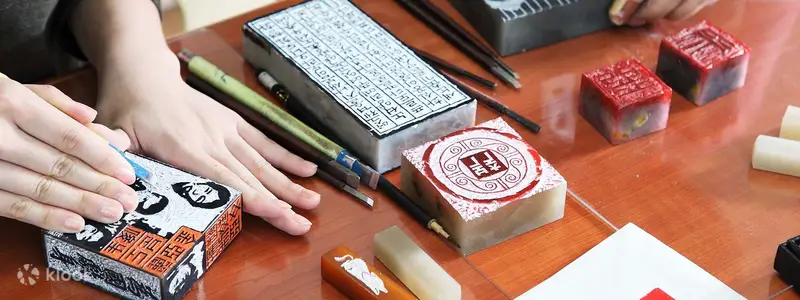
Korean Traditional Dessert Rice Class
Learn how to make traditional Korean desserts in this fun cooking class.
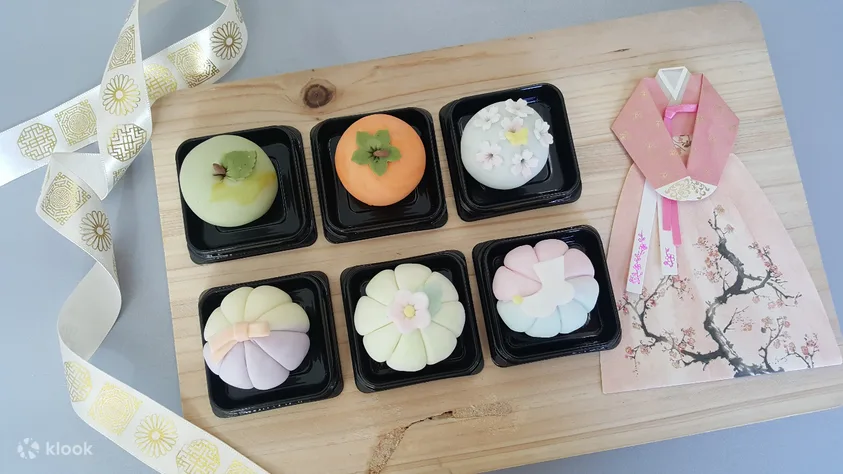
Seoul Kimchi & Culture Experience
Learn how to make delicious kimchi, instructed by professional Korean chefs with a choice of three cultural package options.
Makeup Workshop
Make your own personal lipstick in Seoul! It's the perfect souvenir for yourself or a loved one back home.
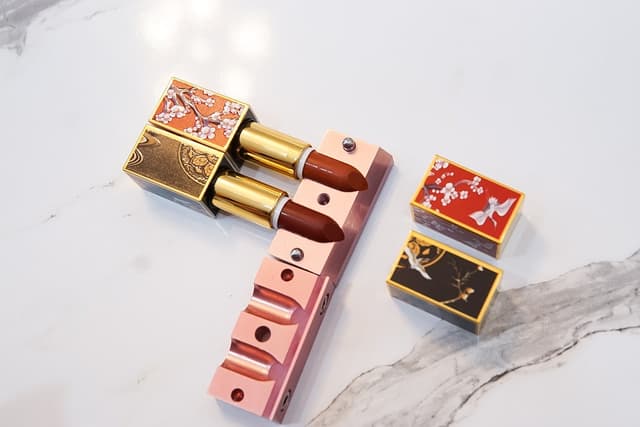
Ring Craft Workshop
Design and craft a personal ring for yourself or a loved one back home. You'll get to learn how to use raw materials to make the perfect personal gift.
Jewellery Workshop
Make your own jewelry using Korean alphabets or Hangeul and take it home as souvenirs in Euljiro Seoul.
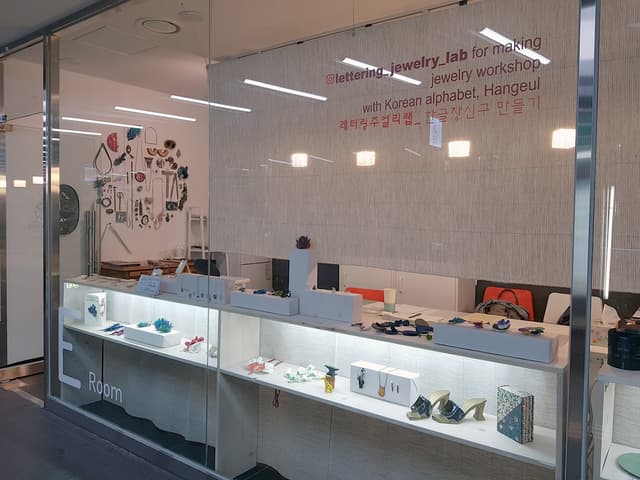
Visit a Themepark
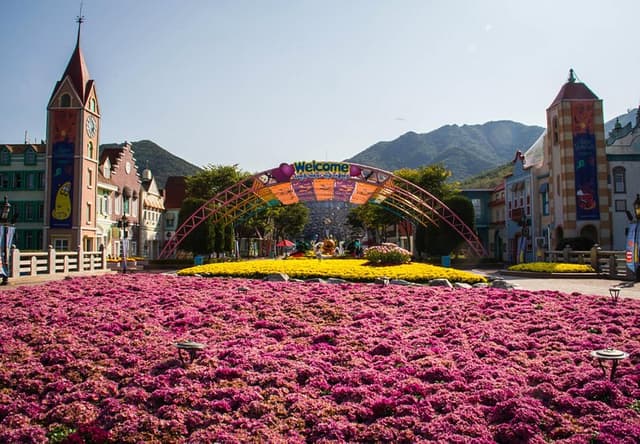
Guide to Hanbok Rentals
If you’re planning a trip to South Korea you must try this activity to immerse yourself in the Korean culture and make some memories for your trip. It’s a fun cultural experience to try with family and friends to make your trip to South Korea more memorable.
What is a hanbok?
A hanbok is a traditional piece of clothing previously worn for everyday wear. However, in more recent times it is reserved for special occasions including birthday celebrations, major holidays, and weddings.
Things to know about a hanbok
The hanbok consists of two different parts - the skirt and the shirt. In line with Korean customs, there are distinctions in costume structure in various classes in society. Each hanbok is unique with a combination of emotion, creativity, and sophistication in design and color.
Why should you wear a hanbok?
1) Free entrance to any of Seoul's five grand palaces. This includes the palaces Gyeongbokgung Palace, Changdeokgung Palace, Gyeonghuigung Palace, Deoksugung Palace, and Changgyeonggung Palace.
2) It's a great way to embrace Korean culture and to make some unique memories on your trip.
Where are the best places & tips for renting a hanbok?
I go into things I wish I knew before I rented a hanbok and the best places to rent a hanbok in Seoul and other cities.
Best Places for Hanbok Rentals
Depending on your budget and the time you have for your trip there are a variety of places for hanbok rentals in South Korea. My personal recommendation to rent a hanbok includes Seoul and Jeonju. Personally, I found the charming city of Jeonju as the quintessential place to try this cultural activity. However, if you’re short on time you can explore Seoul by heading to Gyeongbokgung Palace with its picturesque mountain views and nearby Bukchon Hanok Village. This place serves as the perfect backdrop for your photos.
As a general rule, I always recommend choosing places that are close to the attractions you’ll want to explore in the hanbok. This is to save time traveling to and from the location. Here are a few personal recommendations on where to rent a hanbok in South Korea in cities including Seoul, Jeonju, and more.

Booking a Hanbok
Did you know you can book a hanbok (a traditional Korean dress) in advance? There are a few reasons why you should book in advance.
1) Save Money
Bookings in advance are essential to save money but also to ensure you don’t miss out on securing a rental booking. If you choose to do just ‘walk in’ to a rental store you’ll have to consider if the place has English-speaking staff and if the place offers ‘walk-in’ appointments. Some rental places only accept a certain amount of bookings per day which can be common in high-traffic places in South Korea. Worst case you might have to wait a long time or you won’t be accommodated at all. So remember to book ahead of time!
2) Hanbok Selections
If you book an early morning time slot so you’ll have a wider selection of hanboks before they get rented by other customers. Think of it as ‘first comes, first served.’ You will also have more time to wear the hanbok without feeling rushed exploring and taking photos before you have to return it at the end of the day.
Hanbok Rental Recommendations
Here are a few of my recommendations for hanbok rentals in Seoul and other cities. My best advice for choosing a rental place is to decide on where you want to visit and take photos in your hanbok. Choosing a rental place near your selected attraction will make it easier to get to and from - saving you time walking to the place and you'll get more time in the hanbok!
If you're looking to rent a hanbok in Seoul check out these places. Most of the rental places are situated around the local attractions such as Gyeongbokgung Palace, Changdeok Palace and Bukhon Hanok Village.
1) Seohwa Hanbok Rental (Gyeongbokgung Palace)
Looking for a hanbok rental and photoshoot all-in-one package? Look no further. This rental shop is located near Gyeongbokgung Palace and offers hanbok rentals and photography sessions. Visitors can choose from renting a variety of hanboks (‘traditional’, ‘fusion’, or ‘premium’ from 3 to 4 hours to a full day.
2) Hanboknam (Changdeok Palace)
Select from over 500 Hanbok designs at this rental store near Changdeokgung Palace. One of Seoul’s five remaining Joseon palaces. They offer both traditional and themed hanboks to rent from 1.5 hours to a full day depending on your budget for this activity.

3) Bukchon Hanbok Rental
Choose from renting a hanbok for four hours to a full day. This rental place offers a variety of sizes and designs with hair accessories for those interested. This place is available in Seoul South Korea near Bukchon Hanok Village.
4) 한복남 프리미엄점 Hanboknam Premium Store
Try booking a premium hanbok service at the Hanboknam Premium store. They offer the latest trendy hanbok designs and have branches near Gyeongbokgung and in Jeonju. The rental services range from an hour to three hours to a full day depending on your budget.
Outside of Seoul
Looking to rent a hanbok outside of Seoul? Why not try the cities of Jeonju or Jeju Island. You'll be able to escape the usual crowds of the main city and explore places where not many tourists venture.
1) Jeju Hanbok Private Guide Tour & Photo Session
Book a private tour of Jeju inclusive of a hanbok rental and a photo session around the island. They offer packages for one individual or groups depending on your travel preferences.

2) Hanboknam Jeonju Store
Try a hanbok rental in Jeonju Hanok Village. You’ll get to try traditional Korean clothing and the option to get your hair styled in a traditional look. You can choose from a traditional or themed hanbok from 1.5 to 4 hours or a full-day rental.

Did you find this helpful? 🙋🏻♀️
I'm in the process of creating more travel guides for South Korea. Keep your eye out on my page for more releases. I'll be posting guides for cafe & restaurant hopping, travel itineraries, a Korea survival guide, and more.
Subscribe to my Thatch Page for updates on new releases.
Want to travel to Korea in 2024? 🌸🇰🇷
Want to travel to South Korea without planning anything? Come and travel to South Korea in April 2024 with me! I'm hosting a group trip and would love for you to join me. The best part? Everything is planned for you. From the accommodation, activities, local transfers, meals, and more! All you have to do is sign up and show up for the trip!
Want the FULL trip information pack about the group trip?
❗️GET ACCESS TO:
✈️ FULL trip itinerary
💬 Answers to frequently asked questions ("Can I join alone?" Why is it so expensive?" "How does flying in and flying out work?"
👀 Answers to COMMON concerns from sign-up interests ("I'm scared of traveling alone," "I'm concerned about paying the full amount," "I'm nervous about meeting new people, etc"
👇🏼DOWNLOAD the full info pack below!👇🏼
Are you a bit hesitant about solo travel? Or maybe curious about what a group trip is? Read up on why group travel is a perfect way for you to travel more in 2024. Maybe you want to travel more but your friends aren't free, or you want to visit a place that no one is interested in. Find out how group travel is a perfect opportunity for you!
💌 Let's stay connected!
Want to get access to exclusive discounts for digital products, early product releases, insider tips & recommendations?
Join my community to be notified first!
Want FREE information on my latest travels or resources? Check out my blog for the latest posts.
📱Follow my daily adventures!
Catch me on the 'gram for my almost daily life. From my travel adventures, and lifestyle content. You can also subscribe to notifications for my stories, posts, or reels where I share the latest drops for limited discounts, products, events, and group trips.
I can't wait to connect with you!
If you have any questions or issues regarding the guide feel free to contact me at [email protected].

IMAGES
VIDEO
COMMENTS
Explore South Korea's diverse attractions, from Seoul's nightlife to Jeju-do's volcano, with Lonely Planet's expert tips and advice. Find out the best time and places to visit, how to get around, what to do and more.
Learn everything you need to know to plan a trip to Korea, from entry requirements and costs to culture and festivals. Find the latest travel news, tips, and itinerary ideas for your Korean adventure.
A comprehensive guide to help you plan your trip to Korea, with tips on visa, flights, hotels, destinations, attractions, and more. Learn about Korea's culture, history, cuisine, and safety, and discover the best places to visit in this fascinating country.
Learn how to plan your trip to South Korea, a vibrant and diverse country with a rich culture, history, and food. Find out the best things to see and do, typical costs, money-saving tips, and more in this comprehensive guide.
A comprehensive guide for first-time travelers to South Korea, covering visa, language, money, transportation, hygiene, weather, accommodation, food, culture and more. Learn how to plan your trip, what to expect and what to do in South Korea with tips and insights from KoreaTravelPost.
4. Take advantage of Korea's world-class public transportation. Korea's subways, trains and buses are clean, convenient and efficient. It can sometimes seem like a new station is added to the Seoul metro every month, and the rail and intercity bus networks will take you to every corner of the country.
South Korea Workation Guide: 8 Places to Live and Work for Digital Nomads. South Korea's unique mix of fast-speed internet, great cafe culture, and all-around convenience make it an ideal workation destination for digital nomads. ... Korea Travel Cheat Sheet: 3 New Transportation Services. The language barrier at subway stations in Seoul has ...
Days 3-4: Andong. When you arrive in Andong, it's not hard to notice a stark contrast from the bustling capital of South Korea. While walking through Seoul is an exercise in back-and-forth time travel from past to present to future, Andong is mostly rooted in centuries-old traditions and culture. I'm not complaining.
The Taegeukki. Winter Sonata. Tailor-made travel itineraries for South Korea, created by local experts. 14 days / from3800 USD. Culture & Island life. Experience the highlights of Korea with a private guide by your side. Fascinating Seoul with a day trip to the DMZ, followed by days in Gyeongju and Busan.
Start your travel to-do list now with our seven favorite places to visit in South Korea. 1. Seoul. Best place for nightlife. Home to half of South Korea's population, Seoul is also the most popular city for tourists to visit. The capital has an electric vibe at any hour of the day or night.
1 Seoul (서울) — the dynamic 600-year-old capital of South Korea, a fusion of the ancient and modern; 2 Busan (부산, 釜山) — the second city and main beach destination; 3 Chuncheon (춘천, 春川) — capital city of Gangwon province, surrounded by lakes and mountains and known for local dishes, dakgalbi and makguksu; 4 Daegu (대구, 大邱) — a cosmopolitan city, rich with ...
Welcome to the ultimate South Korea Travel Guide, where we unveil all you need to know for an unforgettable adventure in this captivating country. From the bustling cityscape of Seoul to the serene landscapes of Jeju and the vibrant coastal charm of Busan, South Korea offers a kaleidoscope of experiences. Whether you're a culture enthusiast, a food lover, or an outdoor adventurer, this diverse ...
Explore CNN's South Korea Travel Guide and discover the best things to do and places to stay, plus get insider tips, watch video and read inspiring narratives.
How Much to Budget in South Korea Per Day. Budget traveler: If you are on a tight budget, watch your spending closely, $30 - $40 could be a sufficient budget. Mid-range traveler: If you want to have a few splurges and stay in nicer accommodation, plan to budget $50 - $100 per day. Dorm bed = $18-$30.
2. Explore Busan. South Korea's second largest city, Busan offers magnificent beaches, the colorful Gamcheon culture village, and the largest fish market in Korea. 3. Try the Street Food at Gwangjang Market. Originally a fabric market, Gwangjang Market is now the busiest food alley in Seoul, with street food vendors spread among the fabric shops.
We can craft a trip around you and help you realize your own holiday dreams. 8-Day South Korea Tour. 8-Day South Korea Tour. Private tour from: US$3, 200. View More. 10-Day South Korea Tour. 10-Day South Korea Tour. Private tour from: US$4, 000. View More.
To give you an idea, you should expect to travel in South Korea with an average daily cost of about USD $35~ per person on a budget, or at least $100~ if you want to experience more comfort on activities, tours, hotels, and more. (Values below show low budget to medium budget ranges). Hotels: $20 to $100 USD / day. Food: $10 to $30 USD / day.
For those in South Korea on a work visa, all employment changes must be authorised by Korean Immigration. Re-entry permits for long-term visa holders. Most foreign nationals in South Korea on long-term visas are allowed to re-enter South Korea within one year of departure without the need for a re-entry permit. Check with the Korea Immigration ...
Seoul. South Korea, Asia. Fashion- and technology-forward but also deeply traditional, this dynamic city mashes up palaces, temples, cutting-edge design and mountain trails, all to a nonstop K-Pop beat.
South Korea has very clear-cut seasons, and for most cases, each offers a unique perspective of the country. The summer (June to August) can be hot and humid. Winter (December to February) can be extremely cold but with less risk of rain. Autumn (September - November) is when the forests can turn reddish orange, and the best time of all is ...
The Sights In Seoul, South Korea. Seoul itself is an architectural landmark. There are specific sights in Seoul that are places you have to visit while you're there. A few of those places are: N Seoul Tower, the Ansan Starlight Village, and the Jogyesa. There's also entertainment like underground shopping.
Seoul, the capital of South Korea, is a captivating destination for travelers seeking a mix of rich history, vibrant culture, and modern charm. Explore the city's iconic landmarks, such as Gyeongbokgung Palace and N Seoul Tower, or immerse yourself in the energetic atmosphere of trendy neighborhoods like Hongdae and Gangnam.
This guide is a one-stop resource on traveling in South Korea. You'll get a sneak peek into my Korea SURVIVAL Travel Guide, essential travel tips in Korea, things to know for your trip and must-try activities to do in Korea including renting a traditional Korean dress and more [About the author] 🏻 As an Australian expat that has lived in South Korea since 2022, I know firsthand how it can ...